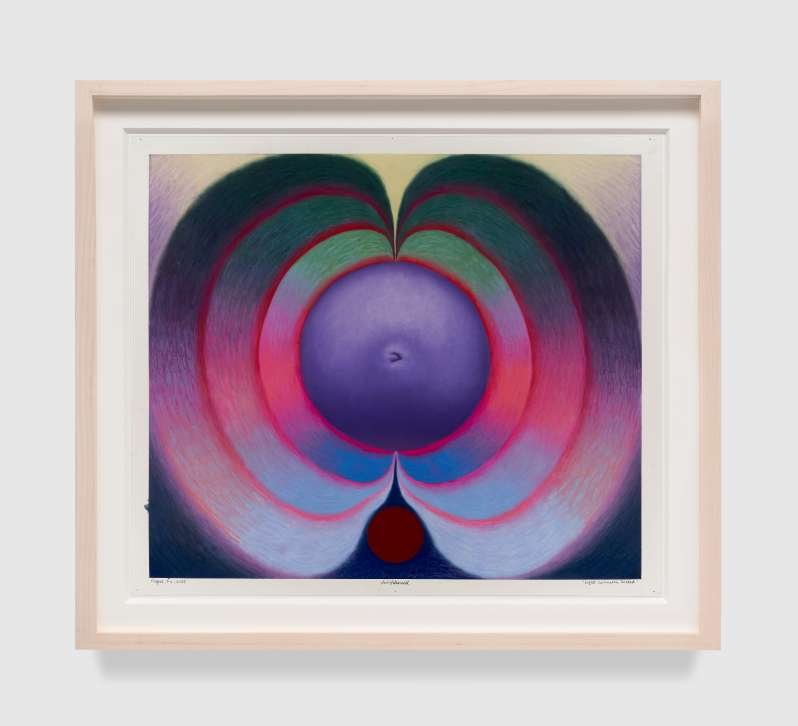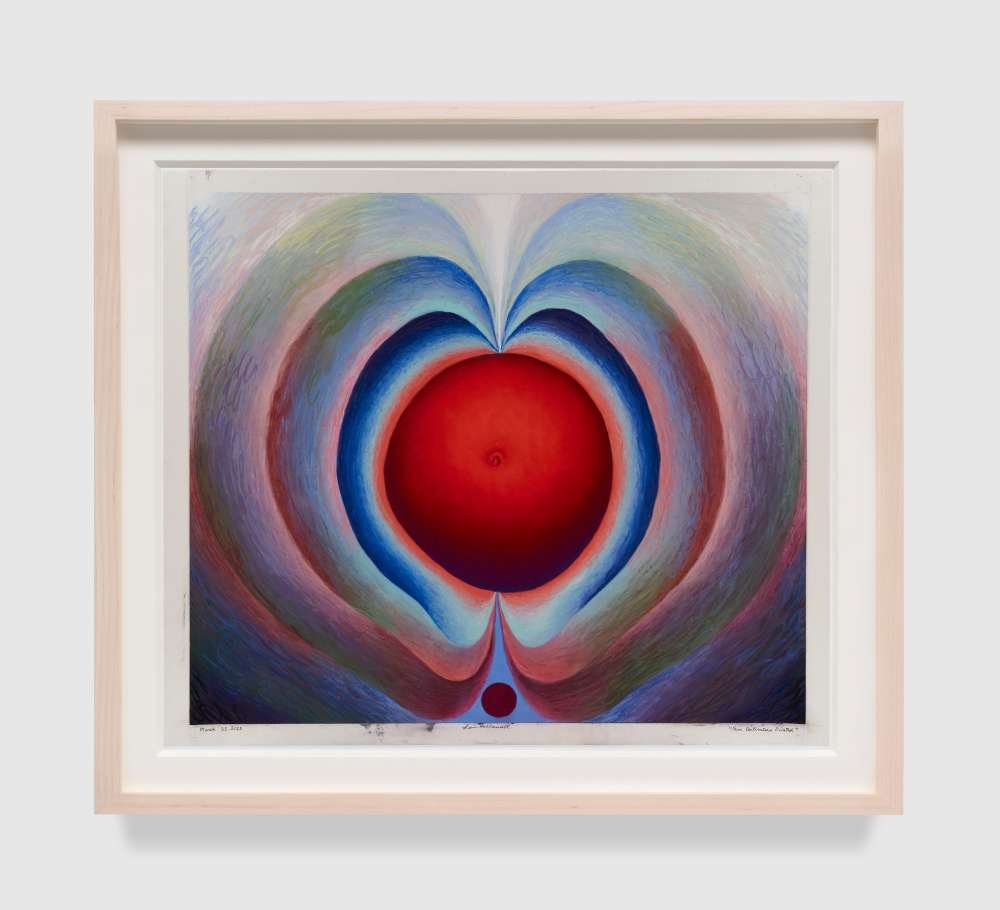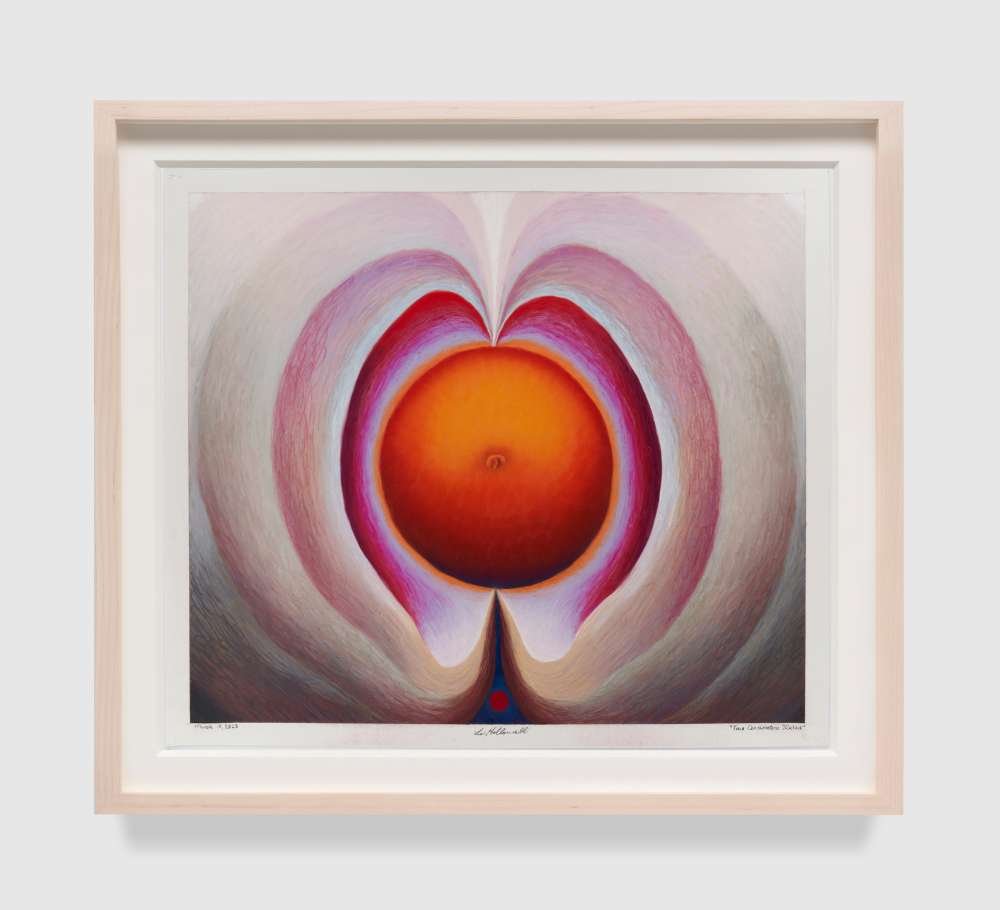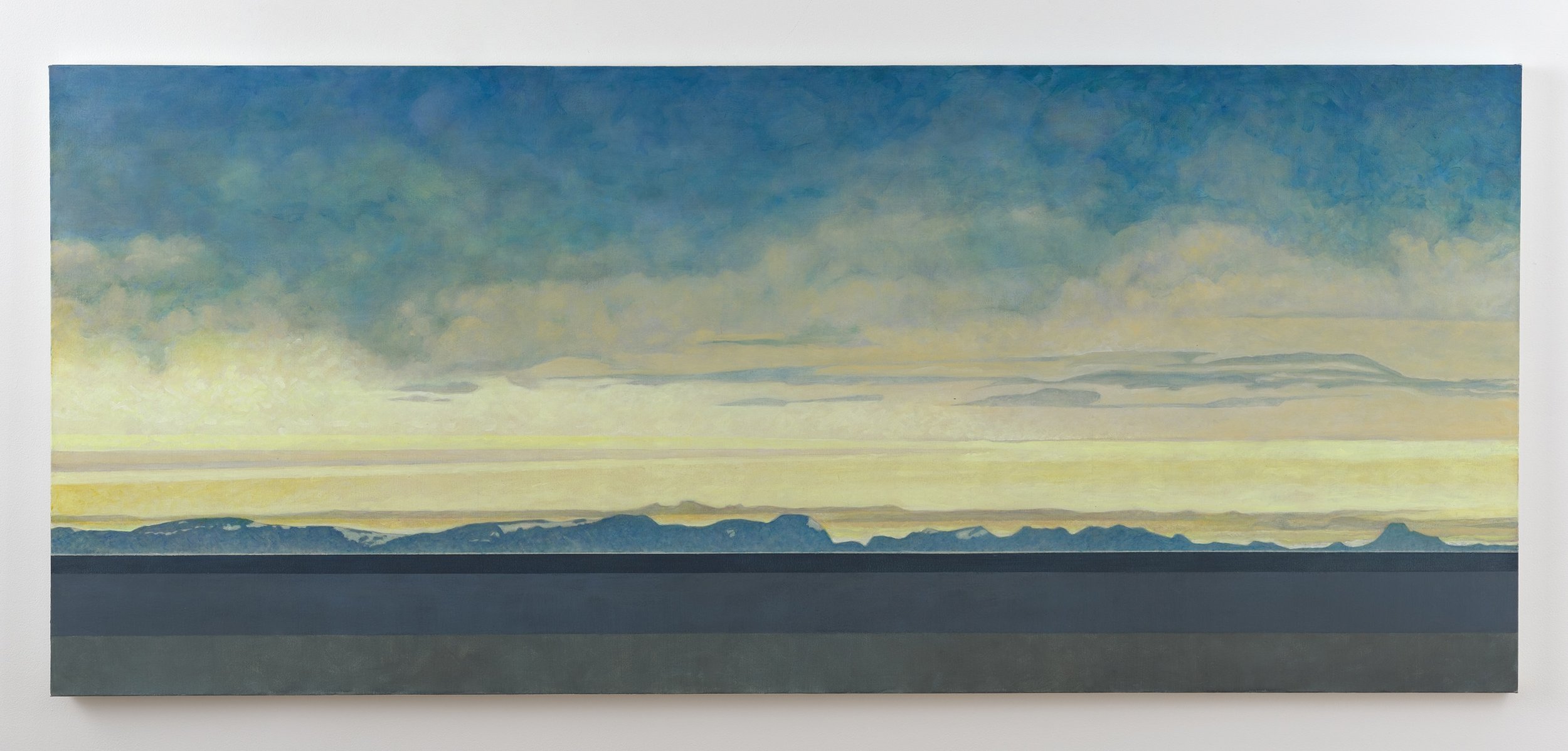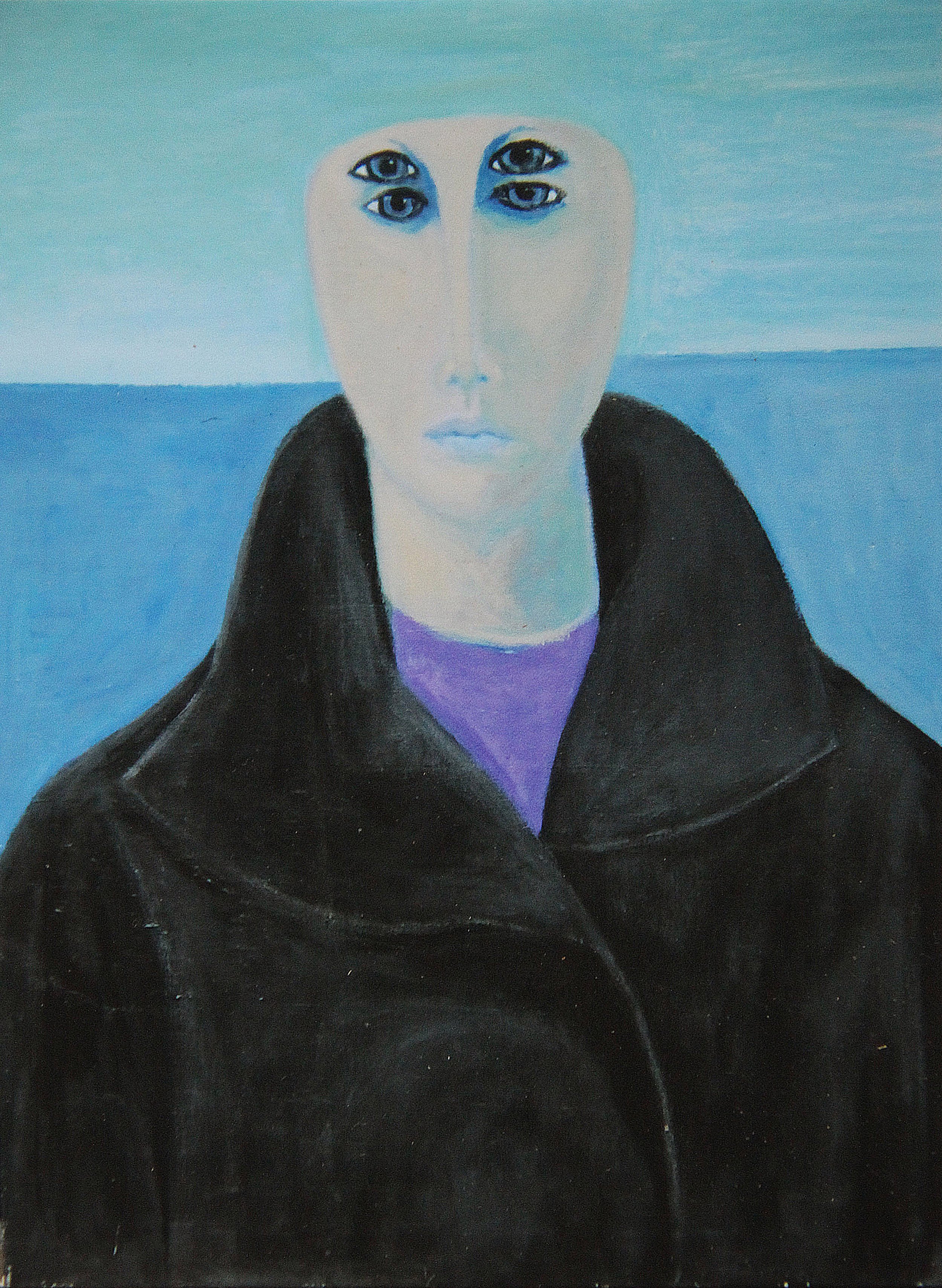Josef Koudelka: Industry
Josef Koudelka: Industry 540 West 25th Street, New York, NY 10001March 29–April 27, 2024 Photography courtesy Pace Gallery
New York – Pace is pleased to present an exhibition of work by Josef Koudelka at its 540 West 25th Street gallery in New York. The exhibition opened on March 29th and will be on view until April 27 of this year. This will be the artist’s first solo show in New York in nearly a decade, bringing together six large-scale panoramas he created between 1997 and 2010 as part of a project titled Industries. The exhibition will also include a display of small-scale, accordion-style maquettes of Mission Photographique Transmanche, Beyrouth Centre Ville, The Black Triangle, Reconnaissance-Wales, Lime Stone, Teatro del Tempo, Camargue, Piemonte, WALL, Ruins, and Solac. This presentation at Pace coincides with the release of Josef Koudelka: Next, the definitive and only authorized biography of the artist, published by Aperture. The book will be available for purchase on-site at the gallery during the run of the exhibition.
Italy, 2004 inkjet print mounted to aluminum 32-7/8" × 100-1/16" (83.5 cm × 254.2 cm), image 36-7/8" × 104-1/16" (93.7 cm × 264.3 cm), paper and mount 44-1/8" × 111-5/16" × 2-1/4" (112.1 cm × 282.7 cm × 5.7 cm), frame Edition 3 of 7, Edition of 7 + 4 APs No. 90259.03
Born in Czechoslovakia in 1938, Koudelka trained as an aeronautical engineer but began photographing Romani people—their everyday lives, their struggles, and their traditions—mainly in central European countries in the early 1960s, making a full-time commitment to photography later that decade. In 1968, he photographed the Soviet invasion of Prague, publishing his works under the initials P.P. (Prague photographer). Koudelka, who was anonymously awarded the Overseas Press Club’s Robert Capa Gold Medal for those photographs, left Czechoslovakia seeking political asylum in England, with assistance from the Magnum Photos cooperative, in 1970. His first book, Gypsies, was released by Aperture in 1975, and he has since produced more than a dozen publications of his work.
Germany, 2010 inkjet print mounted to aluminum 32-7/8" × 100-1/16" (83.5 cm × 254.2 cm), image 36-7/8" × 104-1/16" (93.7 cm × 264.3 cm), paper and mount 44-1/8" × 111-5/16" × 2-1/4" (112.1 cm × 282.7 cm × 5.7 cm), frame Edition 2 of 7, Edition of 7 + 4 APs No. 90257.02
Koudelka’s interest in the social and political dimensions of photography, evident in his earliest bodies of work, would endure through the following decades. He has been working in large-format, panoramic photography since 1986, capturing images of changing landscapes around the world—places that have been reshaped, altered, and in some cases devastated by the effects of industry, time, and war.
Germany, 1997 inkjet print mounted to aluminum 32-7/8" × 100-1/16" (83.5 cm × 254.2 cm), image 36-7/8" × 104-1/16" (93.7 cm × 264.3 cm), paper and mount 44-1/8" × 111-5/16" × 2-1/4" (112.1 cm × 282.7 cm × 5.7 cm), frame Edition 1 of 7, Edition of 7 + 4 APs No. 90260.01
Adopting a semi-nomadic lifestyle in pursuit of documenting these haunting, elegiac scenes, Koudelka produced deeply interconnected bodies of work that speak to the ways that the weight of history lingers within the natural world. During the late 1980s and early 1990s, the artist photographed the Berlin Wall; the streets of Beirut immediately following the Lebanese Civil War; outsized industrialization and pollution in the Black Triangle, a border region between Germany, Poland, and the Czech Republic; the Auschwitz concentration camp in Poland; and other places forever transformed by sociopolitical turmoil, violence, and environmental destruction.
Israel, 2009 inkjet print mounted to aluminum 32-7/8" × 100-1/16" (83.5 cm × 254.2 cm), image 36-7/8" × 104-1/16" (93.7 cm × 264.3 cm), paper and mount 44-1/8" × 111-5/16" × 2-1/4" (112.1 cm × 282.7 cm × 5.7 cm), frame Edition 1 of 7, Edition of 7 + 4 APs No. 90258.01
Also among Koudelka’s famous panoramic projects are his Ruins series, for which he photographed more than 200 archeological sites across Greece, Italy, Libya, Syria, and other countries between 1991 and 2015, and his body of work on Israel’s West Bank Wall, which he created over the course of seven trips to Israel and Palestine between 2008 and 2012. For immediate release “The face of the wounded landscape—it is marked by trouble, by suffering,” Koudelka tells his biographer, Melissa Harris. “It is the same as the face of people who have a difficult life. I am interested in real people, real faces … In this wounded landscape, I admire the fight for survival … Nature is stronger than man.”
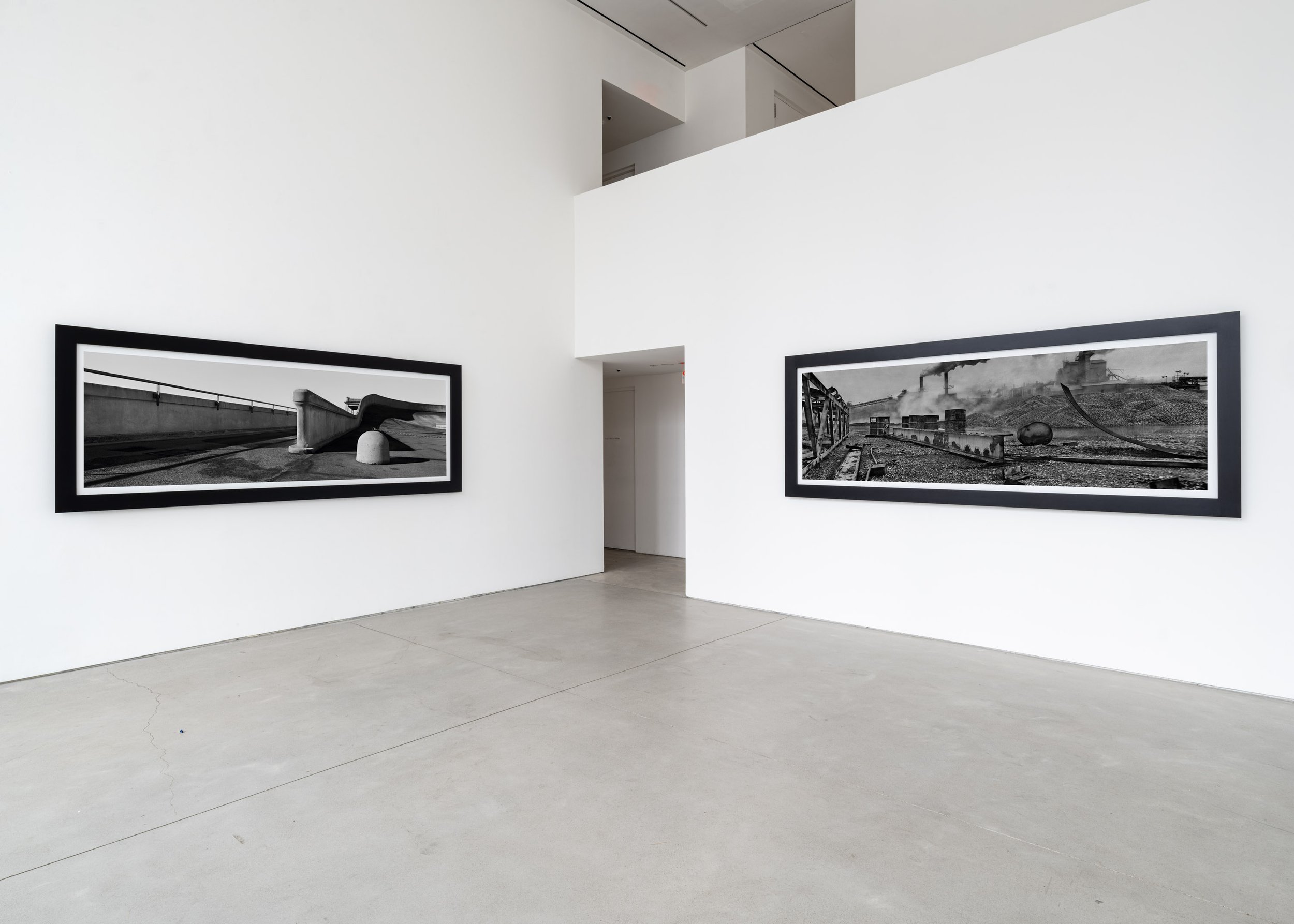
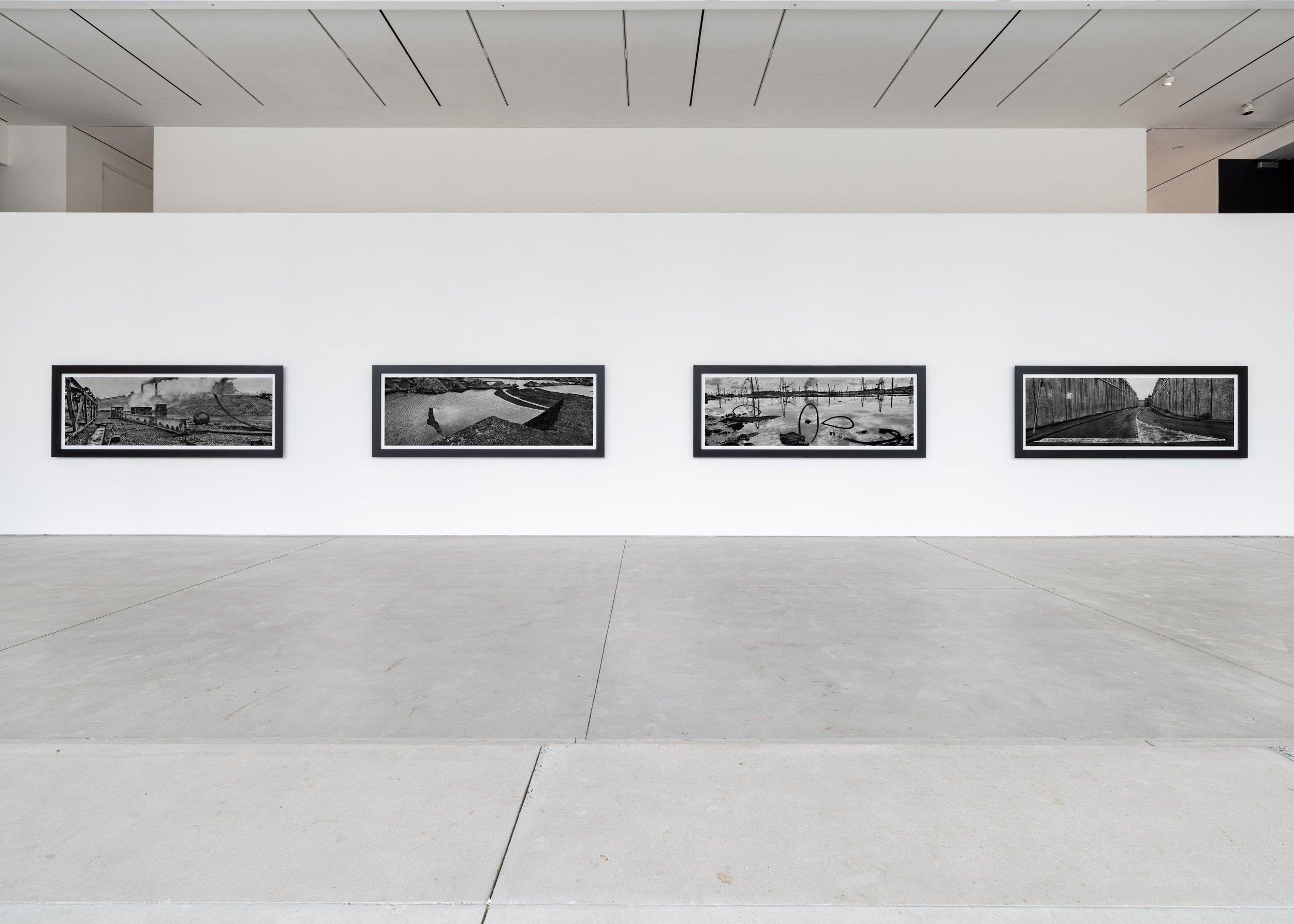
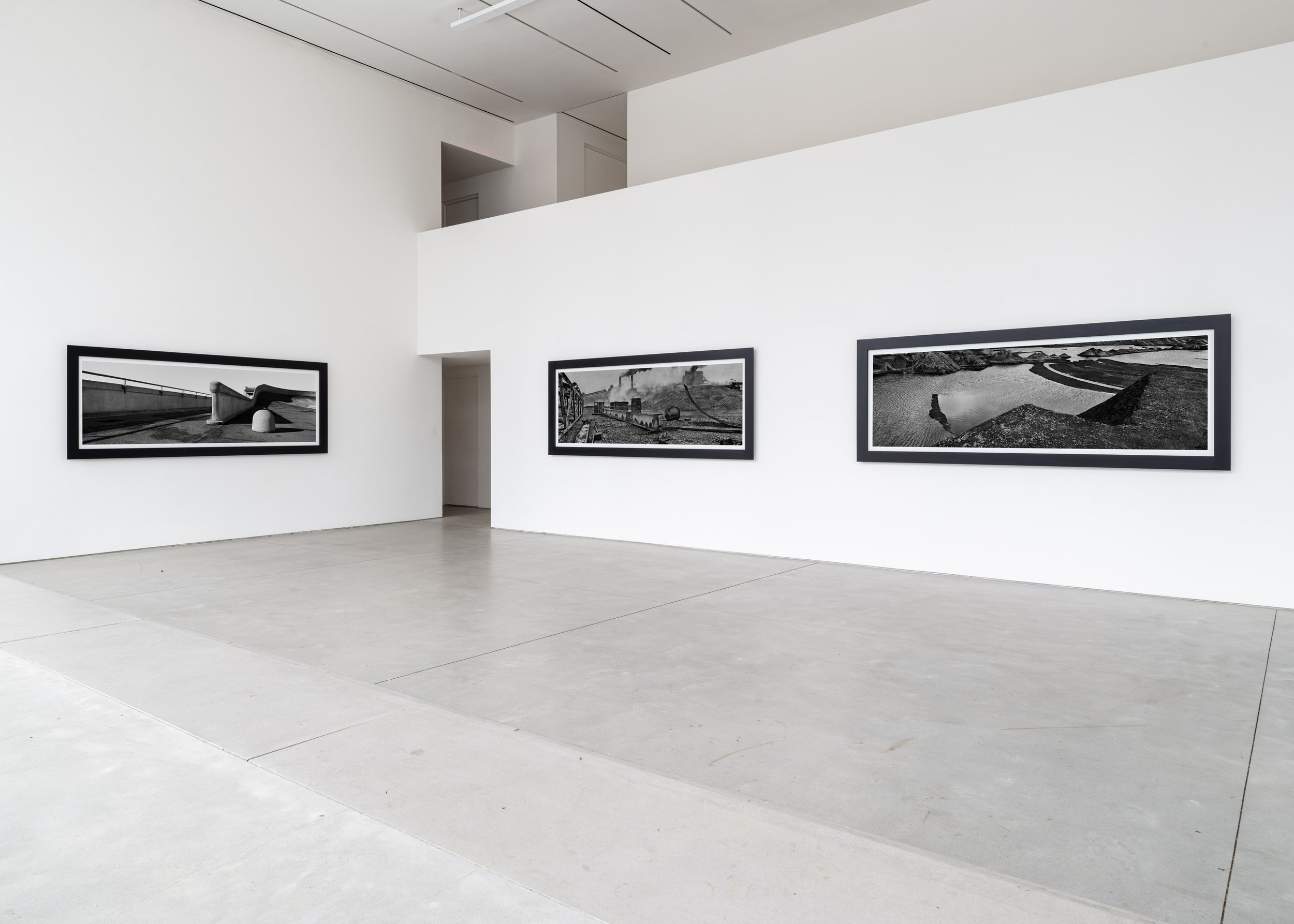
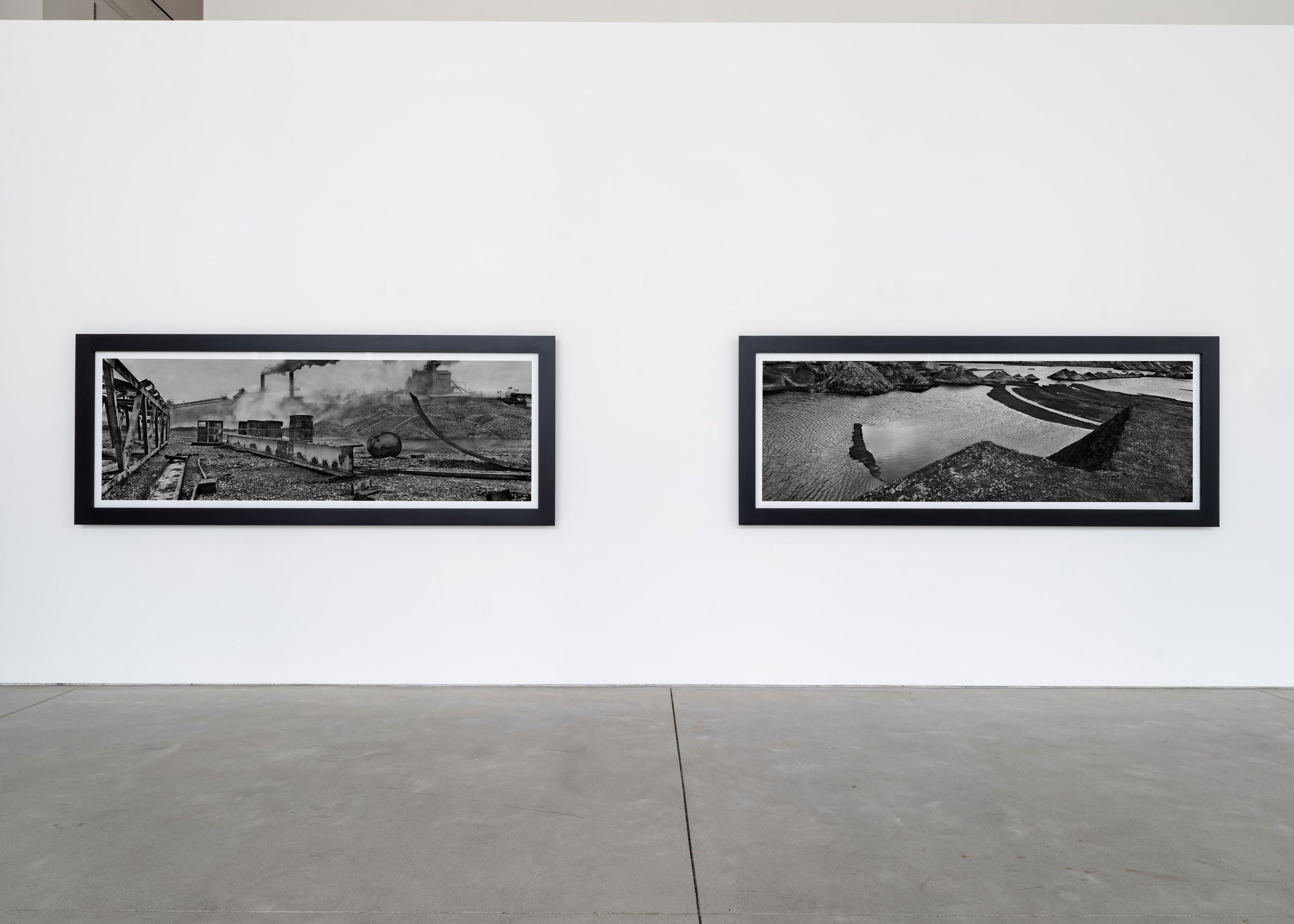
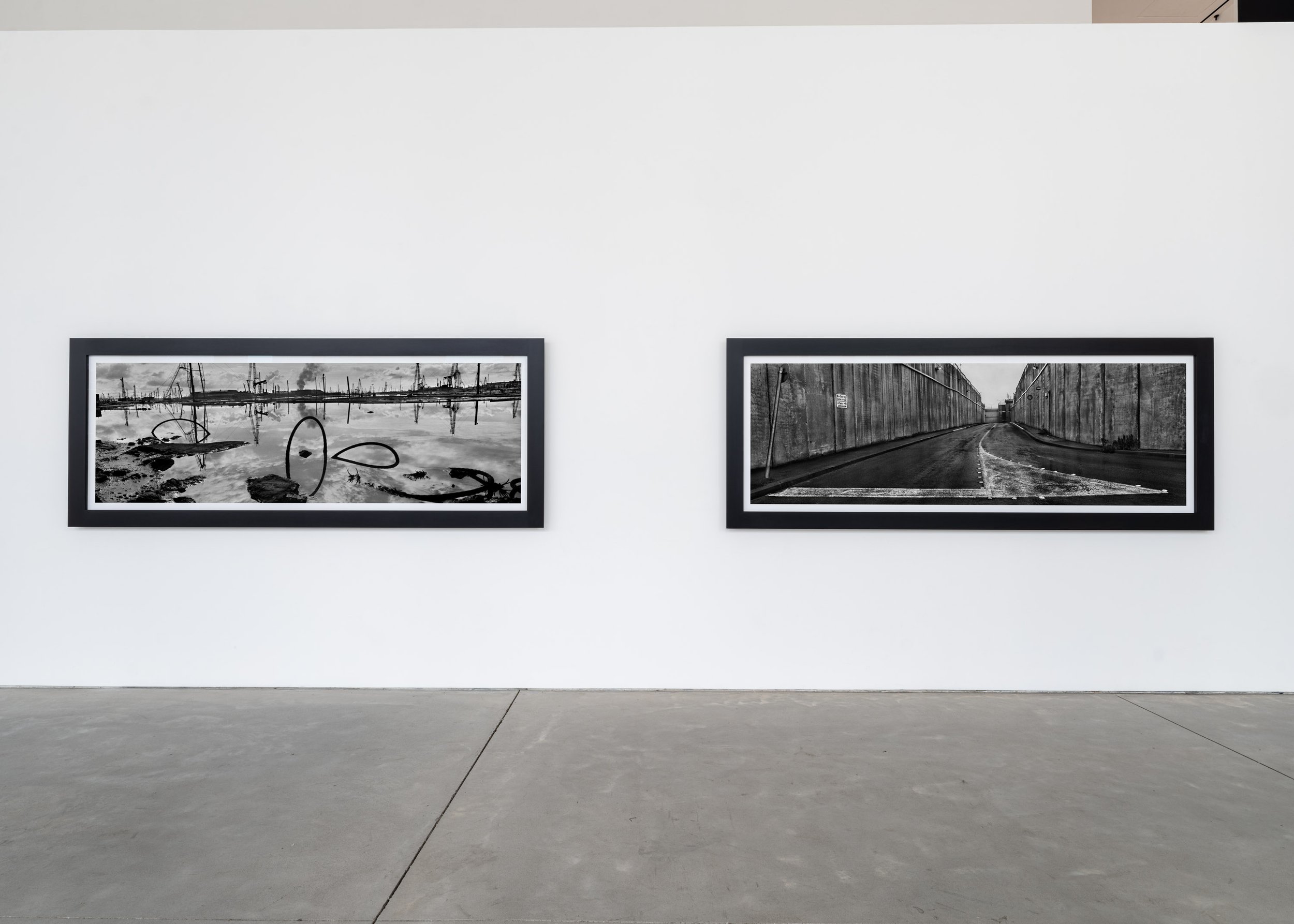
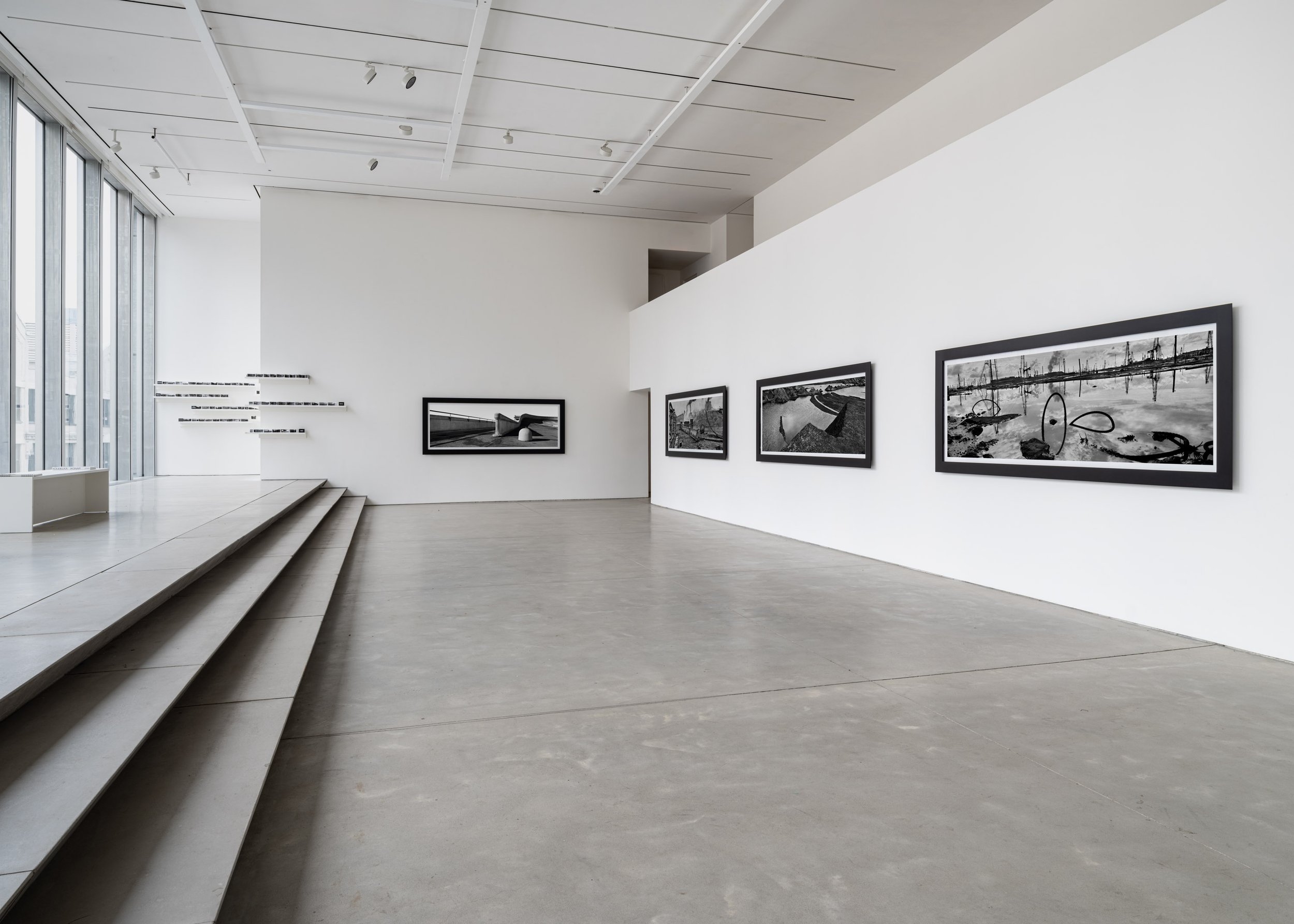
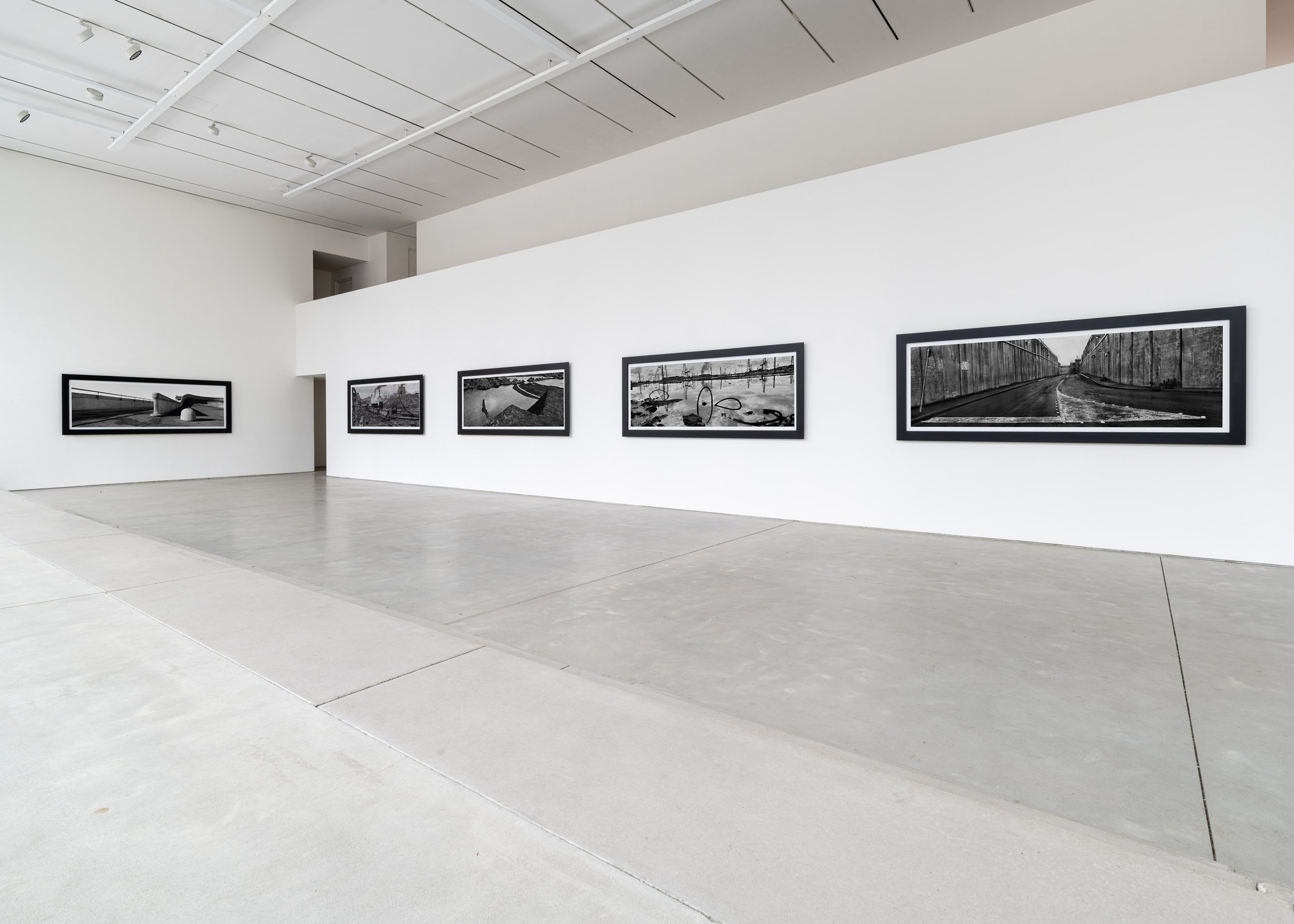
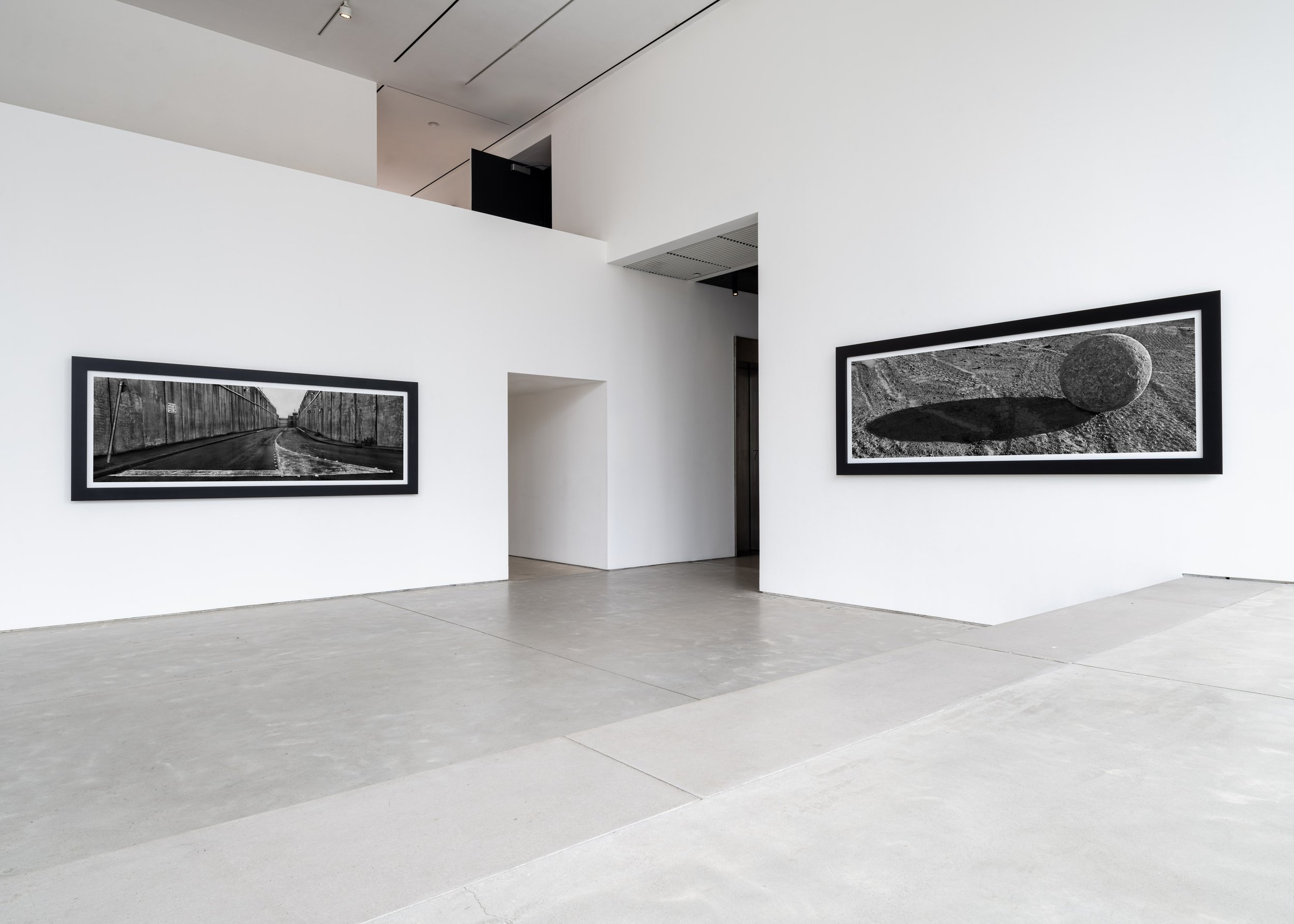
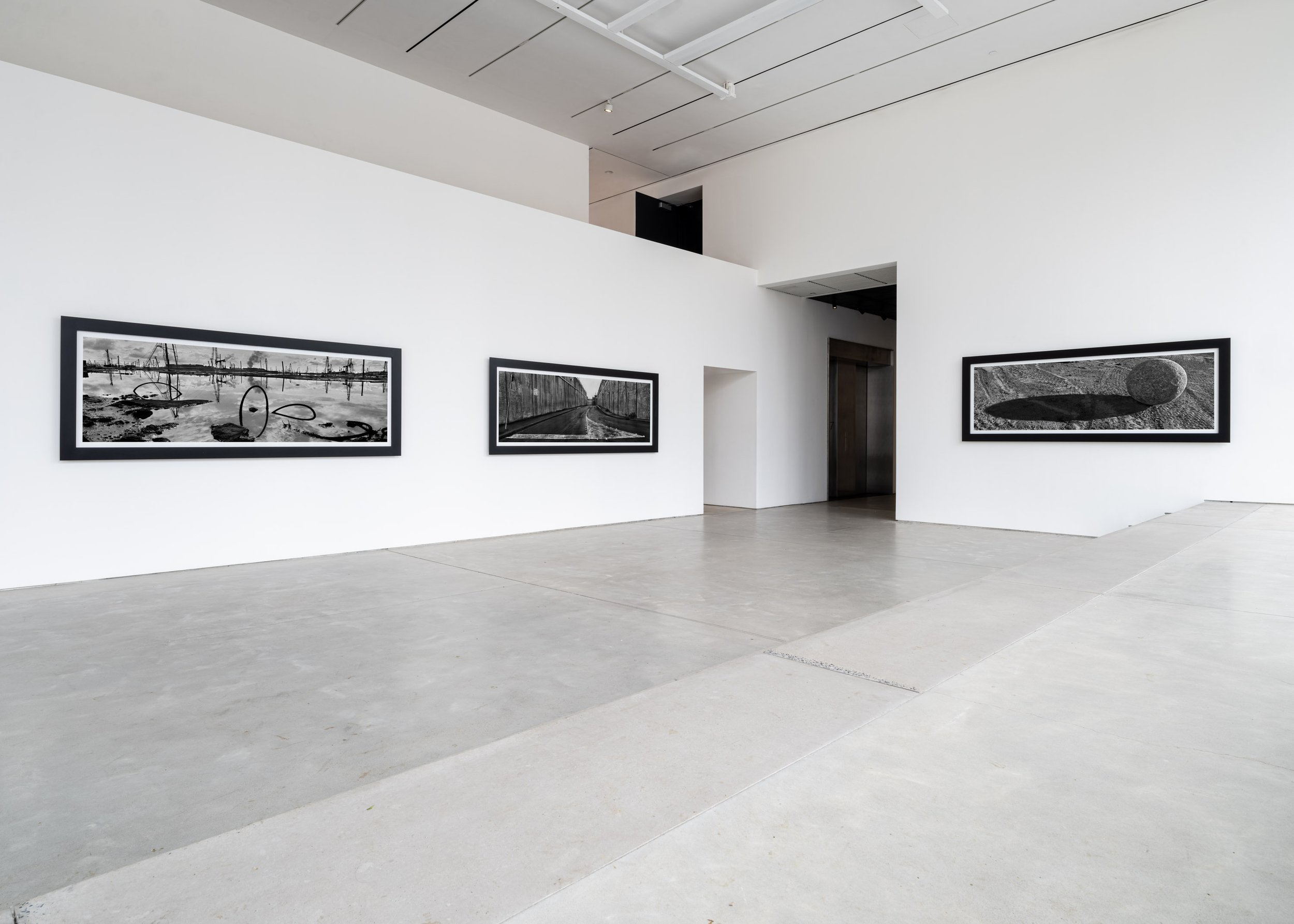
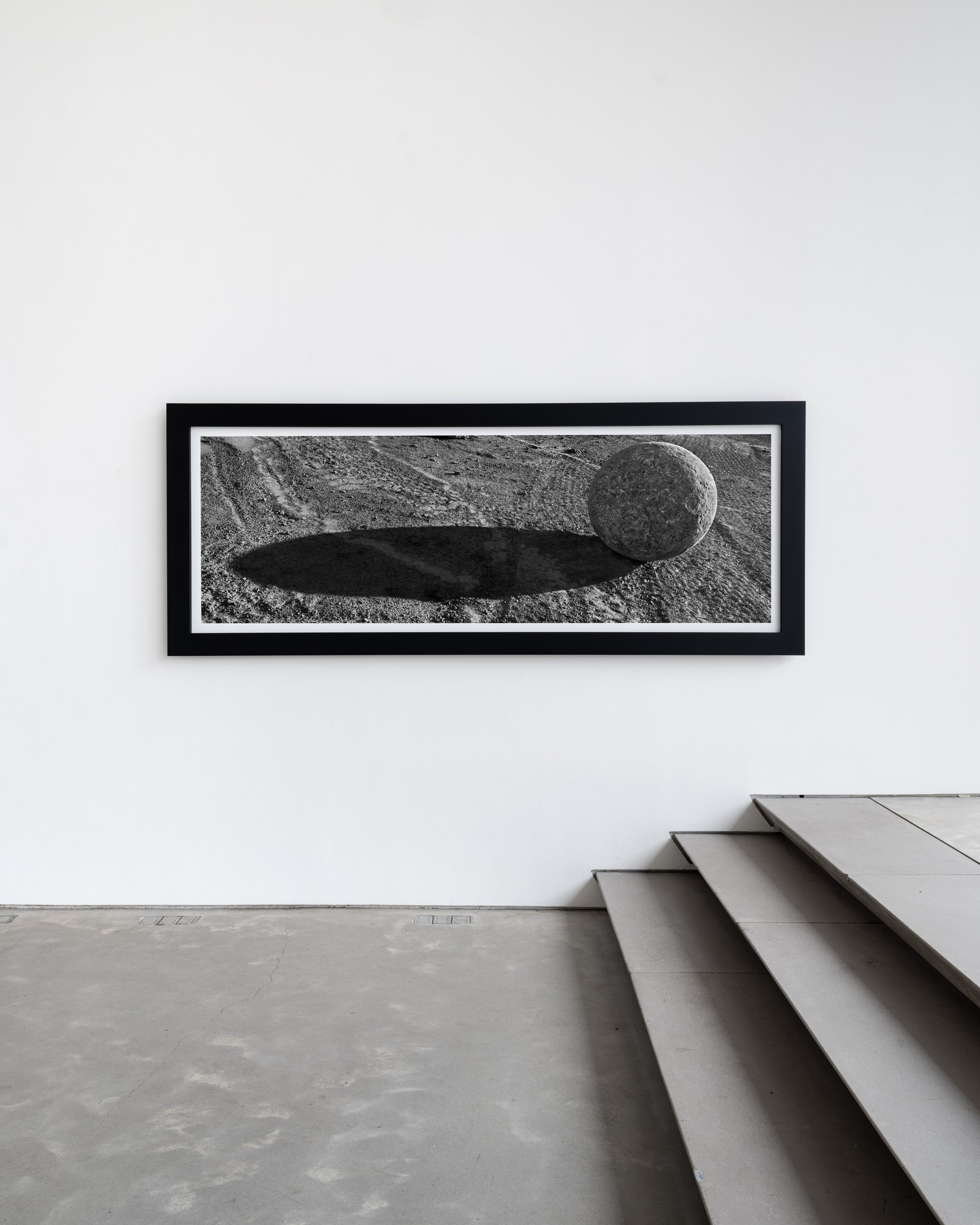
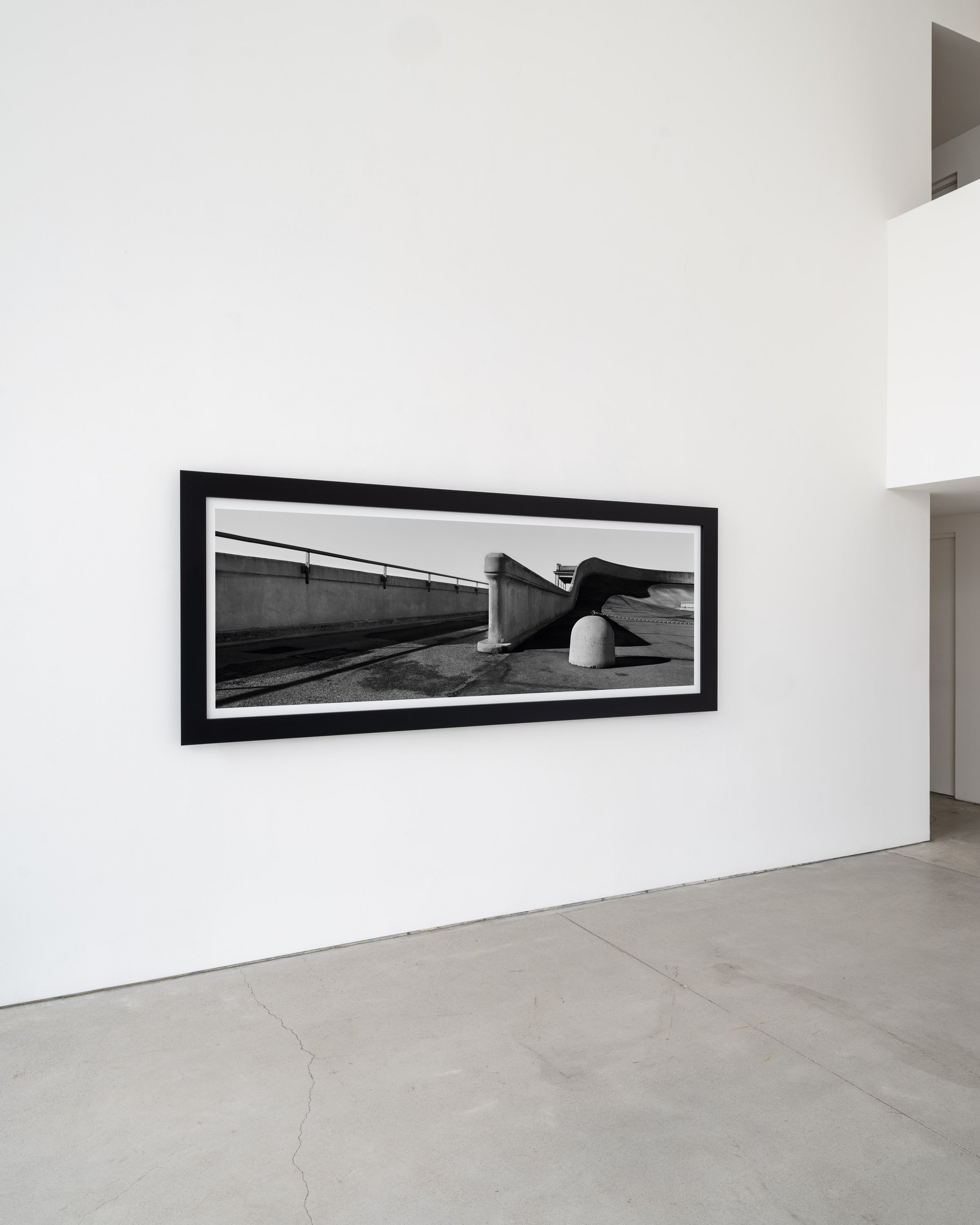
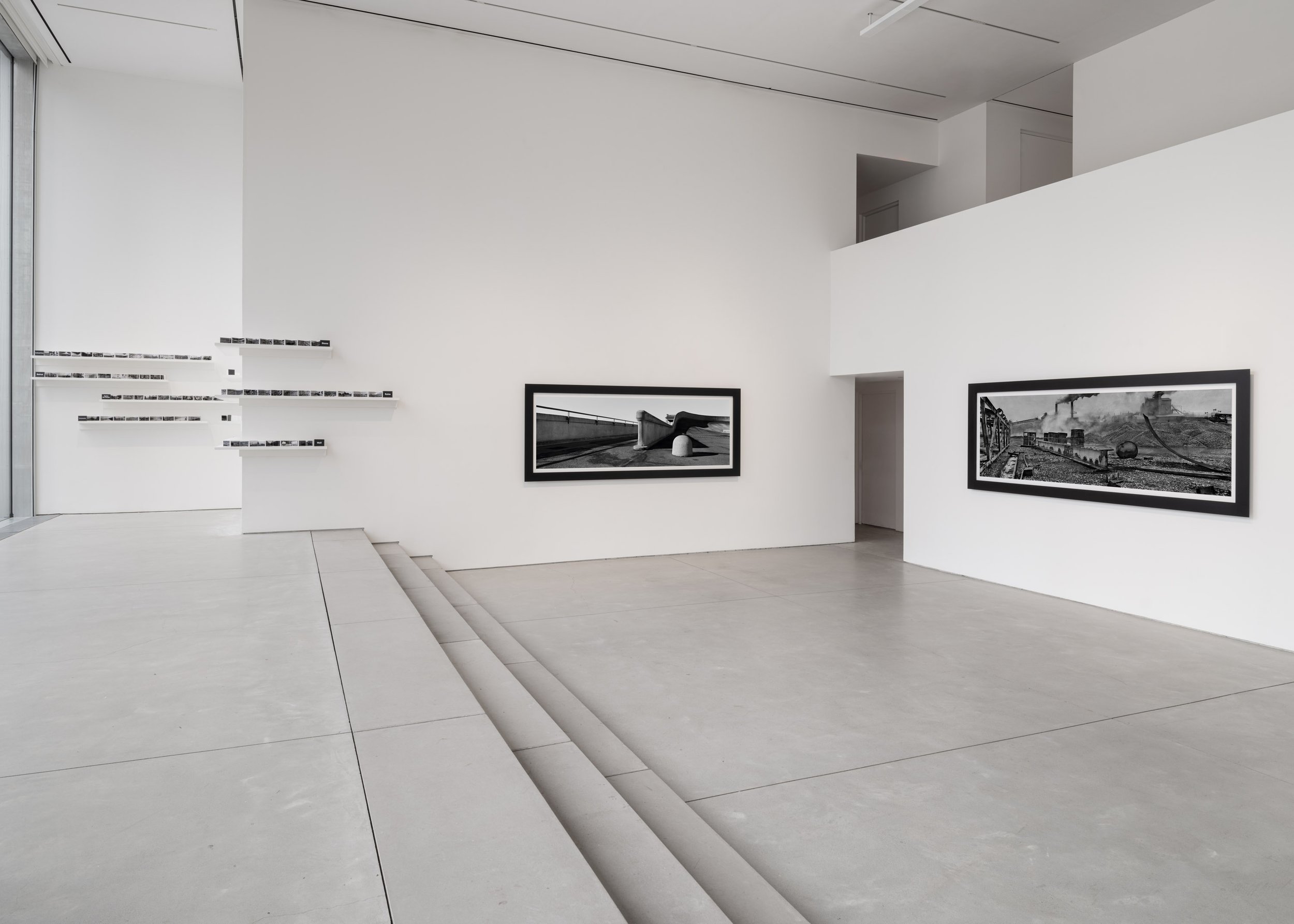
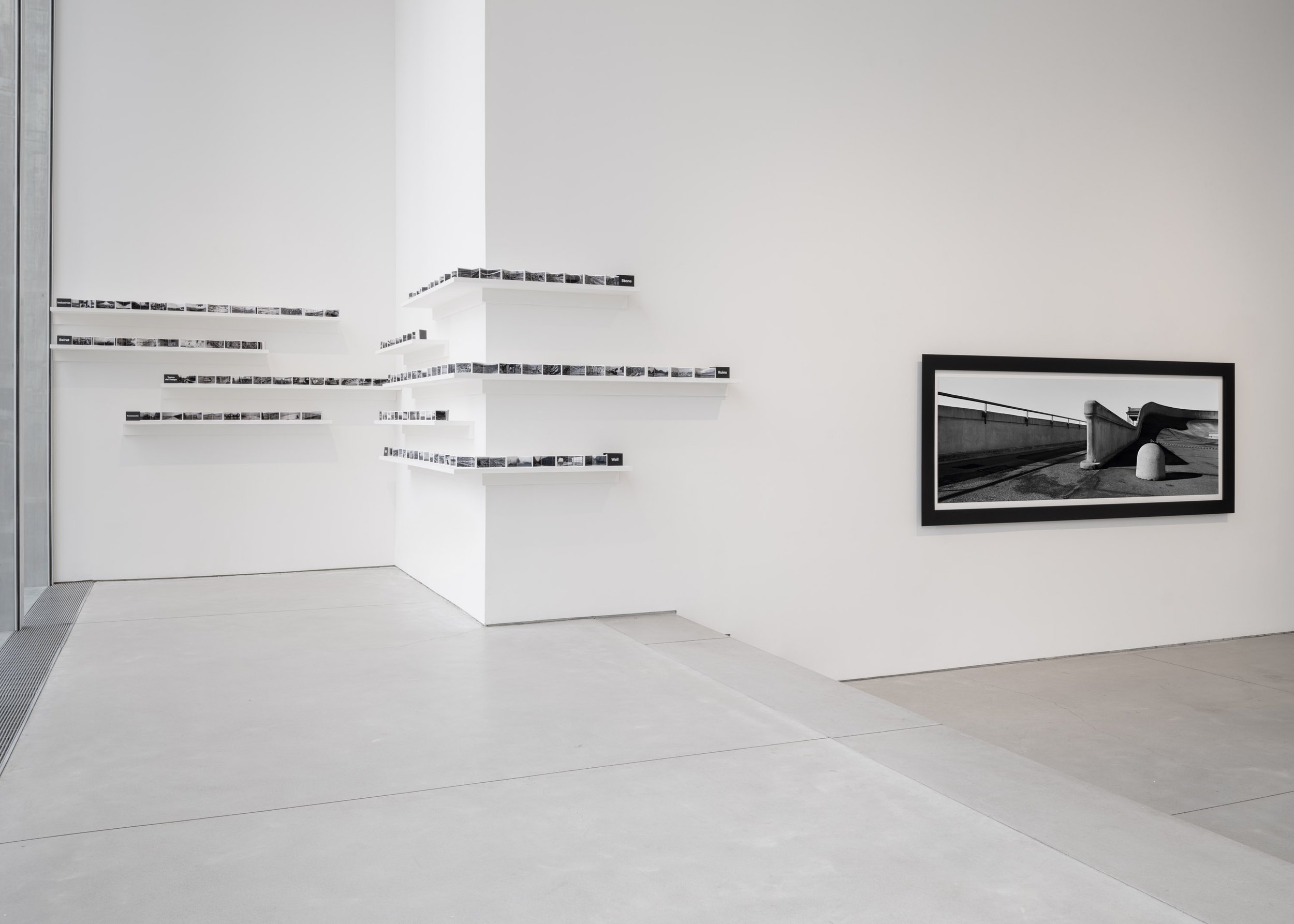
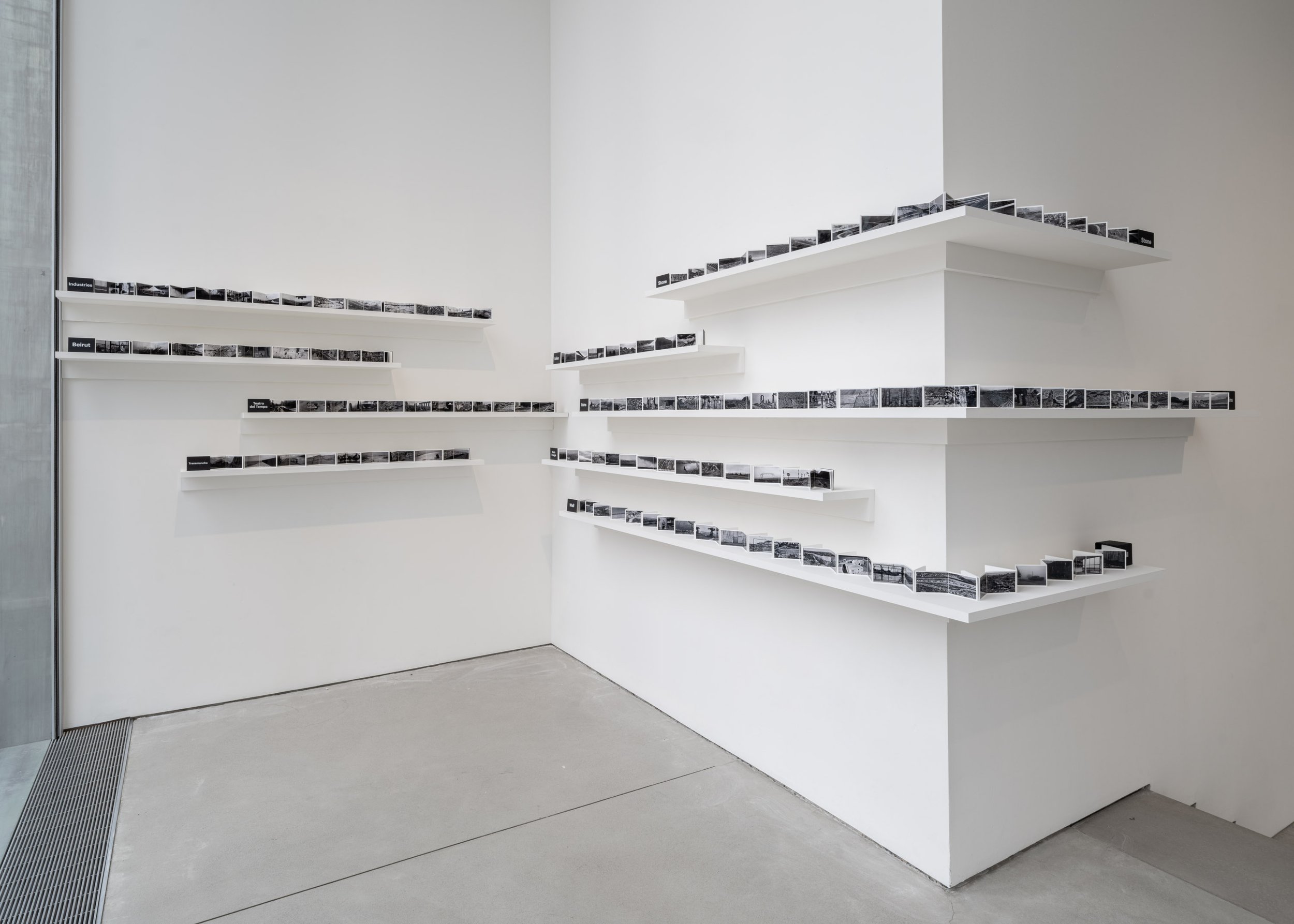
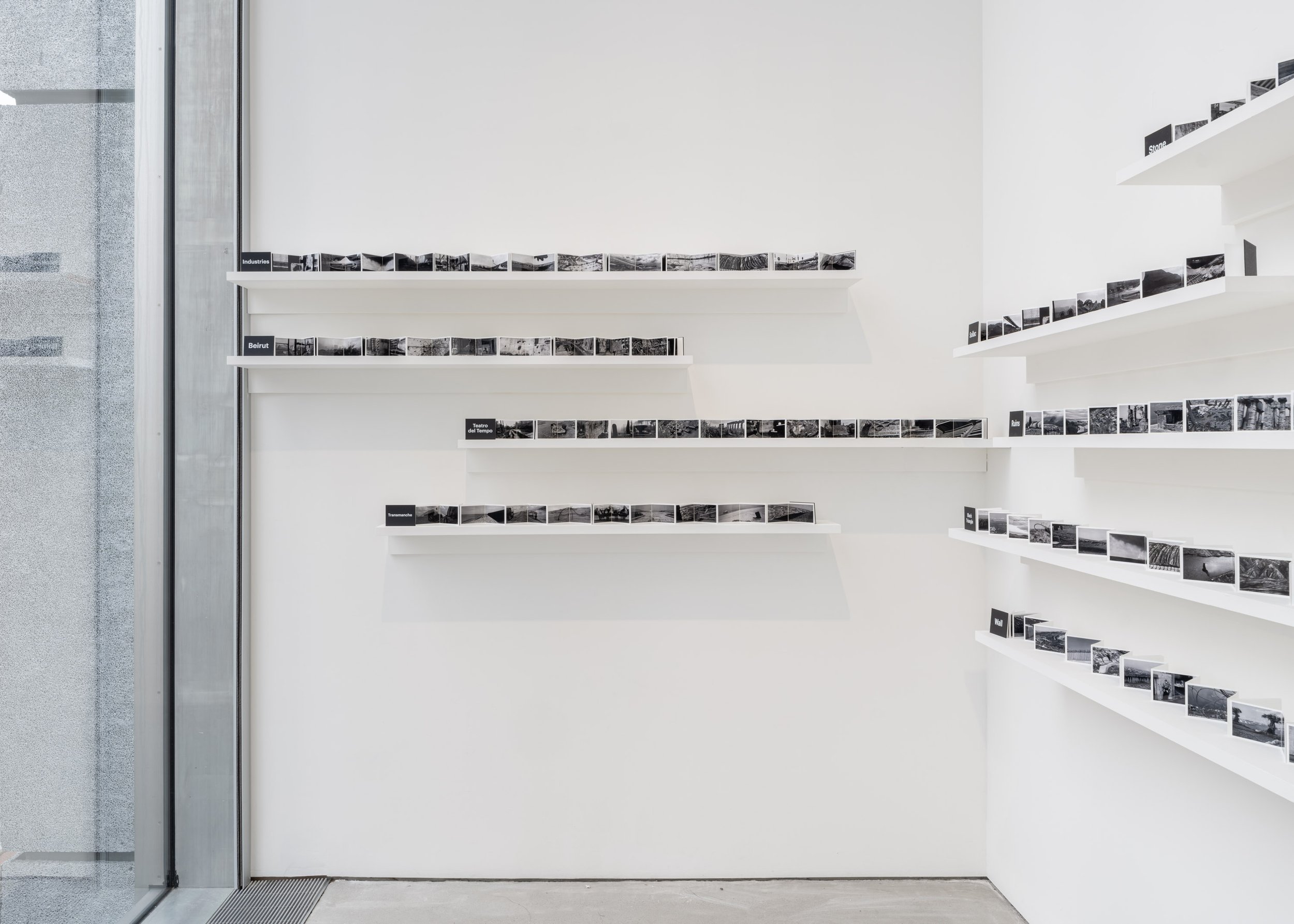
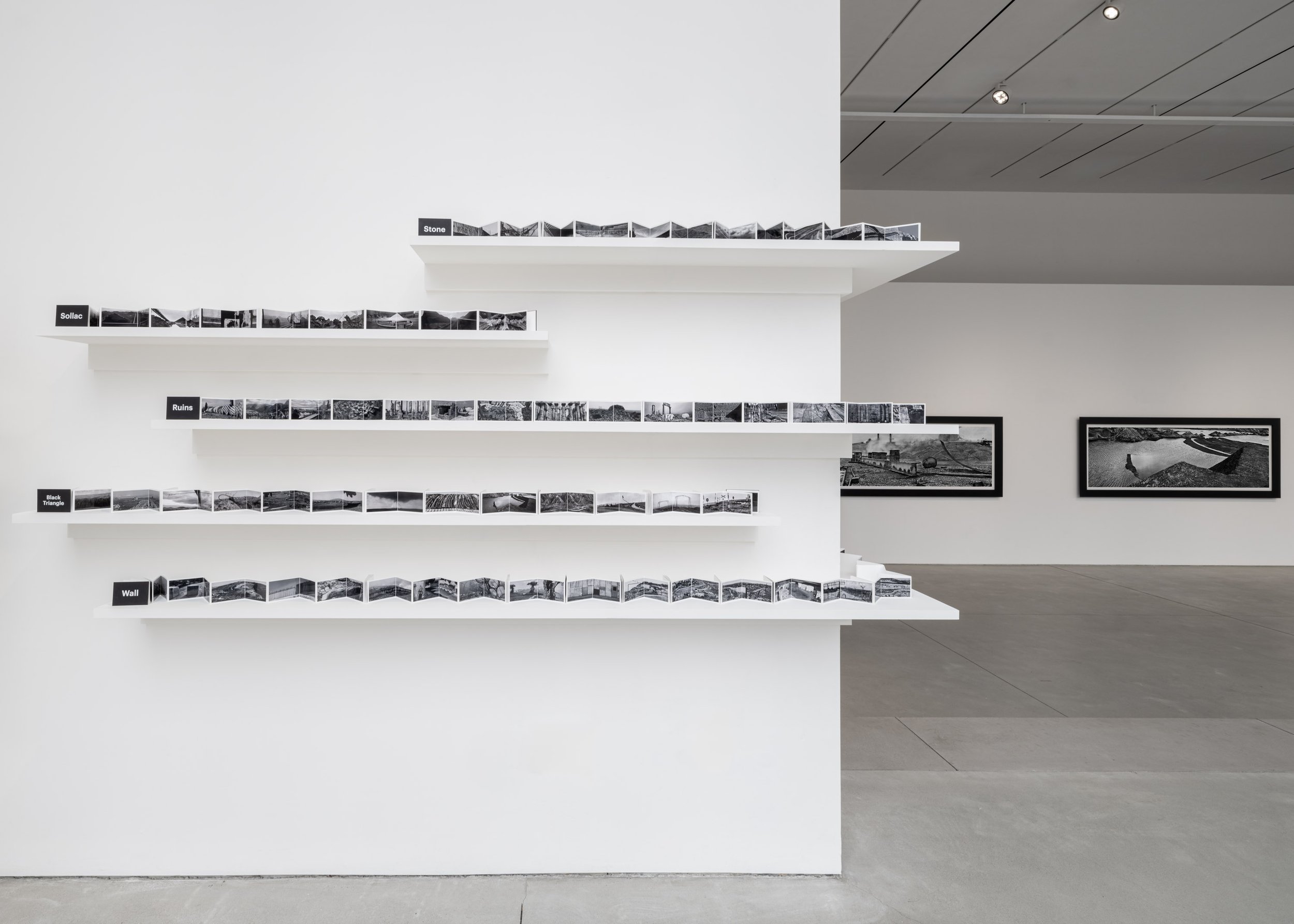

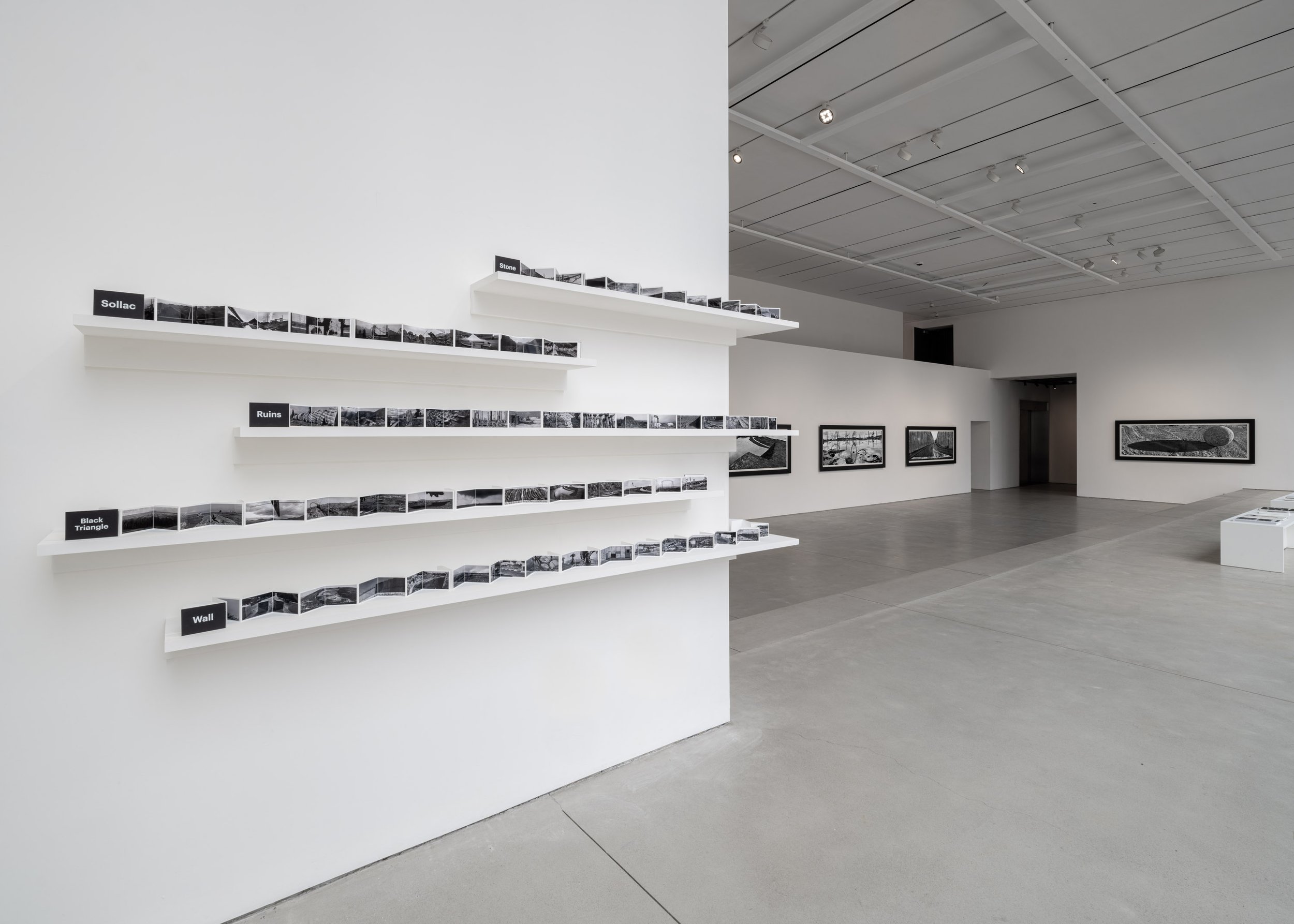
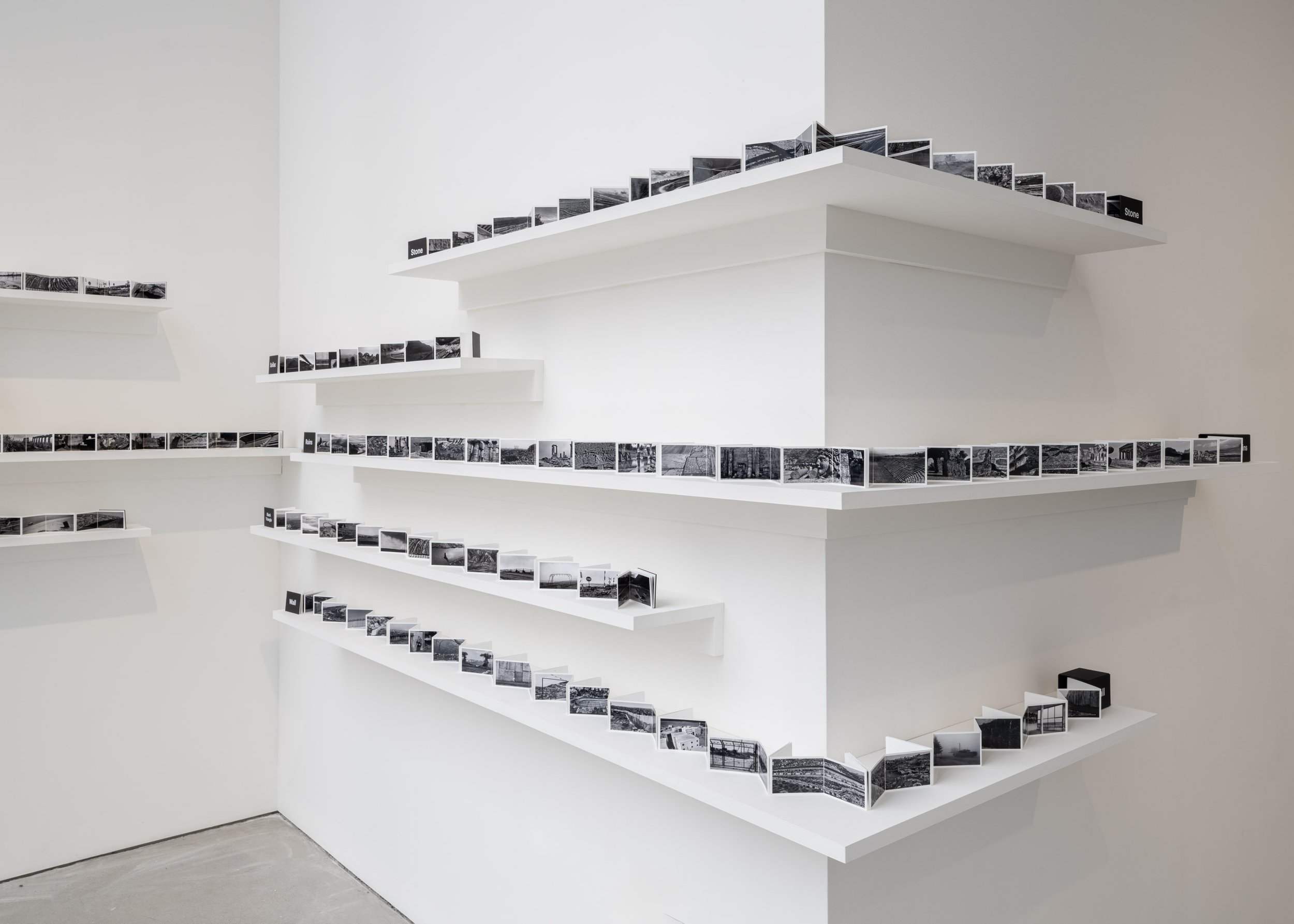
Josef Koudelka: Industry 540 West 25th Street, New York, NY 10001March 29–April 27, 2024 Photography courtesy Pace Gallery
The artist’s upcoming exhibition with Pace in New York, his first solo show in the city since 2015, will be presented on the gallery’s seventh floor against sweeping views of the Chelsea skyline. Measuring some nine feet in width, each of the six monumental panoramas that Koudelka has selected for the exhibition—captured across the United States, Germany, Italy, Azerbaijan, and Israel between 1997 and 2010—tells a different story.
Josef Koudelka (b. 1938) began his career as an aeronautical engineer in Prague and Bratislava, and began photographing stage productions for theater magazines. After documenting gypsy culture in Romania, Slovakia, and Western Europe, he committed to photography full-time in 1967. The following year, Koudelka photographed the Soviet invasion of Prague, publishing his images under the initials "P. P." (Prague Photographer) for fear of reprisal. He was anonymously awarded the Overseas Press Club's Robert Capa Gold Medal for this work in 1969. Since 1986, Koudelka has embraced and employed the expansive compositional format of the panorama. From his commissioned investigation of the French-English region impacted by the Channel Tunnel for La Mission Photographique Transmanche project, to his exploration of the political climate in Israel and Palestine, and his recent documentation of the persistence of classicism along the Mediterranean rim, Koudelka has continuously used panoramic cameras to showcase terrains that have been significantly shaped, altered, and even devastated by the effects of industry, time, and territorial conflict.
Azerbaijan, 1999inkjet print mounted to aluminum32-7/8" × 100-1/16" (83.5 cm × 254.2 cm),image36-7/8" × 104-1/16" (93.7 cm × 264.3 cm),paper and mount44-1/8" × 111-5/16" × 2-1/4" (112.1 cm × 282.7cm × 5.7 cm), frameEdition 4 of 7, Edition of 7 + 4 APsNo. 90256.04
Pace is a leading international art gallery representing some of the most influential contemporary artists and estates from the past century, holding decades-long relationships with Alexander Calder, Jean Dubuffet, Barbara Hepworth, Agnes Martin, Louise Nevelson, and Mark Rothko. Pace enjoys a unique U.S. heritage spanning East and West coasts through its early support of artists central to the Abstract Expressionist and Light and Space movements.
Since its founding by Arne Glimcher in 1960, Pace has developed a distinguished legacy as an artist-first gallery that mounts seminal historical and contemporary exhibitions. Under the current leadership of CEO Marc Glimcher, Pace continues to support its artists and share their visionary work with audiences worldwide by remaining at the forefront of innovation. Now in its seventh decade, the gallery advances its mission through a robust global program— comprising exhibitions, artist projects, public installations, institutional collaborations, performances, and interdisciplinary projects. Pace has a legacy in art bookmaking and has published over five hundred titles in close collaboration with artists, with a focus on original scholarship and on introducing new voices to the art historical canon.
Today, Pace has seven locations worldwide, including European footholds in London and Geneva as well as Berlin, where the gallery established an office in 2023. Pace maintains two galleries in New York—its headquarters at 540 West 25th Street, which welcomed almost 120,000 visitors and programmed 20 shows in its first six months, and an adjacent 8,000 sq. ft. exhibition space at 510 West 25th Street. Pace’s long and pioneering history in California includes a gallery in Palo Alto, which was open from 2016 to 2022. Pace’s engagement with Silicon Valley’s technology industry has had a lasting impact on the gallery at a global level, accelerating its initiatives connecting art and technology as well as its work with experiential artists. Pace consolidated its West Coast activity through its flagship in Los Angeles, which opened in 2022. Pace was one of the first international galleries to establish outposts in Asia, where it operates permanent gallery spaces in Hong Kong and Seoul, along with an office and viewing room in Beijing. In spring 2024, Pace will open its first gallery space in Japan in Tokyo’s new Azabudai Hills development.
For more information about this exhibition and others, please visit the Pace Gallery’s website here. Pace Gallery can be found on Instagram and Artsy, too.
Thomas Nozkowski : Everything in the World
Thomas Nozkowski: Everything in the World540 West 25th Street, New York, NY 10001March 8–April20, 2024 Photography courtesy Pace Gallery
New York – Pace is pleased to present an exhibition of works by Thomas Nozkowski at its 540 West 25th Street gallery in New York which opened on March 8 and will be on view until April 20. Focusing on the artist’s practice during the 1970s and 1980s, this presentation, titled Thomas Nozkowski: Everything in the World, will include the artist’s signature, intimatelyF scaled 16” x 20” canvas compositions alongside several large-scale paintings that have not been publicly exhibited in decades and three painted wood sculptures. The show will be accompanied by a new catalogue produced by Pace Publishing, featuring a new essay by Martin Clark, director of the Camden Art Centre in London.
Untitled (6-36), 1987 PAINTING oil on linen on panel 16" × 20" (40.6 cm × 50.8 cm) 17" × 21" × 1-1/2" (43.2 cm × 53.3 cm × 3.8 cm), framed No. 89583 © Thomas Nozkowski, courtesy Pace Gallery
Over more than four decades, Nozkowski developed a singular approach to painting that rejected established aesthetic conventions.The artist, who died in 2019 at age 75, is known for his richly colored and textured abstractions inspired by his memories, everyday experiences, and encounters in the landscapes surrounding his longtime home in upstate New York. In this way, he developed a distinctive visual language of forms, symbols, and notations grounded in his own reality while defying obvious legibility. Constellations of biomorphic and geometric abstractions become worlds unto themselves, which Nozkowski forged as part of a lengthy and exacting process.
Untitled (4-120), 1986 PAINTING oil on linen on panel 16" × 20" (40.6 cm × 50.8 cm) 17" × 21" × 1-1/2" (43.2 cm × 53.3 cm × 3.8 cm), framed No. 89579© Thomas Nozkowski, courtesy Pace Gallery
In this exhibition of his work, it centers on a hugely formative period of the artist’s career during which he set out specific aesthetic terms for his practice. The show’s title, Everything in the World, brings the relationship between Nozkowski’s abstractions and his daily observations to the fore. Anything and everything in his environment—an object, a surface, a quality of light—could capture his curiosity and attention, becoming the source material for a painting.
Untitled (4-14), 1982 PAINTING oil on linen on panel 16" × 20" (40.6 cm × 50.8 cm) No. 89575 © Thomas Nozkowski, courtesy Pace Gallery
Breaking away from the aesthetics of Minimalism and Abstract Expressionism, the artist embarked on an intensely experimental journey, raising formal and conceptual questions about the expressive potential of abstraction that he would continue revisiting in the decades to come—and that would define his approach for the rest of his life. The 1970s and 1980s also saw major changes in Nozkowski’s personal life, including the birth of his son and the purchase of his first property in New York’s Hudson Valley—a place that would become an enduring inspiration for his work.
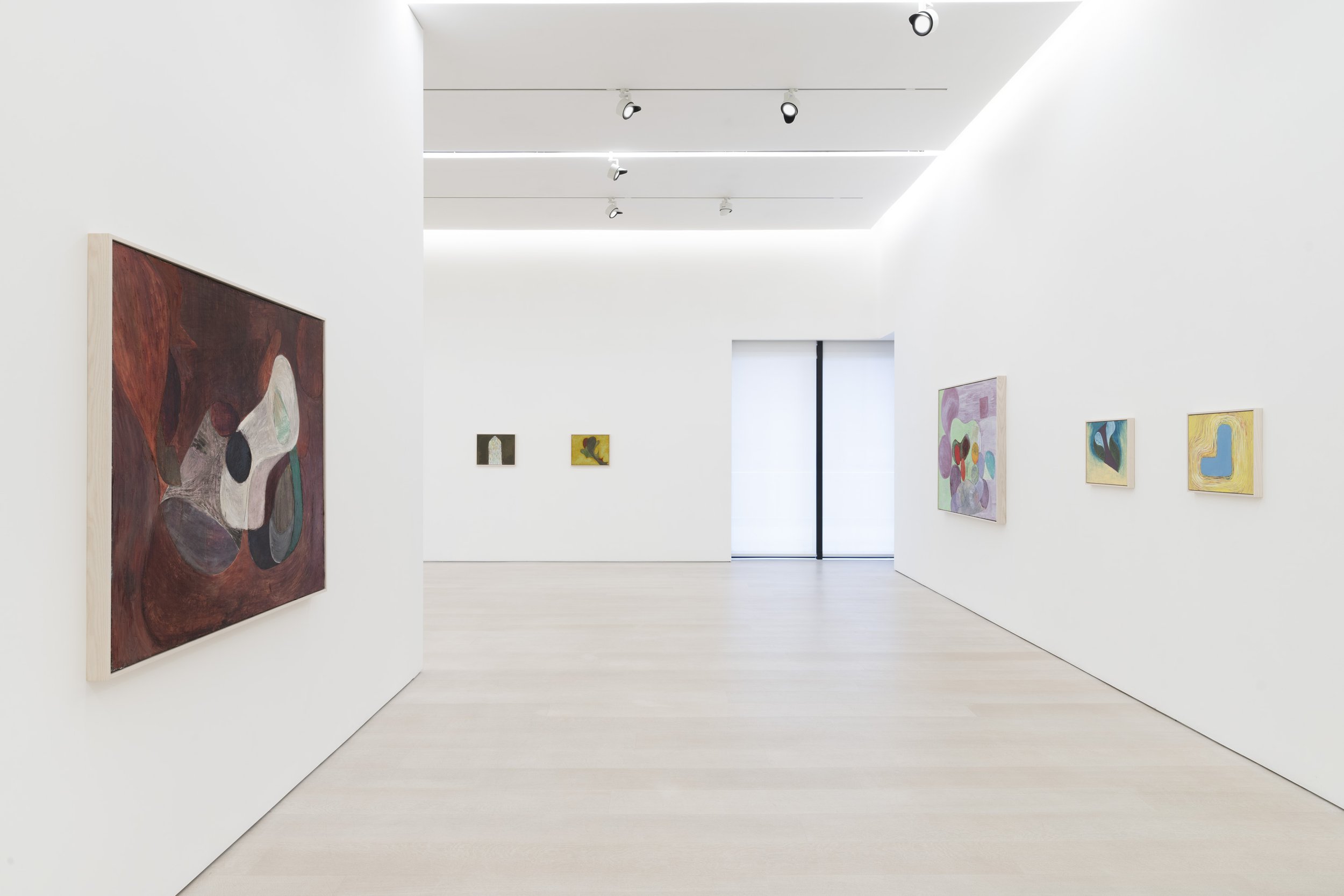


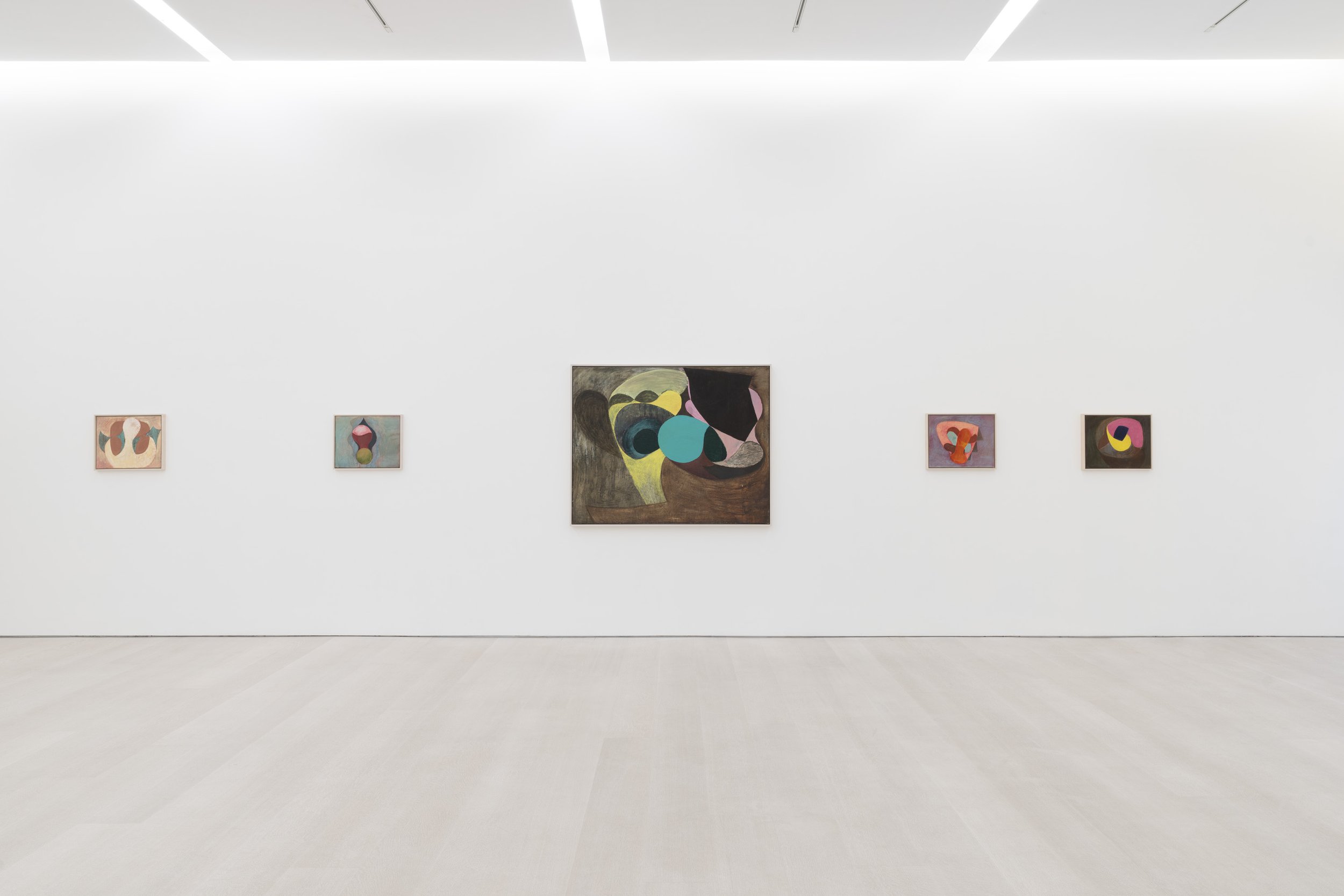
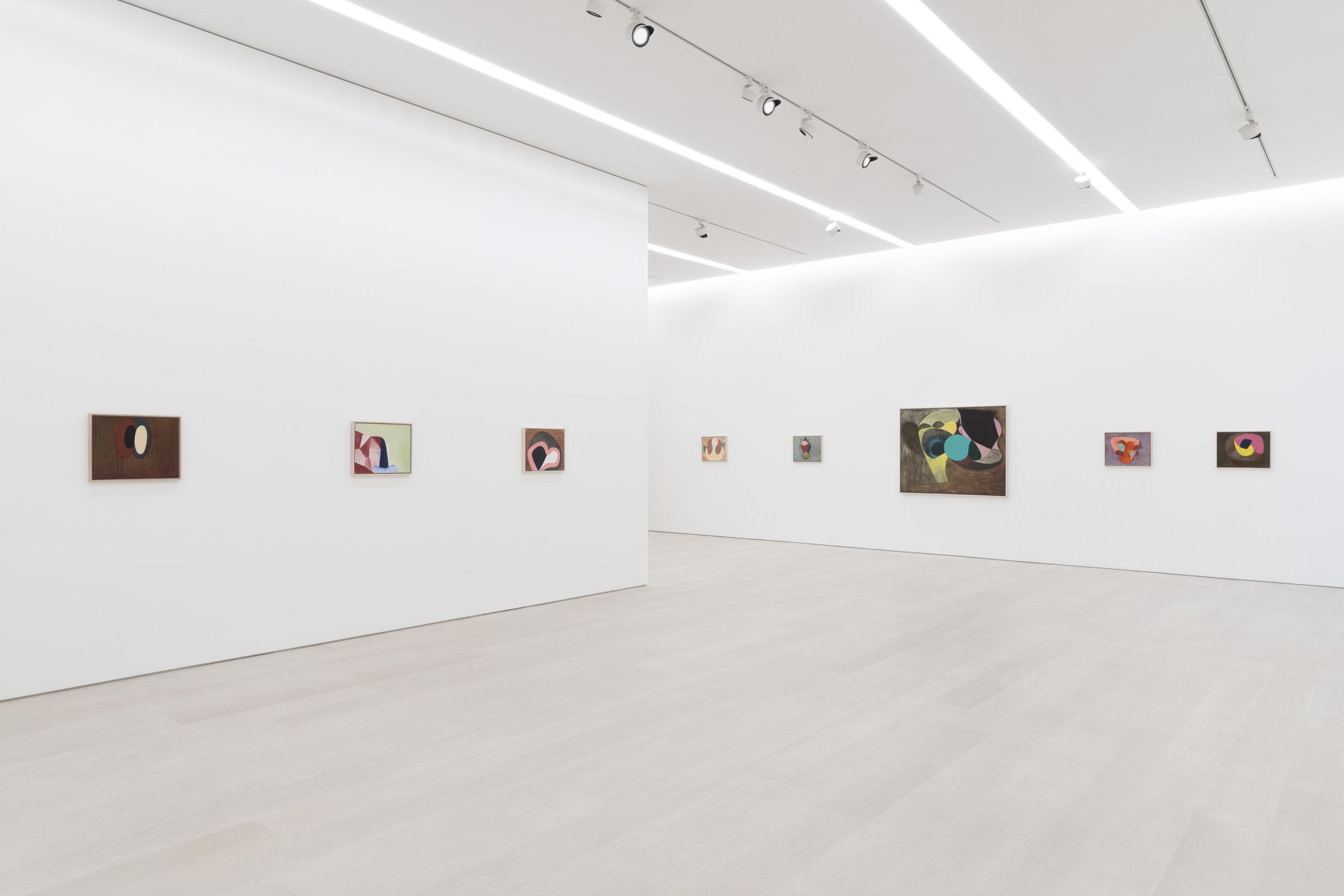
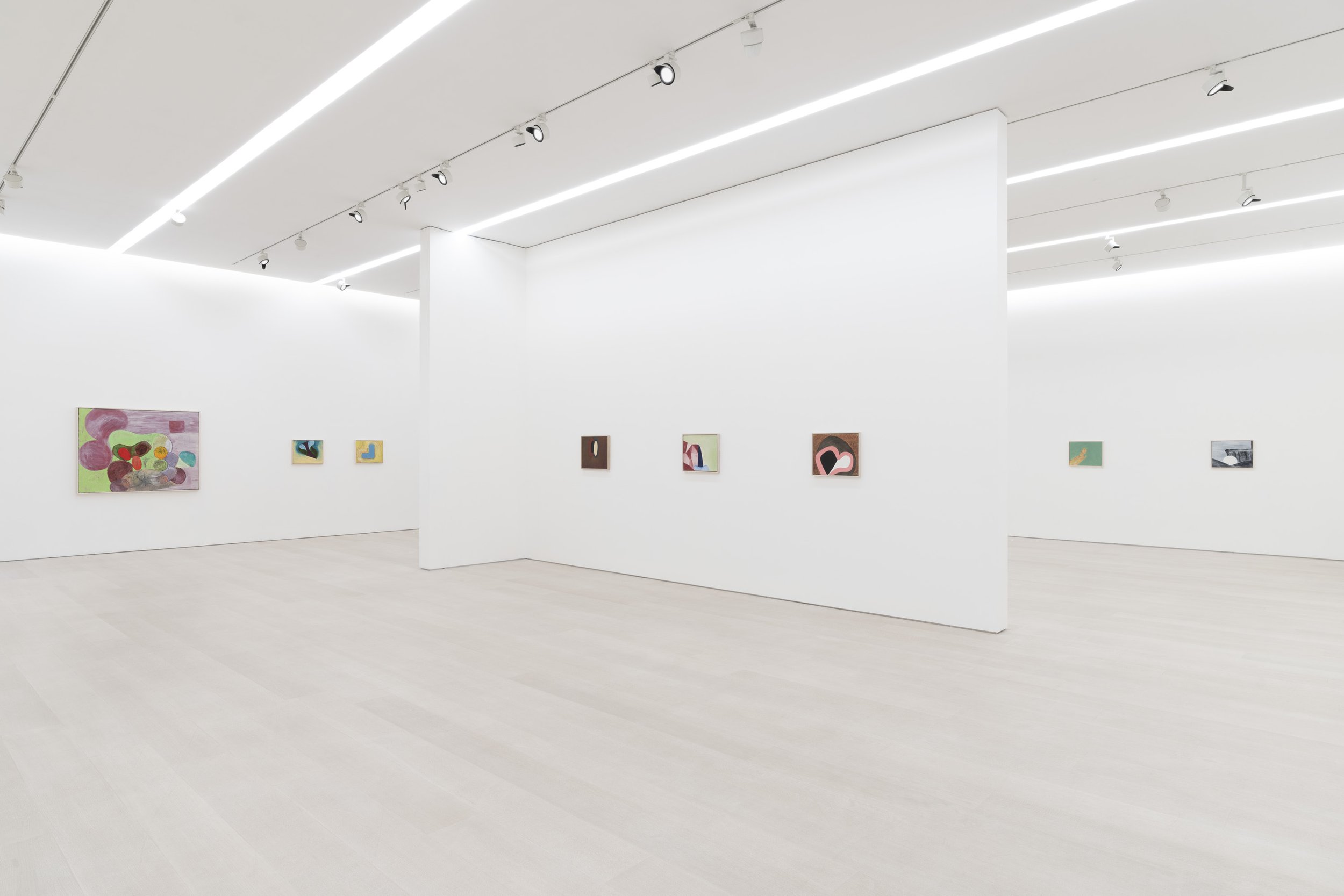
Thomas Nozkowski: Everything in the World 540 West 25th Street, New York, NY 10001March 8–April 20, 2024 Photography courtesy Pace Gallery
The artist made fewer than ten large-scale canvases in his life, and four of these rare works will be exhibited with more than 20 of his classic, small-scale paintings in Pace’s forthcoming show in New York. Three of Nozkowski’s idiosyncratic, conical, painted wood sculptures from 1979 will also figure in the presentation—these objects reflect his interest in the material presence and physicality of paint in its encounters with different surfaces. Together, these works speak to the exploratory ethos that guided Nozkowski over the course of two decades. For immediate release Arriving in New York after the first wave of Abstract Expressionism and during the rise of Pop Art and Minimalism,
Untitled (2-94), 1975 PAINTING oil on linen on panel 16" × 20" (40.6 cm × 50.8 cm) 17" × 21" × 1-1/2" (43.2 cm × 53.3 cm × 3.8 cm) No. 89571© Thomas Nozkowski, courtesy Pace Gallery
Thomas Nozkowski (b. 1944, Teaneck, New Jersey; d. 2019, New York) completed his undergraduate degree in 1967 at Cooper Union. He defied the dismissal of painting at the time, embracing the medium and dedicating himself to an inventive and focused body of work attuned to his subjective experience of the world. His prolific oeuvre reveals an ability to shift between various media, ranging from ballpoint pen and pencil to gouache and oils. Eschewing large-scale formats and resistant to established styles or recurrent motifs, Nozkowski developed a varied and influential artistic practice.
Untitled (2-59), 1979 PAINTING oil paint on canvas board 16" × 20" (40.6 cm × 50.8 cm) 17" × 21" × 1-1/2" (43.2 cm × 53.3 cm × 3.8 cm), framed No. 64470 © Thomas Nozkowski, courtesy Pace Gallery
Pace is a leading international art gallery representing some of the most influential contemporary artists and estates from the past century, holding decades-long relationships with Alexander Calder, Jean Dubuffet, Barbara Hepworth, Agnes Martin, Louise Nevelson, and Mark Rothko. Pace enjoys a unique U.S. heritage spanning East and West coasts through its early support of artists central to the Abstract Expressionist and Light and Space movements.
Since its founding by Arne Glimcher in 1960, Pace has developed a distinguished legacy as an artist-first gallery that mounts seminal historical and contemporary exhibitions. Under the current leadership of CEO Marc Glimcher, Pace continues to support its artists and share their visionary work with audiences worldwide by remaining at the forefront of innovation. Now in its seventh decade, the gallery advances its mission through a robust global program— comprising exhibitions, artist projects, public installations, institutional collaborations, performances, and interdisciplinary projects. Pace has a legacy in art bookmaking and has published over five hundred titles in close collaboration with artists, with a focus on original scholarship and on introducing new voices to the art historical canon.
Today, Pace has seven locations worldwide, including European footholds in London and Geneva as well as Berlin, where the gallery established an office in 2023. Pace maintains two galleries in New York—its headquarters at 540 West 25th Street, which welcomed almost 120,000 visitors and programmed 20 shows in its first six months, and an adjacent 8,000 sq. ft. exhibition space at 510 West 25th Street. Pace’s long and pioneering history in California includes a gallery in Palo Alto, which was open from 2016 to 2022. Pace’s engagement with Silicon Valley’s technology industry has had a lasting impact on the gallery at a global level, accelerating its initiatives connecting art and technology as well as its work with experiential artists. Pace consolidated its West Coast activity through its flagship in Los Angeles, which opened in 2022. Pace was one of the first international galleries to establish outposts in Asia, where it operates permanent gallery spaces in Hong Kong and Seoul, along with an office and viewing room in Beijing. In spring 2024, Pace will open its first gallery space in Japan in Tokyo’s new Azabudai Hills development.
For more information about this exhibition and others, please visit the Pace Gallery’s website here. Pace Gallery can be found on Instagram and Artsy, too.
Delcy Morelos and Ettore Spalletti
Installation view: Delcy Morelos, Ettore Spalletti, “Esa Esquina Soy Yo”, Marian Goodman Gallery, New York, 2023 Courtesy of Delcy Morelos and Marian Goodman Gallery Photo credit: Alex Yudzon
Marian Goodman Gallery in New York is pleased to announce the upcoming exhibition by Delcy Morelos and Ettore Spalletti, which opened Wednesday, March 13, and will be on view through 20 April 2024. The exhibition's opening reception was held on Wednesday, 13 March, from 6 to 8 p.m.
Esa esquina soy yo will present works that span three decades and offer a dialogue between these two artists. The exhibition highlights distinct practices and processes, traversing past and present, bringing to light dual influences and trajectories, from Andean cosmology to explorations of color, geometries and relationship with space. In this exhibition we see their dynamic activation and a sublime transcendence.
In his work, where painting and sculpture merge together, Ettore Spalletti (1940-2019) offers a dialogue between classicism and contemporaneity. In his search for an essential dimension and a new idea of spatiality, there is a constant dialogue with the art of the past and, in particular, with the masters of Italian Renaissance art, from Piero della Francesca to Raffaello. His language eliminates all forms of rhetoric, recovering geometries and archetypal forms according to concepts that clearly distinguish him from Minimal Art.
Installation view: Delcy Morelos, Ettore Spalletti, “Esa Esquina Soy Yo”, Marian Goodman Gallery, New York, 2023 Courtesy of Fondazione Ettore Spalletti; Delcy Morelos and Marian Goodman Gallery Photo credit: Alex Yudzon
Fundamental to his poetics are the transformation of materials (alabaster, onyx, marble) and, above all, the definition of a particular painting technique. The painted surfaces, obtained through multiple layers of color impasto repeated over several days at the same time, following the final abrasion, are characterized by the presence of a certain amount of white pigment that, as it breaks, becomes a source of light. The light that comes from within the work intertwines itself with the variations of natural light that add color to color. Far from being absolutely monochrome, Spalletti’s painted surfaces offer a texture which gives breath to the image.
Color in Spalletti’s works always reveals a depth, just as in the words of Paul Valéry -"Ce qu'il y a de plus profond dans l'homme, c'est la peau”- with which the artist titled his solo exhibition at Galerie Marian Goodman in Paris in 2018. Contrary to contemporary trends, Spalletti spent his life in his native places, loving to call his studio home.
Ettore Spalletti Senza titolo, (grigio chiaro), 2019 Color impasto on board, tapered frame on 4 sides, gold leaf Courtesy of Fondazione Ettore Spalletti and Marian Goodman Gallery Photo credit: Alex Yudzon
Delcy Morelos' indigenous traditions inform her memories of her homeland and its hierarchies of skin, race, land and violence. Invoking a bodily materiality in her layers of paint poured and slowly applied to textile or fabric supports, the artist lets the paint drip, pool and solidify, creating vast pictorial fields that move away from the picture plane and extend to ceramics, textiles and large-scale immersive installations. Her evocative treatment of color suggests both the body and the earth, revealing what is most sacred to the artist and drawing a connection between the body and violence. Morelos' chromatic exploration of the color red, for example, especially in her early works, implies blood and matrilineal force. Taking cues from Andean ancestral traditions, Morelos favors textiles and fabrics and natural materials such as plant and mineral fibers, earth, clay, and soil. Conceiving of a fictional and primordial cosmos, her experiential artworks are made for the human senses and create “an alchemy that awakens different emotions in each person.”
Ettore Spalletti Carte rosa, 1998 Color impasto on panel, painted front and back Courtesy of Fondazione Ettore Spalletti and Marian Goodman Gallery Photo credit: Alex Yudzon
Spalletti's pink diptych, Carte rosa, 1998, is the anchor of the North Gallery space, in dialogue with Morelos' series, Eva, from 2013. The work is made with an impasto of color painted on the front and back of two slender wooden paper panels that move in response to atmospheric shifts. The color pink is, as the artist tells it, the color of the human skin "which never has a fixity of its own but is continually transformed through the mood we experience." Next to these, Morelos' work, Eva, 2013, extends into three-dimensional space and volumetric form. A fabric structure, suspended in space, stands across from of a series of works, Eva. 1-10, 2013. Objectively geometric, they are made with clay, brick dust and binder on cotton weave, with earth tones that recall soil and color, life and the female body. As Morelos said, the earth contains in its womb the very cycles of life, death and rebirth, and is a feminine deity.
Delcy Morelos Eva, 2013 Clay, brick dust, and acrylic binder on cotton weave Courtesy of Delcy Morelos and Marian Goodman Gallery Photo credit: Alex Yudzon
In the North Gallery Viewing Room, a series of works by Morelos made with thick layers of acrylic on cotton thread, titled The Double Negation (La doble negación), 2008, bring the minimalist grid closer to the dense tactility of paint droplets, which serve to structure the surfaces of the lattice works. In the center of the room is Spalletti's Colonna, portacipria, 2016: a circular form of pink onyx, concealing within it a powder of the same color, rests on a white marble column, a form dear to Spalletti, which has spanned the entire history of art and architecture.
In the South Gallery is Senza titolo, azzurro, 1990, with its three-sided bull frame. Light blue for Spalletti, as the artist put it, is "an atmospheric color, in which we are continually immersed, it is the color of the sky [...] ours is a sky of meditation, when you take a walk by the sea towards evening the line of the horizon is no longer visible, the sea joins the sky. You feel that space never ends, there is no image, but if you try to pierce the blue with a finger, what do you find? You are in contemplative reality. I think of Beato Angelico." Mobile, 1994, a sculpture painted in a different shade of pink than the Carte rosa in the North Gallery space, offers an example of Spalletti's research into the relationship between sculpture and spatiality. The three-dimensional volume, placed in mid-air, seems to come out the wall and interacts with Senza titolo (grigio chiaro), 2019, whose profile is animated by a girandola frame on the four sides characterized by the use of gold leaf.
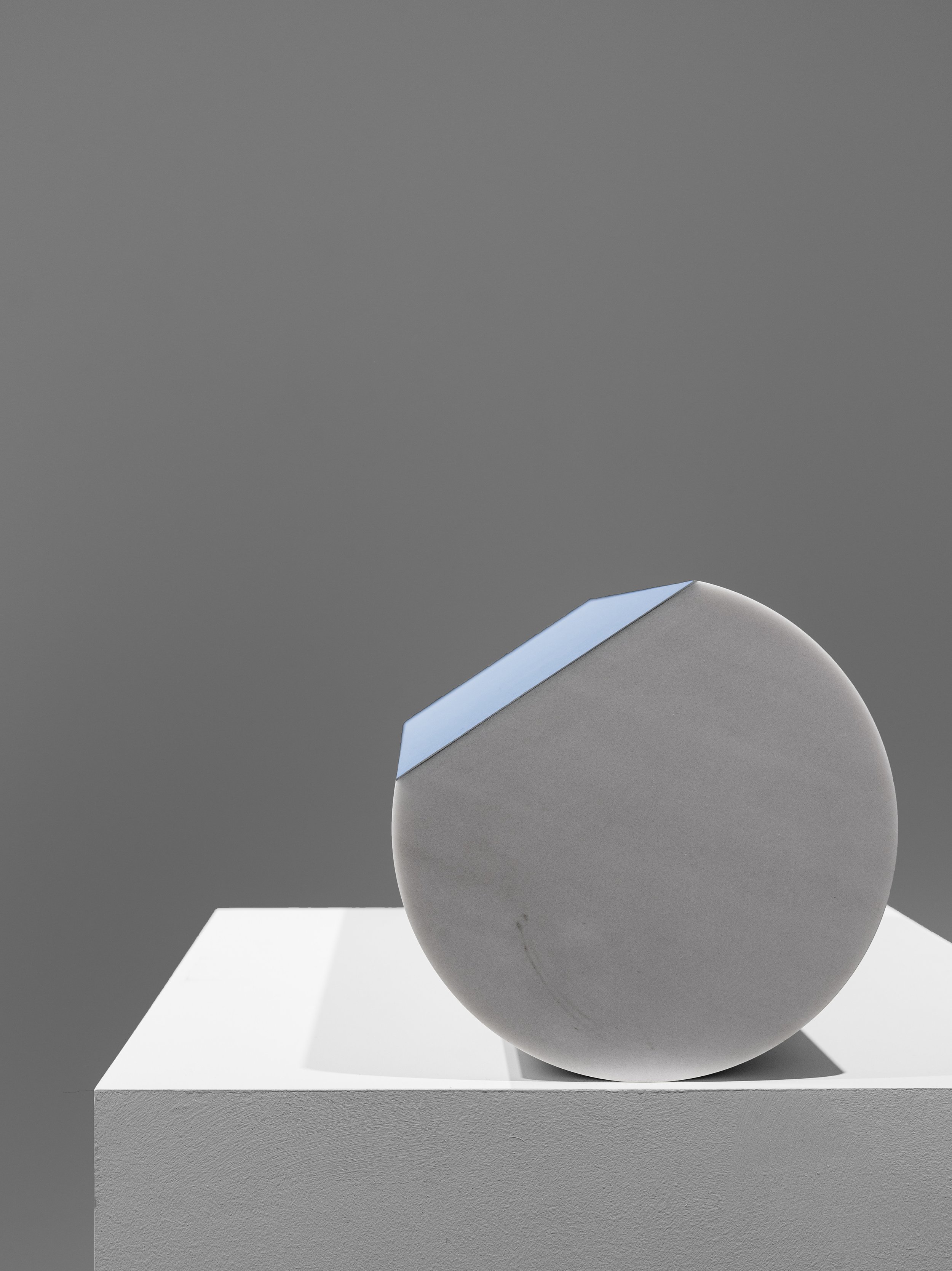
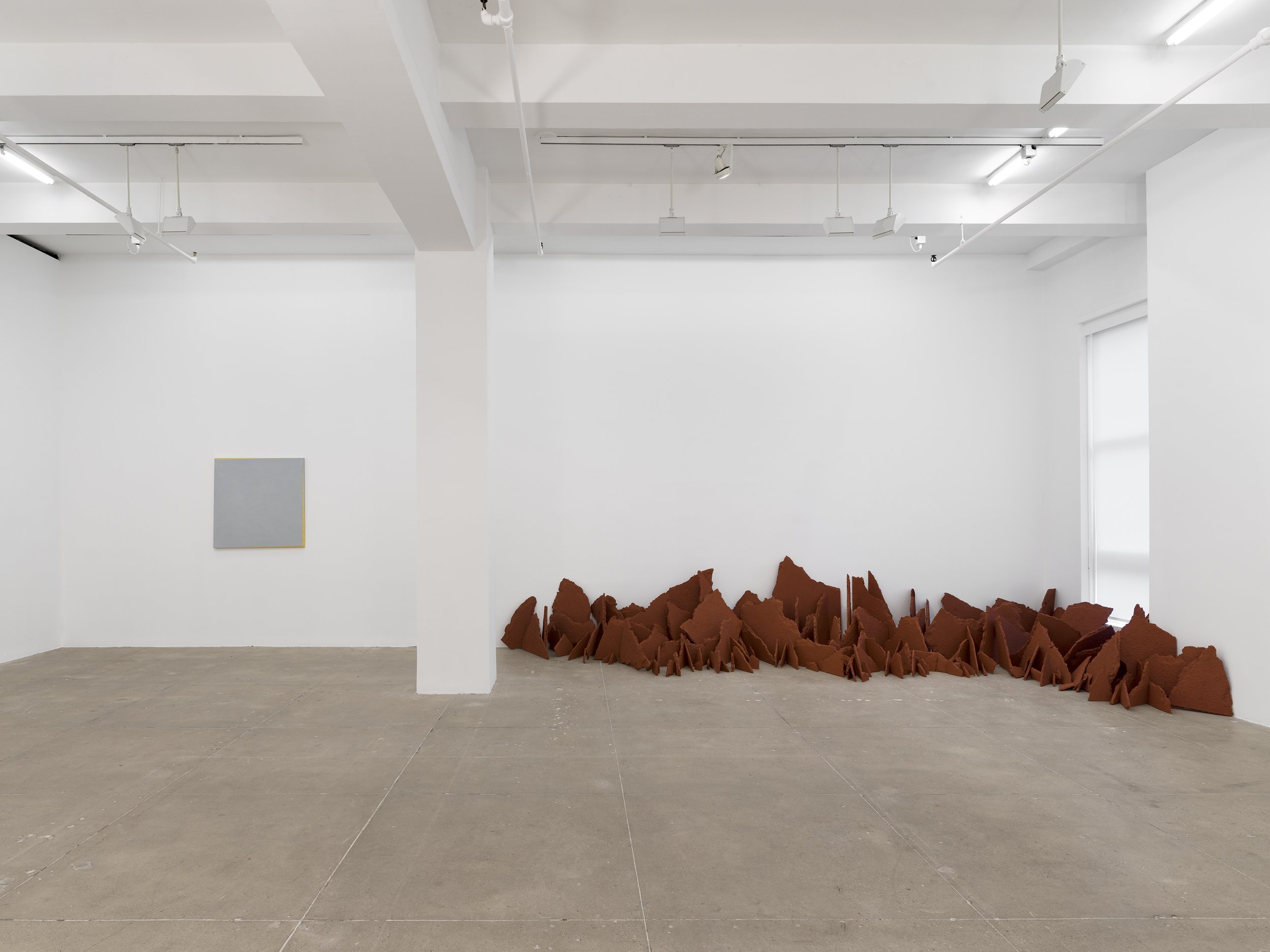

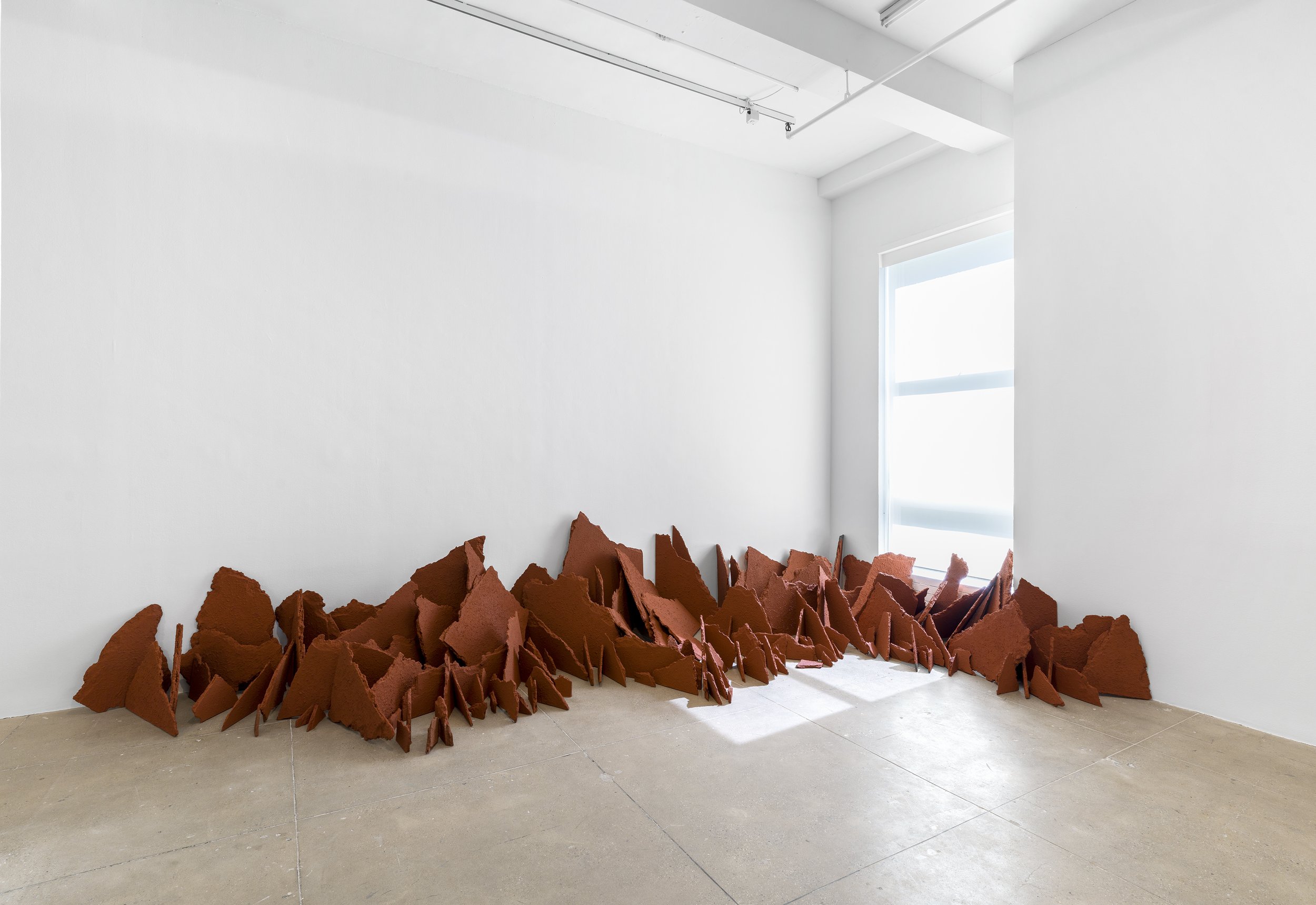
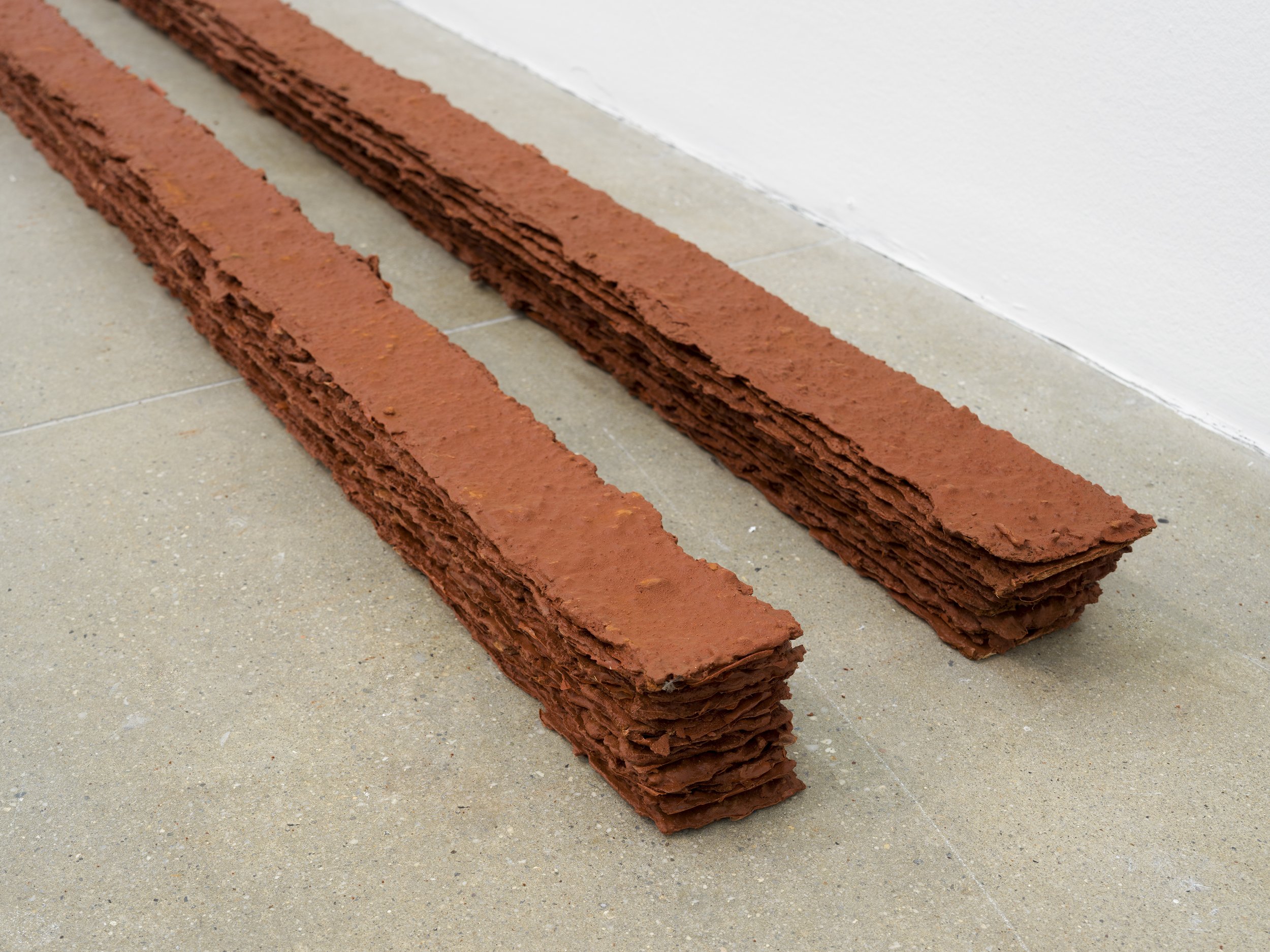
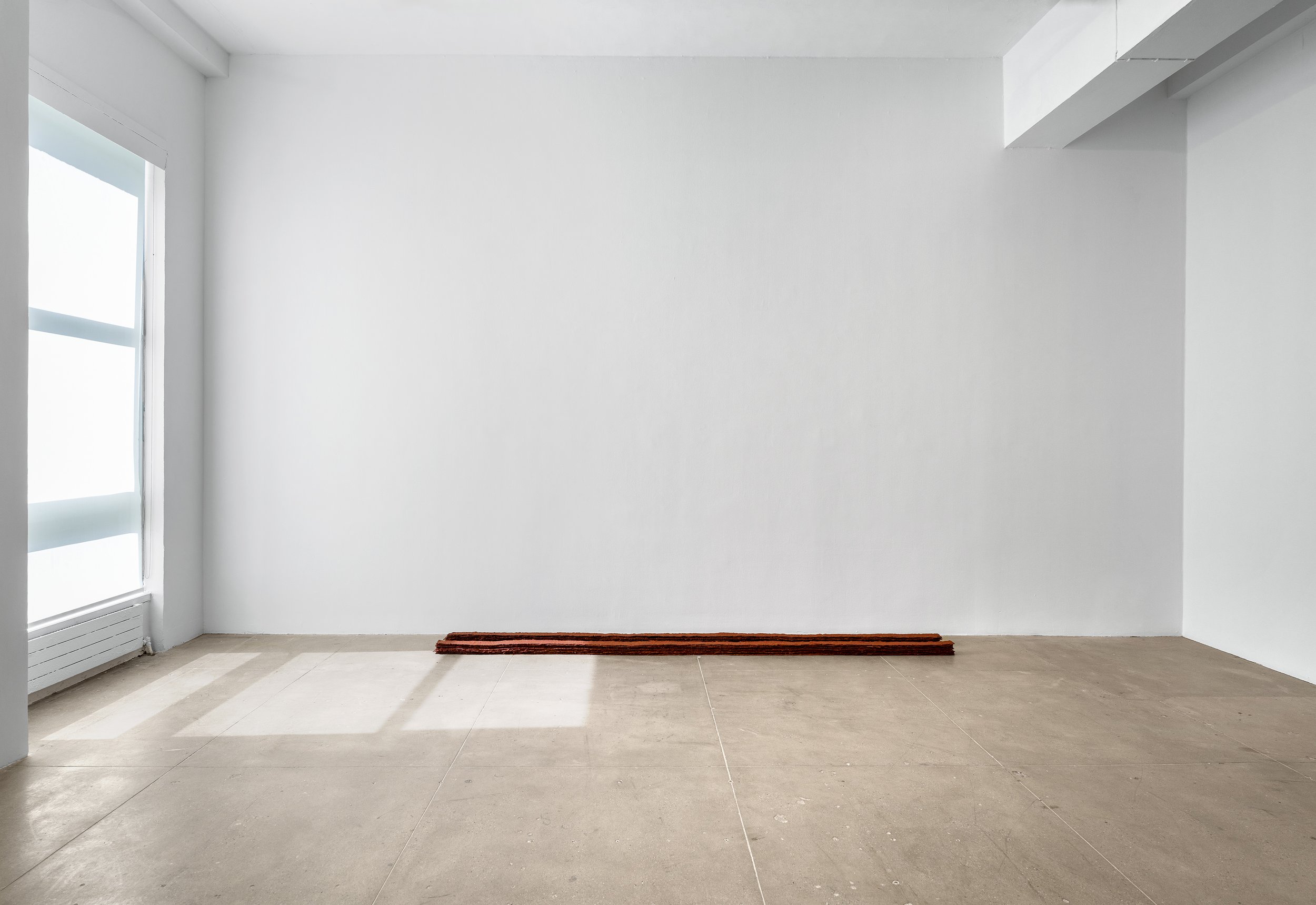
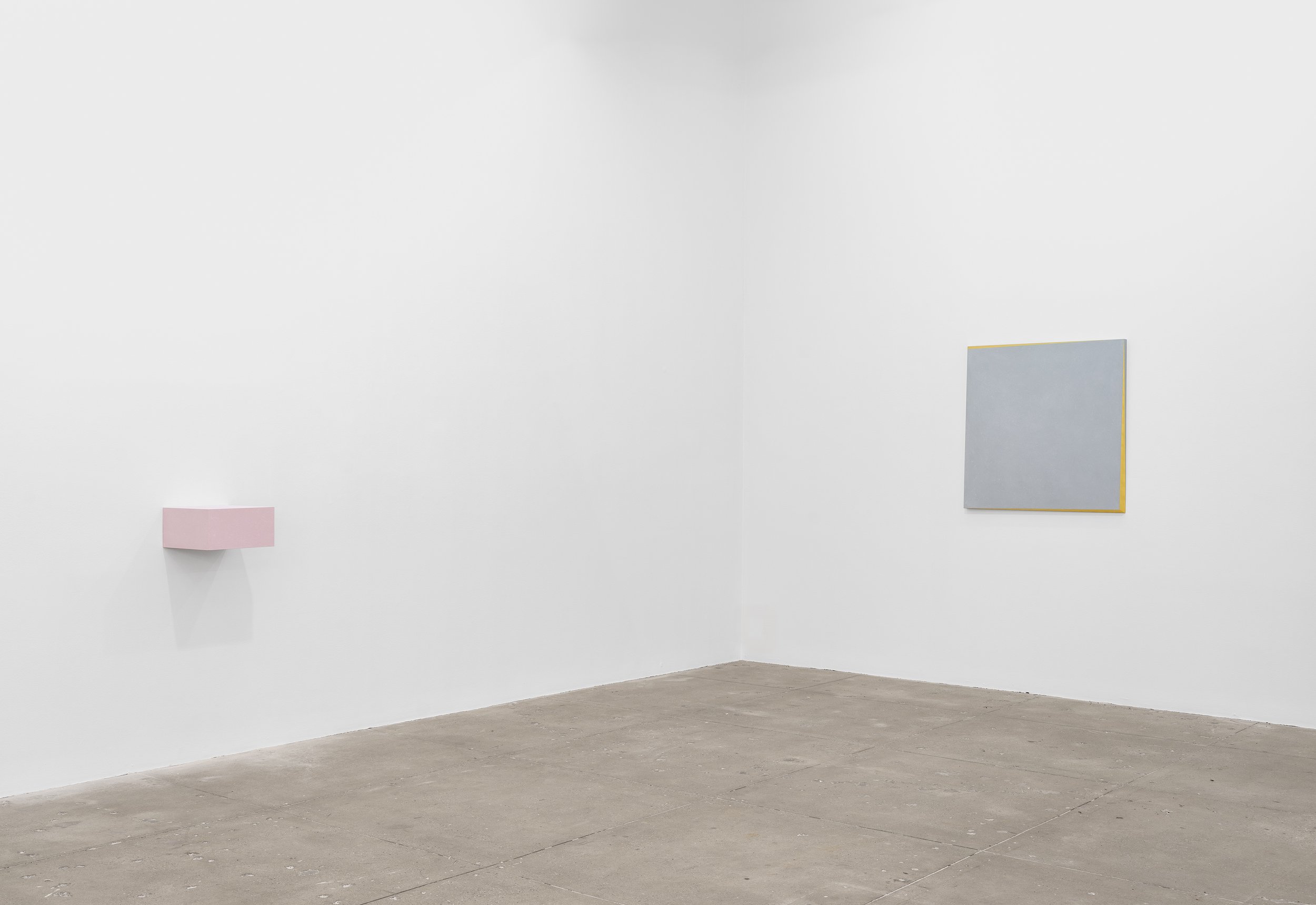
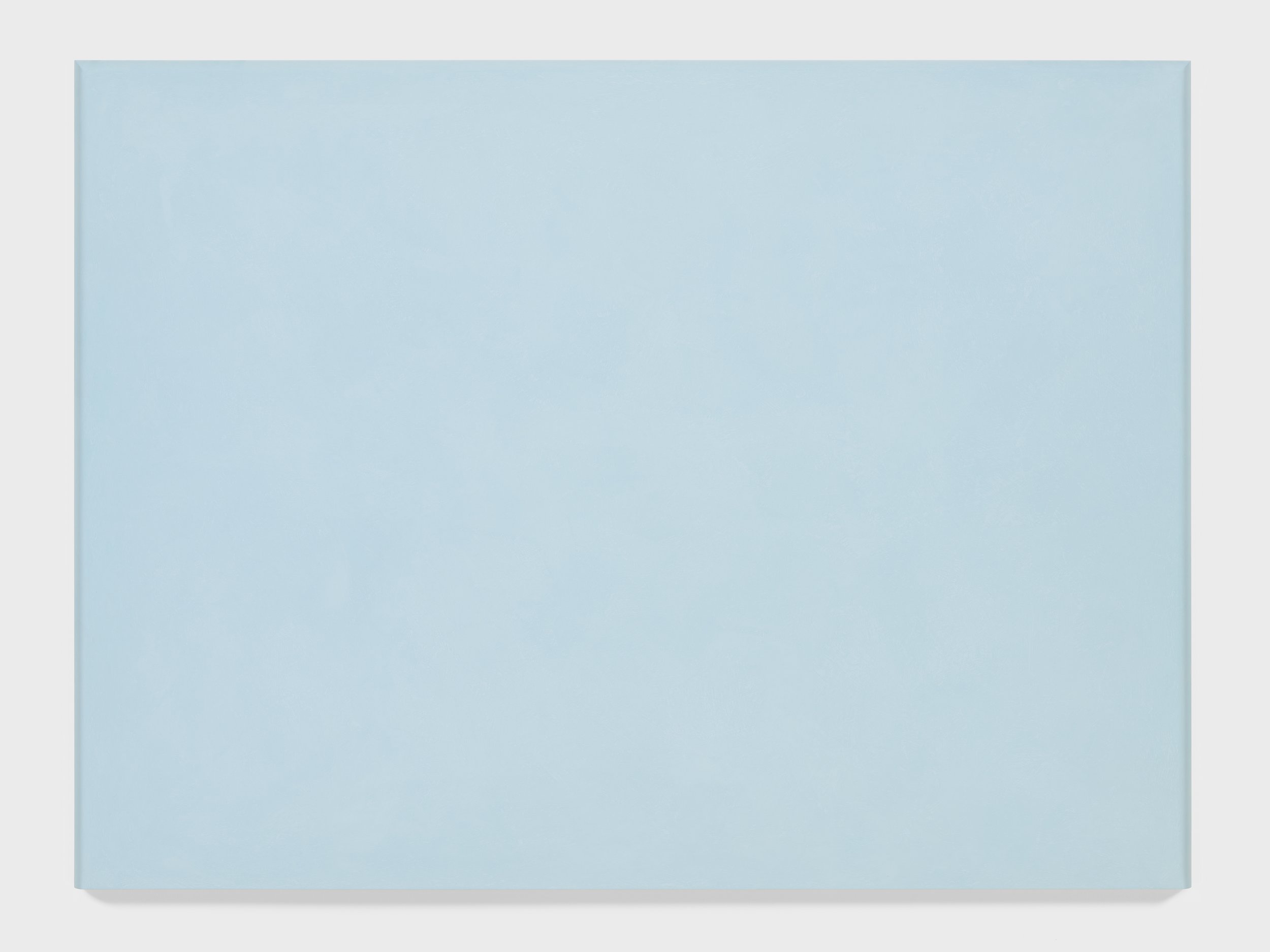
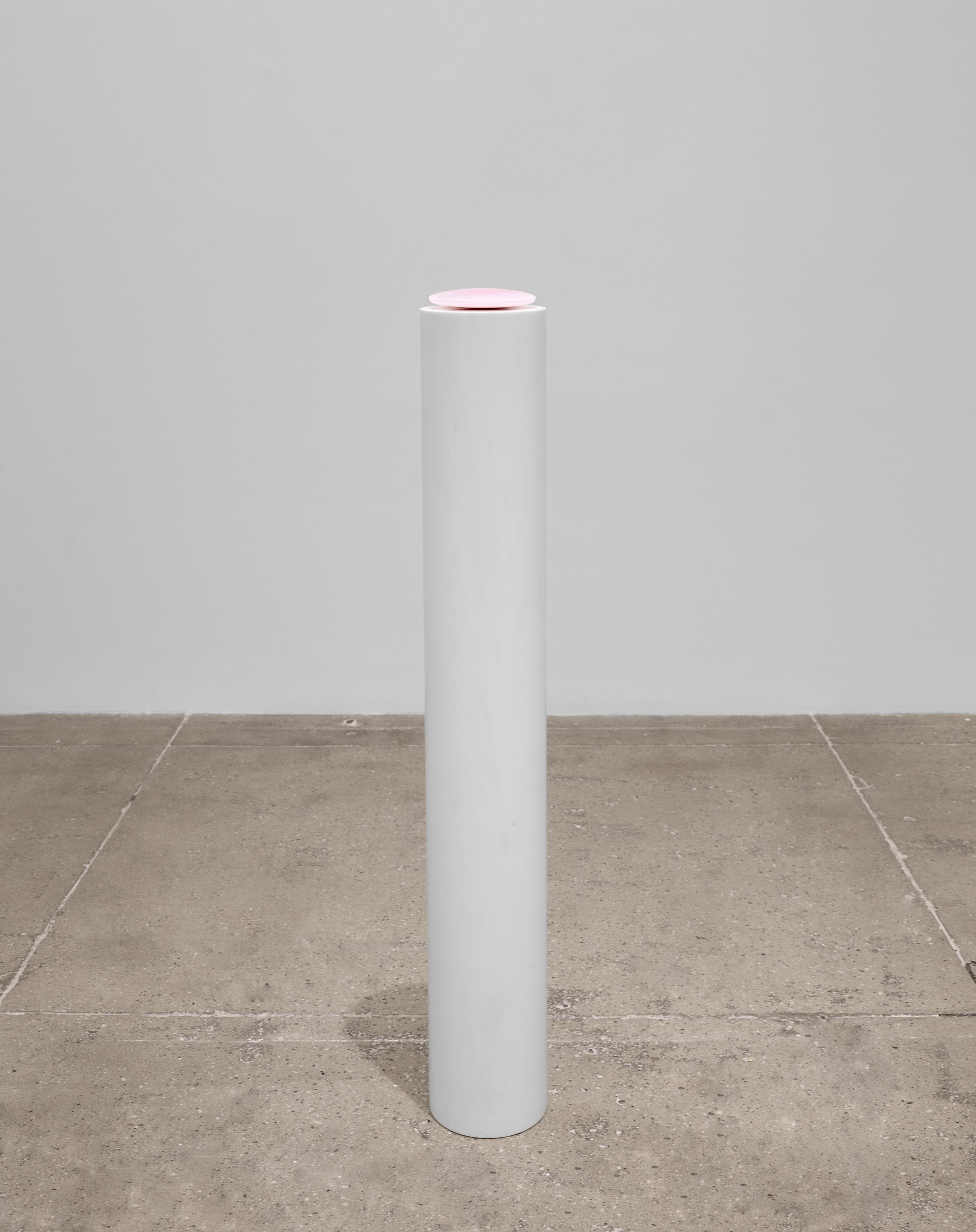
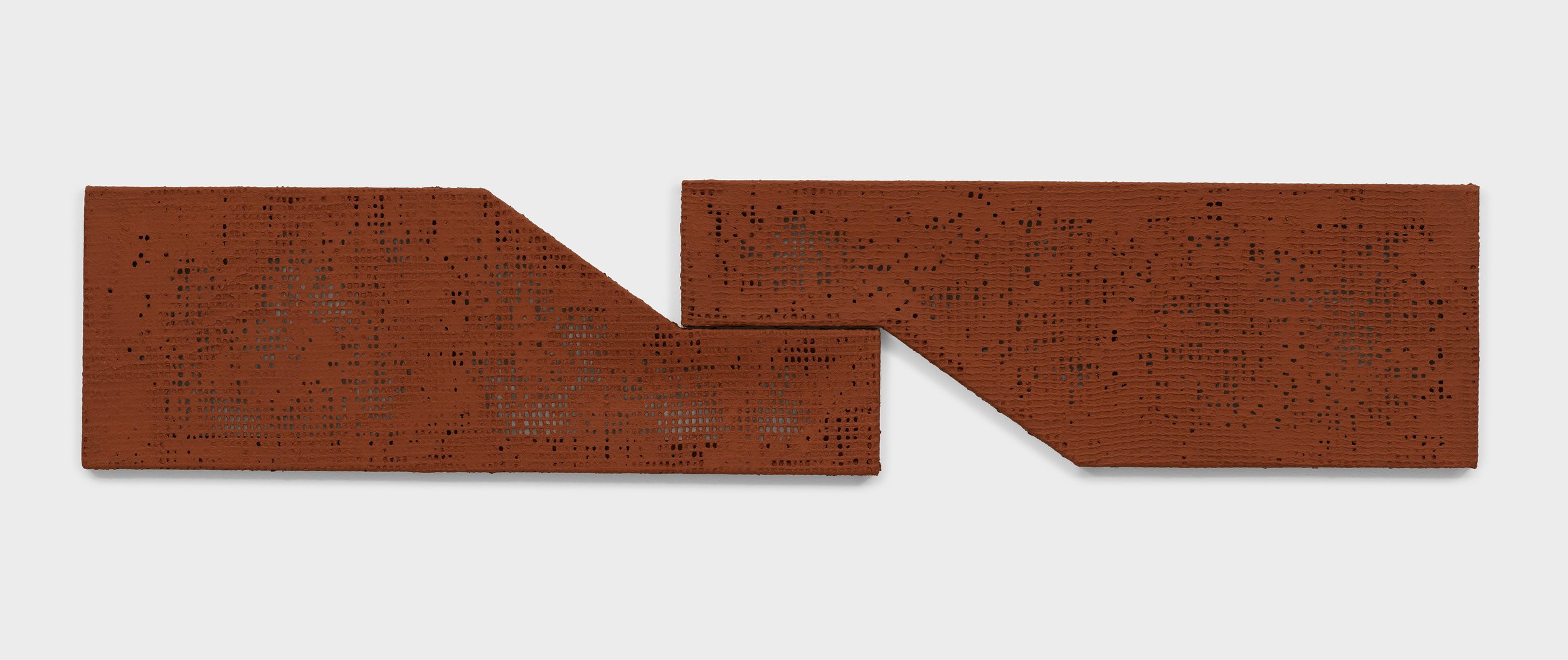
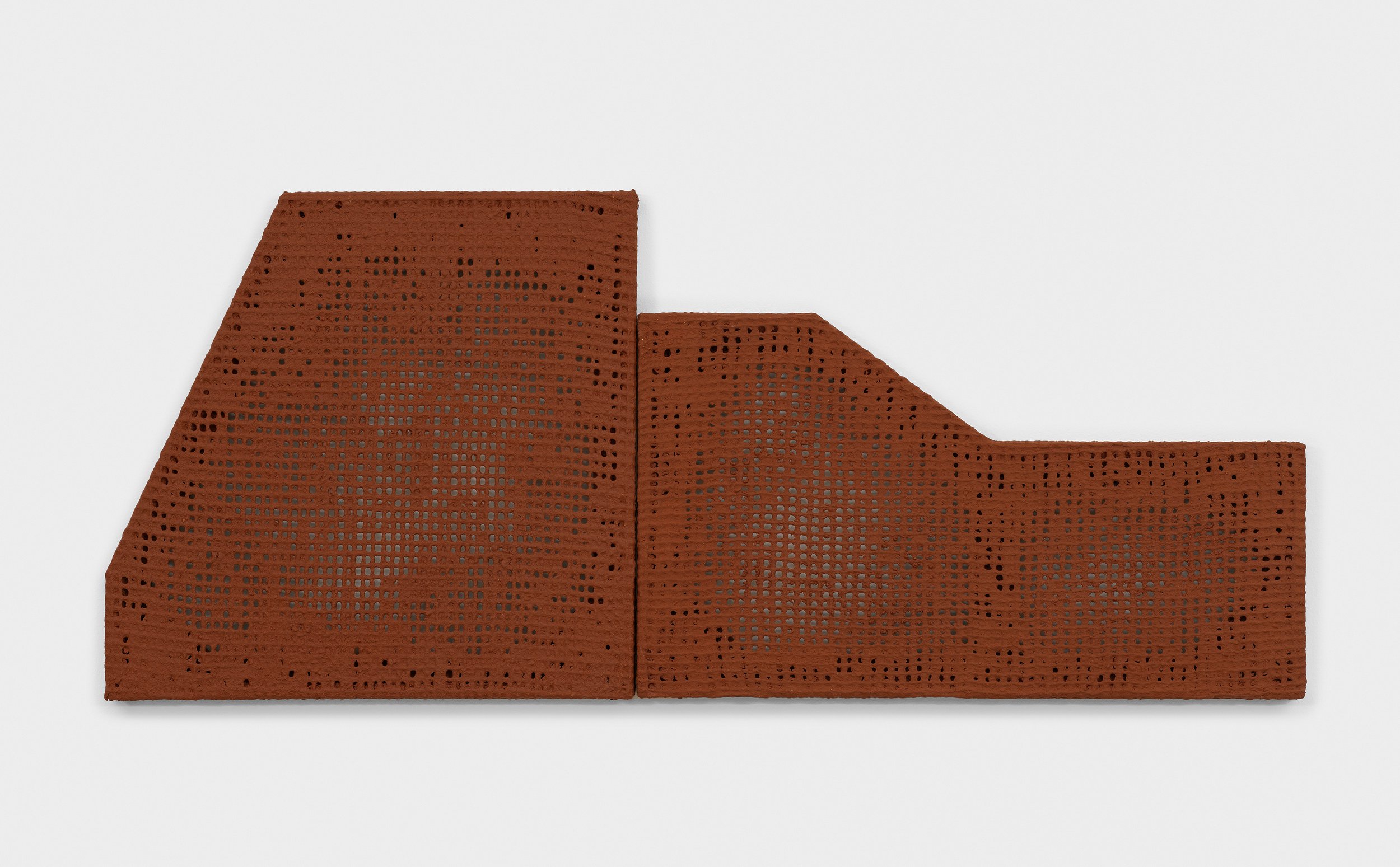
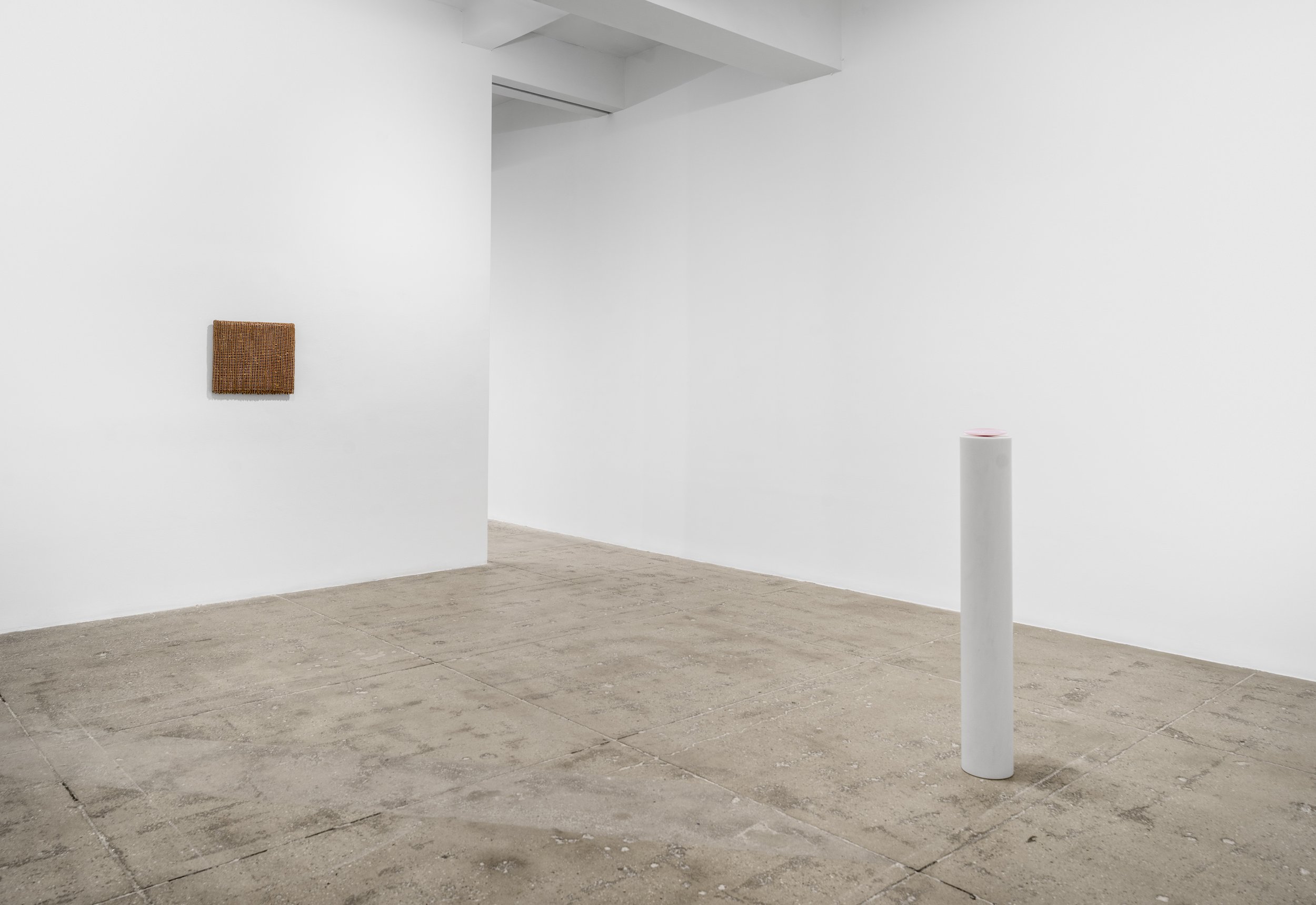
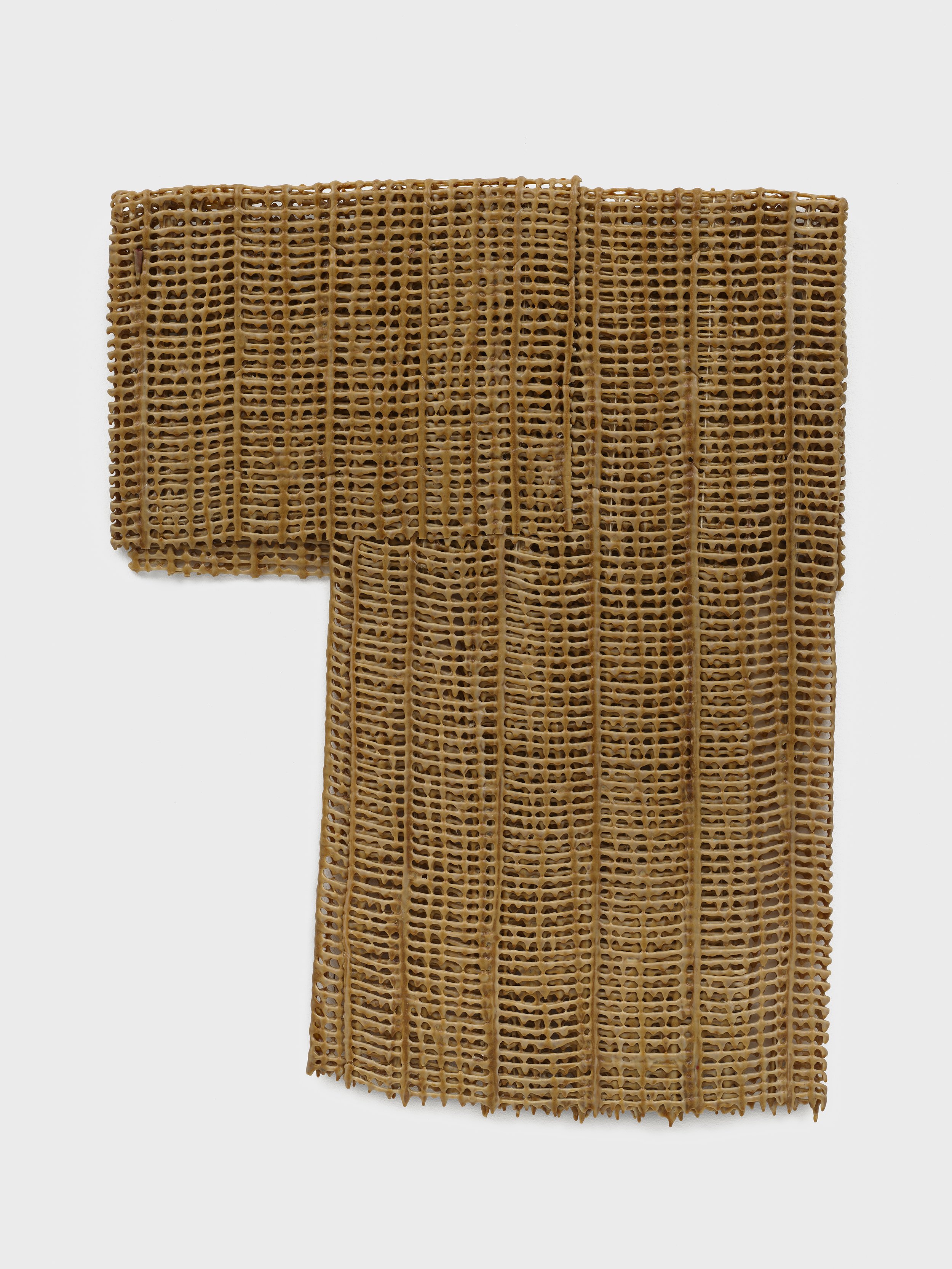

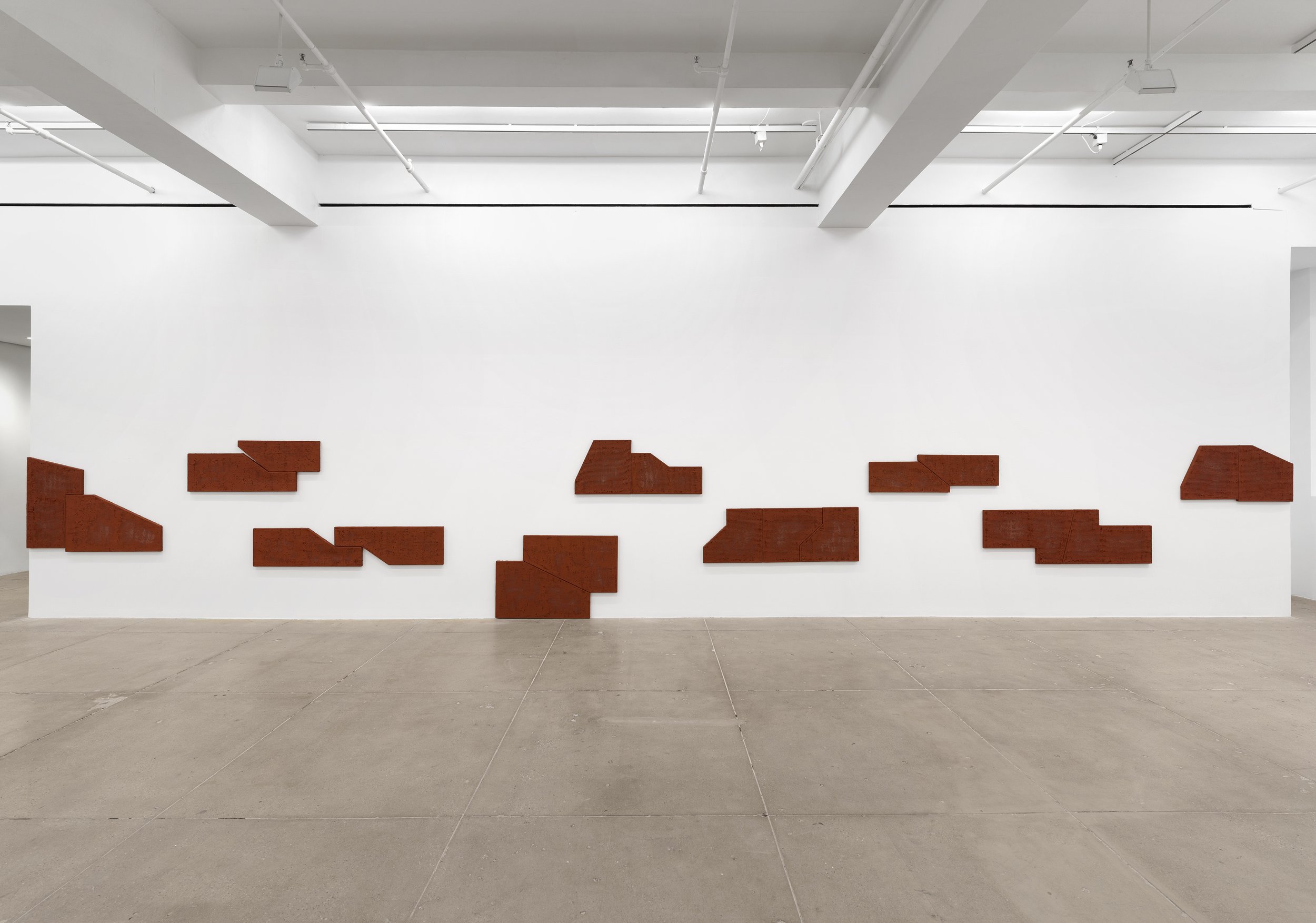
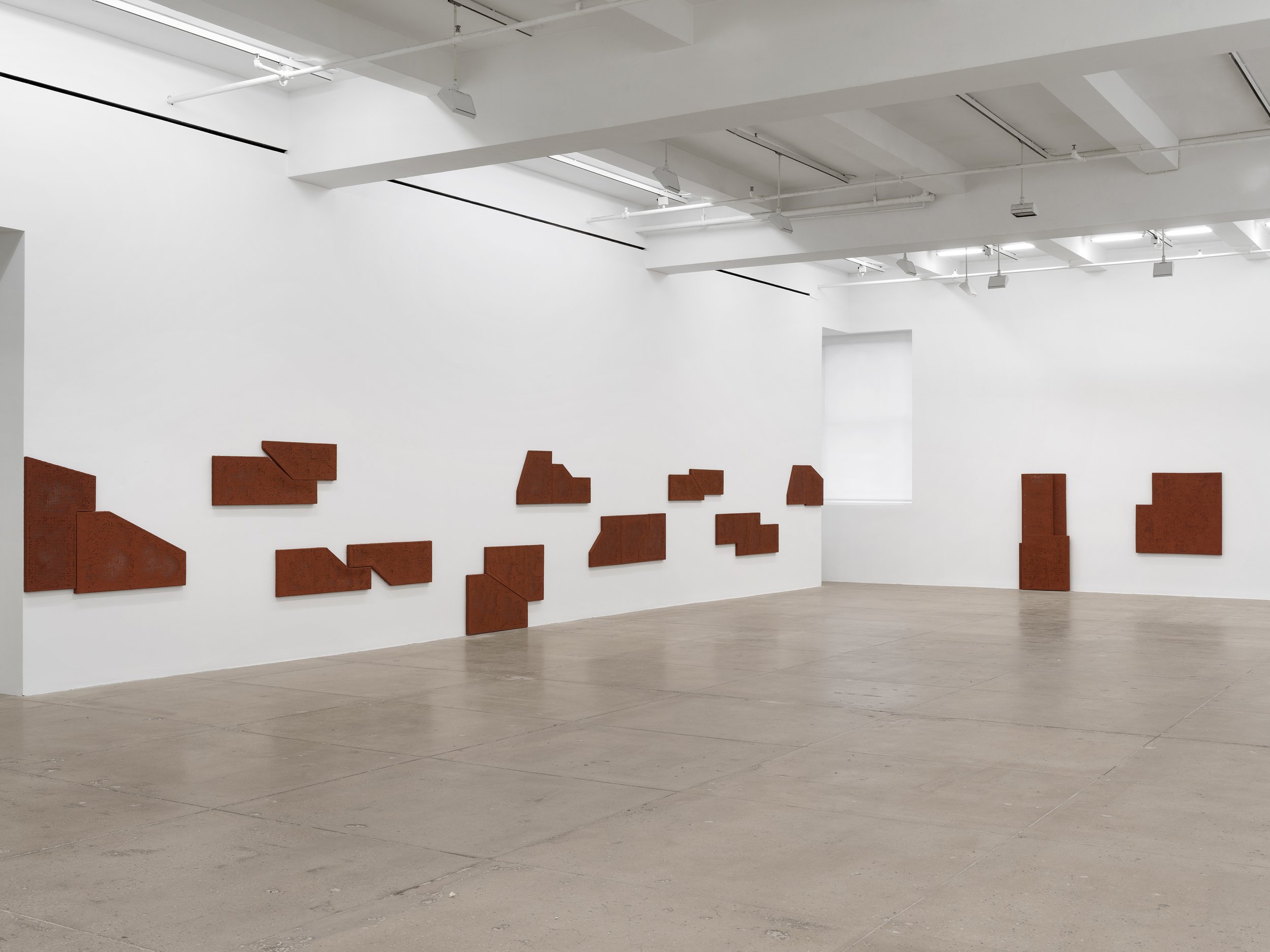
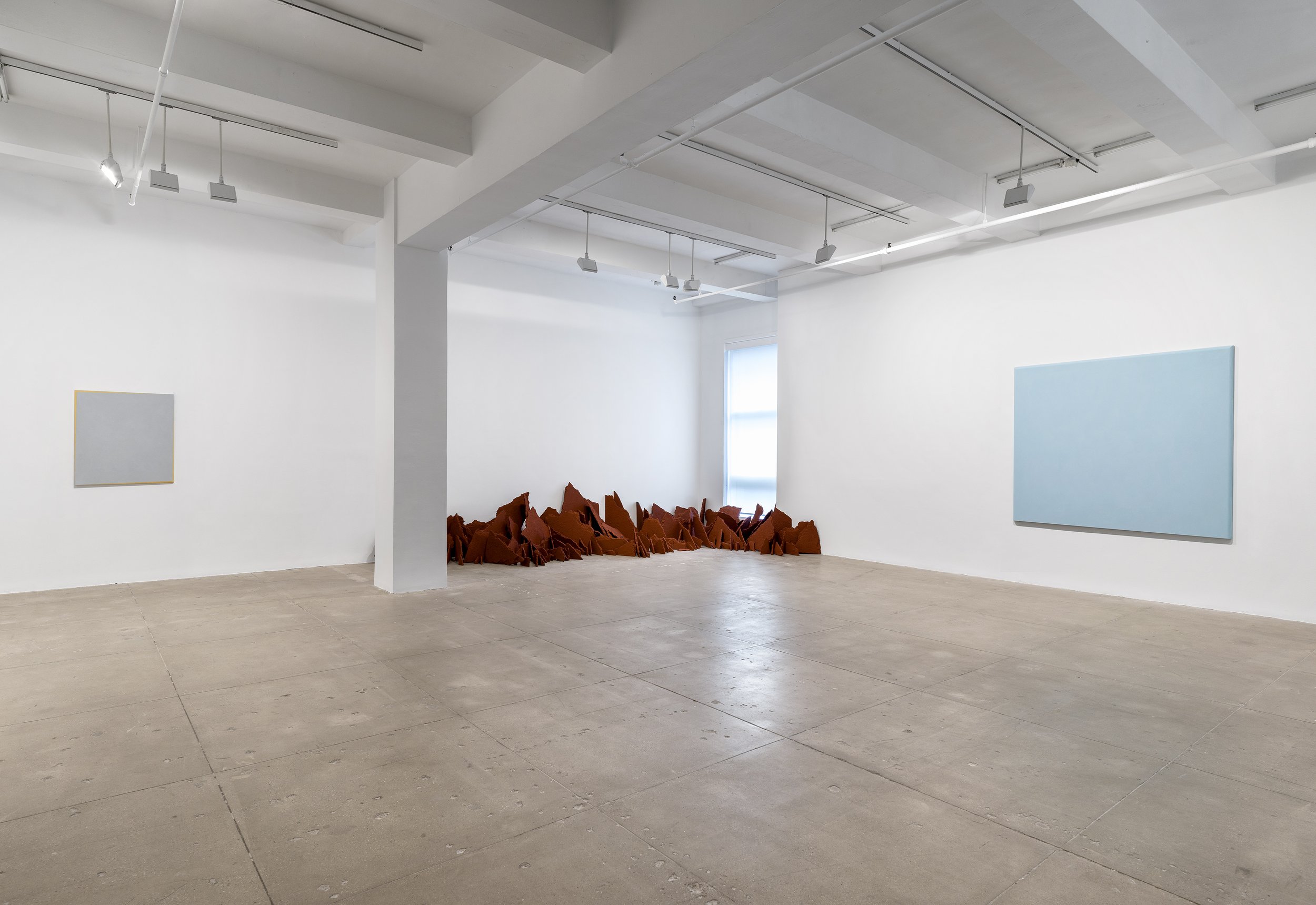
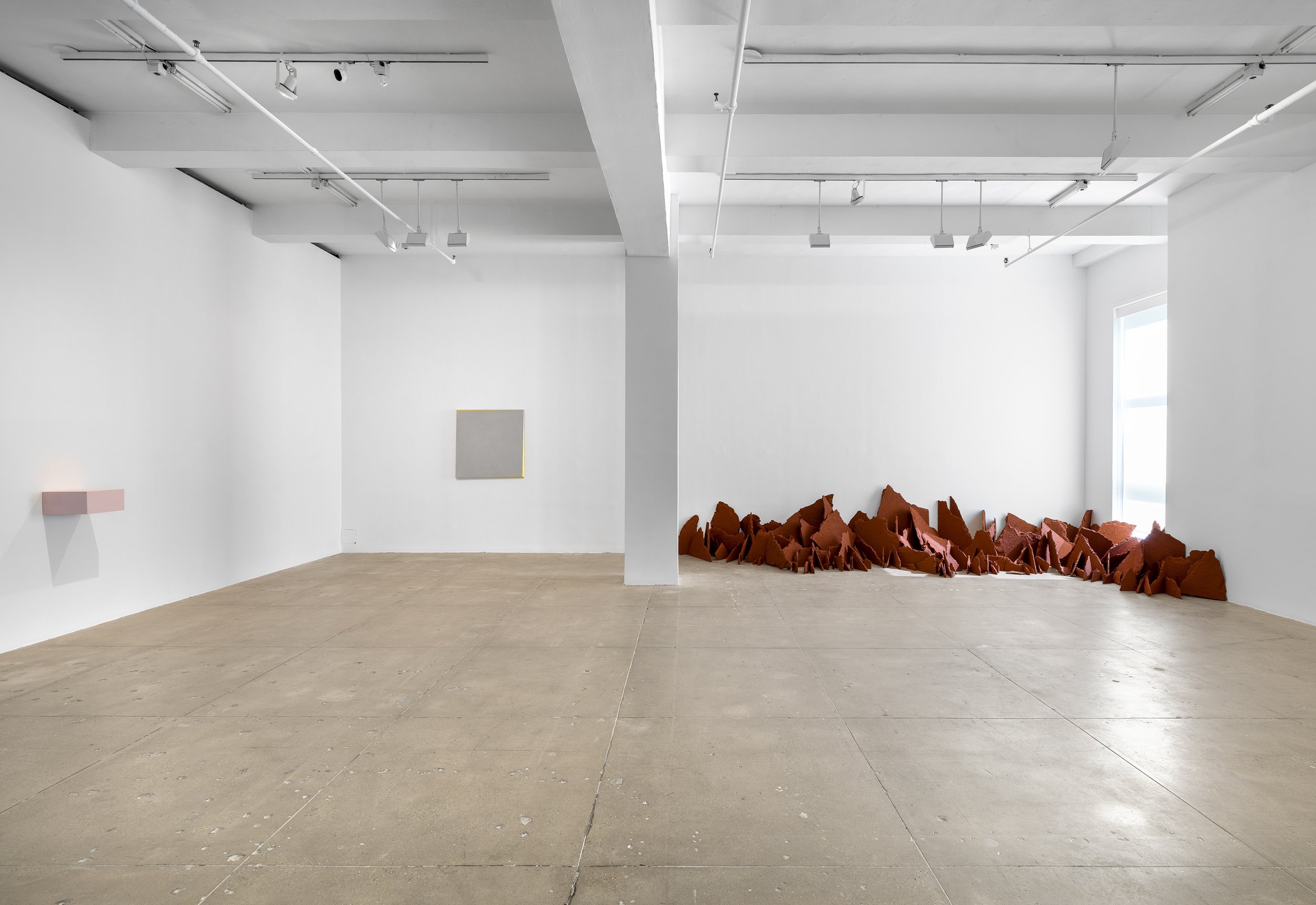
Installation view: Delcy Morelos, Ettore Spalletti, “Esa Esquina Soy Yo”, Marian Goodman Gallery, New York, 2023 Courtesy of Fondazione Ettore Spalletti and Marian Goodman Gallery Photo credit: Alex Yudzon
Morelos' Eva, 2013, acrylic on jute, an installation of the same title made with earth and binder on chipboard, marks Morelos' decisive shift from the pictorial plane to structures in space, anticipating her sculptural practice and large-scale experiential and multisensory installations.
At the Pulitzer Arts Foundation in St. Louis, Interwoven, a solo exhibition of Morelos' work, is scheduled to run from 8 March through 4 August 2024. Delcy Morelos: El Abrazo, on view at Dia Chelsea through 20 July 2024, features two immersive earth-based installations, Cielo terrenal (Earthly Heaven) 2023 and El abrazo (The Embrace) 2023. A catalogue will be published in conjunction with the exhibition.
Ettore Spalletti: Parole di colore, an installation that opened in September 2023 and inaugurated the new Robert Olnick Pavilion at Magazzino Italian Art in Cold Spring, NY, is on view through 6 January 2025, and a publication will accompany the exhibition.
Born in 1967 in Tierralta in the region of Córdoba in Colombia, Delcy Morelos studied at the Cartagena School of Fine Arts. She lives and works in Bogotá. Her practice is rooted in ancestral Andean cosmovision and the aesthetics of Minimal Art. Morelos’ abstract works, with their formidable evocations, inspire rumination on the interplay between human beings and earth, the human body and materiality.
Solo exhibitions include Interwoven, Pulitzer Arts Foundation, St. Louis, MO (2024); El Abrazo, Dia Chelsea, New York (2023); El lugar del alma, Museo Moderno, Buenos Aires, Argentina (2022); Enie, Fundación NC-Arte, Bogotá (2018); Inner Earth, Röda Sten Konsthall, Göteborg, Sweden (2018); La Sombra Terrestre (The Shadow of the Earth), Fundación Fuga, Bogotá (2015); Barranquilla Museum of Modern Art (2006); Gt Gallery, Flax Arts Studios Residence Program, Belfast, Northern Ireland (2006); Academia Superior de Artes de Bogota, Santa Fe Gallery, Bogota (2004); and Color que soy, Museo de Arte de la Universidad Nacional de Colombia (2002).
Selected group exhibitions include The Milk of Dreams, Arsenale Pavilion at the 59th Venice Biennale (2022); Still Alive, Aichi Trienniale in Japan (2022); Something (you can't see, on the other side, of a wall from this side) casts a shadow, SOMArts Culural Center, San Francisco (2018); Medellín, une histoire colombienne des années 1950 à aujourd’hui, Musée des Abattoirs, Toulouse, France (2017); Du som jag, Havremagasinet, Boden, Sweden (2016) and Sami Center for Contemporary Art, Karasjok, Norway (2017); 7 Mercosul Biennial, Grito e escuta (Screaming and Listening), Porto Alegre, Brazil (2009); MDE 07, Espacios de hospitalidad (Hospitality Spaces), Medellín (2007); ES2002 Tijuana/II International Biennial, Tijuana Cultural Center CECUT, Mexico (2002), and the VI Havana Biennial, Cuba (1997).
Ettore Spalletti (1940-2019) was born in Cappelle sul Tavo (Pescara), where he spent his entire life. Compared to contemporary contexts, Spalletti developed a singular, solitary voice and a body of work that transcends any movement that circumscribes an artist to regional or ideological boundaries.
Spalletti has been the protagonist of important international exhibitions, the most recent of which at Nouveau Musee National de Monaco, Monaco (2019) and at Palazzo Cini, Venice (2015). In 2014, three public institutions asked Spalletti to create three exhibitions at the same time at MADRE - Museo d'Arte Contemporanea Donnaregina, Naples, at GAM - Galleria Civica d'Arte Moderna e Contemporanea, Turin, and at MAXXI - Museo Nazionale delle Arti del XXI Secolo, Rome. Other solo exhibitions include: GNAM - Galleria Nazionale d'Arte Moderna, Rome (2010); Museum Kurhaus, Kleve (2009); Académie de France, Villa Medici, Rome (2006); Henry Moore Institute, Leeds (2005); Castello di Rivoli - Museo d'Arte Contemporanea, Rivoli, Turin (2004); Fundación la Caixa, Madrid (2000); Museo di Capodimonte, Naples (1999); Musée d'Art Moderne et Contemporain, Strasbourg (1998); MUHKA - Museum van Hedendaagse Kunst, Antwerp (1995); Solomon R. Guggenheim Museum, New York (1993); ARC - Musée d'Art Moderne de la Ville de Paris, Paris (1991); SMAK - Ghent, Ghent (1983); Museum Folkwang, Essen (1982).
In 2021, after the artist's passing, the Galleria Nazionale d’Arte Moderna e Contemporanea in Rome dedicated a retrospective exhibition to him. Spalletti has participated in the Venice Biennale (1982, 1993, 1995 and 1997) and documenta VII (1982), documenta IX (1992). His major commissioned works include the Chapel of Villa Serena, Pescara, Italy (2016), in collaboration with architect Patrizia Leonelli, and La salle des départs at the Hôpital Raymond-Poincaré, Garches, France (1996), a project for which he was awarded the order of Chevalier des Arts et Lettres de la République Française.
Works by Spalletti can be found, among others, in the permanent collections of the Solomon R. Guggenheim Museum, New York; MUMOK, Vienna; Castello di Rivoli, Turin; MAXXI, Rome-L'Aquila; Galleria Nazionale d'Arte Moderna e Contemporanea, Rome; Villa Litta Menafoglio Panza di Biumo, Varese; Centre Pompidou, Paris; Fondation Louis Vuitton, Paris; Museum Kurhaus, Kleve; SMAK, Ghent; MUHKA, Antwerp; Nouveau Musee National de Monaco, Monaco.
For more information about the exhibit, please visit the Marian Goodman Gallery’s site. The gallery can be found on Instagram and Artsy, too.
Michal Rovner:Pragim
Michal Rovner: Pragim 540 West 25th Street, New York, NY 10001 March 8 – April 18, 2024 Photography courtesy Pace Gallery
New York – Pace is pleased to present an exhibition of works by Michal Rovner at its 540 West 25th Street gallery in New York. Which opened on March 8th and will be on view until the April 18, the show, titled Pragim—the Hebrew word for Poppies—will feature prints, video works, and installations from a series the artist started in 2019. Over the last five years, as part of this long-term project, Rovner has filmed and drawn wild poppies that grow in her field in Israel.
Pragim- 2 (detail), 2024 PRINT archival pigment print 80-1/4" × 50" × 2" (203.8 cm × 127 cm × 5.1 cm), framed No. 90459.01 © Michal Rovner / Artists Rights Society (ARS), New York
For more than 30 years, Rovner’s practice has centered on universal questions of the human condition—bringing issues of identity, place, and dislocation to the fore. The poppy—which carries different associations and meanings around the world—embodies both fragility and fortitude, as well as memorial and loss. The ongoing war has impacted the artist’s perspective on her Pragim works, as they now also powerfully reflect the state of unrest and anguish afflicting the region. Using a dark palette of black, gray, and red, the artist imbues her human-scale staccato swaying poppies with harsh and tragic qualities.
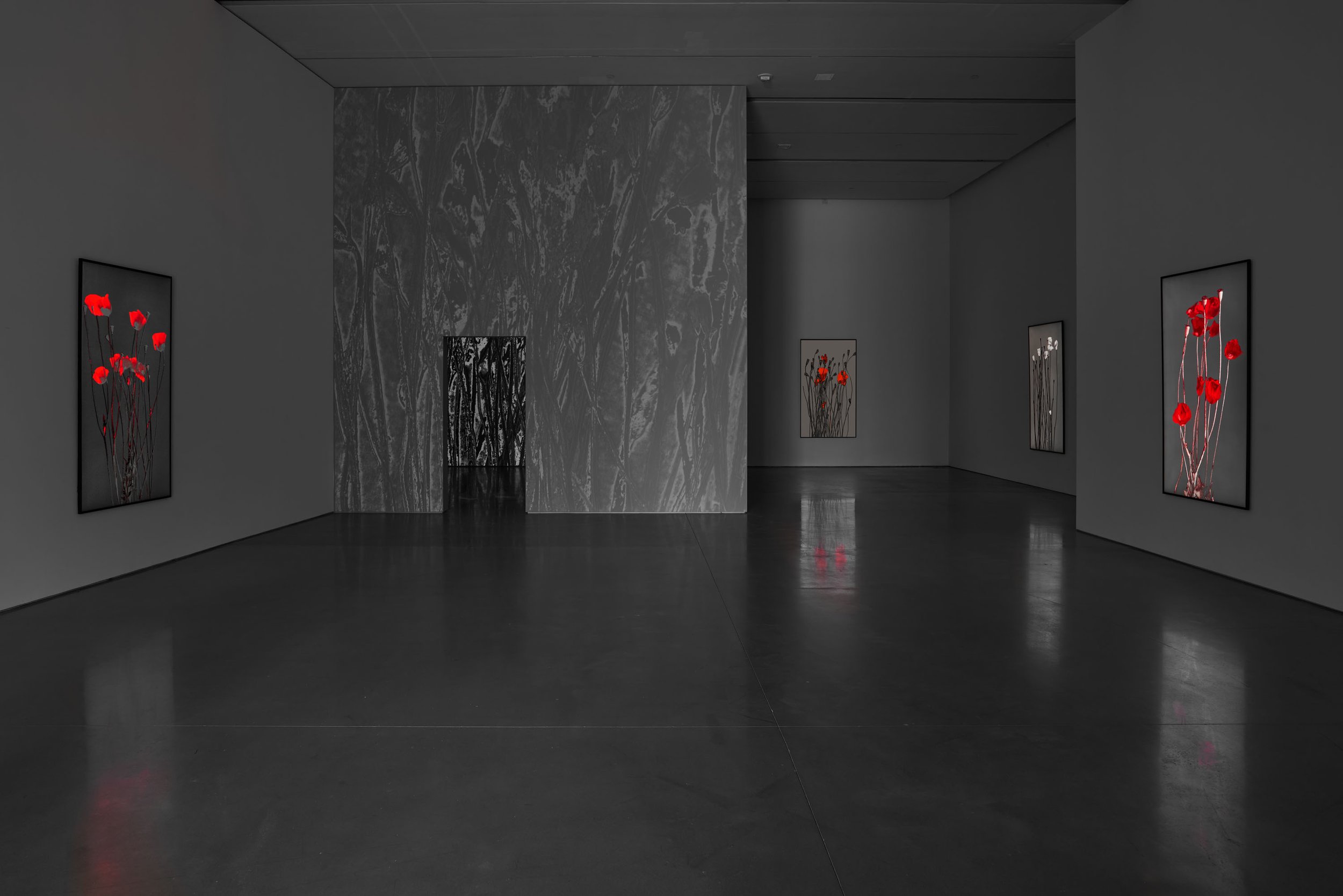
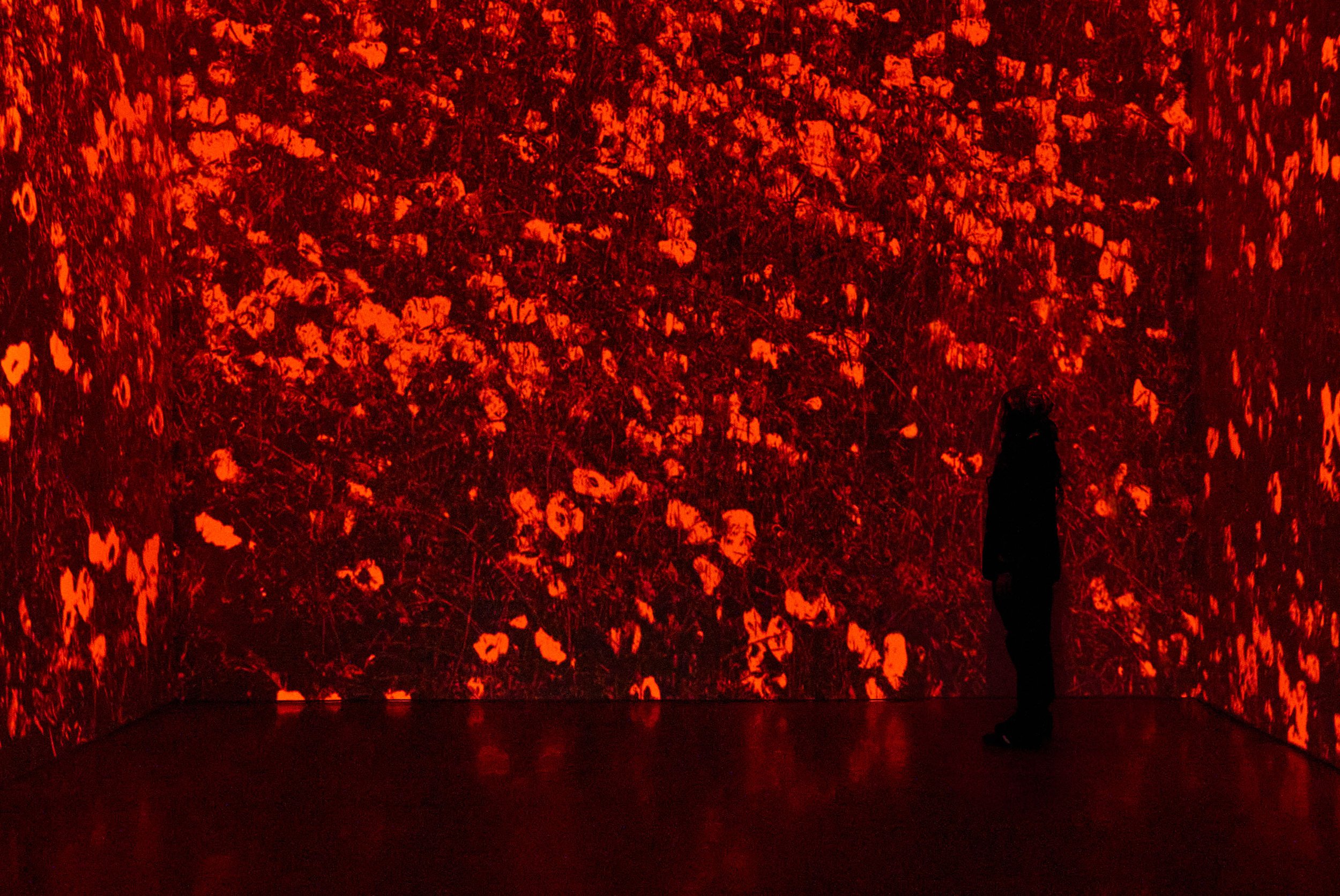
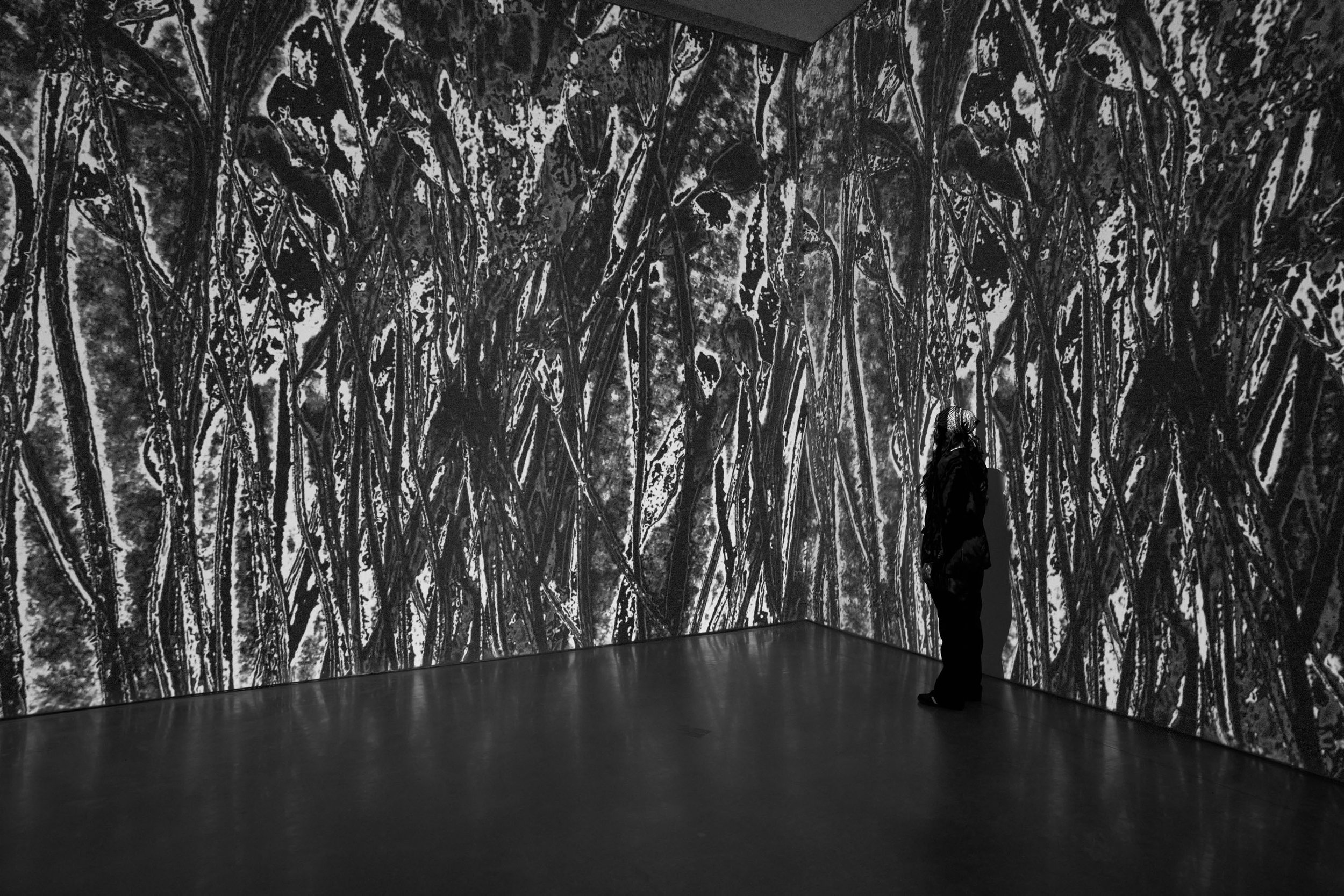
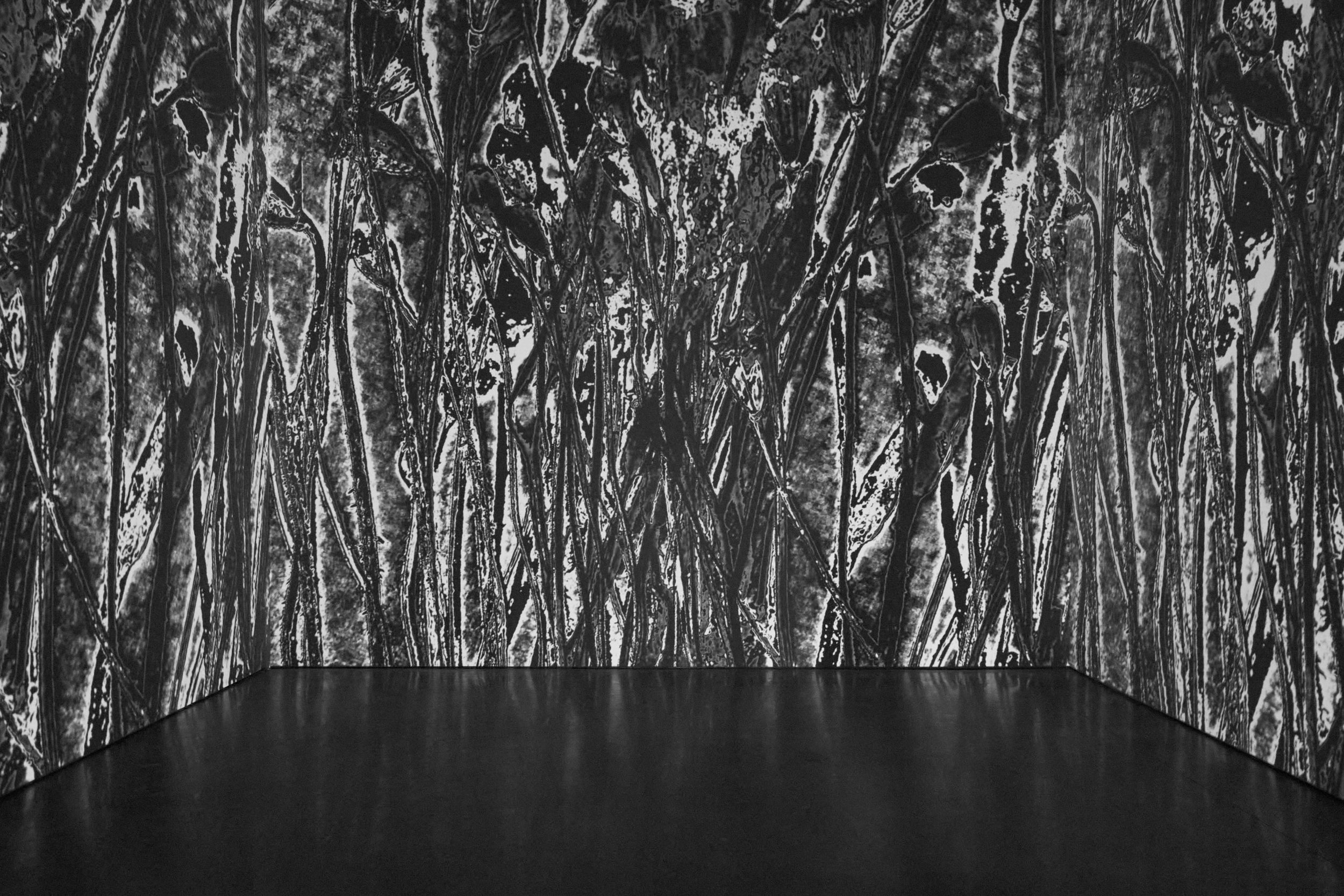
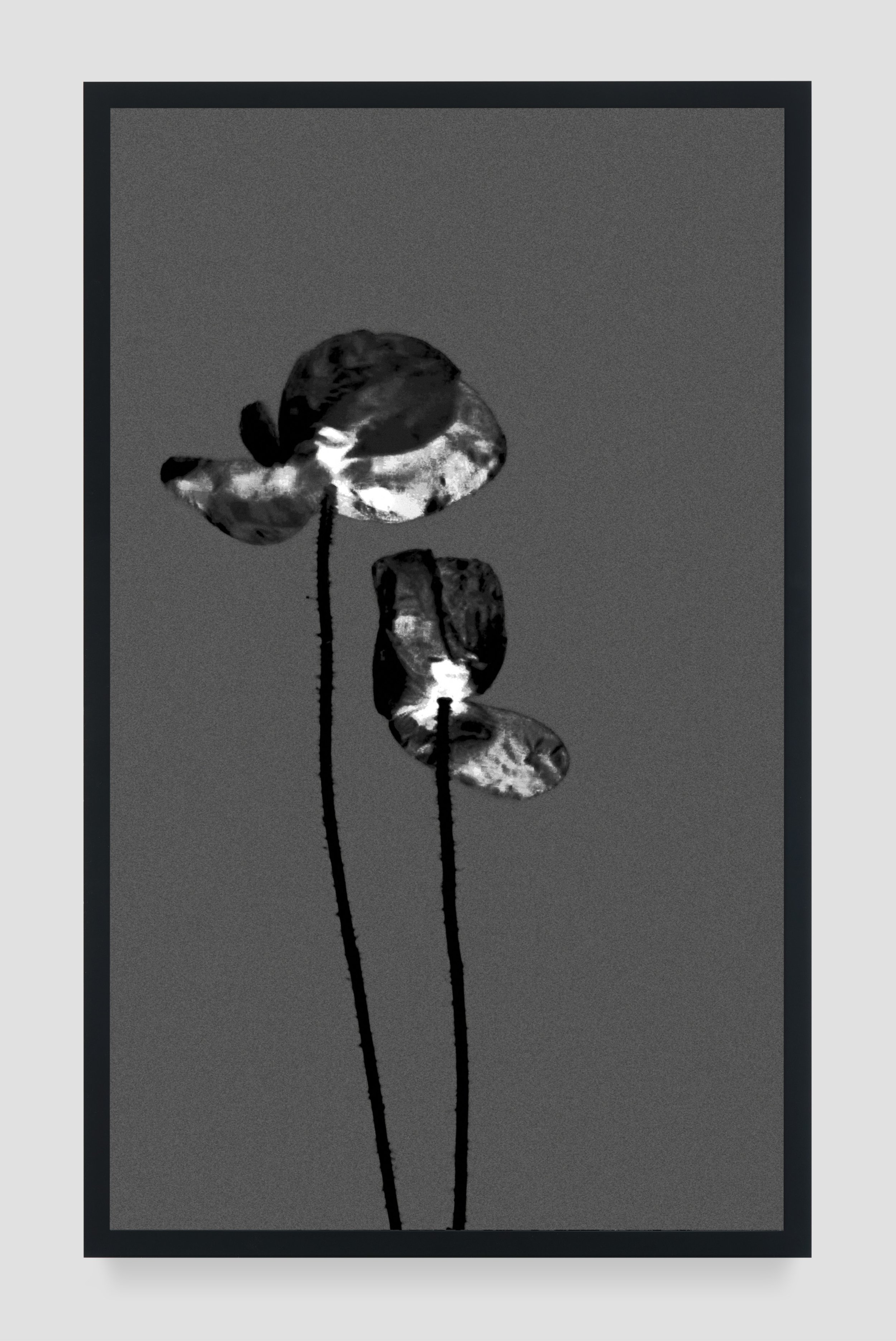
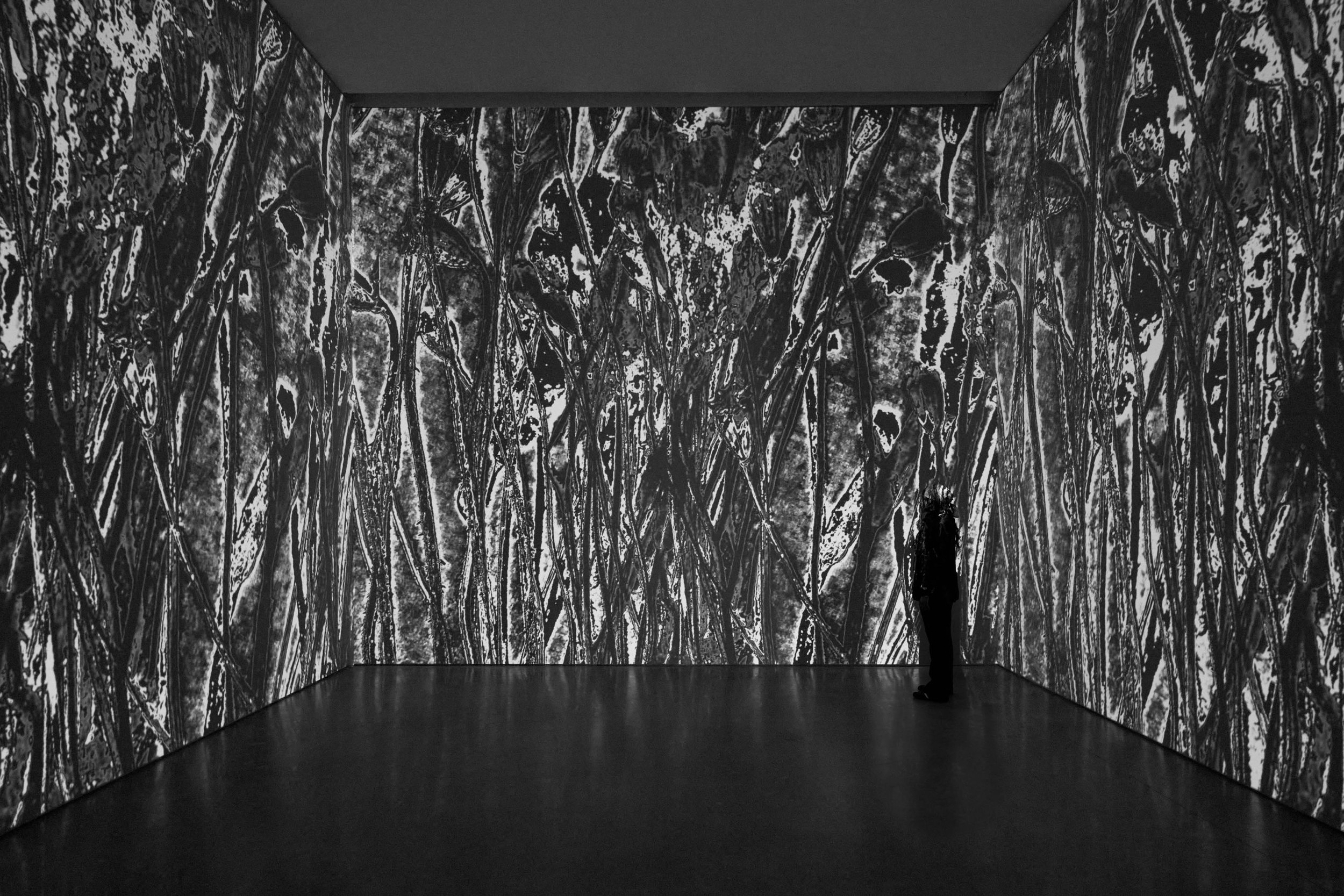
Michal Rovner: Pragim 540 West 25th Street, New York, NY 10001 March 8 – April 18, 2024 Photography courtesy Pace Gallery
Working across drawing, printmaking, video, sculpture, and installation, the artist often obscures identifying details and specifics of time and place in her layered compositions, creating abstract yet resonant reflections of reality and the human experience. One of her most famous projects is Makom (Place), a series of monumental cubic structures composed of stones of dismantled or destroyed Israeli and Palestinian homes from Jerusalem, Bethlehem, Haifa, the Galilee, and the border between Israel and Syria.
Pragim-3, 2024 PRINT archival pigment print 80-1/4" × 50" × 2" (203.8 cm × 127 cm × 5.1 cm), framed No. 90460.01 © Michal Rovner / Artists Rights Society (ARS), New York
The Makom series echoes conflicts in the past and present. Working with Israeli and Palestinian masons, Rovner addresses the possibility of creating together, in a shared experience of reconstructing and rebuilding.
Red Light, 2024 VIDEO LCD screen 74-13/16" × 42-1/2" × 5-3/8" (190 cm×108cm×13.7cm) No. 91051.01 © Michal Rovner / Artists Rights Society (ARS), New York
Michal Rovner (b. 1957, Tel Aviv, Israel) works with drawing, printmaking, video, sculpture, and installation to reflect on the continuum of human experience. Her work shifts constantly between the poetic and the political, using imagery that invokes the fragility of existence, identity, dislocation, and time. Generally avoiding direct representation of specific issues or events, Rovner reinterprets the present and historical memory. She records and erases visual information, obscuring specifics of time and place through gestural, abstract qualities. For immediate release Important historic exhibitions and installations of her work include Michal Rovner: The Space Between, Whitney Museum of American Art (2002); Against Order? Against Disorder?, Venice Biennale (2003); Incidental Affairs, Suntory Museum, Osaka (2009); Michal Rovner: Histoires, Musée du Louvre, Paris (2011); and Michal Rovner: Transitions, Canary Wharf, London (2019). Rovner’s work resides in numerous public collections worldwide including The Art Institute of Chicago, Illinois; Solomon R. Guggenheim Museum, New York; The Metropolitan Museum of Art, New York; Paris Audiovisuel, France (Collection of the City of Paris); and The Israel Museum, Jerusalem, Israel, among others.
Pace is a leading international art gallery representing some of the most influential contemporary artists and estates from the past century, holding decades-long relationships with Alexander Calder, Jean Dubuffet, Barbara Hepworth, Agnes Martin, Louise Nevelson, and Mark Rothko. Pace enjoys a unique U.S. heritage spanning East and West coasts through its early support of artists central to the Abstract Expressionist and Light and Space movements.
Since its founding by Arne Glimcher in 1960, Pace has developed a distinguished legacy as an artist-first gallery that mounts seminal historical and contemporary exhibitions. Under the current leadership of CEO Marc Glimcher, Pace continues to support its artists and share their visionary work with audiences worldwide by remaining at the forefront of innovation. Now in its seventh decade, the gallery advances its mission through a robust global program— comprising exhibitions, artist projects, public installations, institutional collaborations, performances, and interdisciplinary projects. Pace has a legacy in art bookmaking and has published over five hundred titles in close collaboration with artists, with a focus on original scholarship and on introducing new voices to the art historical canon.
Today, Pace has seven locations worldwide, including European footholds in London and Geneva as well as Berlin, where the gallery established an office in 2023. Pace maintains two galleries in New York—its headquarters at 540 West 25th Street, which welcomed almost 120,000 visitors and programmed 20 shows in its first six months, and an adjacent 8,000 sq. ft. exhibition space at 510 West 25th Street. Pace’s long and pioneering history in California includes a gallery in Palo Alto, which was open from 2016 to 2022. Pace’s engagement with Silicon Valley’s technology industry has had a lasting impact on the gallery at a global level, accelerating its initiatives connecting art and technology as well as its work with experiential artists. Pace consolidated its West Coast activity through its flagship in Los Angeles, which opened in 2022. Pace was one of the first international galleries to establish outposts in Asia, where it operates permanent gallery spaces in Hong Kong and Seoul, along with an office and viewing room in Beijing. In spring 2024, Pace will open its first gallery space in Japan in Tokyo’s new Azabudai Hills development.
For more information about this exhibition and others, please visit the Pace Gallery’s website here. Pace Gallery can be found on Instagram and Artsy, too.
Loie Hollowell: Dilation Stage
Loie Hollowell: Dilation Stage 540 West 25th Street, New York, NY 10001March 8–April 20, 2024 Photography courtesy Pace Gallery
New York – Pace is pleased to present Dilation Stage, an exhibition of new large-scale drawings by Loie Hollowell, at its 540 West 25th Street gallery in New York, which opened on March 8 and will be on view until April 20. This presentation marks Hollowell’s second solo show with Pace in New York and her first exhibition in the city dedicated exclusively to her works on paper. Dilation Stage will coincide with her first museum survey, on view at the Aldrich Contemporary Art Museum in Ridgefield, Connecticut, through August 11.
Nine Centimeters Dilated, September 21, 2023 WORK ON PAPER soft pastel on paper 26" × 30" (66 cm × 76.2 cm) framed, 29-15/16" × 33- 15/16" (76 cm × 86.2 cm) No. 89269 © Loie Hollowell, courtesy Pace Gallery
Hollowell is known for her otherworldly paintings and drawings of bodily landscapes. Through a unique lexicon of geometric and organic forms that represent elements of her body, the artist explores experiences of sex, pregnancy, childbirth, breastfeeding, and motherhood. Manipulating real and illusory space on the canvas, she uses radiant colors, varied textures, and protruding sculptural elements to draw viewers into her energetic compositions.
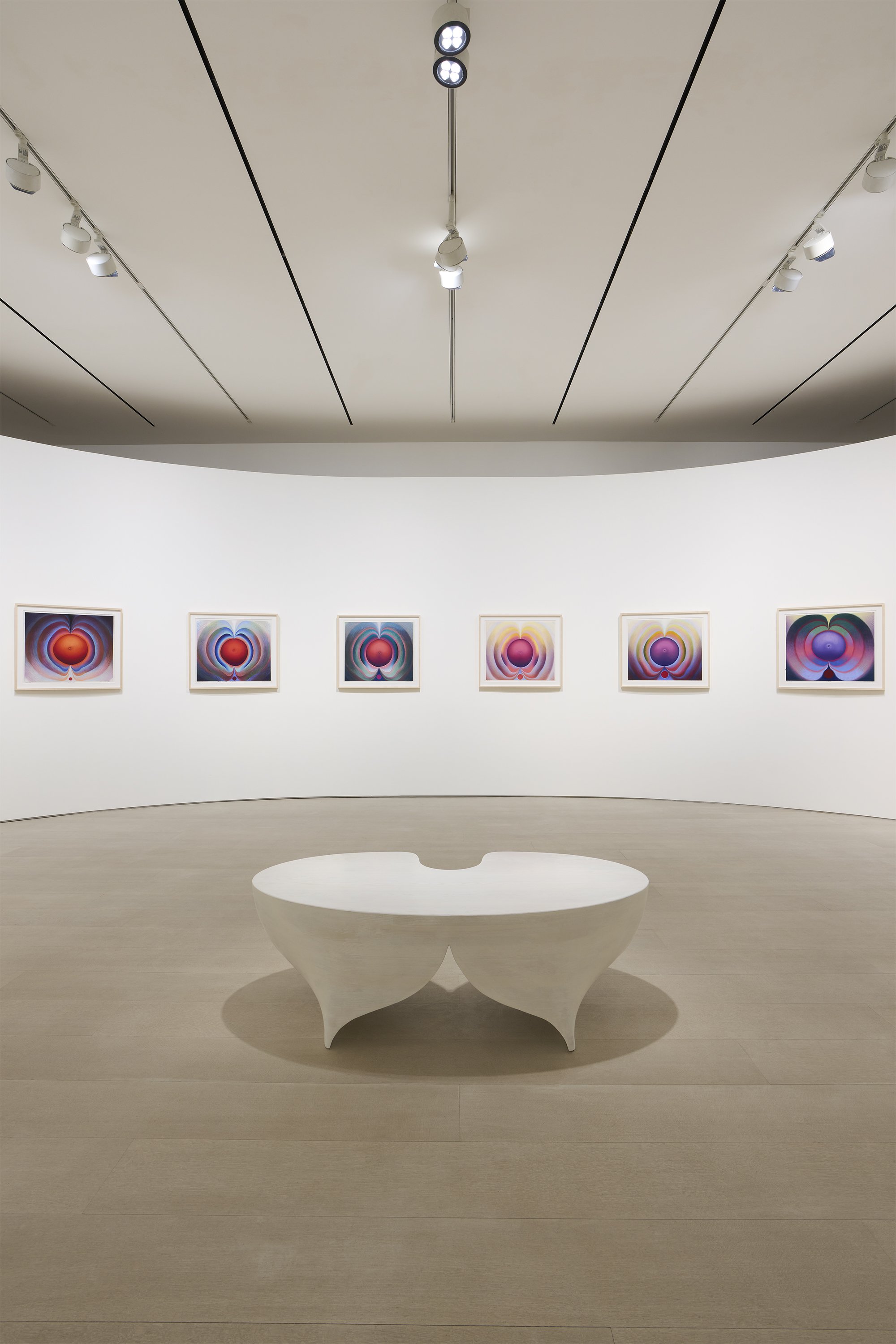
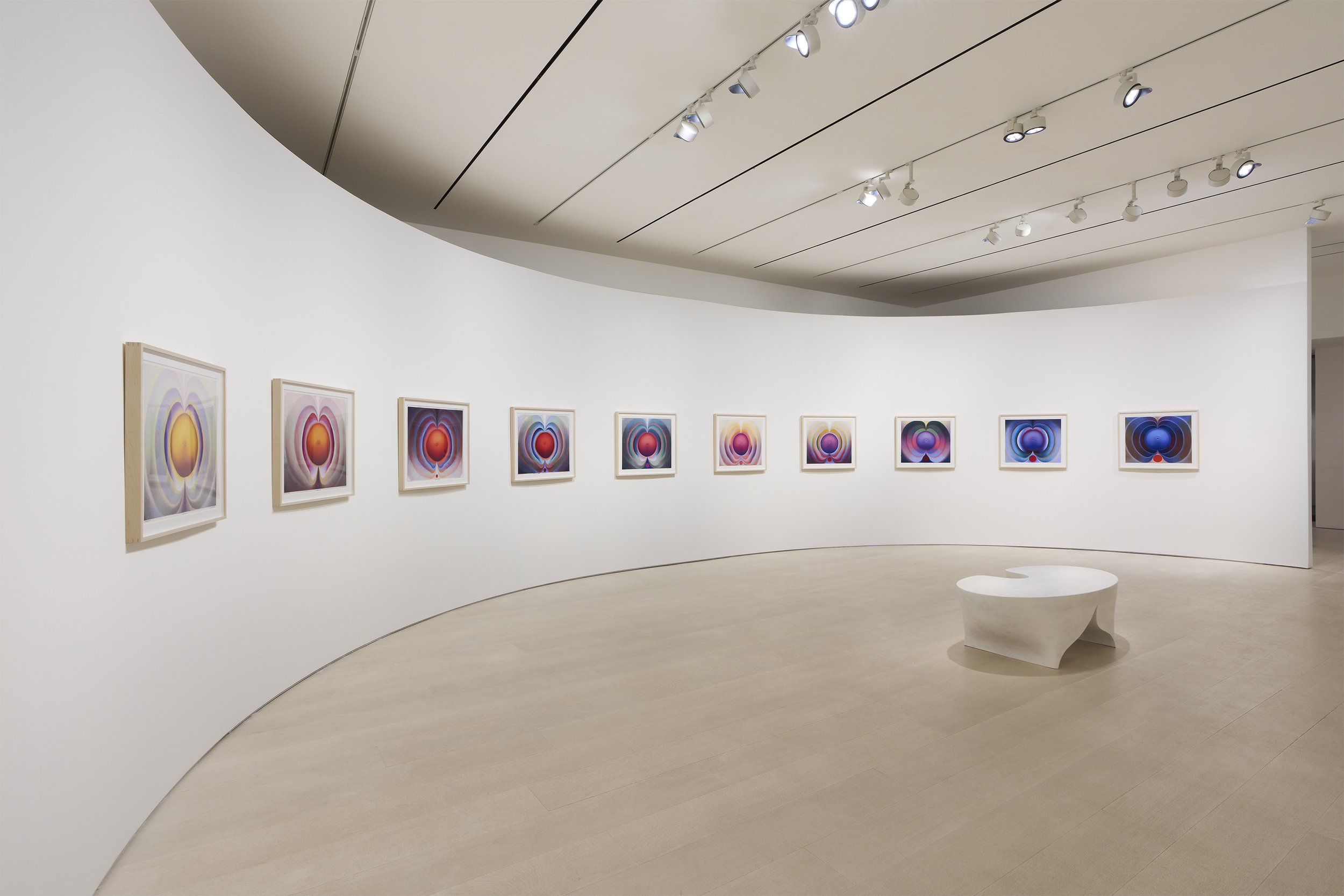
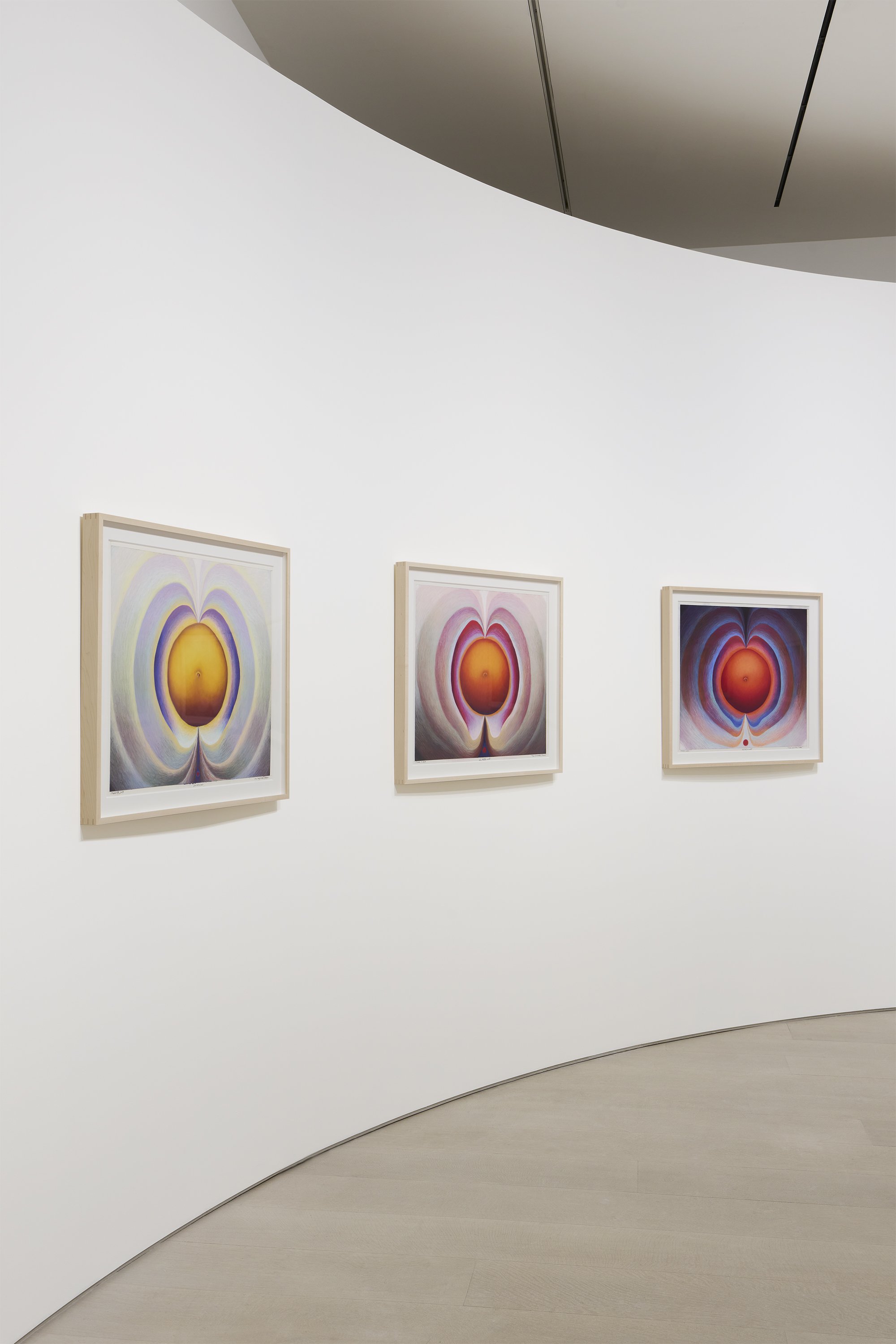
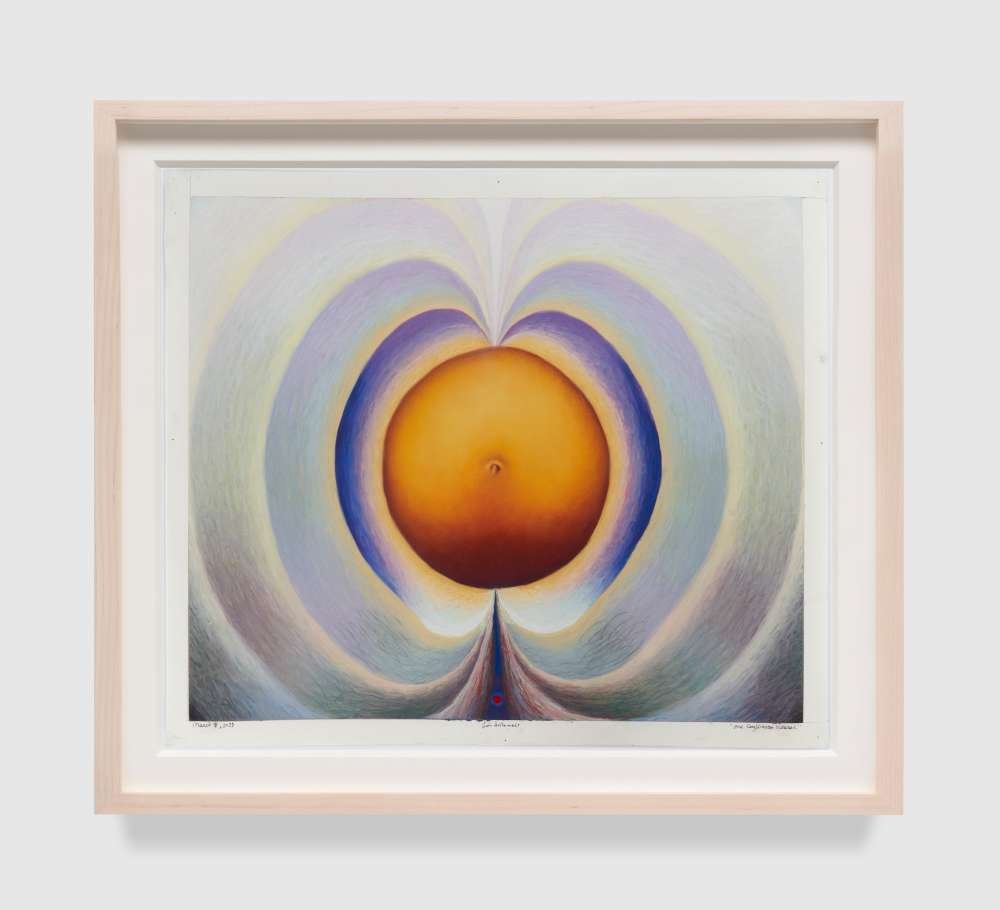
Loie Hollowell: Dilation Stage 540 West 25th Street, New York, NY 10001March 8–April 20, 2024 Photography courtesy Pace Gallery
In her show with Pace in New York, Hollowell presents ten new pastel drawings that document the dilation stage of labor, in which the cervix opens and effaces from one to ten centimeters, allowing the baby to move into the birth canal. Displayed sequentially on a rounded wall that reflects the shape of a pregnant belly, these drawings feature, at their centers, depictions of Hollowell’s own pregnant abdomen, rendered to scale. Below each belly is a circle the exact size of the effaced cervix as it expands. Meanwhile, radiating bands of color—which represent the increasingly intense pain of contractions during the dilation stage—fill the spaces around the bellies. In each composition, these rippling colors respond to the hue of the swollen wombs from which they emanate— Hollowell assigns light colors to minimally painful contractions, while intensely painful contractions take on dark colors. The cervical “circles” at the bottom of each drawing seem to pulse as the series progresses, culminating in a blazing cadmium red.
Four Centimeters Dilated, March 22, 2023 WORK ON PAPER soft pastel on paper 26"×28"(66cm×71.1cm) framed, 29-15/16" × 33- 15/16" (76 cm × 86.2 cm) No. 87553 © Loie Hollowell, courtesy Pace Gallery
For this body of work, in which color is a highly charged force, Hollowell adopts a wide ranging palette to express the mental and physical sensations she has experienced while giving birth. “When the first contractions started with each of my pregnancies, I was filled with joy and excitement that I would soon be meeting my baby,” Hollowell says. “I rendered this stage in yellow, like the sun on a cloudless day, full of light and optimism. As my cervix dilated, the pain became increasingly intense and sharp, so I moved into bright, deep reds for that stage. My second birth was at home in a birthing tub—I was enveloped in buoyant, luke-warm water while also having this searing and heavy pain. I felt only an ultramarine blue could rightfully signify that experience.”
Two Centimeters Dilated, March 10, 2023 WORK ON PAPER soft pastel on paper 26"×30"(66cm×76.2cm) framed, 29-15/16" × 33- 15/16" (76 cm × 86.2 cm) No. 87551 © Loie Hollowell, courtesy Pace Gallery
In addition to these drawings, the exhibition includes a unique birthing bench that Hollowell created collaboratively with her husband, sculptor Brian Caverly. The history of the birthing chair—which has been used by women in labor throughout millennia—extends all the way back to 1450 BCE Egypt. In Caverly and Hollowell’s rendition, which visitors are invited to sit on, space is created not just for the birther, but also for the partner, midwife, doula, doctor, or any other witness to the transcendent journey of birth.
Later this year, Pace will present an exhibition of new paintings by Hollowell at its Los Angeles gallery. Details about this presentation will be announced in due course.
Loie Hollowell (b. 1983, raised in Woodland, CA) is recognized for her paintings that evoke bodily landscapes, using geometric shapes to move a figure or its actions into abstraction. Her work explores themes of sexuality, often through allusions to the human form with an emphasis on women’s bodies. An investigation of autobiography became evident in Hollowell’s early work, which explored the use of gradient staining techniques on cotton supports as a metaphor for intimate spaces—meditations on sleep and bodily fluids. These canvases evolved into figurative painting, introducing female nudes as subject matter as well as the use of reflection and mirroring. Her subsequent work exhibited a shift toward abstraction, characterized by radiating silhouettes and a pulsating color palette. With its strong colors, varied textures, and geometrical symmetry, Hollowell’s practice is situated in lineage with the work of the Transcendental Painting Group (1938–41), Georgia O’Keeffe, Gulam Rasool Santosh, and Judy Chicago.
Pace is a leading international art gallery representing some of the most influential contemporary artists and estates from the past century, holding decades-long relationships with Alexander Calder, Jean Dubuffet, Barbara Hepworth, Agnes Martin, Louise Nevelson, and Mark Rothko. Pace enjoys a unique U.S. heritage spanning East and West coasts through its early support of artists central to the Abstract Expressionist and Light and Space movements.
Since its founding by Arne Glimcher in 1960, Pace has developed a distinguished legacy as an artist-first gallery that mounts seminal historical and contemporary exhibitions. Under the current leadership of CEO Marc Glimcher, Pace continues to support its artists and share their visionary work with audiences worldwide by remaining at the forefront of innovation. Now in its seventh decade, the gallery advances its mission through a robust global program— comprising exhibitions, artist projects, public installations, institutional collaborations, performances, and interdisciplinary projects. Pace has a legacy in art bookmaking and has published over five hundred titles in close collaboration with artists, with a focus on original scholarship and on introducing new voices to the art historical canon.
Today, Pace has seven locations worldwide, including European footholds in London and Geneva as well as Berlin, where the gallery established an office in 2023. Pace maintains two galleries in New York—its headquarters at 540 West 25th Street, which welcomed almost 120,000 visitors and programmed 20 shows in its first six months, and an adjacent 8,000 sq. ft. exhibition space at 510 West 25th Street. Pace’s long and pioneering history in California includes a gallery in Palo Alto, which was open from 2016 to 2022. Pace’s engagement with Silicon Valley’s technology industry has had a lasting impact on the gallery at a global level, accelerating its initiatives connecting art and technology as well as its work with experiential artists. Pace consolidated its West Coast activity through its flagship in Los Angeles, which opened in 2022. Pace was one of the first international galleries to establish outposts in Asia, where it operates permanent gallery spaces in Hong Kong and Seoul, along with an office and viewing room in Beijing. In spring 2024, Pace will open its first gallery space in Japan in Tokyo’s new Azabudai Hills development.
For more information about this exhibition and others, please visit the Pace Gallery’s website here. Pace Gallery can be found on Instagram and Artsy, too.
Chuck Close : Red, Yellow and Blue: The Last Paintings
Fred/Diptych, 2017-2018 PAINTING oil on canvas 36" × 30" × 1-1/4" (91.4 cm × 76.2 cm × 3.2 cm), two panels, each No. 69339 © Chuck Close, courtesy Pace Gallery
New York – Pace is pleased to present an exhibition of the last paintings of Chuck Close at its 510 West 25th Street gallery in New York which opened on February 23 and will be on view until April 13, 2024. This is the gallery’s first presentation dedicated to the artist's work since his death in 2021; this show features a selection of paintings, photographs, and works on paper—most of which have never been exhibited before—that reflect Close’s significant contributions to the history of art. Since it began representing Close in 1977, Pace has exhibited each new body of his work, and this presentation will complete that cycle.
Brad, 2020-2021 PAINTING oil on canvas 36" × 30" (91.4 cm × 76.2 cm) No. 77931 ©Chuck Close, courtesy Pace Gallery
The exhibition is accompanied by a catalogue featuring a previously unpublished 2018 interview between Close and the artist Cindy Sherman—originally commissioned by The Brooklyn Rail—as well as a new critical essay by Carter Ratcliff, which considers Close’s final works in depth. These texts appear alongside an essay by Barbara Knappmeyer that examines the artist’s renderings of the face in the context of facial recognition technology.
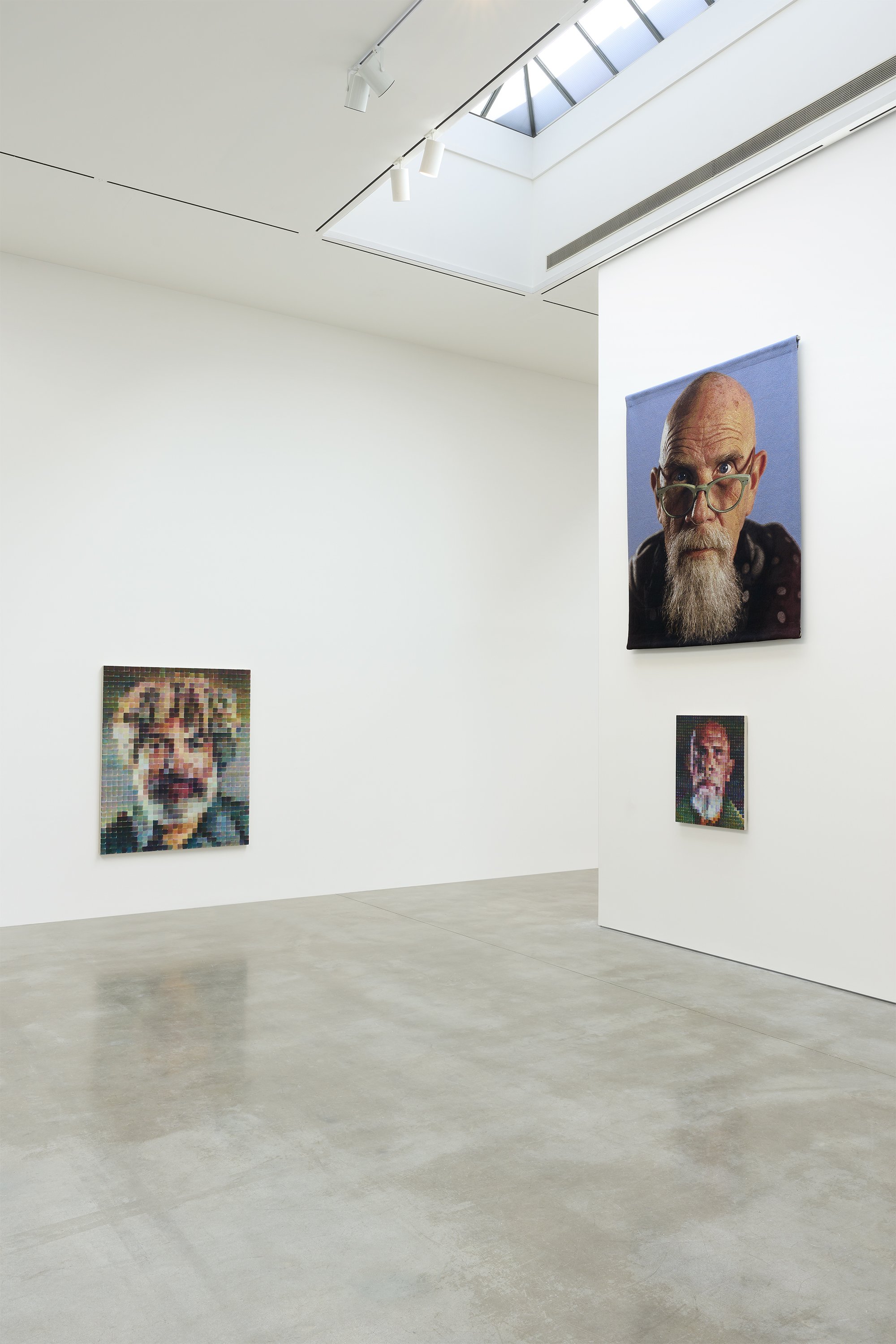
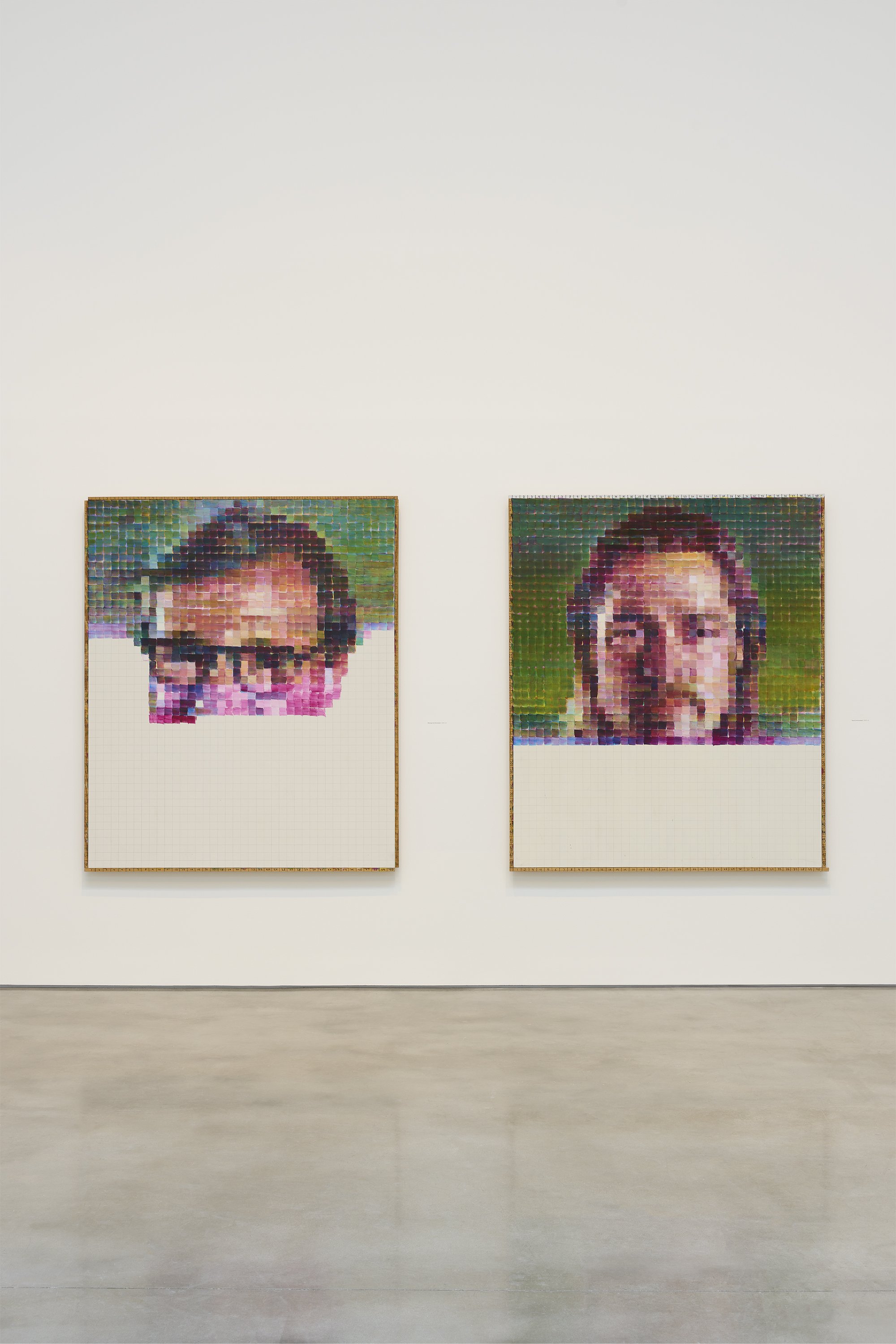
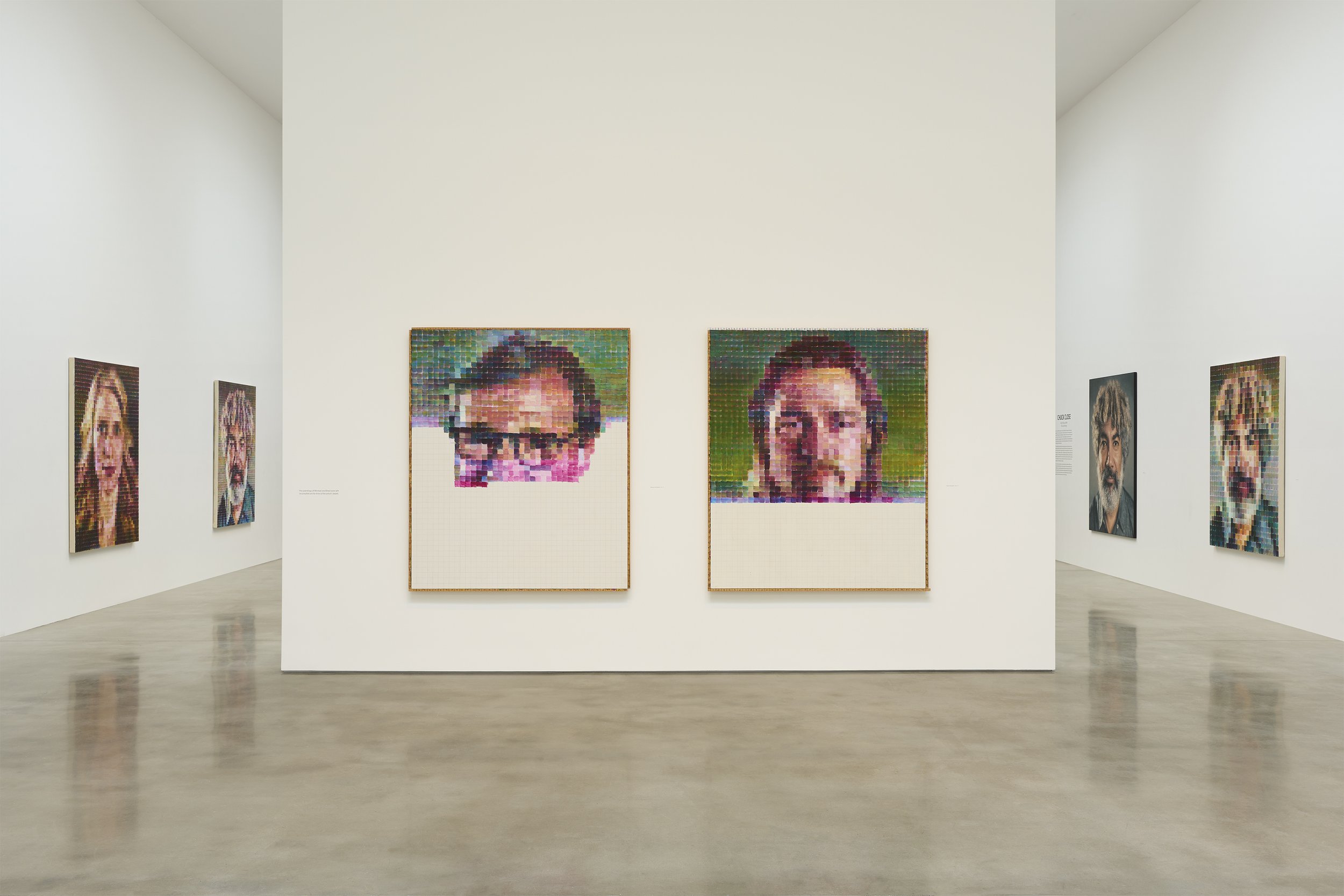

Chuck Close, Red, Yellow and Blue: The Last Paintings 510 West 25th Street, New York, NY 10001 February 23 – April 13, 2024 Photography courtesy Pace Gallery
Since the 1970s, Close has been known for his innovative approach to conceptual portraiture, systematically transposing his subjects’ likenesses from photographs into gridded paintings. Over the course of five decades, his work challenged conventional modes of representation across a wide range of media, including various forms of painting, printmaking, drawing, collage, daguerreotypes, Polaroid photography, and tapestry.
Baby Jane, 2018-2019 PAINTING oil on canvas 102-1/2" × 84" (260.4 cm × 213.4 cm) No. 73510©Chuck Close, courtesy Pace Gallery
The artist posed a radical proposition with his approach to painting, going against the grain of art world trends during the late 1960s and 1970s, when Minimalism, abstraction, and seriality were dominant, and portraiture and photorealism were largely overlooked. Pace’s exhibition spotlights Close’s final body of paintings, which includes works that have never been publicly exhibited. These full-color portraits and self-portraits employ a palette of only three colors: red, yellow, and blue.
Claire, 2020 PAINTING oil on canvas 72" × 60" (182.9 cm × 152.4 cm) No. 77932 ©Chuck Close, courtesy Pace Gallery
Layering transparent glazes of paint, Close created an effect of abstract likeness entirely different from that of his previous work. The complex color relationships that unfold in these paintings are visible at the bleeding edges of each square within the grid, where the ragged ends of each individual color are visible. Meditating on the power of color itself, Close’s final works suggest the constructive aesthetics of Impressionism, where form is built up through a chromatic architecture of brushstrokes. Appearing more abstract than representational to the human eye, the likenesses in these portraits come into greater focus when viewed from a distance or through the lens of a camera, an act of transfiguration that speaks to the artist’s interest in modes of perception and information processing.
Close realized these formal achievements in his last works while grappling with long-term health issues precipitated by a spinal aneurysm that he suffered in 1988 at the age of 48. Having lost the use of his arms and legs as a result of the aneurysm, Close was told by doctors that he would never be able to paint again. Through a grueling process of rehabilitation, he eventually regained his ability to paint by using a brush-holding device strapped to his wrists and forearms. Working through this disability for the rest of his life, he was forced to teach himself how to paint in an entirely new way, reinventing his approach to the medium in the middle of his career. In his final works, Close continued to push against the constraints of his physical disability to reinvent his own painterly language once again.
Even prior to his aneurysm, however, Close struggled with other disabilities. Throughout his childhood and adolescence, he used art as a means of navigating severe dyslexia and prosopagnosia, or face blindness. Having studied at the University of Washington, Yale, and the Akademie der Bildenden Künste in Vienna, he began teaching at the University of Massachusetts, Amherst—where he would present his first solo exhibition—in the mid-1960s. Upon relocating to New York, the artist continued to explore new modes of realism, using an airbrush to paint blackand-white, highly detailed photographic portraits of himself, his family, and his friends onto large-scale canvases, a practice he would continue for the rest of his career. Close began in the late 1970s to make use of a grid system based on a physical relationship to his support. The resulting works read like pixelated mosaics wherein the viewer deciphers a unified image within juxtaposed colors, shapes, lines, and fingerprints. The artist’s first retrospective, titled Close Portraits, was organized by the Walker Art Center in Minneapolis in 1980. That show traveled to the St. Louis Art Museum in Missouri and the Museum of Contemporary Art Chicago before closing at the Whitney Museum of American Art in New York. In the early 1990s, he began experimenting with portraiture through the production of silk tapestries and, in 2003, he furthered this investigation, creating editions of large-scale Jacquard tapestry portraits. In 1998, the Museum of Modern Art in New York presented a full-scale retrospective of Close’s career that included more than 90 paintings, drawings, and photographs, cementing his status as one of the most influential artists of his generation.
Fred II, 2017 PAINTING oil on canvas 72"×60"×2"(182.9cm× 152.4 cm × 5.1 cm) No. 68273 © Chuck Close, courtesy Pace Gallery
Chuck Close’s (b. 1940, Monroe, Washington; d. 2021, New York) commitment to process and media characterized his approach to portraiture. He began creating portraits based on photographs in the late 1960s, using a grid to map each facial detail, which he would then recreate in exacting detail through painting. Beginning in the late 1970s,
Close began to diverge from his highly detailed approach, instead constructing images that are still organized by a grid, but with layers of autonomous shapes and colors that cohere into his subject’s face when viewed from a distance. Close constantly revitalized his practice through varied media and modes of representation and his oeuvre encompassed many modes of art-making, including painting, printmaking, drawing, collage, daguerreotype and Polaroid photography, mosaic, and tapestries.
Pace is a leading international art gallery representing some of the most influential contemporary artists and estates from the past century, holding decades-long relationships with Alexander Calder, Jean Dubuffet, Barbara Hepworth, Agnes Martin, Louise Nevelson, and Mark Rothko. Pace enjoys a unique U.S. heritage spanning East and West coasts through its early support of artists central to the Abstract Expressionist and Light and Space movements.
Since its founding by Arne Glimcher in 1960, Pace has developed a distinguished legacy as an artist-first gallery that mounts seminal historical and contemporary exhibitions. Under the current leadership of CEO Marc Glimcher, Pace continues to support its artists and share their visionary work with audiences worldwide by remaining at the forefront of innovation. Now in its seventh decade, the gallery advances its mission through a robust global program— comprising exhibitions, artist projects, public installations, institutional collaborations, performances, and interdisciplinary projects. Pace has a legacy in art bookmaking and has published over five hundred titles in close collaboration with artists, with a focus on original scholarship and on introducing new voices to the art historical canon.
Today, Pace has seven locations worldwide, including European footholds in London and Geneva as well as Berlin, where the gallery established an office in 2023. Pace maintains two galleries in New York—its headquarters at 540 West 25th Street, which welcomed almost 120,000 visitors and programmed 20 shows in its first six months, and an adjacent 8,000 sq. ft. exhibition space at 510 West 25th Street. Pace’s long and pioneering history in California includes a gallery in Palo Alto, which was open from 2016 to 2022. Pace’s engagement with Silicon Valley’s technology industry has had a lasting impact on the gallery at a global level, accelerating its initiatives connecting art and technology as well as its work with experiential artists. Pace consolidated its West Coast activity through its flagship in Los Angeles, which opened in 2022. Pace was one of the first international galleries to establish outposts in Asia, where it operates permanent gallery spaces in Hong Kong and Seoul, along with an office and viewing room in Beijing. In spring 2024, Pace will open its first gallery space in Japan in Tokyo’s new Azabudai Hills development.
For more information about this exhibition and others, please visit the Pace Gallery’s website here. Pace Gallery can be found on Instagram and Artsy, too.
Rollie McKenna: Making a Life in Photography
Rollie McKenna, Making A Life In Photography: Rollie McKenna, Installation view, Vassar College’s Frances Lehman Loeb Art Center Photo credit: Thomas Barratt Photography
Vassar College’s Frances Lehman Loeb Art Center presents Making A Life In Photography: Rollie McKenna, the first survey of the prolific career of American photographer Rosalie (Rollie) Thorne McKenna, the exhibition opened on February 17 of this year and will be on view until June 2, 2024.
Rollie McKenna, Laura Gilpin, 1962, Gelatin silver print, Frances Lehman Loeb Art Center, Vassar College, Gift of the artist, 1987.53.67 © The Rosalie Thorne McKenna Foundation, Courtesy Center for Creative Photography, The University of Arizona Foundation Dimensions: 5 x 6 15/16 in.
McKenna, Vassar Class of 1940, worked independently as a sought-after architectural and portrait photographer, making unique yet underrecognized contributions to American modernism and documentary photography. McKenna’s work was published in numerous books and magazines including Vogue, Vanity Fair, and Fortune. The Museum of Modern Art’s 1955 landmark exhibition Latin American Modernism Since 1945 featured her architectural photographs. She made iconic portraits of artists and writers, including W. H. Auden, Elizabeth Bishop, Alexander Calder, Truman Capote, T. S. Eliot, Laura Gilpin, Henry Moore, Sylvia Plath, Ezra Pound, Anne Sexton, Dylan Thomas, and Eudora Welty. Using her camera, McKenna forged an unusual path for a woman in mid-twentieth-century America toward personal and creative freedom. She embraced photography to explore the complexities of human experience—including her own queer and feminist life.
Rollie McKenna, Alexander Calder, Acoustic Ceiling, Carlos Raúl Villanueva, Aula Magna, Universidad Central de Venezuela, Caracas, Venezuela 1952–1953, 1954–55, Ferrotyped gelatin silver print, Frances Lehman Loeb Art Center, Vassar College, Transfer from the Vassar College Art Department, SC.55.19 © The Rosalie Thorne McKenna Foundation, Courtesy Center for Creative Photography, The University of Arizona Foundation Dimensions: 7 1/2 x 8 in.
Making a Life in Photography offers a new thematic frame to consider the significance of McKenna’s contributions to photography: Her career as an independent, working photographer enabled her to make an independent life; and in turn, her self-determination motivated her to pursue photography. In reference to the framework of the exhibition, Mary-Kay Lombino, Deputy Director and Emily Hargroves Fisher ’57 and Richard B. Fisher Curator at the Loeb, says, “We emphasize McKenna’s entrepreneurship and work outside of the darkroom to demonstrate, especially to an audience of undergraduate students thinking about making their own way in the world, that artists are not simply born into creativity, but rather, they make careers as creative professionals.”
Rollie McKenna, Anne Sexton, 1961, Gelatin silver print; printed 1983, Frances Lehman Loeb Art Center, Vassar College, Purchase, Francis Woolsey and Helen Silkman Bronson, class of 1924, Fund, 1983.5 © The Rosalie Thorne McKenna Foundation, Courtesy Center for Creative Photography, The University of Arizona Foundation Dimensions: 13 1/2 x10 7/8 in.
McKenna’s rich history of self-determination and spirit goes beyond her photography: As the US entered World War II, she enlisted in Women Accepted for Voluntary Emergency Service (WAVES), becoming the first woman to attain the rank of sharpshooter in the U.S. Navy and receiving the Navy Expert Pistol Shot Medal in 1943. During her brief and only marriage, McKenna returned to Vassar in 1948 and 1949 to pursue a master’s degree in the history of art, with special dispensation secured by professor of art history Agnes Rindge Claflin under the G.I. Bill.
Rollie McKenna, Dylan Thomas, 1953, Gelatin silver print; printed 1983, Frances Lehman Loeb Art Center, Vassar College, Purchase, Francis Woolsey and Helen Silkman Bronson, class of 1924, Fund, 1983.6 © The Rosalie Thorne McKenna Foundation, Courtesy Center for Creative Photography, The University of Arizona Foundation Dimensions: 14 9/16 x 12 3/16 in.
The exhibition, presented thematically in four galleries, features over 100 gelatin silver prints made during the artist’s lifetime, drawn primarily from the Loeb’s collection with the addition of several key loans. Exhibition themes include People & Places, McKenna’s Modernism, Life & Photography, and McKenna at Work, while other issues such as artistic legacy, the complexities of privilege, and accepted conventions of both womanhood and photographic genre are addressed. “This career retrospective of McKenna, who is the most represented individual photographer in the Loeb’s collection, highlights her work as emblematic not only of the Loeb, but as part of her history with Vassar College,” says T. Barton Thurber, the Anne Hendricks Bass Director of the Loeb Art Center.
Vassar College’s Frances Lehman Loeb Art Center presents Making A Life In Photography: Rollie McKenna, the first survey of the prolific career of American photographer Rosalie (Rollie) Thorne McKenna, on view February 17–June 2, 2024. Photo credit: Thomas Barratt Photography
Complementing the exhibition in the Loeb, a satellite exhibition, Rollie McKenna’s Photography: In Print and at Vassar, featuring McKenna’s photographs published in books and magazines and photos taken for and of Vassar, will be shown in the Thompson Library. The Library’s Archives and Special Collections houses archival documents and work prints that relate to McKenna’s time on campus as a student and later as a frequent visiting photographer covering student life, campus architecture, special events, and faculty personalities. Among the work is a 1955 story from Seventeen magazine, “Anne Goes to Vassar,” written and photographed by McKenna, which chronicles the story of Anne Breukelman, class of 1958, during her first days at Vassar. The Library exhibition is located on the first floor, just beyond the main entrance and circulation desk, on view from February 22–June 2, 2024.
Vassar College’s Frances Lehman Loeb Art Center presents Making A Life In Photography: Rollie McKenna, the first survey of the prolific career of American photographer Rosalie (Rollie) Thorne McKenna, on view February 17–June 2, 2024. Photo credit: Thomas Barratt Photography
The Loeb exhibition is also accompanied by a fully illustrated catalog, co-published by Vassar College and Scala Arts Publishers, including contributions by Jessica D. Brier, Mary-Kay Lombino, Rebecca Senf, T. Barton Thurber, and Luísa Valle.
Making a Life in Photography: Rollie McKenna is generously supported by the Rosalie Thorne McKenna Foundation and the Hoene Hoy Photography Fund.
Rollie McKenna, Elizabeth Bishop, 1954, Gelatin silver print, Frances Lehman Loeb Art Center, Vassar College, Gift of the artist, 1987.53.35 © The Rosalie Thorne McKenna Foundation, Courtesy Center for Creative Photography, The University of Arizona Foundation Dimensions: 8 3/4 x 7 1/4 in.
In this two-part lecture by Mindy Seu and Celine Wong Katzman, Seu will do a performative reading of the Cyberfeminism Index followed by Wong Katzman’s introduction to building intersectional feminist, archival, and curatorial frameworks in the contemporary art world.
Co-sponsored by the Vassar Art Department and the Loeb Art Center.
Exhibition curators Jessica D. Brier and Mary-Kay Lombino, joined by Loeb Director T. Barton Thurber and Visiting Assistant Professor of Art Luísa Valle, will lead an exhibition tour focusing on highlights from McKenna’s prolific career.
Vassar College’s Frances Lehman Loeb Art Center presents Making A Life In Photography: Rollie McKenna, the first survey of the prolific career of American photographer Rosalie (Rollie) Thorne McKenna, on view February 17–June 2, 2024. Photo credit: Thomas Barratt Photography
About the Frances Lehman Loeb Art Center
The Frances Lehman Loeb Art Center is a teaching and learning museum, free and open to all, supporting Vassar College’s educational mission and communities. Formerly the Vassar College Art Gallery, the Loeb is the first art museum at a college or university that was part of the institution’s original plan. Today, the permanent collection includes over 22,000 works, comprised of paintings, sculptures, drawings, photographs, textiles, and glass and ceramic wares. The Loeb strives to be a catalyst for scholarly, creative, and social justice work by Vassar students and others. It aims to reflect a commitment to broaden, and amplify, the voices represented in the museum setting, and to ensure that the Loeb’s programs and practices have a positive impact on campus and beyond. To learn more, please visit vassar.edu/theloeb or follow @theloeb.
Rollie McKenna, Juan O’Gorman, Gustavo Saavedra & Juan Martínez de Vasco, Biblioteca Central (Central University), Ciudad Universitaria, Mexico City, Mexico 1951–1953, 1954–55, Gelatin silver print, Frances Lehman Loeb Art Center, Vassar College, Transfer from the Vassar College Art Department, SC.55.4 © The Rosalie Thorne McKenna Foundation, Courtesy Center for Creative Photography, The University of Arizona Foundation Dimensions: 6 x 9 1/2 in.
Commitment to DEAI
The Frances Lehman Loeb Art Center, Vassar College commits to Diversity, Equity, Access, and Inclusion (DEAI) as core values across its culture, systems, and practices. We pledge to allocate resources (human and financial) to create and sustain a museum culture in which difference is celebrated. The Loeb staff is dedicated to integrating DEAI priorities into gallery installations, programming, interpretation, collections management, acquisitions, and internal processes. Our ongoing work is guided by an intention to care for all people engaged with the Loeb while welcoming the exchange of ideas, enriching experiences, and diverse perspectives through art.
Admission to the Frances Lehman Loeb Art Center is free and all galleries are wheelchair accessible. The Loeb is now open to the public every day (except Monday) from 10:00 a.m. to 5:00 p.m. The Loeb is located at 124 Raymond Avenue near the entrance to the Vassar College campus. Parking is available on Raymond Avenue. Directions to the Vassar campus in Poughkeepsie, NY, are available at https://www.vassar.edu/visit/tour#directions.
The Art Center is also accessible via the Dutchess County Public Transit, Bus Route L. For additional information, the public may call (845) 437-5632 or visit https://www.vassar.edu/theloeb.
Rollie McKenna, Vassar College, Ferry House—Exterior, 1951, Gelatin silver print, Frances Lehman Loeb Art Center, Vassar College, Gift of the artist, 1987.53.99 © The Rosalie Thorne McKenna Foundation, Courtesy Center for Creative Photography, The University of Arizona Foundation Dimensions: 6 3/4 x 8 5/8 in.
Land Acknowledgement
We acknowledge that Vassar stands upon the homelands of the Munsee Lenape, Indigenous peoples who have an enduring connection to this place despite being forcibly displaced by European colonization. Munsee Lenape peoples continue today as the Stockbridge-Munsee Community in Wisconsin, the Delaware Tribe and the Delaware Nation in Oklahoma, and the Munsee-Delaware Nation in Ontario. This acknowledgment, however, is insufficient without our reckoning with the reality that every member of the Vassar community since 1861 has benefited from these Native peoples’ displacement, and it is hollow without our efforts to counter the effects of structures that have long enabled—and that still perpetuate—injustice against Indigenous Americans. To that end, we commit to build and sustain relationships with Native communities; to expand opportunities at Vassar for Native students, as well as Native faculty and other employees; and to collaborate with Native nations to know better the Indigenous peoples, past and present, who care for this land.
Rollie McKenna, Lever House, New York City, 1956, Gelatin silver print, Frances Lehman Loeb Art Center, Vassar College, Gift of the artist, 1987.53.105 © The Rosalie Thorne McKenna Foundation, Courtesy Center for Creative Photography, The University of Arizona Foundation Dimensions: 7 1/8 x 12 3/4 in.
Picasso: Drawing from Life
Installation view: Picasso: Drawing from Life, 2024. The Art Institute of Chicago, Chicago. Courtesy of The Art Institute of Chicago.
CHICAGO—The Art Institute of Chicago is pleased to announce Picasso: Drawing from Life, opened on November 11, 2023, and will be on view through April 8, 2024. This year marks 50 years since the death of Spanish artist Pablo Picasso in 1973, and the Art Institute of Chicago is joining hundreds of presentations worldwide in honoring the artist’s legacy.
Installation view: Picasso: Drawing from Life, 2024. The Art Institute of Chicago, Chicago. Courtesy of The Art Institute of Chicago.
Picasso is often presented as a singular artistic genius solely responsible for his creative force, but he would not have achieved his immense success without the many people who supported him. The exhibition will highlight the stories of those who may previously have been lost in the shadow of Picasso—his artistic collaborators, printers, dealers, lovers, and family. Spanning the entirety of his 70-year career, including pieces from 1899 through 1969, this is a celebration of the Art Institute of Chicago’s extensive collection of Picasso’s works on paper and other pivotal works from the prolific artist. It will feature more than 60 objects, including drawings, prints, and illustrated books, along with a handful of paintings, and a sculpture.
Installation view: Picasso: Drawing from Life, 2024. The Art Institute of Chicago, Chicago. Courtesy of The Art Institute of Chicago.
“Picasso did not become the artist we know today on his own,” said Jay A. Clarke, Rothman Family Curator, Prints and Drawings. “Throughout his long career, Picasso collaborated with dealers, printers, and other artists who helped him to achieve fame and challenge him creatively.”
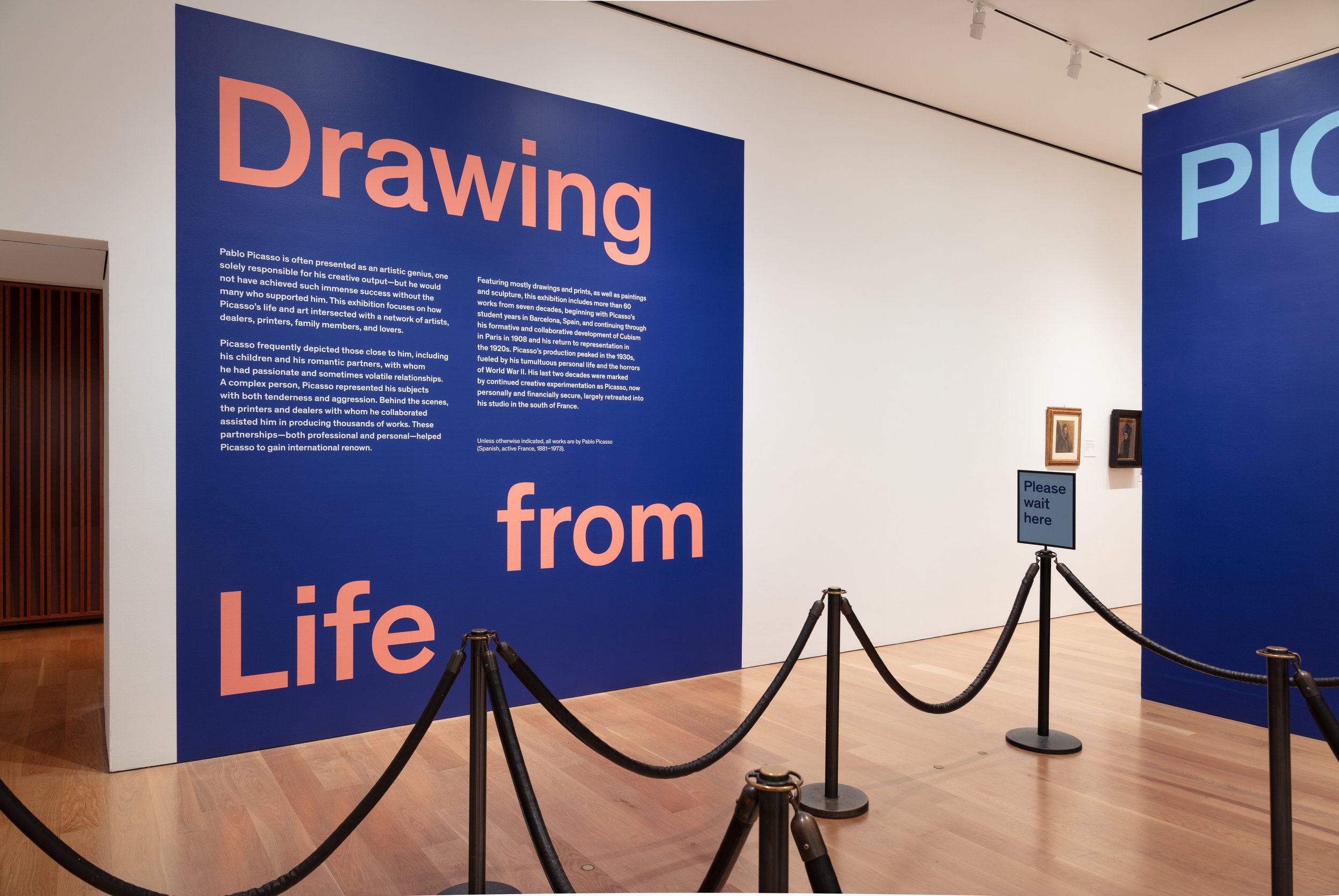
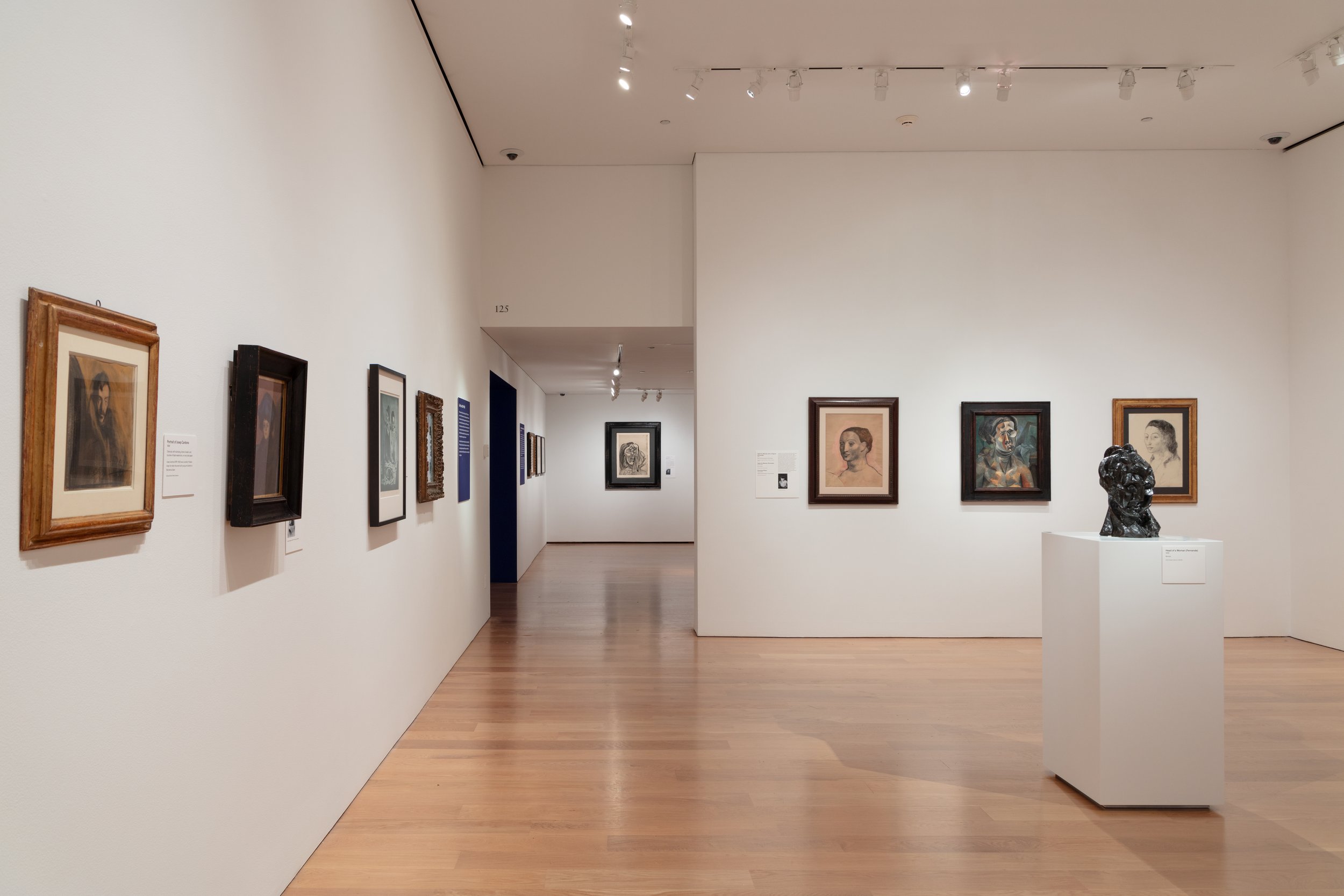
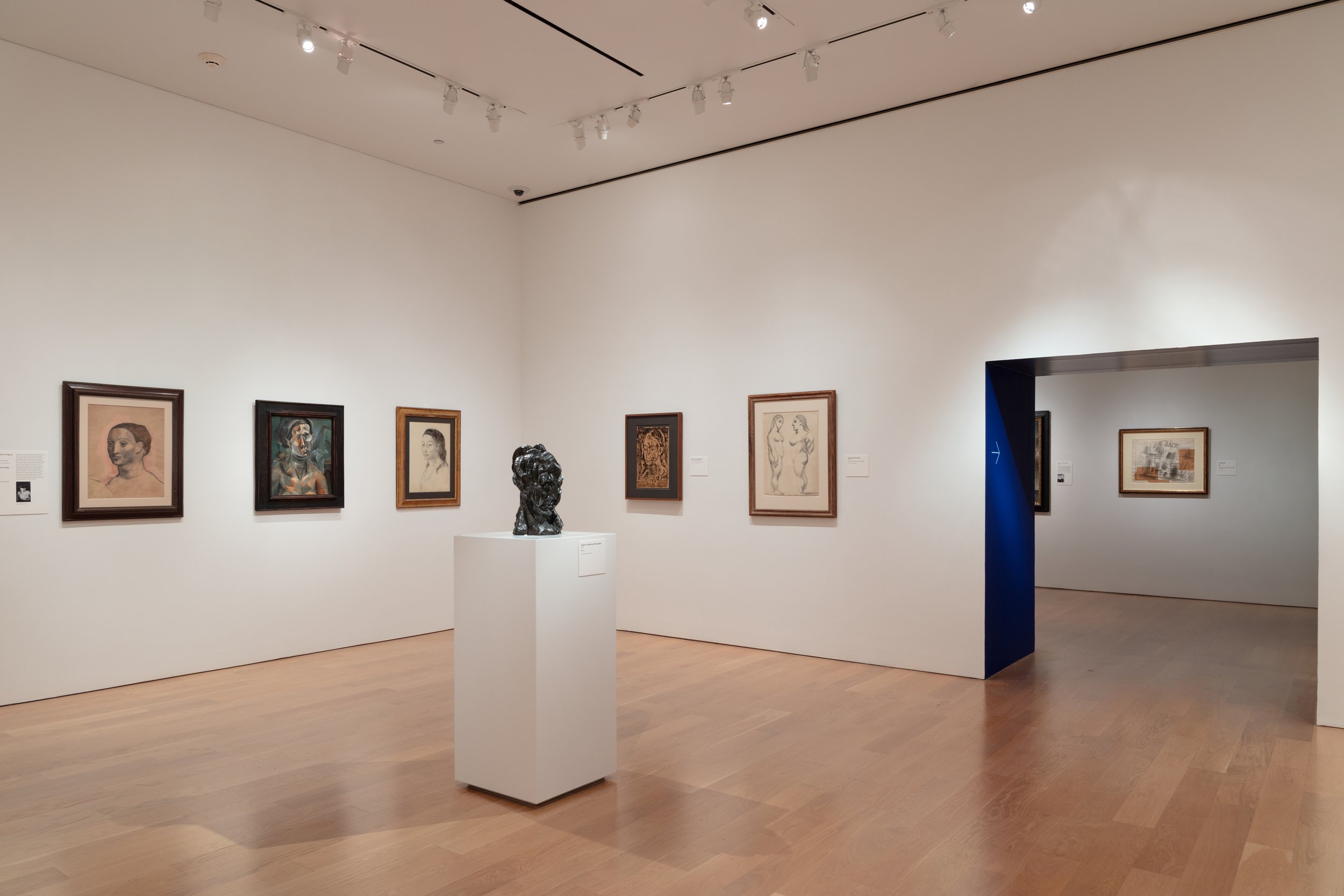
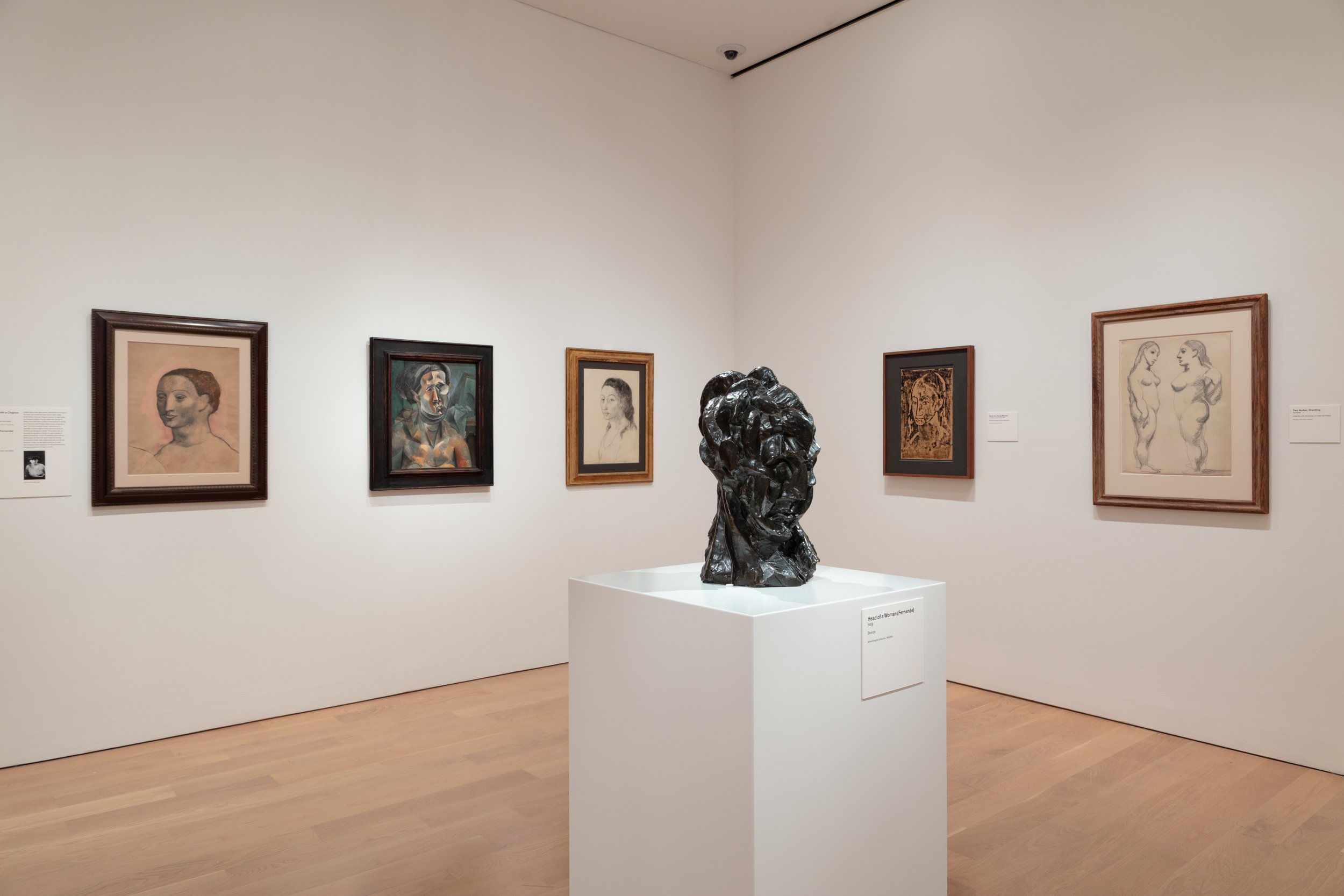
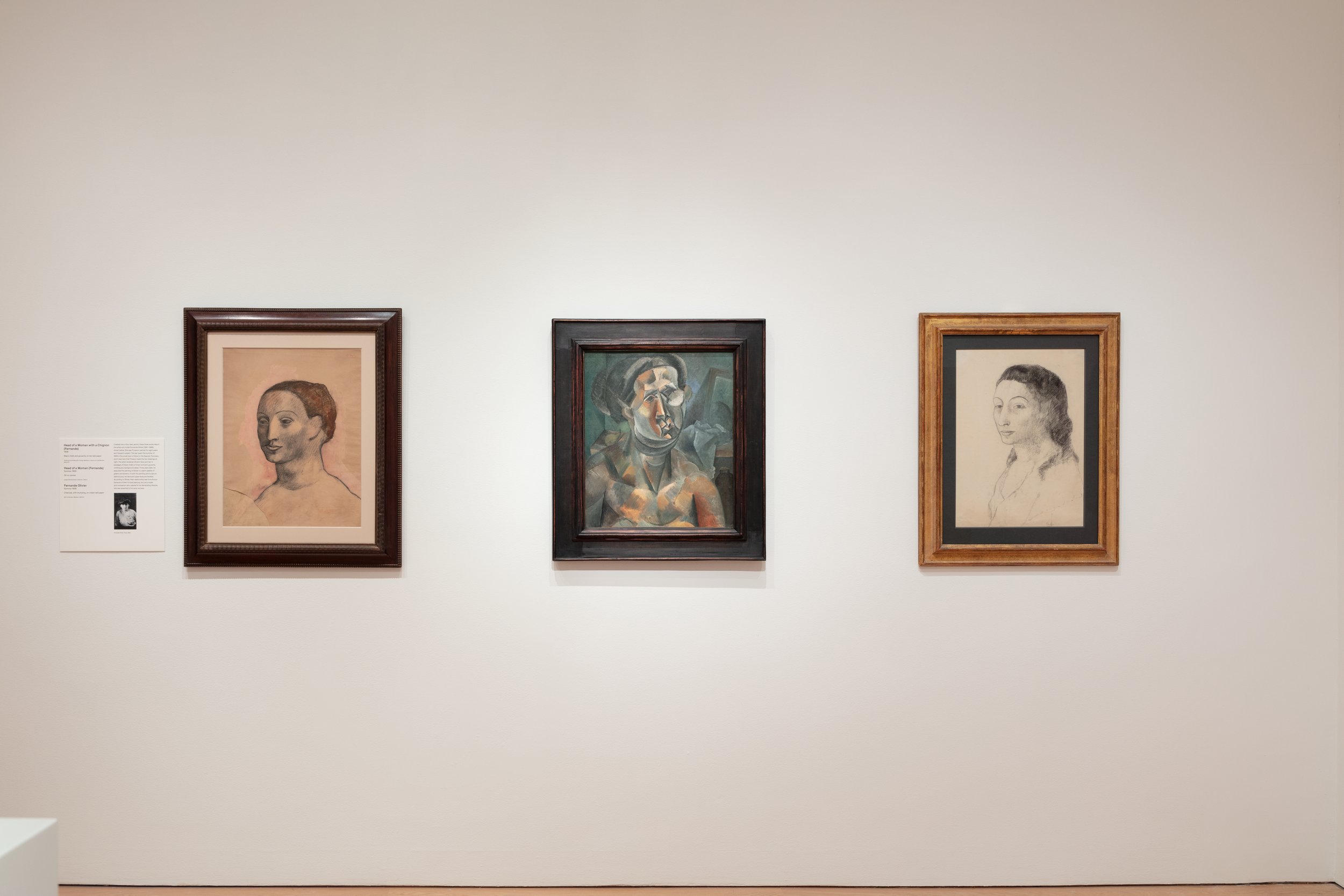
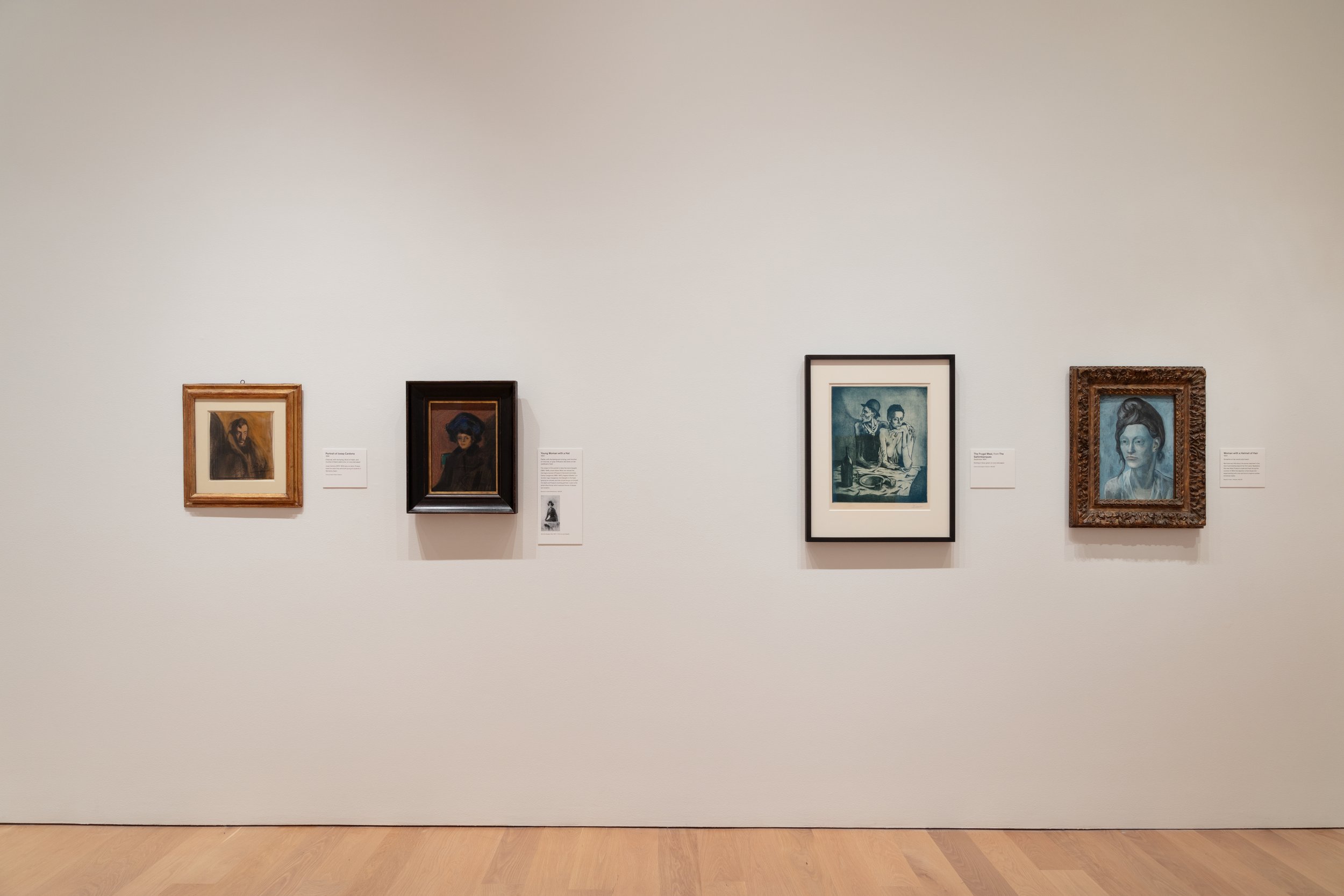

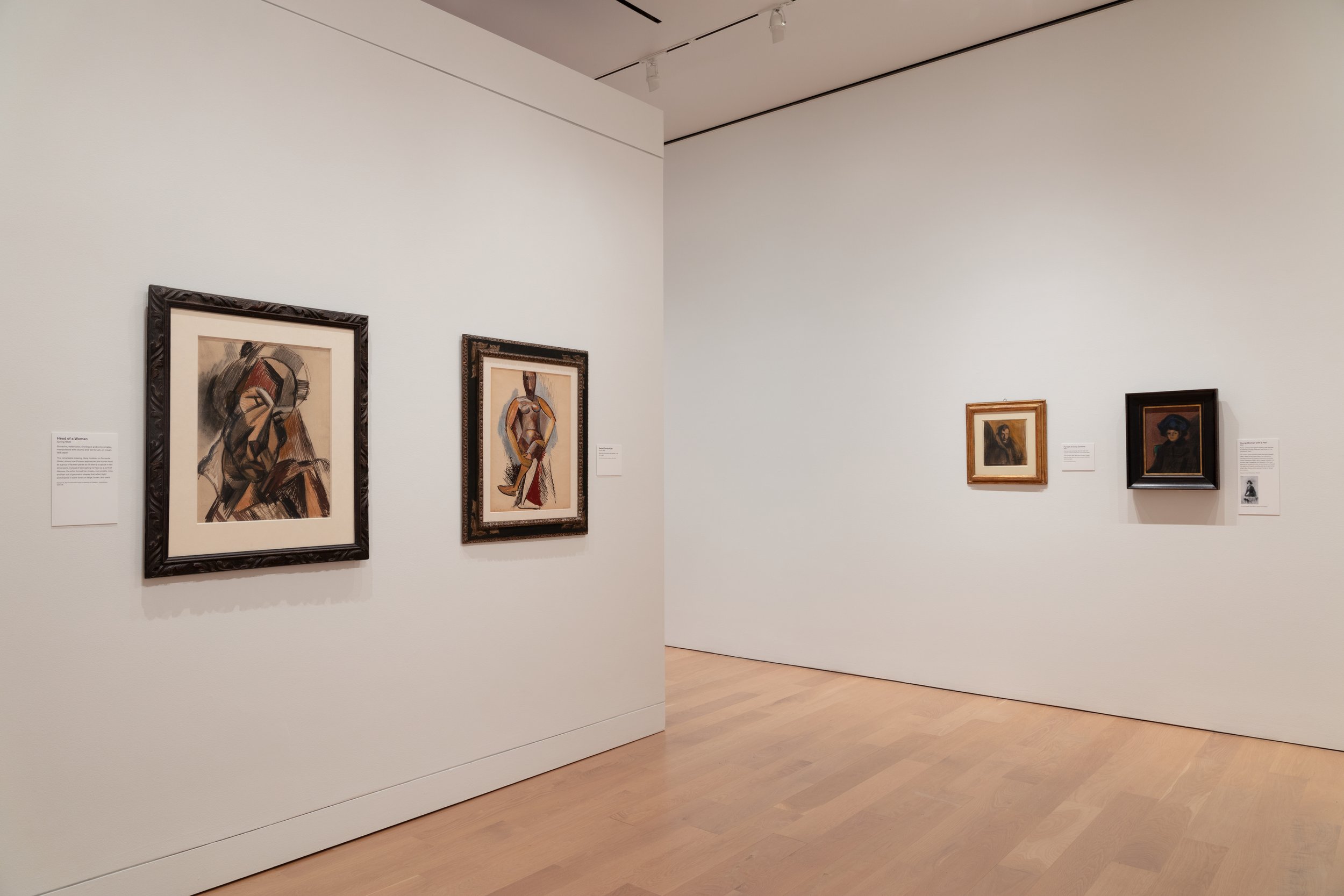
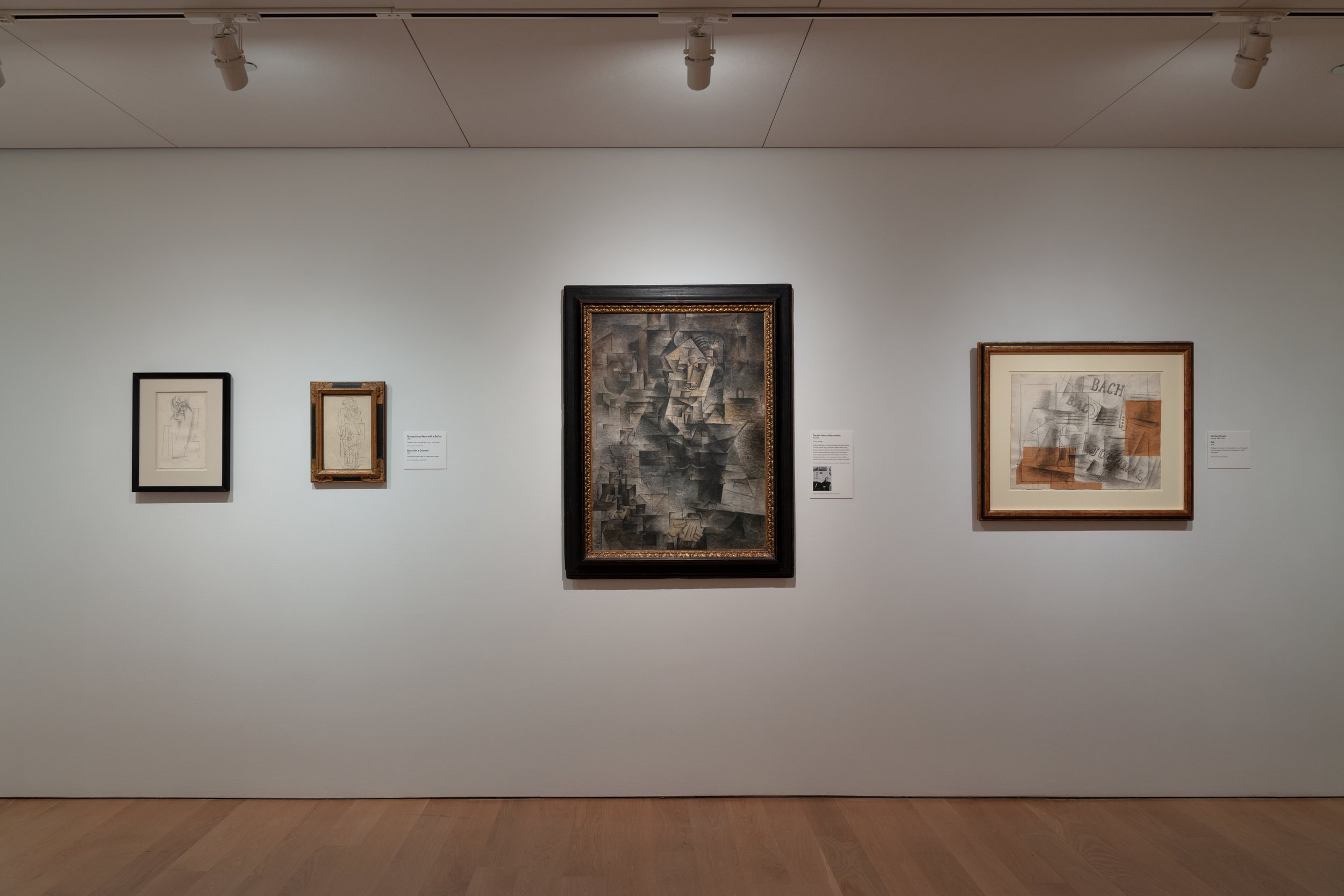
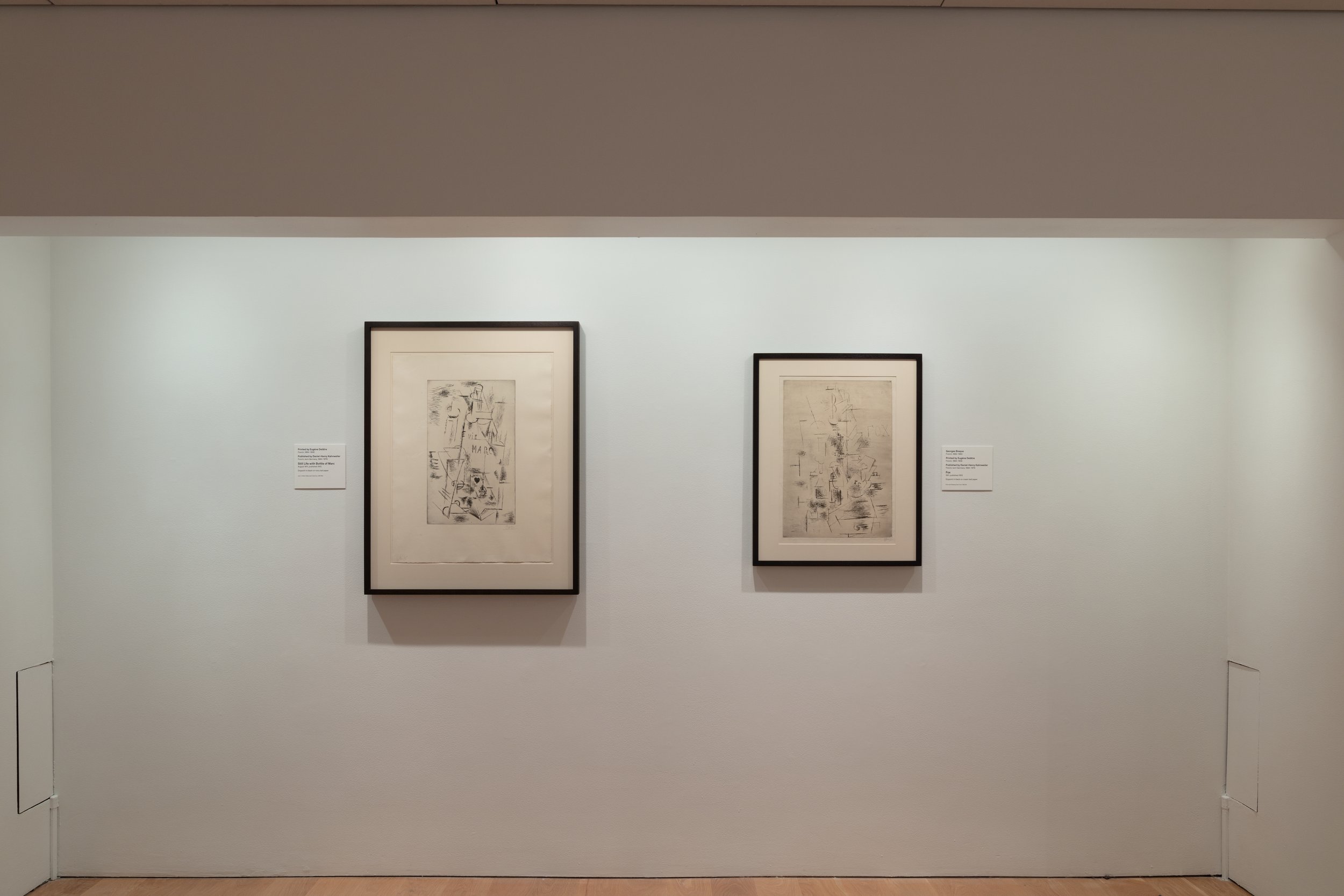
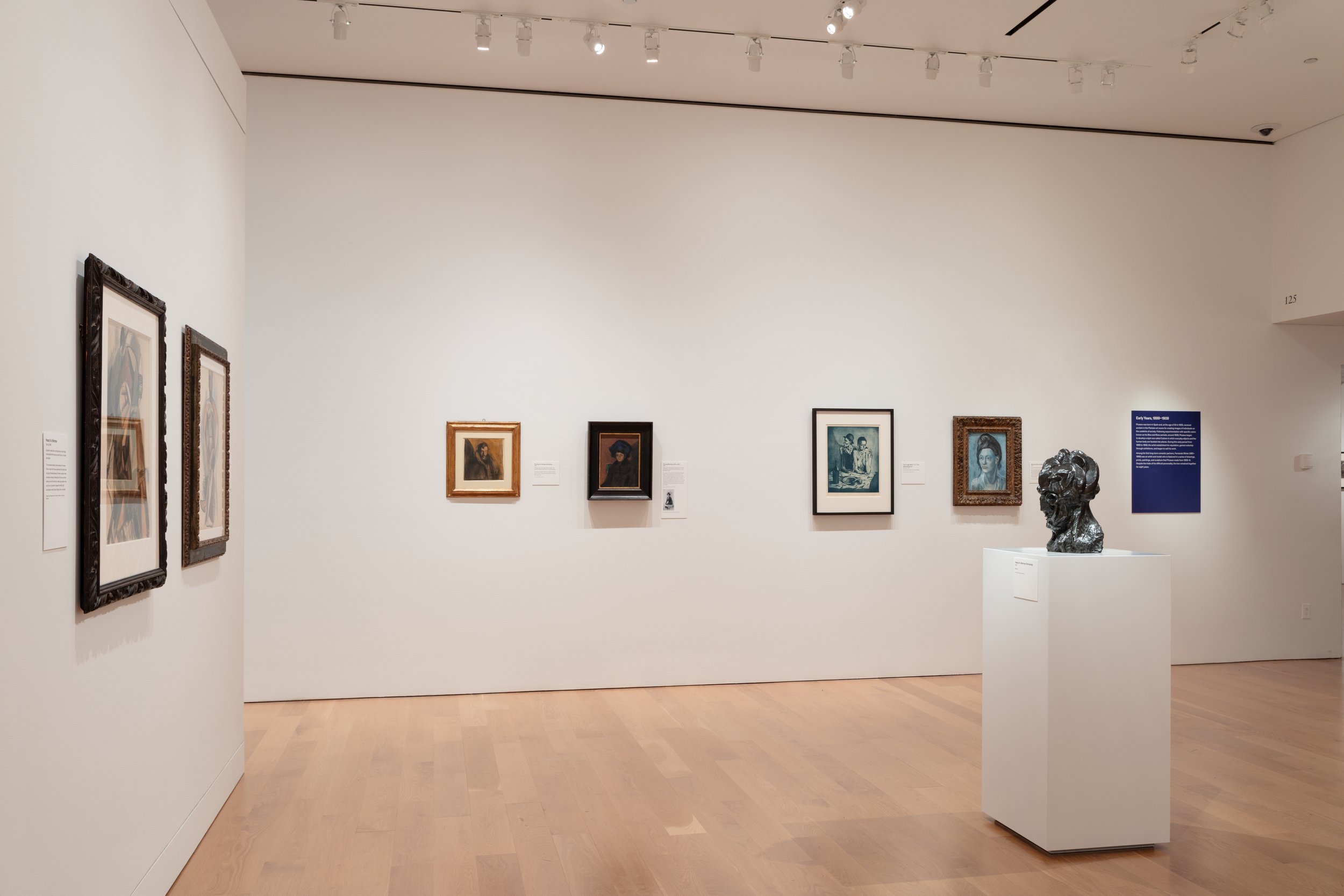
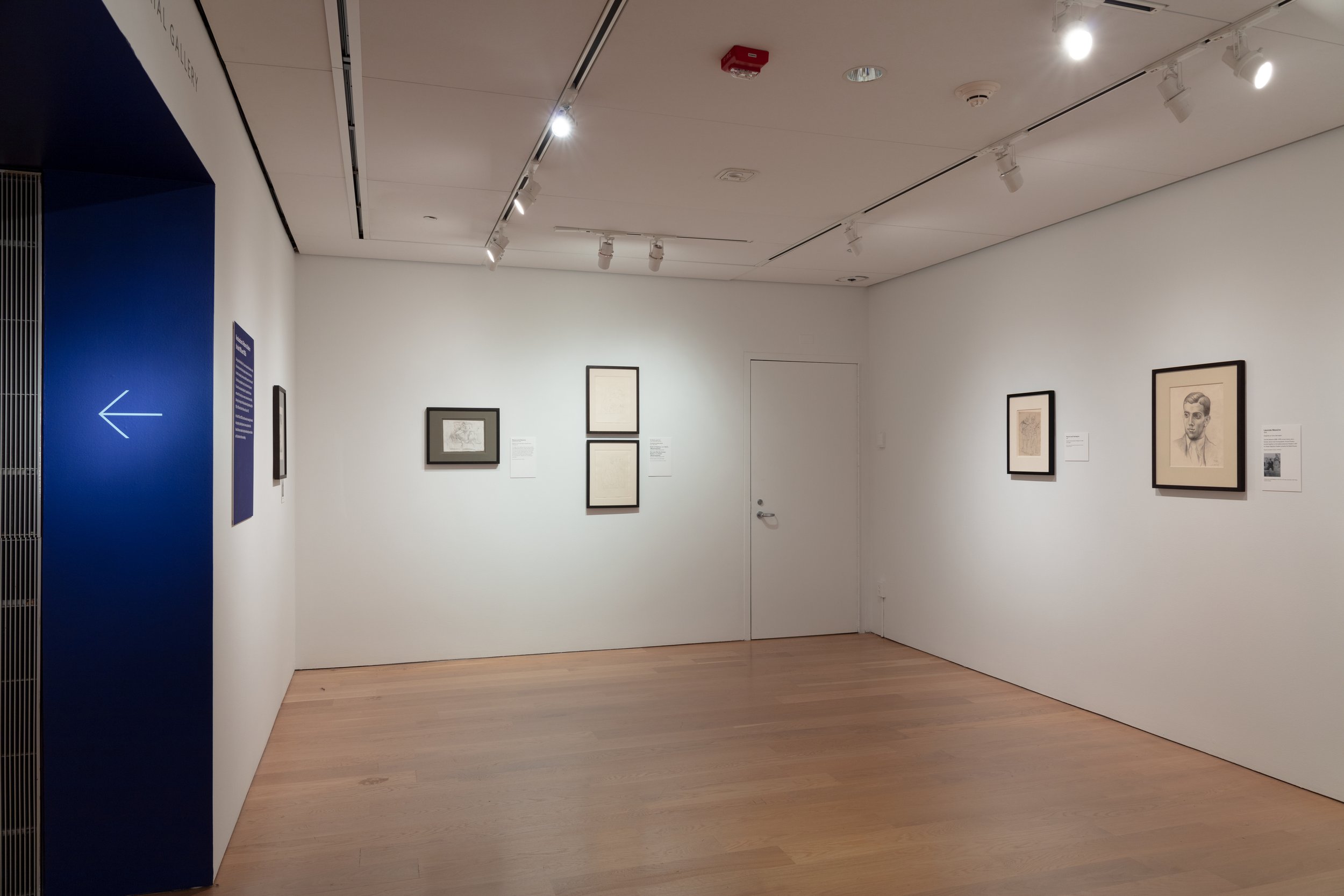
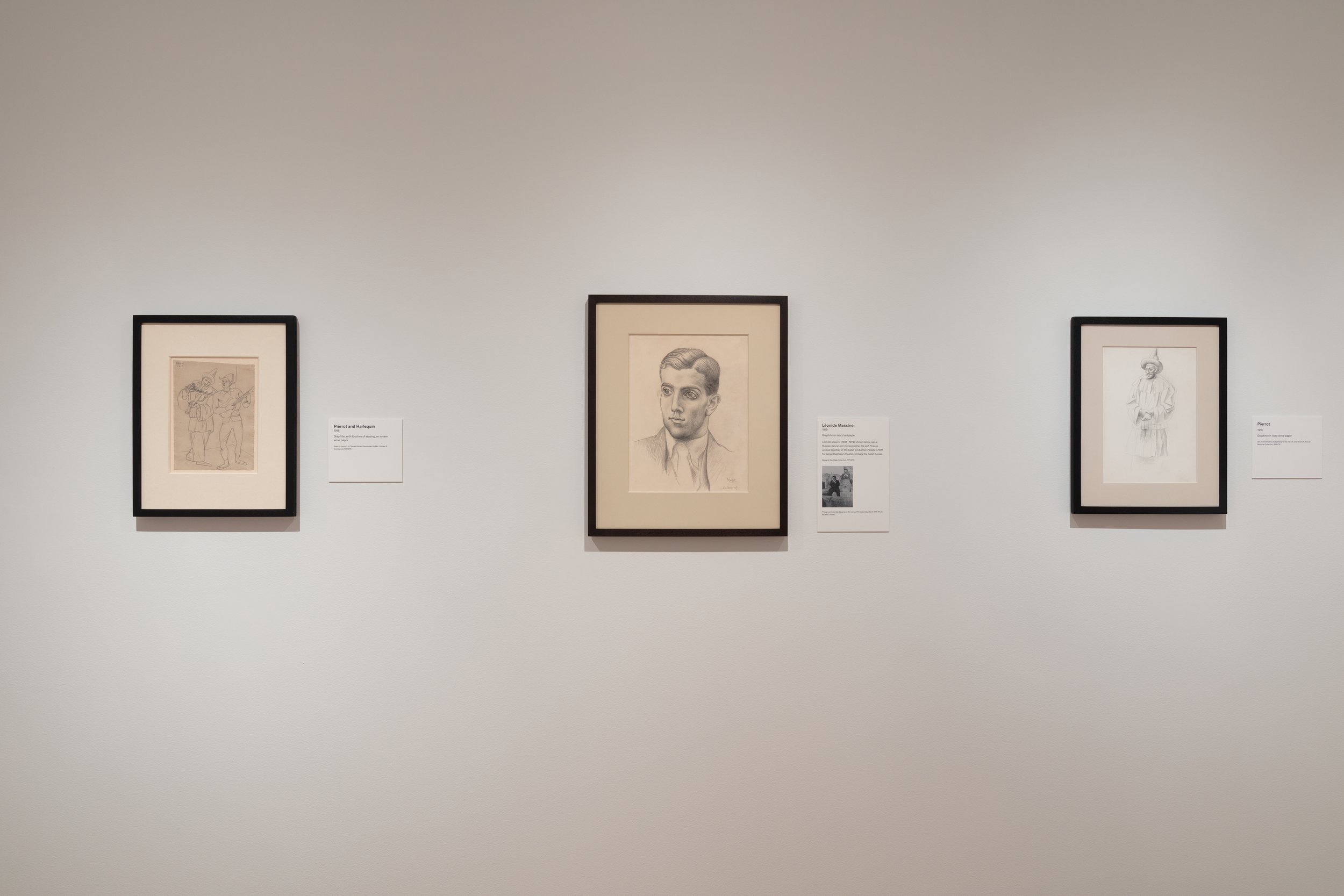
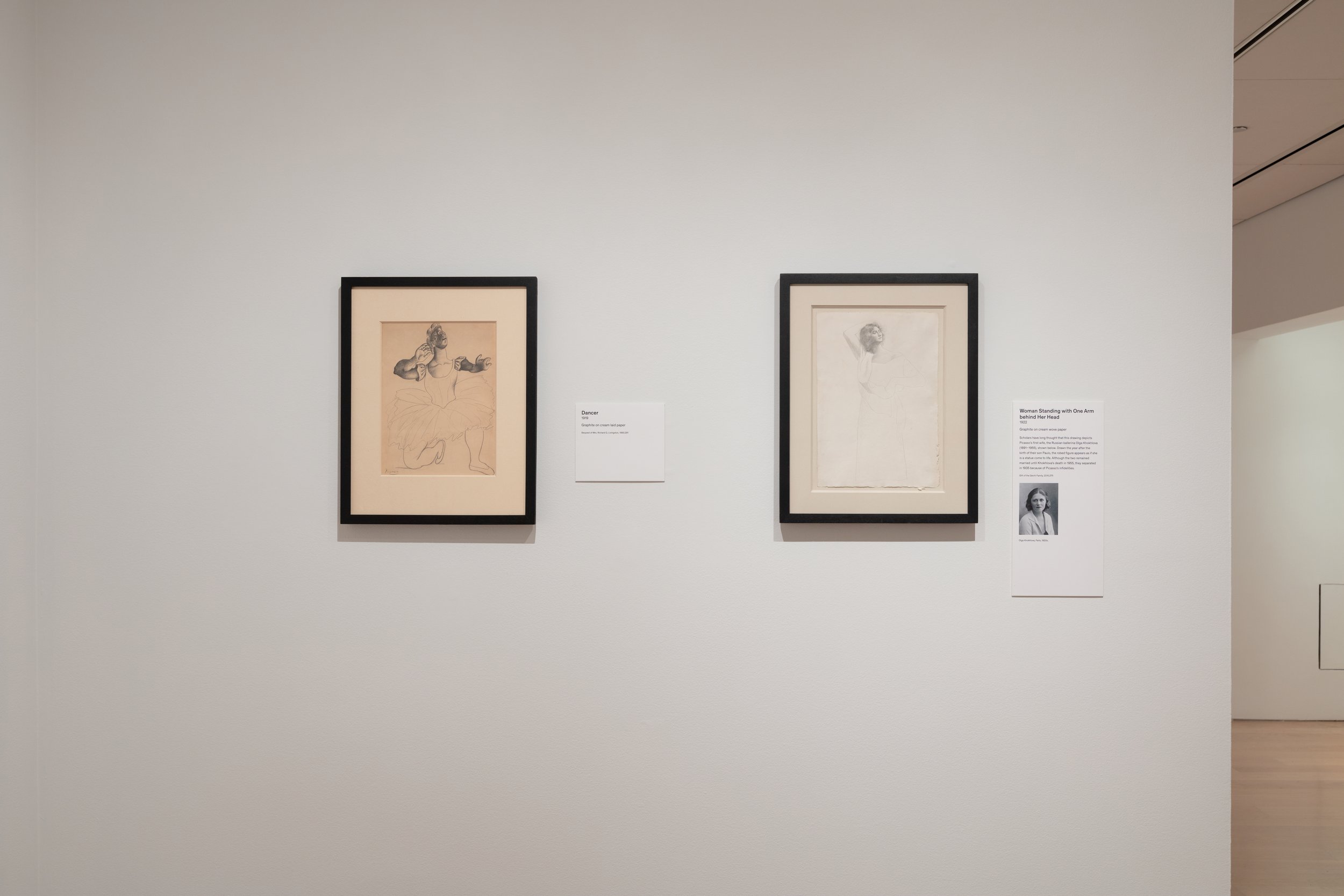

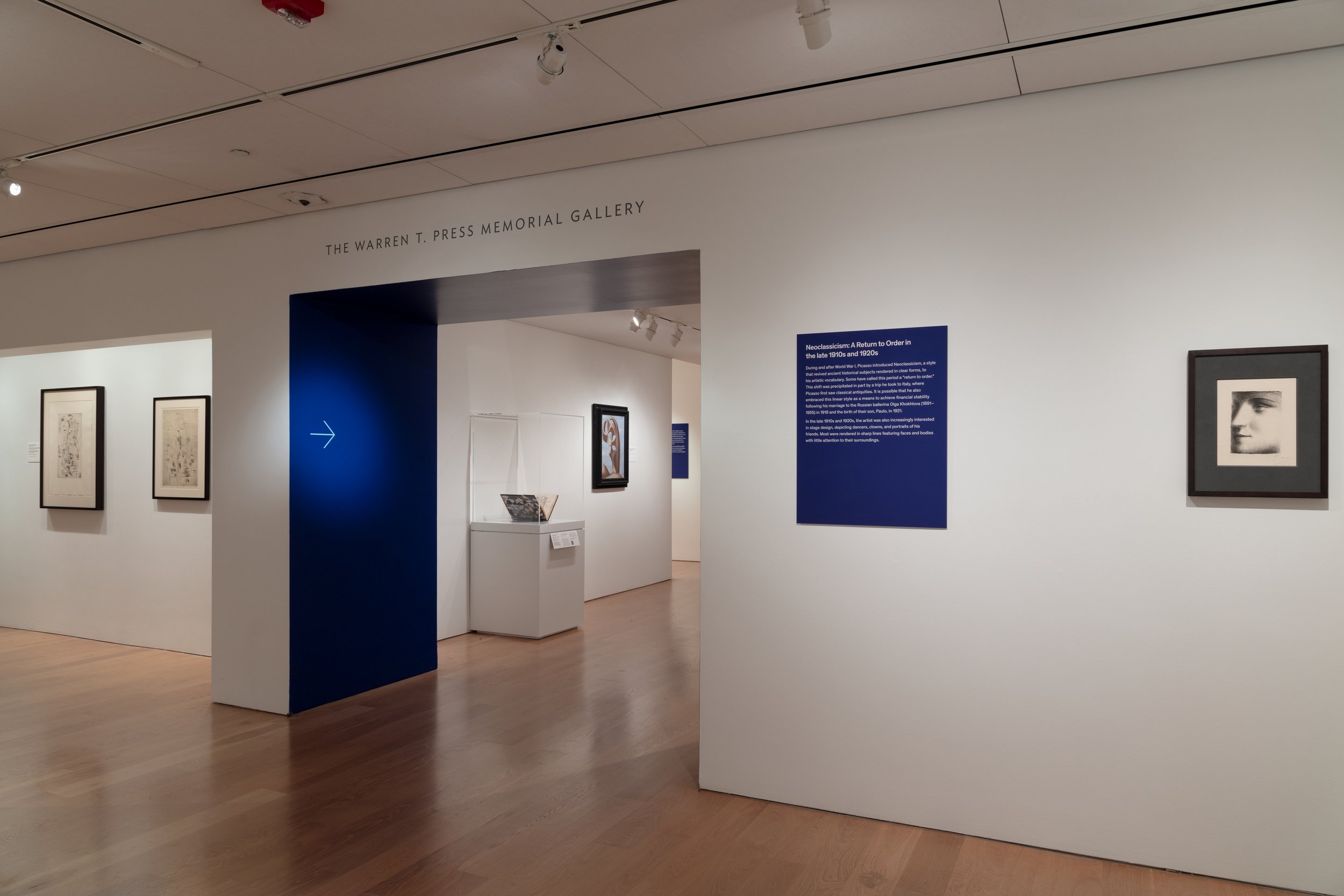
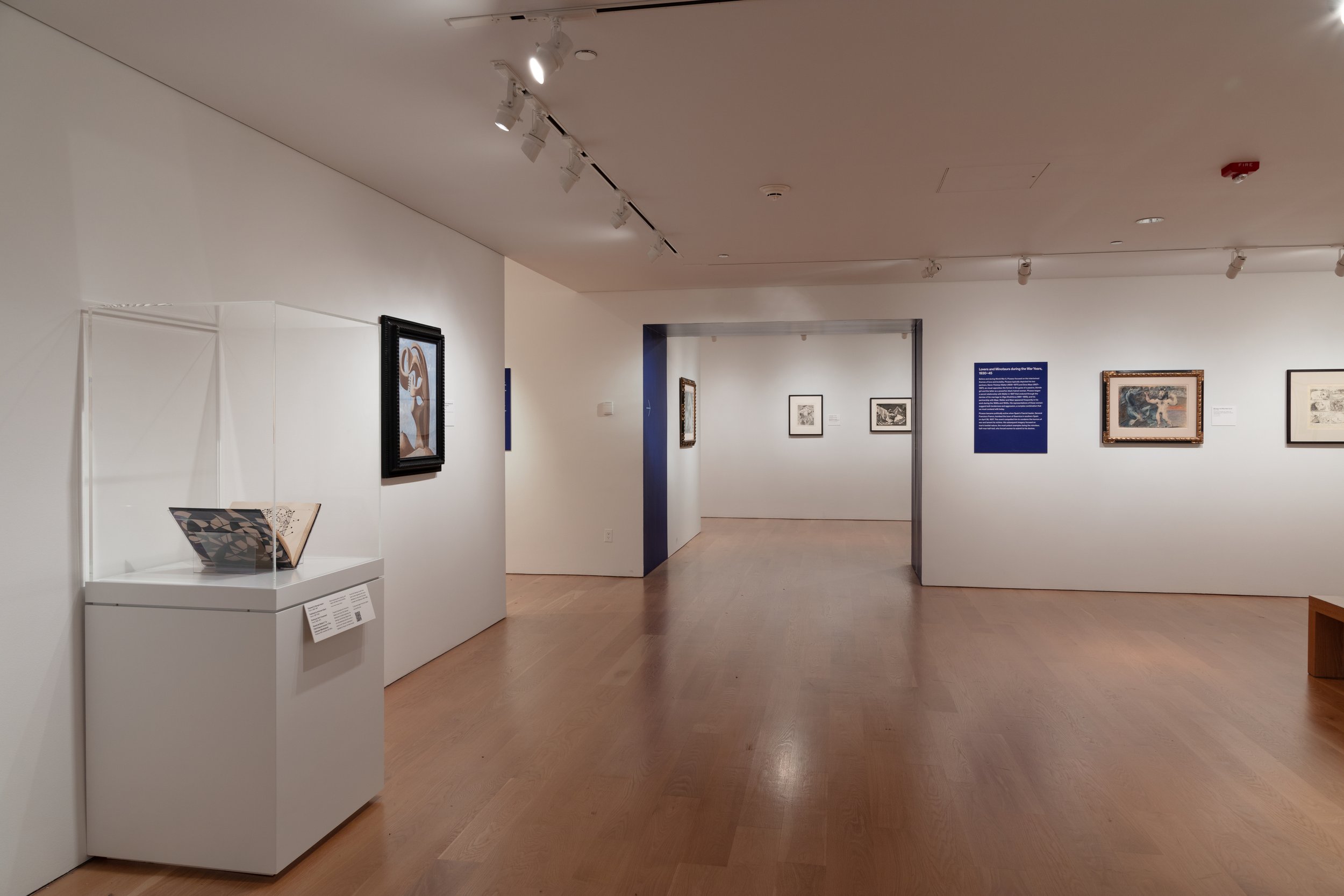
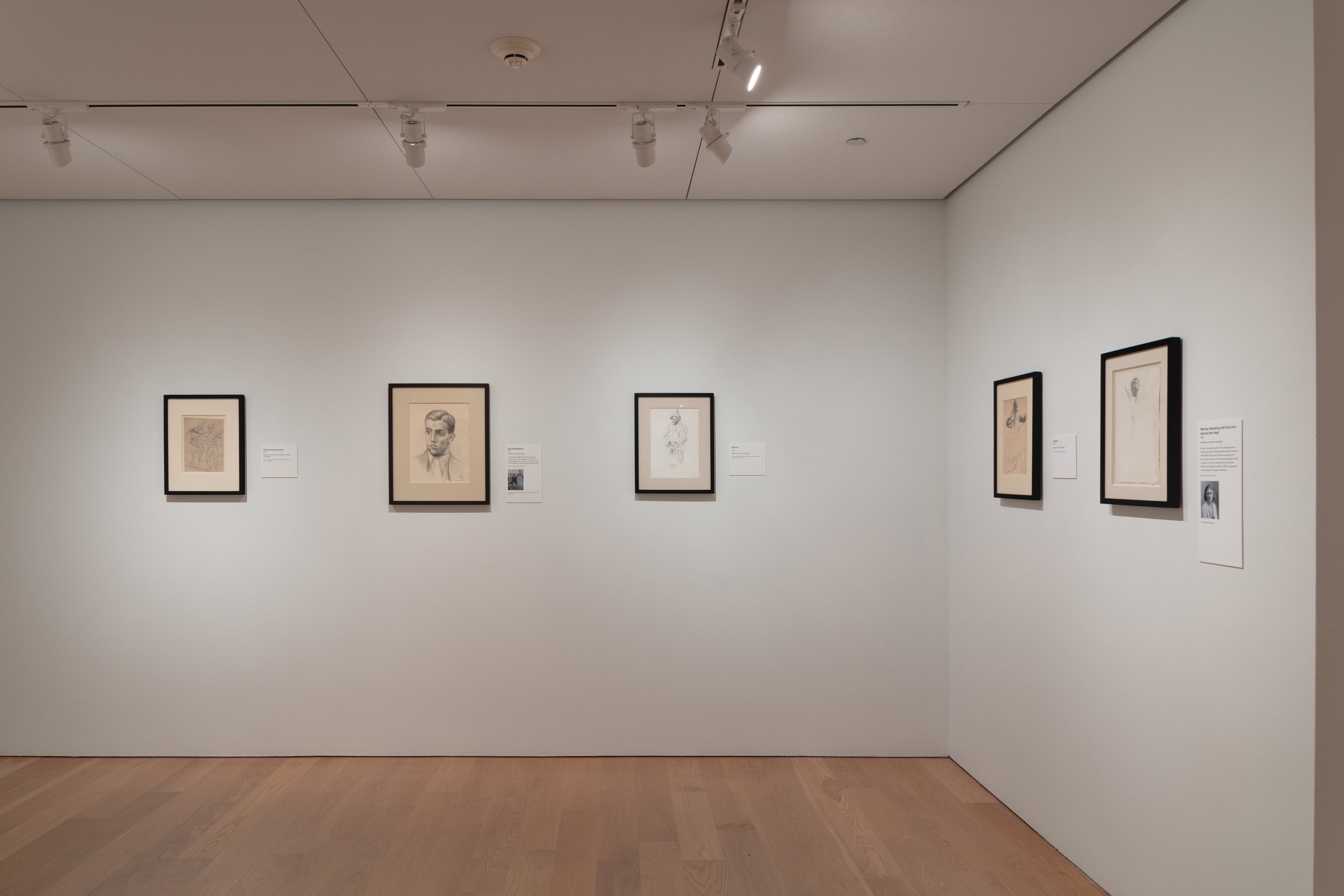
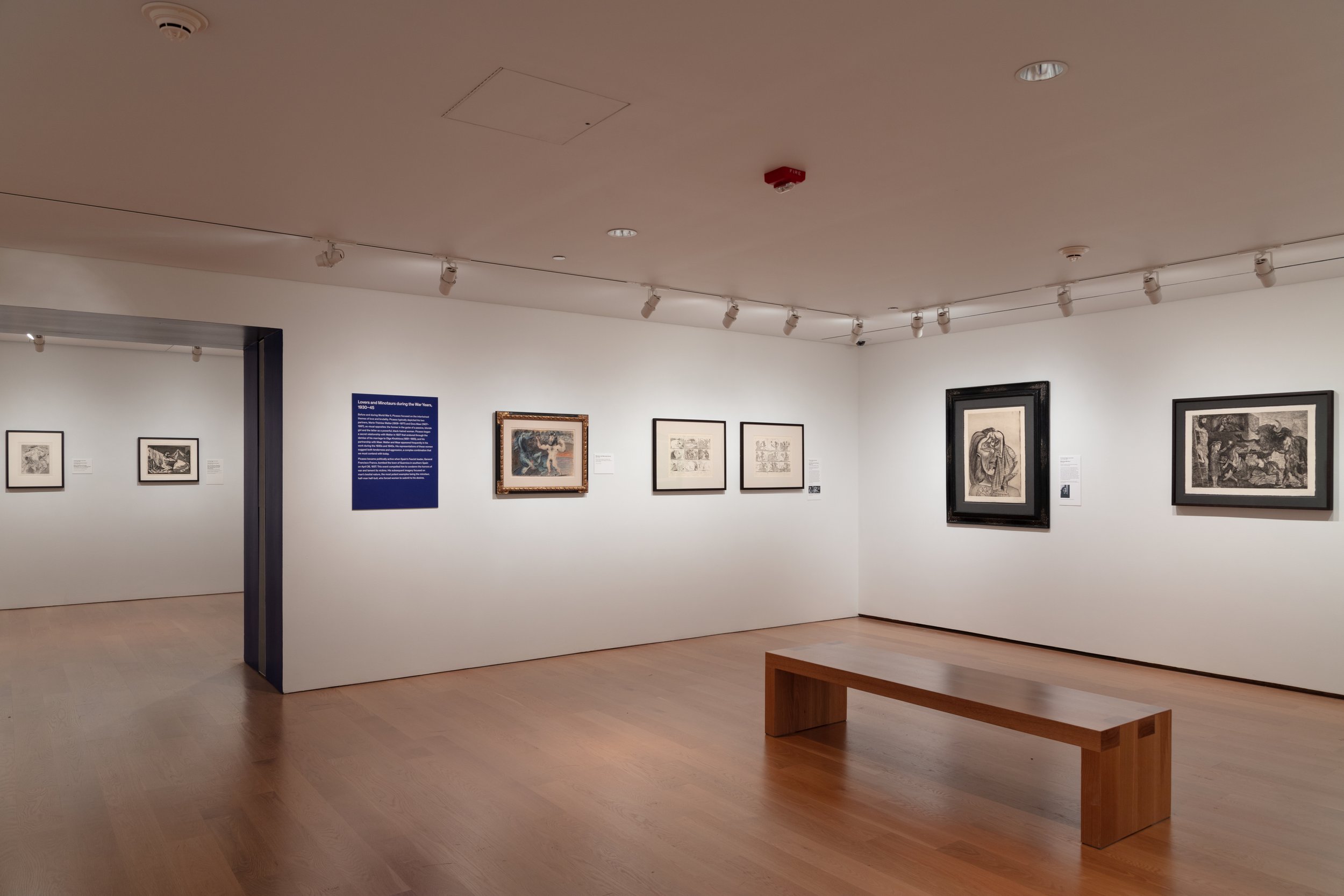


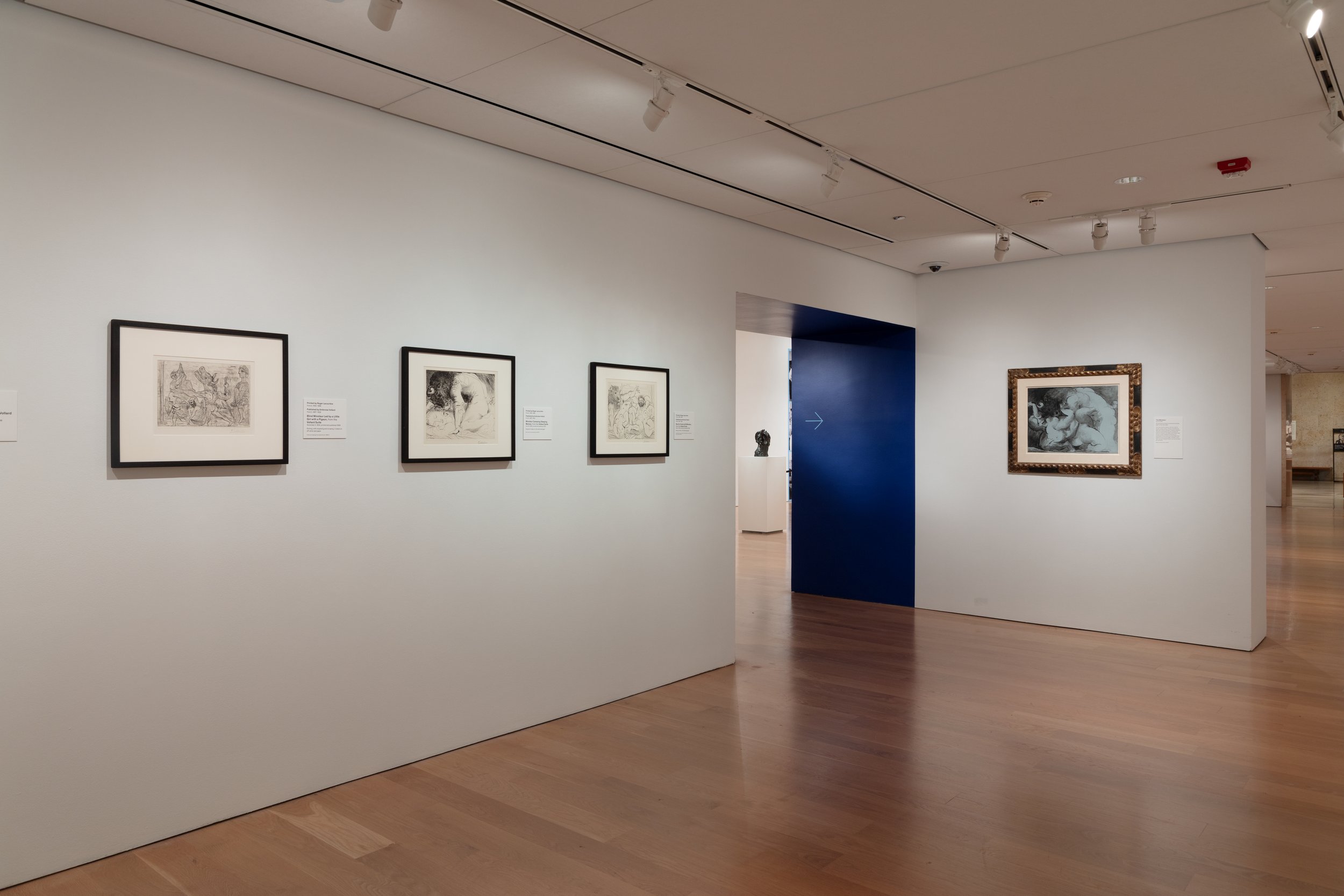
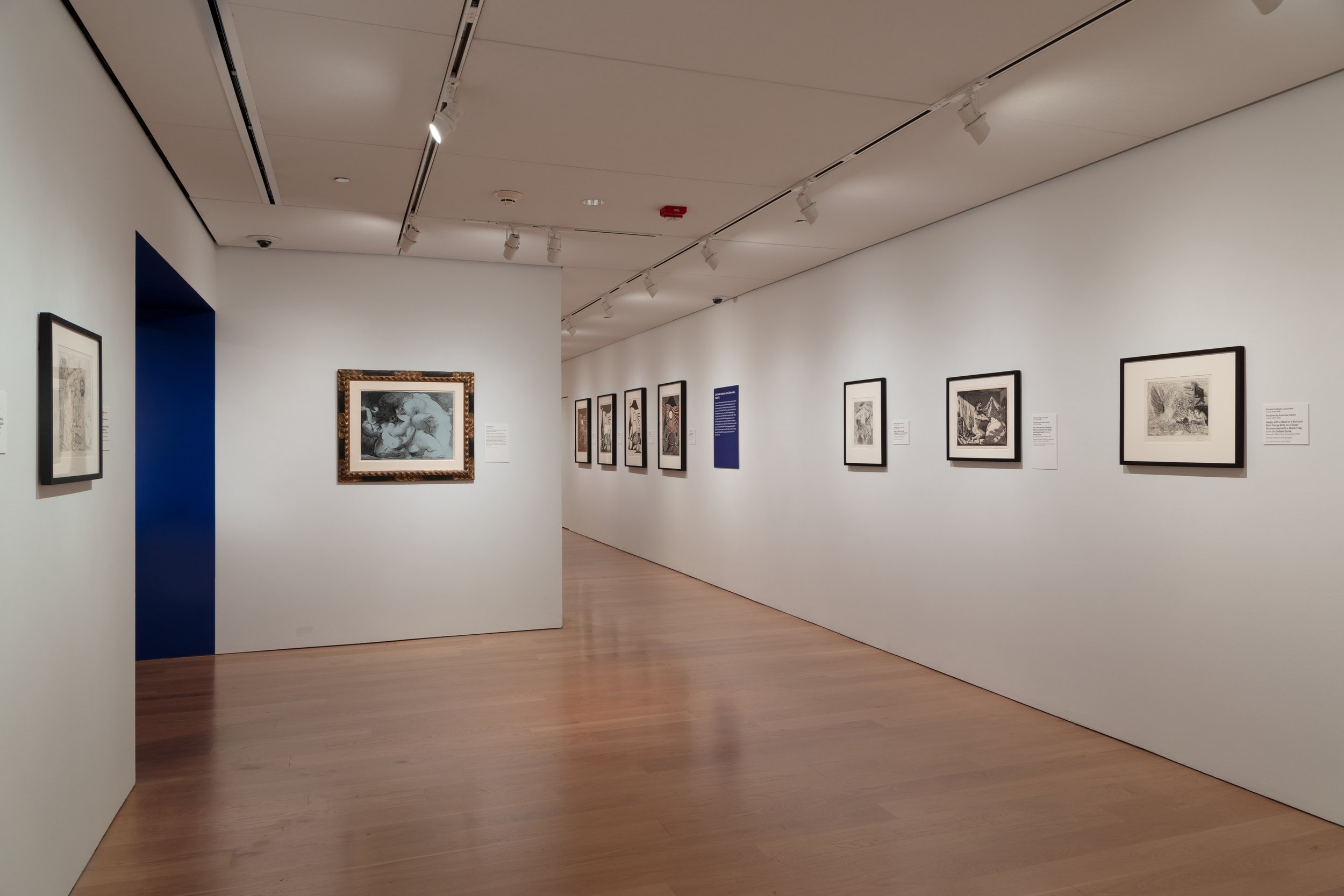
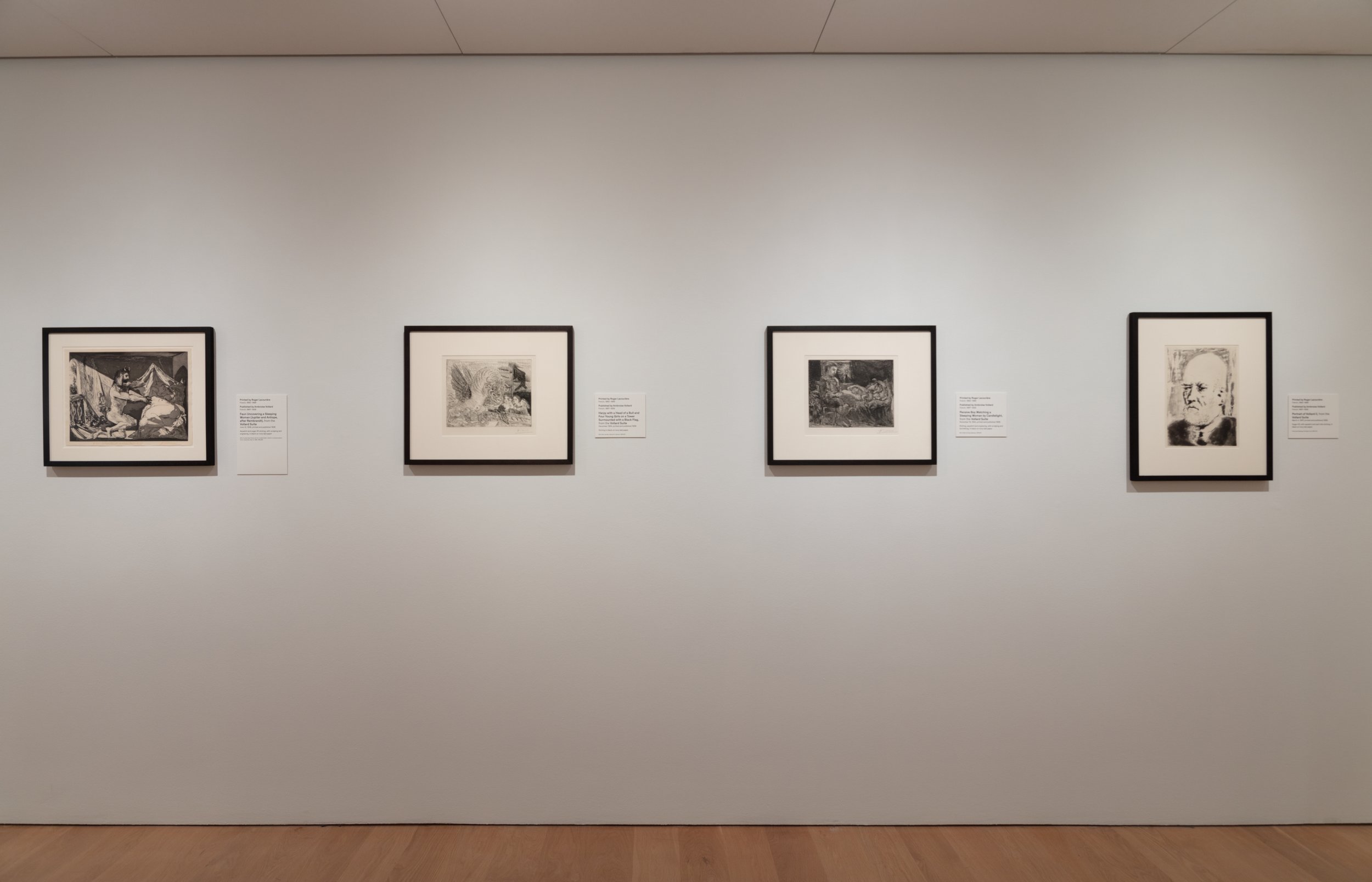
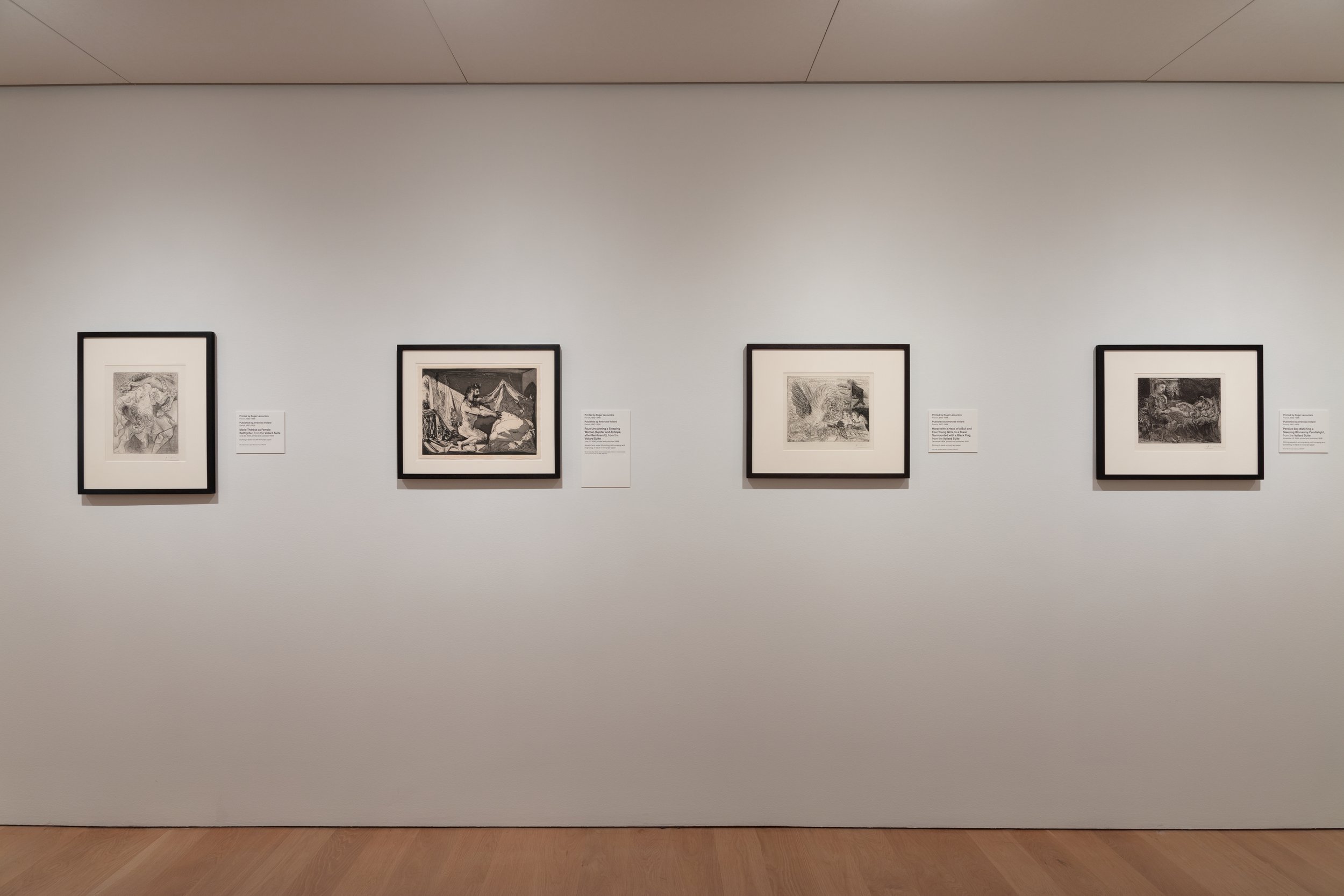
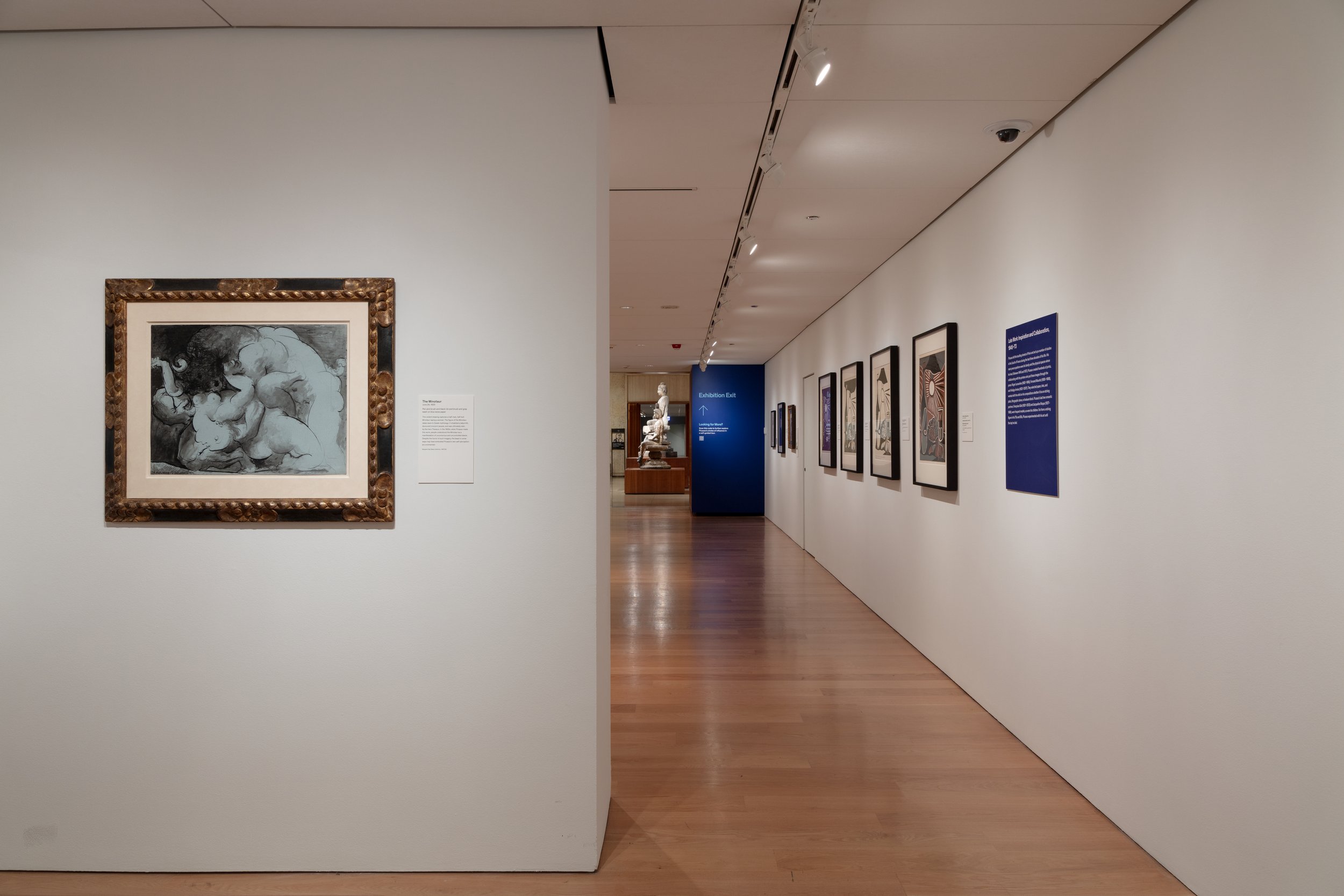
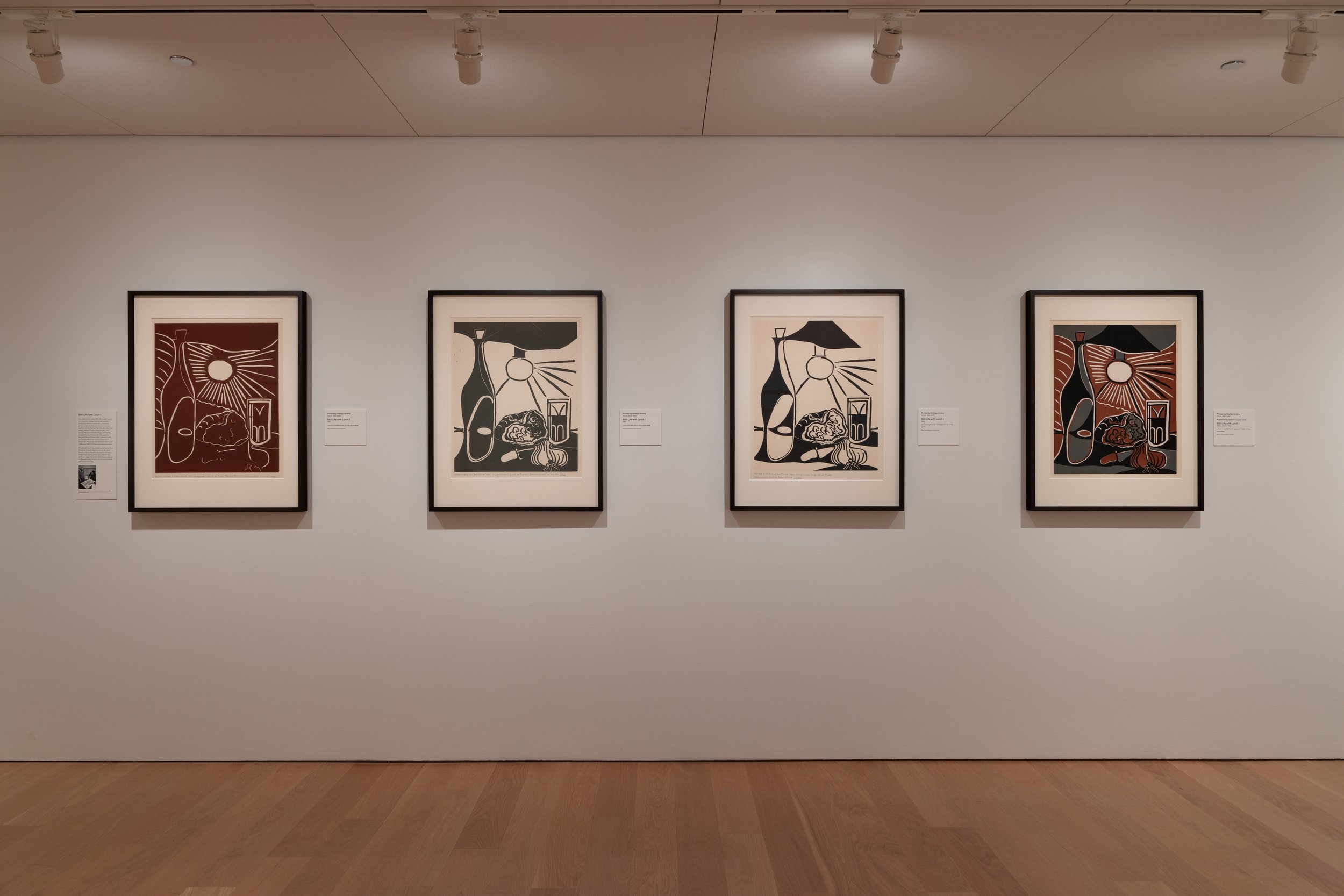
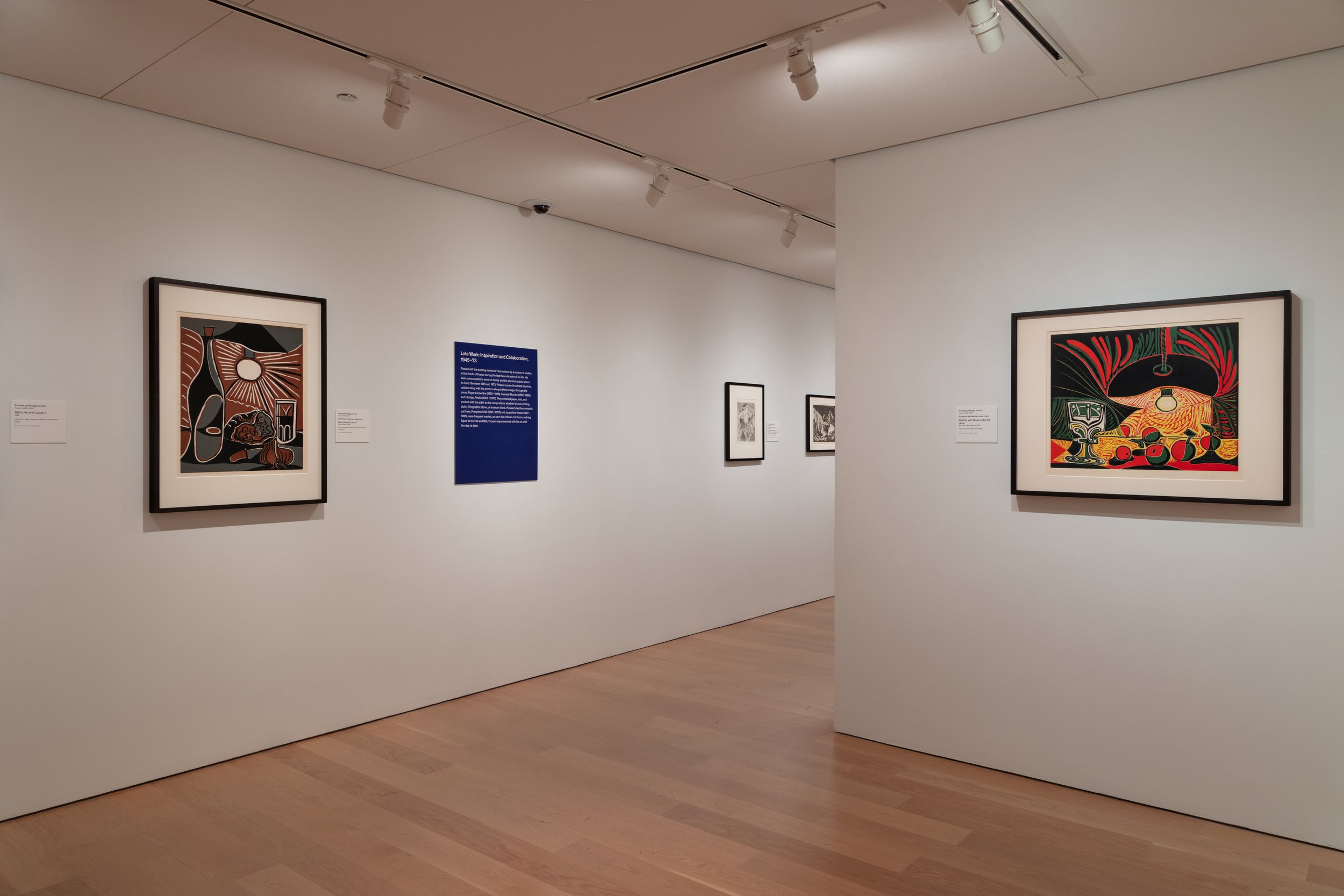
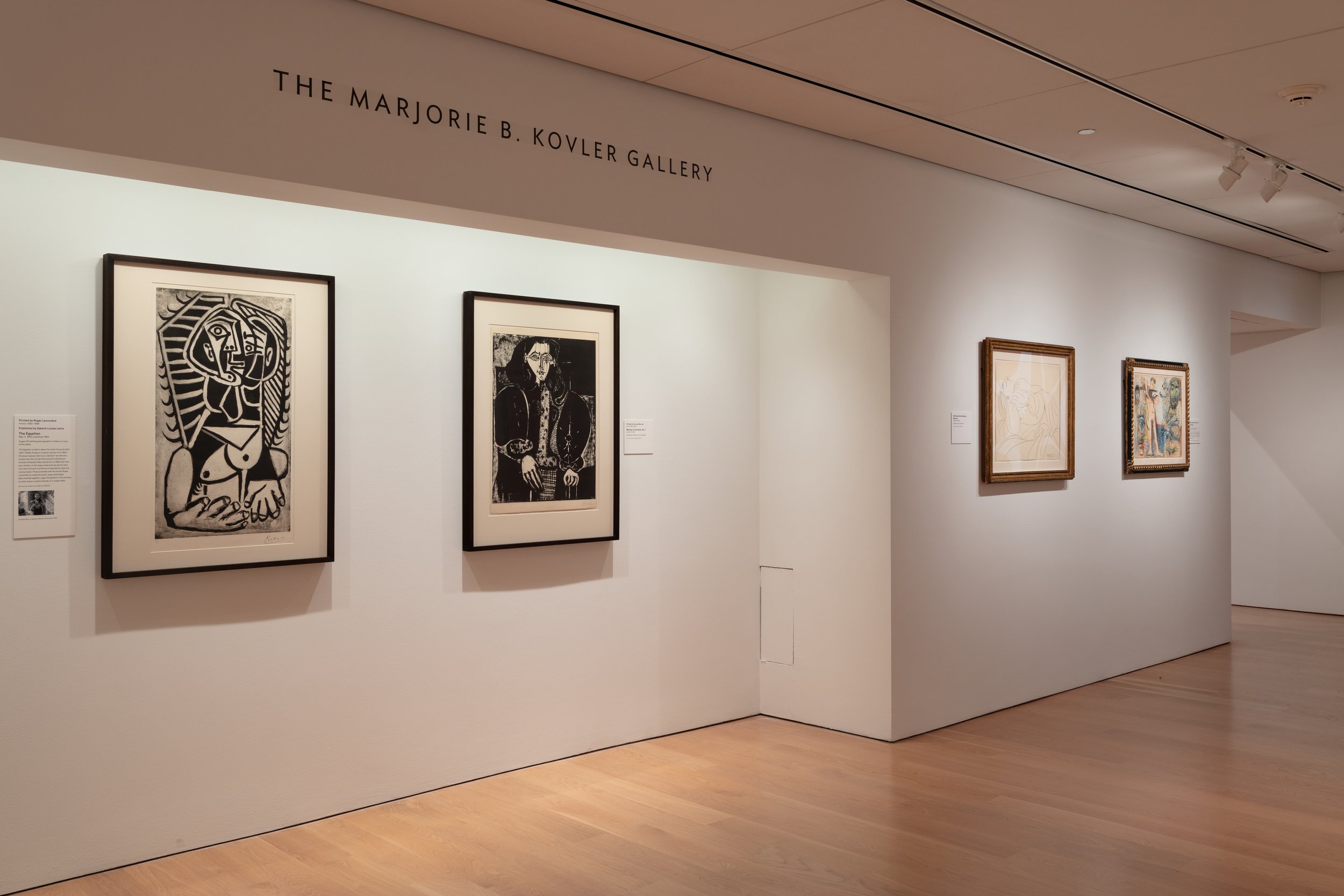
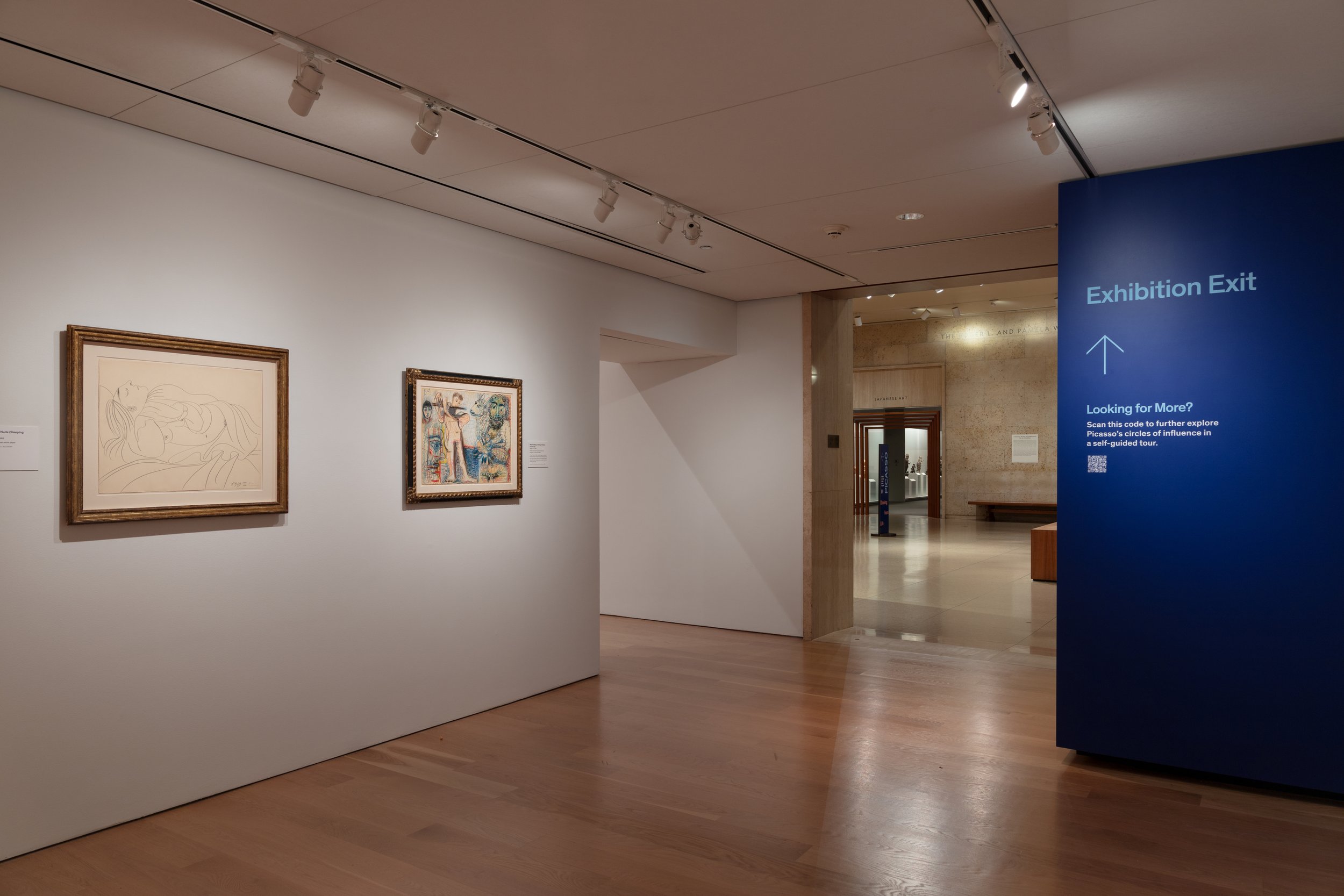
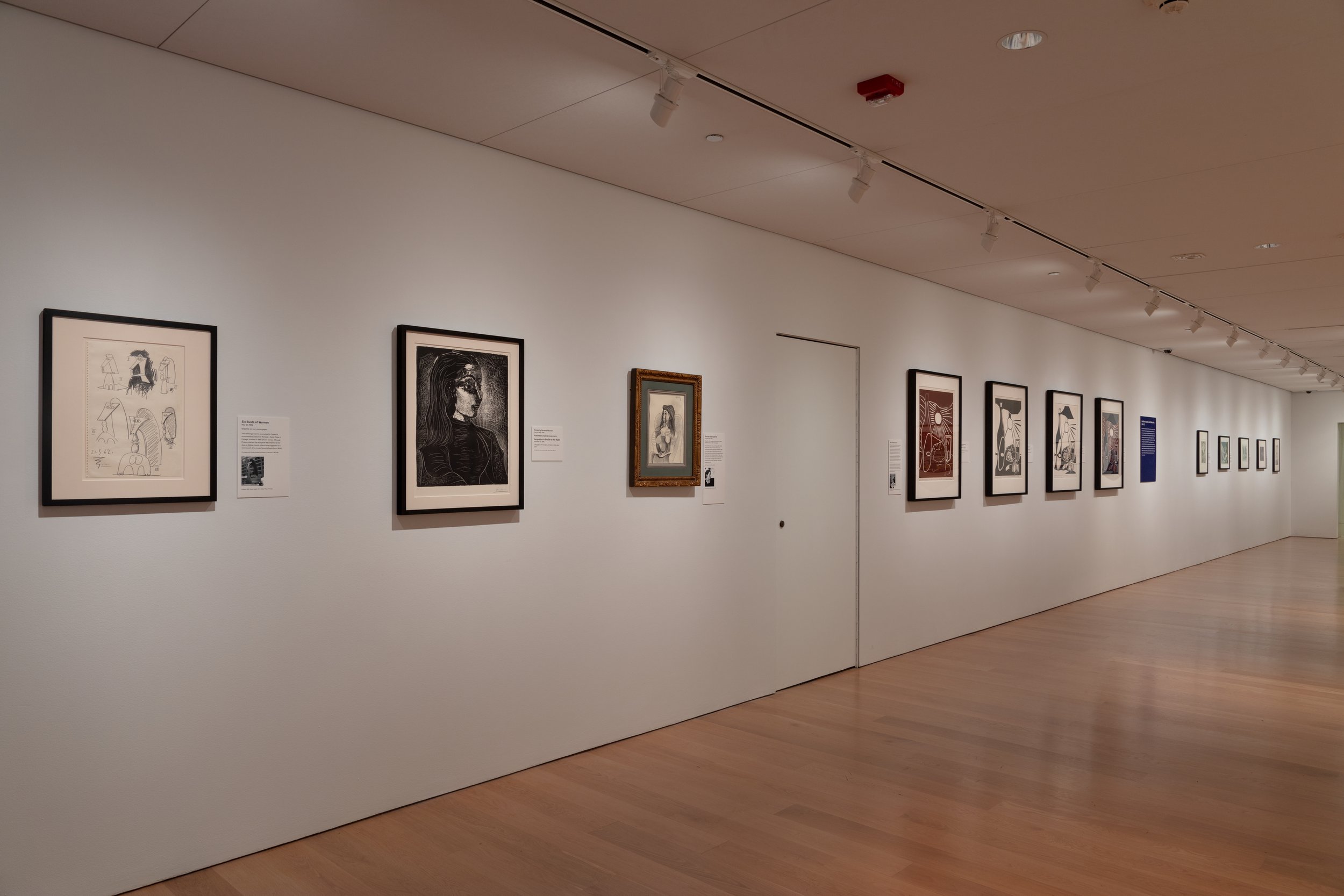
Installation view: Picasso: Drawing from Life, 2024. The Art Institute of Chicago, Chicago. Courtesy of The Art Institute of Chicago.
Organized chronologically, the exhibit highlights those who influenced him at different points in time, including his gallerist Daniel-Henry Kahnweiler, fellow artist George Braque, lovers including Fernande Olivier, Marie-Thérèse Walter, and Dora Maar, and his family.
Installation view: Picasso: Drawing from Life, 2024. The Art Institute of Chicago, Chicago. Courtesy of The Art Institute of Chicago.
“A lot of his art gets lost in the drama of his life, or at least what people think they know about his life,” said Emily Ziemba, Director of Curatorial Administration and Research Curator, Prints and Drawings. “But he made his amazing works of art aided by a fascinating group of people around him.”
Picasso: Drawing from Life is curated by Jay A. Clarke and Emily Ziemba
For more information about the exhibition and other exhibitions, please visit The Art Institute of Chicago's website here. The institute can also be found on Facebook, Instagram, and YouTube.
Radical Clay: Contemporary Women Artists from Japan
Installation view: Radical Clay: Contemporary Women Artists from Japan, 2024. The Art Institute of Chicago, Chicago. Courtesy of The Art Institute of Chicago
CHICAGO—The Art Institute of Chicago is pleased to announce Radical Clay: Contemporary Women Artists from Japan opened on December 16, 2023, and will be on view until June 3, 2024. The exhibition features 40 stunning works by 36 different women artists from across Japan, showcasing the inventiveness and variety of work that is driving the ceramics movement forward.
While women have been historically underrecognized for their contributions to the ceramics field, this show brings both established and emerging women artists to the forefront and focuses on the explosion of innovative and technically ambitious compositions by such artists, particularly since 1970.
Installation view: Radical Clay: Contemporary Women Artists from Japan, 2024. The Art Institute of Chicago, Chicago. Courtesy of The Art Institute of Chicago
“There are so many strong contemporary women artists from Japan that are truly pushing the limits in ceramics and clay beyond what we’ve ever seen traditionally,” said Janice Katz, Roger L. Weston Associate Curator of Japanese Art, the Art Institute of Chicago. “This show brings together artists on the cutting edge of invention in terms of materials, glaze, and technique, and we are thrilled to recognize their contributions to the global ceramics field.”
The creators featured in the show span several generations of women contemporary artists, and while they have been featured in other shows, this is the first major exhibition to position these artists together to highlight their collective achievements and impact. Three artists featured in the show–Mishima Kimiyo (born 1932), Tsuboi Asuka (born 1932), and Ogawa Machiko (born 1946)–began their careers decades ago and continue to produce groundbreaking sculptures that drive the clay medium in a new direction. Konno Tomoko (born 1965), Aoki Katsuyo (born 1972), and Oishi Sayaka (born 1979) are part of younger generations and are represented by pieces featuring bodily distortion to fantastical decoration. These women have routinely confronted expectations about their practice and often refuse gender-imposed constraints in their work, approaching subjects in unconventional ways.
Installation view: Radical Clay: Contemporary Women Artists from Japan, 2024. The Art Institute of Chicago, Chicago. Courtesy of The Art Institute of Chicago
The exhibition is accompanied by a richly illustrated catalog with essays and insights by Janice Katz, Joe Earle, and Hollis Goodall. Additionally, bringing these artists to global attention has been made possible by the generous collaboration with Carol and Jeffrey Horvitz, who shared all of the selected pieces in the show from their exemplary collection.
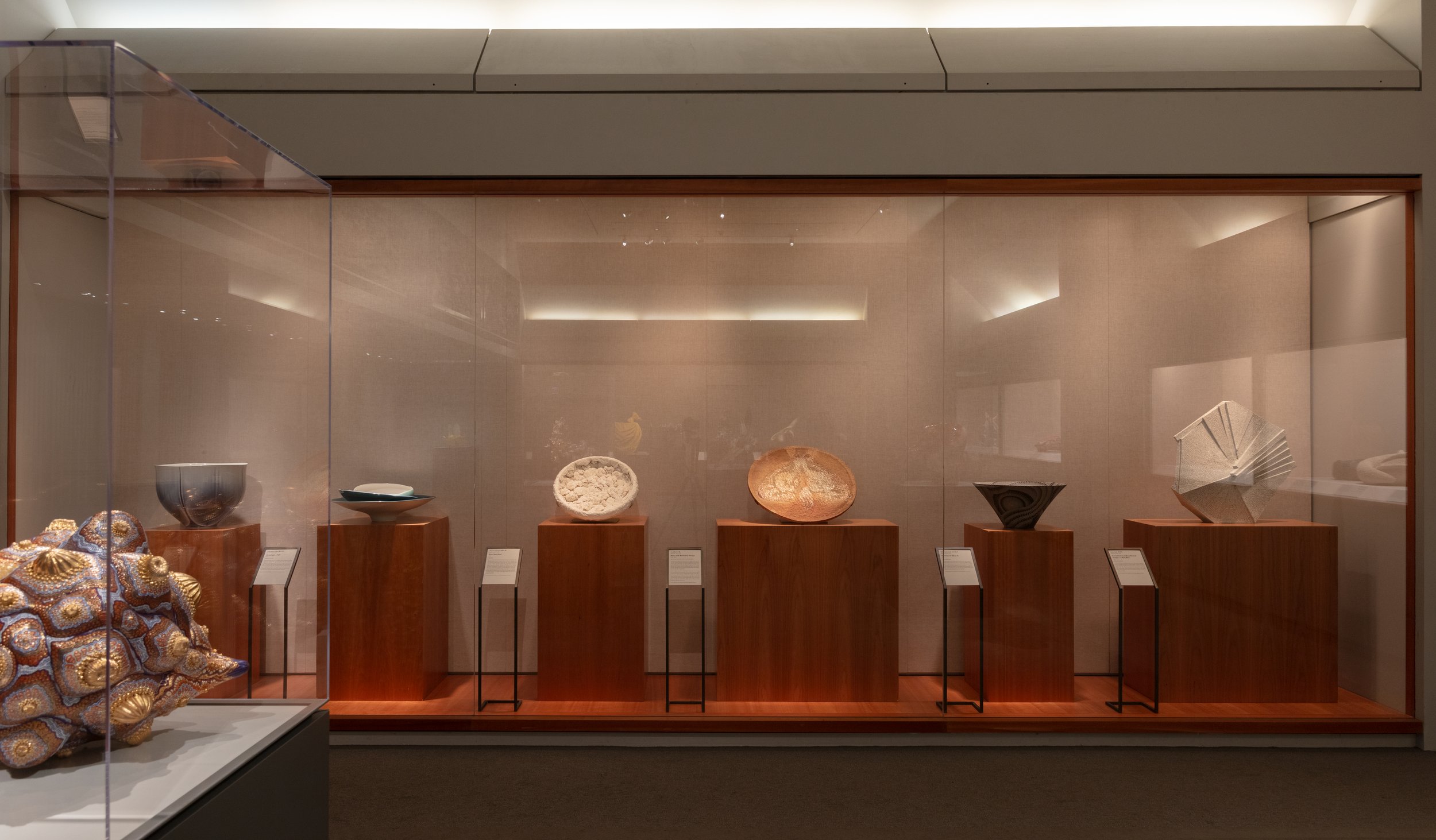
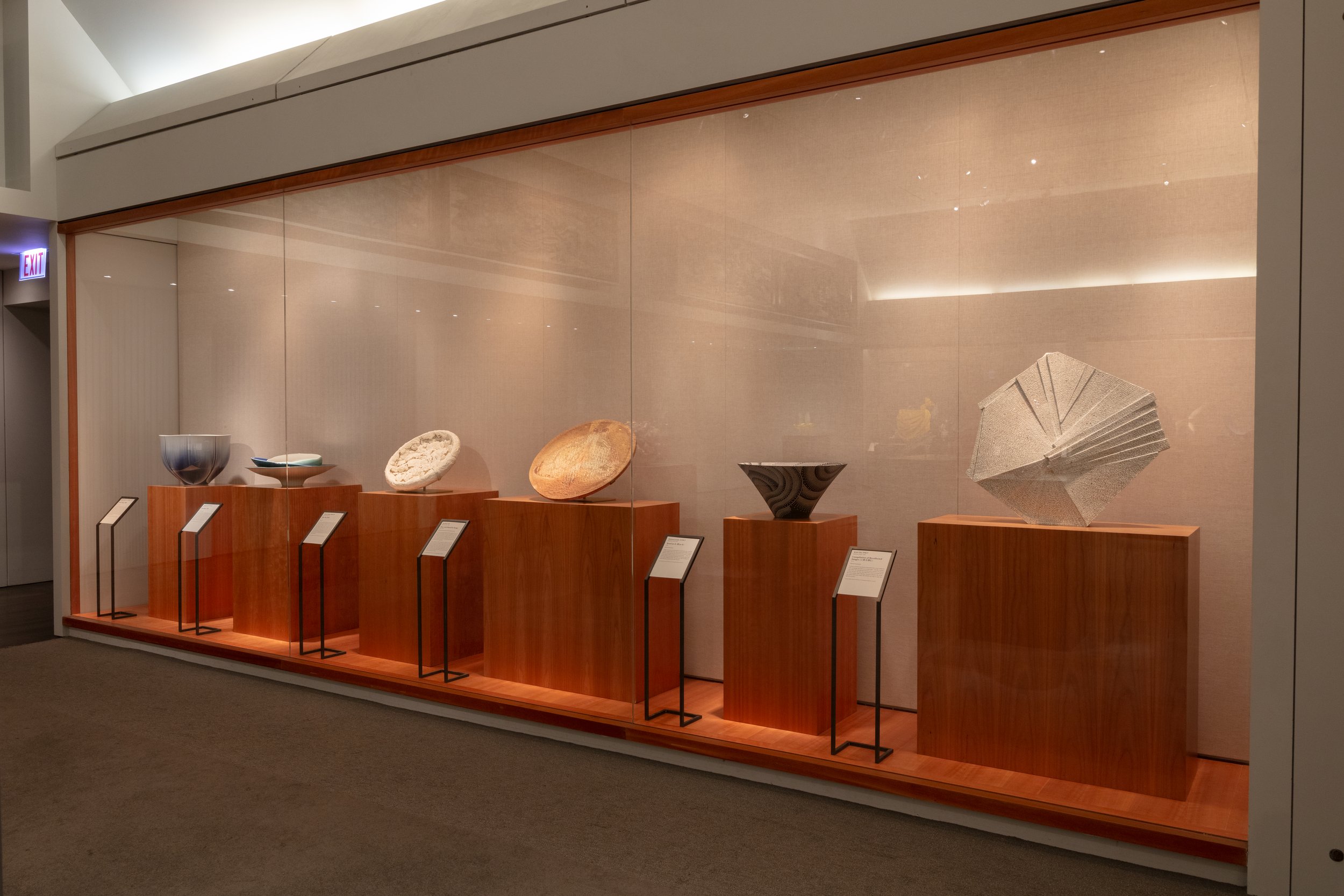
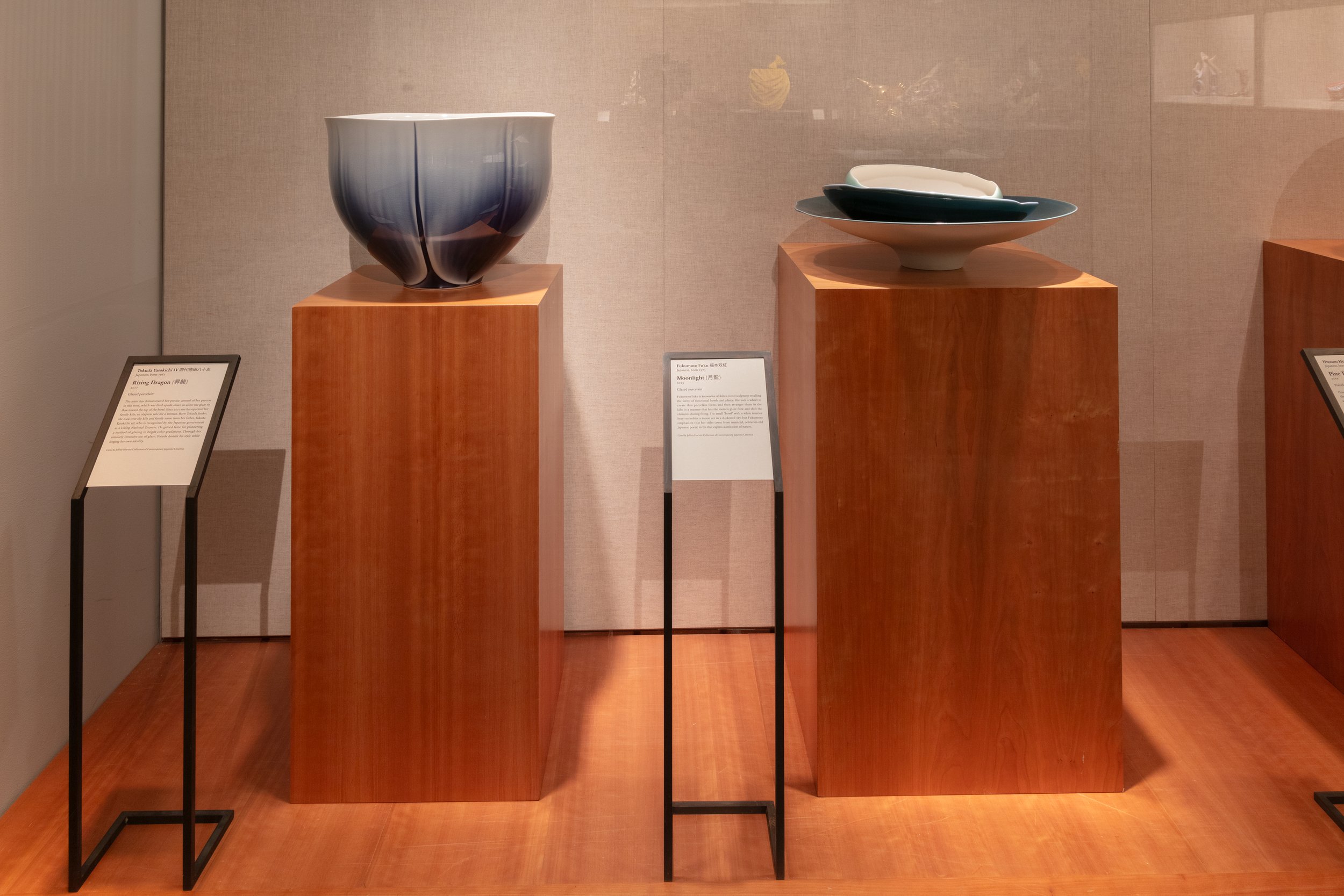
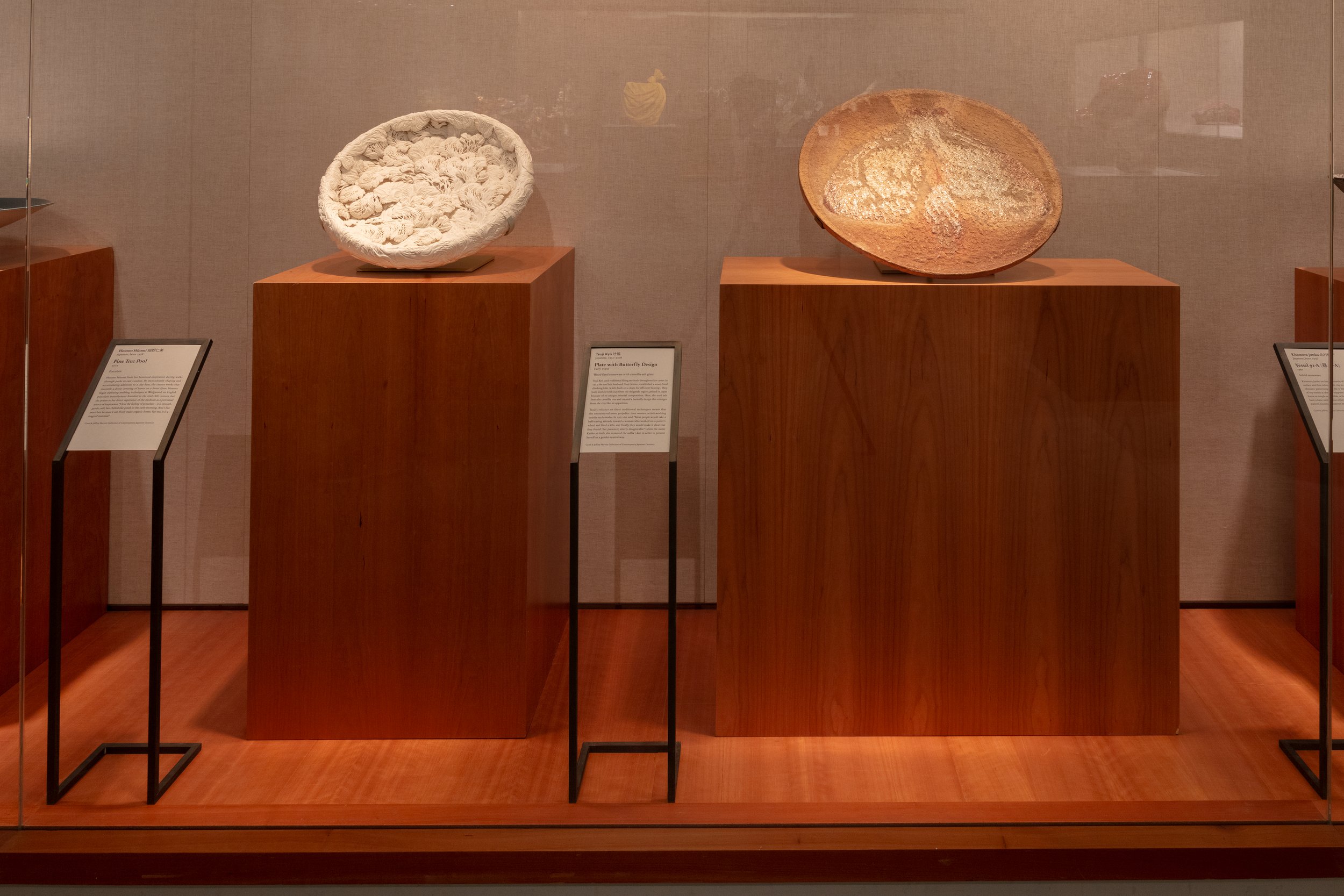
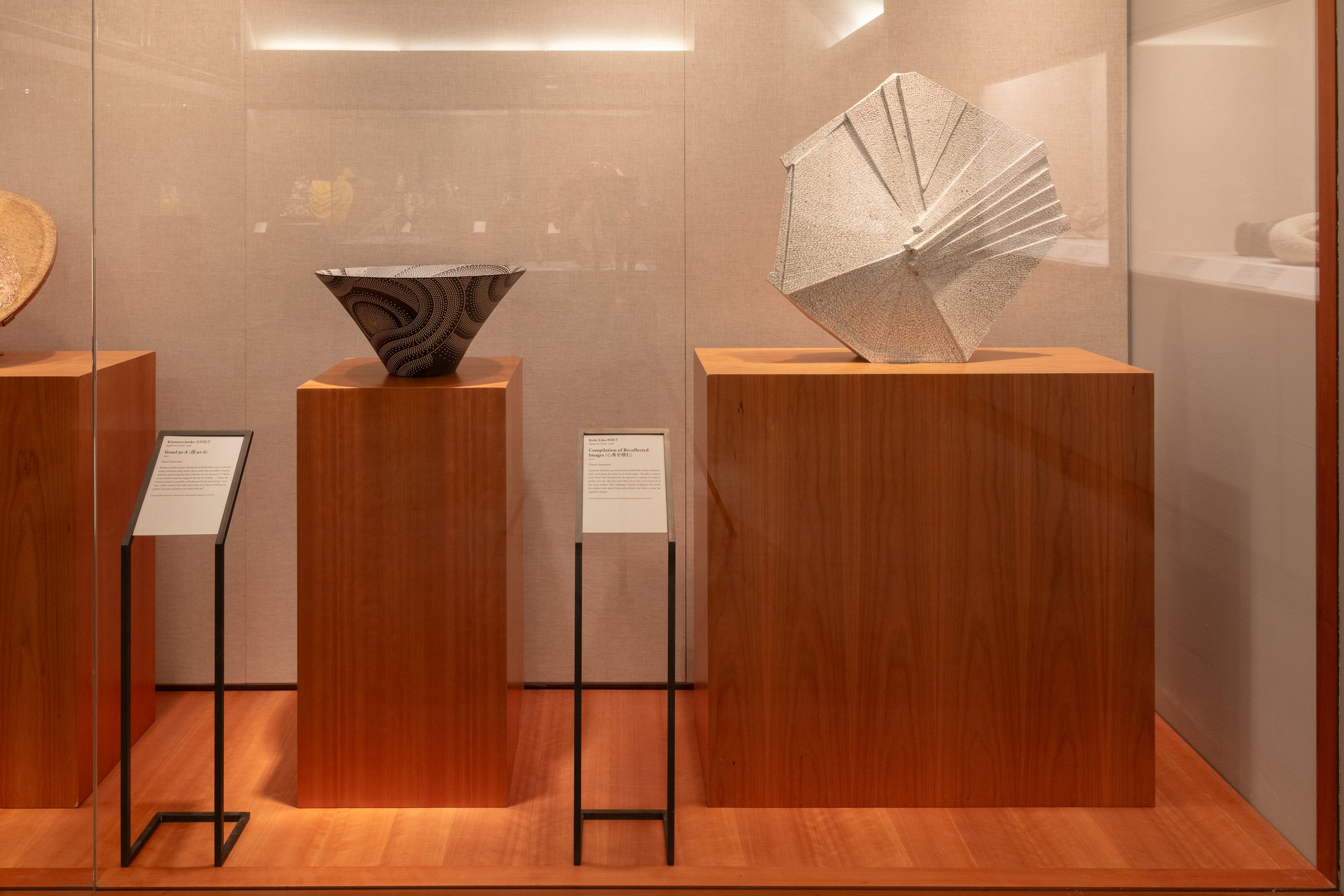
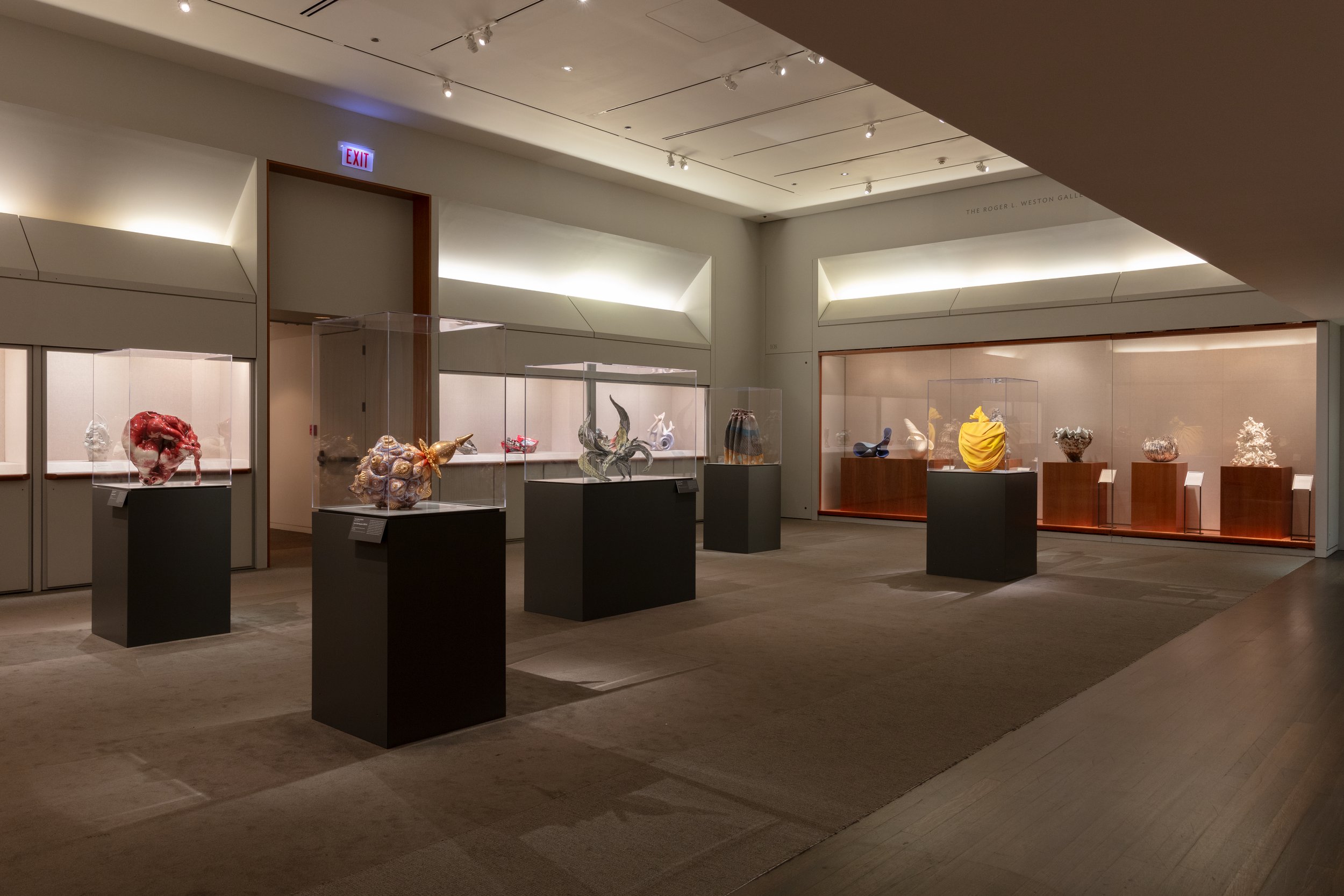
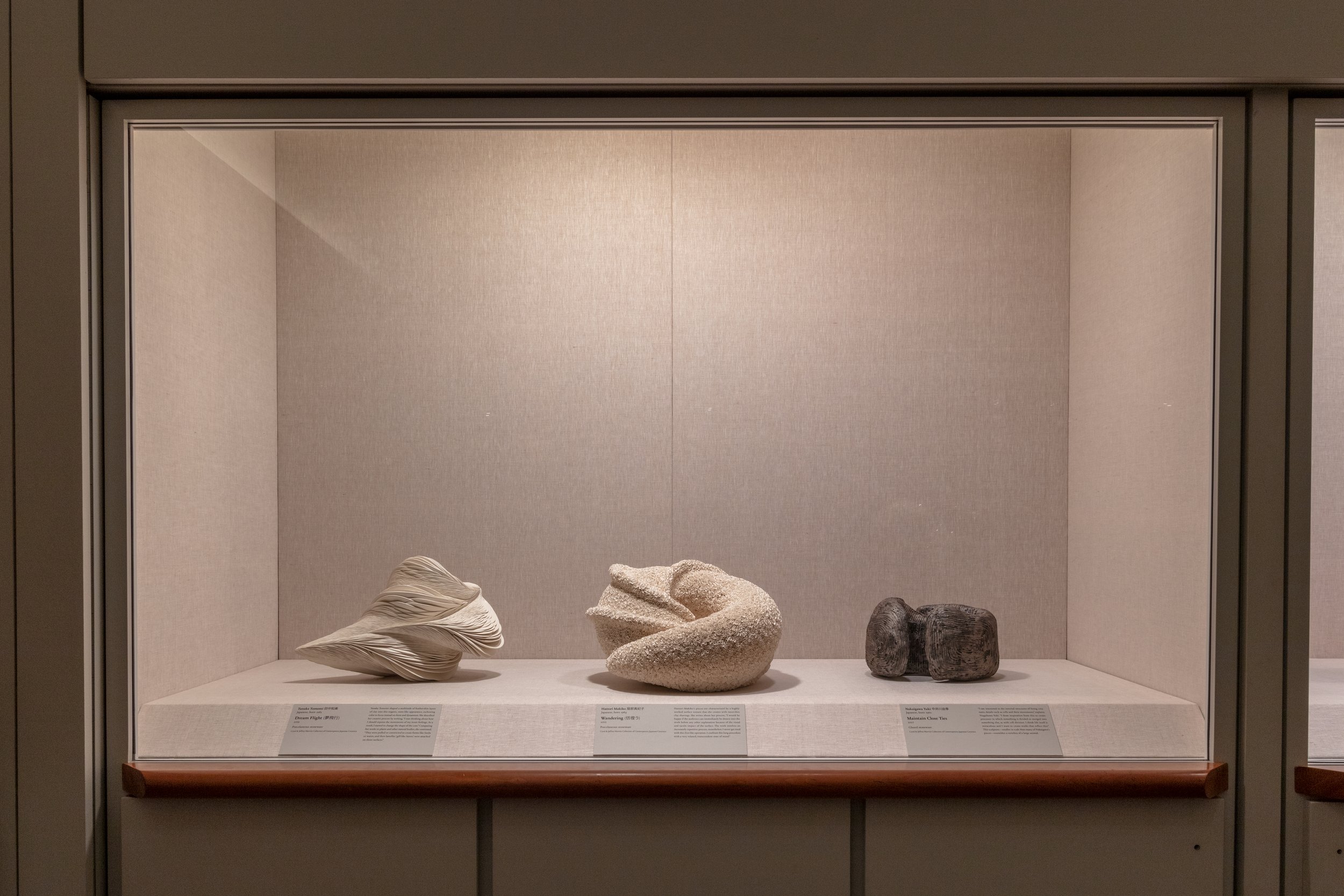
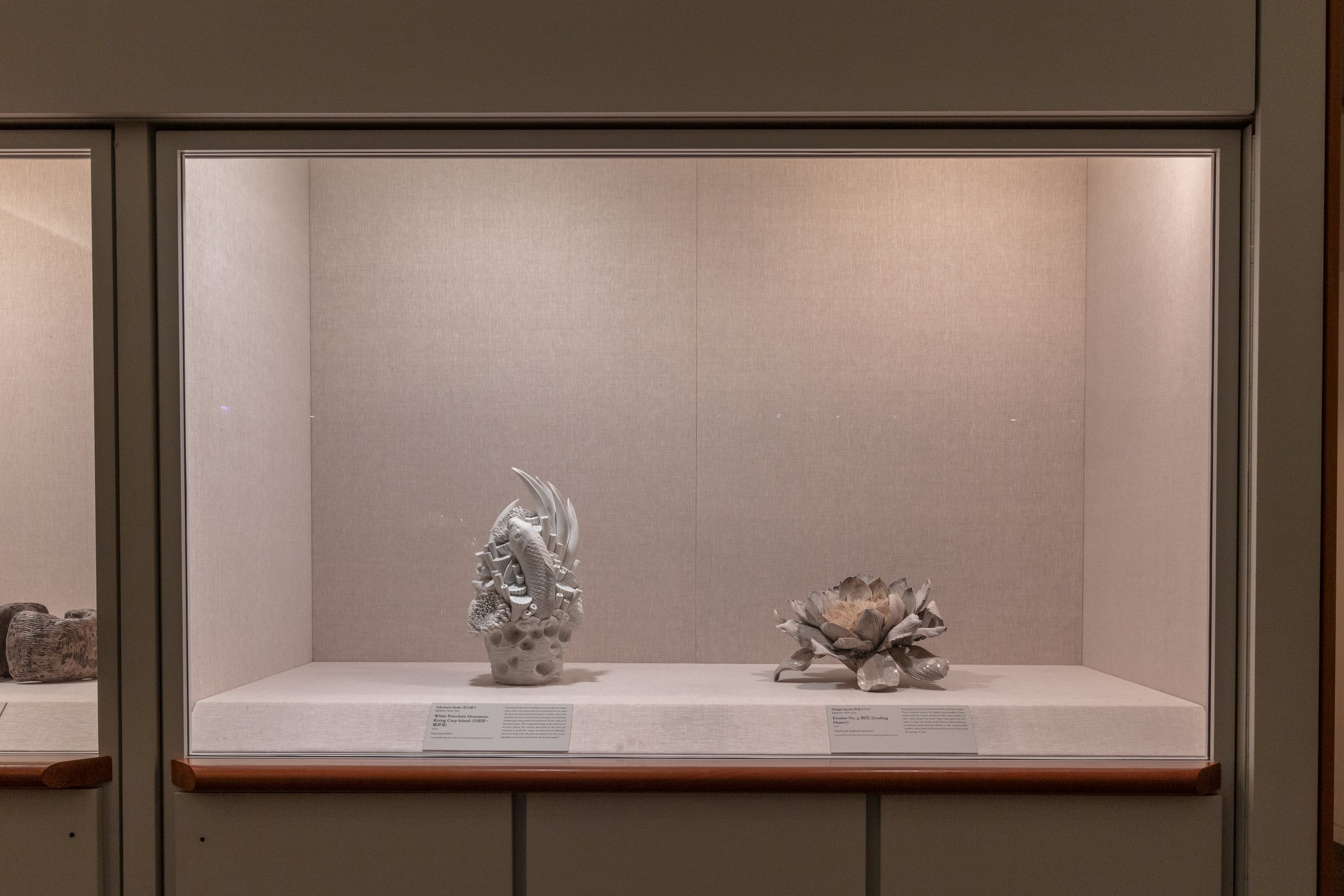
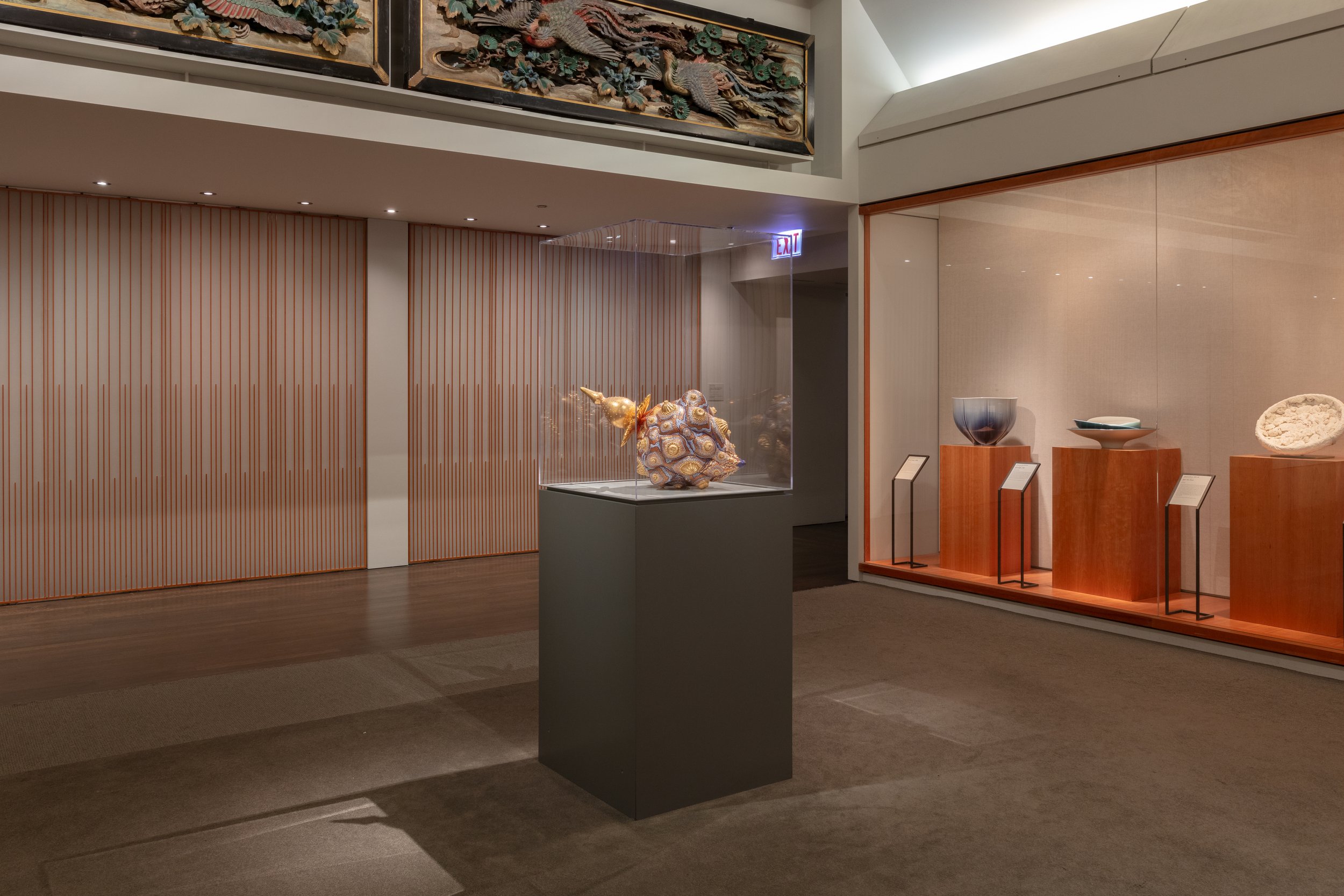
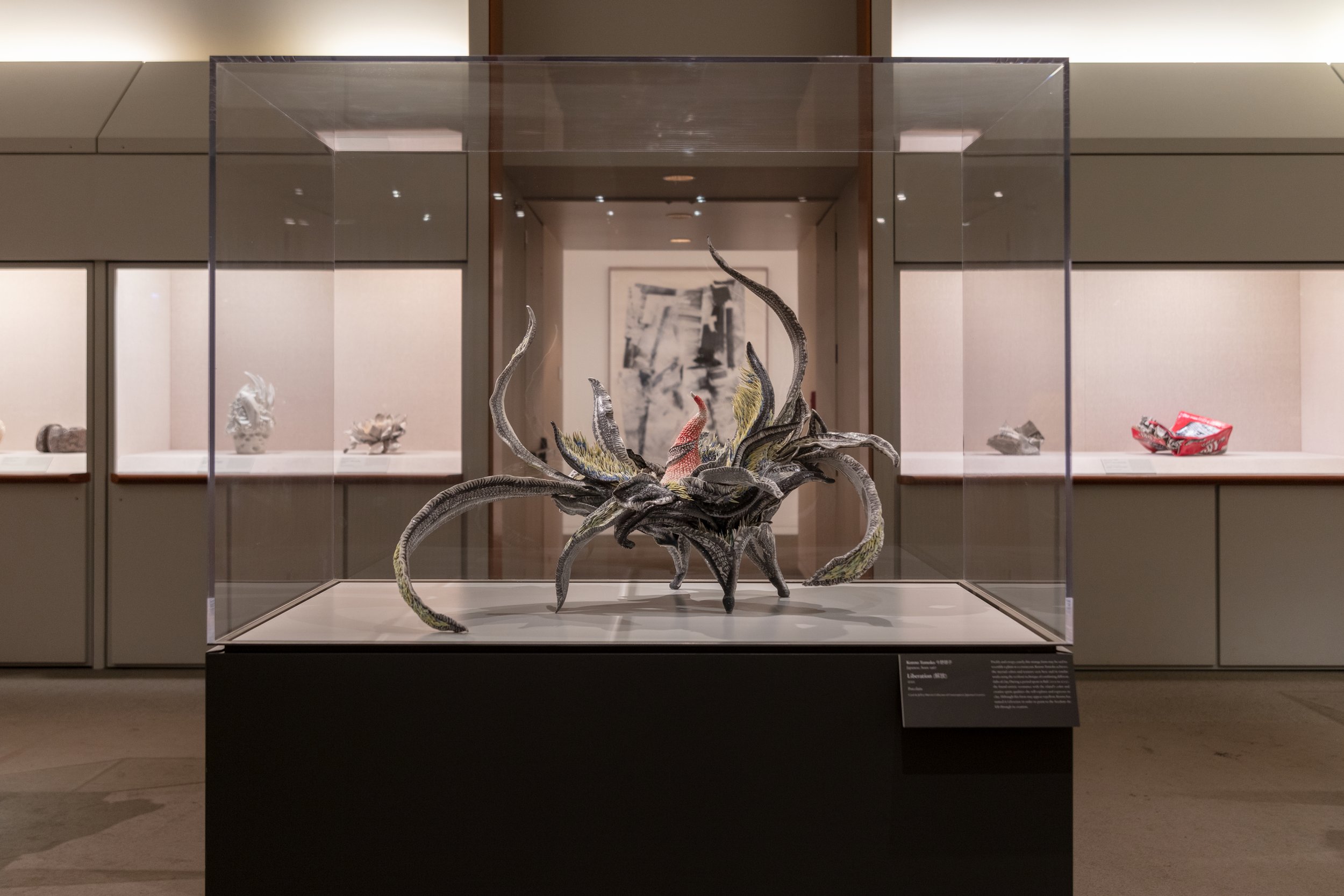
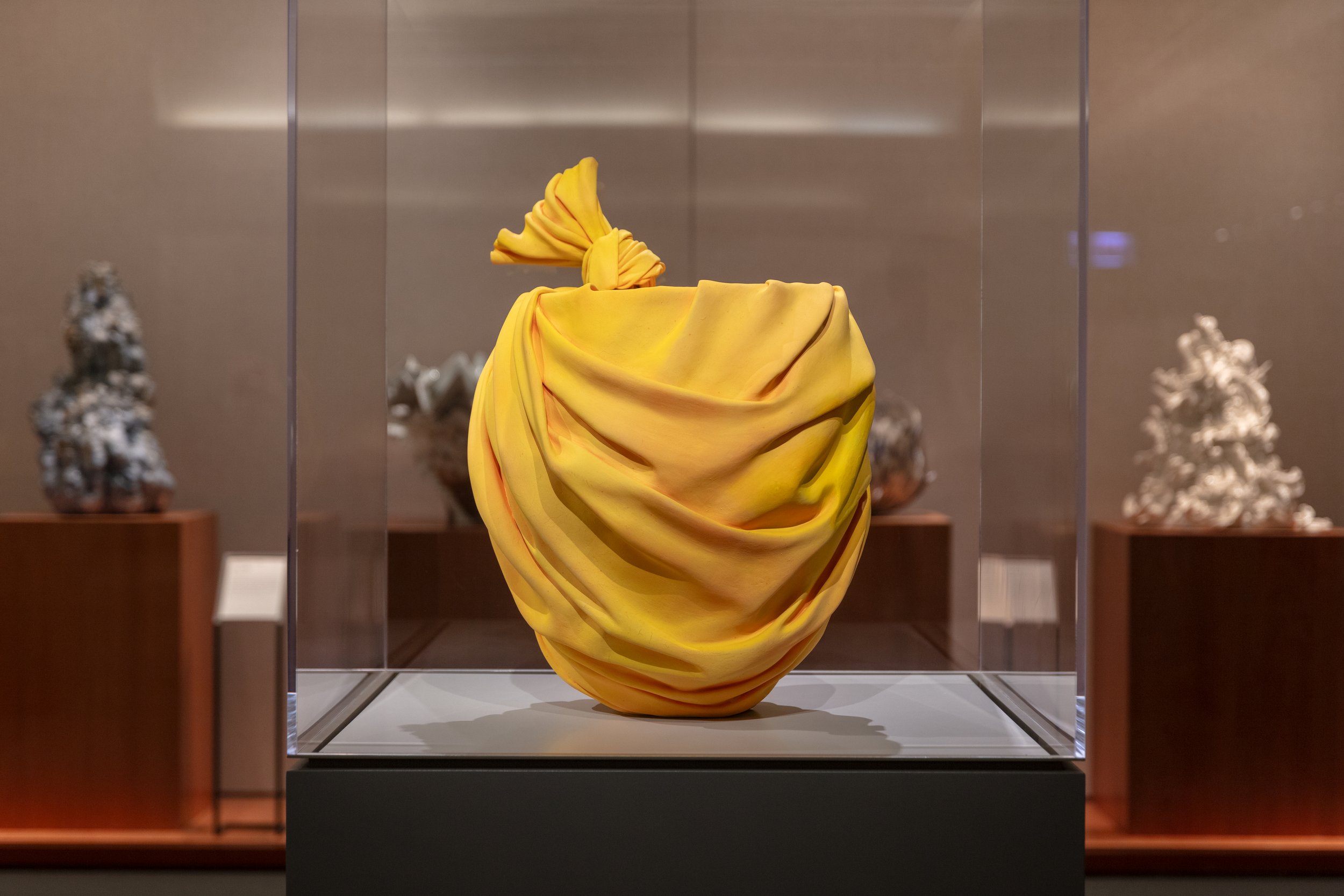
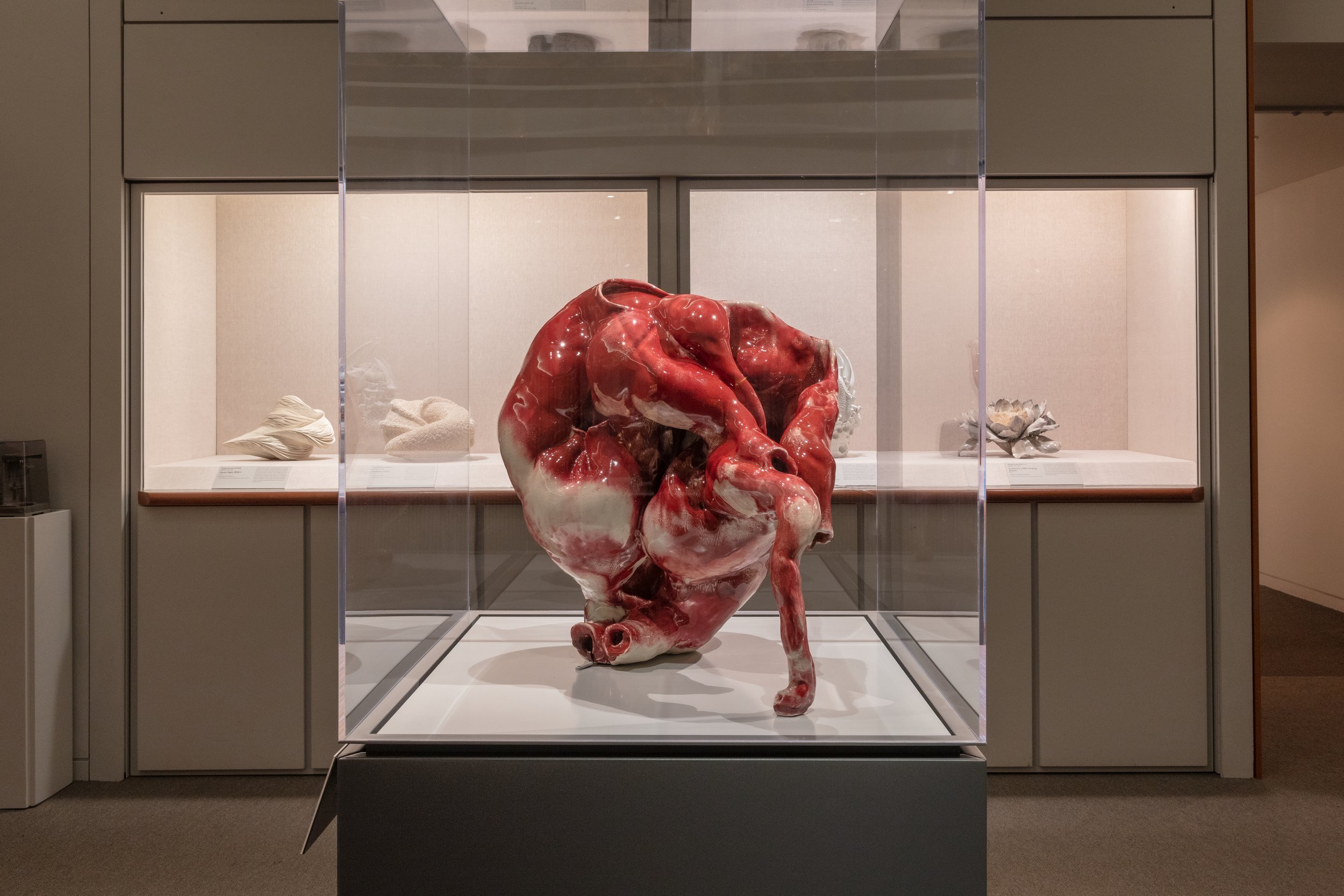
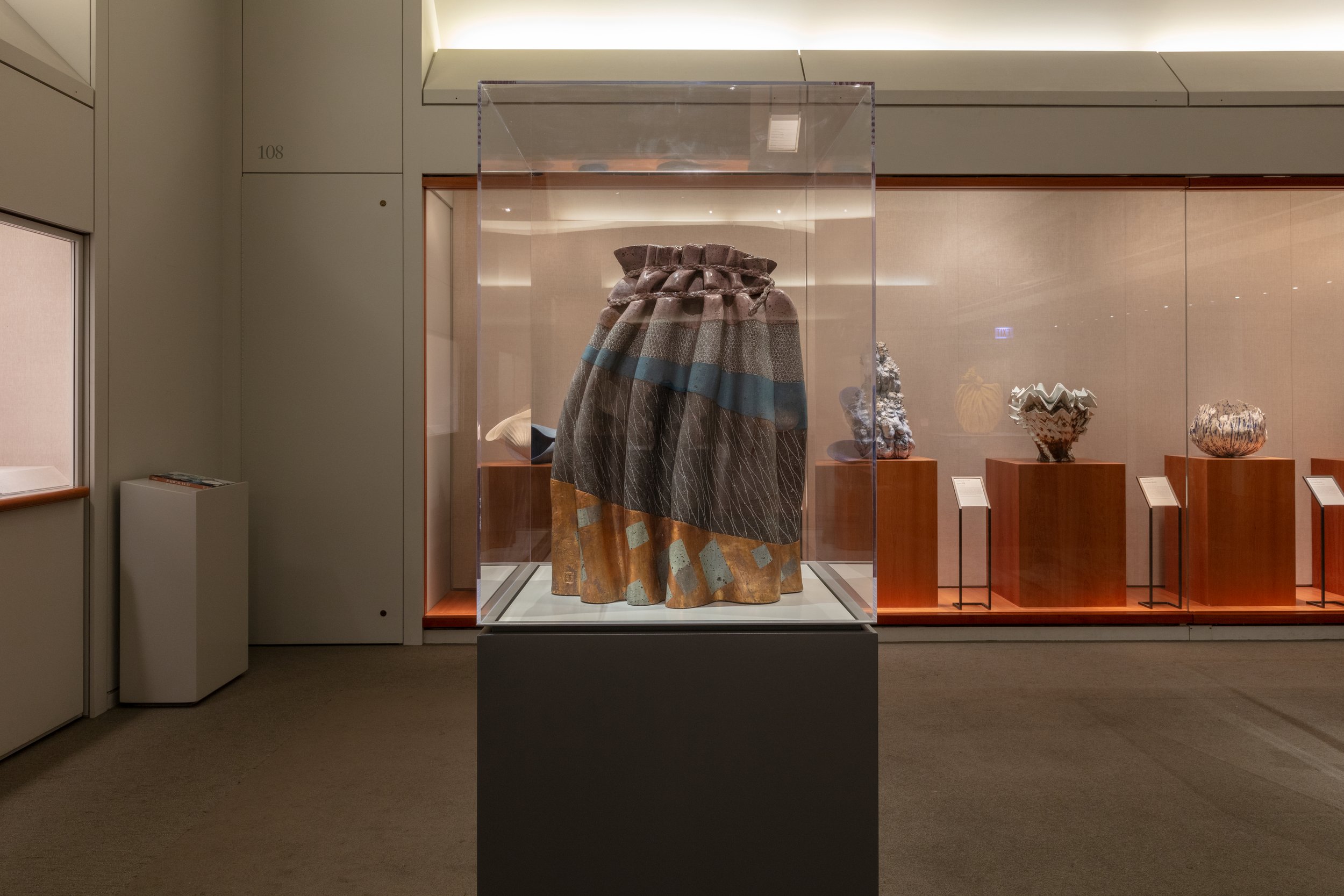
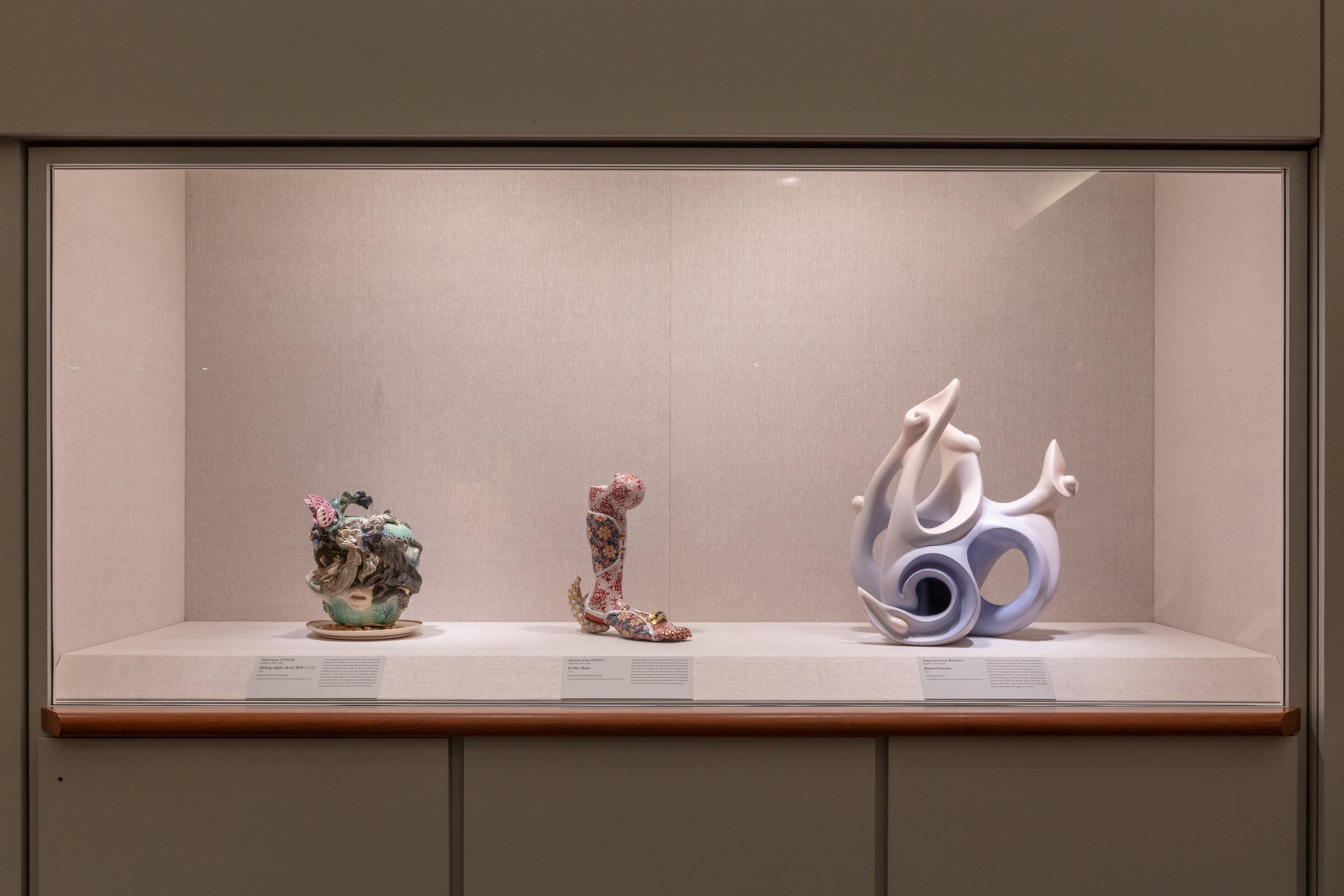
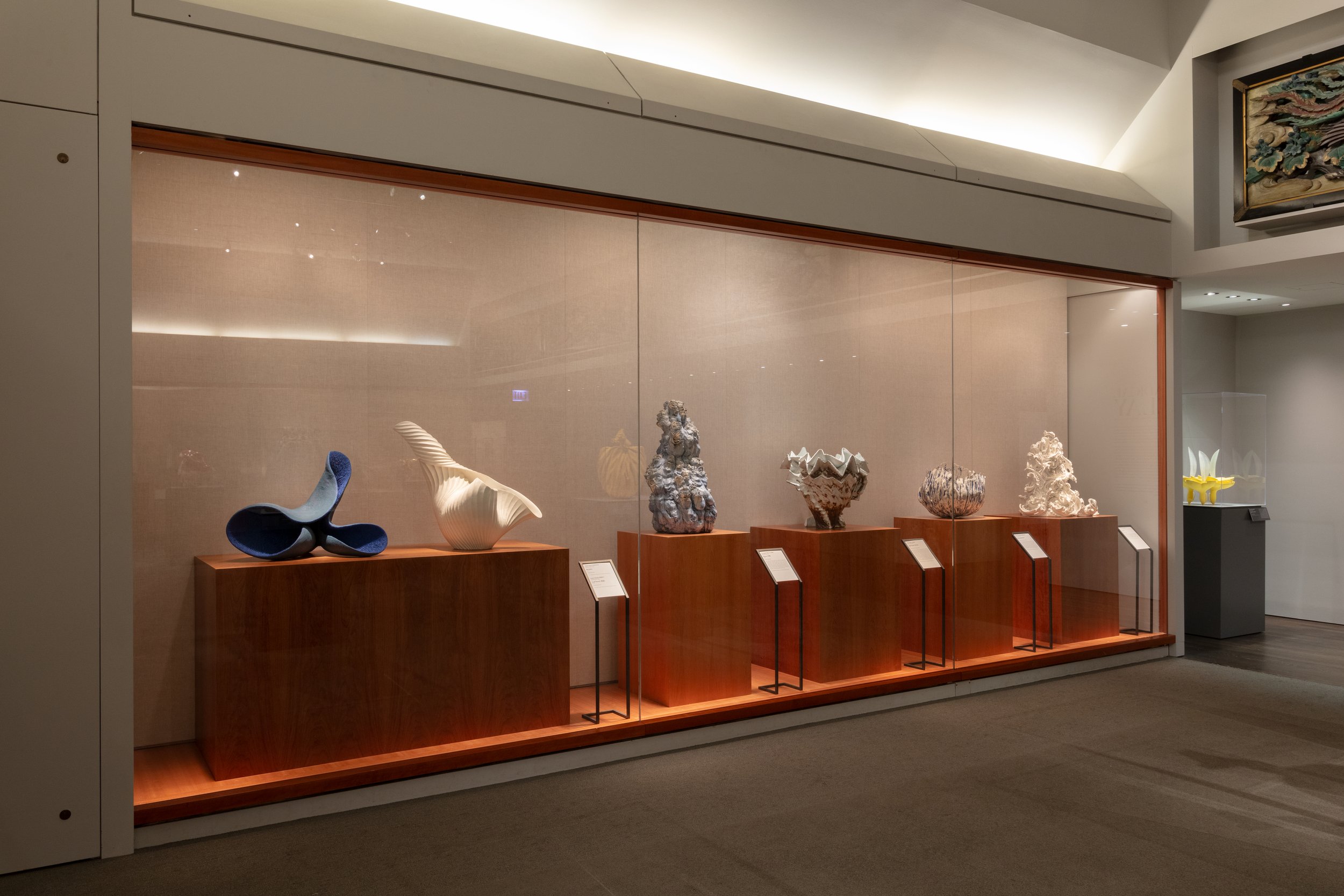
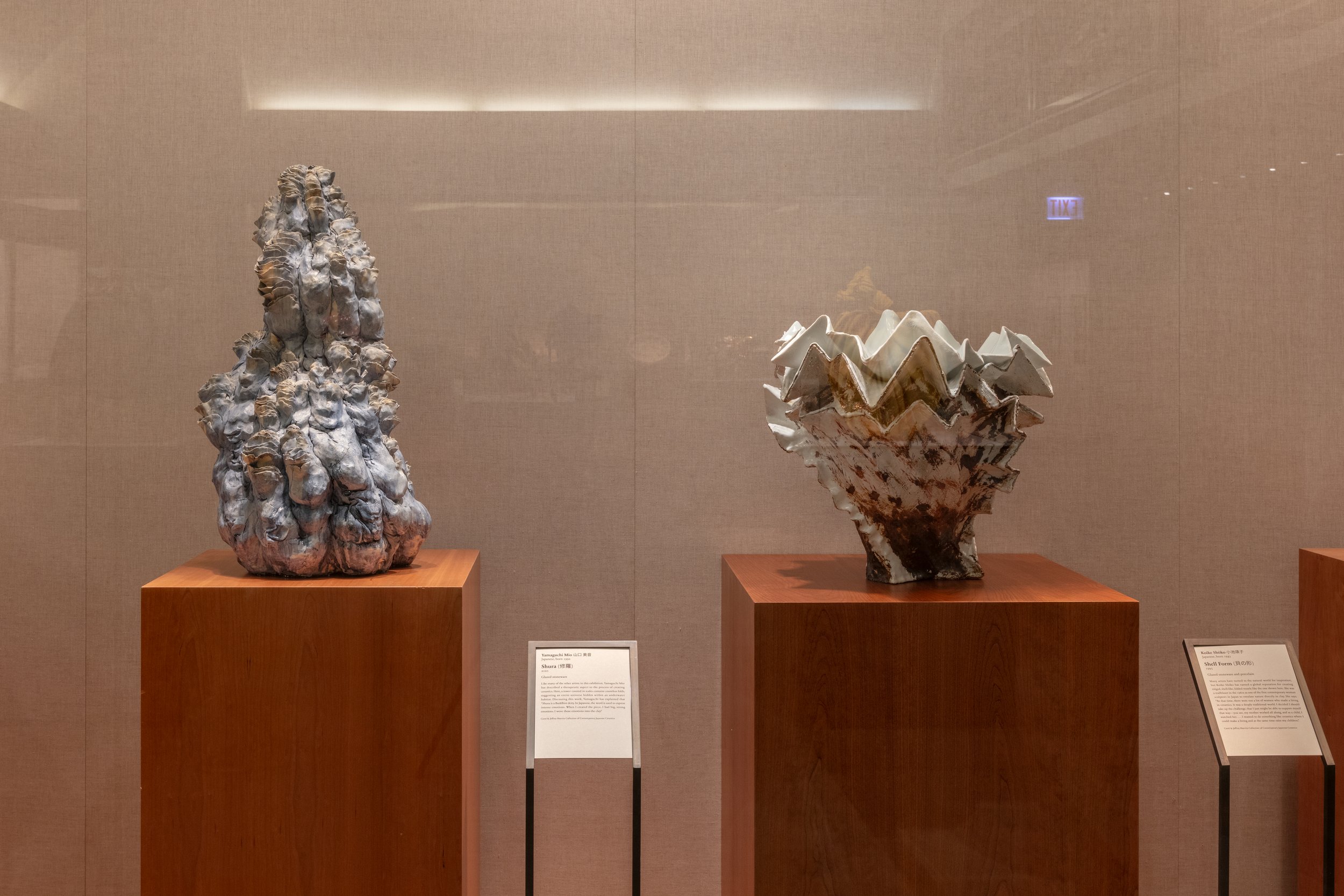
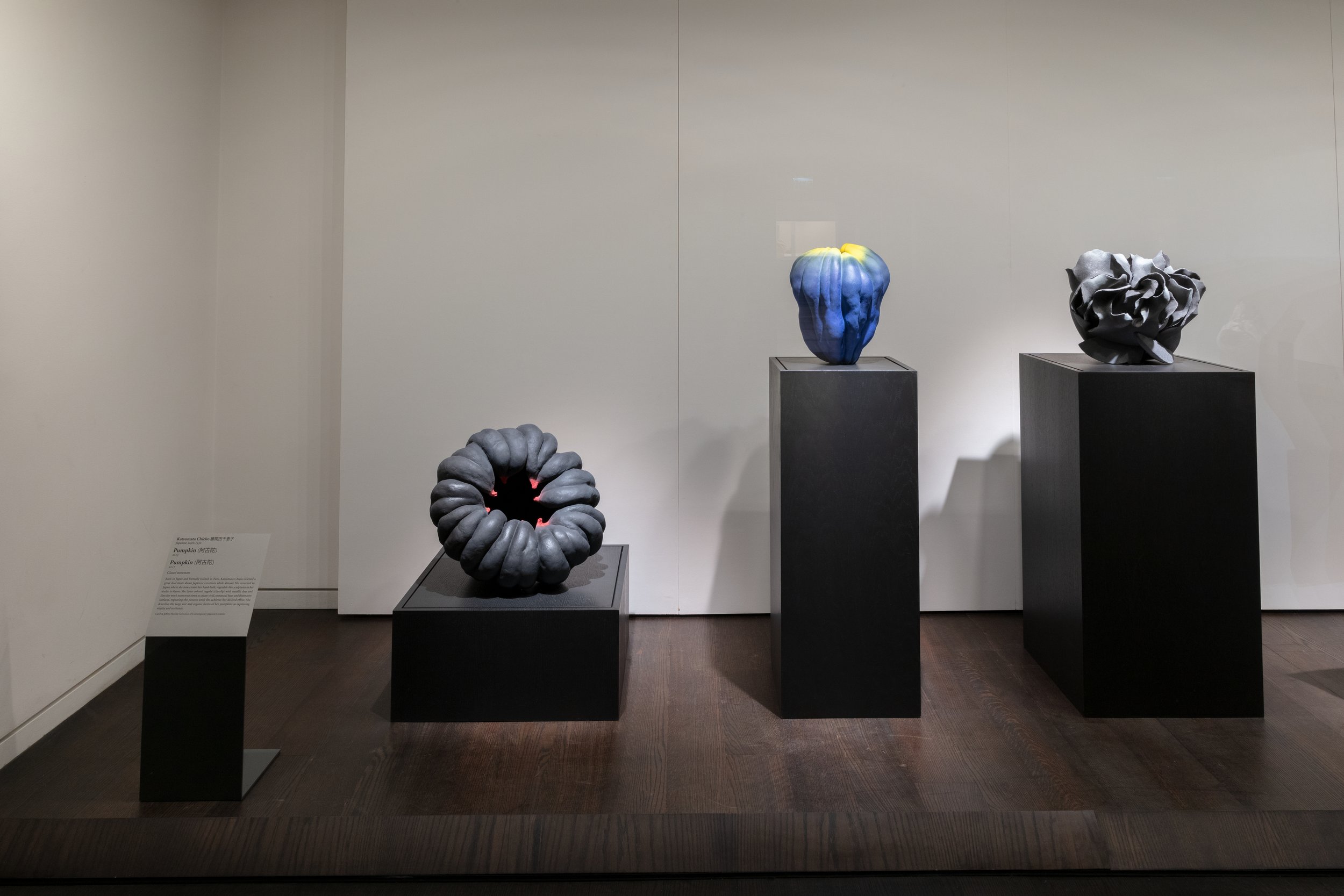
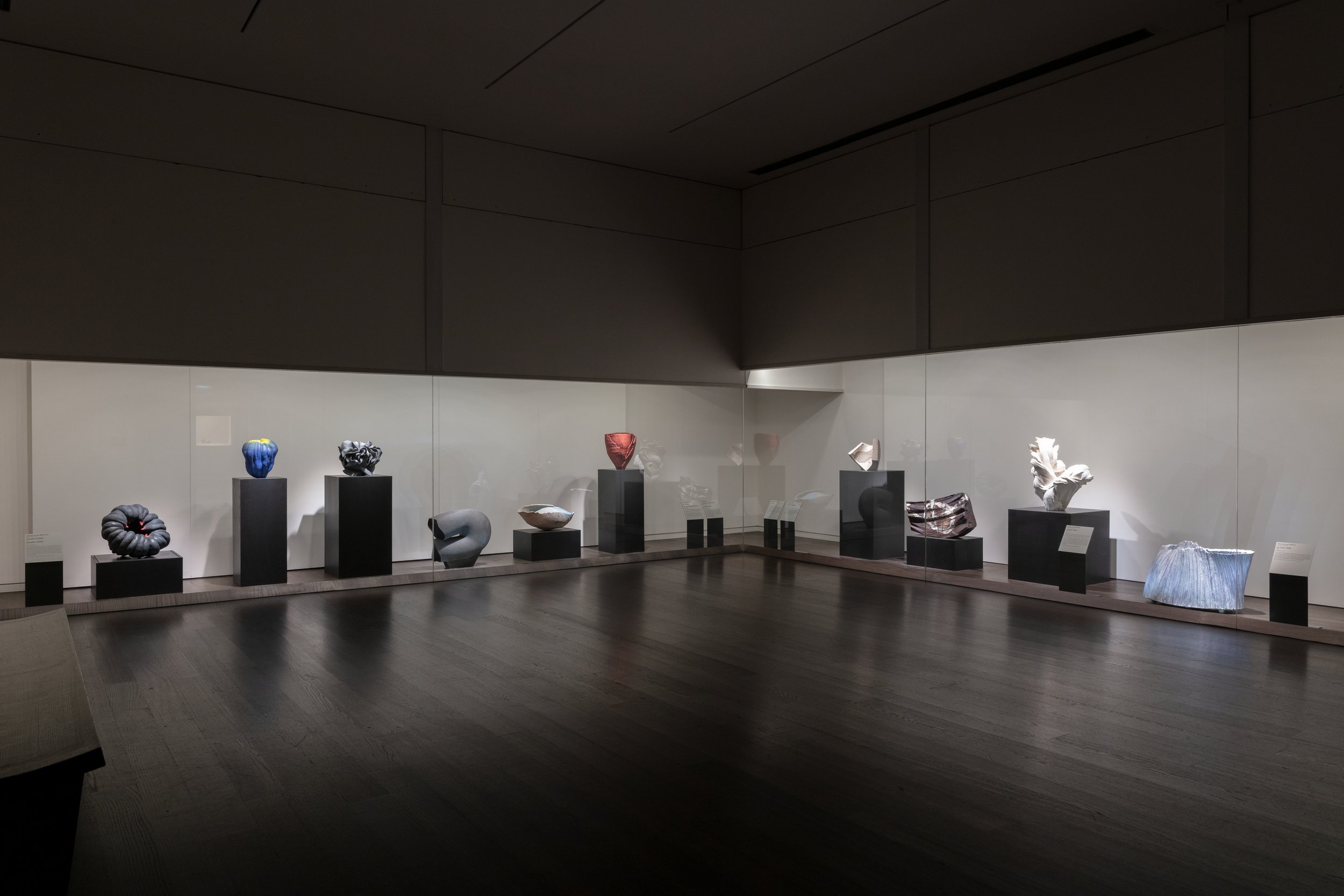
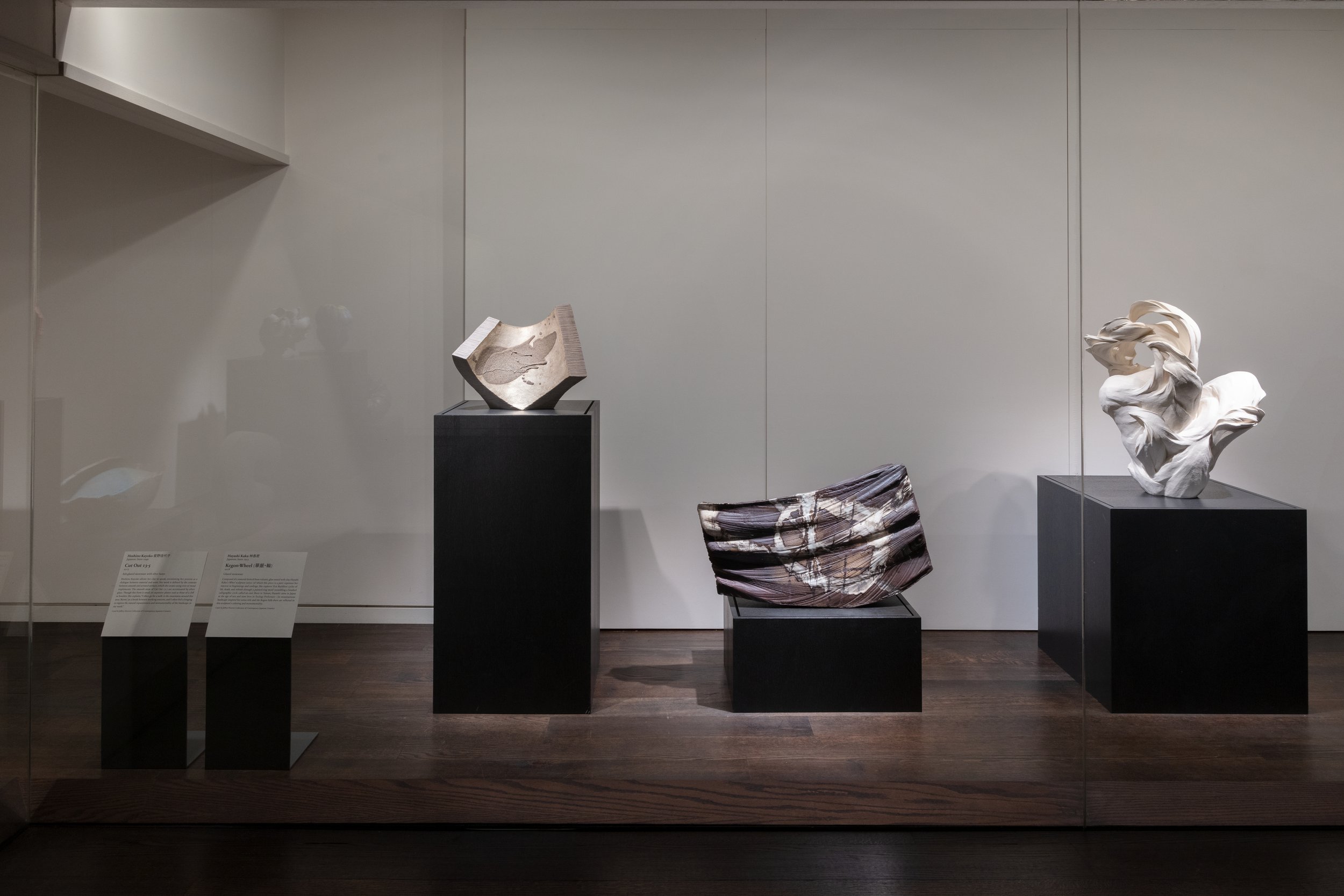
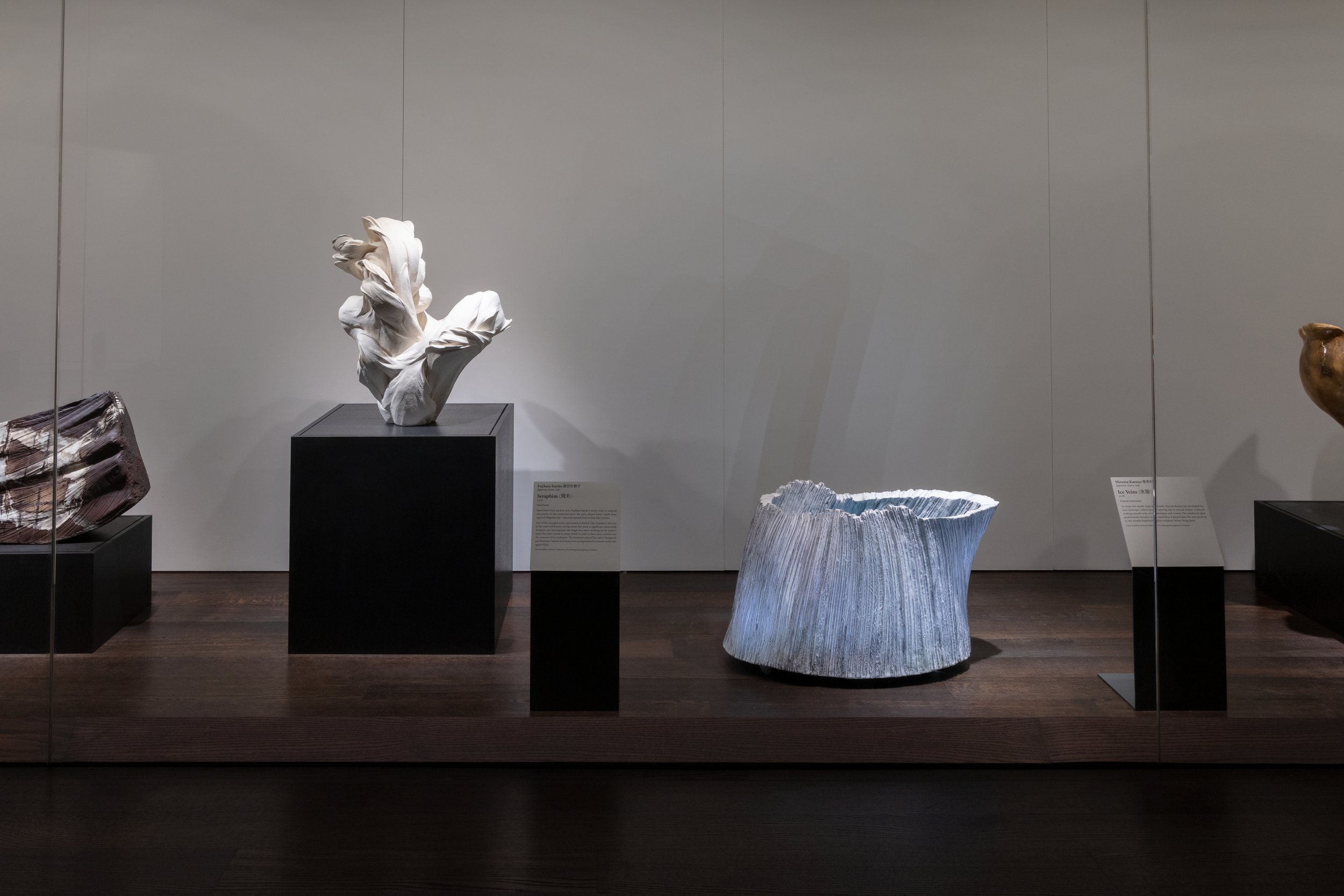
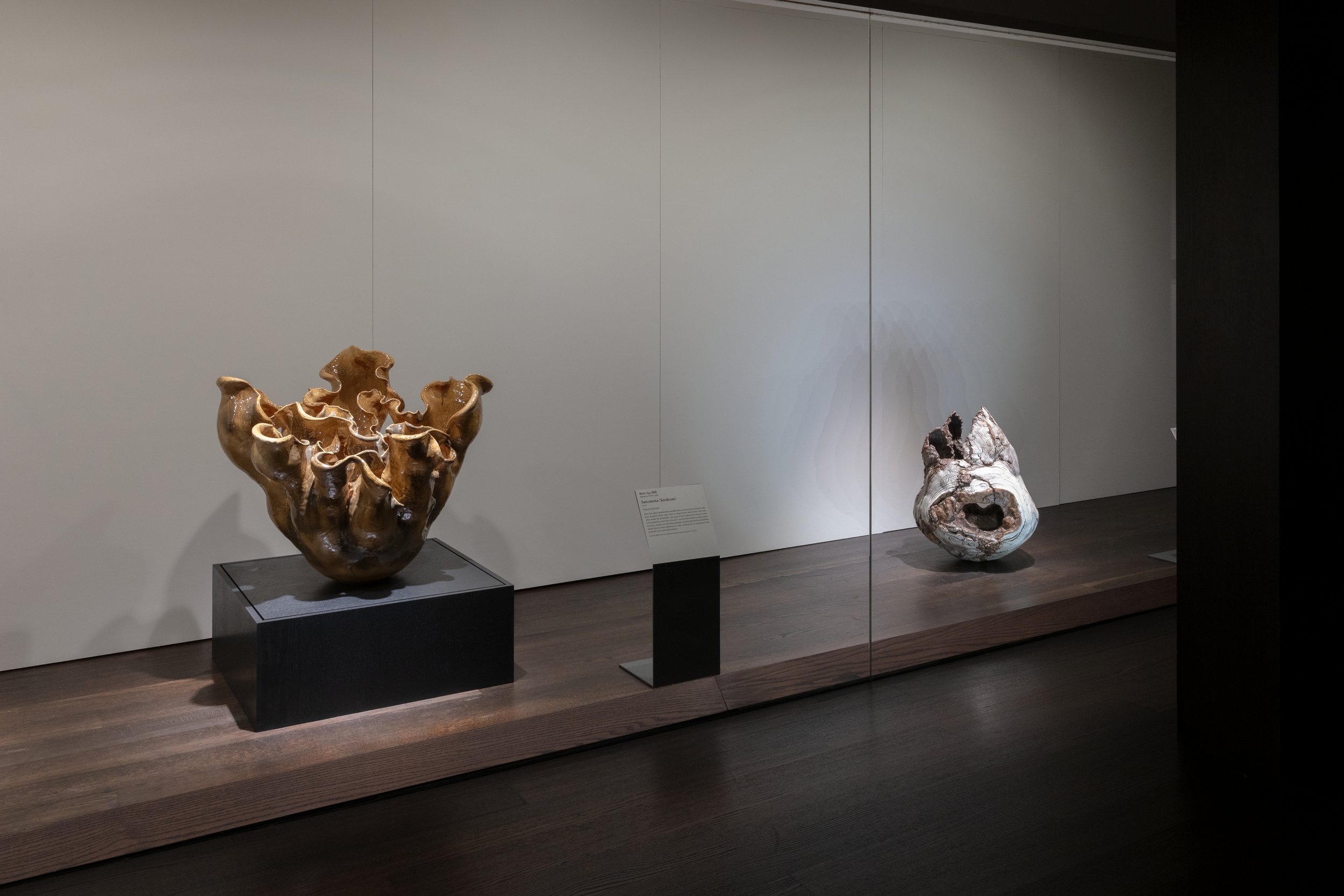
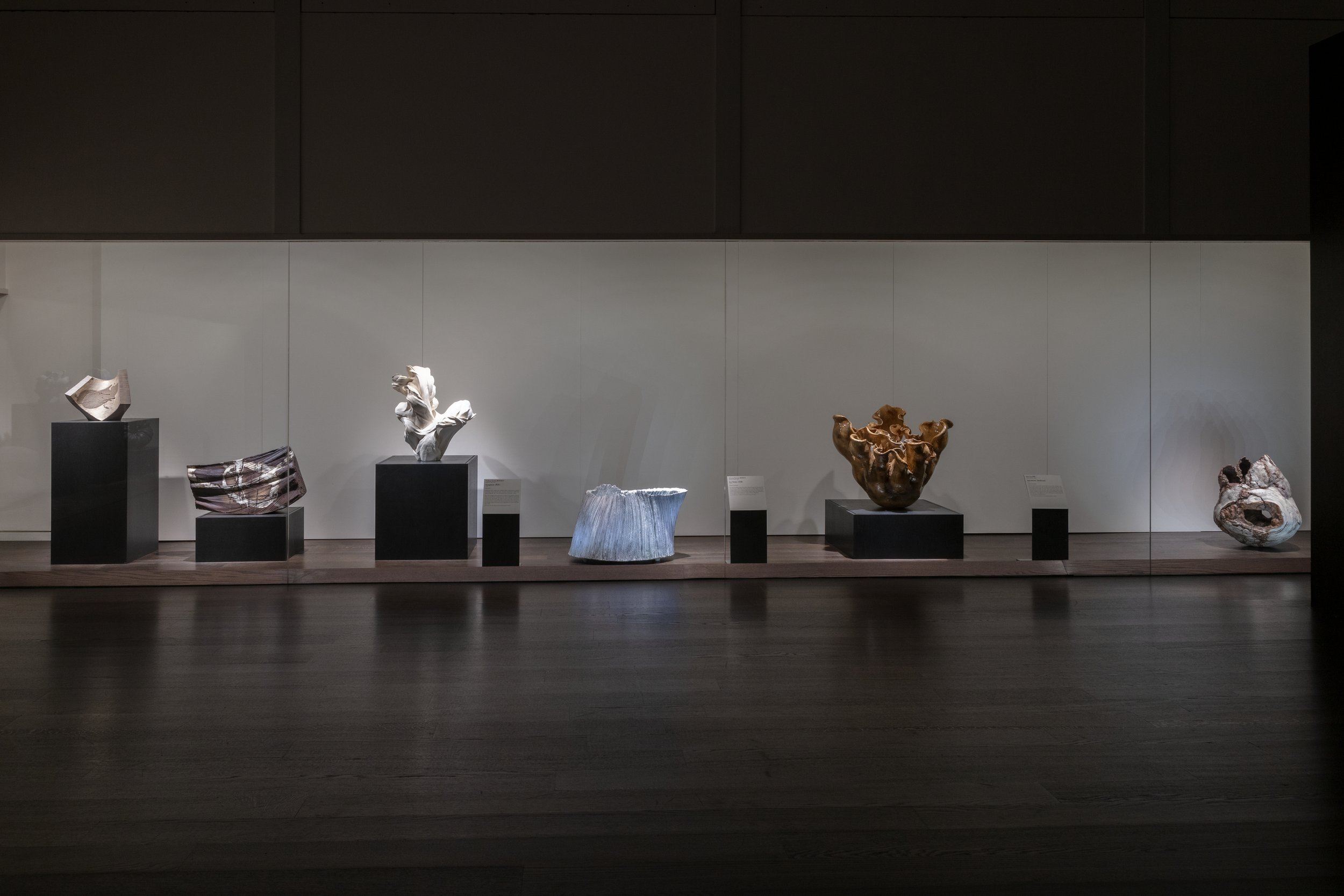
Installation view: Radical Clay: Contemporary Women Artists from Japan, 2024. The Art Institute of Chicago, Chicago. Courtesy of The Art Institute of Chicago
Radical Clay: Contemporary Women Artists from Japan is curated by the Art Institute of Chicago’s Janice Katz
SPONSORS
Lead support for Radical Clay: Contemporary Women Artists from Japan is generously provided by Carol & Jeffrey Horvitz.
Additional support is contributed by the Japan Foundation.
For more information about the exhibition and other exhibitions, please visit The Art Institute of Chicago's website here. The institute can also be found on Facebook, Instagram, and YouTube.
Ming Smith: Feeling the Future
Photograph by Chanell Stone, courtesy of Aperture
Charleston, S.C. – The International African American Museum (IAAM) will house a special exhibition by Ming Smith this winter and early spring. Ming Smith: Feeling the Future opened on January 31 and will be on view through April 28, 2024. A reception was held on Tuesday, January 30, at IAAM, 14 Wharfside Street, in downtown Charleston; guests had the opportunity to engage with solo artist Ming Smith about her career and legacy. They also had the chance to partake in a self-guided tour of the entire museum from 7:00 p.m. to 9:00 p.m.
Amen Corner Sisters (Harlem, New York) by Ming Smith courtesy of IAAM
Ming Smith: Feeling the Future explores the artist’s unparalleled and under-recognized career from the early 1970s through the present. Smith’s first solo exhibition at a major institution is traveling from its debut site, the Contemporary Art Museum (CAM) of Houston. The collection encompasses a multitude of artistic expressions that represent her vibrant and multi-layered practice, which is grounded in portraiture, as it amplifies the heartbeat of Black life in the United States. Drawn from the full complexity of Smith’s oeuvre, Feeling the Future places works from the artist’s five decades of creation in conversation with one another while it embraces the cultural movements she witnessed and participated in. Exploring themes such as Afrofuturism, Black cultural expression, representation, and social examination, the exhibition offers a guided tour into unperceived moments of life as captured by one of the most profoundly gifted artists of her generation.
Chicago Art Ensemble by Ming Smith, courtesy of IAAM.
“Ming Smith is one of the most important photographers of our time. As the first woman to join Kamoinge – a groundbreaking Black photography collective – she has broken barriers that live at the intersection of race and gender. Her work can be found at the most significant institutions in the world, from The Whitney to the Schomburg, and has been shown at many more, including Tate Modern and MoMA. Still, few of us are yet to know her name, though many know her work. Her iconic images of artists like Tina Turner and Nina Simone have come across our timelines and, for a moment, stopped us in time. That’s how remarkable her lens is as it captures the soul of the moment, the movement, and the person. With this solo exhibition, traveling from CAM, we will have the opportunity to not only discover more of her work, but through the work, we will get to meet and to know Ming Smith,” noted Malika Pryor, chief engagement and learning officer at IAAM.
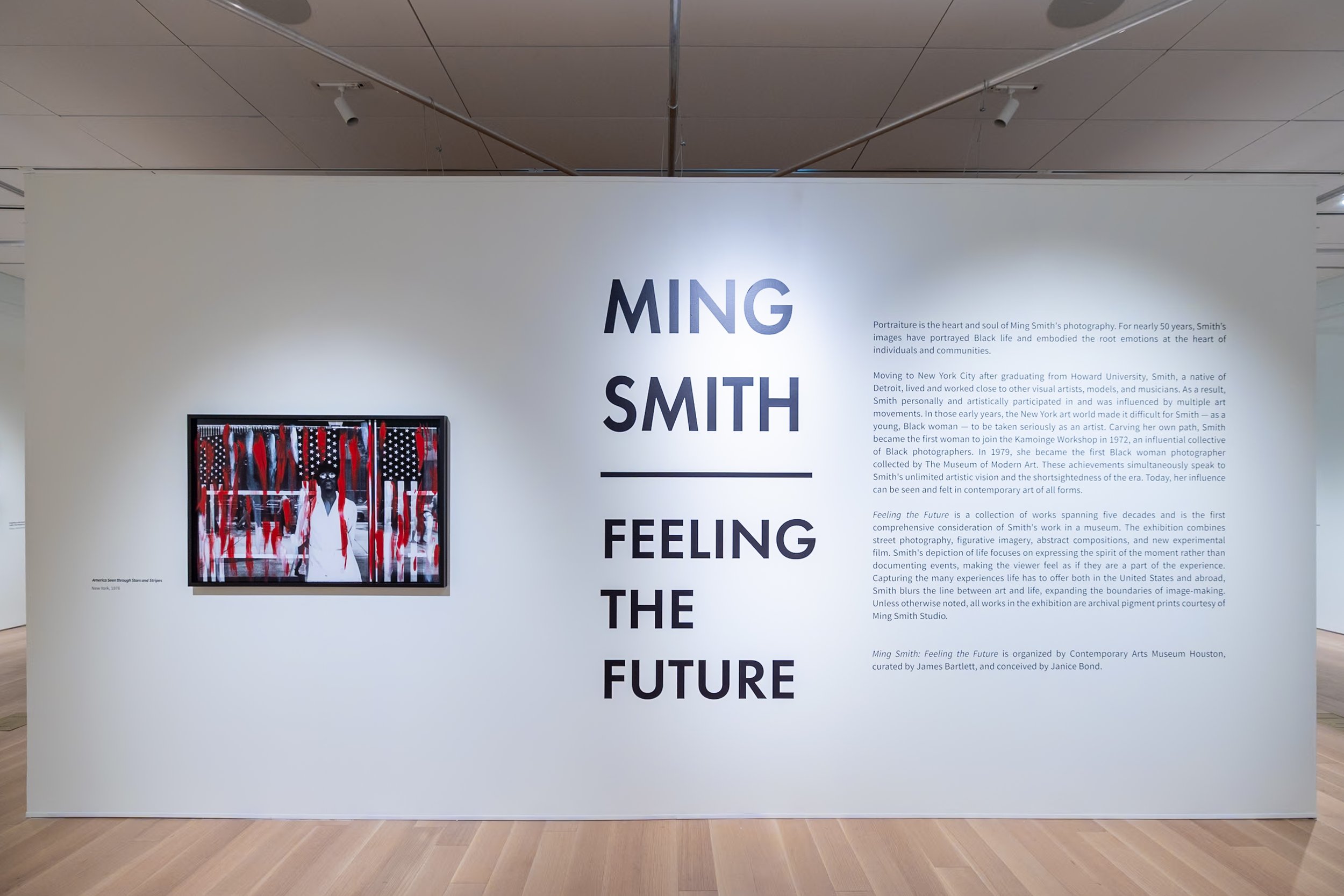

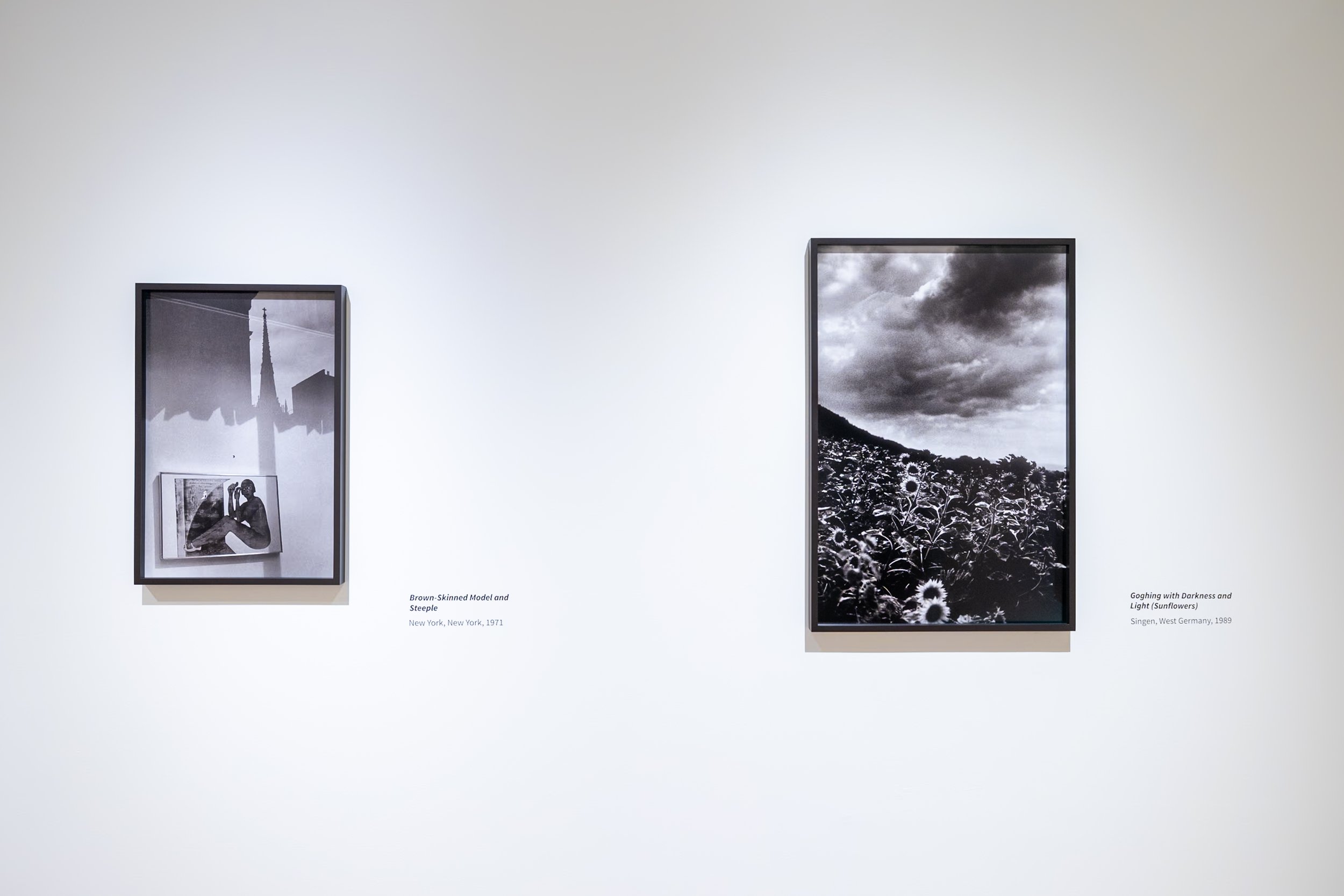
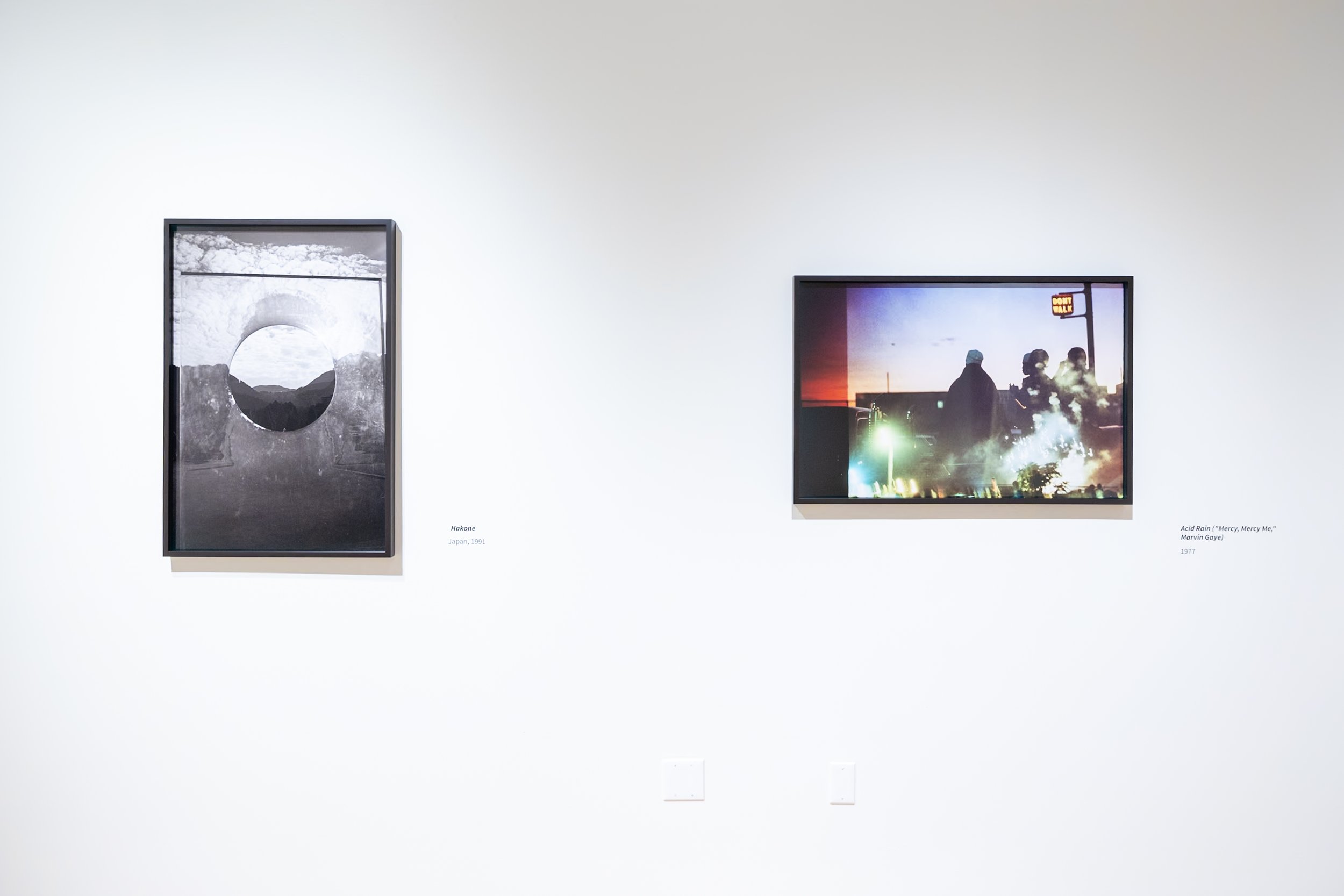
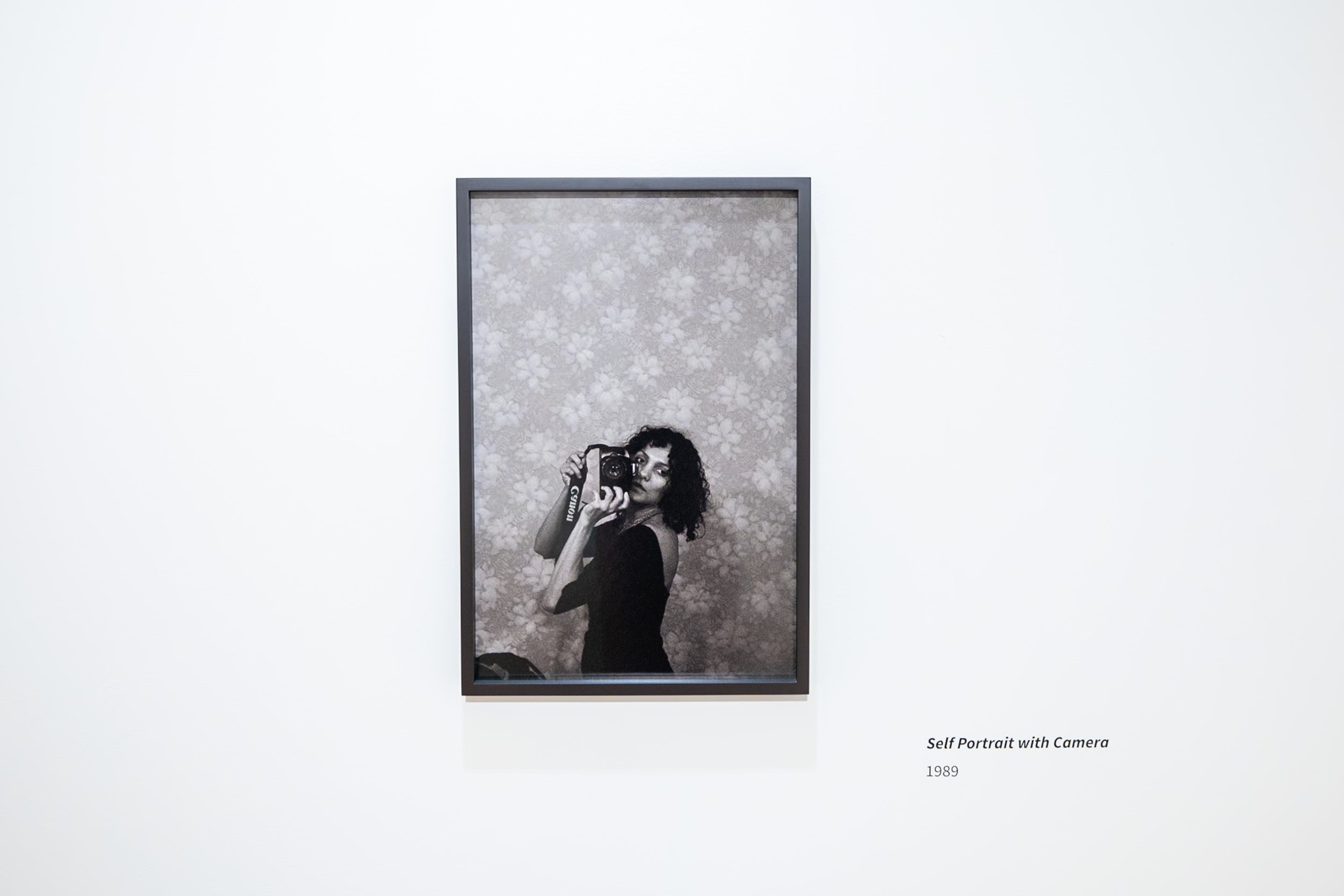
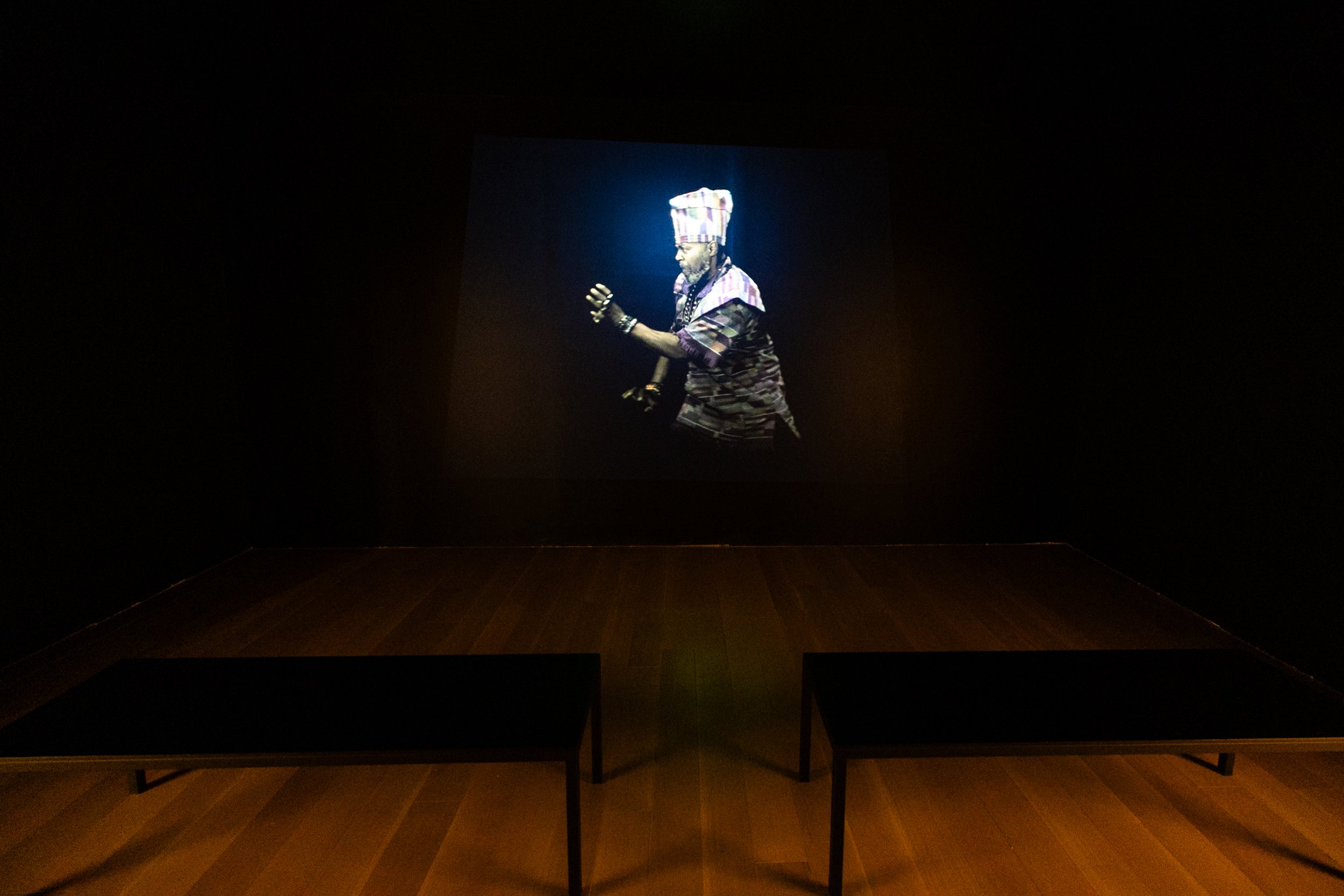
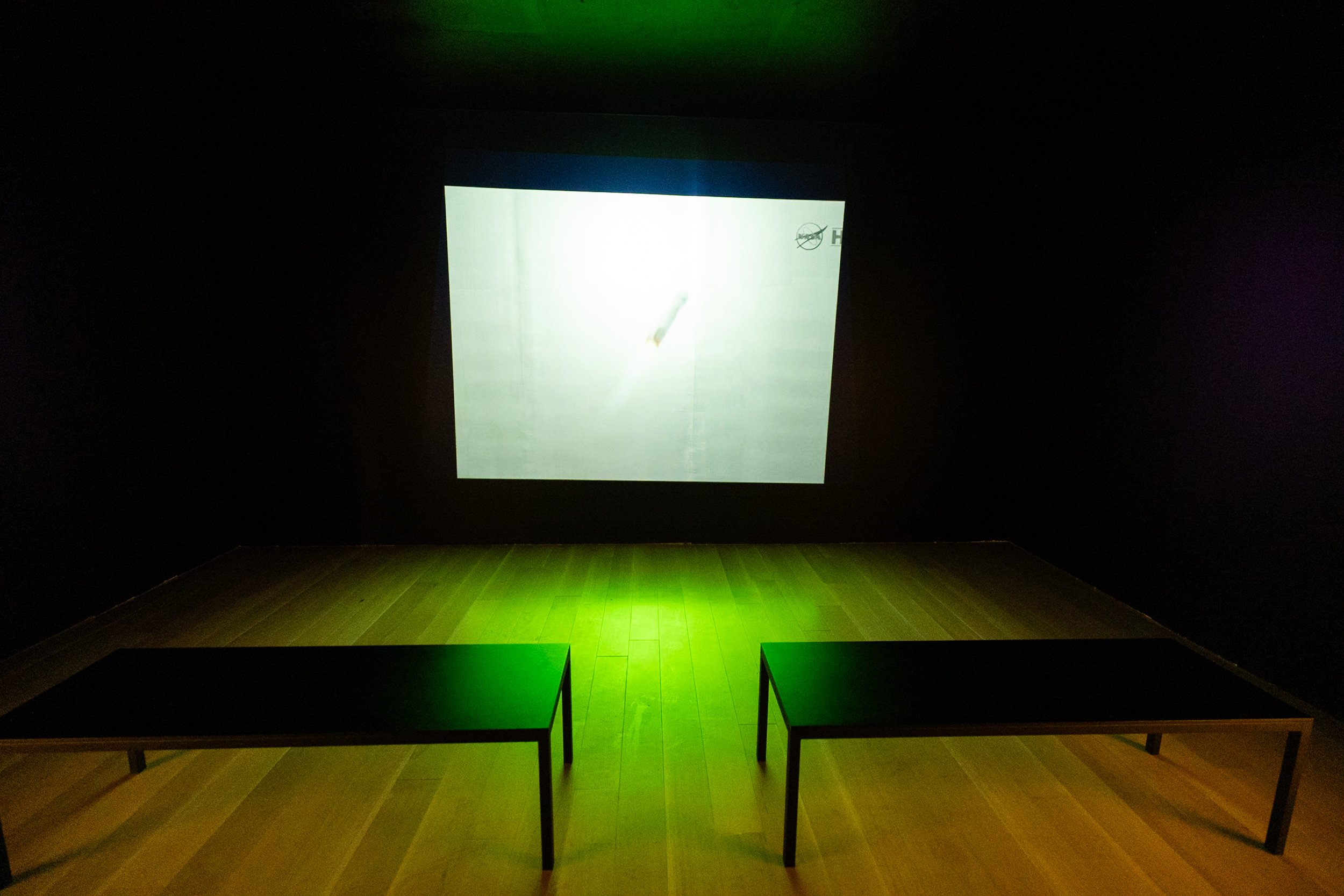
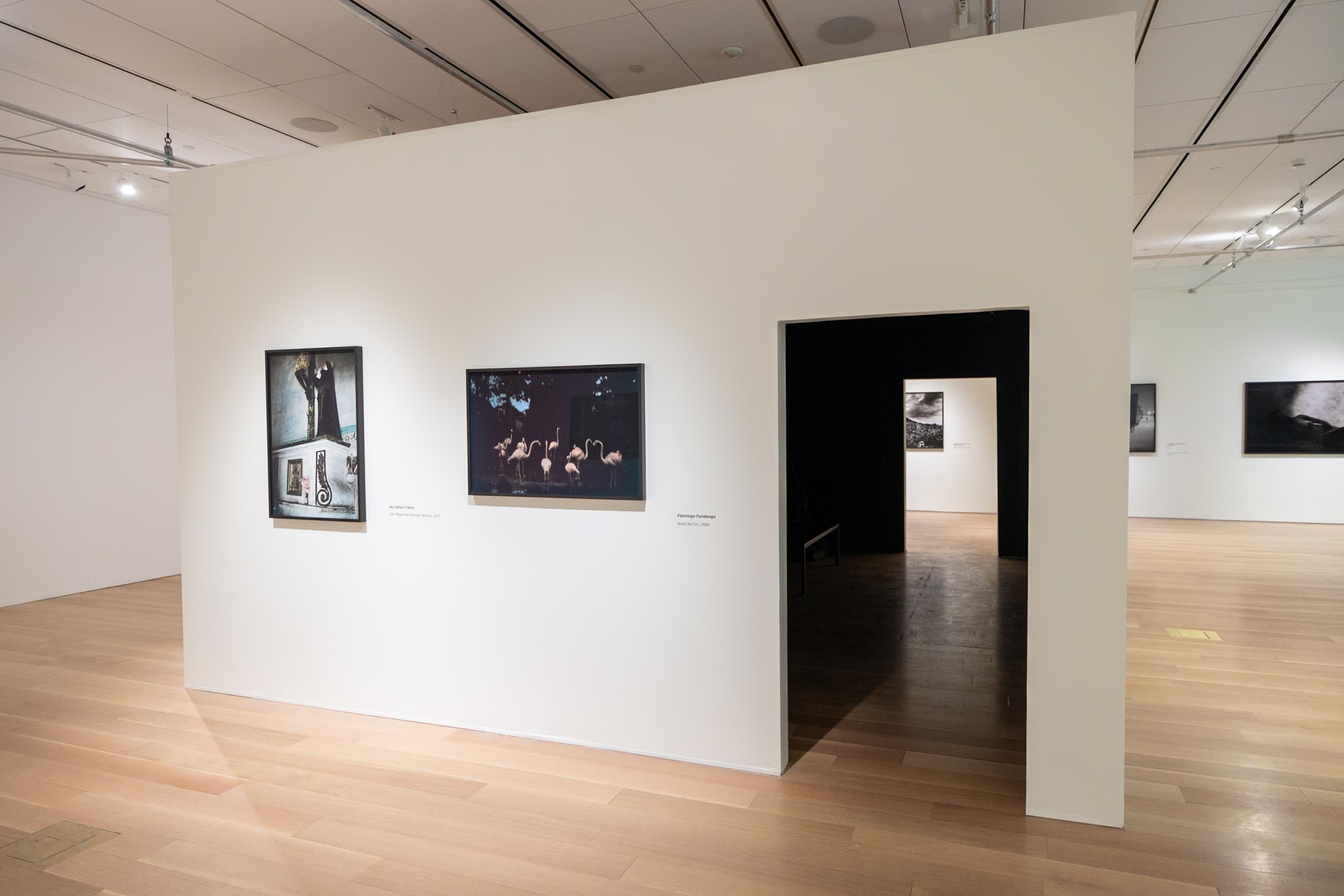
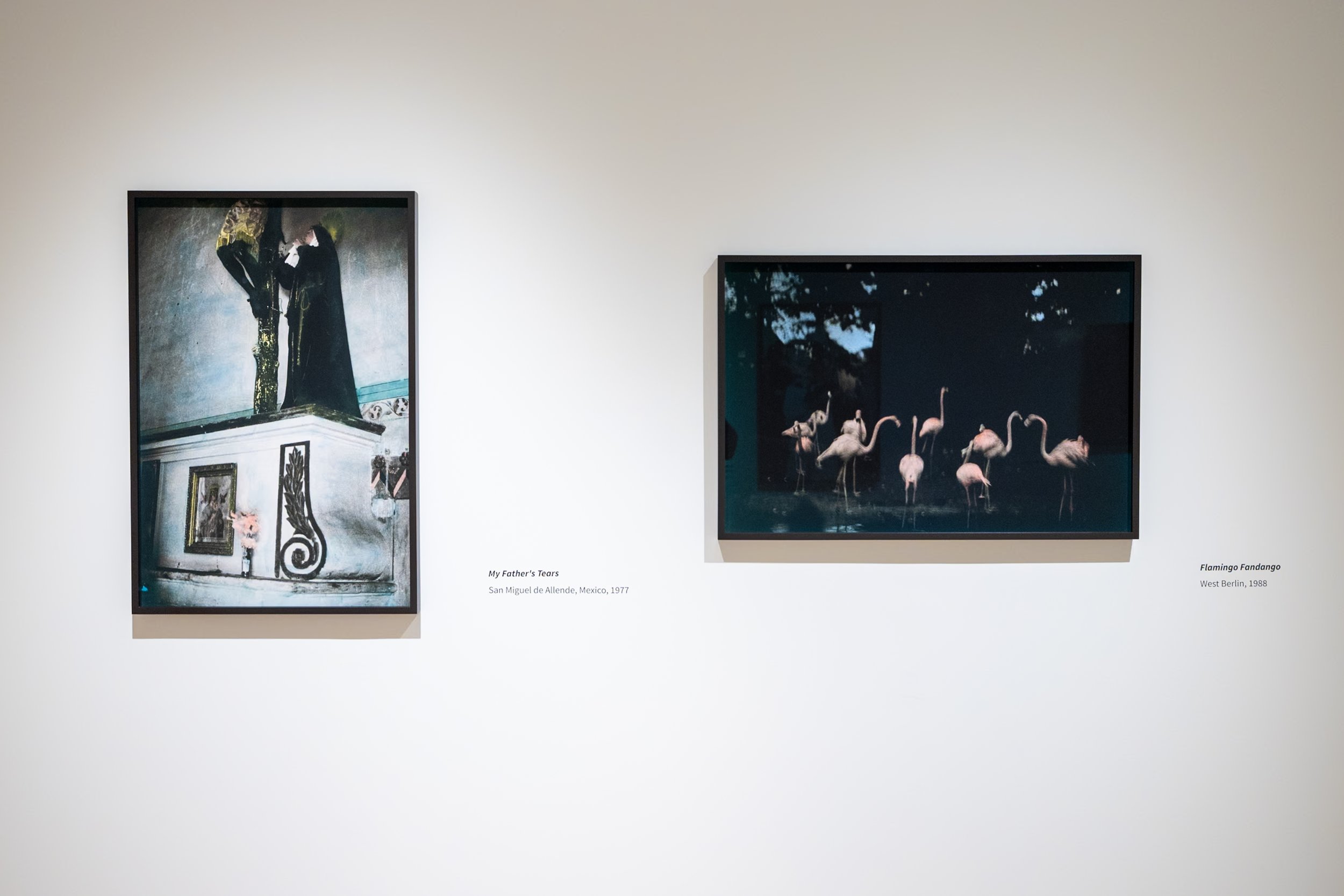

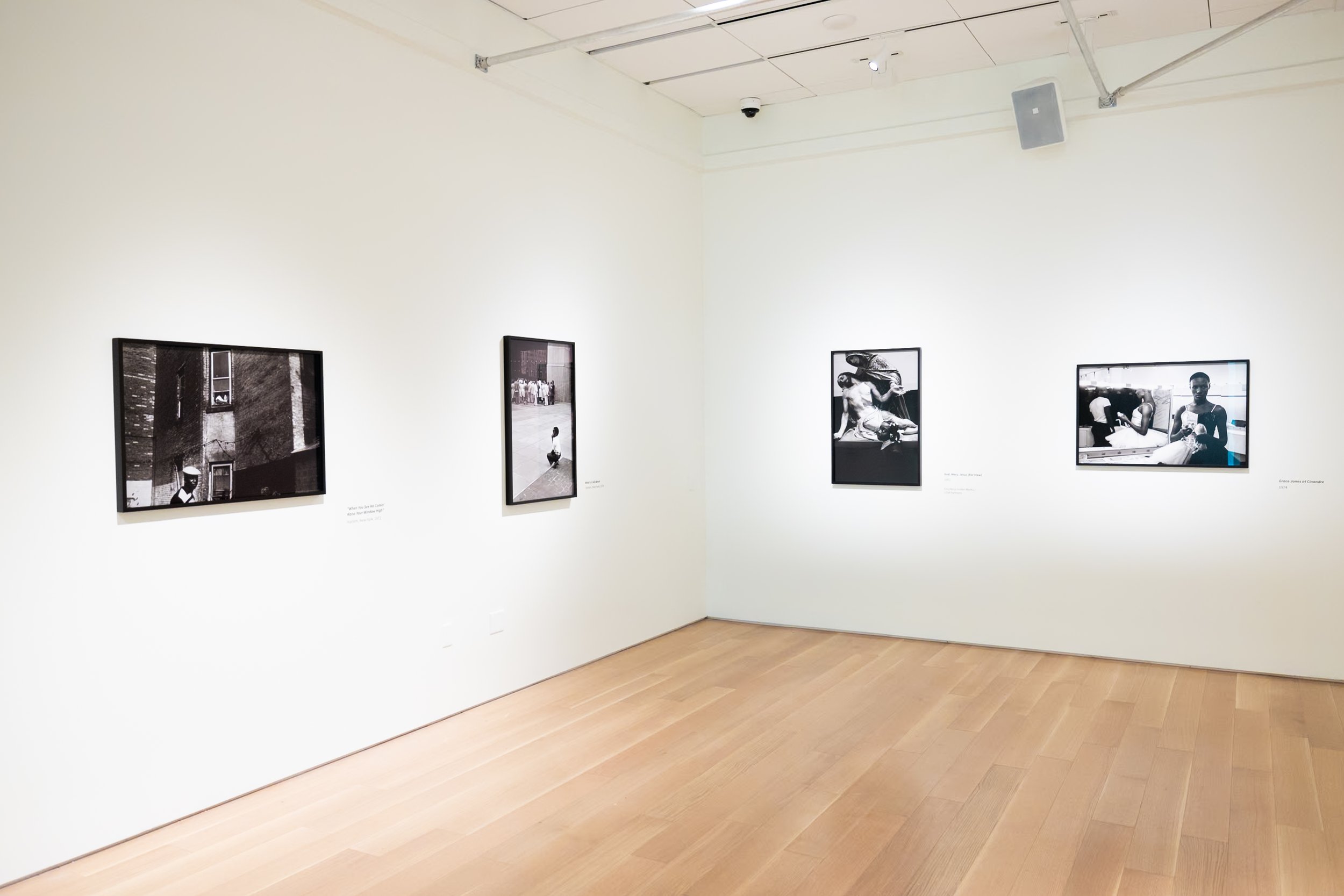
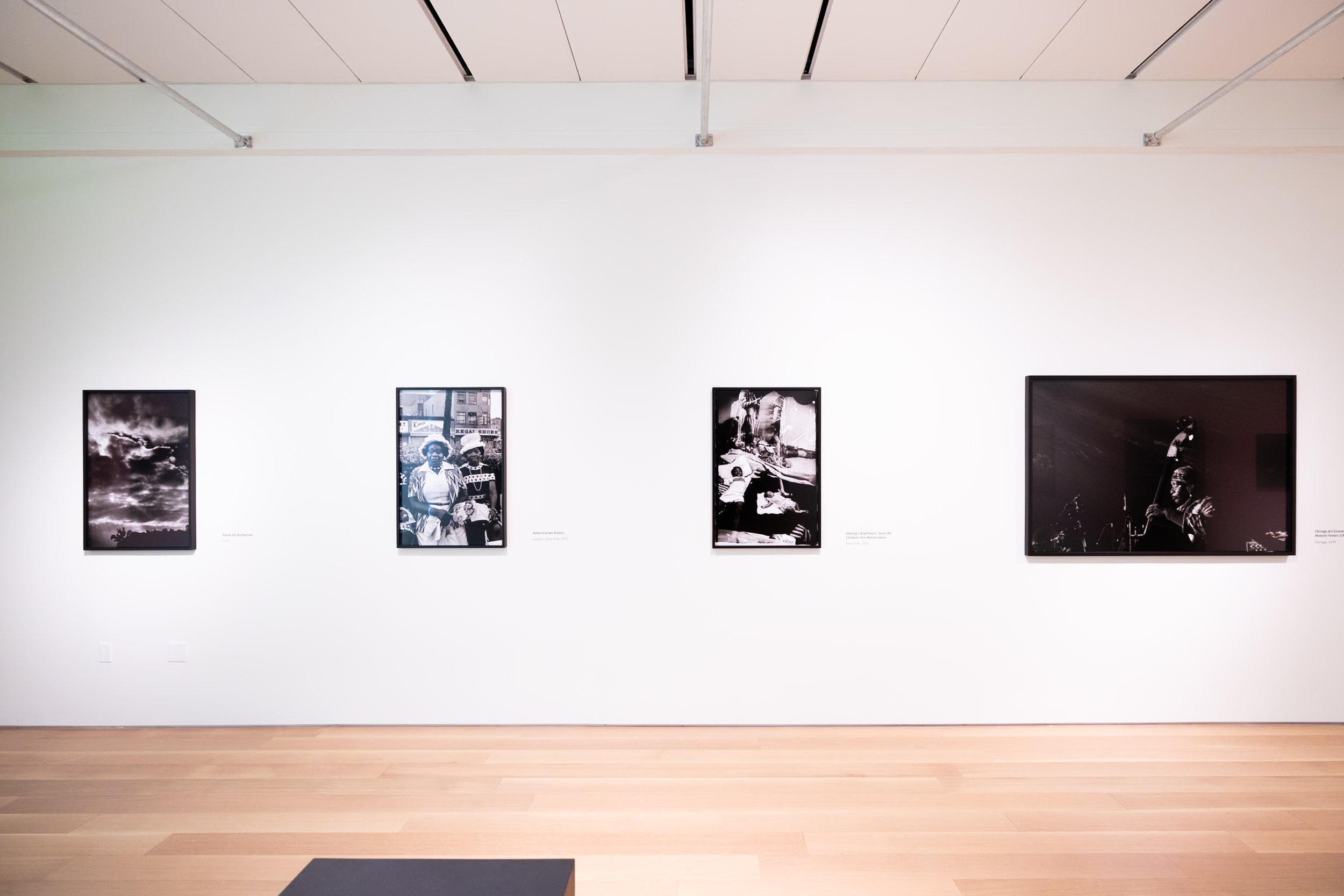
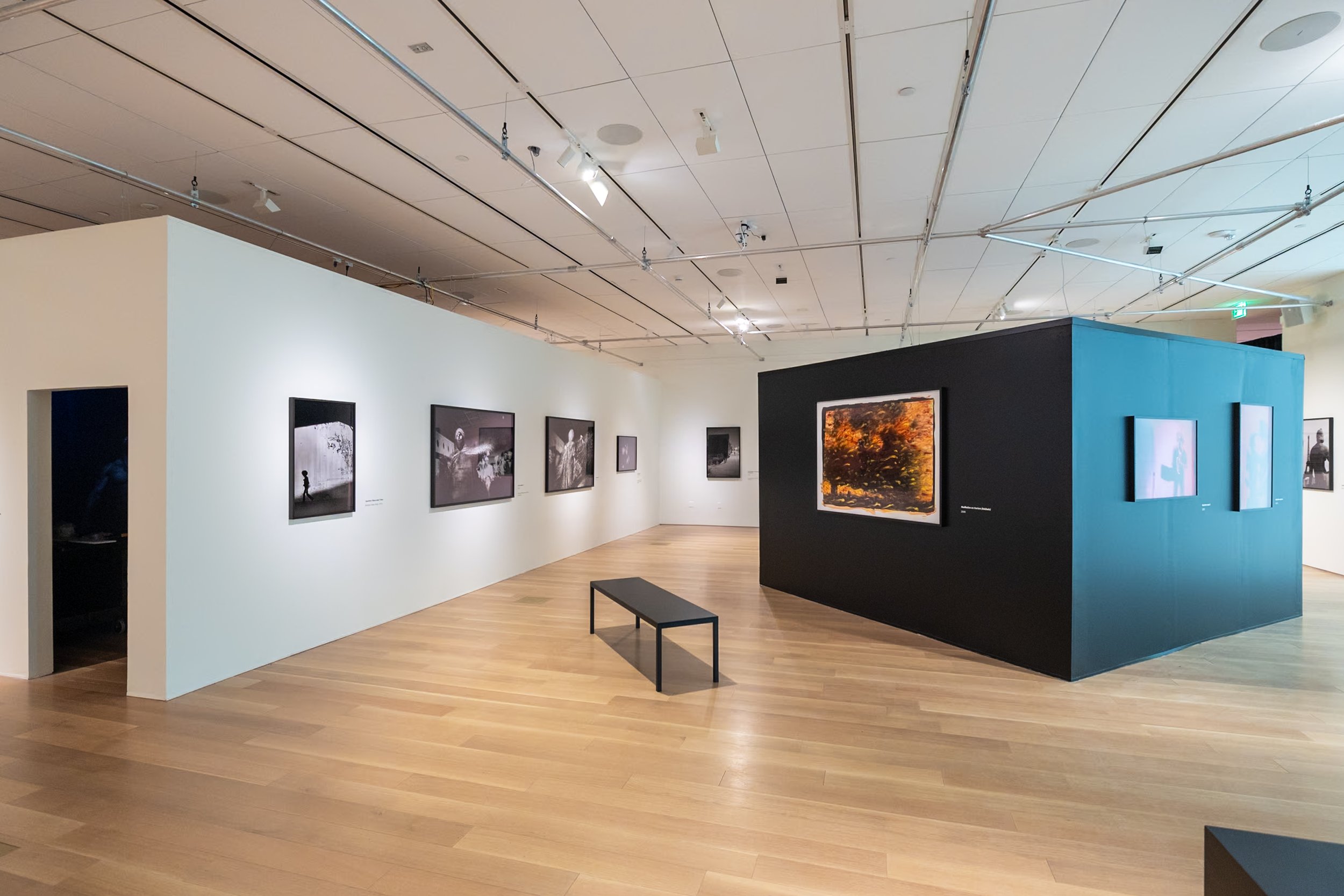
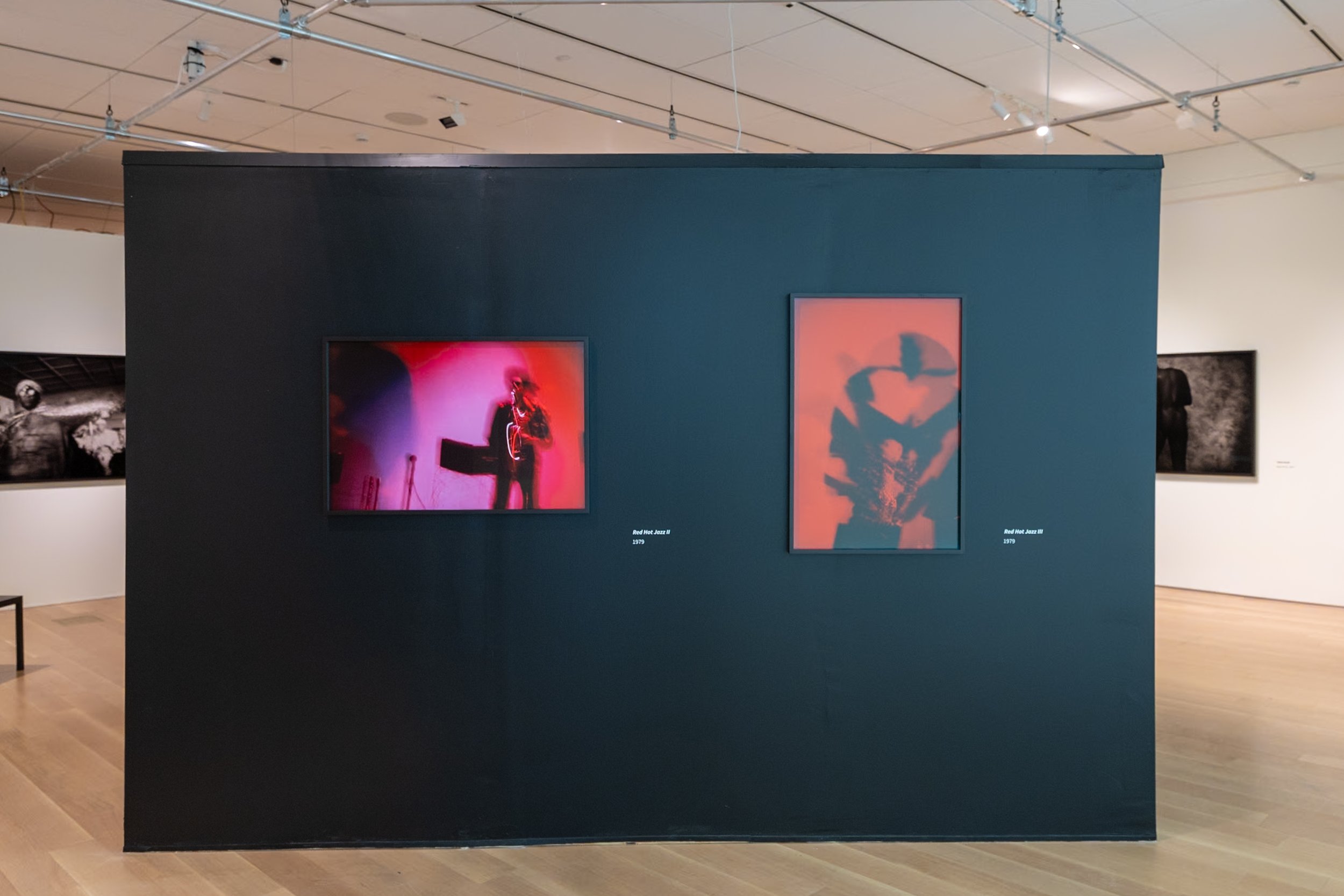
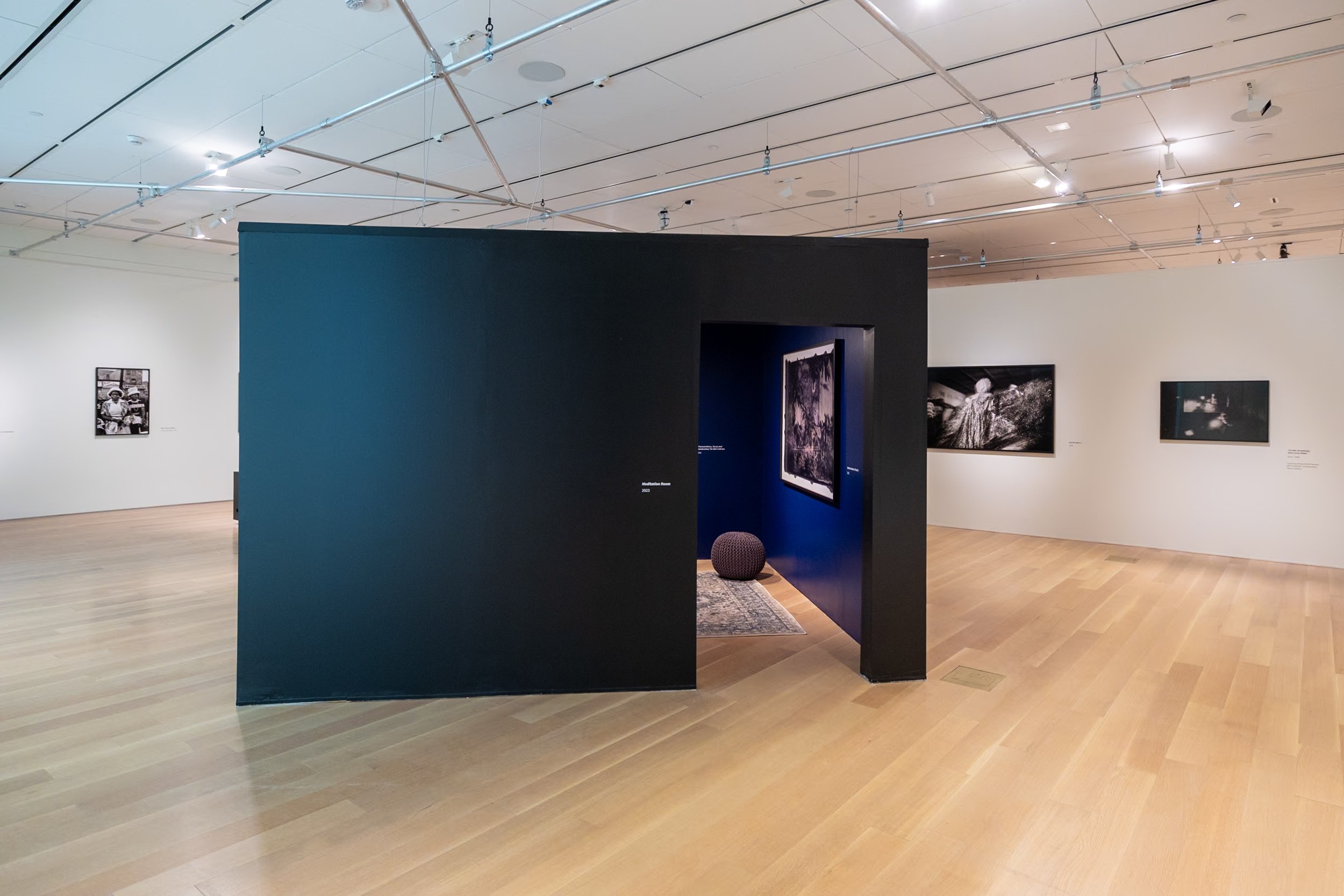
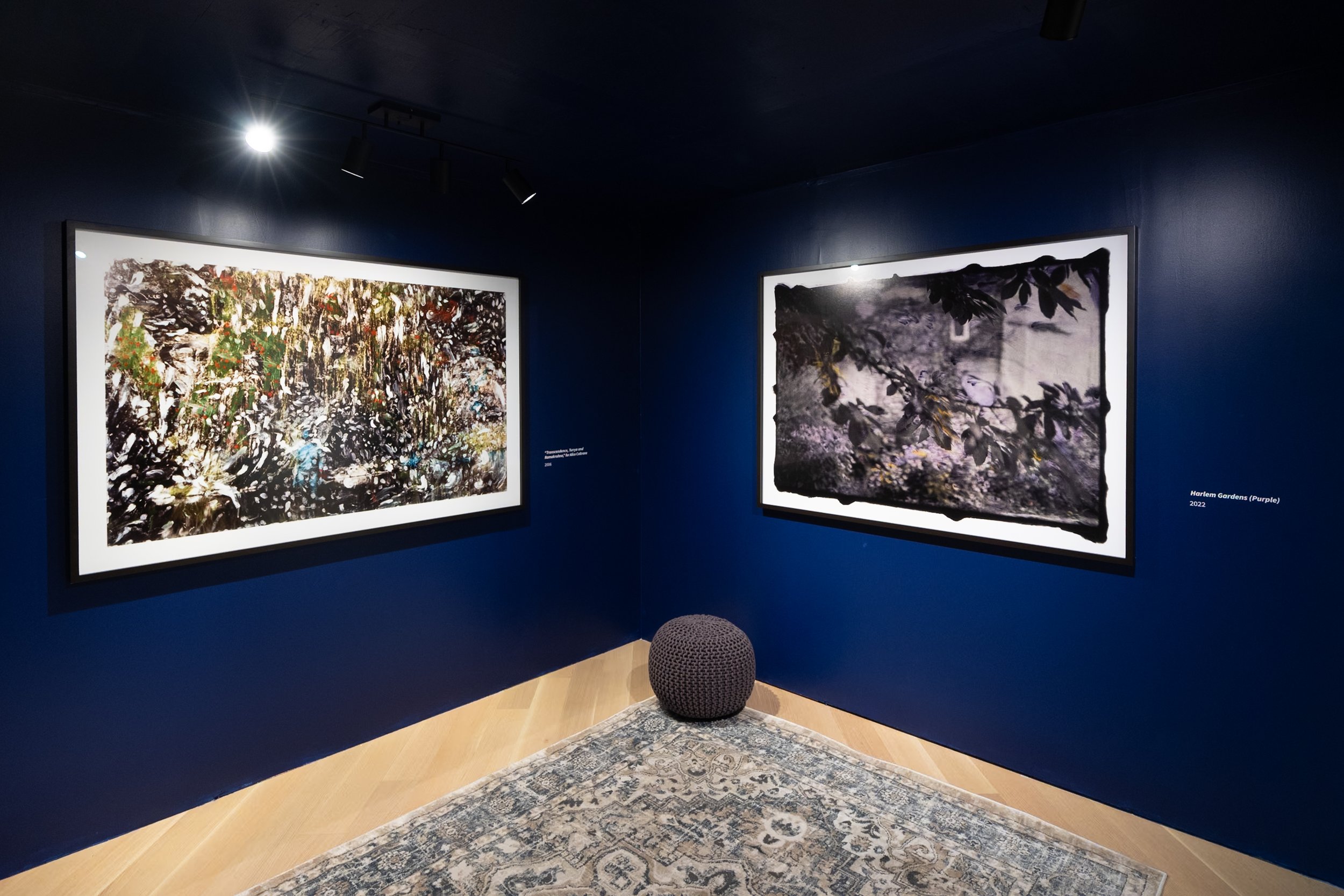
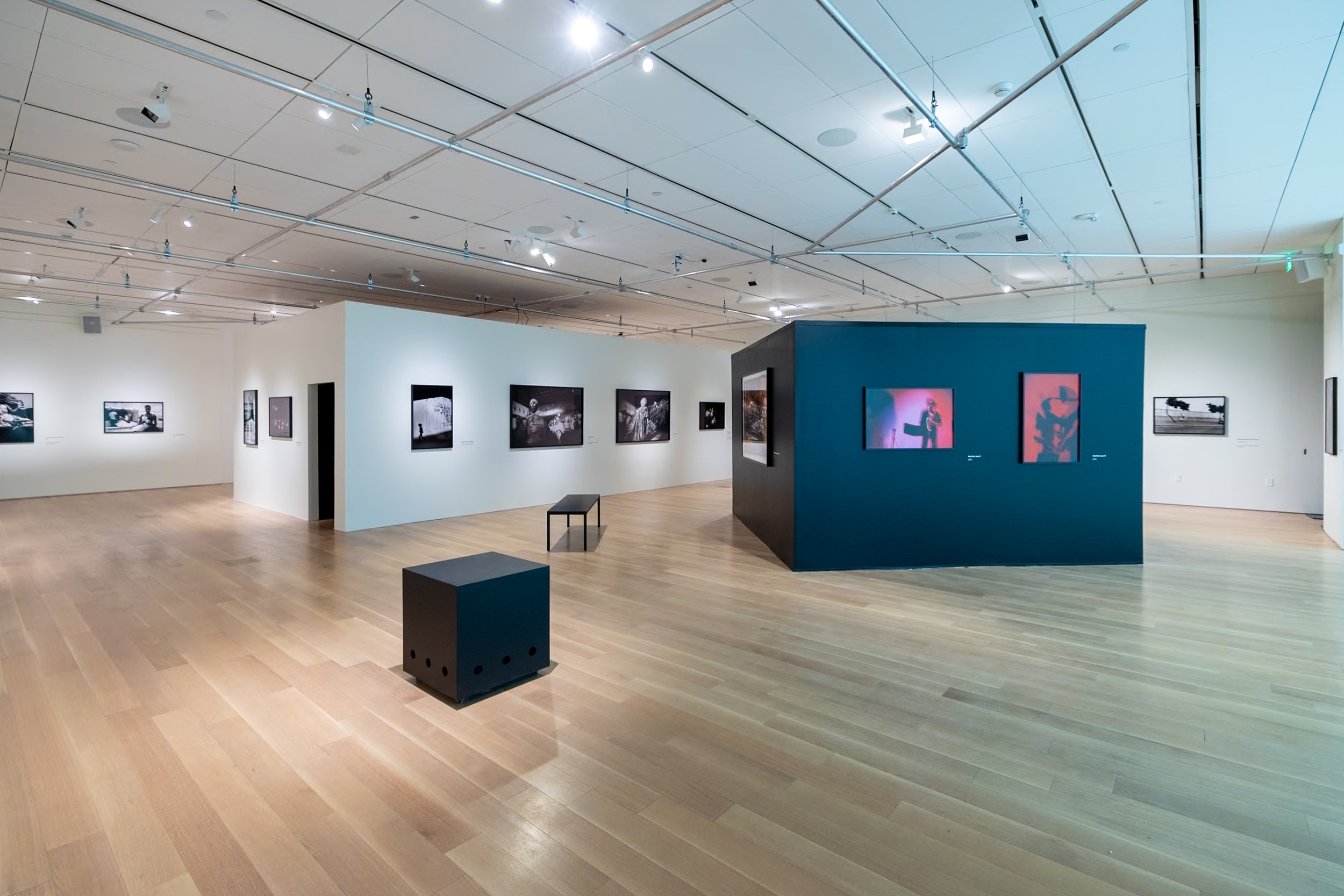
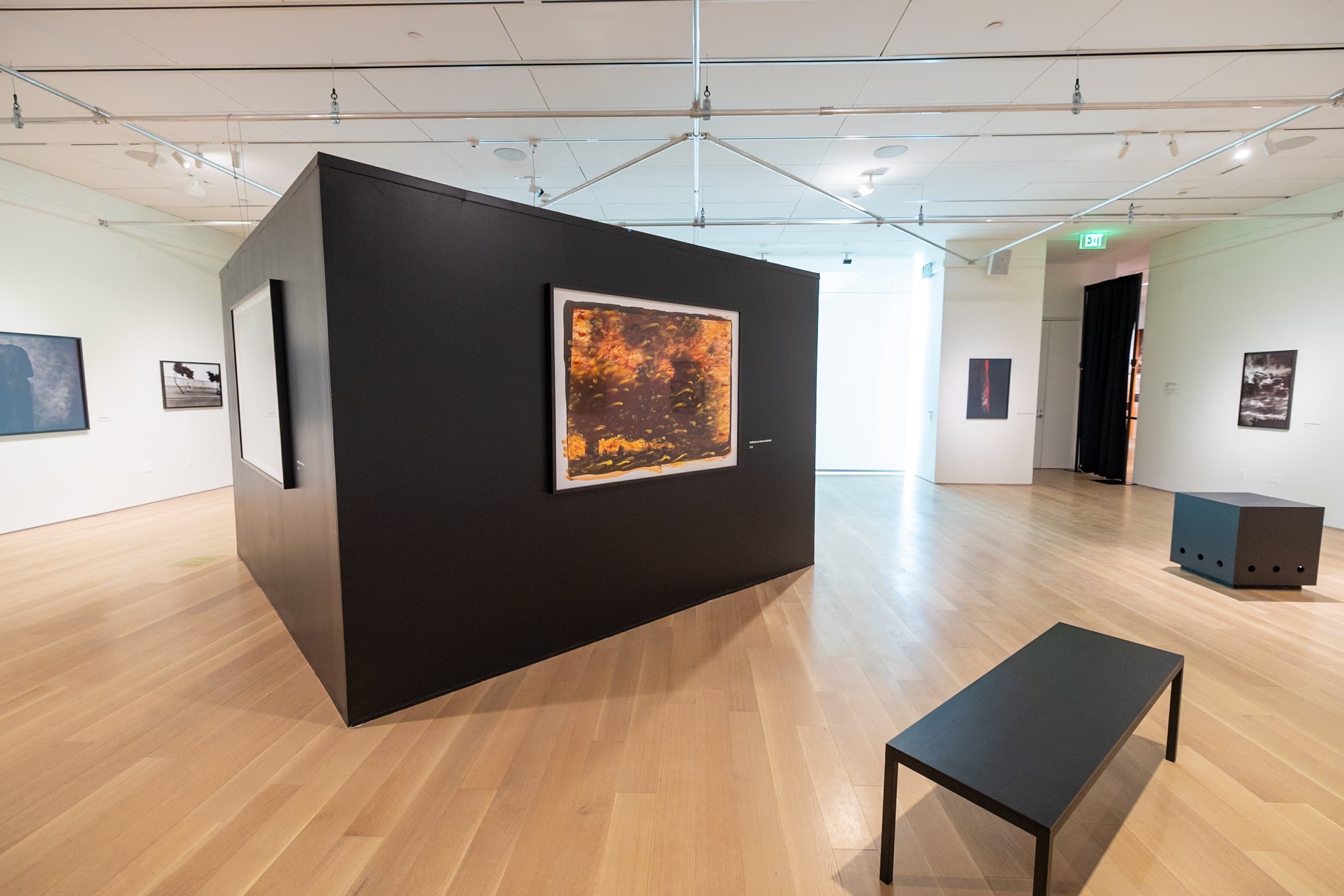
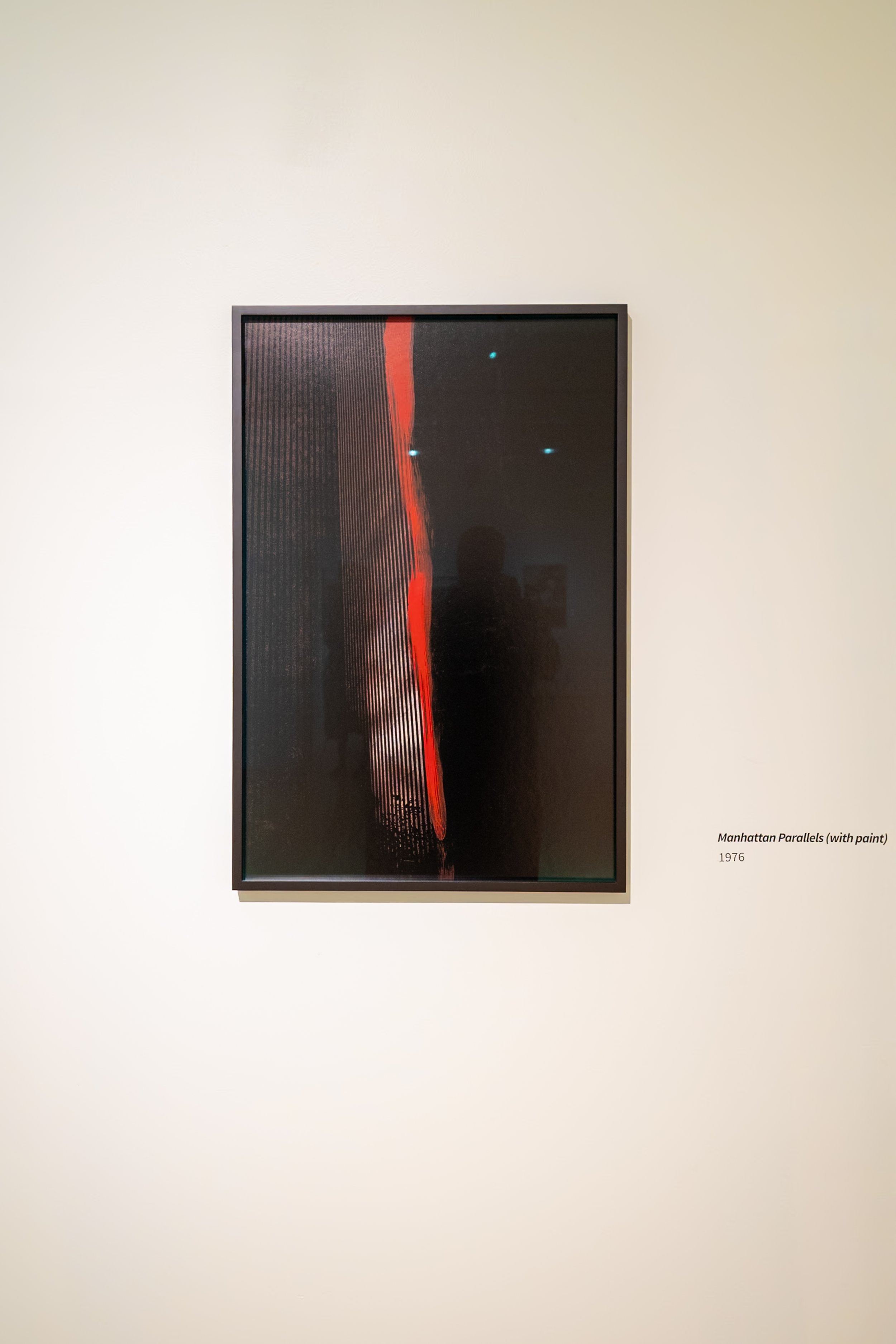
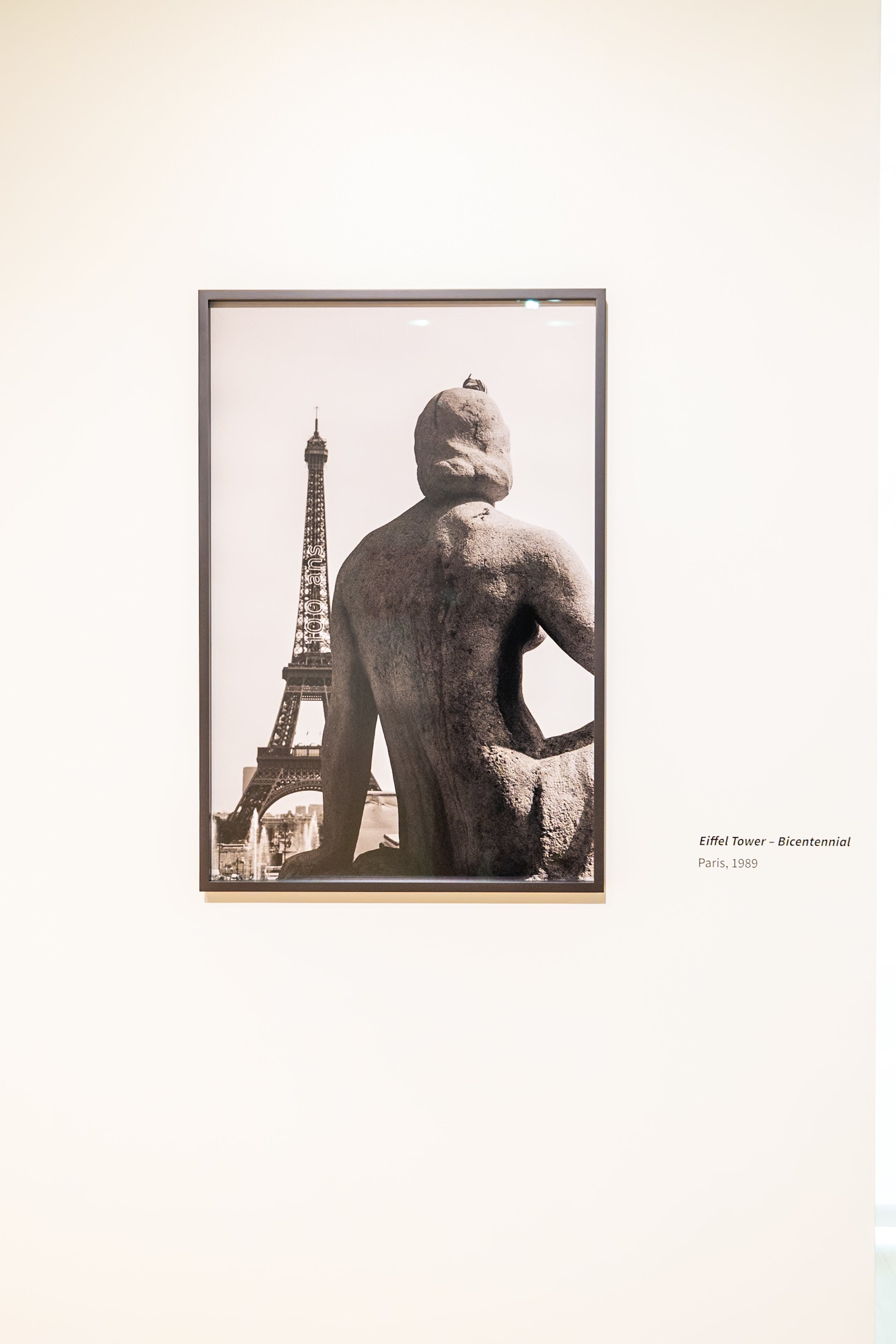
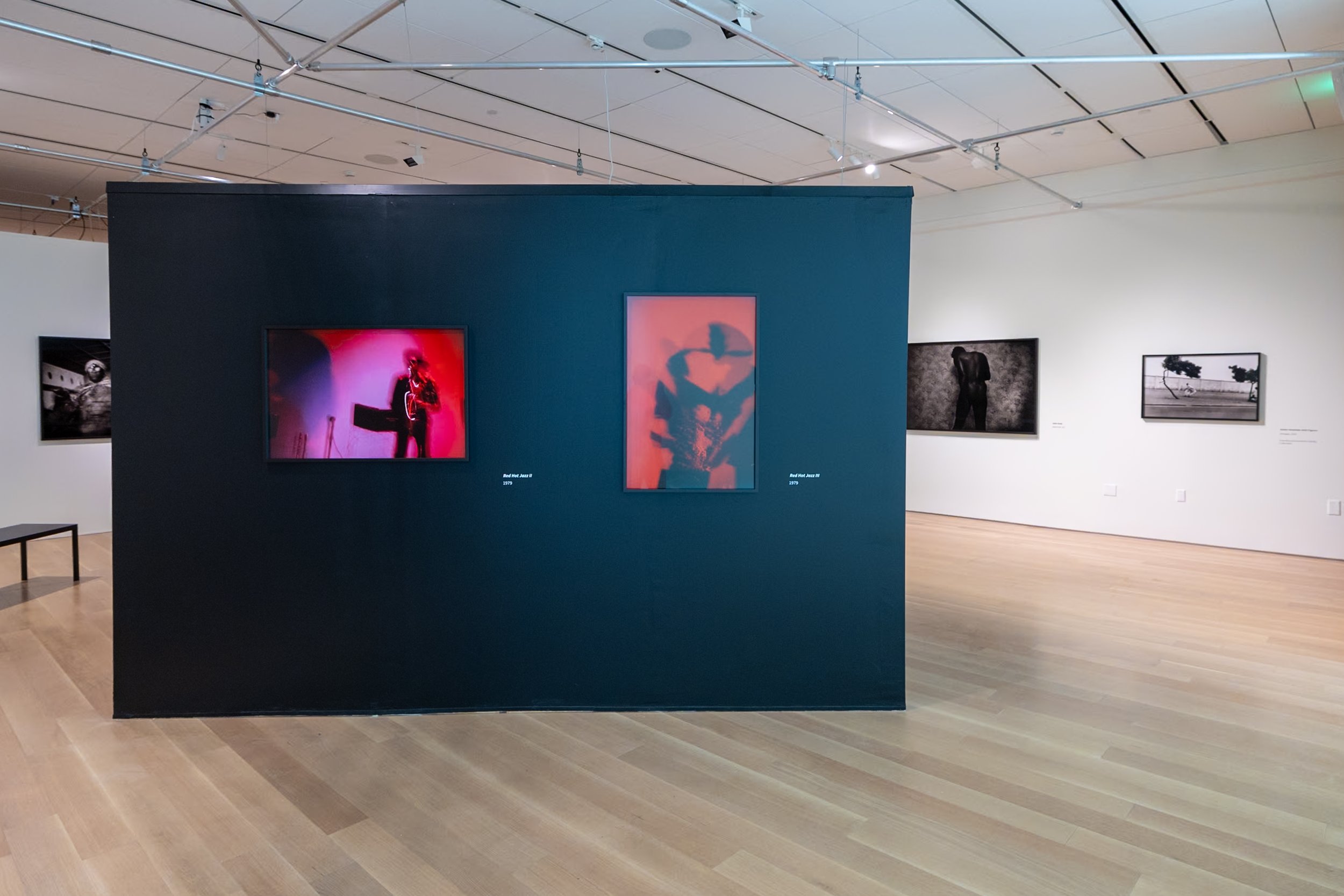
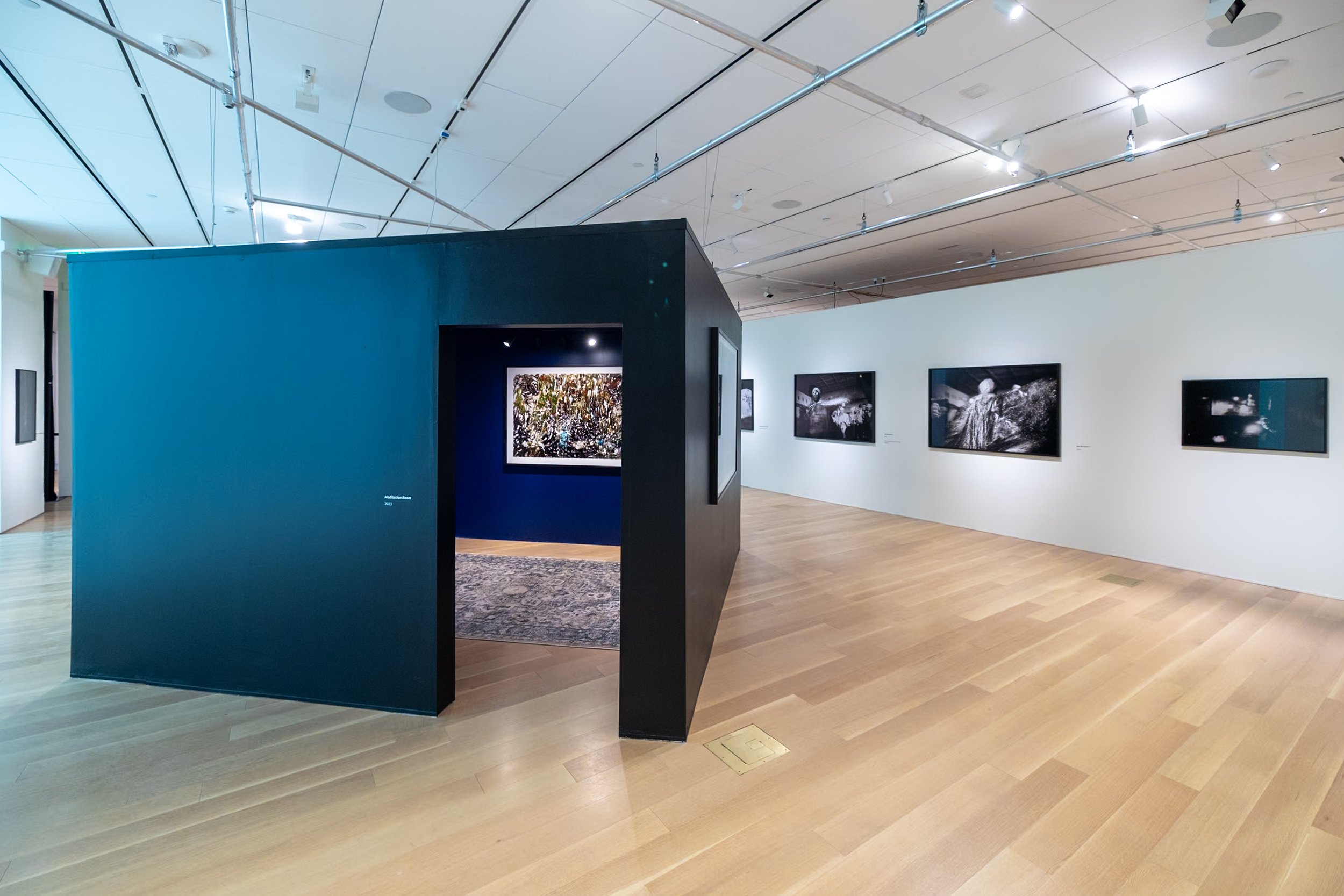
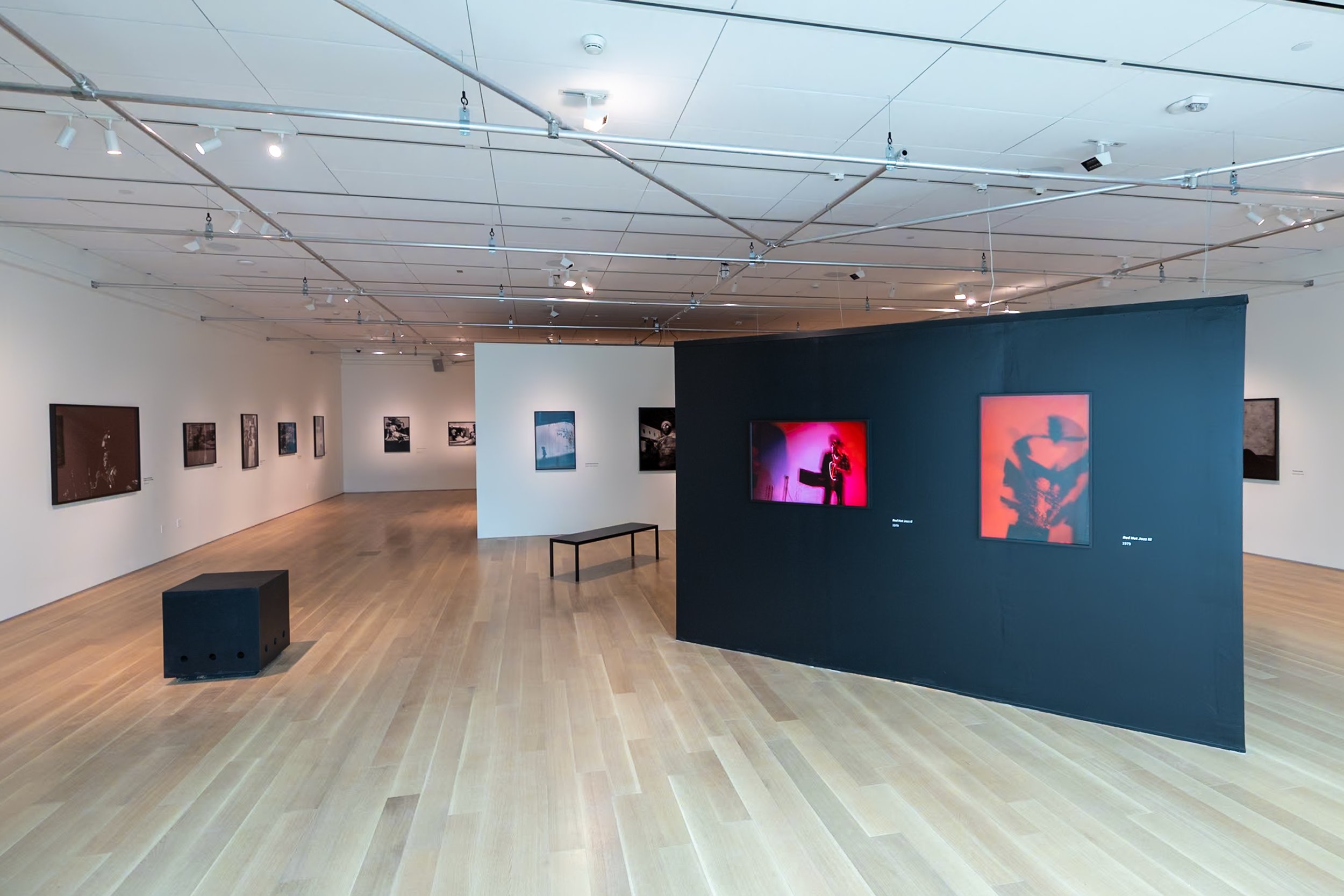
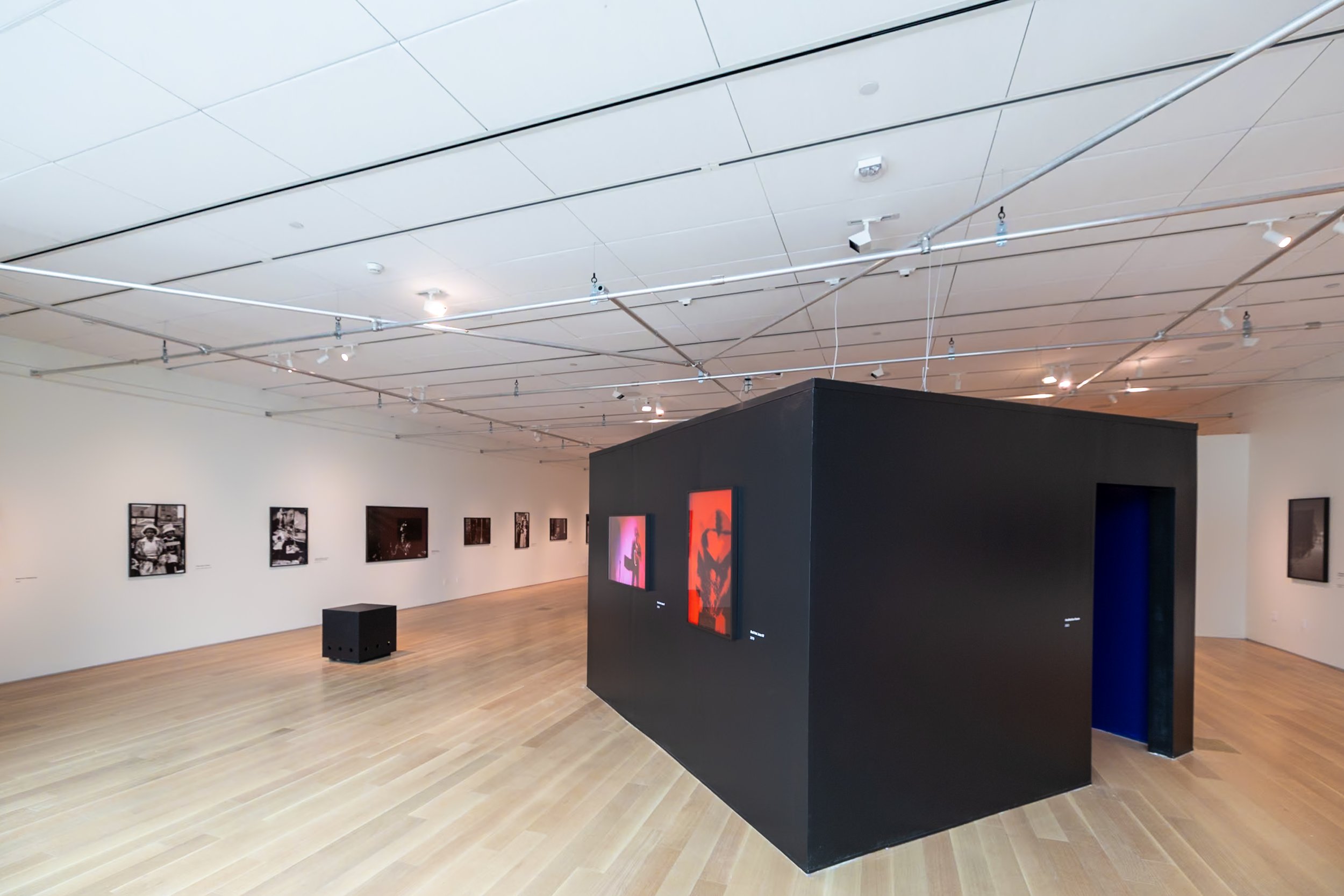
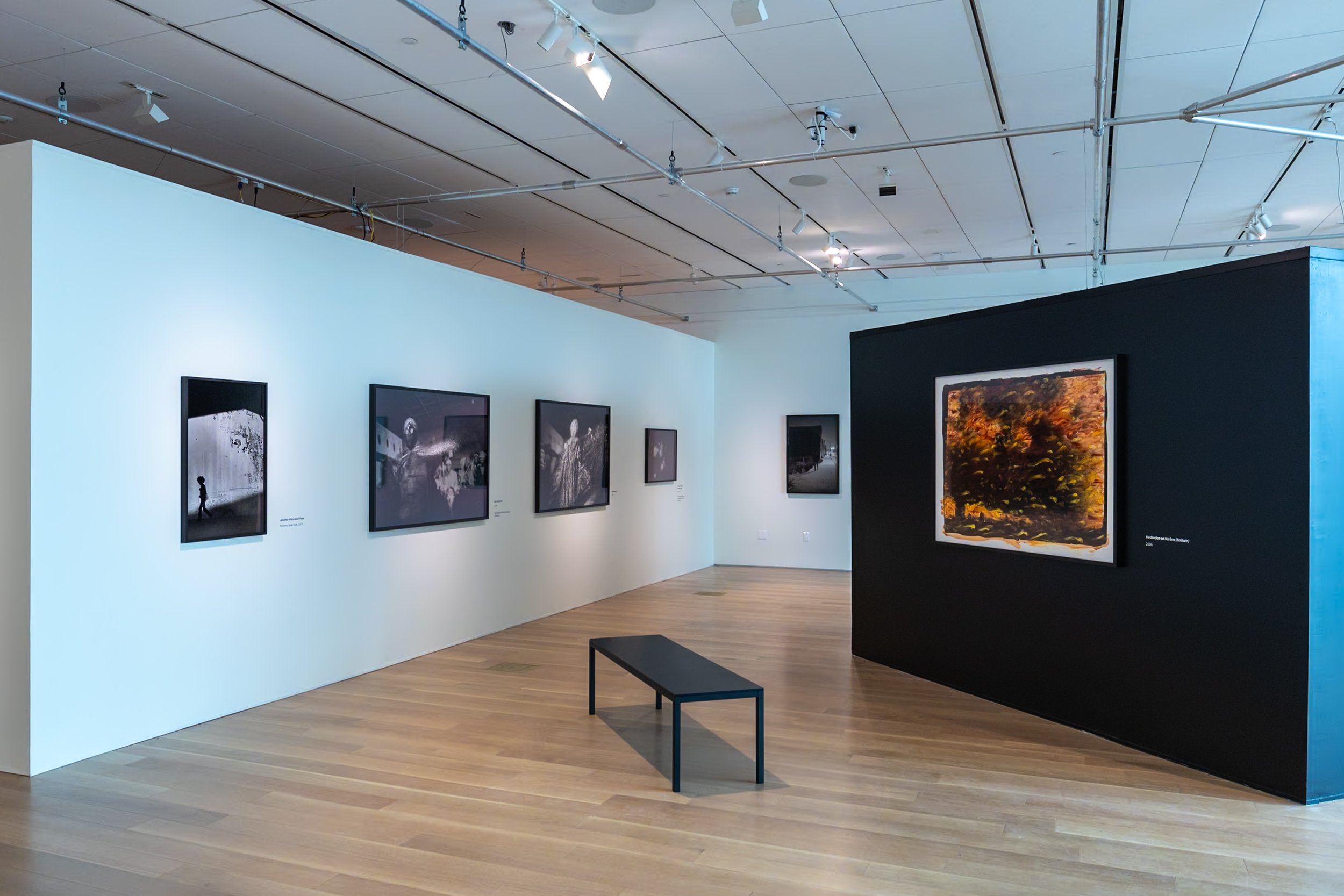
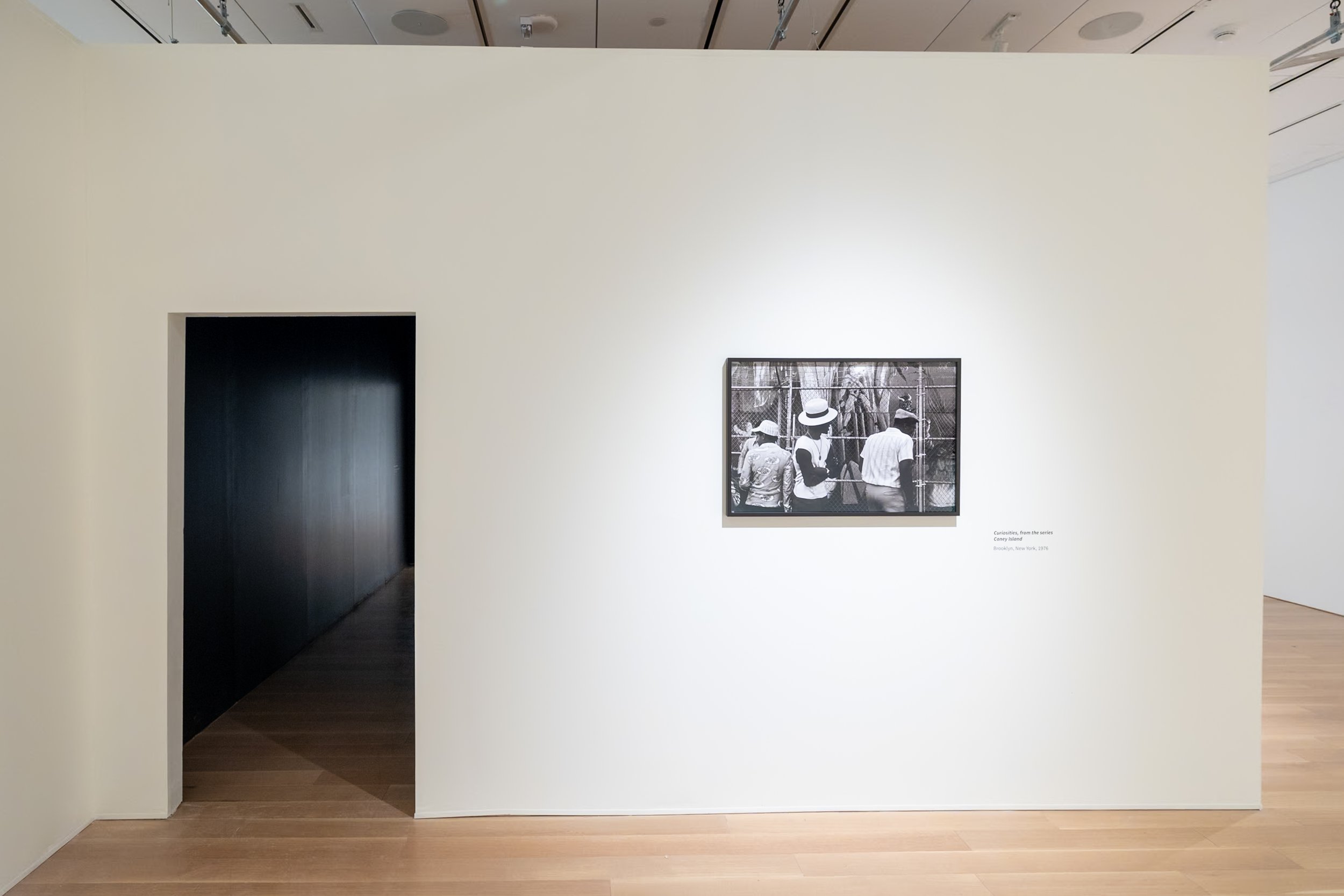
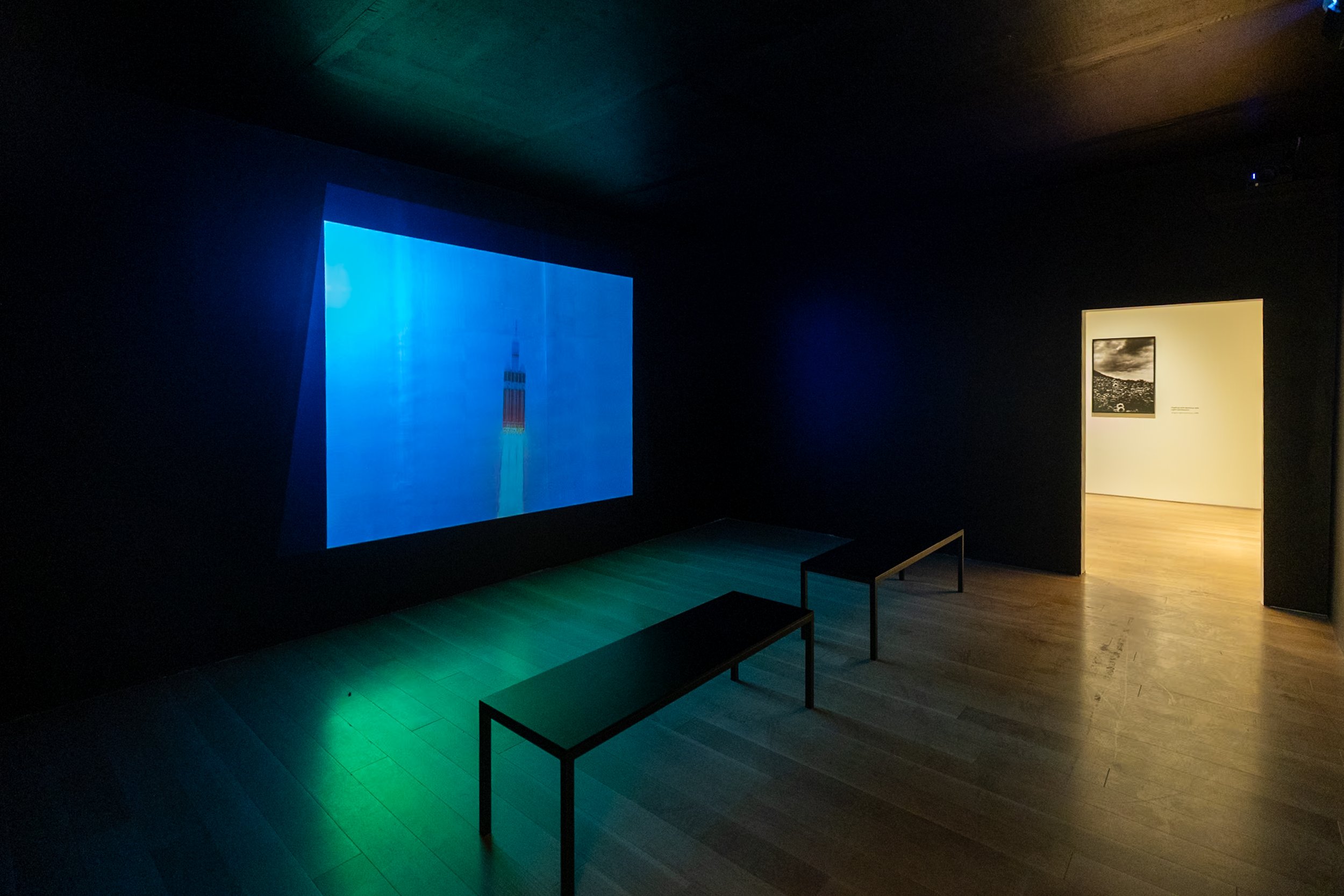
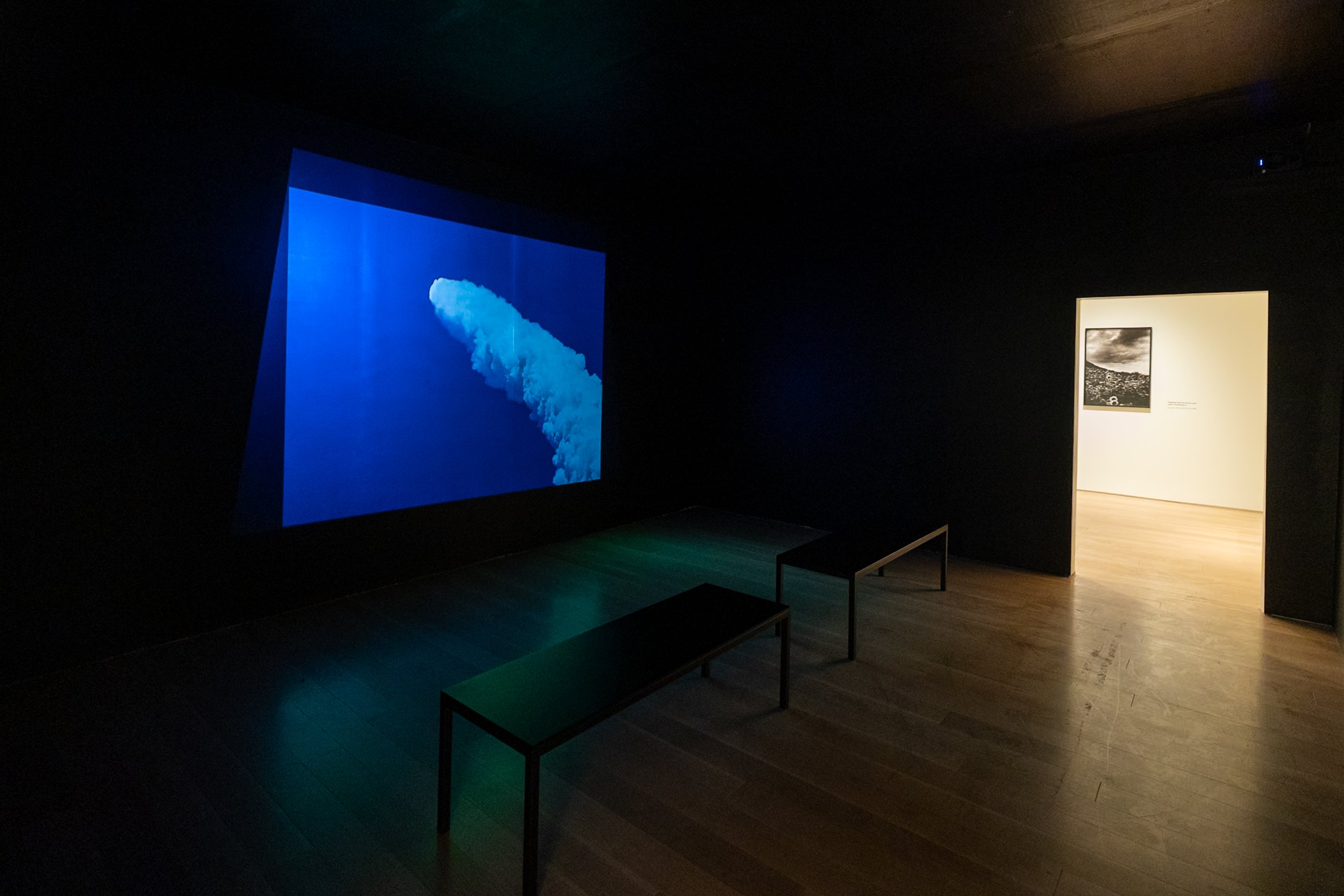
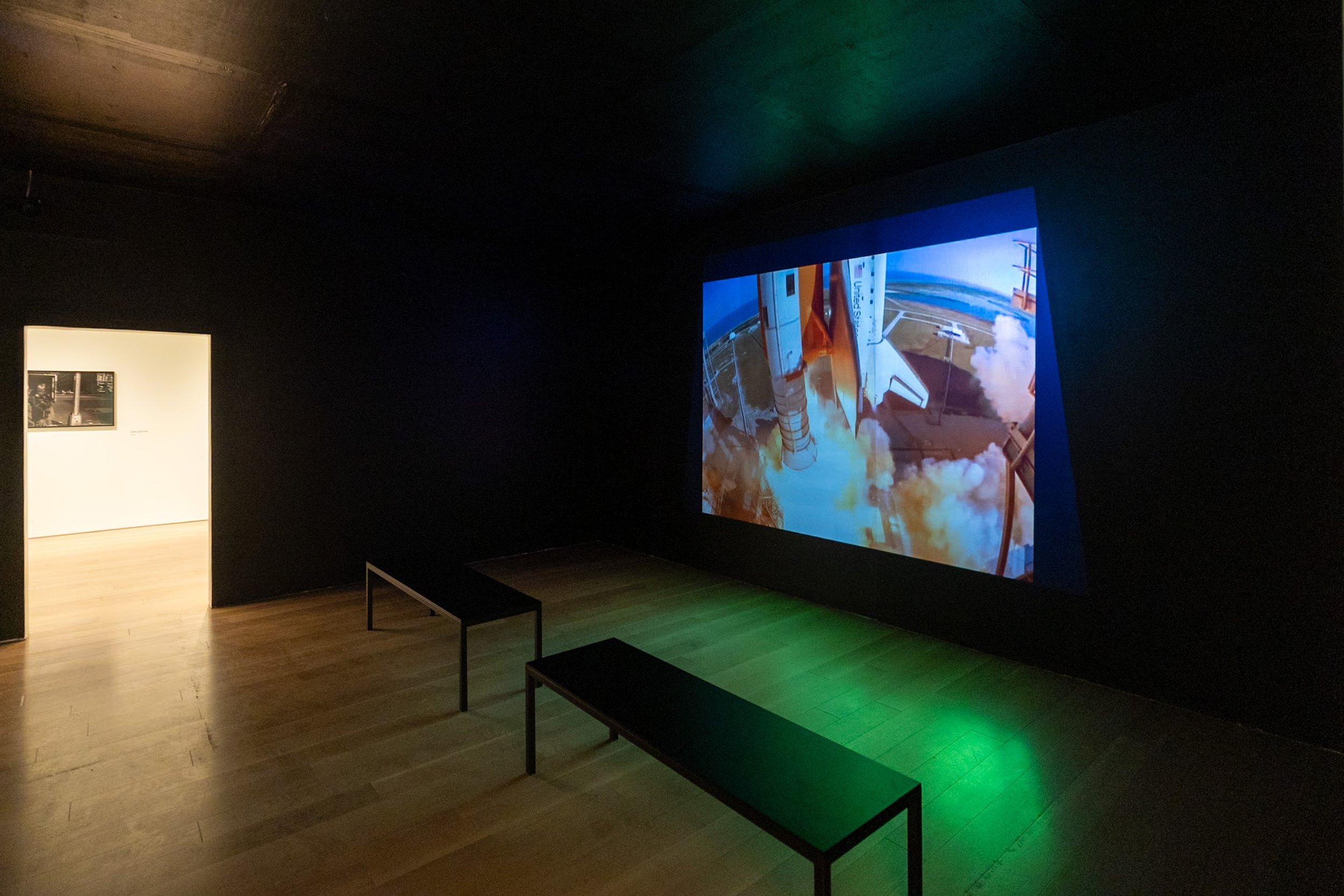
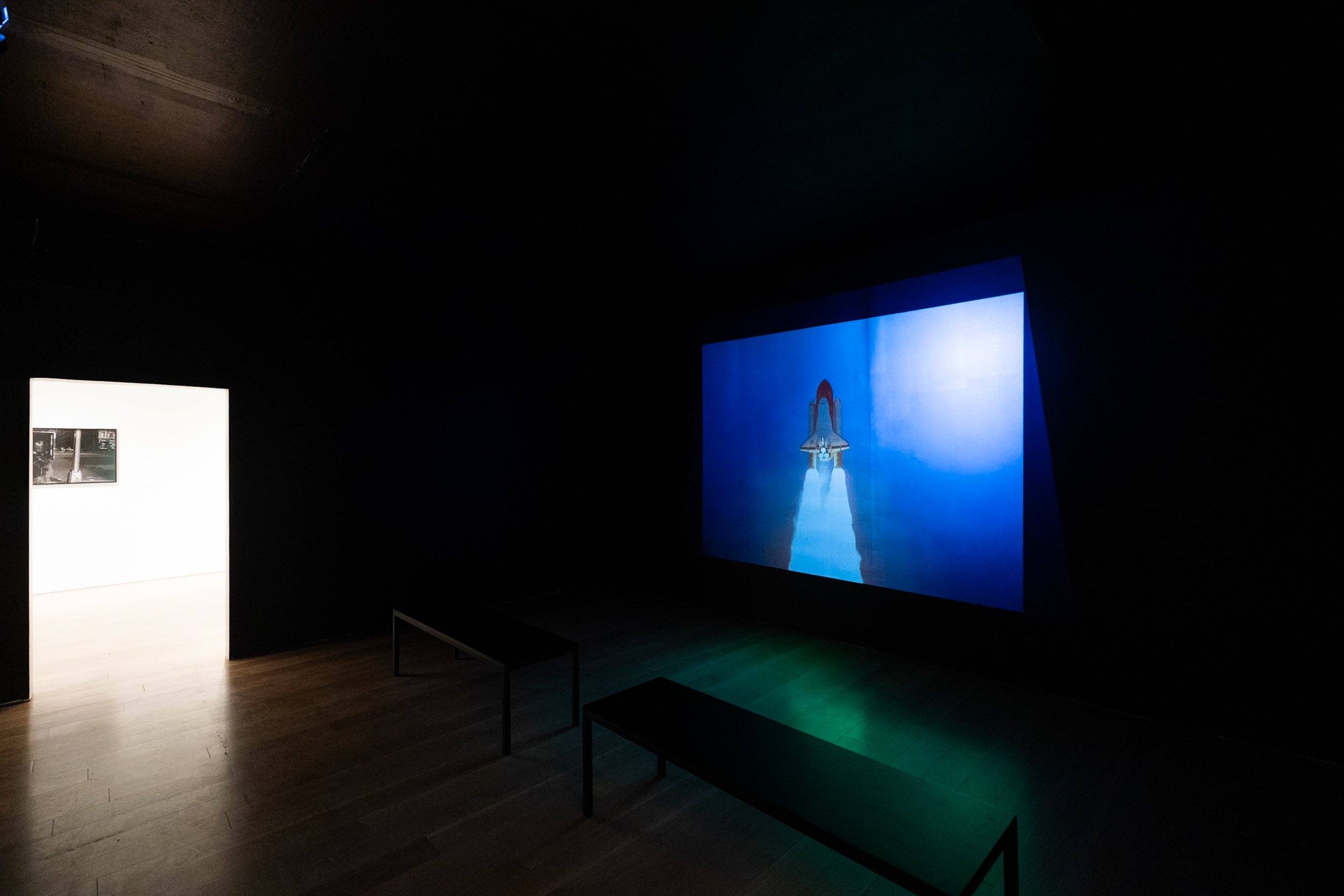
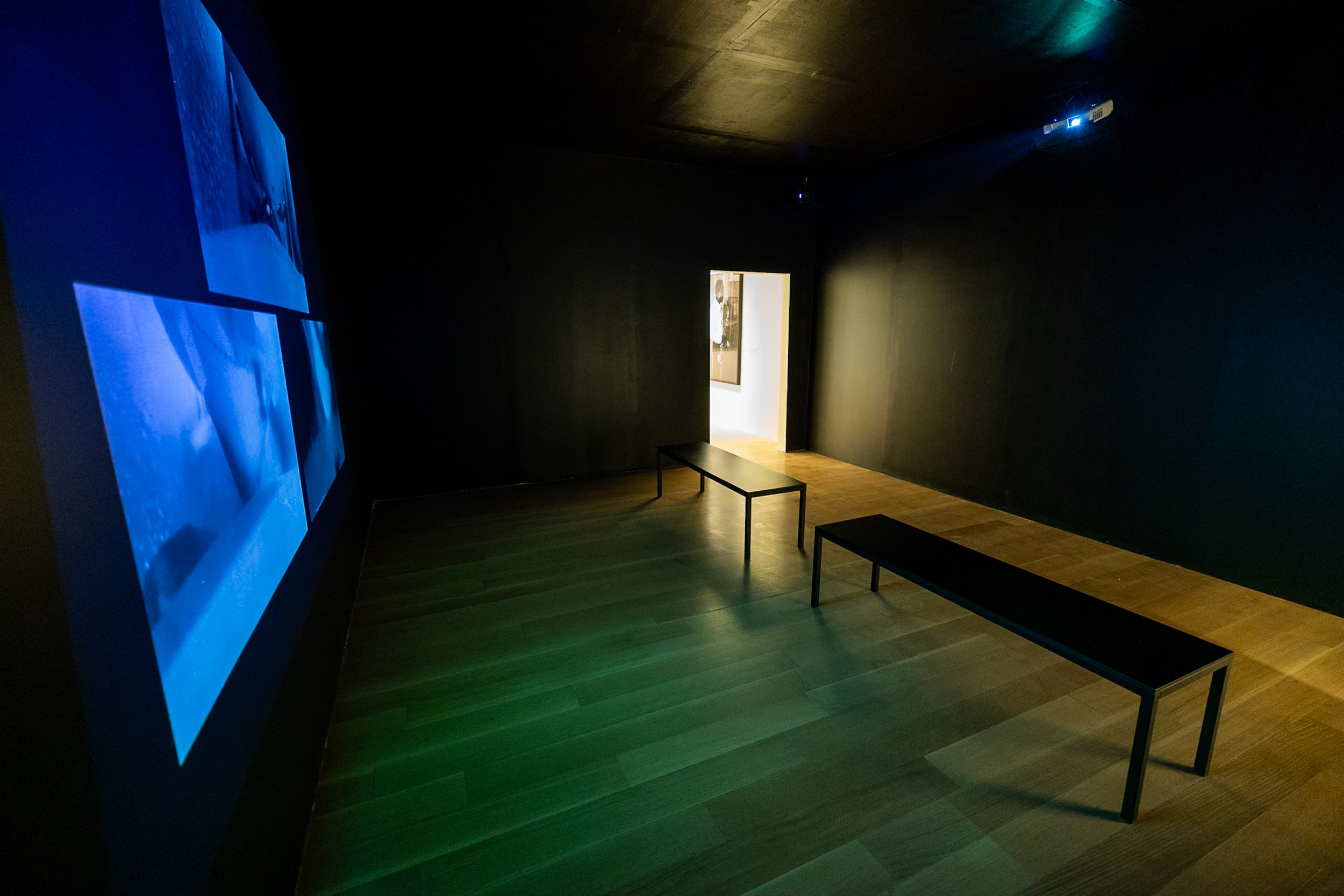
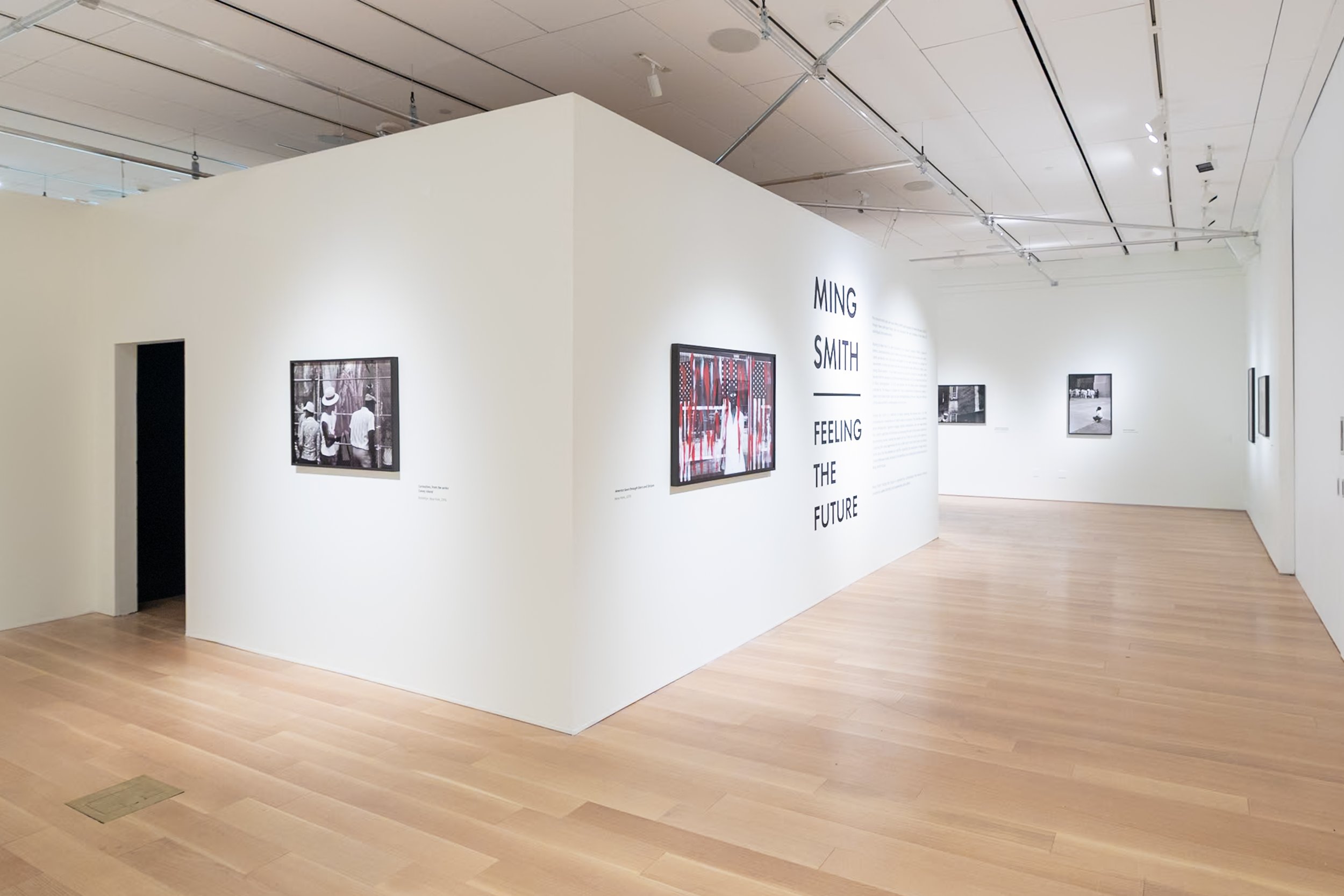
Installation view: Ming Smith: Feeling the Future January 31 through April 28, 2024. The International African American Museum (IAAM), Charleston, South Carolina. Courtesy of The International African American Museum (IAAM)
The International African American Museum (IAAM) explores the history, culture, and impact of the African American journey on Charleston, the nation, and the world, shining light and sharing stories of the diverse journeys, origins, and achievements of descendants of the African Diaspora. Across eleven galleries and a memorial garden with art, objects, artifacts, and multi-media interaction, IAAM is a champion of authentic, empathetic storytelling of American history. As a result, the museum will stand as one of the nation’s newest platforms for the disruption of institutionalized racism as it evolves today. The mission of IAAM is to honor the untold stories of the African American journey at the historically sacred site of Gadsden’s Wharf and beyond.
Installation view: Ming Smith: Feeling the Future January 31 through April 28, 2024. The International African American Museum (IAAM), Charleston, South Carolina. Courtesy of The International African American Museum (IAAM)
Editor's Note: The attached photos include a current picture of Ming Smith photographed by Chanell Stone, courtesy of Aperture, as well as Amen Corner Sisters and Chicago Art Ensemble by Ming Smith, courtesy of IAAM.
Please visit the International African American Museum's website here for more information about its current and future exhibitions.
ATUL DODIYA 'I KNOW YOU. I DO. O' STRANGER'
Toutes les images / All images :© Courtesy de l’artiste et TEMPLON,Paris —Brussels — New York
Painter Atul Dodiya, regarded as one of the greatest Indian artists of his generation, is showing in Paris a new series of canvases inspired by Bollywood classics.
In the early 1990s, while studying at the famous Sir J.J. School of Art in Mumbai, Atul Dodiya spent a year at the Paris École des Beaux Arts. The experience proved decisive in the career of an artist who has been building bridges between the history of Indian and Western art ever since. Passionate about literature and film, he uses a unique language, fluctuating between the figurative and the abstract, where he incorporates references to popular culture, poetry and modern art masters, from Matisse to Motherwell, Picabia to Mondrian. Atul Dodiya possesses an astonishing capacity to reinvent himself and his style, equally happy to draw on photorealism or symbolism. He paints on metal roller shutters, creates photographic assemblages and devises largescale installations combining object and painting. Embedded in his works is a reflection on the history of India and emergence of new political aspirations.
Toutes les images / All images :© Courtesy de l’artiste et TEMPLON,Paris —Brussels — New York
The exhibition's entry point is the Mumbai movie world of the 1960s that marked the artist's childhood. The title “I know you. I do. O’ stranger” is inspired by the film Charulata (1964) by Satyajit Ray. The deceptively ordinary chosen scenes are the fruit of complex compositions where the actor's fame takes a back seat to anonymity. “A recurring theme in my cinematographic stories,” explains the artist, “the characters encounter each other just like strangers.”
Toutes les images / All images :© Courtesy de l’artiste et TEMPLON,Paris —Brussels — New York
Liberated from all narrative context, their mysterious beauty is revealed, leaving the viewer free to interpret their meaning. In the manner of a filmmaker, Atul Dodiya directs our gaze through space, from one canvas to the next.
Certain fragments of a roll of film seemingly pay tribute to the technical feats of cinema. Others highlight the emergence of a new consumer society, with hand-crafted movie sets becoming, in the hands of artist, some sophisticated furnishings and interiors.
Toutes les images / All images :© Courtesy de l’artiste et TEMPLON,Paris —Brussels — New York
The outward appearance of an economy of means conceals a demanding and meticulous painting technique. Atul Dodiya transforms freeze frame photographs in a preliminary monochrome print. Projected onto the canvas, he goes over the scene in black and white until chiaroscuro transcends movement. He completes the image's metamorphosis by covering it in translucent oil paint, swapping the vibrant palette favoured by Bollywood films for a pastel, almost ephemeral, colour range. This transformation of the image as it is filmed, photographed, illuminated and colourised becomes a metaphor for the impact of modernity and globalisation on perception and traditions. “In this very personal selection of moments frozen in time,” he continues, “the unreal becomes a new story, another truth.”
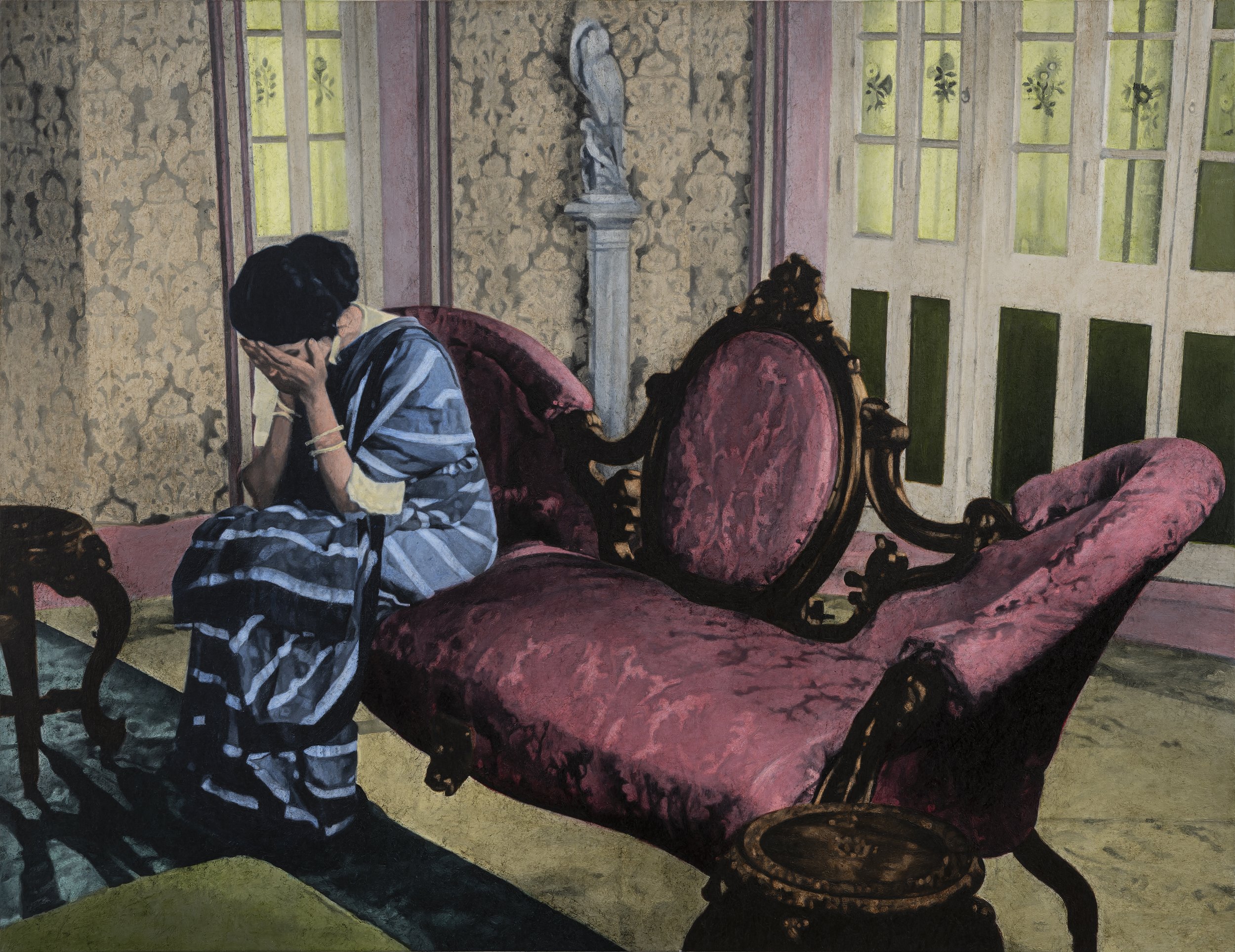

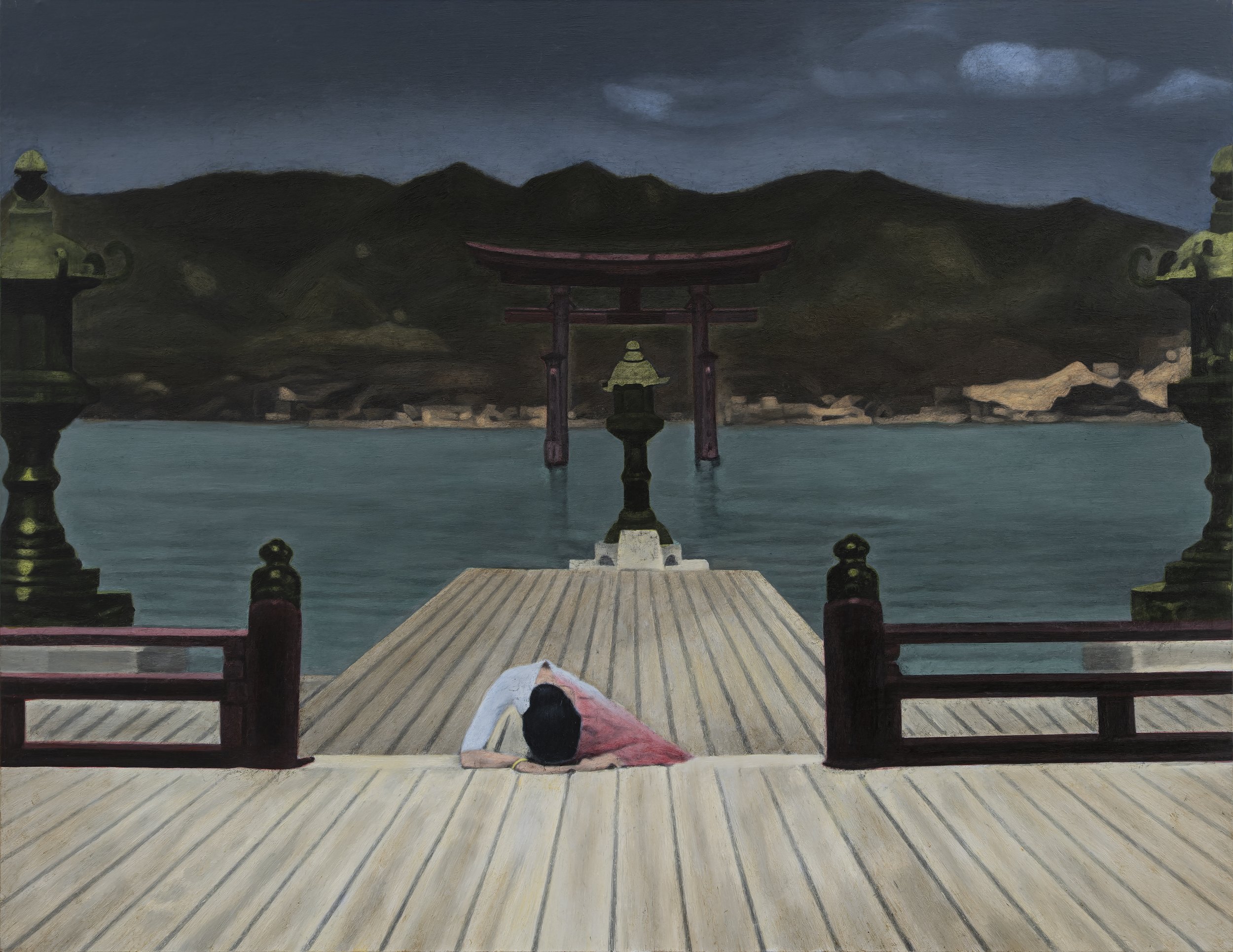
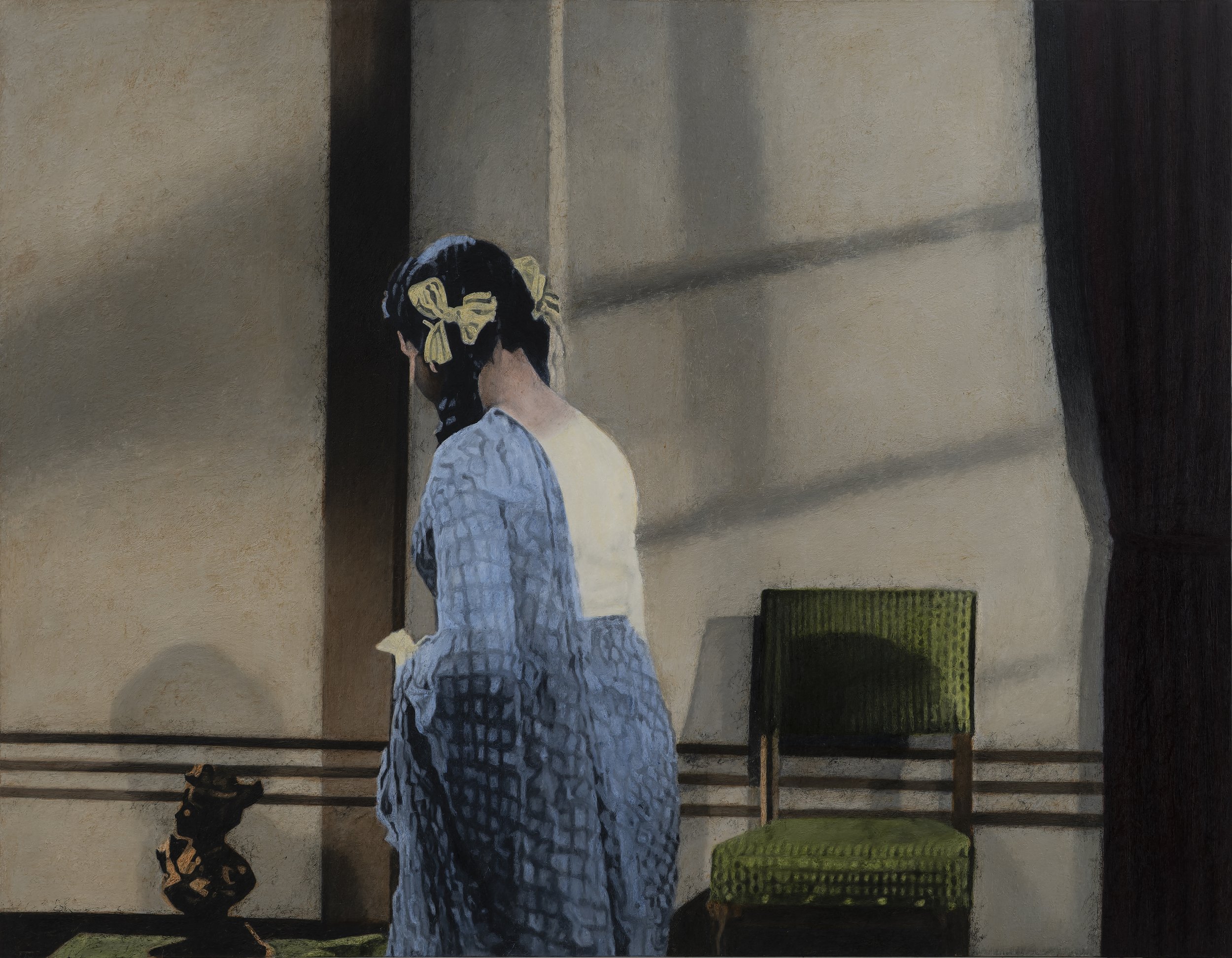
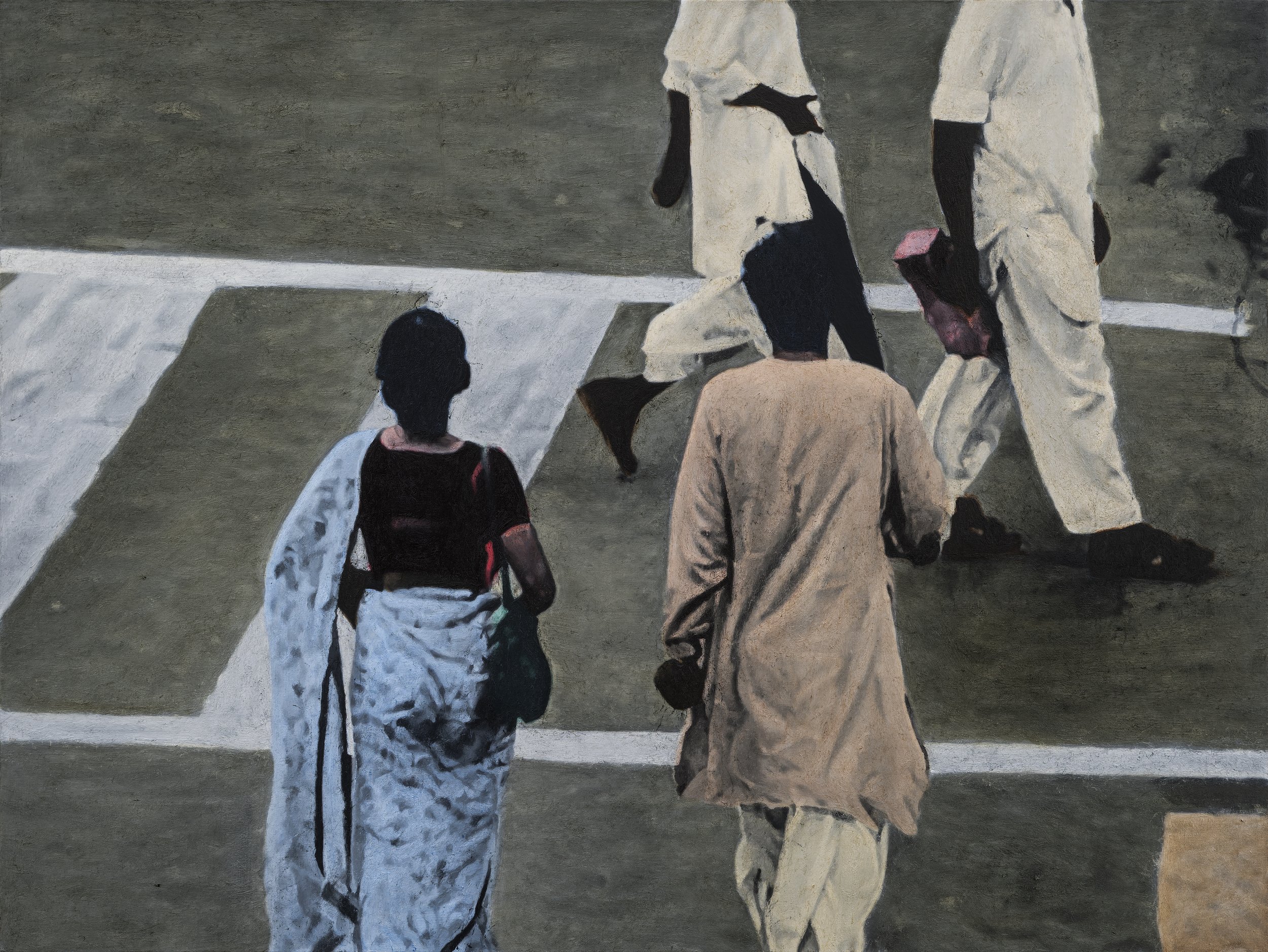
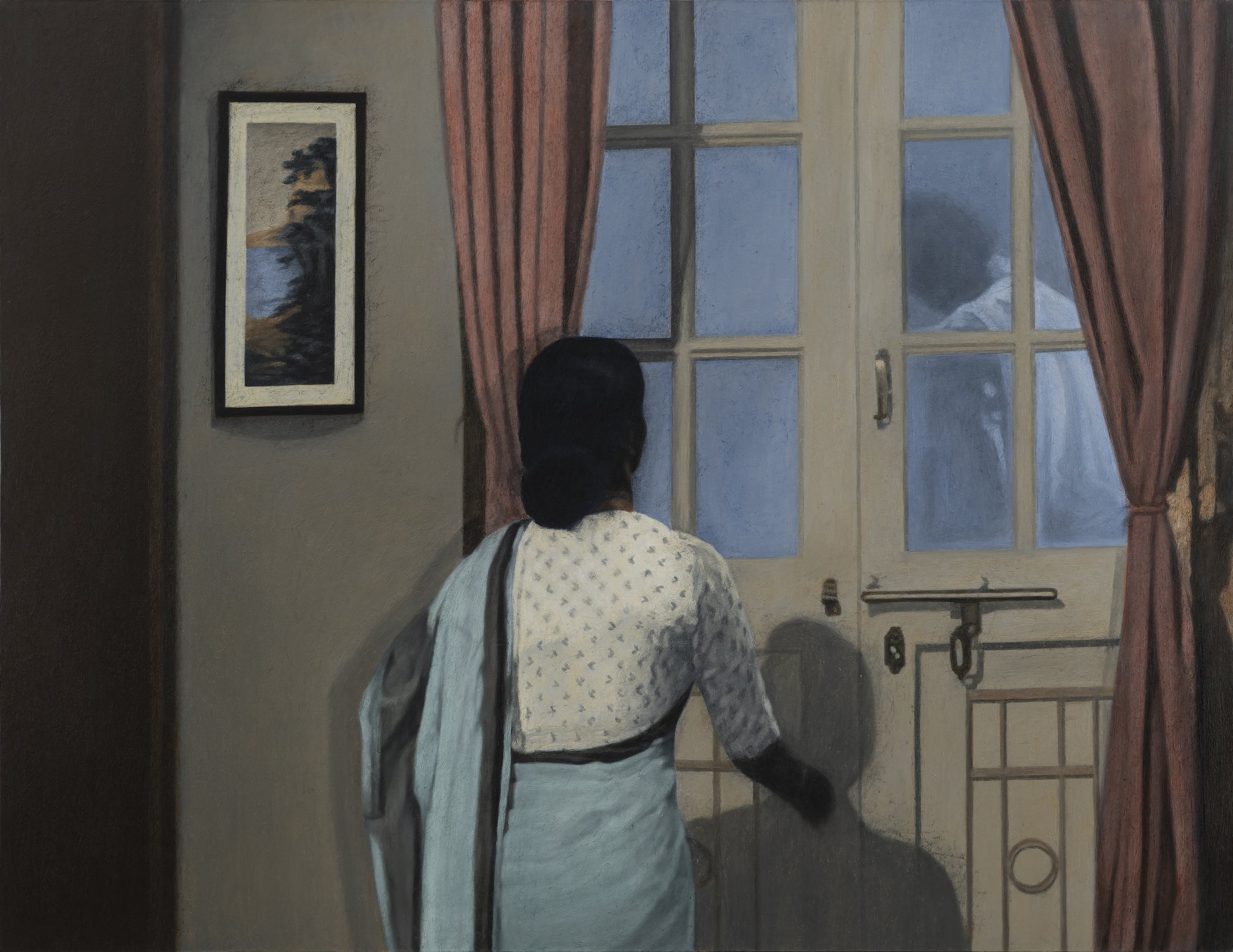

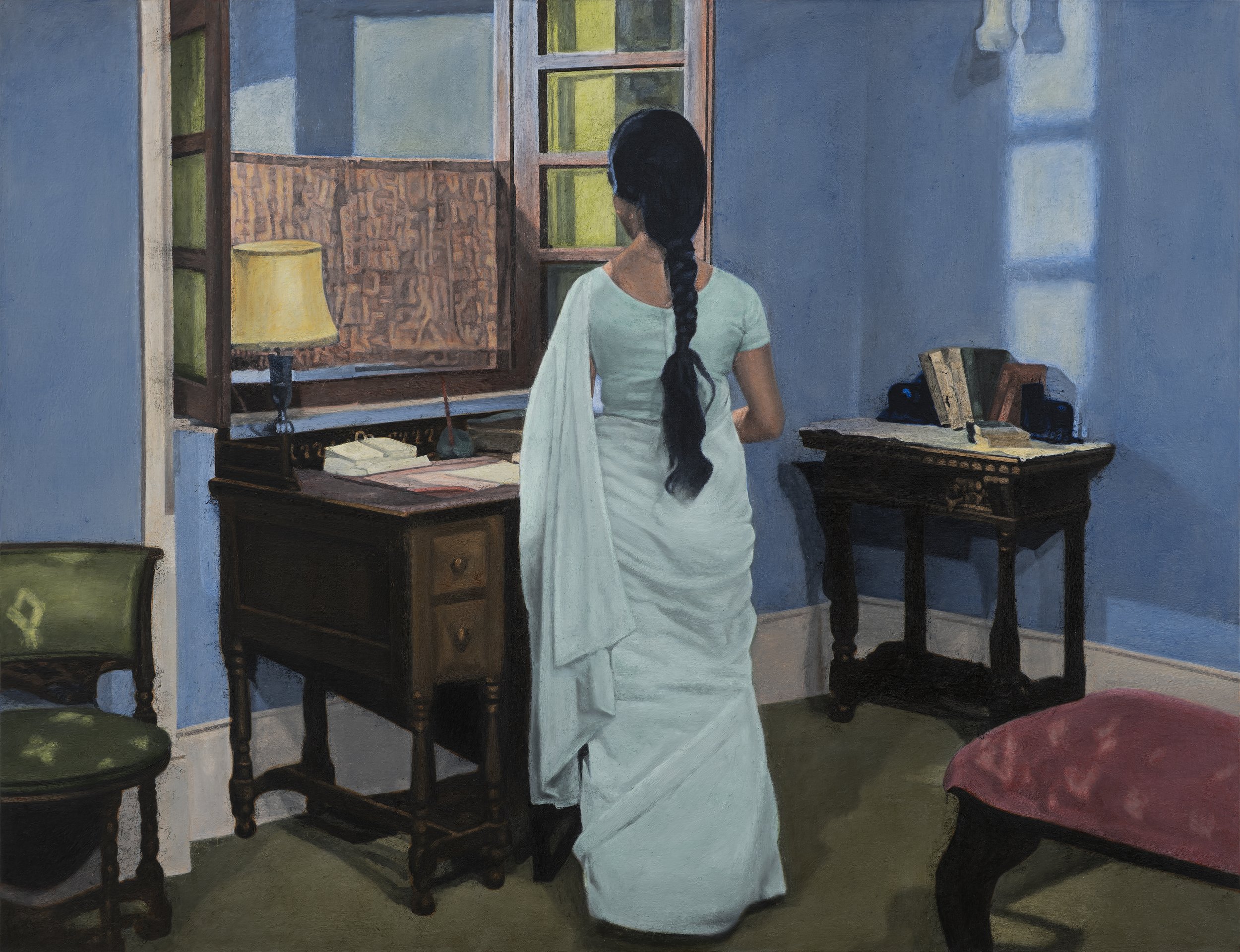
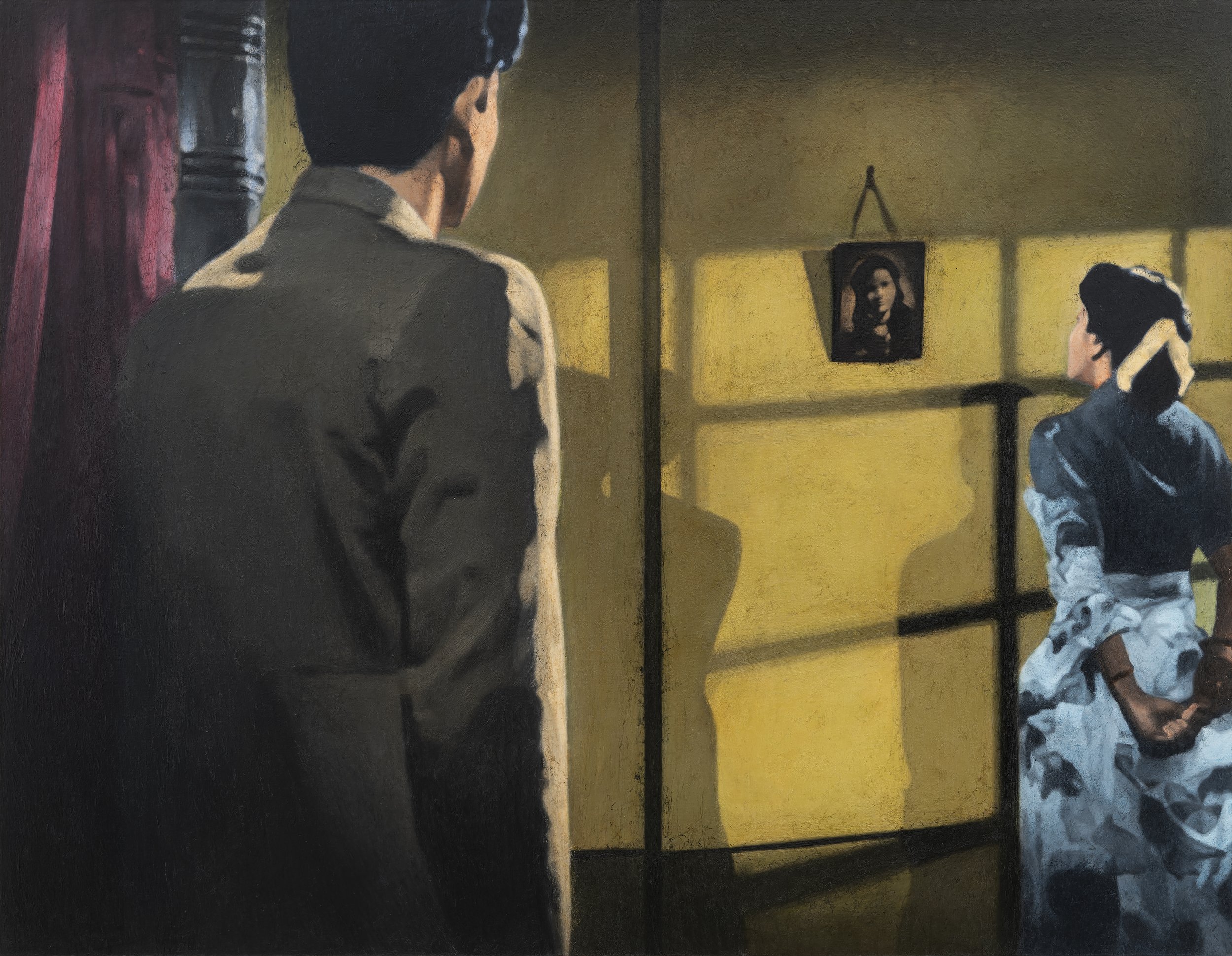


Toutes les images / All images :© Courtesy de l’artiste et TEMPLON,Paris —Brussels — New York
Atul Dodiya was born in 1959 in Mumbai where he lives and works. His work features in the collections of a host of international museums, including the Mnam-Centre Pompidou in Paris, Tate Modern in London and Philadelphia Museum of Art. He has taken part in most major exhibitions of Indian art held in the USA, Europe and Asia over the last twenty years: Atul Dodiya, Detroit Institute of Arts Museum, Detroit, USA (2020), After Midnight: Indian Modernism to Contemporary India at Queens Museum in New York (2015), India: Art Now at the ARKEN Museum of Modern Art in Denmark (2012), La Route de la soie at Tri Postal in Lille and Paris Delhi Bombay at the Centre Pompidou (2011), Inside India at Palazzo Saluzzo Paesana Turin and The Empire Strikes Back at the Saatchi Gallery in London (2010), and Indian Summer at the École des Beaux Arts in Paris (2000). He also participated in Documenta 12 in Kassel (curated by Roger Buergel) in 2007, the Gwangju Biennale (curated by Okwui Enwezor) in 2008, Moscow Biennale (curated by Jean-Hubert Martin) in 2009, Kochi-Muziris Biennale in 2012, and 7th Asia Pacific Triennial of Contemporary Art (APT7) in Brisbane in 2012.
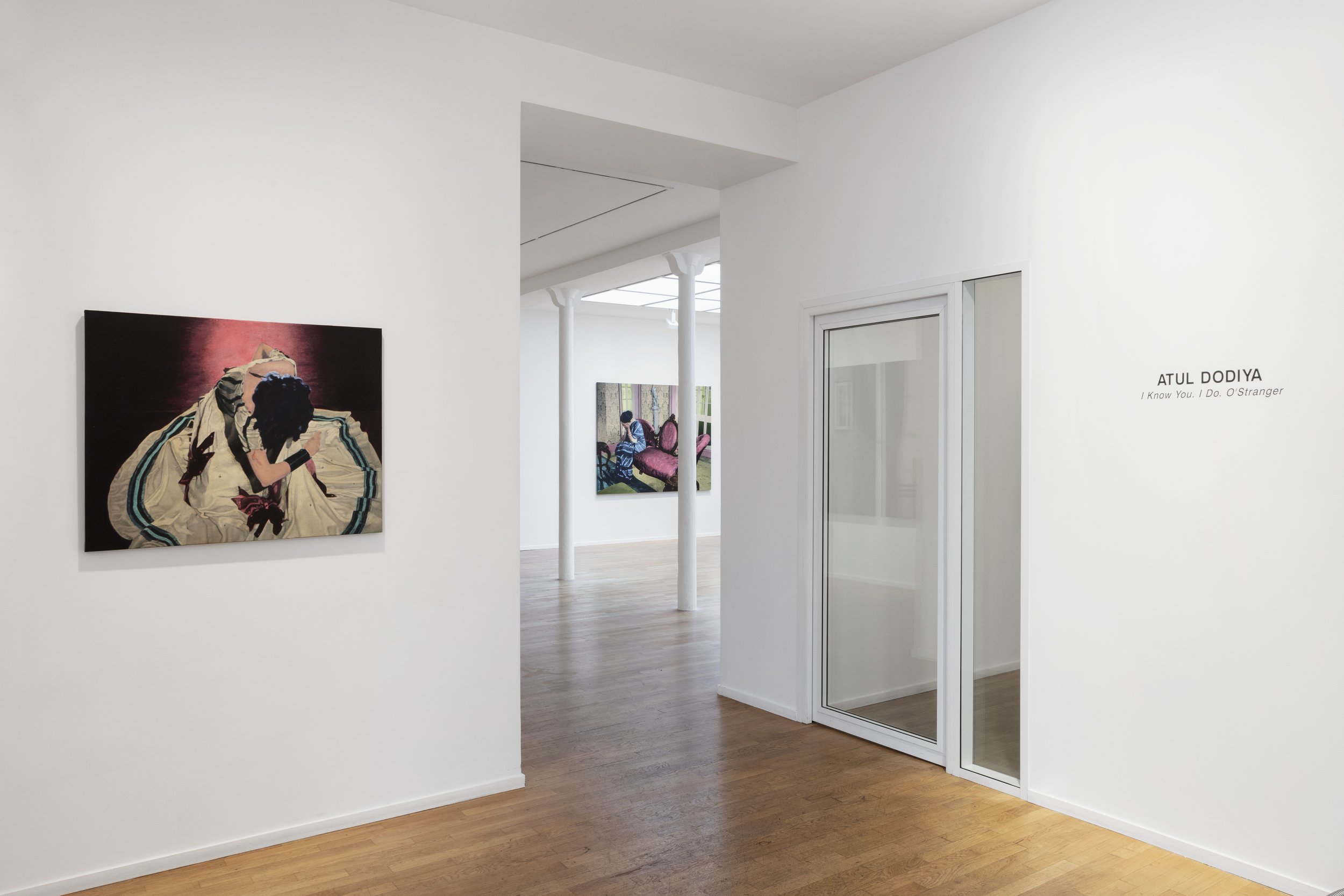
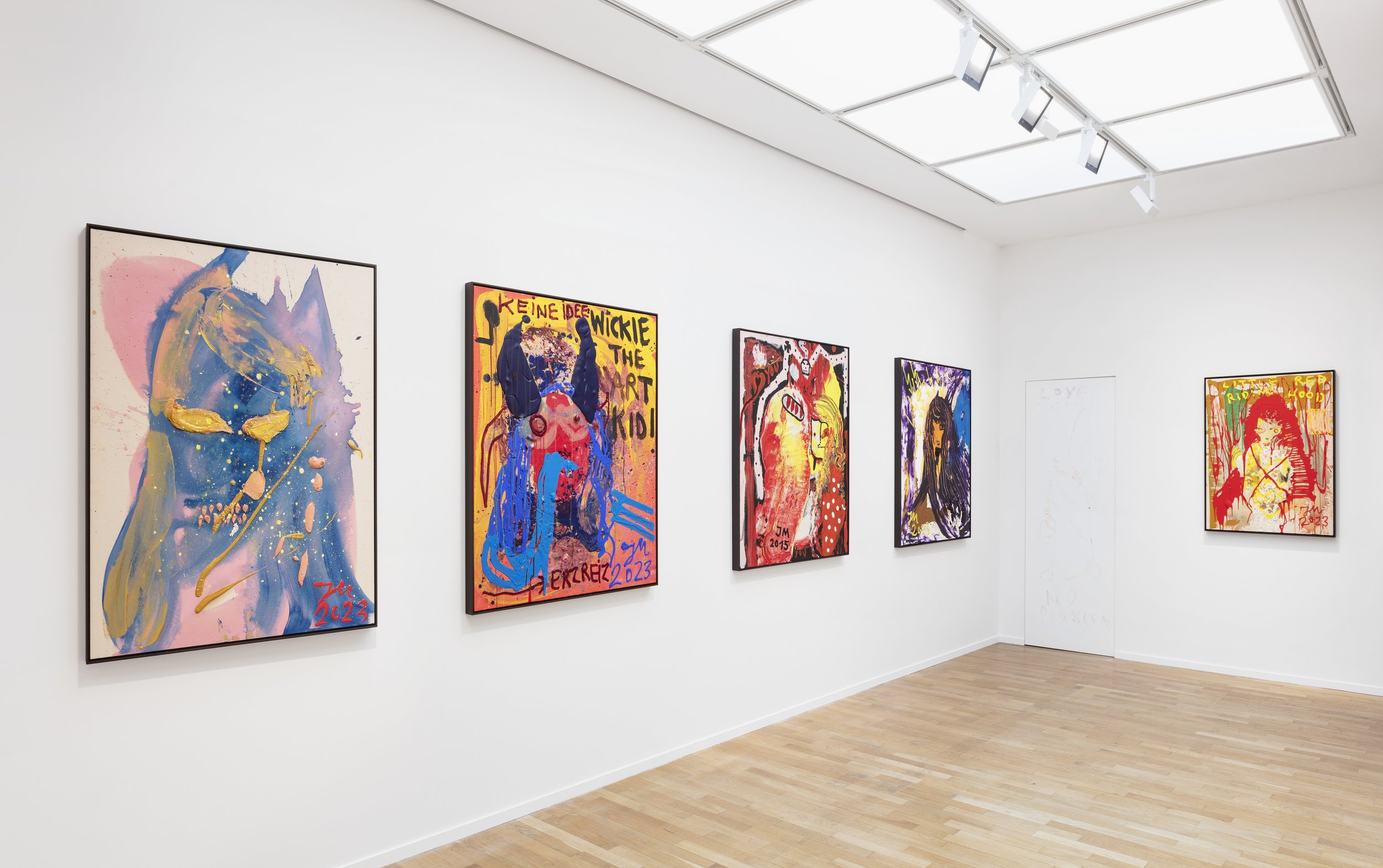
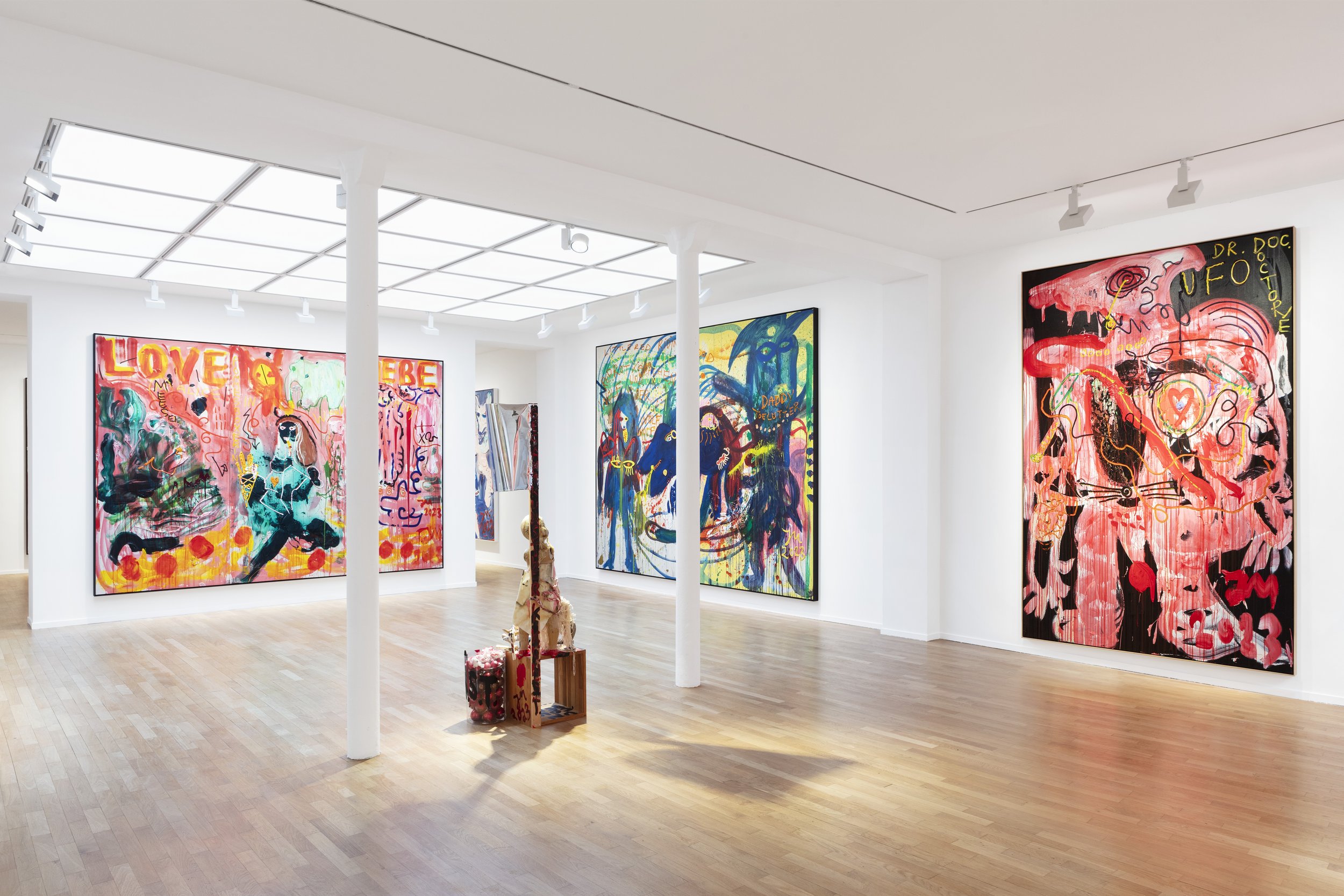
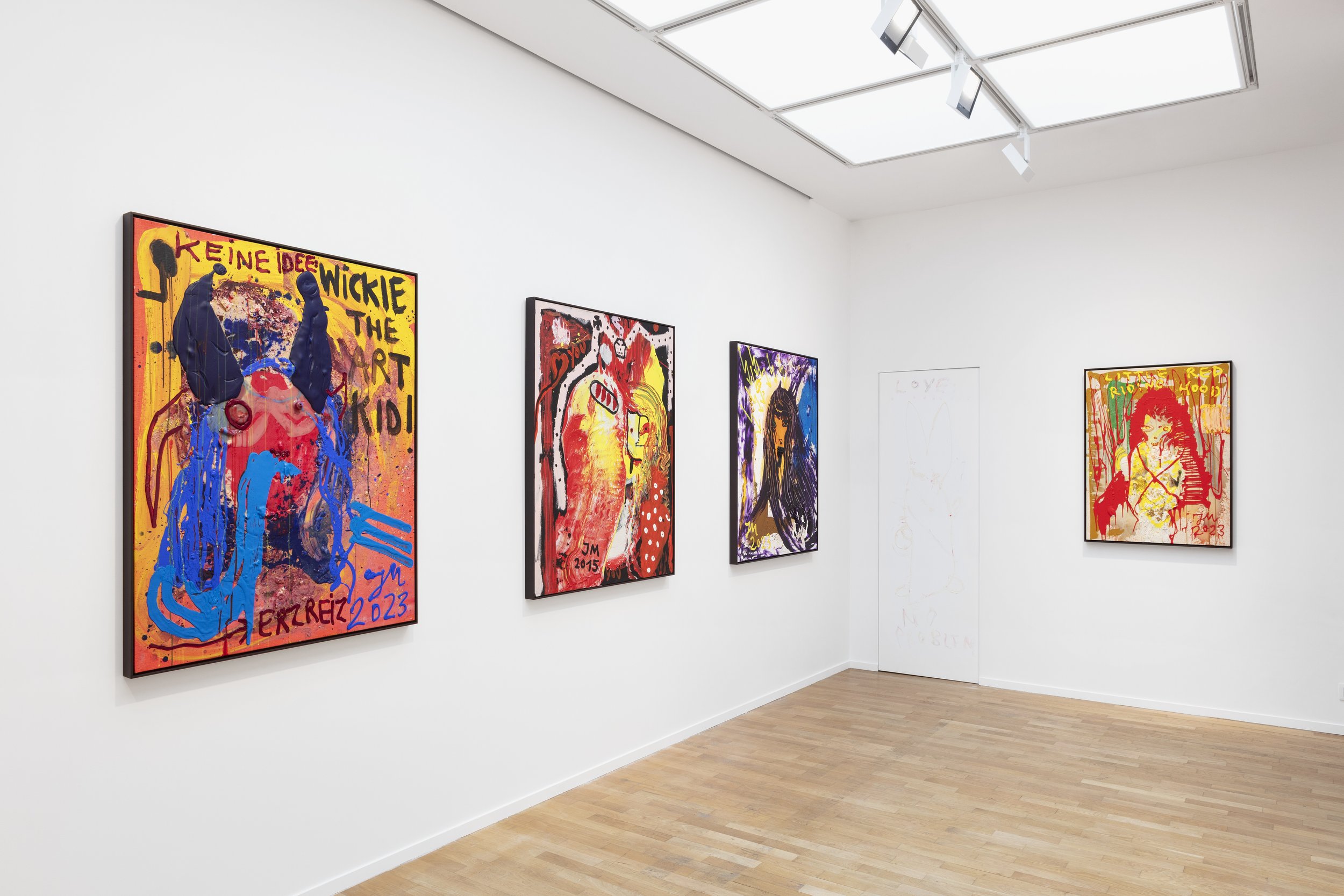

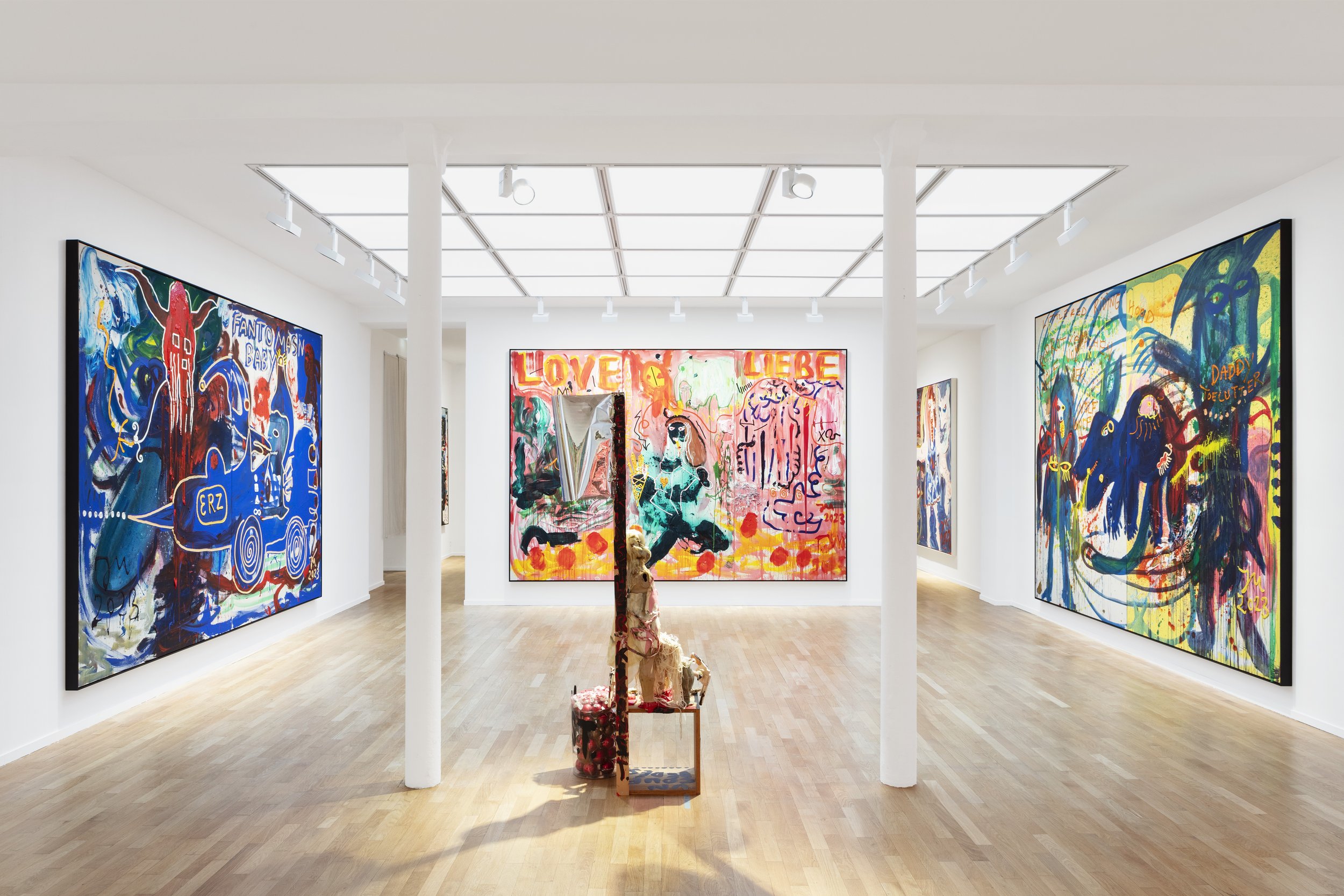
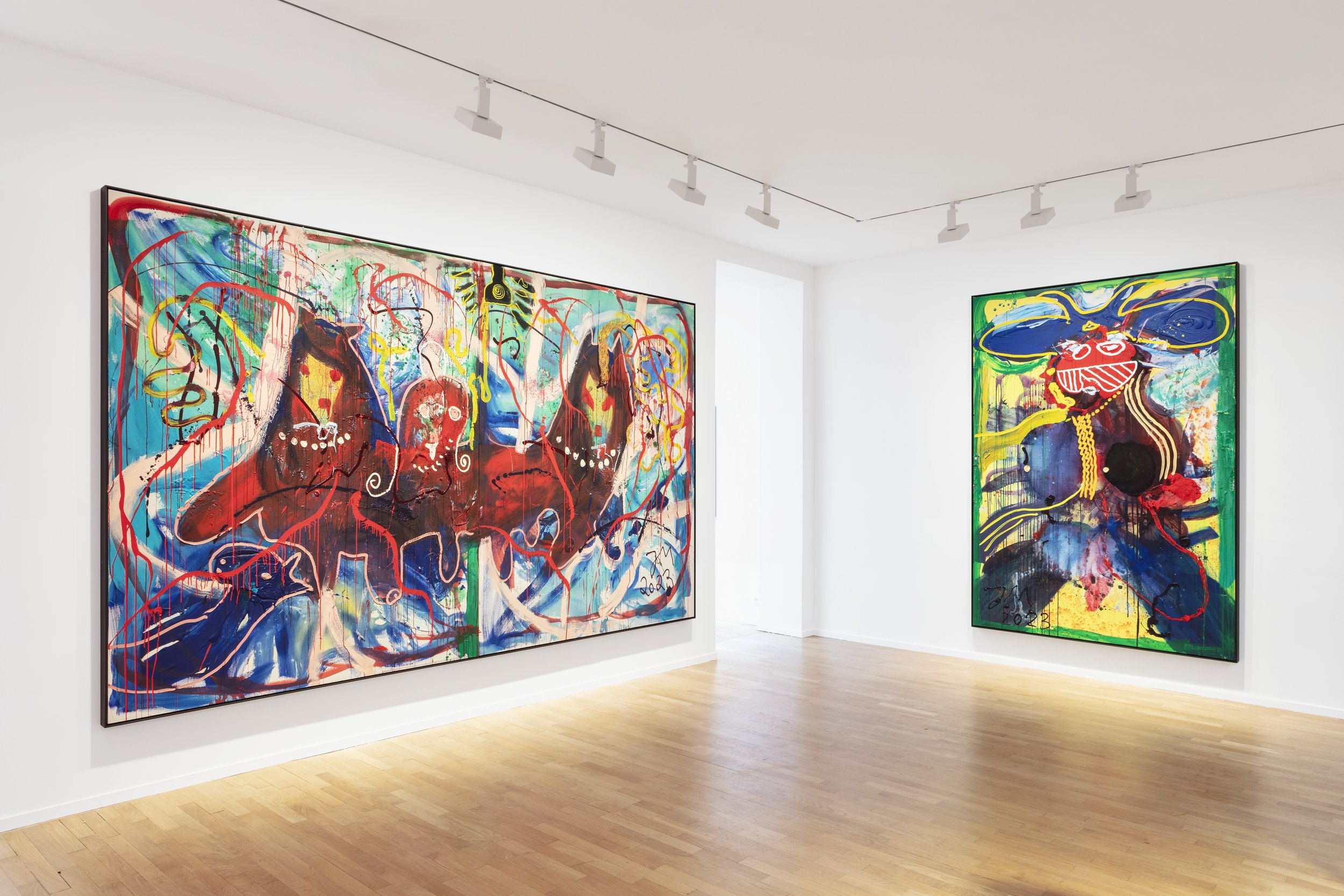
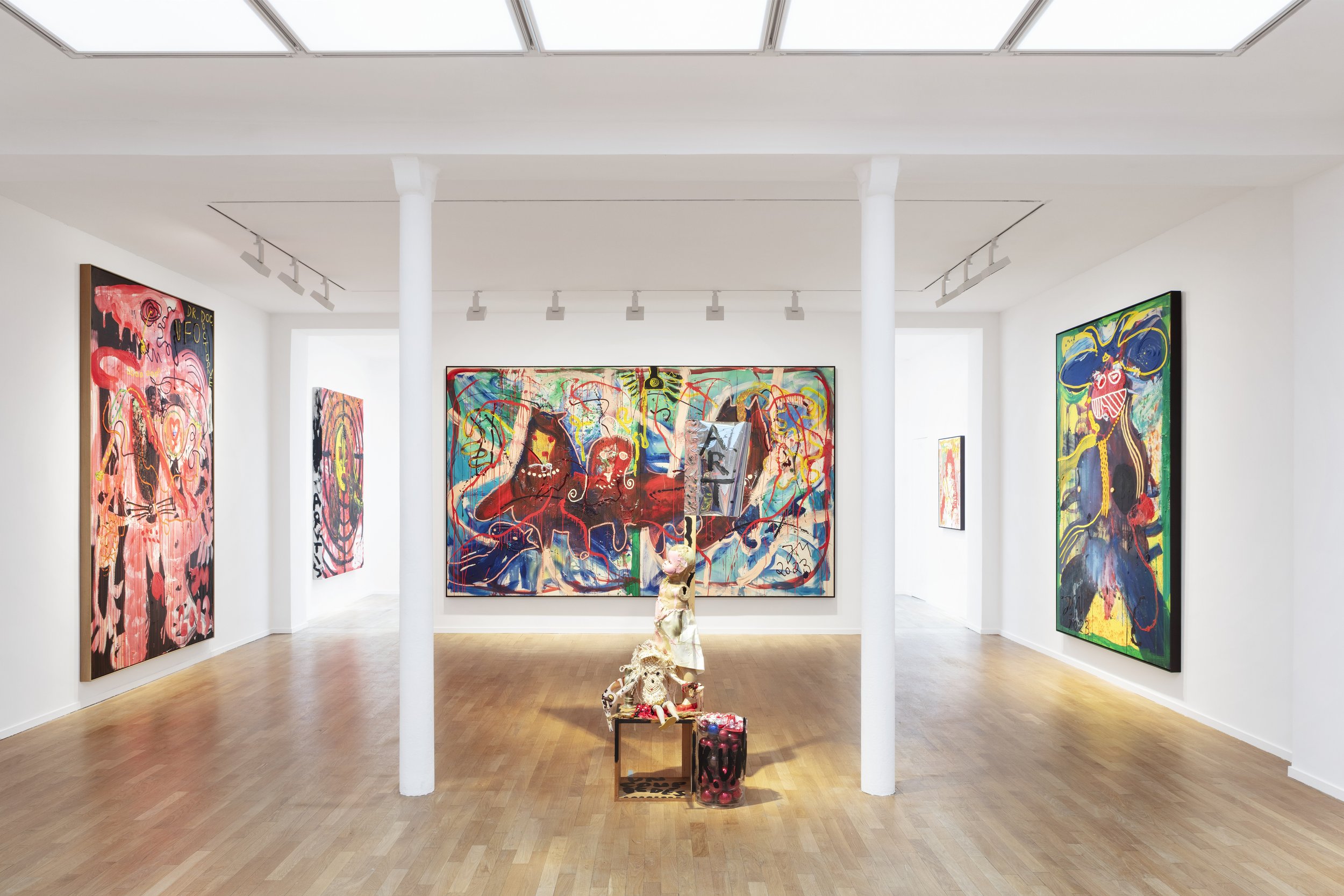
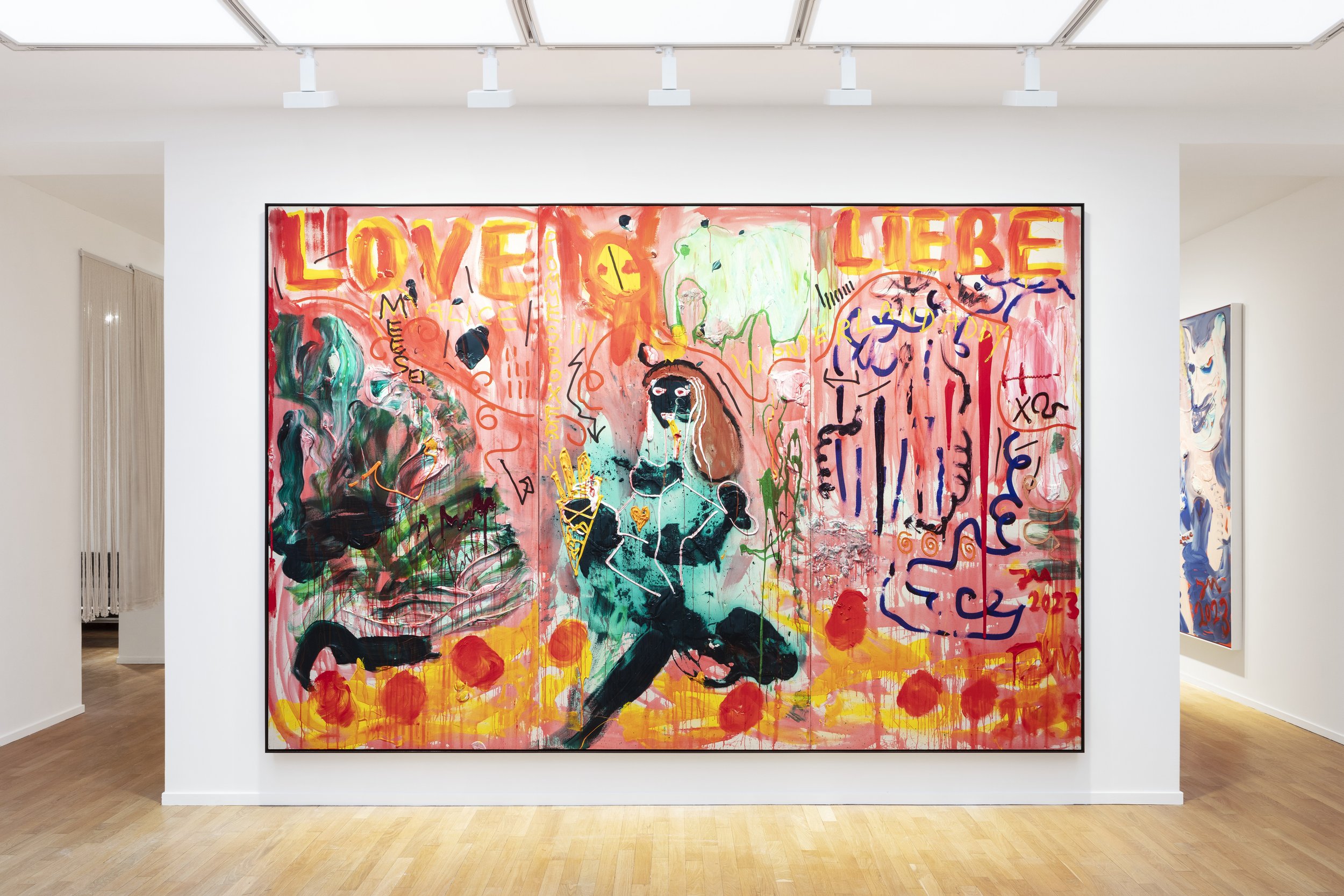
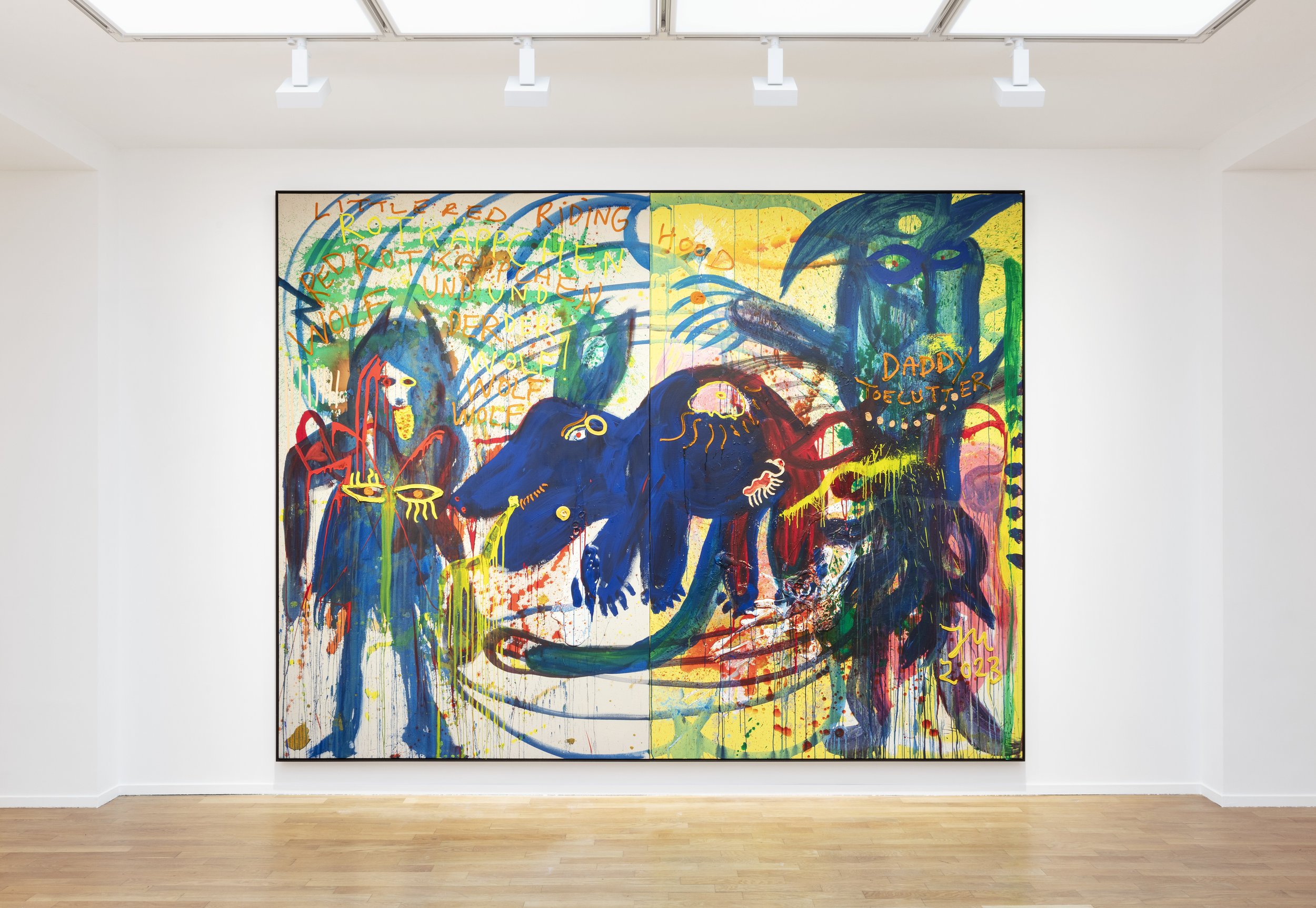
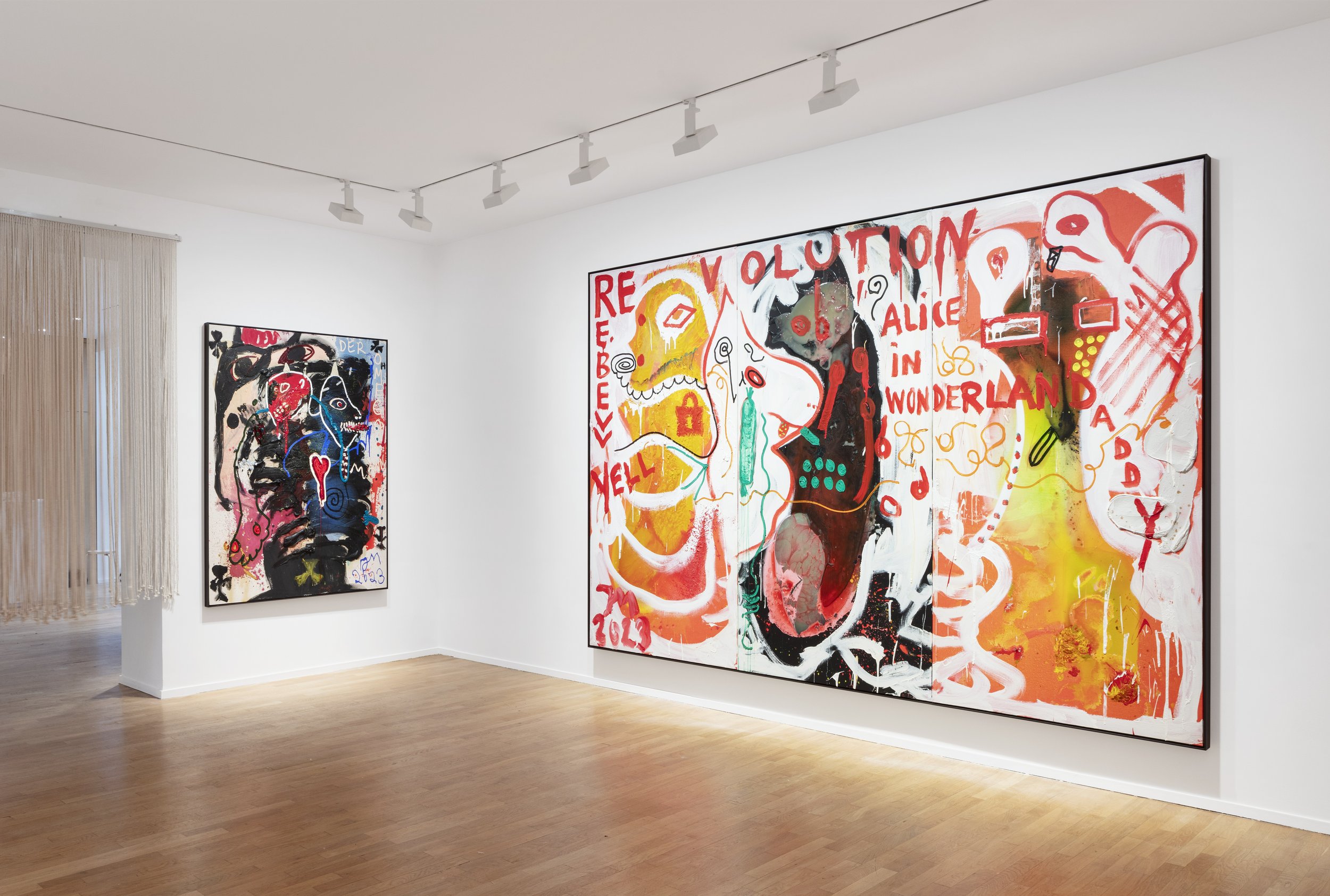
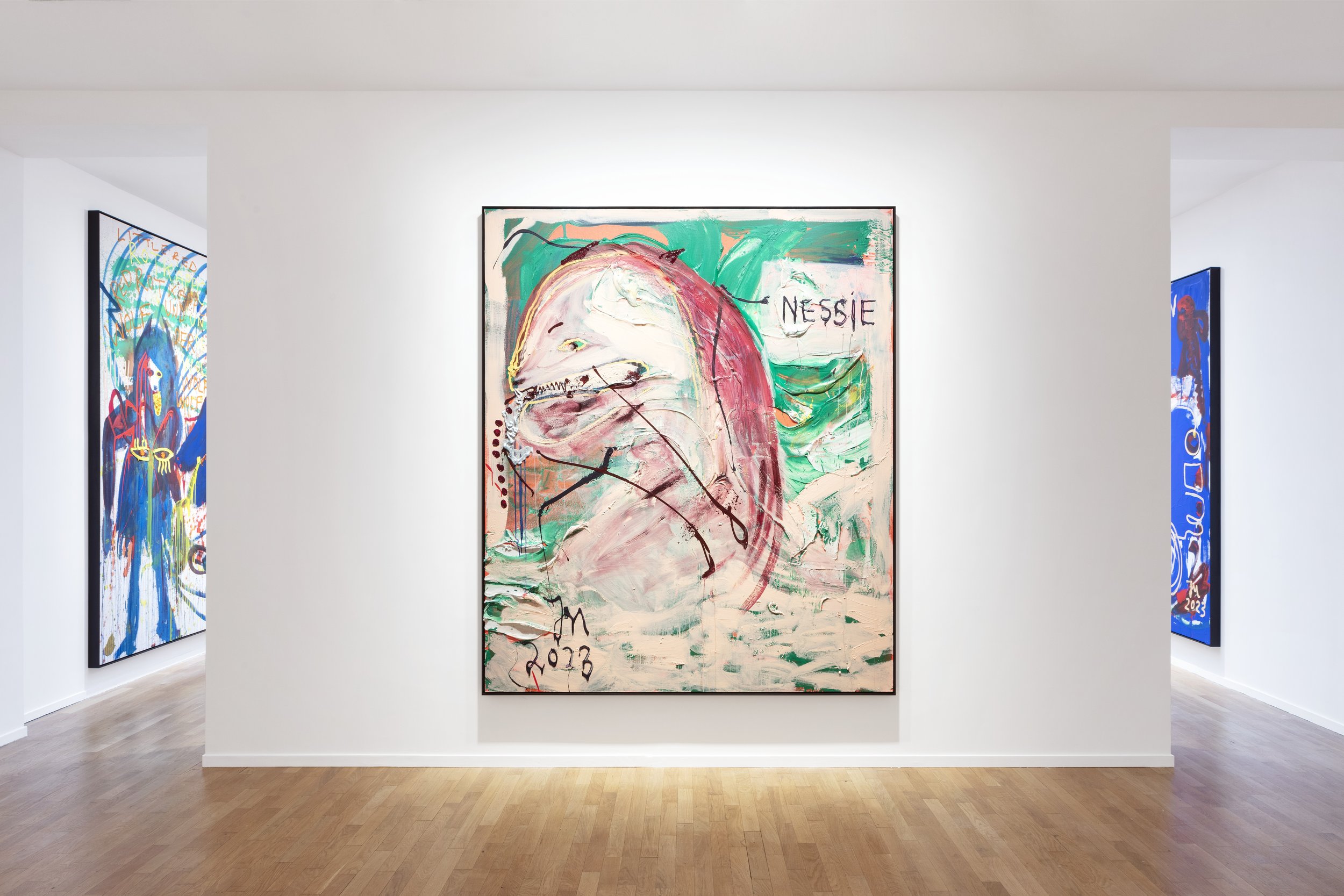
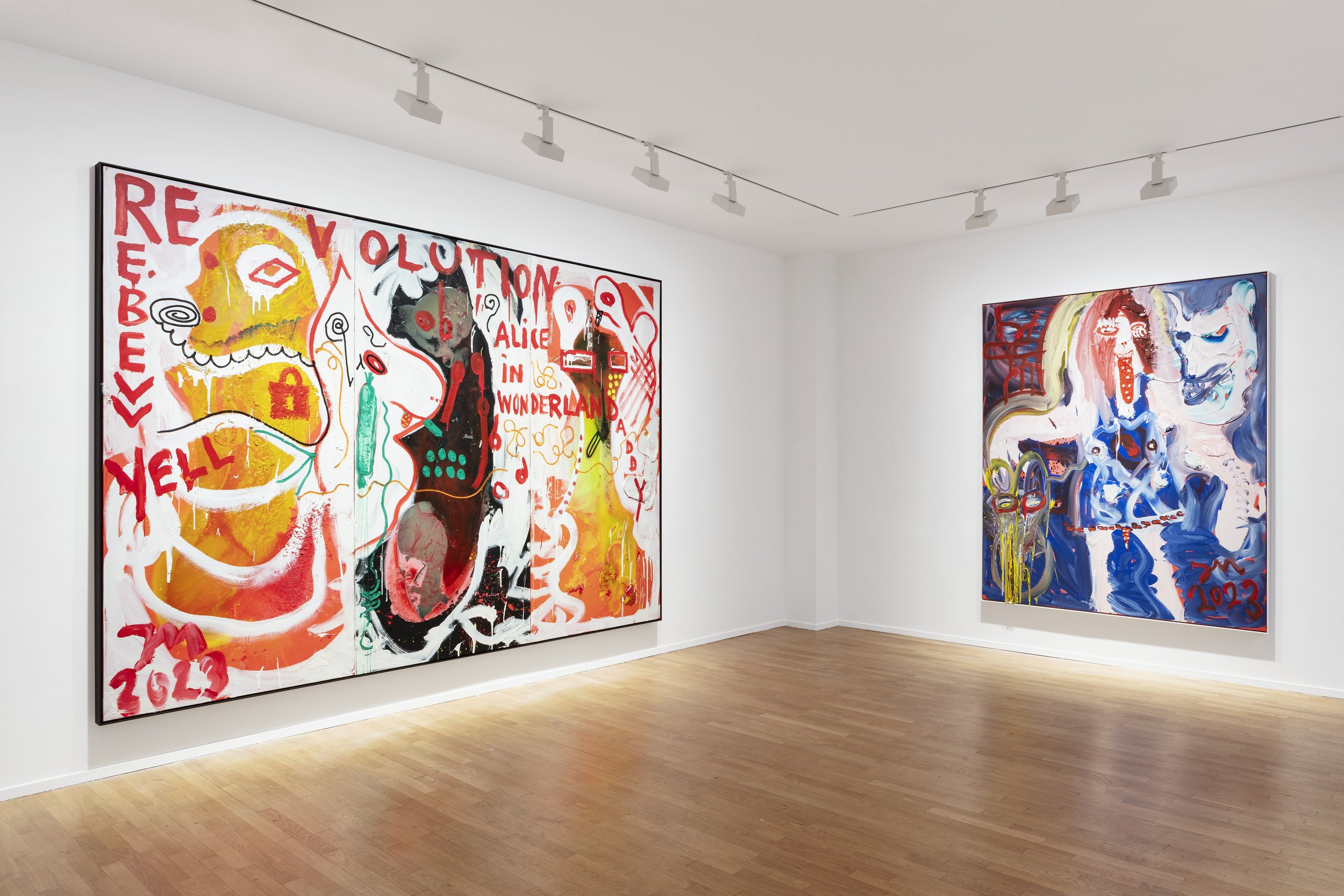
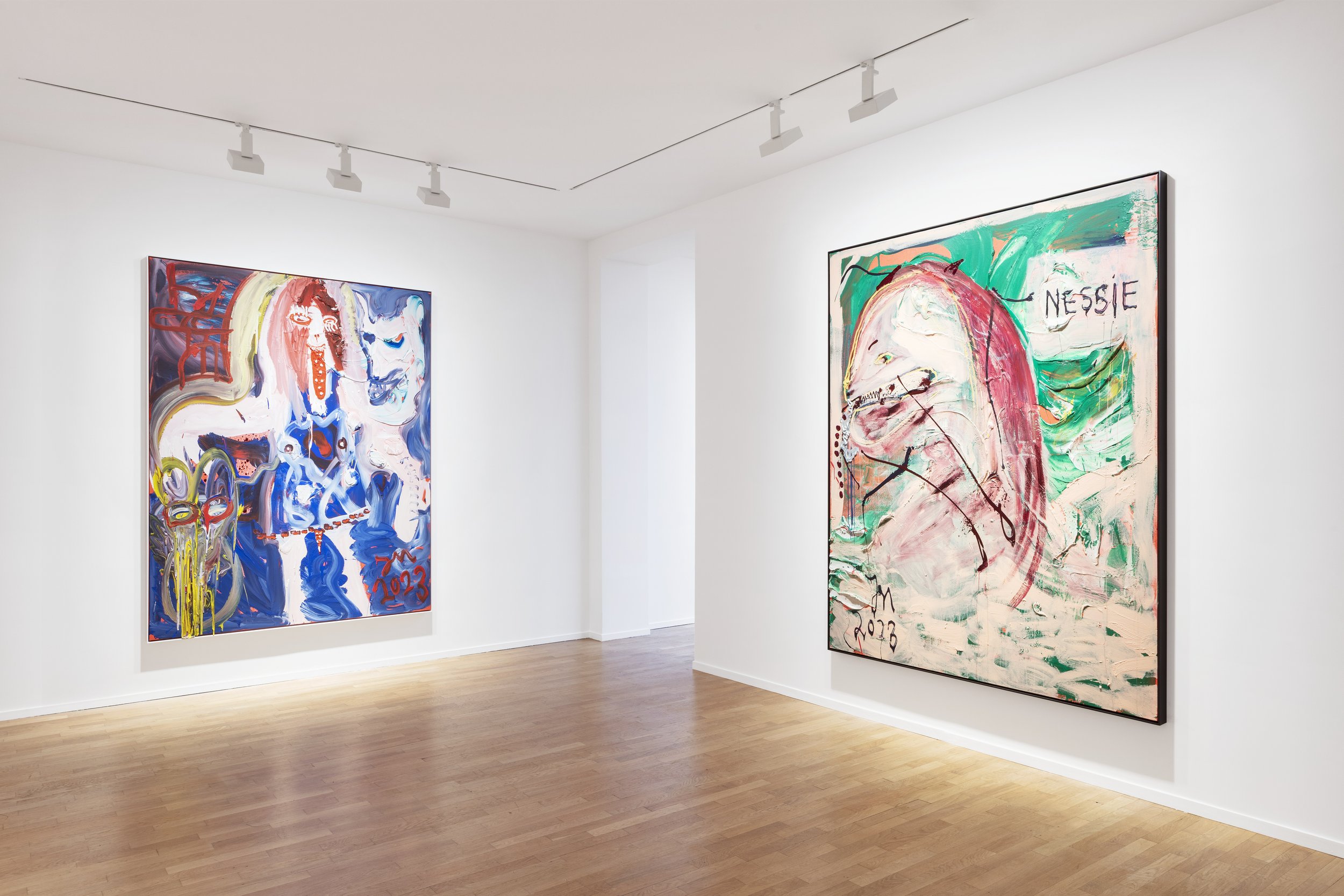
Toutes les images / All images :© Courtesy de l’artiste et TEMPLON,Paris —Brussels — New York
In 2013, the National Gallery of Modern Art in New Delhi organised the first retrospective of his work in India (curated by Ranjit Hoskote). In 2014, Bhau Daji Lad in Mumbai paid tribute to his work with a major exhibition: 7000 Museums. In 2019, he was among the artists showcased at India’s Venice Biennale participation, with a largescale installation dedicated to Gandhi.
This is the fourth exhibition of Atul Dodiya’s work at Galerie Templon.
For more information about this exhibit and other exhibits at the Templon Gallery, please visit their website here. Also, find the Gallery on Instagram and Artsy.
New Realism: Looking Forward and Back
After running galleries in New York for the past decade, Isabel Sullivan launched her eponymous gallery in the heart of Tribeca’s design and gallery district at 39 Lispenard Street.
The Gallery launched a group show on March 14 and will conclude on April 21 of this year. There was an opening reception for New Realism: Looking Forward and Back , which was held on March 14, 6 pm-8 pm. The exhibition features six New York-based artists, New Realism: Looking Forward and Back, curated by/featuring recent works of Neil Jenney (who has remained ardently committed to curating & exhibiting shows associated with Realism) alongside recent works by Elisa Jensen, Victor Leger, Joseph Santore, Mercer Tullis, and Frank Webster (Santore was also teacher to both Jensen & Webster). The show will feature approx. 30 works and the gallery is currently filming mini-documentaries about each artist to be played at the gallery during the show. Through Jenney’s painted, sculptural skyscapes, to Jensen’s shadowed, yet vibrant, intimate interiors, to Santore’s dynamic and existential paintings reflecting the human condition, to Tullis’ meditative yet piercing graphite works, and finally to Webster and Leger’s serene topographical canvases, the gallery poses the question: what is Realism today? Their reflections of nature and humanity are presented for us to behold, to momentarily possess and perhaps to stir a particular affect. The exhibition presents a survey of artists looking both forward and back – painting through the tides of today; attached is a small sampling from each artist of what will be shown (2 images for each artist, plus an initial artworks list with 18 works).
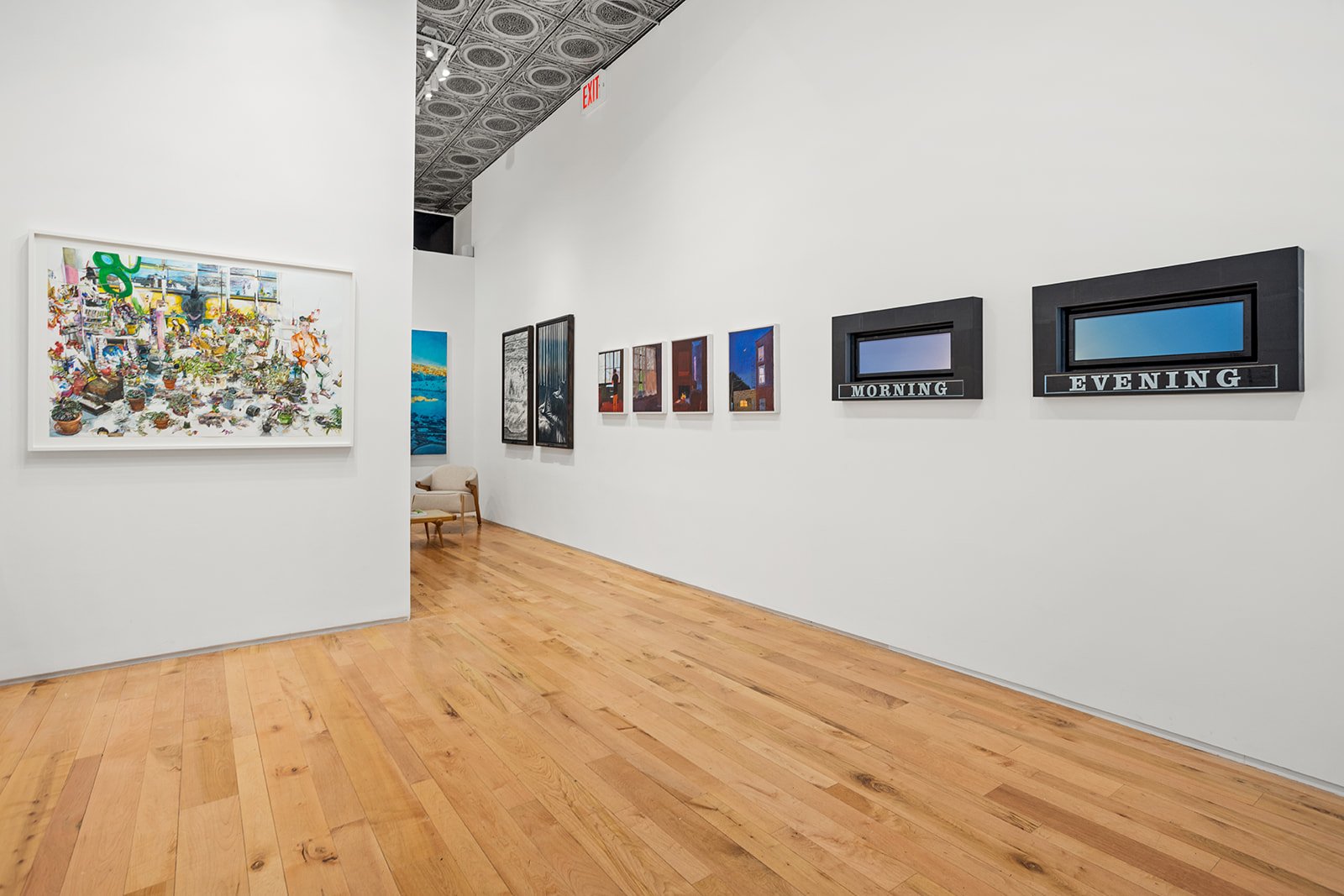
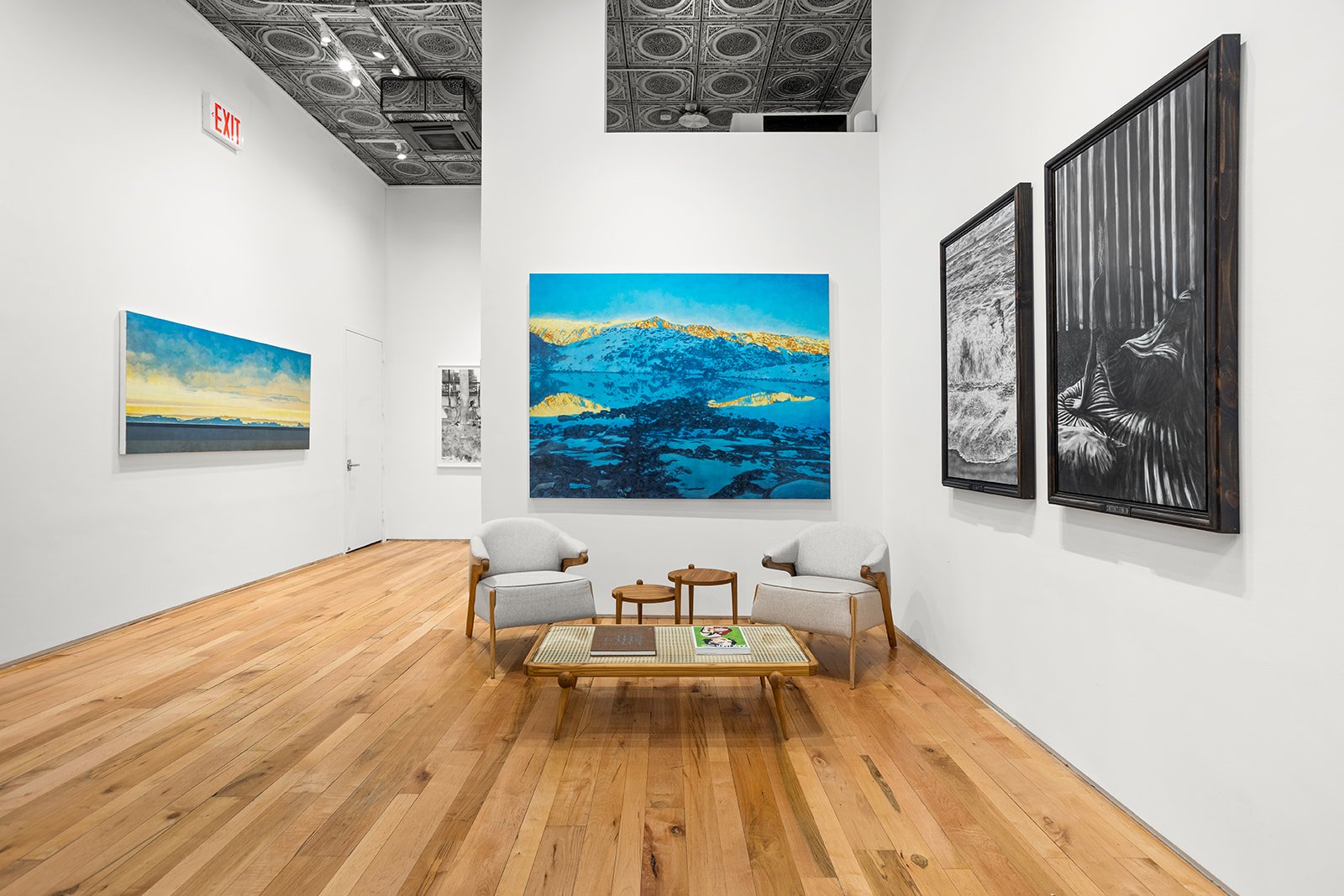

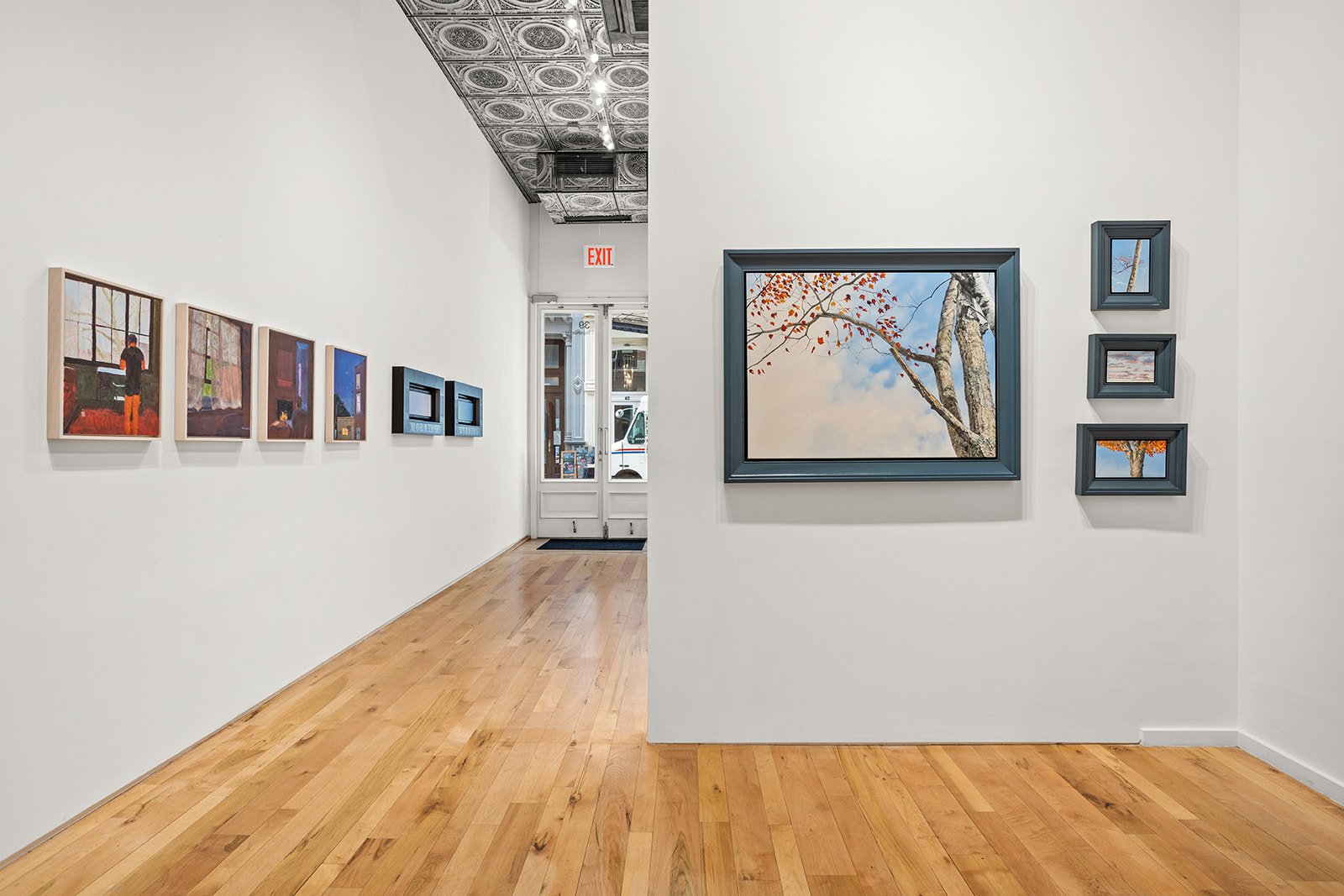
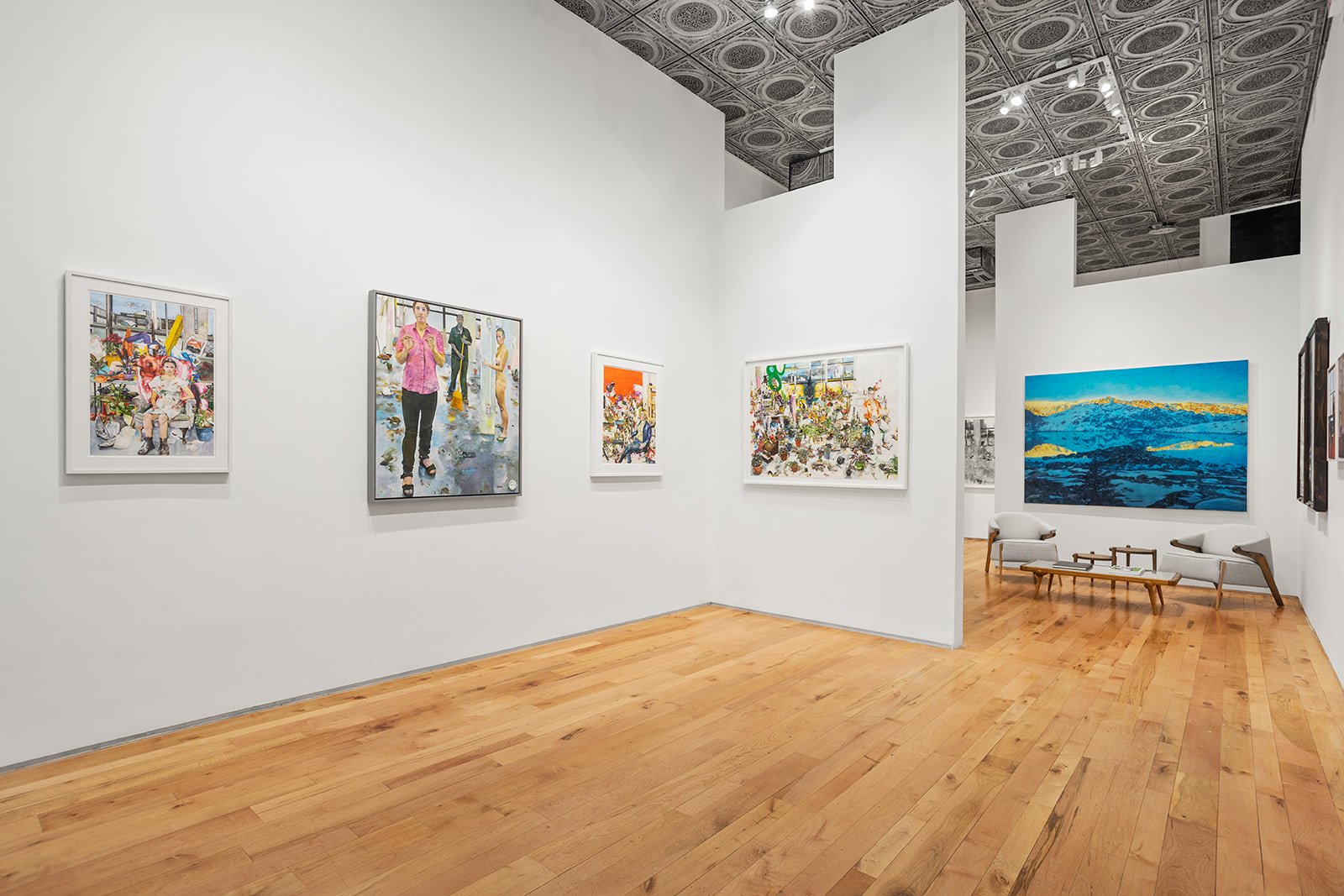
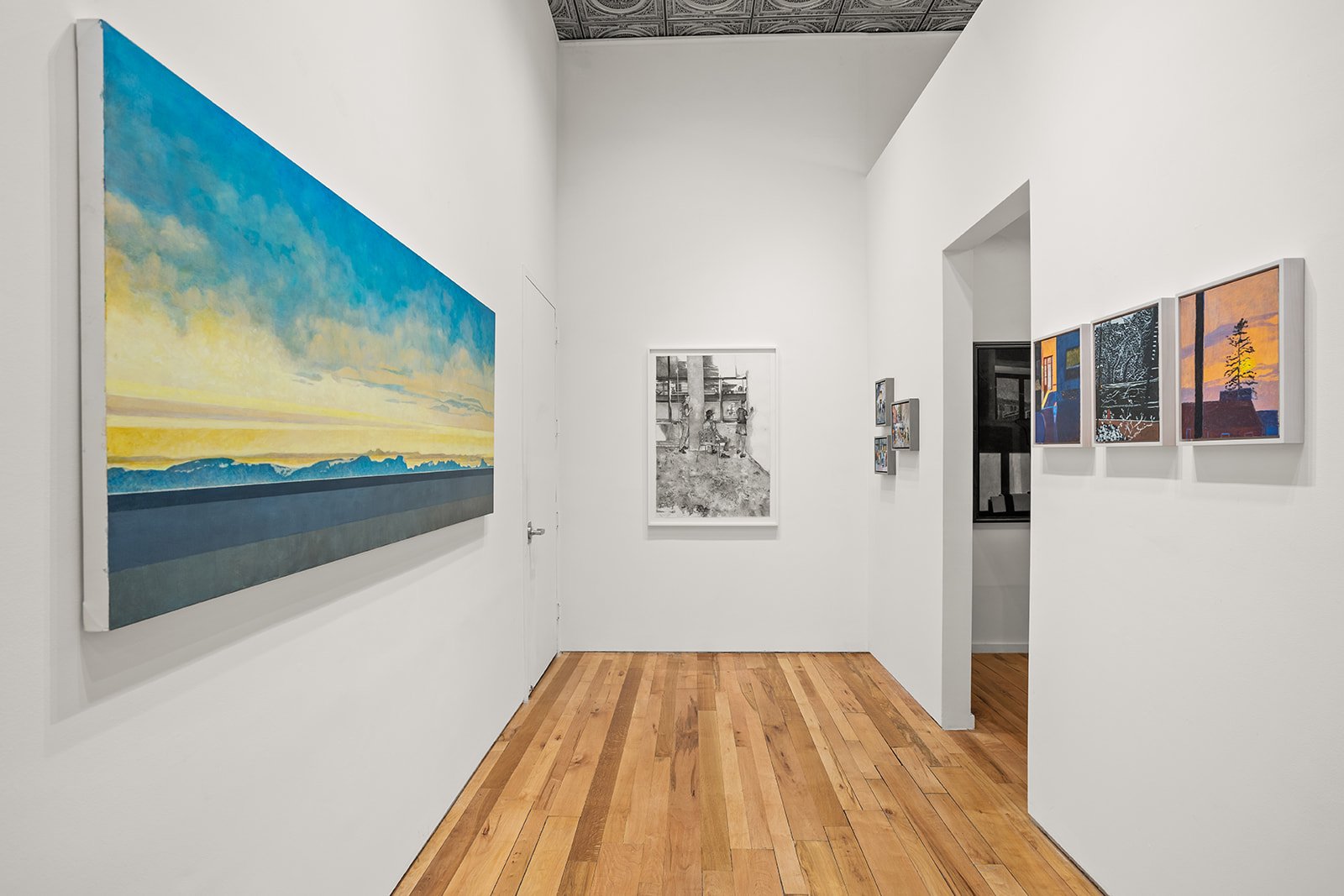
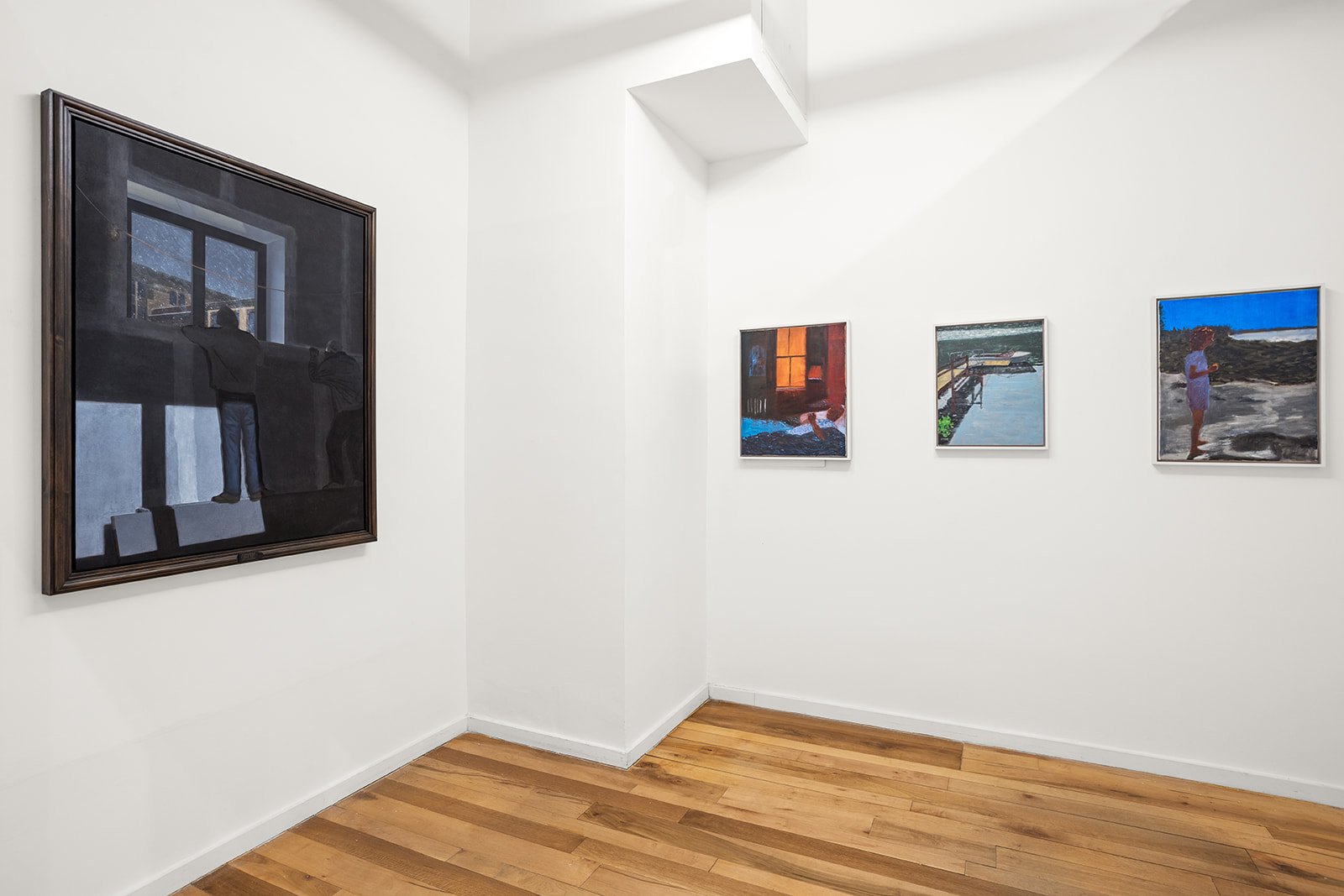
Installation view Realism Today: Looking Forward and Back, Isabel Sullivan Gallery New York, New York, March 14- April 21 2024, photo @ Isabel Sullivan Gallery
A myriad of iterations of Realism have emerged since its inception in late 19th century France. Gustave Courbet and Jean-Francois Millet sought to convey truth and objectivity through embodied depictions of modern life and its array of social classes. German artists Otto Dix and George Grosz’s meticulous Neue Sachlichkeit (New Objectivity) paintings, created during the short-lived Weimar Republic, responded to the brutality of the First World War. Their American counterparts, Edward Hopper and George Bellows, created a new American visual idiom through their depictions of the urbanization of America and its shifting class structures. Despite the disparate geographical production of these Realist painters, what each respective iteration shares most prominently is their emergence and proliferation following great moments of social, political, or cultural change. The past few years have been no exception to this artistic penchant, as there has been an increase in artists turning to themes intrinsic to Realism, and a recommitment to time-honored subjects, such as genre, landscape, and figurative. Realism has always functioned primarily as a means to record our epoch and its dwellers, however in its present context, the paintings included in this show possess both objectivity and expression.
Realism Today: Looking Forward and Back presents a selection of paintings that utilize various concepts and technical aspects of Realism, which today stands as the rebirth of the three-dimensional picture plane, and a turning away from abstraction. The artists included explore both internal and external space, the natural world and urban life, memory, and imagination, offering a respite from the modern world.
More on the artists:
Neil Jenney - Neil Jenney is an American painter and sculptor born in 1945, in Torrington, Connecticut, and working in New York City. His last solo exhibition was at Gagosian gallery, titled AMERICAN REALISM TODAY, from November 9, 2021–January 29, 2022 at 976 Madison Avenue, New York.
Neil Jenney - Morning (2022, acrylic on canvas 18x32in)
Elisa Jensen - Elisa Jensen (b. 1965, Bridgeport, CT) lives and works in Brooklyn, NY. She has received awards for her work from the New York Foundation for the Arts, The National Academy Museum, and The American Academy of Arts and Letters. Elisa graduated from Smith College and the New York Studio School. She currently teaches at the New York Studio School and Pratt Institute.
Elisa Jensen - Brooklyn Morning (oil on wood panel 20x16in).
Victor Leger - Leger was born in 1961 in Canada. He studied at Pratt Institute and the San Francisco Art Institute in the early 1980s. He splits his time between Connecticut and Maine, and was discovered in New York by Neil Jenney. Leger is also a woodworker, building his own frames.
Victor Leger - Elegy to R. Motherwell, no. 25 (2021, oil on panel 55x43x3in)
Joseph Santore - Santore was born in 1945 in Philadelphia. His work was chosen for the poster of the 1991 Whitney Biennial. His works have been exhibited at the Whitney Museum of American Art, Tucson Museum of Art, Denver Art Museum, Staten Island Museum, National Academy of Design, NY, Pennsylvania Academy of the Fine Arts, Philadelphia, The Aspen Art Museum. Santore is in the permanent collections of the Metropolitan Museum of Art, New York, Cincinnati Museum, Chase Manhattan Bank, Hunter Museum of Art, Chattanooga, TN, National Academy of Design, NY, Phoenix Art Museum; Rhode Island School of Design, Tucson Museum of Art, Yale University Art Gallery, Denver Art Museum, among others. Santore was a teacher at the New York Studio School, where he taught artist Elisa Jensen, and at the Skowhegan School of Painting, where he taught Frank Webster.
Joseph Santore - The Studio (2024, watercolorand gouache on paper 35x49in).
Mercer Tullis - Tullis was born in 1994 in New York. Mercer began formally studying at the Art Students League in 2013, taking drawing classes under Robert Cenedella, whose studio was across the hall from the loft he grew up in. Soon after beginning at the Art Students League, Mercer began assisting realist & “bad painting” pioneer Neil Jenny. Tullis is a self-taught painter and woodworker, building all of his own frames.
Mercer Tullis - Officers (2016-2018, oil on gessoed ply 50.25x39.25x2.50in).
Frank Webster - Webster was born in Fort Wayne, Indiana, in 1966, and received his BFA from the School of the Art Institute of Chicago and his MFA from the Mason Gross School of the Arts at Rutgers University. Some of the residencies he has been granted include the Arctic Circle Residency, Burren College of Art in County Clare, Ireland, the NES Artist Residency in Iceland, The Ucross Foundation in Wyoming, The MacDowell Colony in New Hampshire and the Sharpe Walentas Studio Program in Brooklyn. He has participated in many group and solo exhibitions at museums and galleries, such as the Zimmerli Museum of Art, the Bronx Museum of the Arts, Steffany Martz Gallery, the Parrish Art Museum, Blackston Gallery, and many others. In early 2022, Webster was commissioned to execute The Stone—a monumental Icelandic landscape—by the Durst Organization for the library for the newly constructed SVEN residential project in Long Island City, New York. Webster currently lives and works in Queens, New York.
Frank Webster - Hunafloi Bay (2020, acrylic on canvas 36x84in).
Diego Samper : The Jaguar’s Eye
Courstey of Diego Samper
Wild Symphony is an exploration of sound as essential energy and of the archaic origins of music as invocation and spell, a fundamental music that reclaims our belonging to the natural order in resonance with the breath and pulse of Life.
In Calanoa Natural Reserve, a conservation project deep in the Amazon Forest, professional musicians are invited to share with local indigenous singers and storytellers in long improvisation sessions, listening to the natural music, the Symphony of Life, and responding to it. From the first encounter, a Symphony and a film were created. The second one, The Jaguar’s Eye, is a live performance and audiovisual experience to be projected in full-dome spaces, with a premier happening at the Medellín Planetarium, Colombia, on May 15th, 2024.
Diego Samper, the project’s director and audiovisual designer, has been involved with the Amazon Forest for 5 decades, living and exploring the deep forest. This work synthesizes his life-long search of the Wild.
Musicians First Wild Symphony
Pablo Segundo, Aníbal Samuel, Raimundo Makuna, Enrique Yukuna, Teto Ocampo, Alejandra Ortiz Almunis, Marcus Berg, Juan Camilo Paulhiac, Coque Gamboa, Dominique Vaughan, Gabriel Hernández, El Vergel children’s choir, José Villa Ticuna(director). Marlene Escobar, production.
Musicians The Jaguar’s Eye
Darío Yukuna, Luciano Yukuna, Angélica Ocaina, Moises Criollo, Diana María Restrepo, Gina Sabino, Sandra Parra, Juan Camilo Paulhiac, Cristina Rubio, Luis Torres, Peter Harper. Marlene Escobar, producción
Diego Samper, direction, field recording, audio and video edition.
Marlene Samper, production.
Recorded in the Calanoa Natural Reserve, Colombian Amazon.
Edited in The Rainforest Studio, Gibsons, BC, Canada.
Marlene and Diego Samper have worked extensively on the research and recording of wild soundscapes and the voices of traditional cultures. As a result of this came the CD and book Voces de la Tierra (Voices of the Earth), an exploration of the geography of wild soundscapes in Northern South America, published in 1999. Amazon Chant, 2017, is a sound installation commissioned by the Museum of Anthropology of UBC, a five-hour weaving of voices in seven indigenous languages and soundscapes of diverse regions of the Amazon basin.
Please visit his site here for more information about this project and Diego’s work. Also, Diego’s interview with Arte Realizzata can be found here.
DANIEL DEZEUZE : Mesoamerica Lost Cities and Last Refuges
Toutes les images / All images :© Courtesy de l’artiste et TEMPLON, Paris —Brussels — New York
Galerie Templon is dedicating its spring show in Paris to the founding member of the avant-garde movement Supports/Surface, Daniel Dezeuze. Now 82, he is showing his latest work, which encompasses sculptures, paintings, drawings, and an installation. The exhibition opened on March 2nd and will conclude on April 27th, 2024.
Mesoamerica is a personal reflection inspired by Daniel Dezeuze's travels to Mexico and local Maya architecture. Daniel Dezeuze visited Mexico for the first time in the mid-1960s. The year he spent there proved to be a lasting influence. His latest works, wall assemblages made using offcuts of painted wood, hark back to the pivotal experience in the jungle, home to long-gone civilizations. The ground floor of the exhibition features a "negotiating table" surrounded by an installation of "weapons" and "shields," evoking the tensions between nature and culture.
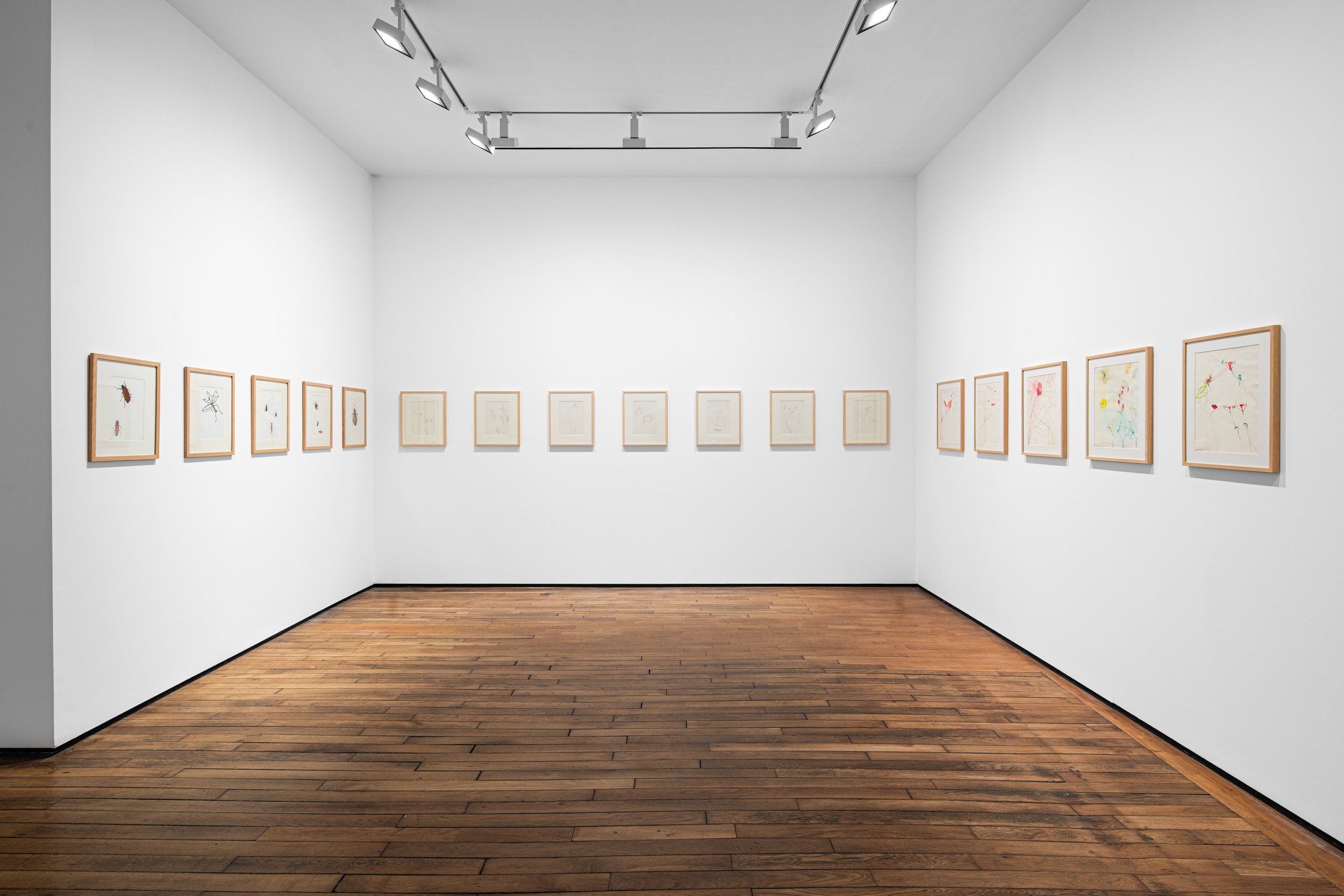
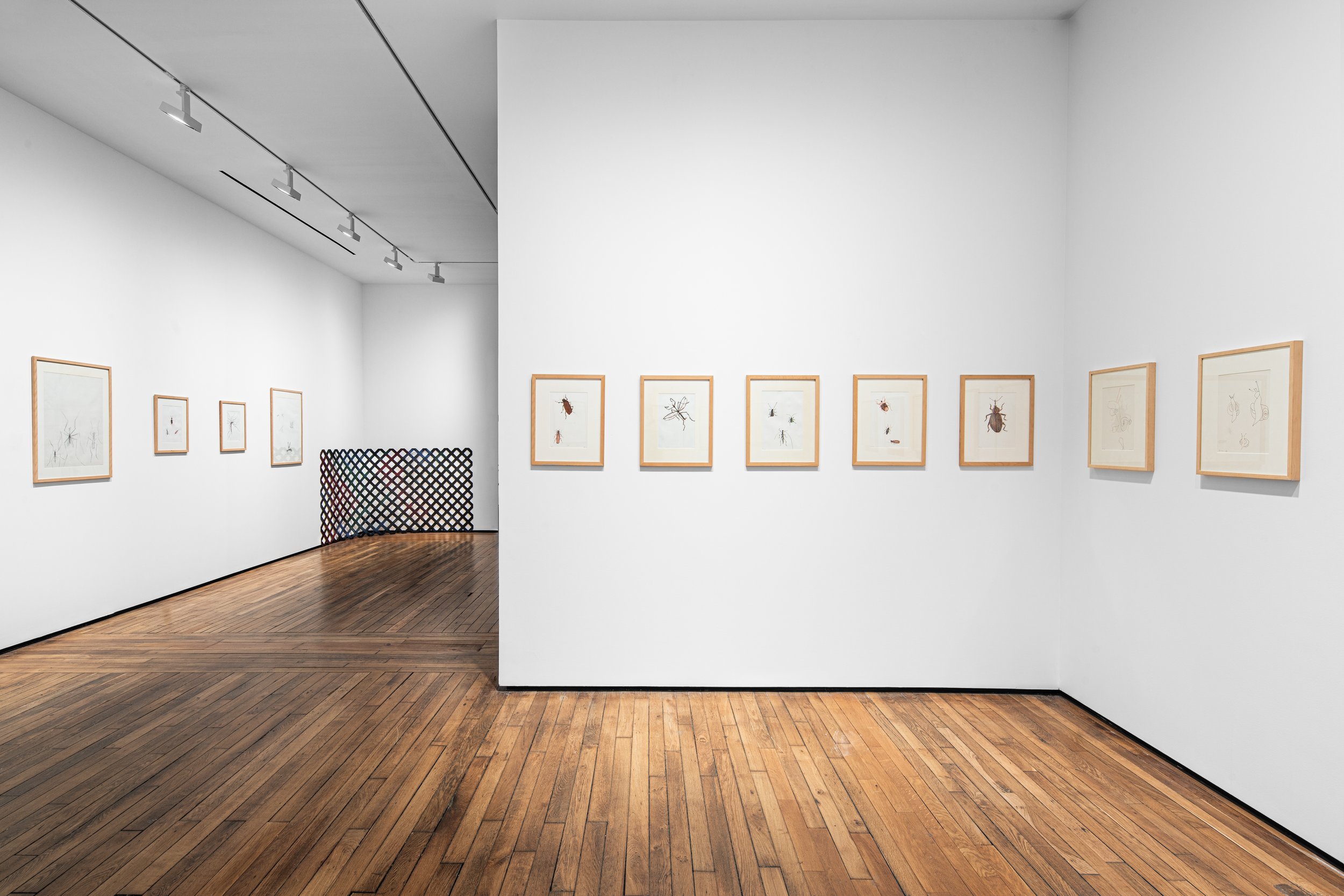
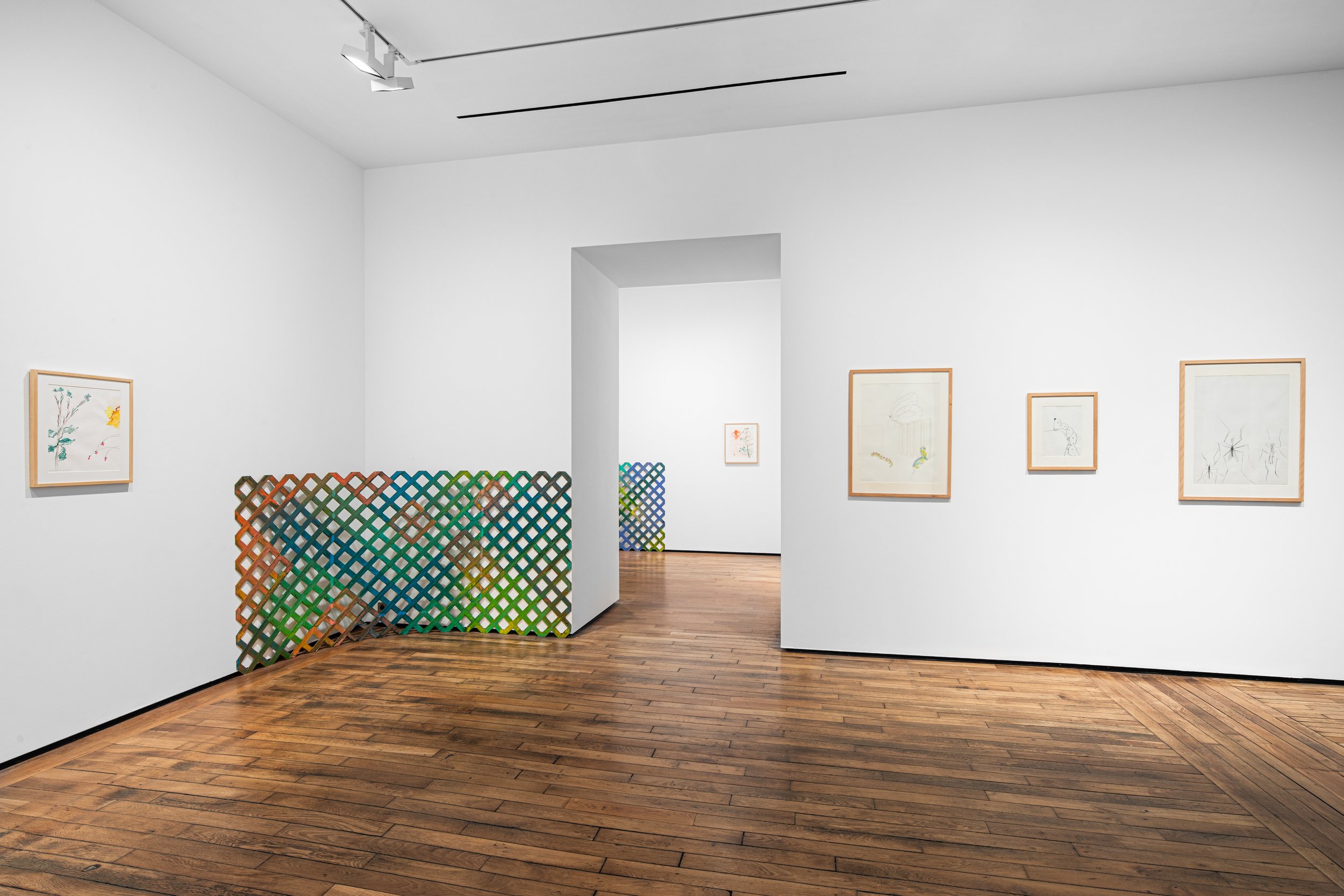
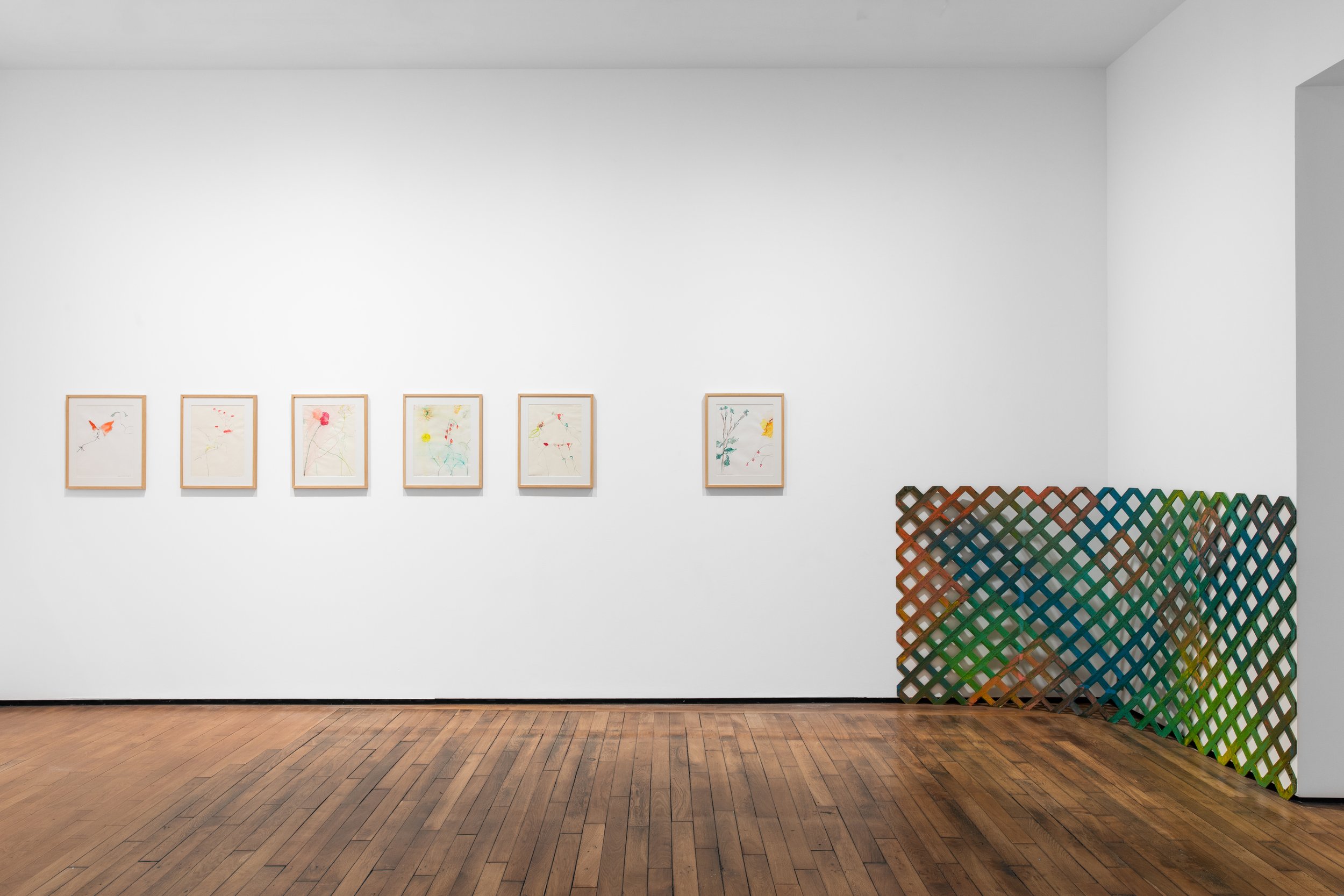
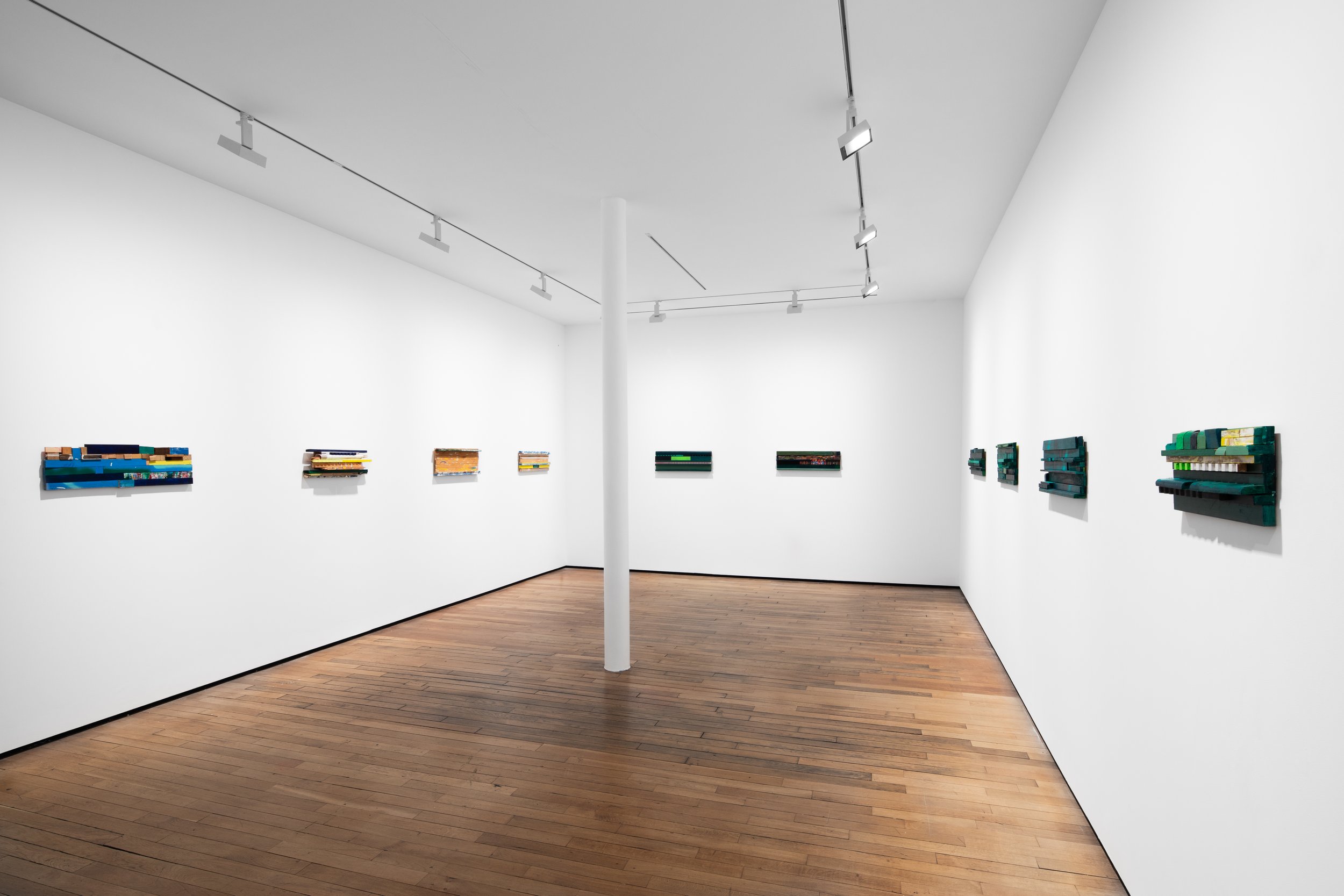
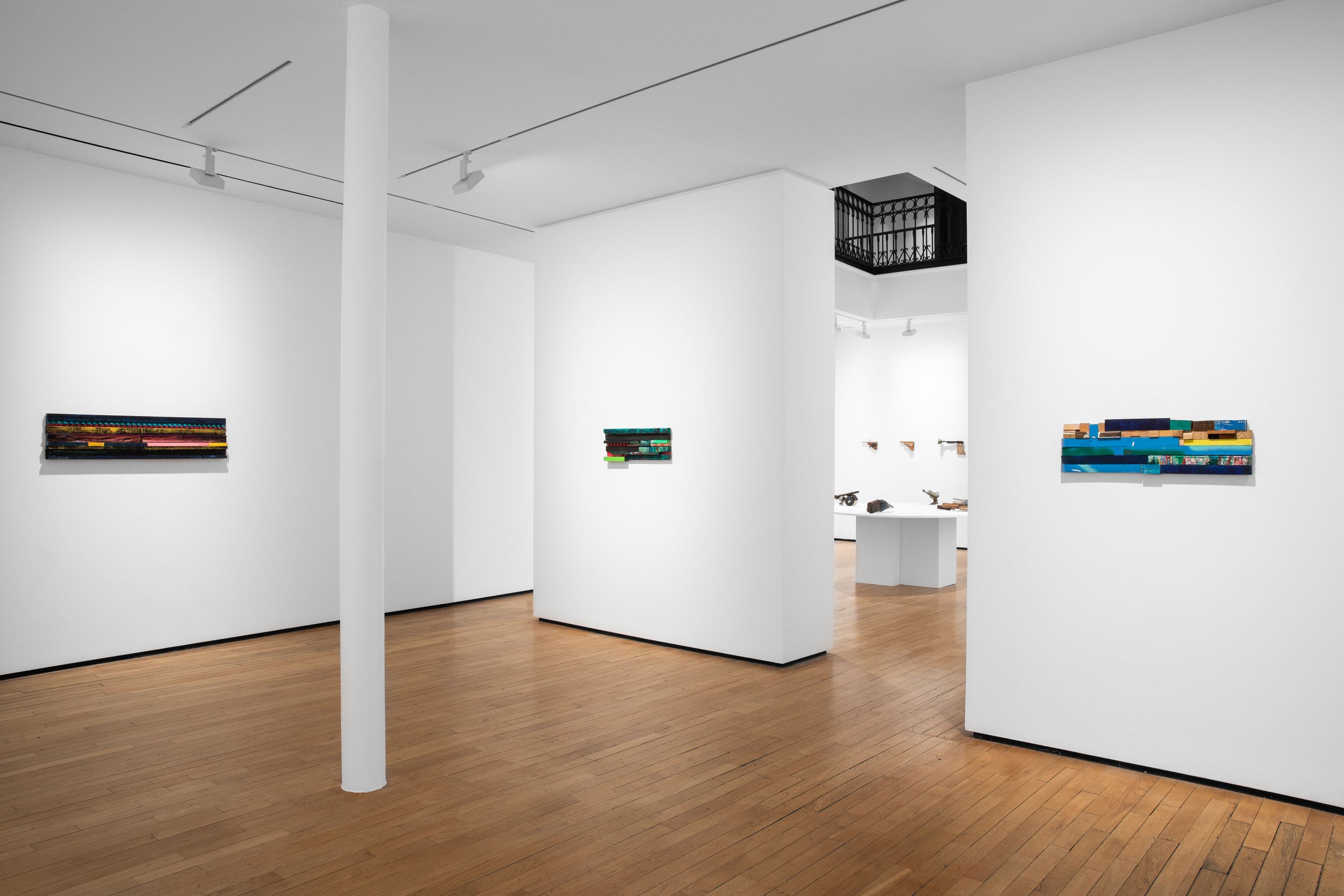
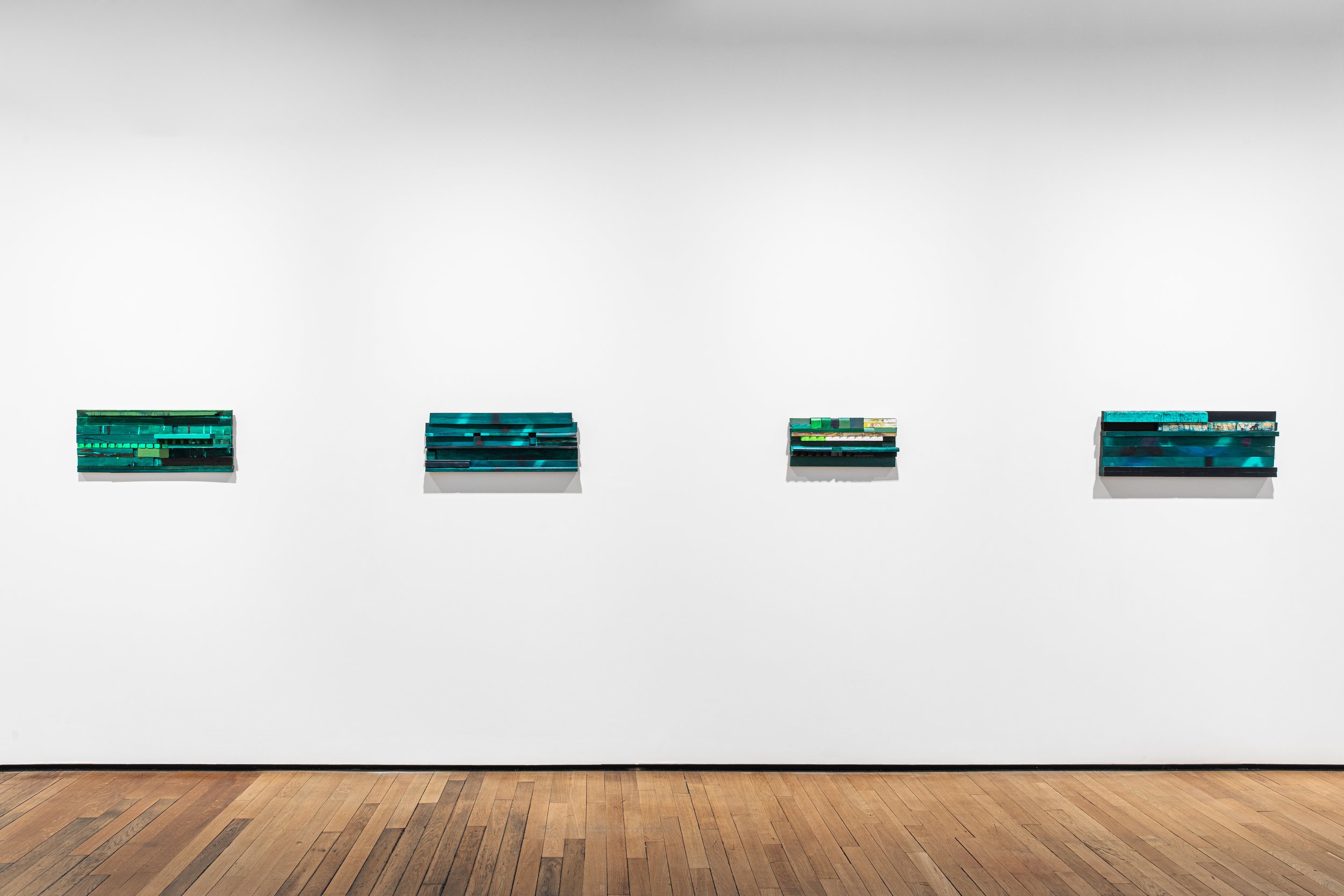
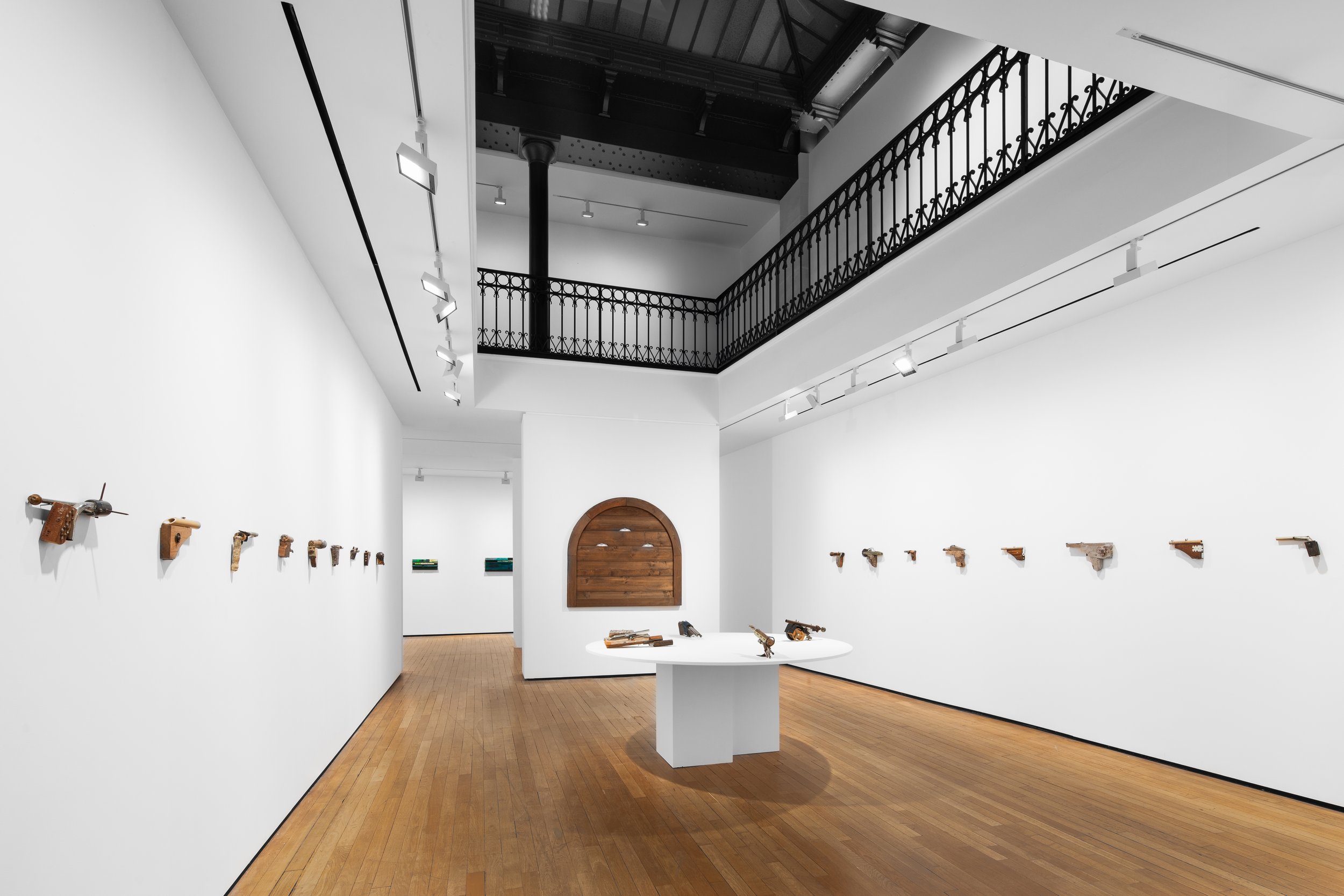
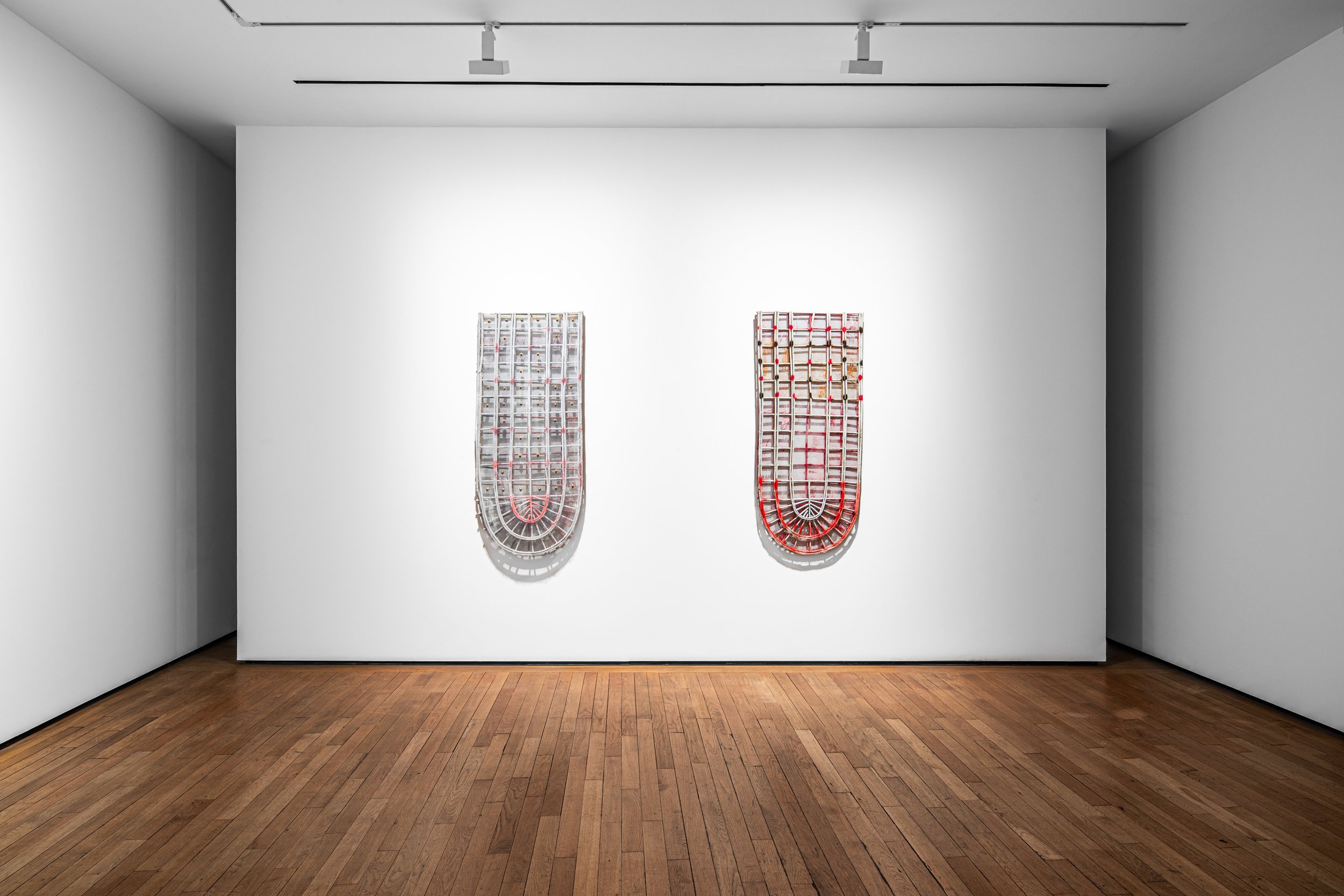

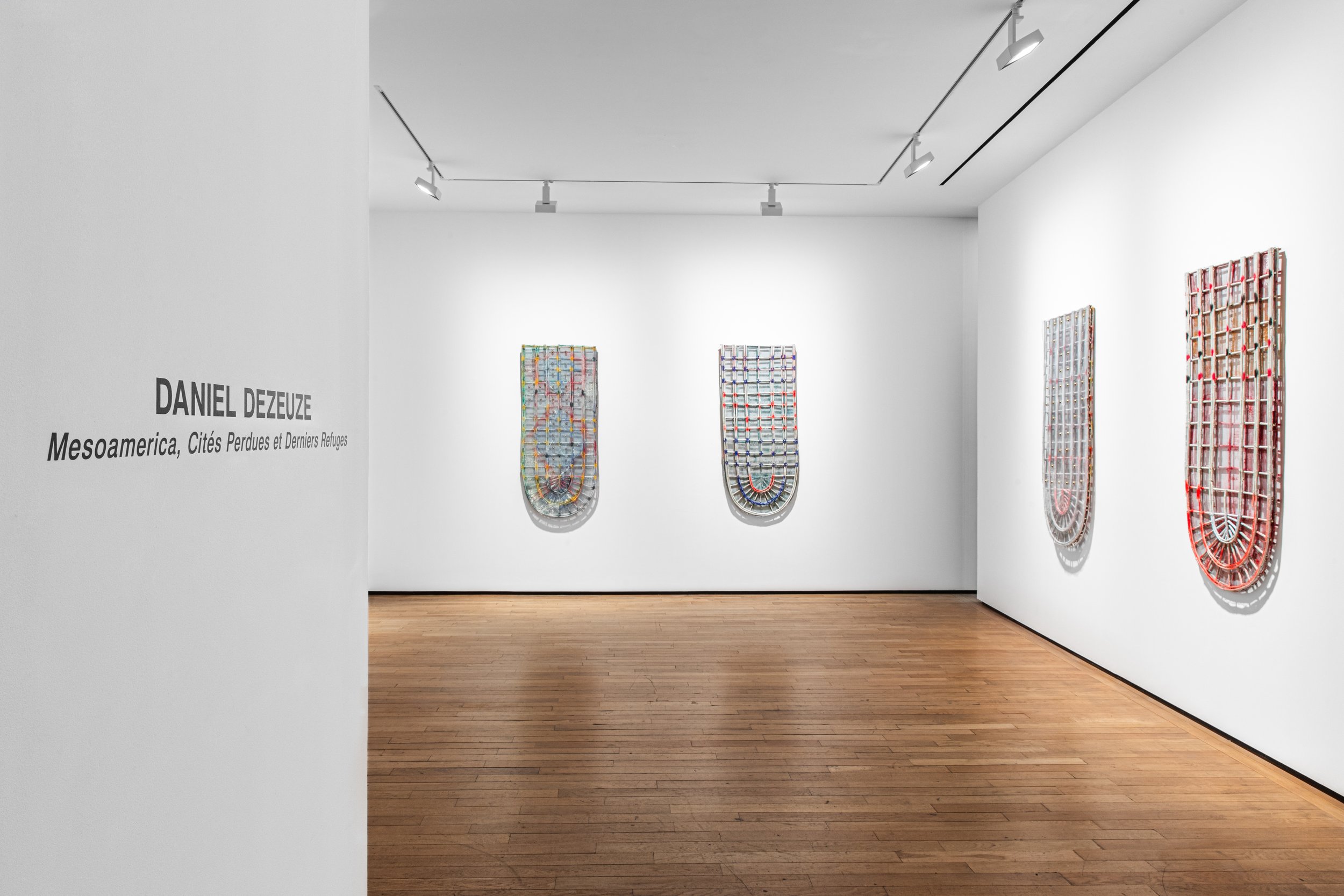
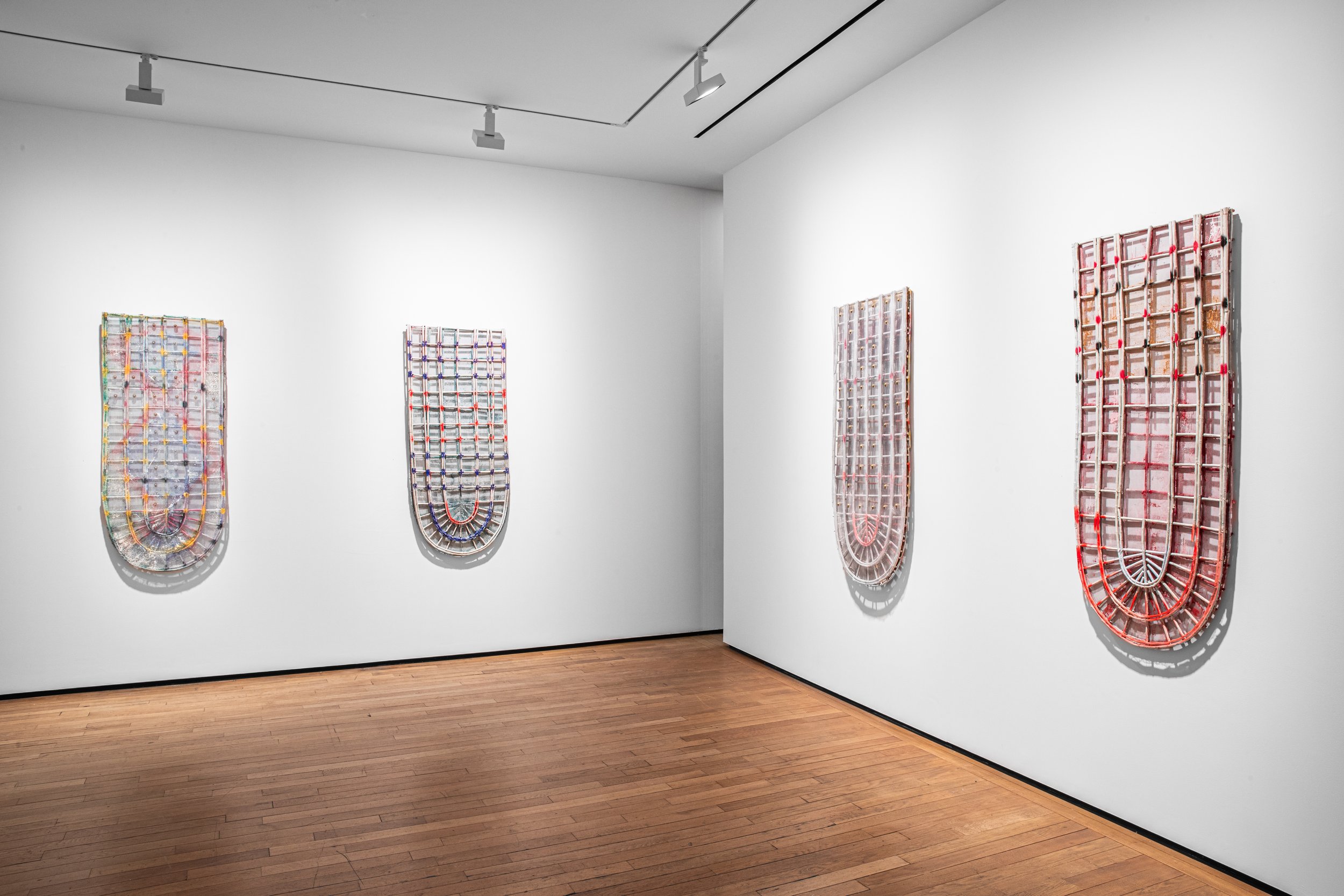
Toutes les images / All images :© Courtesy de l’artiste et TEMPLON, Paris —Brussels — New York
Indigenous people and colonizers. The simplicity of the artist's chosen materials, wood, mesh, and corks, and the delicacy of the way he combines them offer a disturbing exploration of the frontiers between art and crafts, the untouched and the policed, as well as the fragility of civilizations and modernity. In contrast, the gallery basement is inhabited by a collection of drawings Daniel Dezeuze has put together, a jungle of flowers, insects, mosquitoes, and snails. Bordering on the abstract, the series of pieces depicts fragile yet untameable nature, illustrating the artist's obsession with "capturing the uncapturable.” Daniel Dezeuze has spent almost fifty years deconstructing the notion of painting, exploring its traditional techniques and materials in a quest to delve into the role, history, and practice of painting. The impulse to spurn the canvas began very early on in his career: he flipped ped stretchers against the wall, playing with empty spaces and three dimensionality to push the boundaries of artistic traditions. His work is steeped in craftwork practices and anthropology, reflecting his interest in nomadic and non European cultures. His remarkable journey has led him to experiment with what is seen as “poor” materials —wood, gauze, net, and fabric, as well as subverted objects. His oeuvre has heavily influenced new generations of European artists, and features in numerous public collections, including at the Centre Pompidou, Musée d’Art Moderne de la Ville de Paris, Musée Fabre in Montpellier, Carré d’Art in Nîmes and Musée d’Art Contemporain (MAC) in Marseille.
About the Artist:
Born in 1942 in Alès, Daniel Dezeuze lives and works in the southern French port town of Sète. His work has been widely exhibited since the 1970s in France and internationally. The Musée de Grenoble held a retrospective of his art in 2017, while the FRAC Occitanie in M Montpellier held an exhibition of his drawings in 2015. MAMAC in Nice (2012), Centrale Electrique in Brussels (2009) and the Musée Fabre in Montpellier (2009) have also shown his work. In 2008, he exhibited his entire oeuvre at the Musée Paul Valéry in Sète.
.
His art has featured in a wide variety of group exhibitions: at Collection Lambert in Avignon in 2022, FRAC Poitou Charentes in 2020, Musée de l’Abbaye Sainte -Croix in Les Sables d’Olonne (MASC) and MOCAD in Detroit, USA, in 2019, Carré d’Art in Nîmes In 2017, Abattoirs in Toulouse in 2015, Villa Datris in L’Isle sur la Sorgue, Musée du Louvre Lens and Musée d’Art Moderne et Contemporain in Strasbourg in 2014, Musée Picasso in Antibes and Centre Pompidou Metz in 2013, MAMAC in Nice in 2012, Centrale El ectrique in Brussels, Belgium, in 2009 and Fundació Suñol in Barcelona, Spain, in 2007. Daniel Dezeuze has been represented by Galerie Templon since 1999.
For more information about this exhibit and other exhibits at the Templon Gallery, please visit their website here. Also, find the Gallery on Instagram and Artsy.
Ross Simonini: Scrolls
Installation view: Ross Simonini, Scrolls, 2024. François Ghebaly, New York. Courtesy of the Artist and François Ghebaly Gallery. Photo: Brad Farwell
François Ghebaly New York has proudly presented the opening of Scrolls, Ross Simonini’s first exhibition with the gallery at its Lower East Side location on March 7, 2024, and will conclude on April 2, 2024. Ross Simonini’s artistic project hinges on a kind of generosity— open, plural considerations of connection, meaning, and form. Simonini is a painter, musician, author, and multi-hyphenate wordsmith. Over the past two decades, he’s produced a singular oeuvre, one dedicated to the crossing and recrossing of boundaries of medium (anywhere from a roman à clef novel to site-specific performances to studio LPs) in the pursuit of an unmistakable personal poetics.
Simonini’s use of homophones, double entendres, and hidden writing schemes creates an overarching linguistic register that becomes an invisible force within his images.
Installation view: Ross Simonini, Scrolls, 2024. François Ghebaly, New York. Courtesy of the Artist and François Ghebaly Gallery. Photo: Brad Farwell
Scrolls, his latest exhibition of new paintings, is perhaps the most direct expression of this impulse in his work so far. “The language of the conscious mind is text, and the language of the unconscious mind is image,” Simonini says. “You can’t read in a dream. So when you turn text into image, you’re taking a conscious experience and sending it into the unconscious.”
Installation view: Ross Simonini, Scrolls, 2024. François Ghebaly, New York. Courtesy of the Artist and François Ghebaly Gallery. Photo: Brad Farwell
For Simonini, the ‘hidden’ writings in question are actual phrases he writes and draws into the shapes of the painted figures, celebratory refrains repeated over and over again throughout a single painting, but never spoken aloud. A letter becomes a smile, an eye, a waving arm. “My hope,” he says, “is that language is felt.”
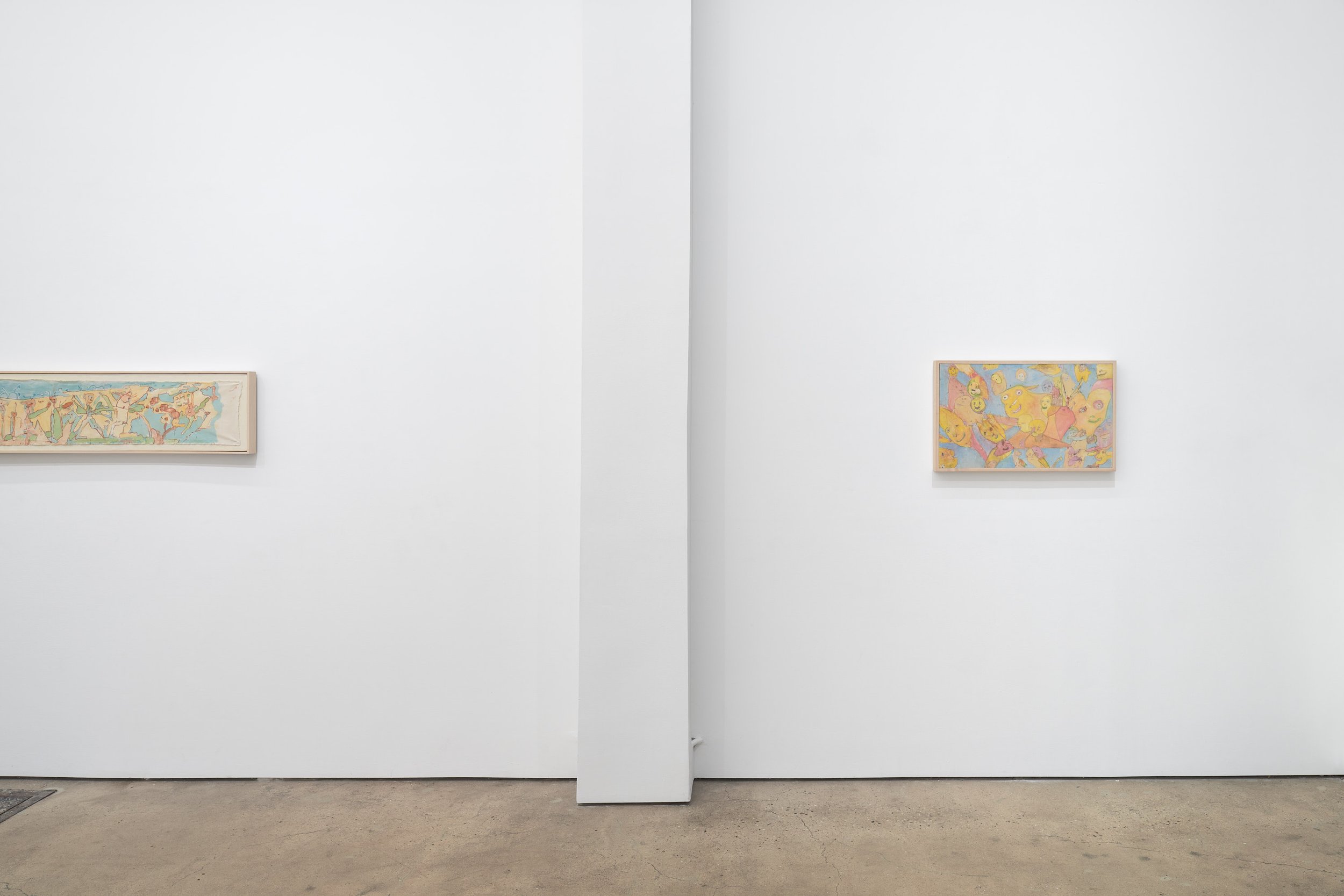
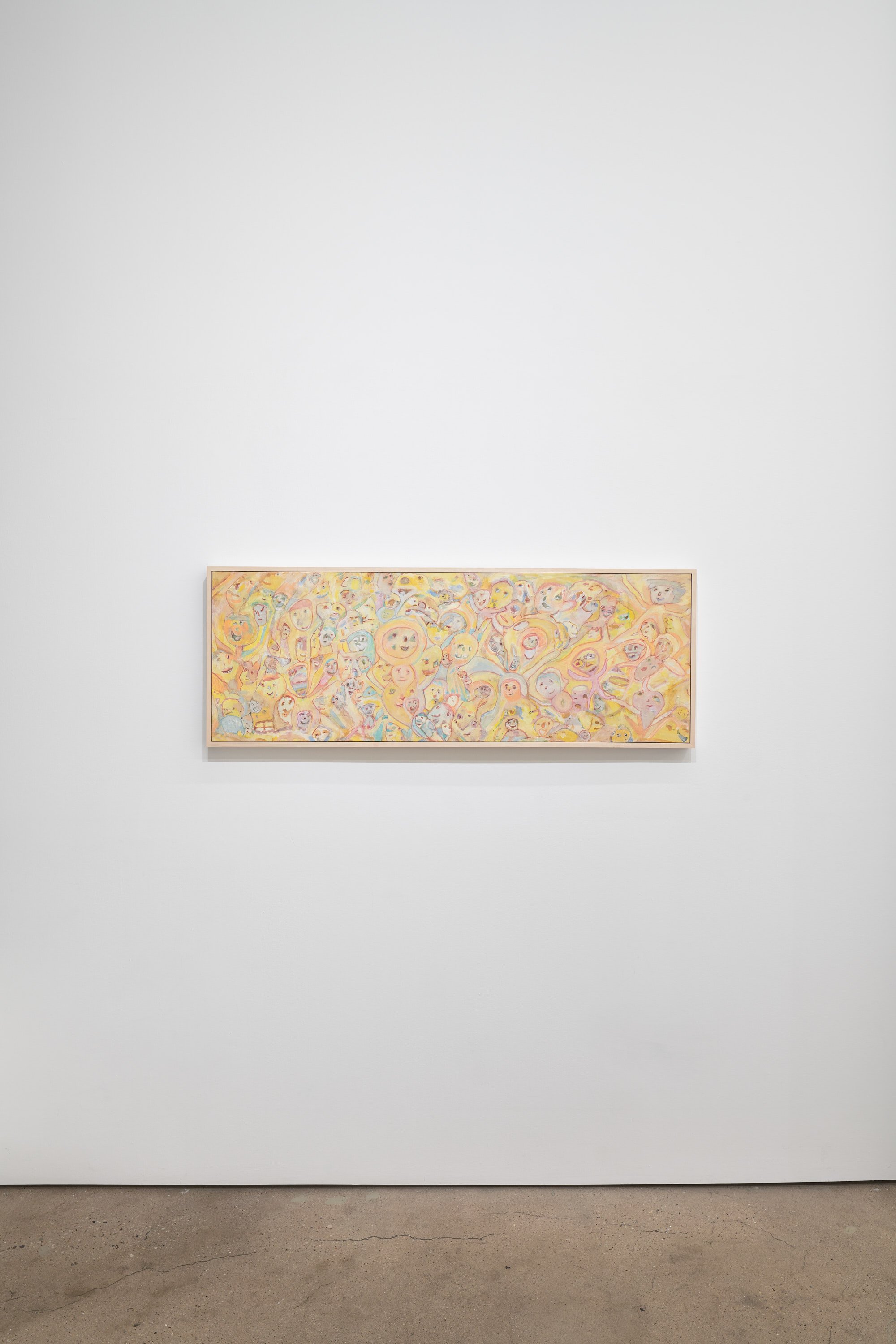
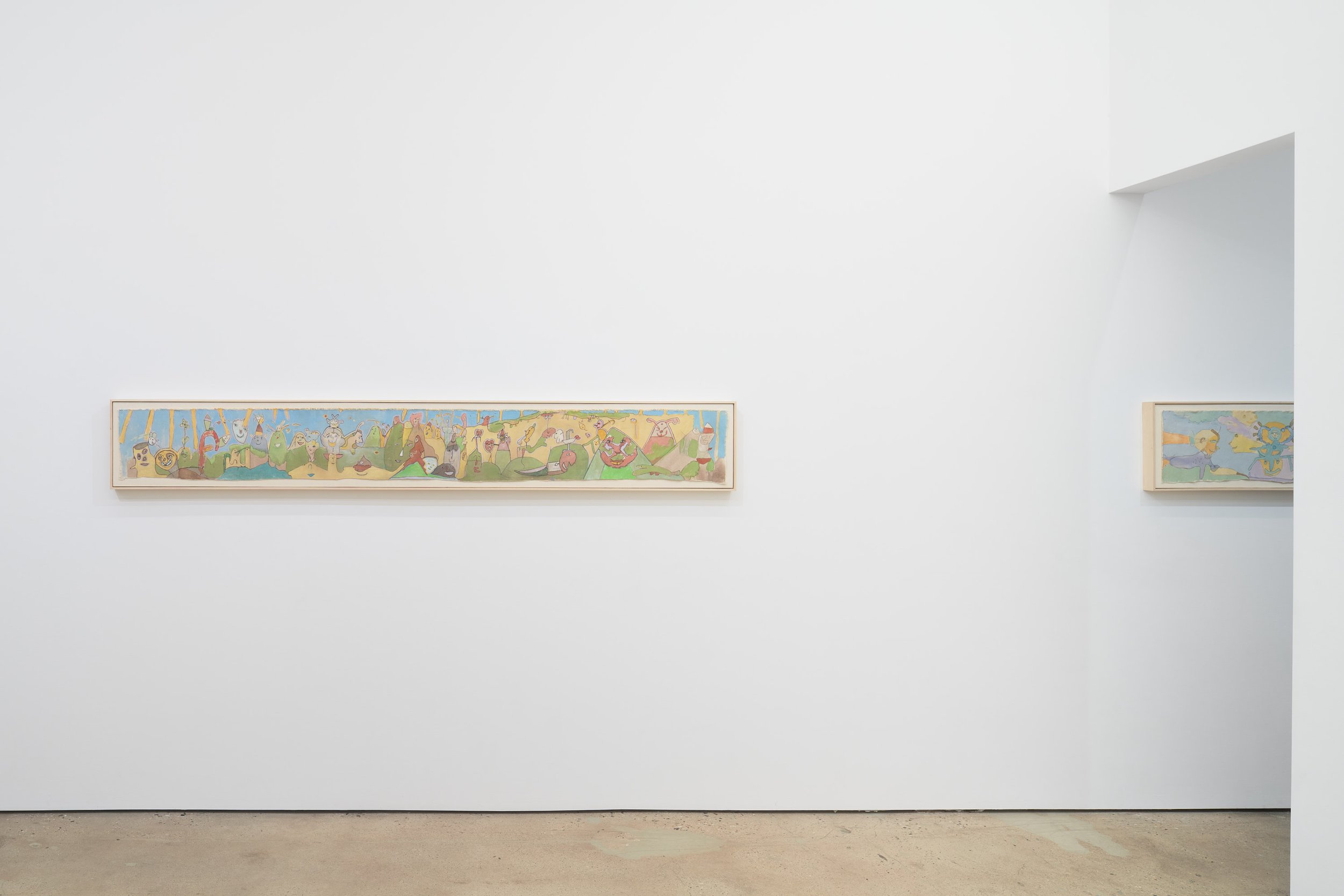
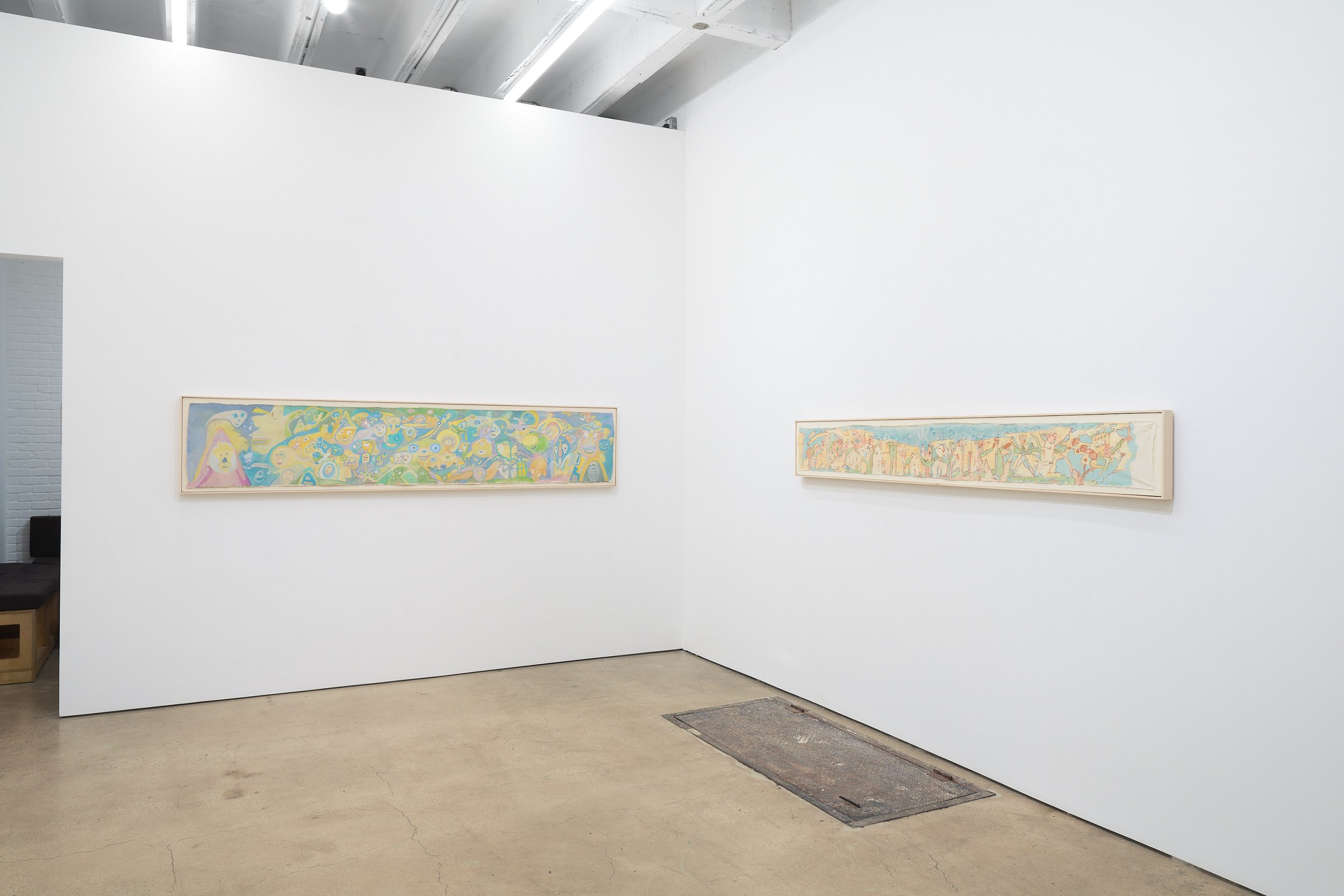

Installation view: Ross Simonini, Scrolls, 2024. François Ghebaly, New York. Courtesy of the Artist and François Ghebaly Gallery. Photo: Brad Farwell
The Scrolls invoke a feeling of narration through their rolling, longitudinal design. Across time and culture, the ‘long’ form has been a visual mode instrumentalized for the depiction of epics—stories that chart development, decline, and transformation.
Simonini’s images, fittingly described by the artist as ‘bachannals,’ recall the jostling, polychrome masked crowds of a James Ensor painting. Across the eight scenes that comprise Scrolls, streams of colorful, pareidoliac sprites aggregate in fête-like formations, at once jubilant, endearing, and hallucinatory. The artworks themselves are crafted from a list of materials with origins dating back to Fra Angelico frescoes and Greek antiquity: egg tempera, casein milk paint, and plain cotton. The almost sculptural sense of organic materials accentuates the animistic quality of Simonini’s painting. Milk and egg are, after all, building blocks of life.
Installation view: Ross Simonini, Scrolls, 2024. François Ghebaly, New York. Courtesy of the Artist and François Ghebaly Gallery. Photo: Brad Farwell
At the same time, Simonini is referencing the “scrolling” that has become our contemporary world’s primary means of beholding images, reading text and the various combinations of both we all encounter daily. To scroll is to enter a mode of perception that almost mirrors our natural, panoramic experience—a flowing motion that cannot be expressed in a single, static glance. Like an unfurling poem, an exploratory sentence or even a musical score, these scrolls must be felt one look at a time. Ross Simonini is an artist and writer based in Los Angeles. Simonini received his bachelor’s degree from the University of California and his MFA from Bennington College. Recent solo exhibitions include sun.works, Zurich; SHRINE, Los Angeles; Anonymous Gallery, New York; Sharjah Biennial 13, UAE; Et Al, San Francisco. and Shoot the Lobster, Luxembourg. Recent group exhibitions include Vielmetter, Los Angeles; François Ghebaly, Rome; and Altman Siegel, San Francisco.
For more information about this exhibition and others please visit the François Ghebaly gallery here. The gallery can also be found on Instagram, Artsy, and Facebook.
Tavares Strachan: Magnificent Darkness
(Front view) Inner Elder (Mary Seacole), 2023 Inner Elder (Biko as Septimius Severus), 2023 Inner Elder (Nina Simone as Queen of Sheba), 2023 Ceramic (Background) Andromeda (Green, Pink and White Galaxy), 2023 Sunflower (Yellow, White, and Blue Galazy), 2023 Cartwheel Galaxy (Blue, Purple, Red and White Galaxy), 2023 Oil, enamel and pigment on acrylic Installation view, Tavares Strachan "Magnificent Darkness" Marian Goodman Gallery, Los Angeles, 2024 Courtesy of the artist and Marian Goodman Gallery Photo credit: Elon Schoenholz
Marian Goodman Gallery Los Angeles is pleased to announce a solo exhibition of Tavares Strachan. The exhibition had an opening reception on February 17th and will conclude on April 13, 2024. Titled Magnificent Darkness, this immersive exhibition will feature several new bodies of work across six diverse and site-specific environments. Through an interconnected array of works comprising ceramic, bronze, marble, hair, neon, sound, and painting, this exhibition collectively professes a visual allegory toward the overarching exploration of light and darkness.
Encyclopedia of Invisibility (Pocket Guide), 2024 Leather, gilding, archival paper, lucite box and stand Overall: 9 1/4 x 12 1/8 x 10 in. (23.5 x 30.8 x 25.4 cm) Installation view, Tavares Strachan "Magnificent Darkness" Marian Goodman Gallery, Los Angeles, 2024 Courtesy of the artist and Marian Goodman Gallery Photo credit: Elon Schoenholz
Strachan’s work summons historical and cultural references, creating essential contextual collisions and connections to his celebrated, ongoing research project, The Encyclopedia of Invisibility. For this exhibition, a central installation from the Encyclopedia forefronts the surrounding gallery spaces, bringing light to a number of ‘invisible histories’ that have largely fallen by the historical wayside. A special, smaller format of the Encyclopedia in book form will also be on view. Nearby, a new work in neon, There is a Light in Darkness, draws on the words of James Baldwin and serves as the source for the audio work that can be heard throughout the exhibition space.
In the Seward Gallery, a vast and transportive earthen floor grounds two near-life-sized ceramic sculptures, Matthew Henson (Hunter’s Shirt Stacked with Football and Spear) and Andrea Crabtree (Potter’s Shirt Stacked with Diver’s Helmet), representing the figures of Matthew Henson, the African American explorer who discovered the North Pole, and Andrea Motley Crabtree, the first African American female diver for the U.S. Navy. Themes intrinsic to Strachan’s practice—ranging from human aspiration to the chronicle of elided histories—are evoked here through depictions of Arctic exploration and deep-sea discovery. Clay, as integral to human evolution and the creation story, is found repeatedly throughout the exhibition, from the Seward Gallery floor to the numerous ceramic sculptures on view.
Mind Field No. 1, 2023 Flocked hair on canvas 60 x 60 x 2 in. (152.4 x 152.4 x 5 cm) Amina (A Map of the Crown), 2023 Bronze, flocked hair 23 5/8 x 9 7/8 x 5 7/8 in. (60 x 25 x 15 cm) Installation view, Tavares Strachan "Magnificent Darkness" Marian Goodman Gallery, Los Angeles, 2024 Courtesy of the artist and Marian Goodman Gallery Photo credit: Elon Schoenholz
In an intimate space off the main lobby sits Amina (A Map of the Crown), a bronze bust sculpture adorned with a traditional West African hairstyle. The closeness of these materials offers an insightful reconciliation of the distance between the deeply personal, political, and present nature of hair and the venerable qualities bestowed upon bronze sculpture—some of the earliest and most accomplished bronze works date to Africa in the 10th century. A new series of paintings also debuts here. Mind Field No. 1 sits in dialogue with Amina, together begetting references ranging from the history of the monochrome to metaphorical notions of hair as a protective layer, symbol of knowledge, and means for communication and transport.
Jah Rastafari with Rice Field (Stacked with Pineapple, Shield, and Football), 2023 Ceramic, rice field installation 110 1/4 x 59 x 59 in. (280 x 149.9 x 149.9 cm) Installation view, Tavares Strachan "Magnificent Darkness" Marian Goodman Gallery, Los Angeles, 2024 Courtesy of the artist and Marian Goodman Gallery
In the adjacent Hudson gallery, a ‘meadow’ of dried rice grass transforms the space into a landscape, referencing rice as a staple of the Afro-Caribbean diet. Viewed from above, the terrain is shaped in the form of the Ghanaian Adinkra symbol for Nsaa, which symbolizes quality and durability, and metaphysically denotes excellence and authenticity. The dramatic floorscape finds its focal point in Jah Rastafari (Stacked with Pineapple, Shield and Football), 2023, a multifaceted ceramic sculpture illustrating a bricolage of spiritual and cultural forms from disparate centuries.
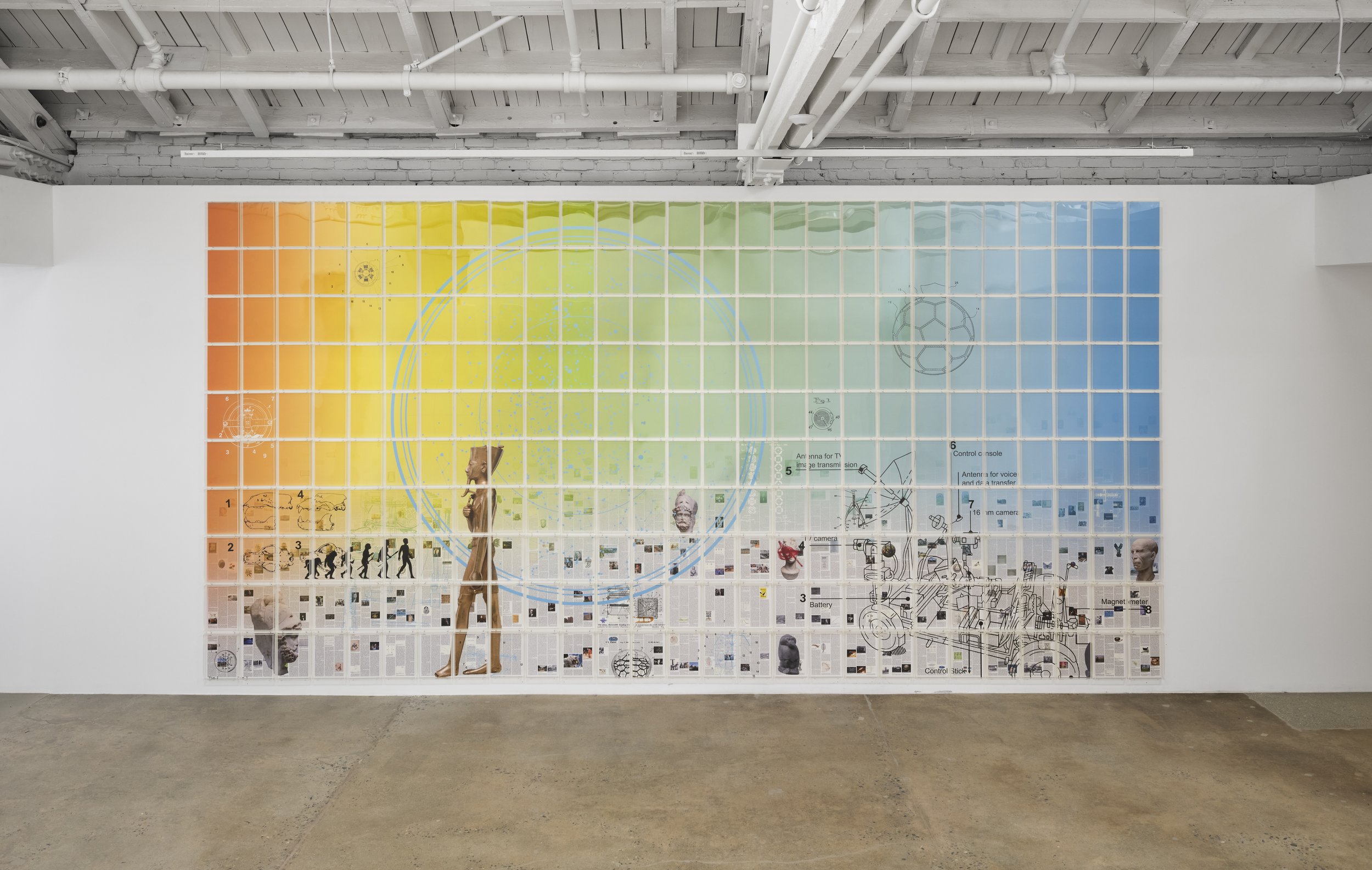
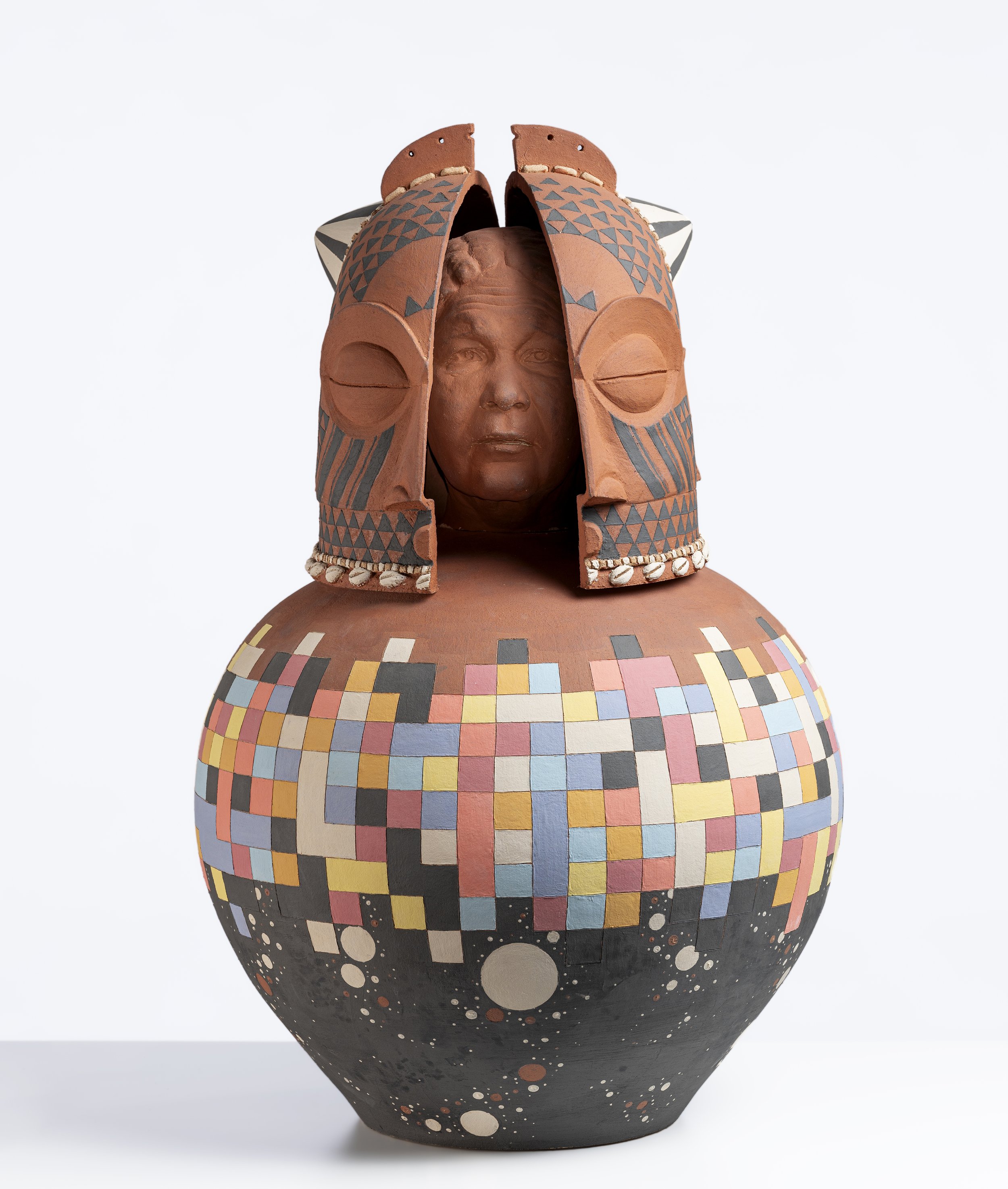

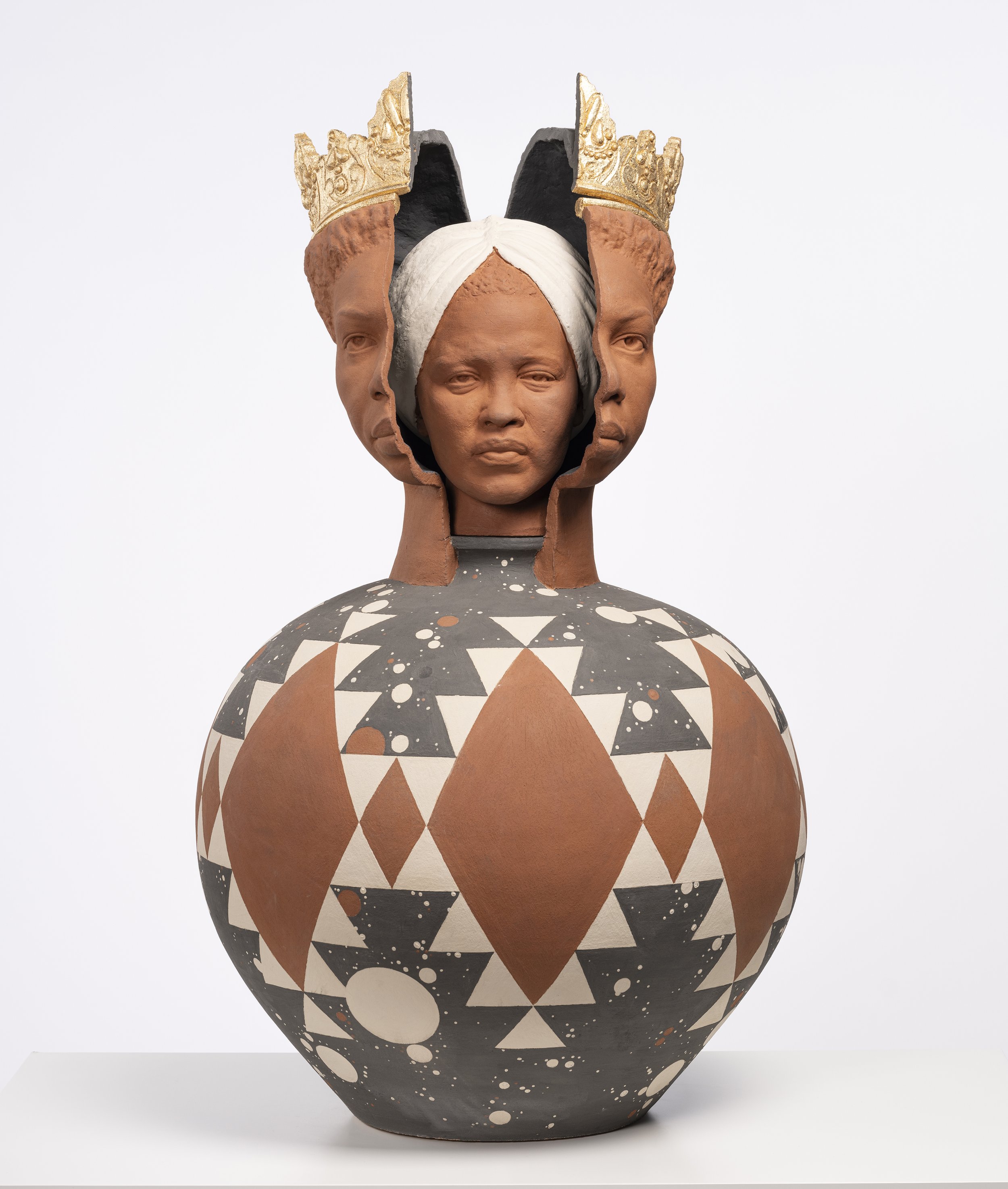
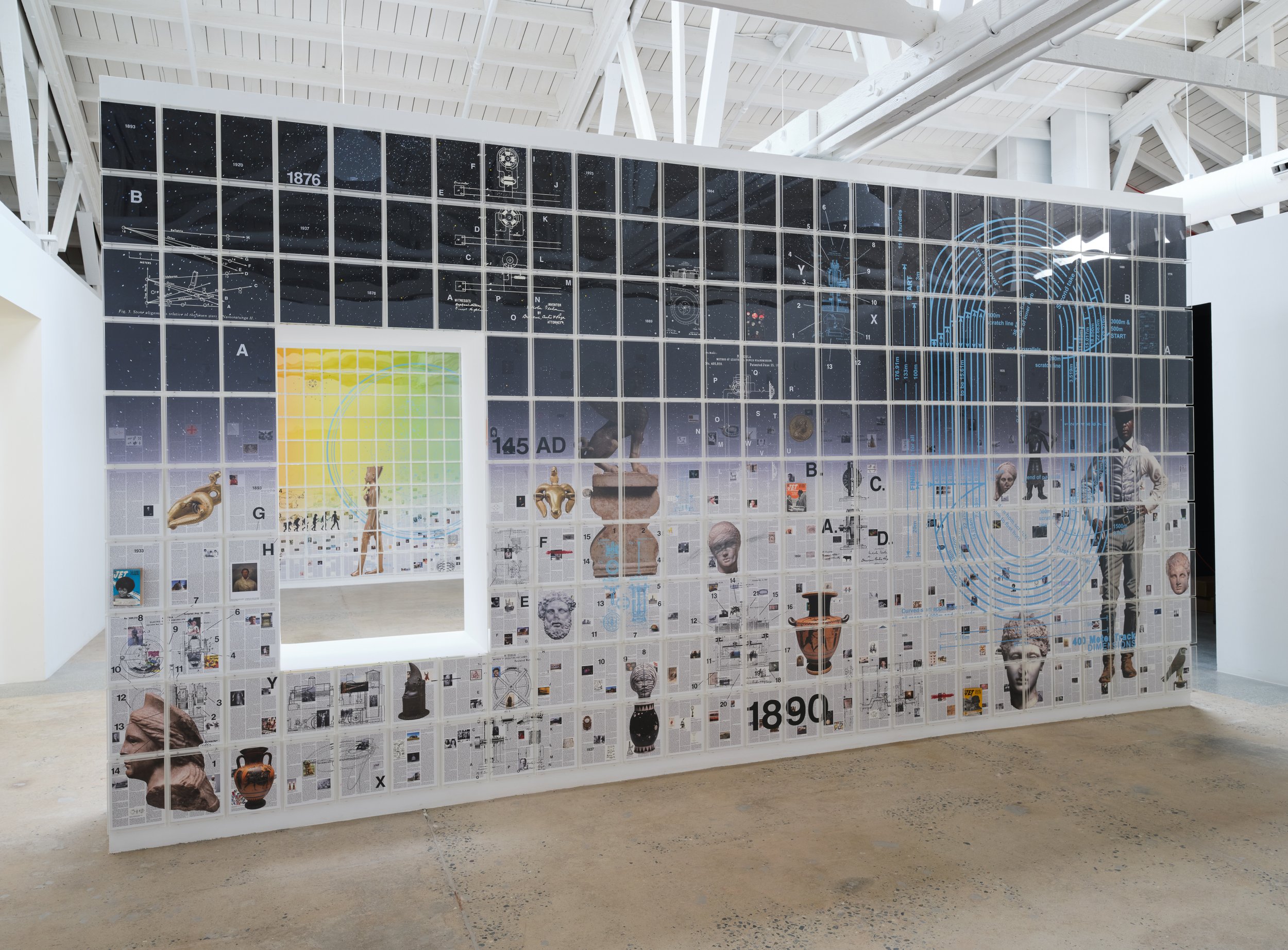
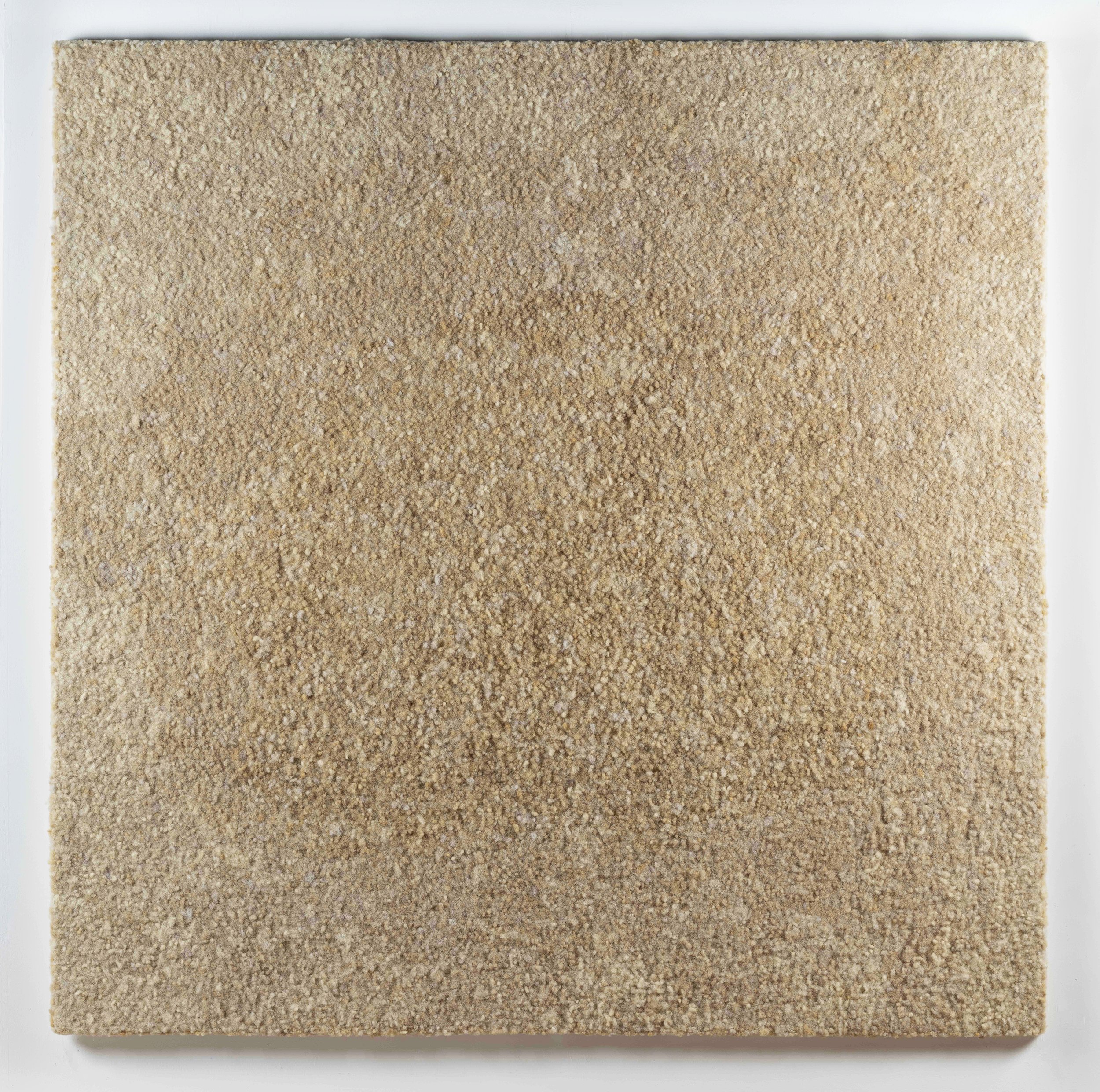
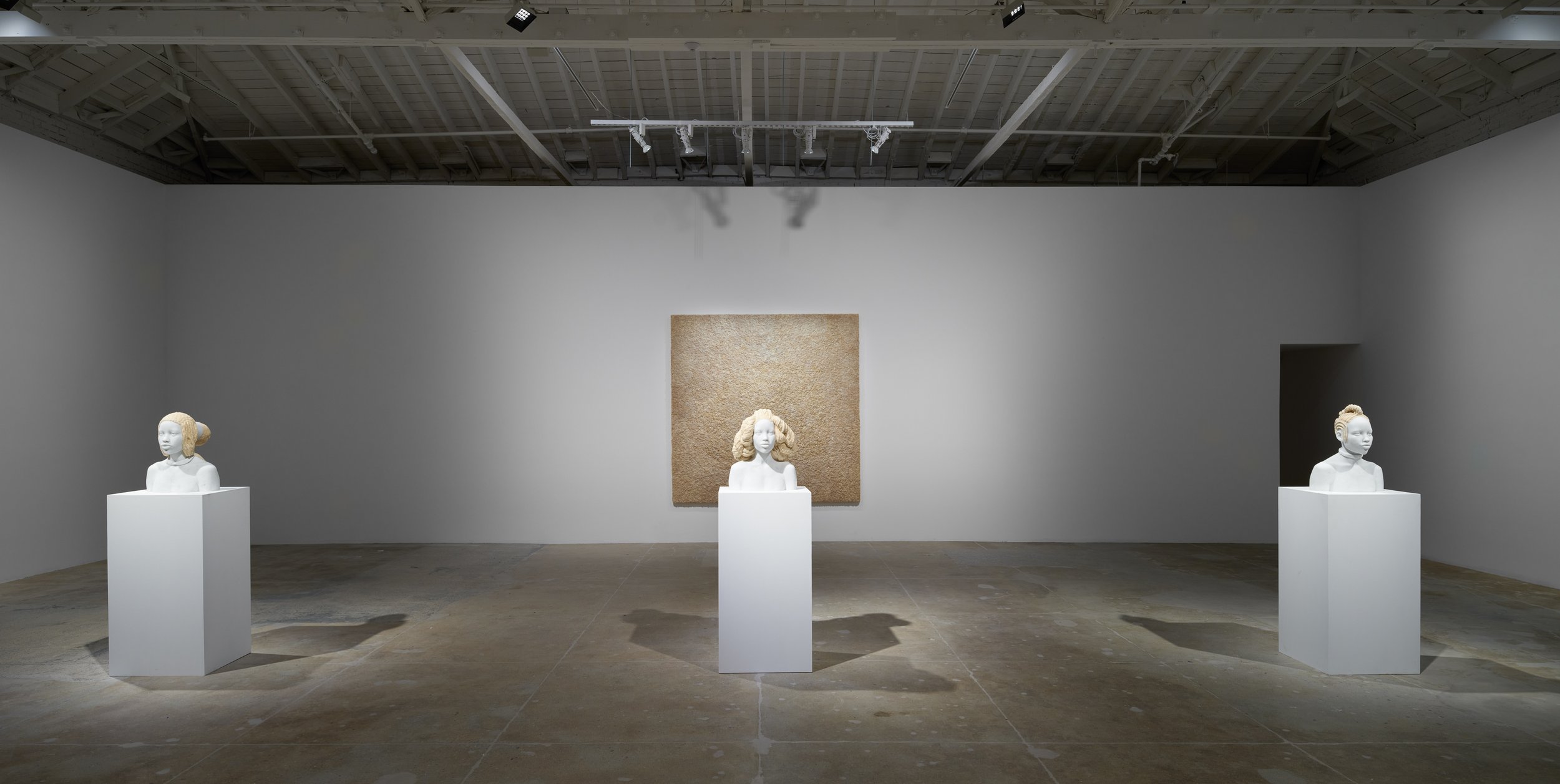
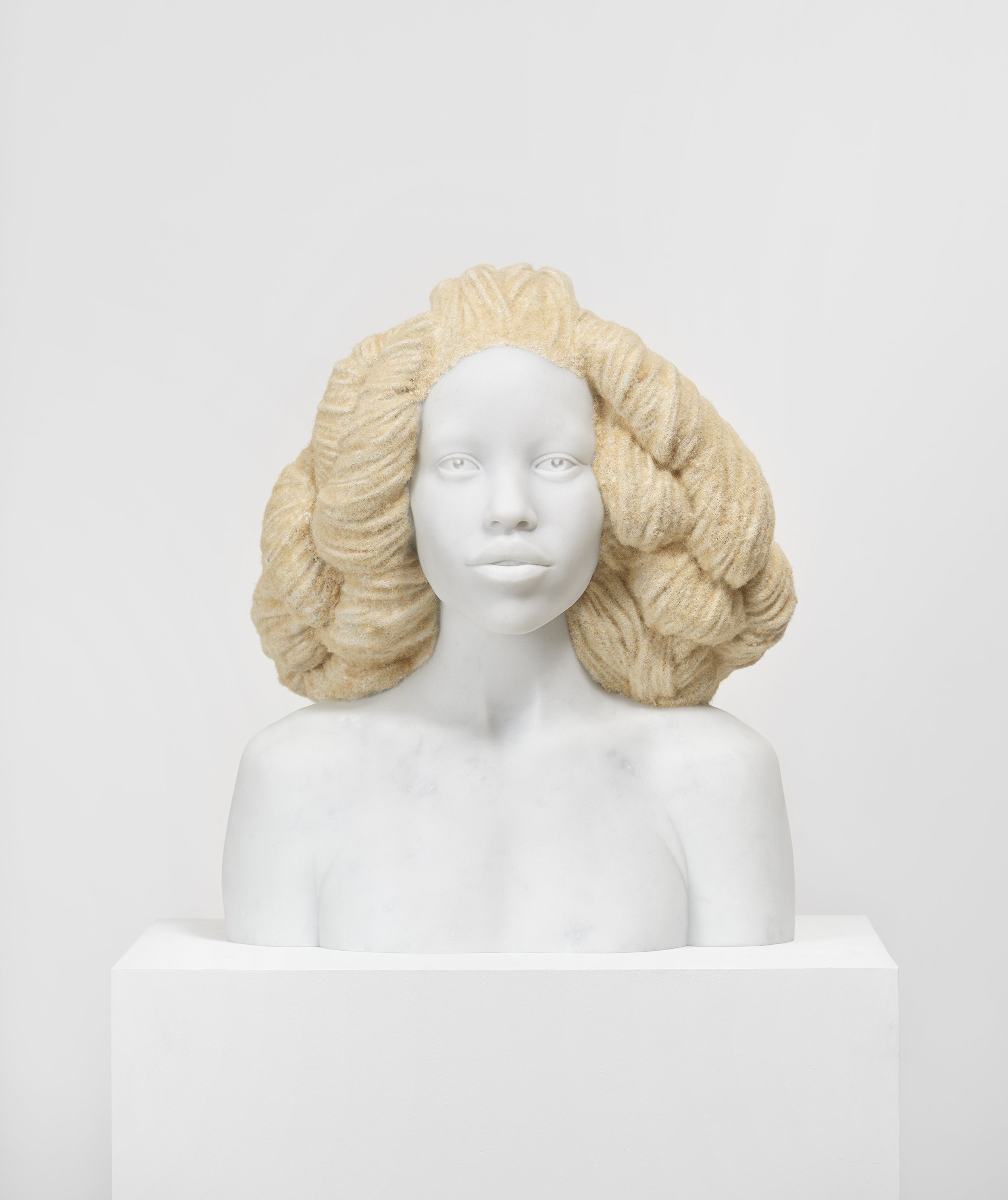
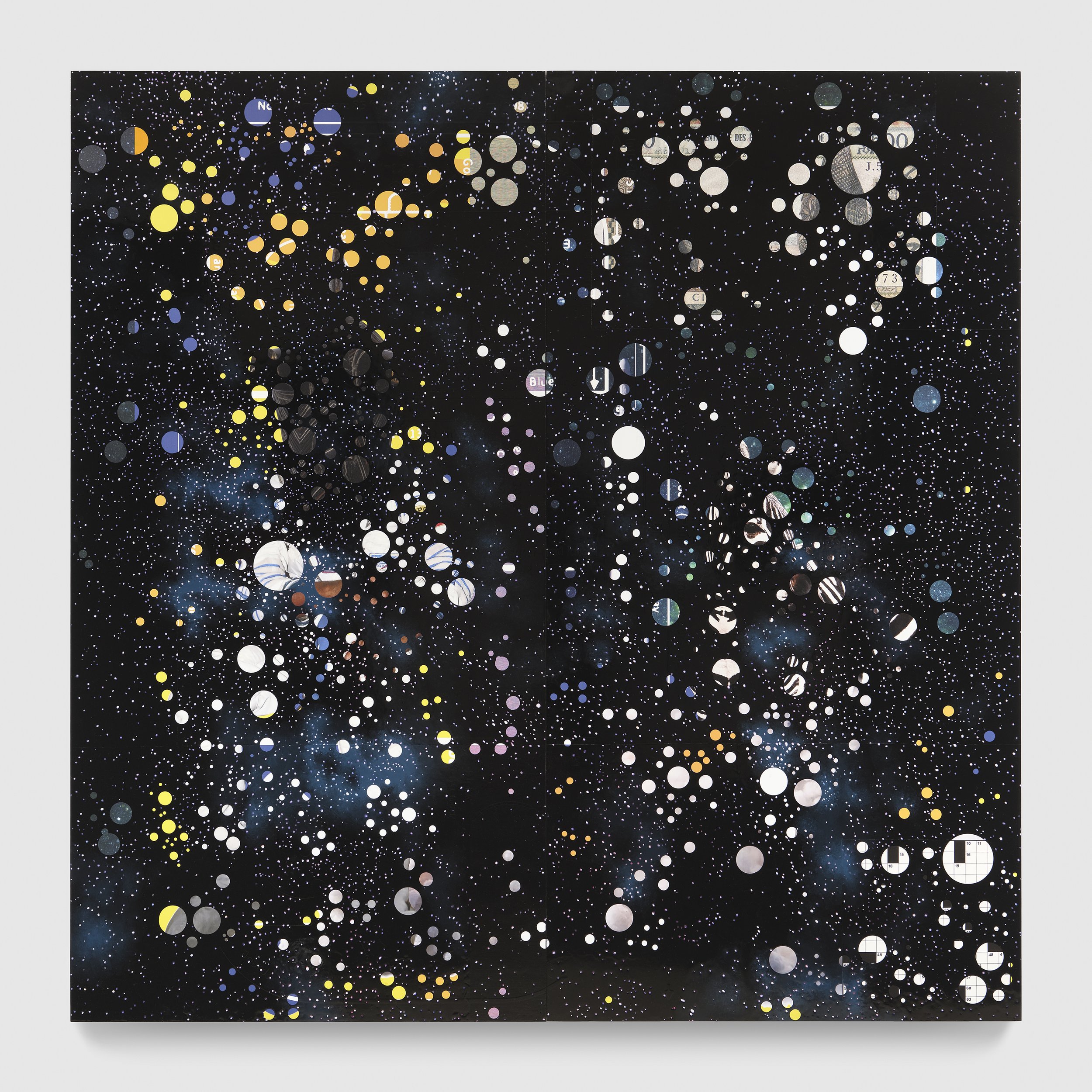
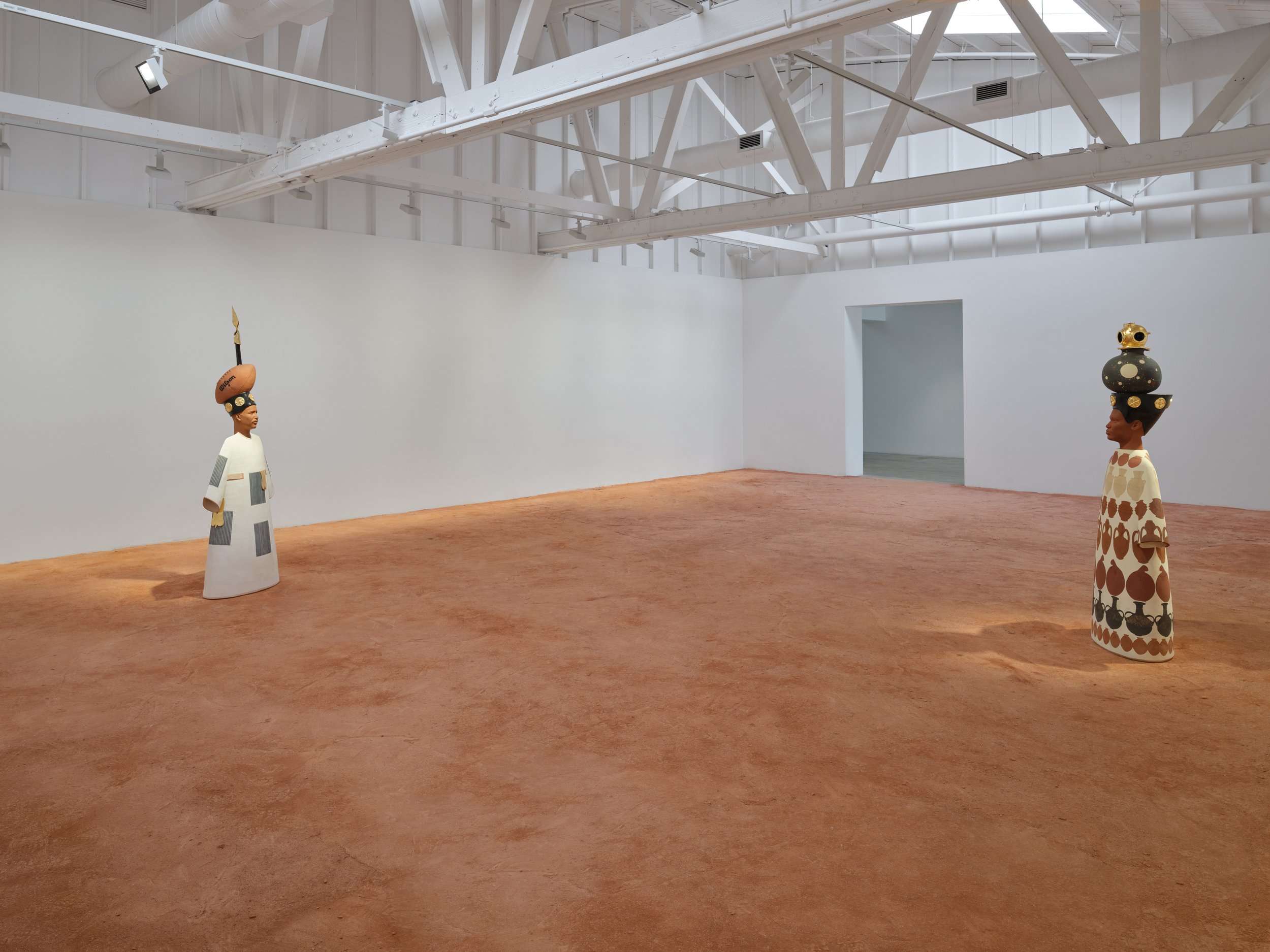
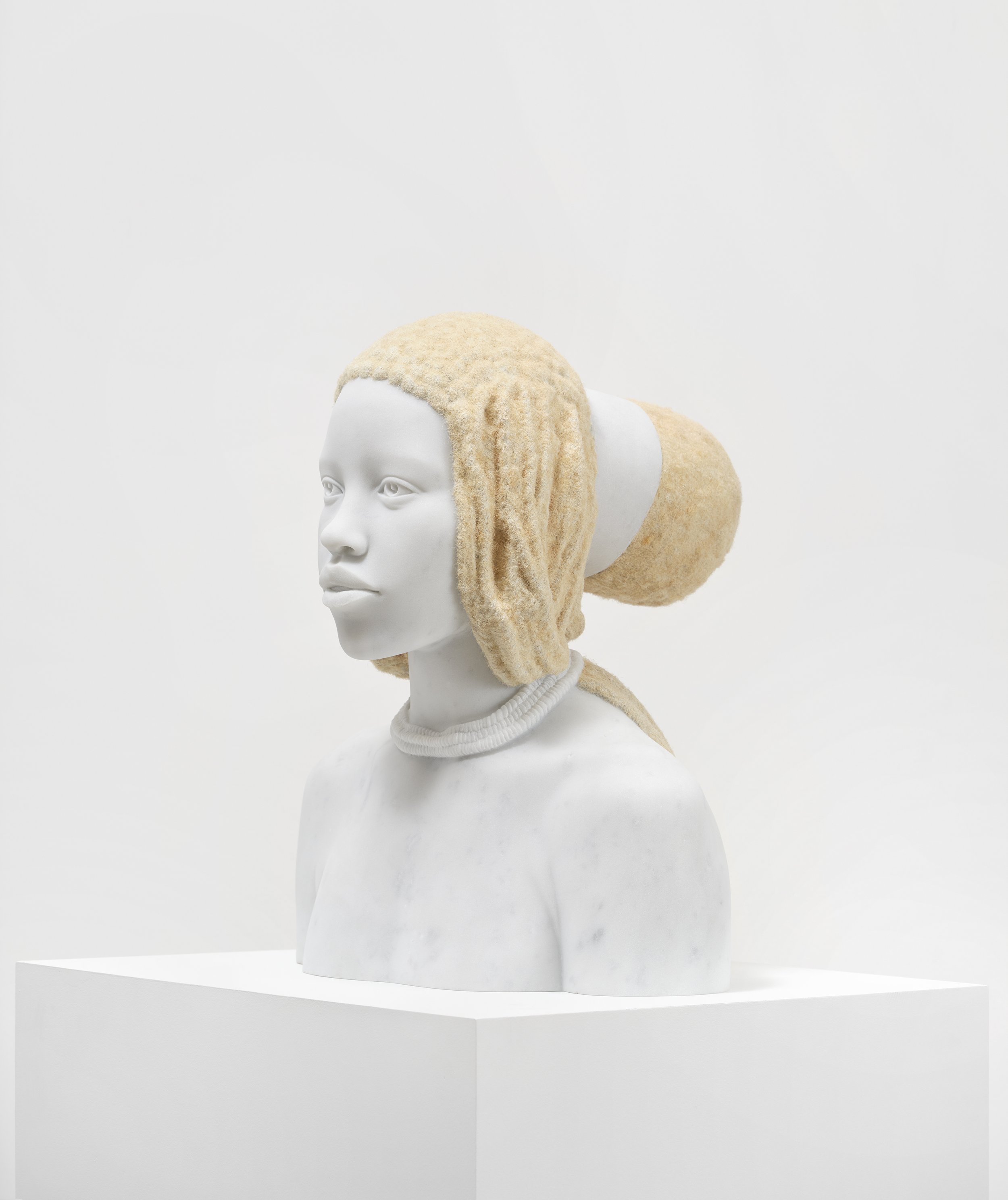
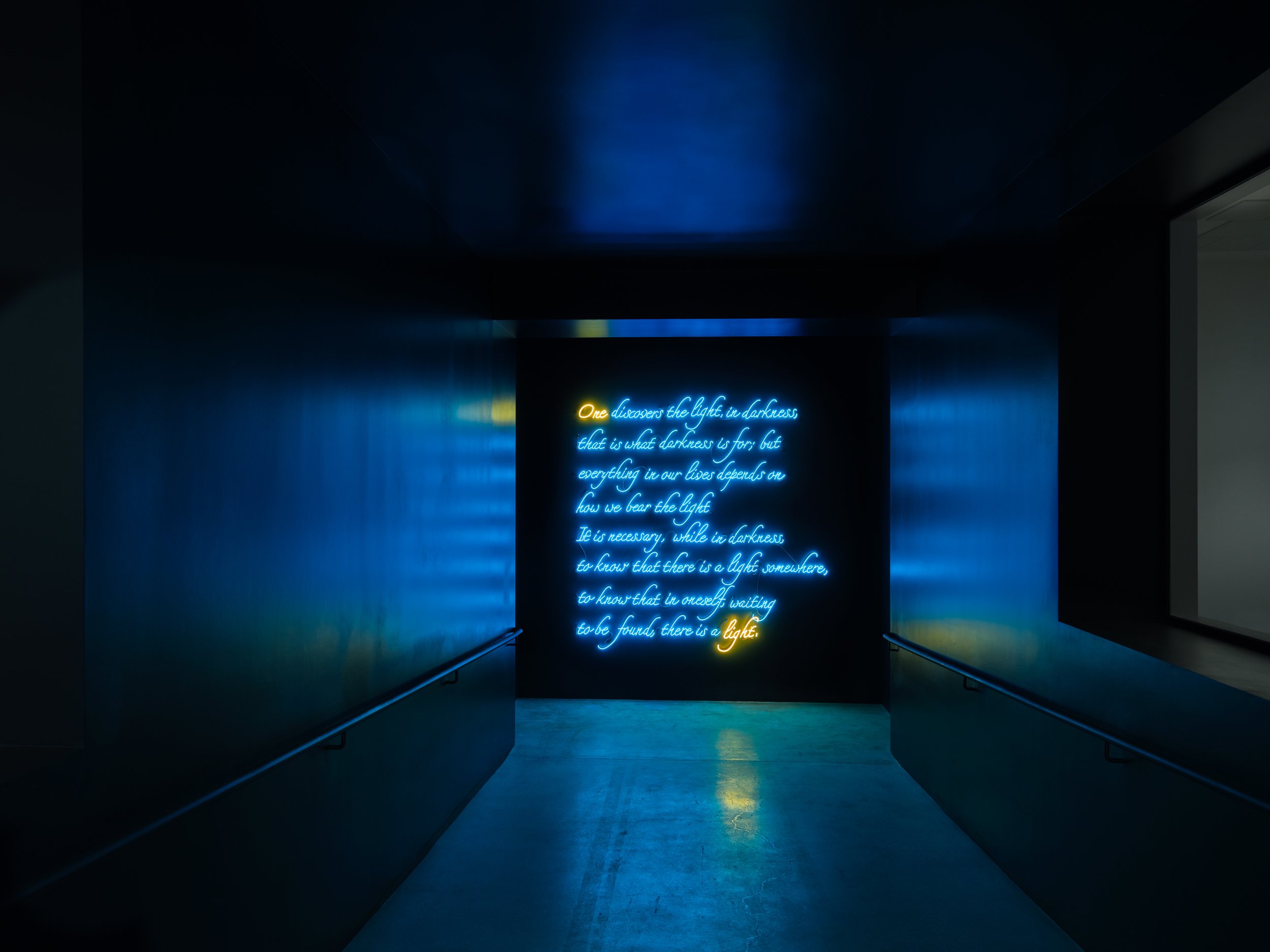
The Main Gallery continues the dialogue of the interrelation of light and darkness opening with the related words of Baldwin. Split in two, the divided spaces become each other’s complements. In the darkness of one half, new Galaxy paintings, depicting distant constellations and galaxies as symbols of the invisible systems that structure our world, are placed in relation to three ceramic sculptures: Inner Elder (Mary Seacole); Inner Elder (Biko as Septimius Severus); and Inner Elder (Nina Simone as Queen of Sheba), historical figures who carry their own symbolic cosmology and are symbols of a lost language. These works explore the traditions of storytelling in West African and Afro-Caribbean cultures, serving the dual purpose of vessels made of earth that host the daily materials of rice and water, and canvases to document stories through symbols and patterns. The contrasting, light-filled gallery presents a white painting of hair, Mind Field No. 8, alongside three white marble sculptures, Makeda (A Map of the Crown), Moremi (A Map of the Crown), and Amanirenas (A Map of the Crown), collectively drawing questions around whiteness and related visual discourses of ancient sculpture.
Current and upcoming projects include a new sculptural installation, The First Supper, presented in the context of an exhibition at the Royal Academy of Arts, London, and a solo exhibition at the Hayward Gallery, London, to open in June 2024. Two new publications, The Awakening and In Total Darkness, have been published by Marian Goodman Gallery and will be available during the exhibition.
Strachan was born in 1979 in Nassau, Bahamas, and currently lives and works between New York City and Nassau. He received a BFA in Glass from the Rhode Island School of Design in 2003 and an MFA in Sculpture from Yale University in 2006. He draws on both the resources and community of his birthplace, dividing his time between his studio in New York and Nassau, where he has established an art studio and scientific research platform B.A.S.E.C. (Bahamas Aerospace and Sea Exploration Center) and OKU, a not-for-profit community project encompassing an artist residency and exhibition spaces, a scholarship program, and after-school creative programs.
Strachan’s work has been featured in numerous solo exhibitions including You Belong Here, Prospect 3. Biennial, New Orleans (2014); The Immeasurable Daydream, Biennale de Lyon, Lyon (2013); Polar Eclipse, The Bahamas National Pavilion 55th Venice Biennale, Venice (2013); Seen/Unseen, Undisclosed Exhibition, New York (2011); Orthostatic Tolerance: It Might Not Be Such a Bad Idea if I Never Went Home Again, MIT List Visual Arts Center, Cambridge (2011); among others.
He has been the recipient of numerous awards including the John D. and Catherine T. MacArthur Foundation fellowship (2022), Artist in Residence at the Getty Research Institute (2019-2020), the Frontier Art Prize (2018), and the Allen Institute’s inaugural artist-in-residence (2018), LACMA Art + Technology Lab Artist Grant (2014), Tiffany Foundation Grant (2008), Grand Arts Residency Fellowship (2007), and Alice B. Kimball Fellowship (2006). In his TED talk in April 2023, Strachan discussed the need to restore lost stories, as exemplified within his work, The Encyclopedia of Invisibility.
For more information about the exhibit, please visit the Marian Goodman Gallery’s site. The gallery can be found on Instagram and Artsy, too.
Justine Mahoney: VIGIL
Image courtesy of Hayden Phipps/Southern Guild.
Southern Guild Cape Town presents VIGIL, a solo exhibition of ceramic sculptures and paintings by South African artist Justine Mahoney, which opened on February 8th and will end on May 23rd, 2024. In this exhibition, the artist reimagines the 12 Jungian archetypes in a series of sculpted figures and large-scale paintings on heavy-weight fabric. Rooted in a wealth of esoteric theory, Mahoney’s archetypes embody and mythologize facets of the collective human unconscious.
The King courtesy of Hayden Phipps/Southern Guild.
Over an extended period of isolation during the pandemic, Mahoney began a daily practice of self-enquiry through Jungian meditation. Encountering what Swiss psychiatrist Carl Jung referred to as “Mythopoetic Imagination” – the dark and fertile landscape of active imagination – the artist conjured vivid manifestations of each archetype. Jung believed these archetypal models underpinned man’s innate and universal personas, behaviours and motivations. They appeared to Mahoney as messengers, carriers from the invisible terrain, arriving as “giant psychic forces” from within. She crystallised their final forms after extensive research into Tarot, Plato’s theory of forms, and a close reading of Jung’s journals (The Black Books) and manuscripts (The Red Book: Liber Novus). She also drew heavily from esoteric knowledge systems that pre-date the advent of Judeo-Christianity. Treating imaginative thought and fantasy as vital creative functions, VIGIL surfaces from a subversive reality; one that belies rationality to ground itself more freely in the ancient, essential and human.
Love courtesy of Hayden Phipps/Southern Guild.
Mahoney’s process of sculpting this body of work echoes the digital collages in her previous series. Shaping the clay into the desired form, each figure was then deconstructed – bisected, hollowed out, interchanged and reassembled to take their final expression. This act of disruption and reconfiguration extends throughout Mahoney’s three decades-long career, which has been characterised by a preference for transgressive, hybridised figuration. This hybridity is the result of a distinct self-awareness that has seen the artist remain active in and awake to both the making of her work and the larger examination of her own identity.
The works in VIGIL regard the figure as an amorphous vessel, transforming each body into irregular contortions. Mother arches backward, life-giving milk flowing from her breasts as 10 fingers reach through her stomach as if growing from within. She is the creator and destroyer, both the abundant life-force and the abyss. The Child looks skyward, mouth agape, holding up two large hands in what could be interpreted as either acquiescence or protest. The figure stands at the precipice of a new beginning, the cosmic infant of boundless possibility. The Wanderer, wearing a hooded cloak, eyes peering out from a painted face of red, holds the head of a wolf. They are the hungry seeker, returning with the spoils from the divine hunt. Some figures read as plant-like, with braided hair or limbs reaching downward to ground themselves in the earth. Mahoney considers these apparitions as the denizens of our inner worlds, encompassing the duality and rapture of our universal humanity.
The painted earthenware figures stand on ebonised plinths of indigenous cedar and pine, which Mahoney treated using the centuries-old Japanese wood-burning technique of Shou Sugi Ban. Each plinth has been torched with a flamethrower, blackening the wood before being sealed with an ebony stain.
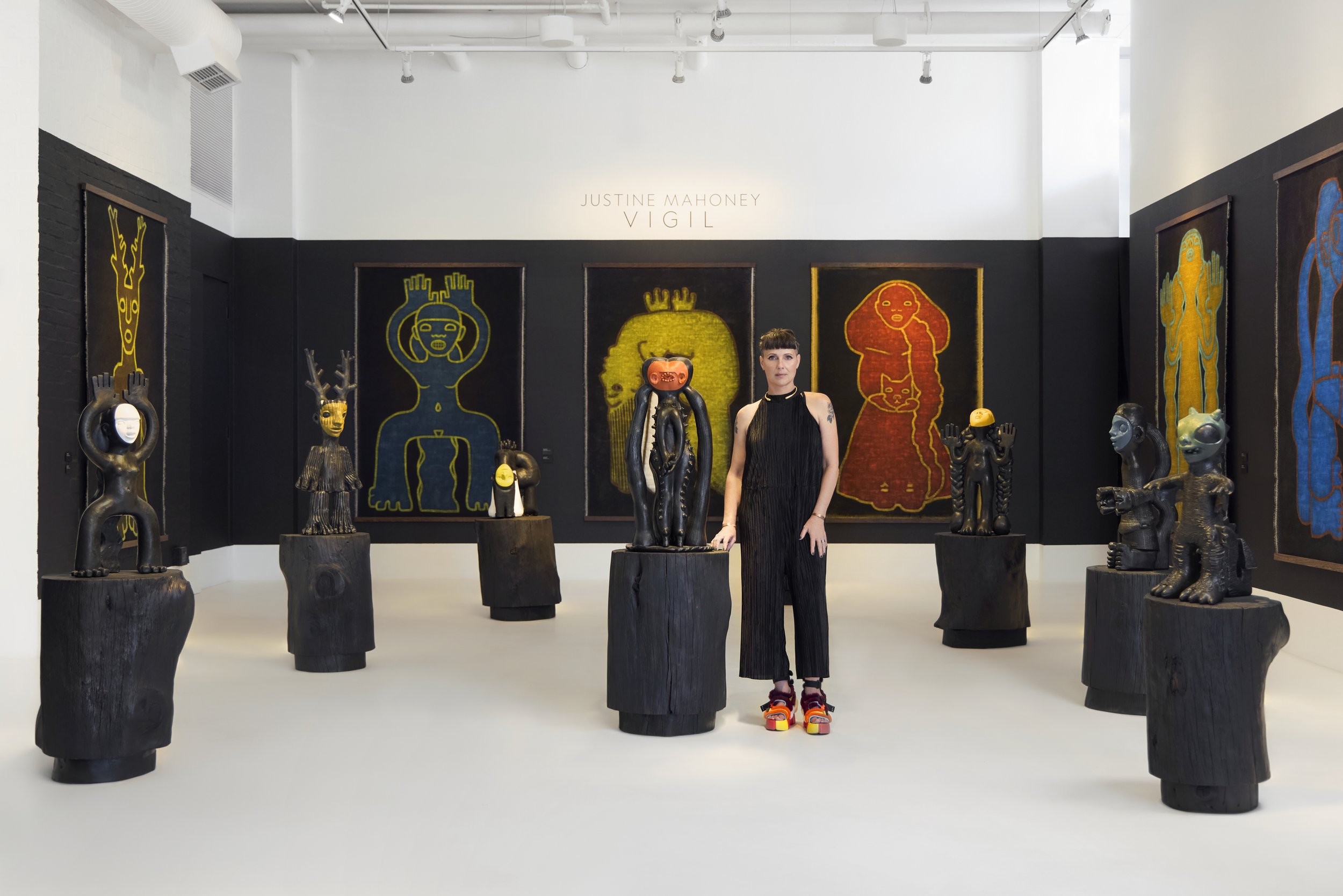
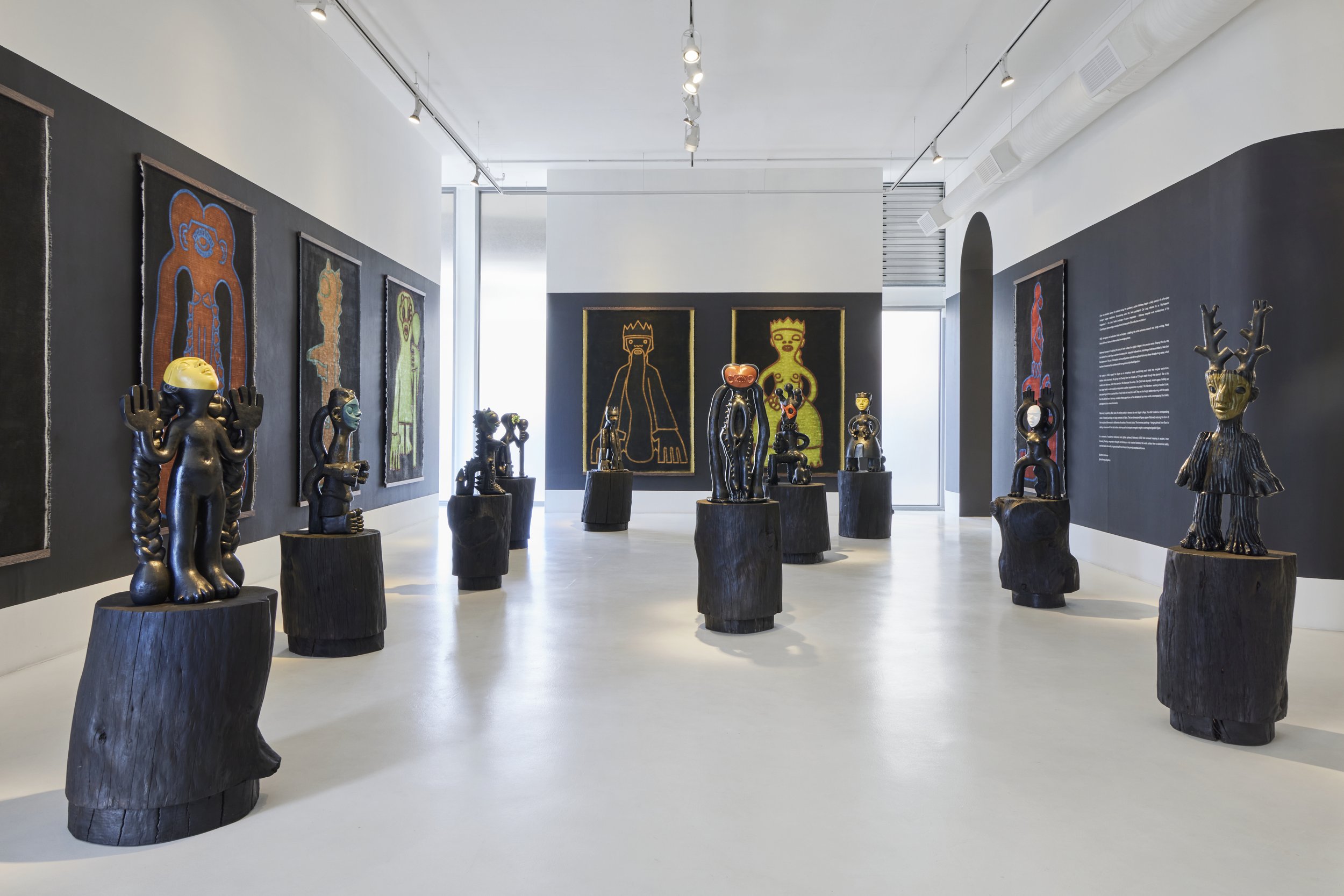

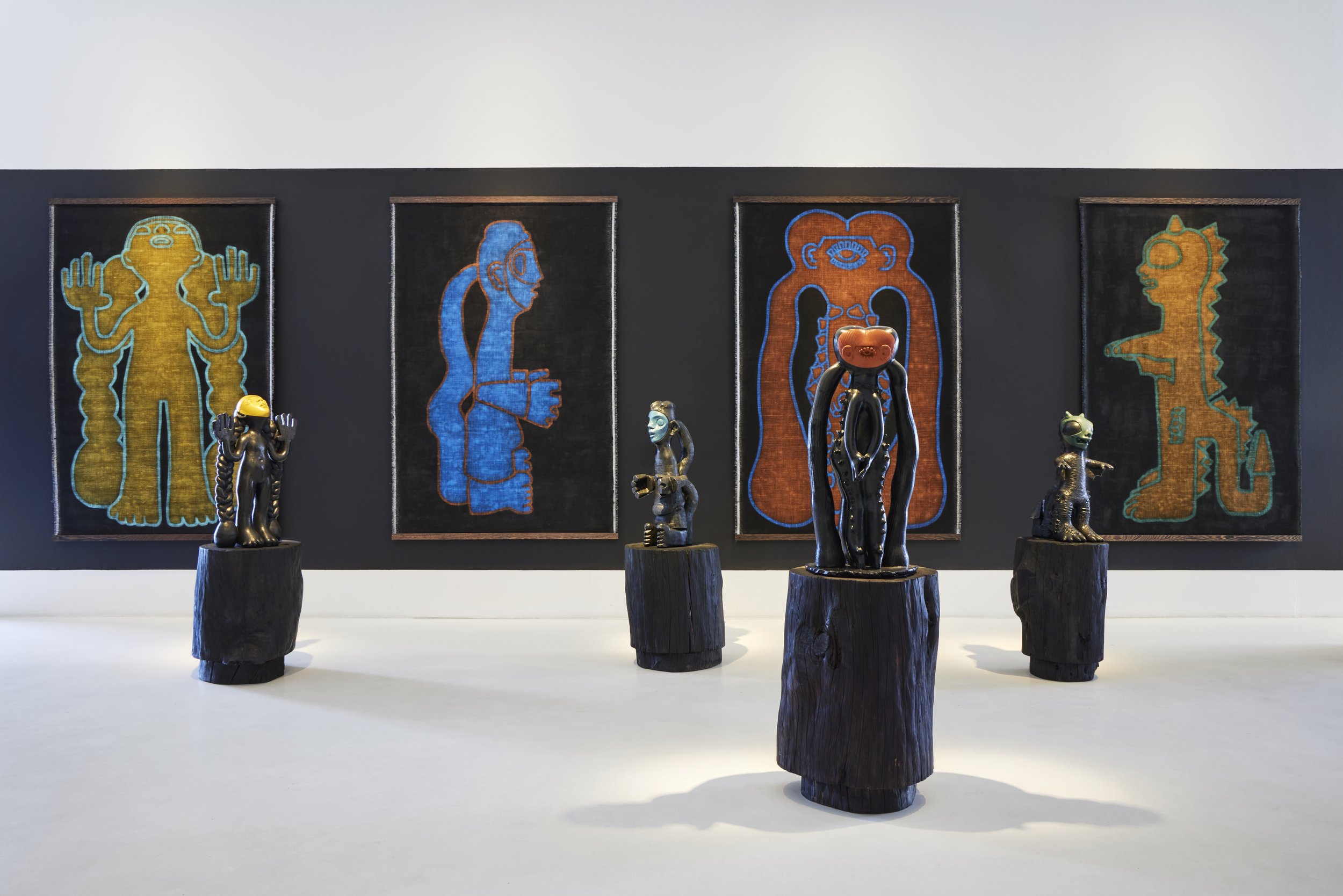
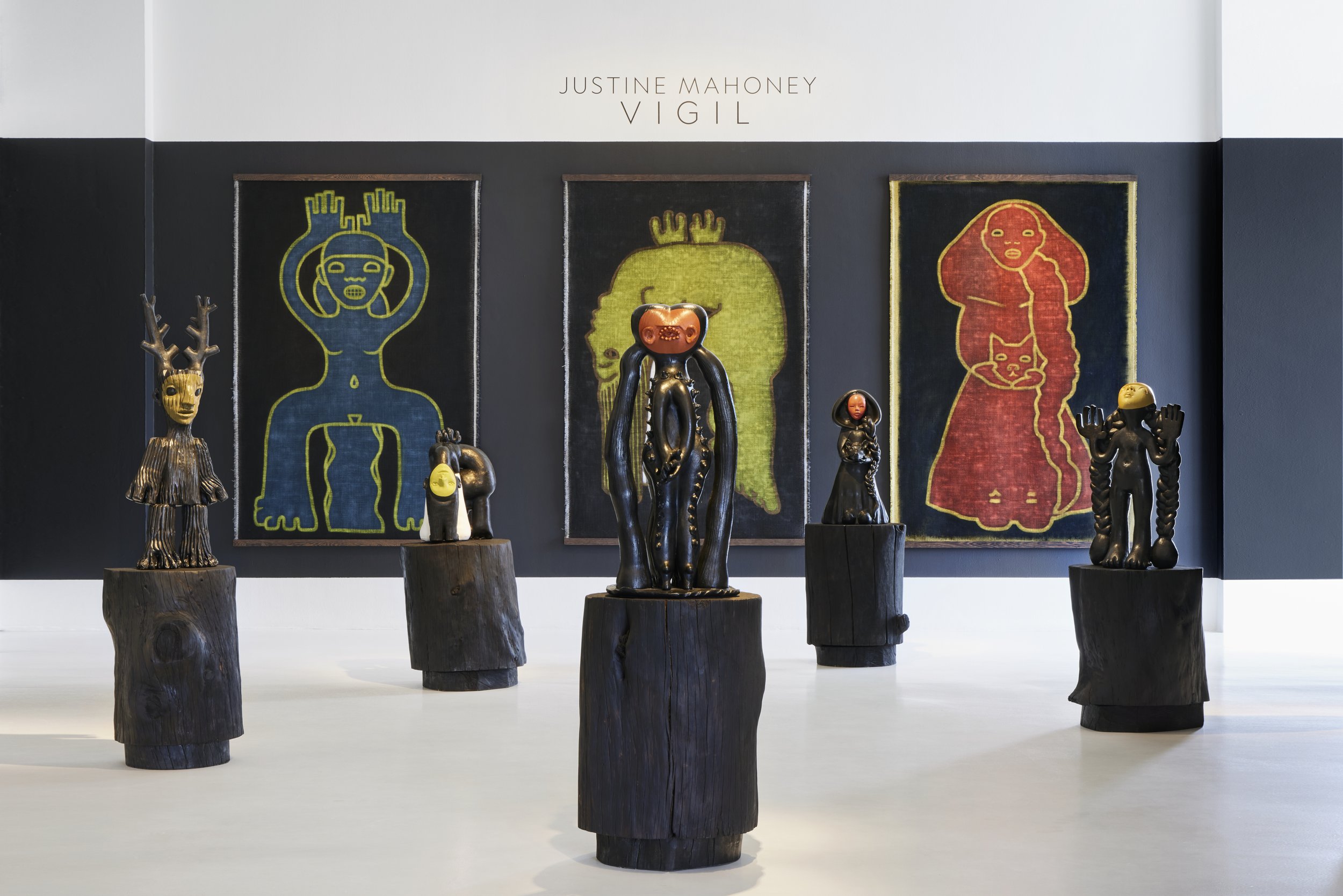
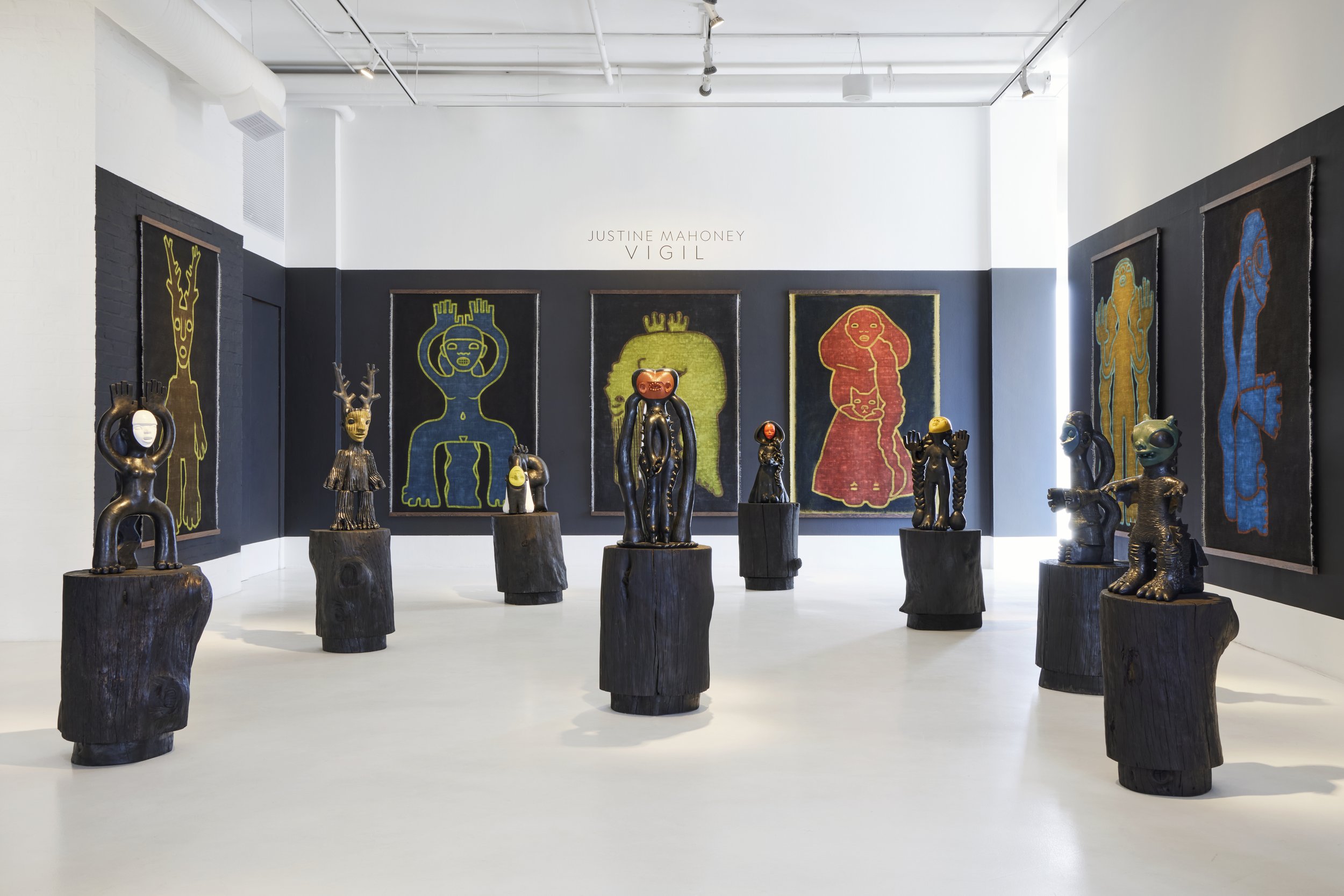
Installation view of Justine Mahoney: VIGIL Southern Guild Cape Town. Image courtesy of Hayden Phipps/Southern Guild.
Returning to painting after years of working solely in bronze, clay and digital collage, the artist created a corresponding series of enamel paintings on large segments of fabric. The two-dimensional figures appear flattened, reducing the form of their sculptural likenesses to deliberate silhouettes of line and colour. The immense paintings – hanging almost from floor to ceiling - converse with the clay bodies, retaining each archetype’s energetic weight in a reimagined graphic figure.
In a moment of epistemic restlessness and global upheaval, Mahoney’s VIGIL finds renewed meaning in ancient, inner knowing. The body of work elevates the primal and perhaps forgotten knowledge of our collective humanness and shared mythologies.
VIGIL by Justine Mahoney runs concurrently with Dzuvula (Shedding Skin) by Rich Mnisi at Southern Guild Cape Town from 8 February – 23 May 2024. For more information about this exhibition and others, please visit the Southern Guild Website here; the gallery can also be found on Artsy, Instagram, and Facebook.
The cure will be completed in my body, silence your spirit to let me reach you, my skin will secrete angels and you will have forgotten and forgiven all.
Tau Lewis, The cure will be completed in my body, silence your spirit to let me reach you, my skin will secrete angels and you will have forgotten and forgiven all., 2023 (detail) Tau Lewis, courtesy of the artist and Night Gallery, Los Angeles. Photo: Justin Craun.
ICA Miami awarded the fourth Ezratti Family Prize for Sculpture to Tau Lewis. Working in an array of techniques—including hand-sewing, appliqué, carving, and assemblage—Lewis honors the materials and creative modalities intrinsic to communities of the African diaspora.
Using found, inherited, and secondhand cloth and objects, Lewis contemplates the affective histories of her materials. Disparate stories and voices are salvaged from the fibers during these processes of transformation; en masse, they imbue Lewis’s forms with potency and life.
Tau Lewis, The cure will be completed in my body, silence your spirit to let me reach you, my skin will secrete angels and you will have forgotten and forgiven all., 2023 (detail) Tau Lewis, courtesy of the artist and Night Gallery, Los Angeles. Photo: Justin Craun.
The artist’s new sculpture The cure will be completed in my body, silence your spirit to let me reach you, my skin will secrete angels and you will have forgotten and forgiven all. (2023) evokes a mythic world of her own creation. Lewis creates in iterations, conceiving of her bodies of work similarly to chapters spread across different volumes. The newest exploration of Lewis’s Saint Mozelle—which she describes as a tutelary deity—forms the center of the installation and spills over with transmuting blossoms and other small life forms. The materials, including found jewelry, leather scraps, drum skins, teeth, and other talismans, carry unique attributes and mysteries beyond what the eye can see—much like the spirit of Mozelle itself.
Tau Lewis, The cure will be completed in my body, silence your spirit to let me reach you, my skin will secrete angels and you will have forgotten and forgiven all., 2023 (detail) Tau Lewis, courtesy of the artist and Night Gallery, Los Angeles. Photo: Justin Craun.
Tau Lewis (b. 1993, Toronto) has had recent solo exhibitions at 52 Walker, New York, (2022); National Gallery of Canada, Ottawa (2021); and Oakville Galleries, Ontario (2020). Her work has been prominently featured in prestigious exhibitions including the Venice Biennale: “The Milk of Dreams” (2022). Lewis’s work is held in the collections of the Metropolitan Museum of Art, Library Collection, New York; National Gallery of Canada, Ottawa; Institute of Contemporary Art, Miami; Hammer Museum, Los Angeles; among many others. Lewis lives and works in Brooklyn.
Tau Lewis, The cure will be completed in my body, silence your spirit to let me reach you, my skin will secrete angels and you will have forgotten and forgiven all., 2023 (detail) Tau Lewis, courtesy of the artist and Night Gallery, Los Angeles. Photo: Justin Craun.
Inaugurated in 2019, the Ezratti Family Prize for Sculpture is awarded by ICA Miami to a living artist in recognition of their exceptional contributions in sculpture and supports the creation of a new commission. Building on the museum’s history of commissioning and presenting new works, the prize reflects ICA Miami’s ongoing commitment to promoting experimentation in artistic practice and providing an international platform for influential voices in contemporary art. Earlier recipients of the Ezratti Prize for Sculpture are Chakaia Booker, Damián Ortega, and Robert Grosvenor.
Tau Lewis, The cure will be completed in my body, silence your spirit to let me reach you, my skin will secrete angels and you will have forgotten and forgiven all., 2023 (detail) Tau Lewis, courtesy of the artist and Night Gallery, Los Angeles. Photo: Justin Craun.
The exhibition is located on the Ground Floor / Arlene H. and Laurans A. Mendelson Gallery. With the exhibition opening on Nov 16, 2023 it will close on Apr 28, 2024. The Institute of Contemporary Art, Miami is located at 61 NE 41st Street, Miami, Florida 33137. For more information, visit here or follow the museum on Instagram, YouTube, and Facebook. Explore the ICA Channel for inside looks at ICA Miami exhibitions and the practices of the most exciting artists working today.
Ahmed Morsi in New York: Elegy of the Sea
Portrait by Yehia El Alialy Courtesy of the artist, photo credit: Yehia El Alaily, Egypt
A major figure in Egyptian modernism and the contemporary art canon, the painter, poet, and critic Ahmed Morsi has only recently begun to gain recognition in the West. “Ahmed Morsi in New York: Elegy of the Sea” brings together a number of paintings from 1983 to 2012 that the artist made in New York, where he continues to live. Morsi came of age in the 1940s and was part of the Alexandria School, a key cultural movement that placed the Egyptian city on the map as an emerging Mediterranean metropole in the postwar period. When Morsi arrived in New York in 1974, his paintings transformed, taking on a lyrical blue and solemn landscape that evoked his seaside homeland, the port city of Alexandria.
Green Horse, Courtesy of the artist (and owner if they choose as per Loan Request)
In this distinctive body of work, Morsi creates surreal, fantastical landscapes populated by recurring figures, real and imagined: fish out of water, androgynous subjects, mythological horses, human-size clocks, and images within images. This Surrealist vocabulary emerges from Morsi’s experience of dislocation, memories of the city and sea in Alexandria, and the simultaneous experience of crowdedness and solitude living in diaspora.
Four Eyes, Courtesy of the artist and mathaf: Arab Museum of Modern Art Collection, Qatar
Morsi’s universal maritime scenes represent multiple seas, as well as feelings of placelessness, repetition, and loss. His aesthetic corpus reflects a uniquely Egyptian Surrealist practice that bridges the visual and the textual, where painting and poetry are intimately connected. They also concretely reflect the loss of an Alexandria that once was, the stories and memories the artist carries, and the political conditions that shape modern and contemporary life. Morsi’s sea is a portal for dreams and a mode of envisioning the world: elegiac, mythological, and otherworldly. To engage with Morsi in New York is to encounter the sea’s hold on the material of the city, or, as Morsi ponders in his poetry: “Did the sea dry up? / A question kept returning to me time and again / as I was dragging my defeated ship over asphalt stones.”
Ahmed Morsi (b. 1930, Alexandria, Egypt) has exhibited work in solo and group exhibitions around the world including, most recently, “Detail From a Mural,” Salon 94, New York (2021); “Greater New York,” MoMA PS1, Long Island City, Queens (2021); “When Art Becomes Liberty: The Egyptian Surrealists (1938–65),” National Museum of Contemporary Art, Korea, Seoul (2017); and “Ahmed Morsi: A Dialogic Imagination,” Sharjah Art Foundation (2017). Morsi’s work is held in numerous collections around the world, including the Museum of Modern Art, New York; Mathaf: Arab Museum of Modern Art; Kiran Museum of Art, New Delhi, India; Sharjah Art Foundation; and the Museum of Egyptian Modern Art, Cairo, among others.
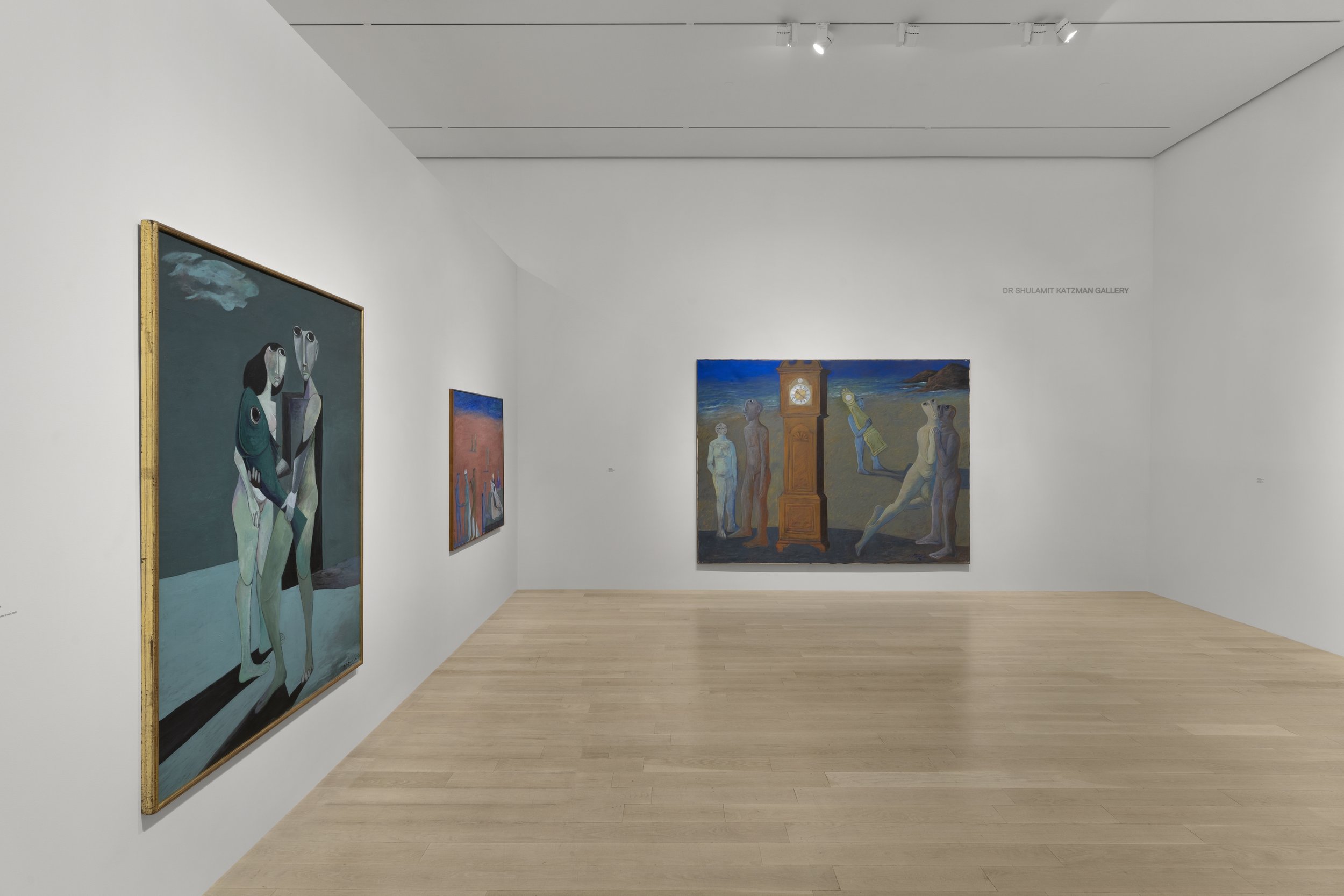
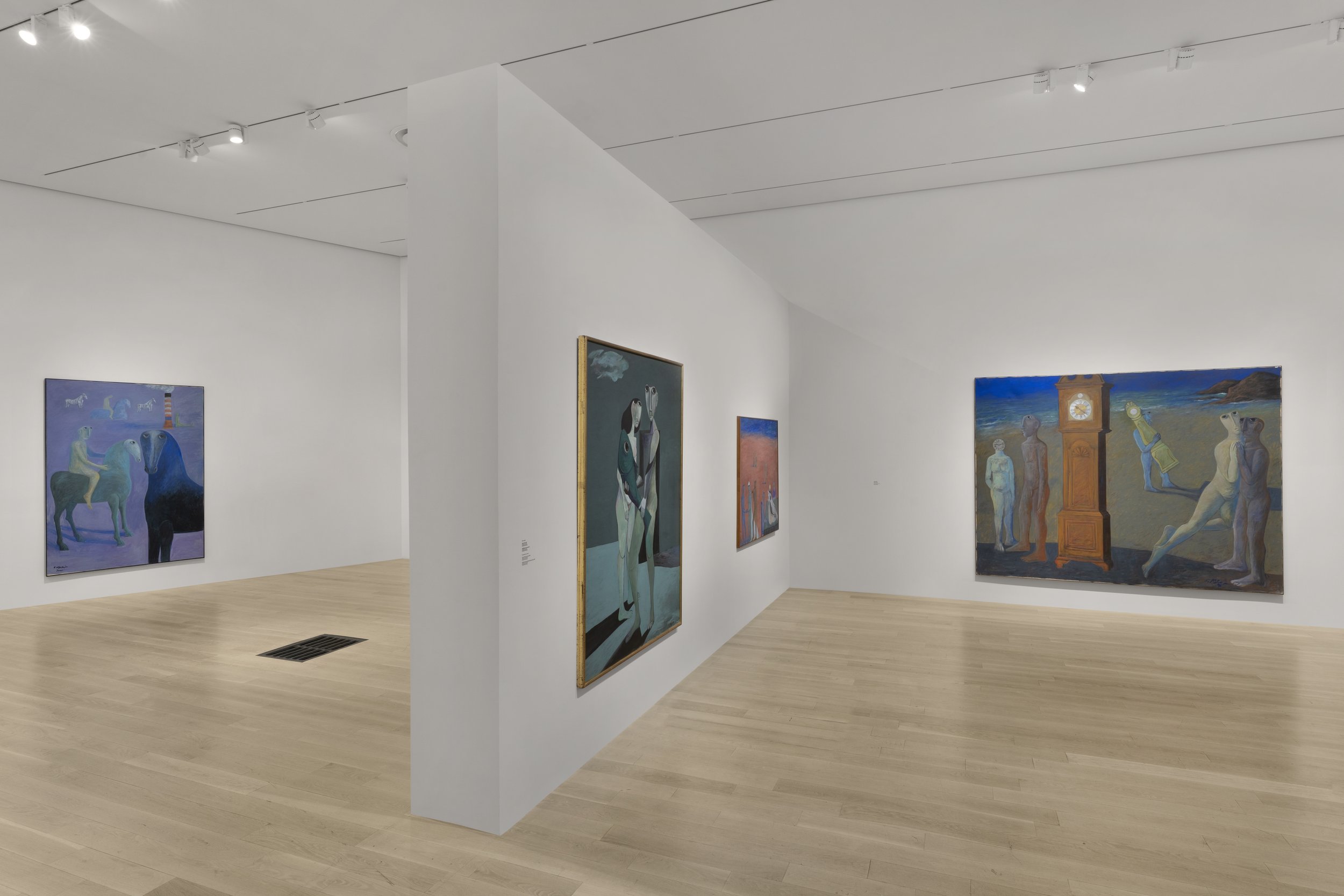
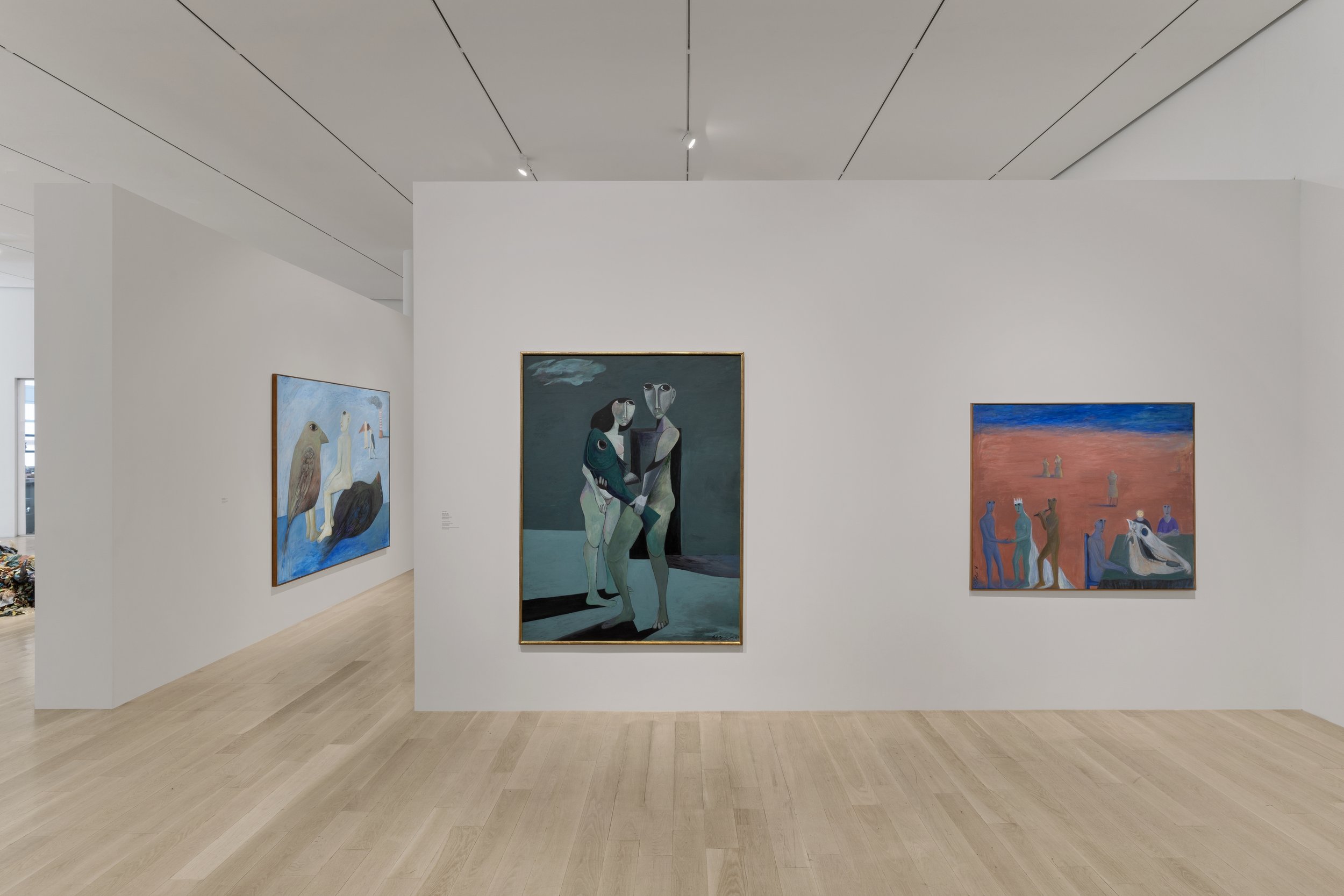
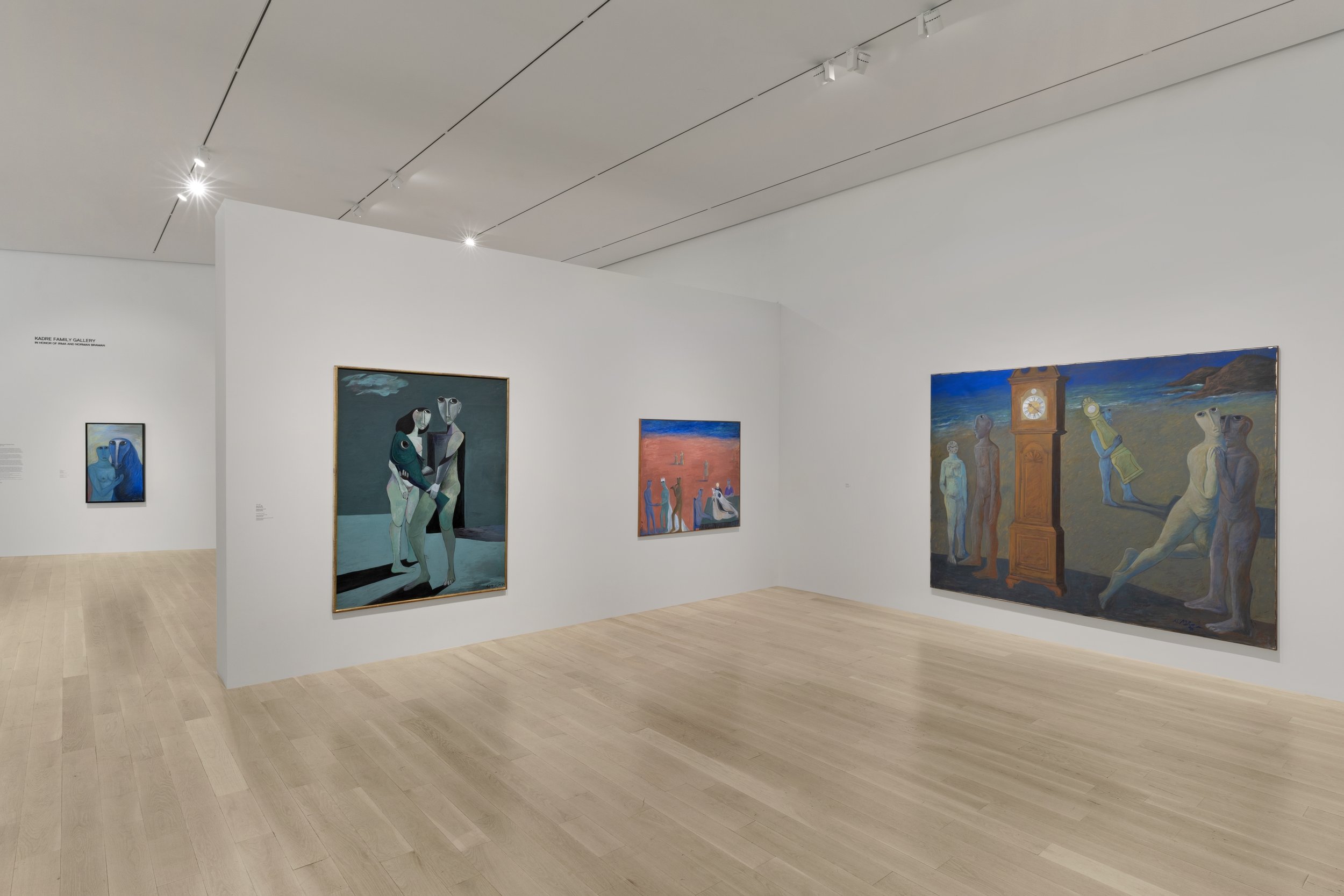
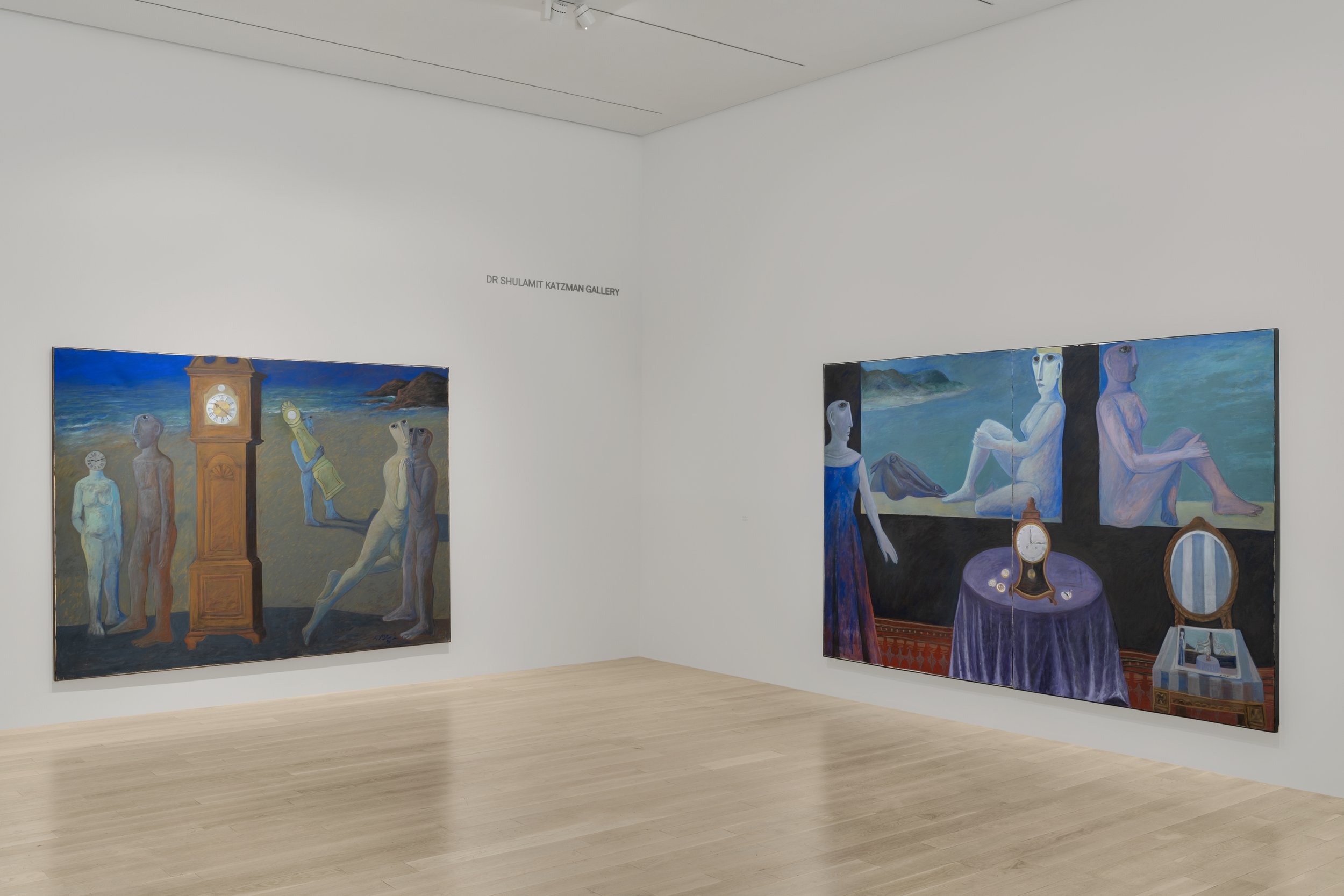
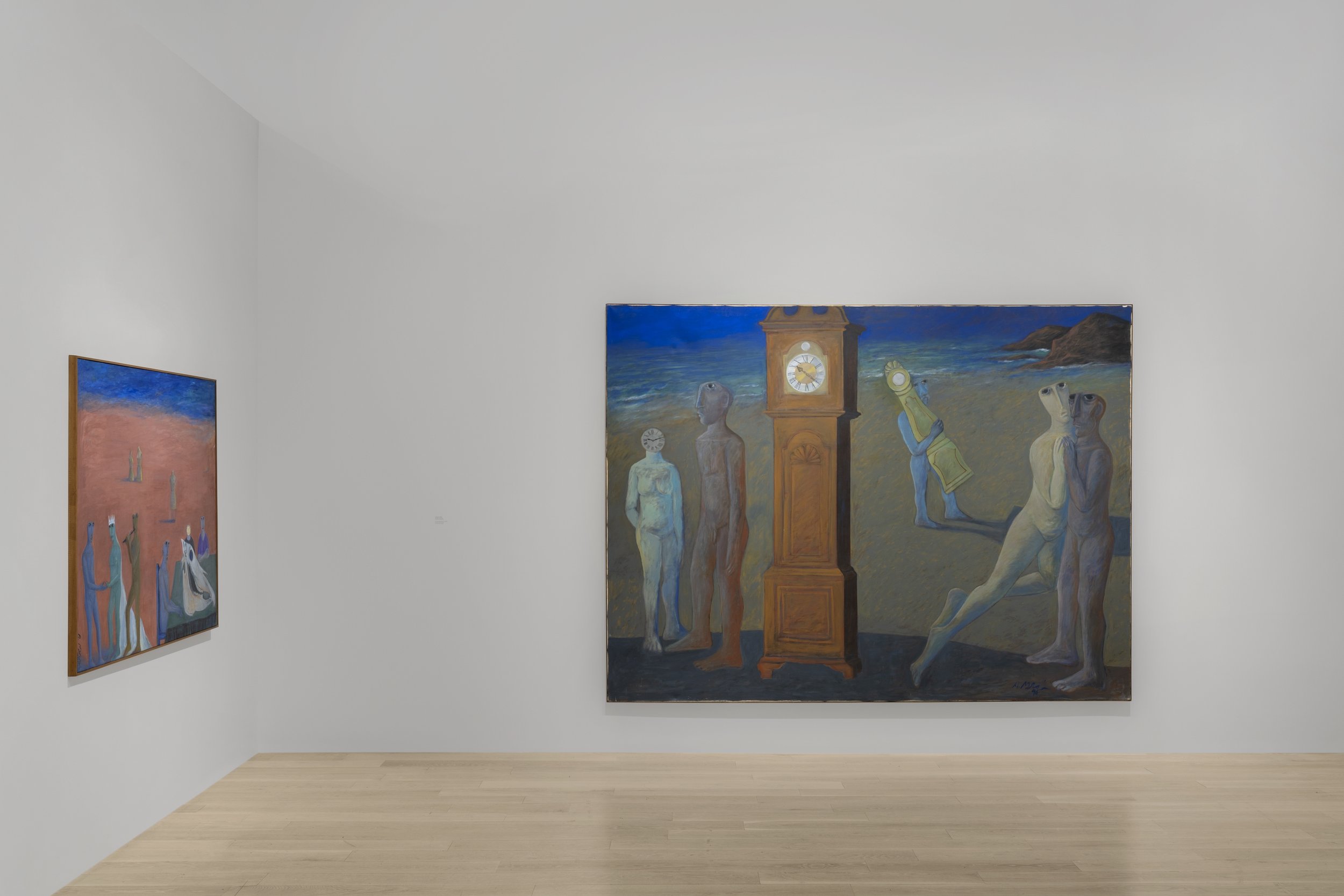
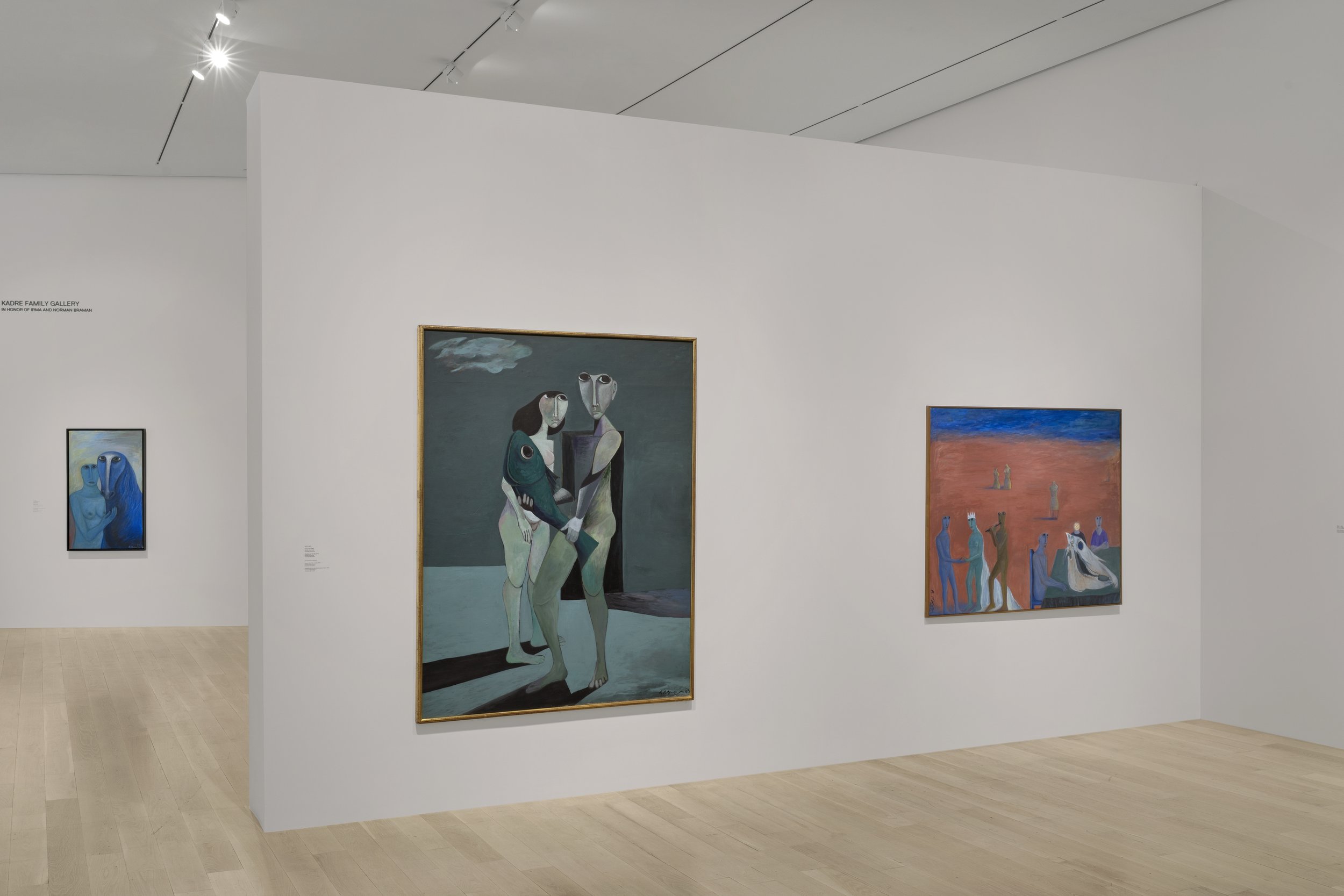
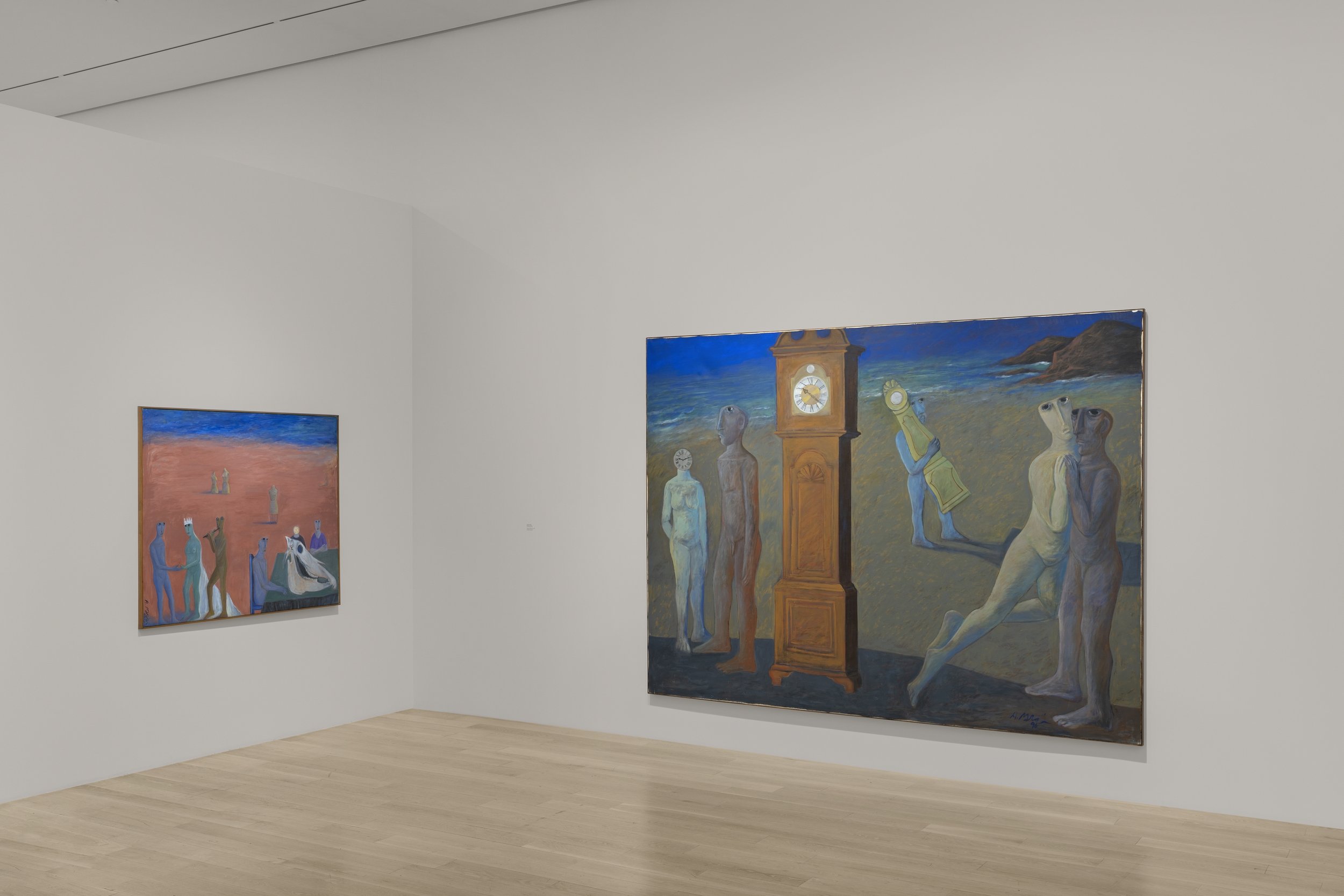
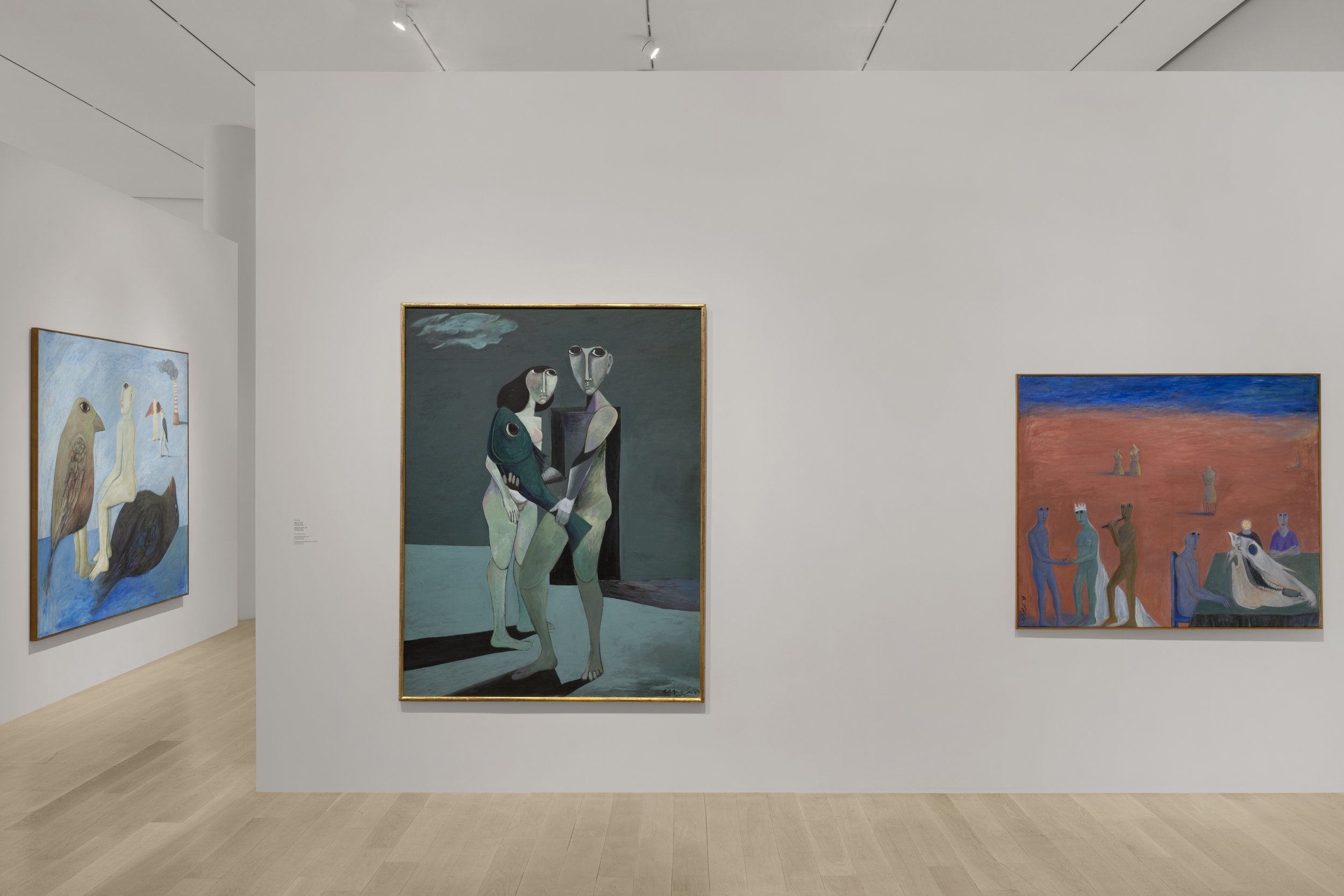
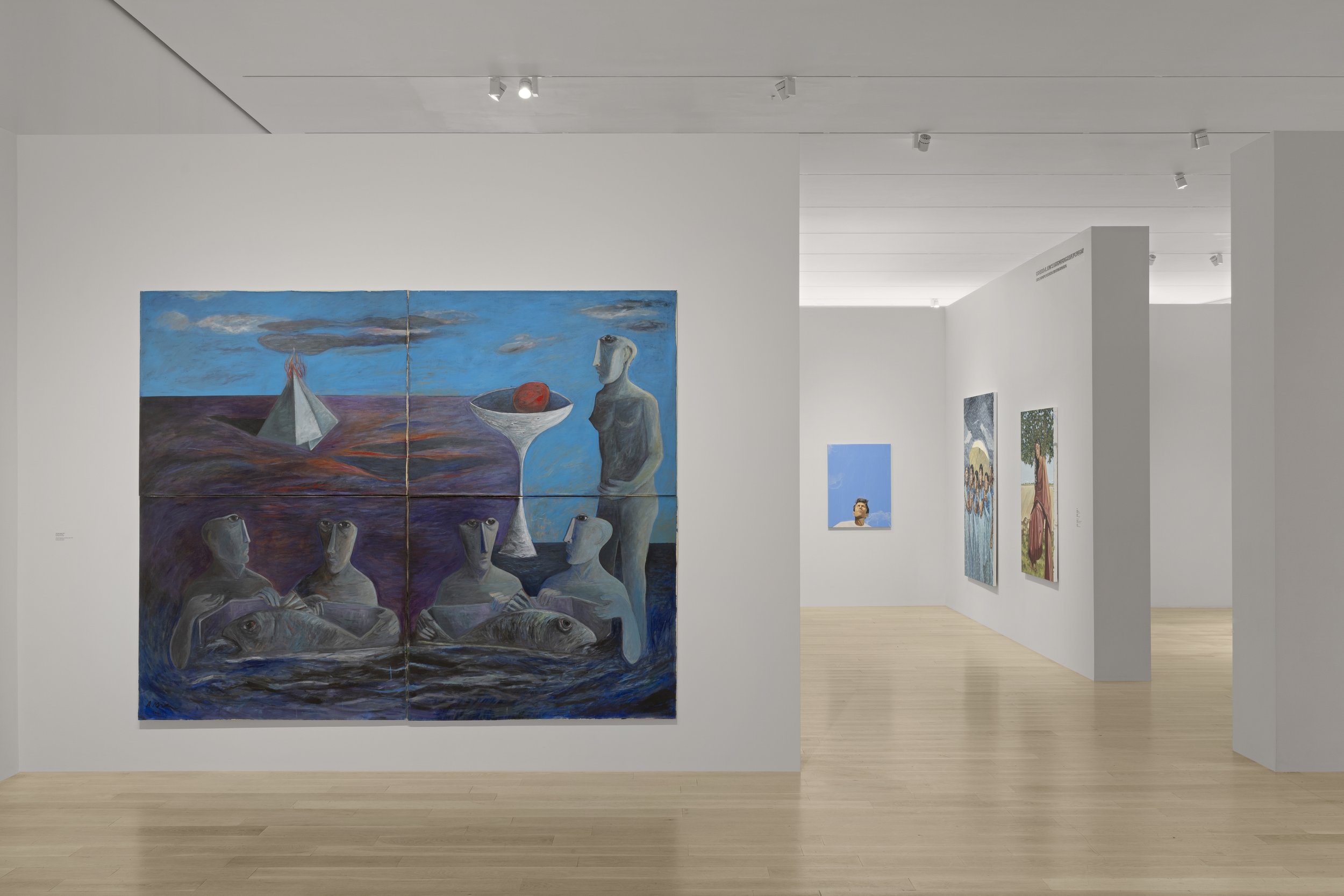
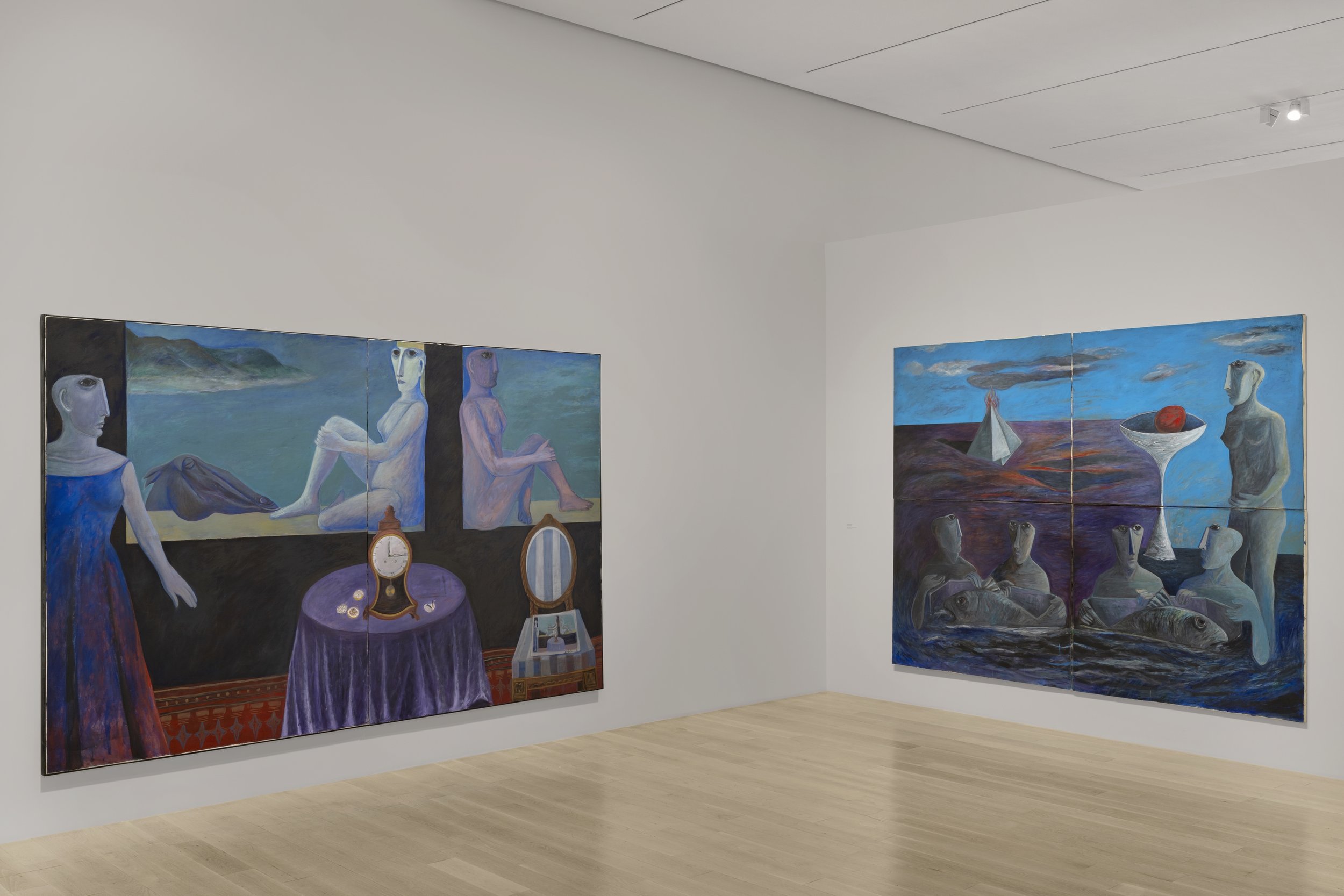

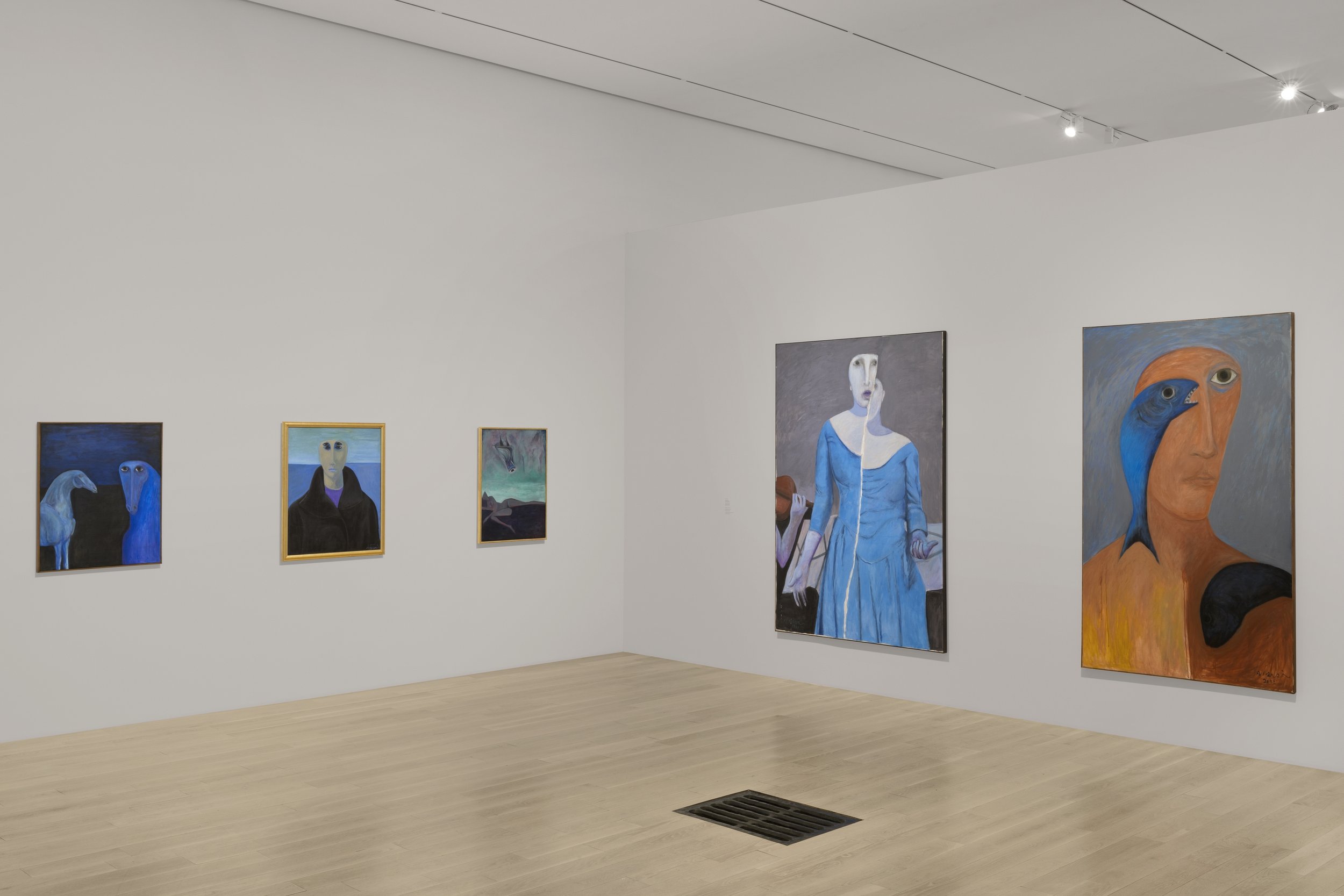
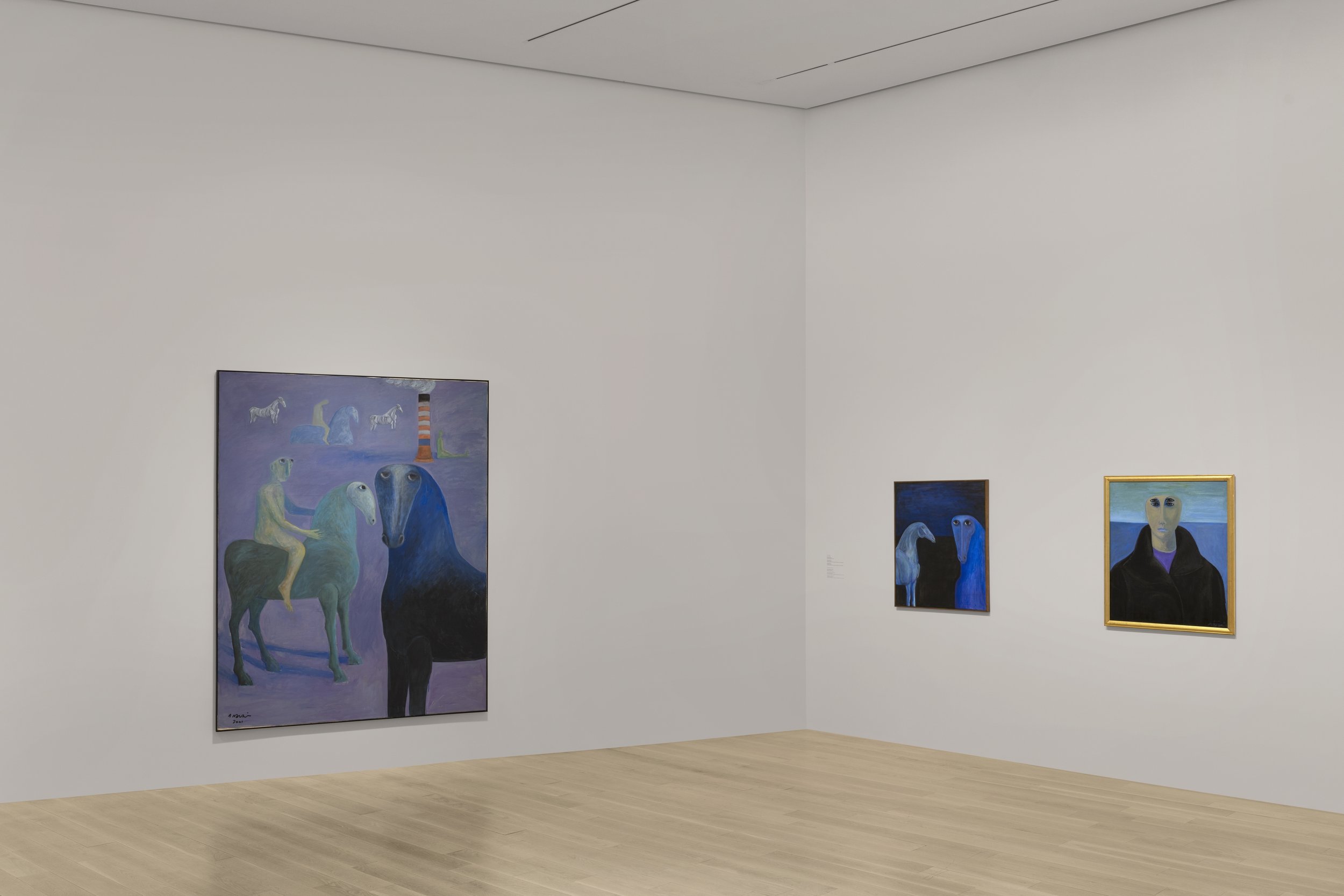
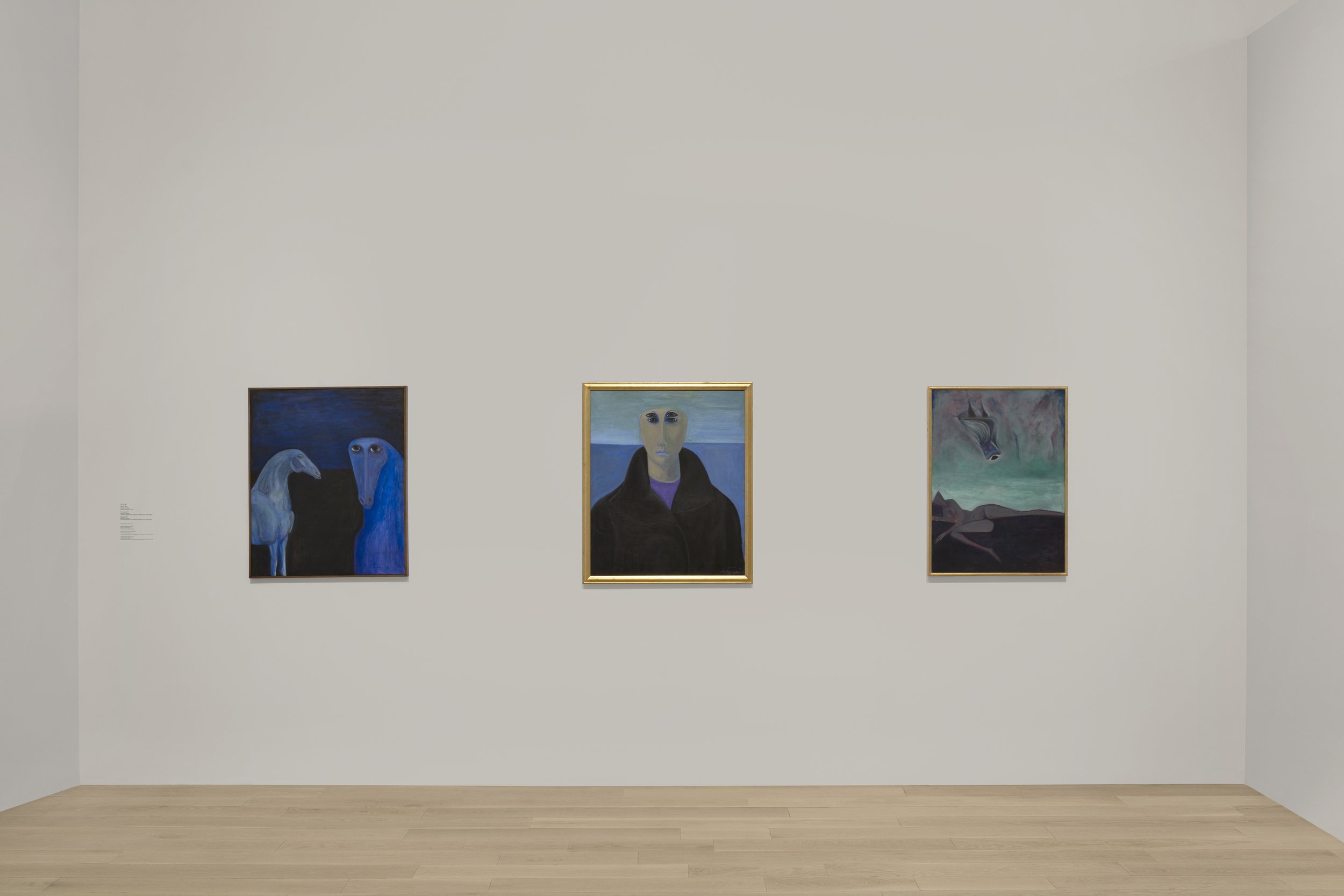

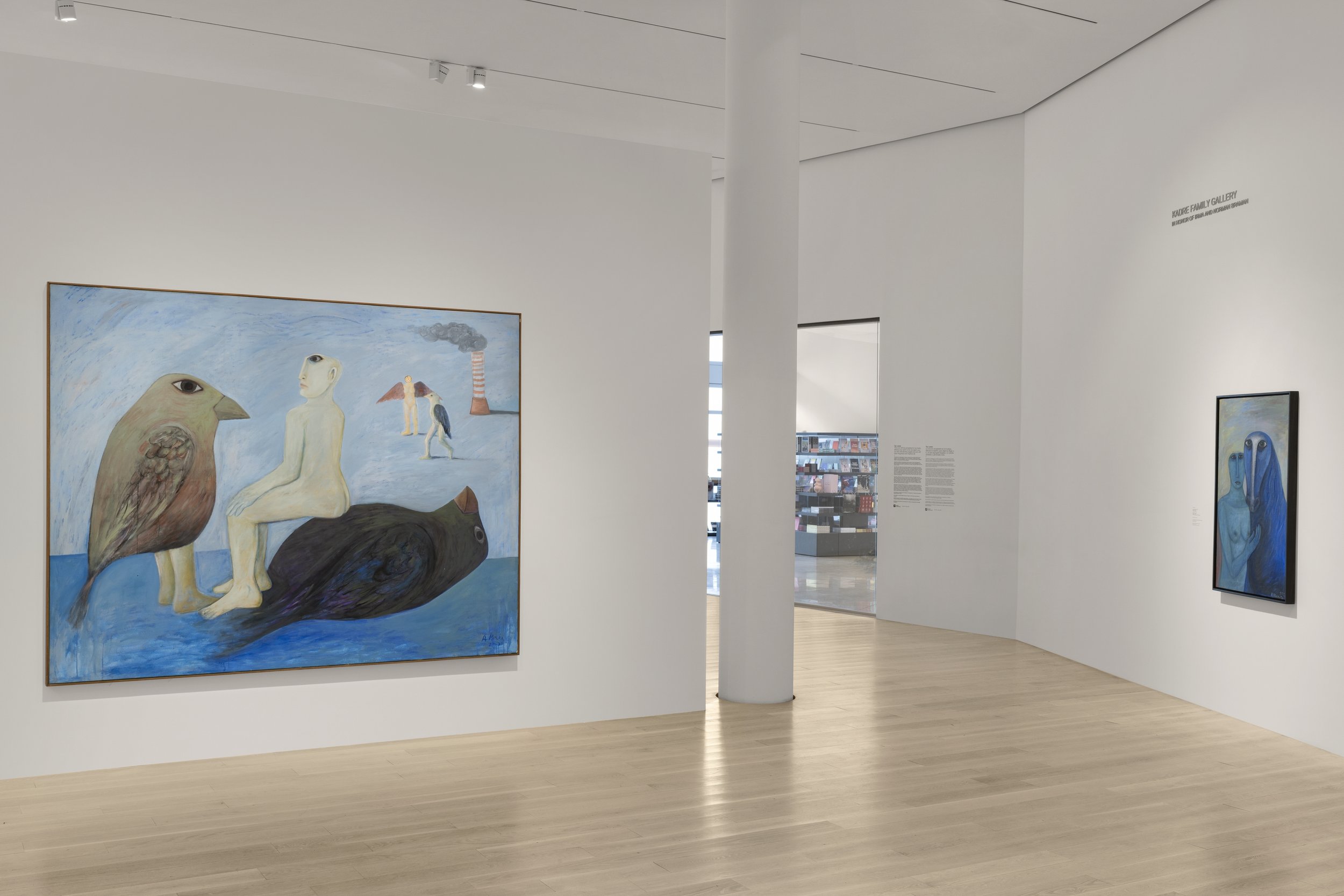
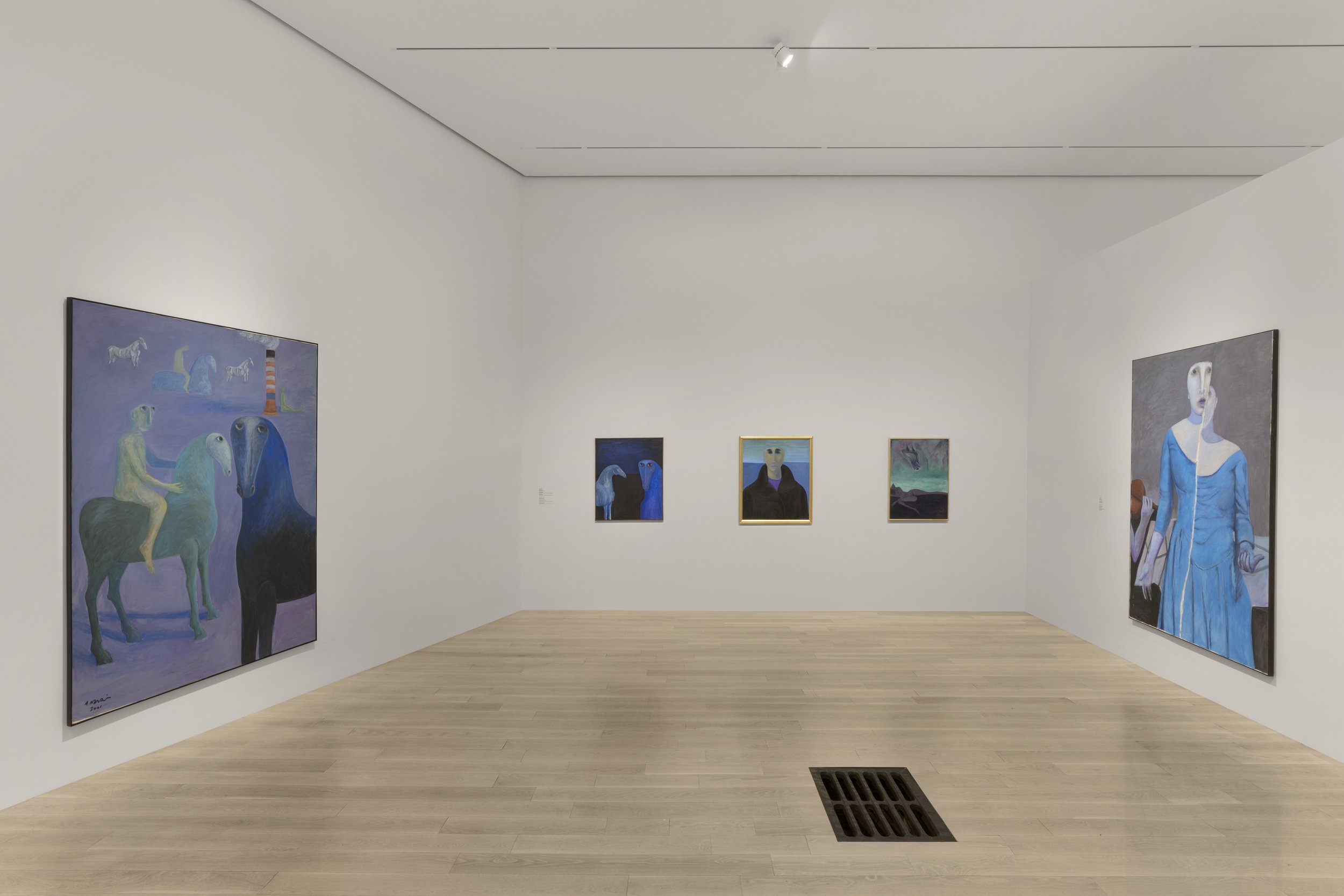
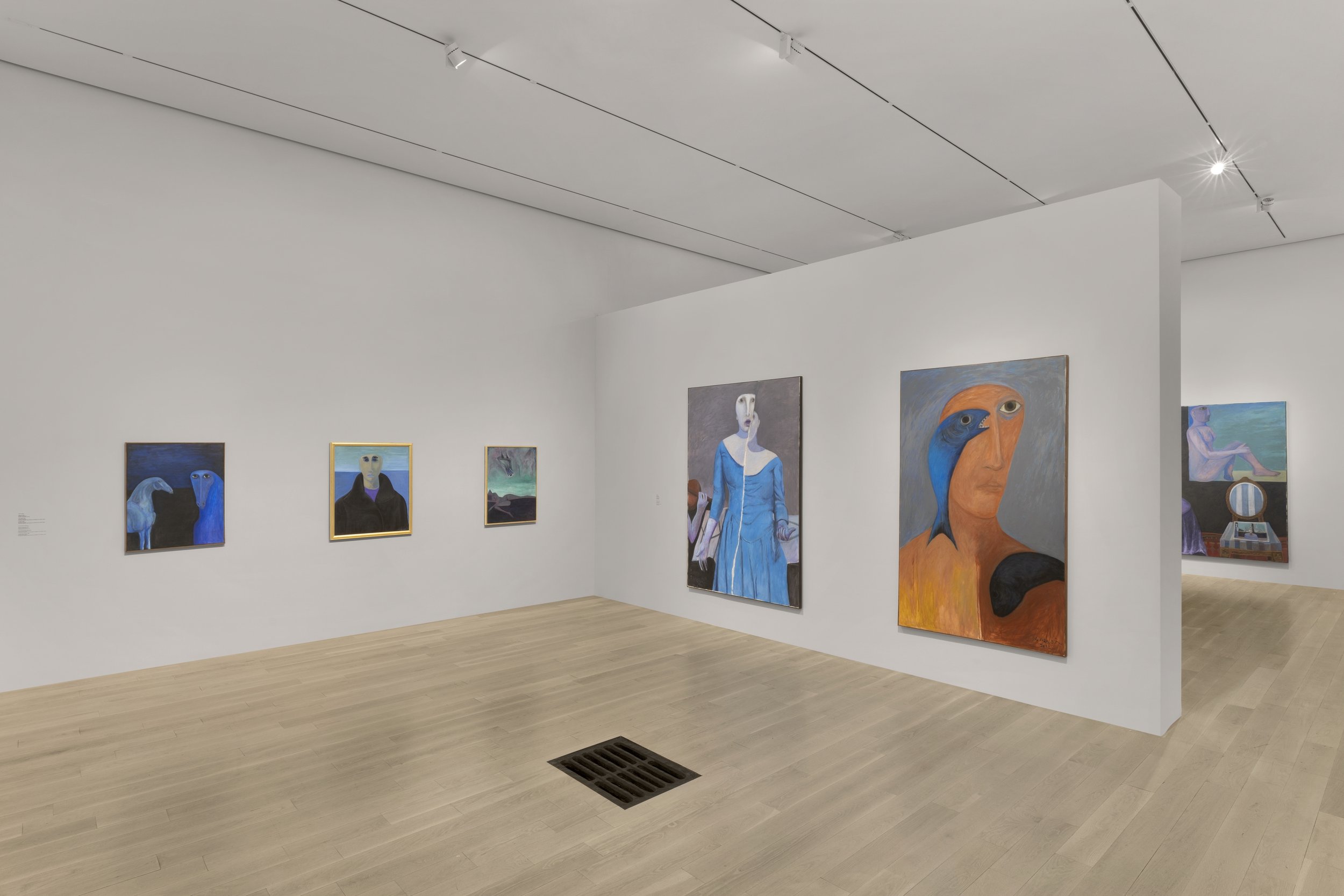
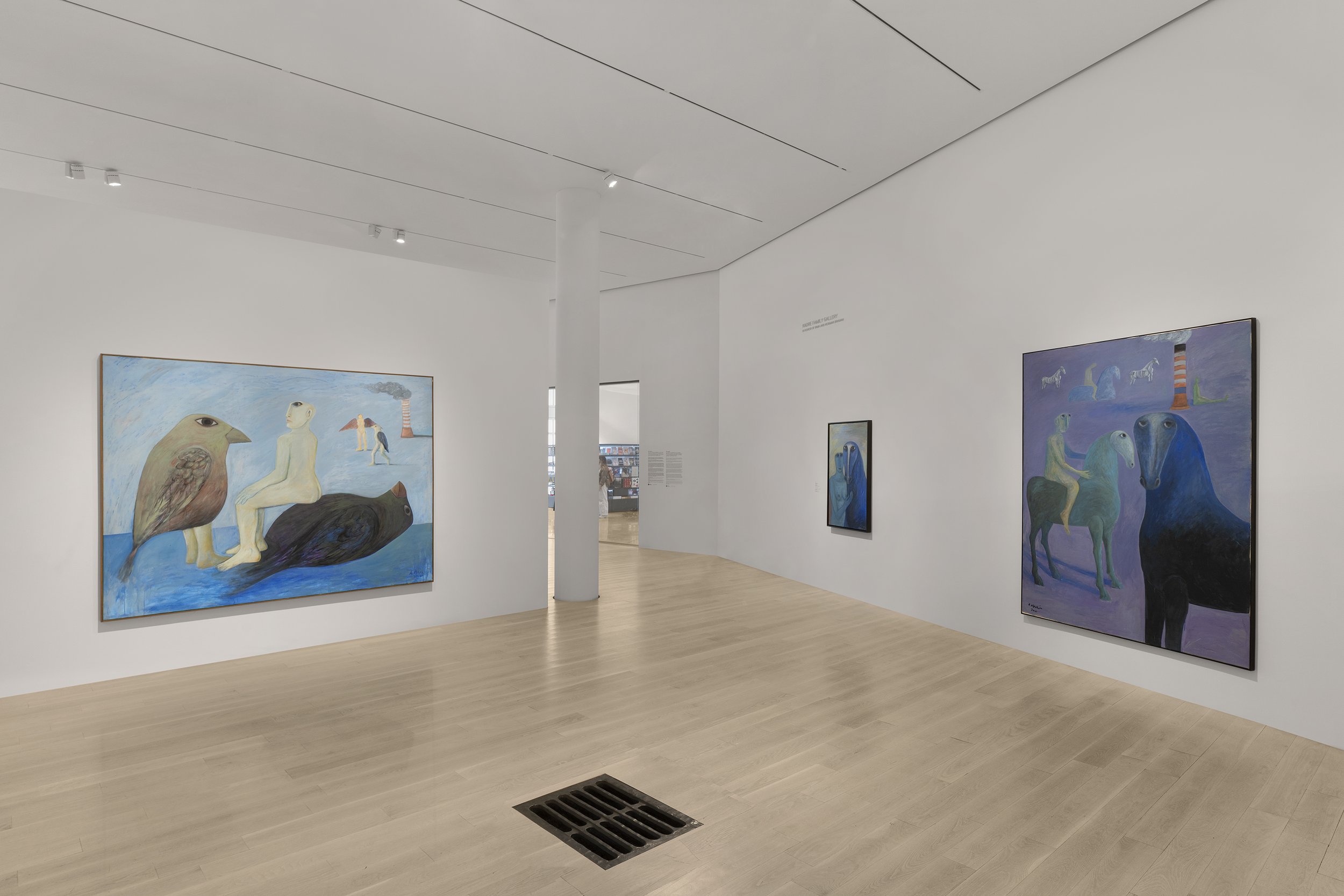
Installation view: "Ahmed Moris in New York: Elegy of the Sea," at the Institute of Contemporary Art,Miami. Dec 5, 2023-Apr 28, 2024. Photograph Zachary Balber.
“Ahmed Morsi in New York: Elegy of the Sea” is organized by ICA Miami and curated by Donna Honarpisheh, Associate Curator.
Exhibition Support Exhibitions at ICA Miami are supported by the Knight Foundation.
About the Institute of Contemporary Art, Miami
The Institute of Contemporary Art, Miami (ICA Miami) is dedicated to promoting continuous
experimentation in contemporary art, advancing new scholarship, and fostering the exchange of art and ideas throughout the Miami region and internationally. Through an energetic calendar of exhibitions and programs, and its collection, ICA Miami provides an important international platform for the work of local, emerging, and under-recognized artists, and advances the public appreciation and understanding of the most innovative art of our time. Launched in 2014, ICA Miami opened its new permanent home in Miami’s Design District in December 2017. The museum’s central location positions it as a cultural anchor within the community and enhances its role in developing cultural literacy throughout the Miami region. The museum offers free admission, providing audiences with open, public access to artistic excellence year round.
The Institute of Contemporary Art, Miami is located at 61 NE 41st Street, Miami, Florida 33137. For more information, visit here or follow the museum on Instagram, YouTube, and Facebook. Explore the ICA Channel for inside looks at ICA Miami exhibitions and the practices of the most exciting artists working today.
Anne Collier
Anne Collier, "Unraveling (Are You Out Of Your Mind)", 2023. Adhesive vinyl on wall. 535x 139 inches. Courtesy of the artist. Photo: Zachary Balber. Courtesy Institute of Contemporary Art, Miami.
ICA Miami presents a newly commissioned work by Anne Collier in the museum’s central stairwell. This is the first site-responsive wallpaper by the artist, and her first major presentation in Miami. In her photographic work that combines staged and often appropriated images, Collier examines mechanisms of representation, circulation, and objecthood of images.
Anne Collier, "Unraveling (Are You Out Of Your Mind)", 2023. Adhesive vinyl on wall. 535x 139 inches. Courtesy of the artist. Photo: Zachary Balber. Courtesy Institute ofContemporary Art, Miami.
Critically reflecting on the representation of women in mass media, her analog photographs feature found imagery, including posters, records, and comic strips from the 1950s and 1960s. Juxtaposing a sober, near-forensic approach to image-making with the charged gender dynamics of the found images she appropriates, Collier frames the apparatus of the camera as both an instrument of domination and emancipation.
Anne Collier, Eye # !, (2014) Courtesy of artist: Anton Kern Gallery, New York; Galerie Neu, Berlin, Gladstone Gallery, Brussels; and the Modern Institute, Toby Webster Ltd., Glasgow
Anne Collier (b. 1970, Los Angeles) has exhibited her work widely internationally in solo and group presentations. Recent survey exhibitions include Lismore Castle, Waterford, Ireland (2023); Sprengel Museum, Hannover, Germany (2018), which traveled to Fotomuseum Winterthur, Switzerland (2019); and a major survey at the Museum of Contemporary Art, Chicago, which traveled to the Hessel Museum of Art, Annandale-on-Hudson, New York (both 2014), the Aspen Museum of Art (2015), and the Art Gallery of Ontario, Toronto (2016); among many others. Collier’s work is part of numerous museum collections worldwide, including the Art Institute of Chicago; Los Angeles County Museum of Art; Moderna Museet, Stockholm; Museum of Contemporary Art, Chicago; Museum of Fine Arts, Boston; Museum of Modern Art, New York; Solomon R. Guggenheim Museum, New York; and Tate Modern, London. The artist lives and works in New York City.
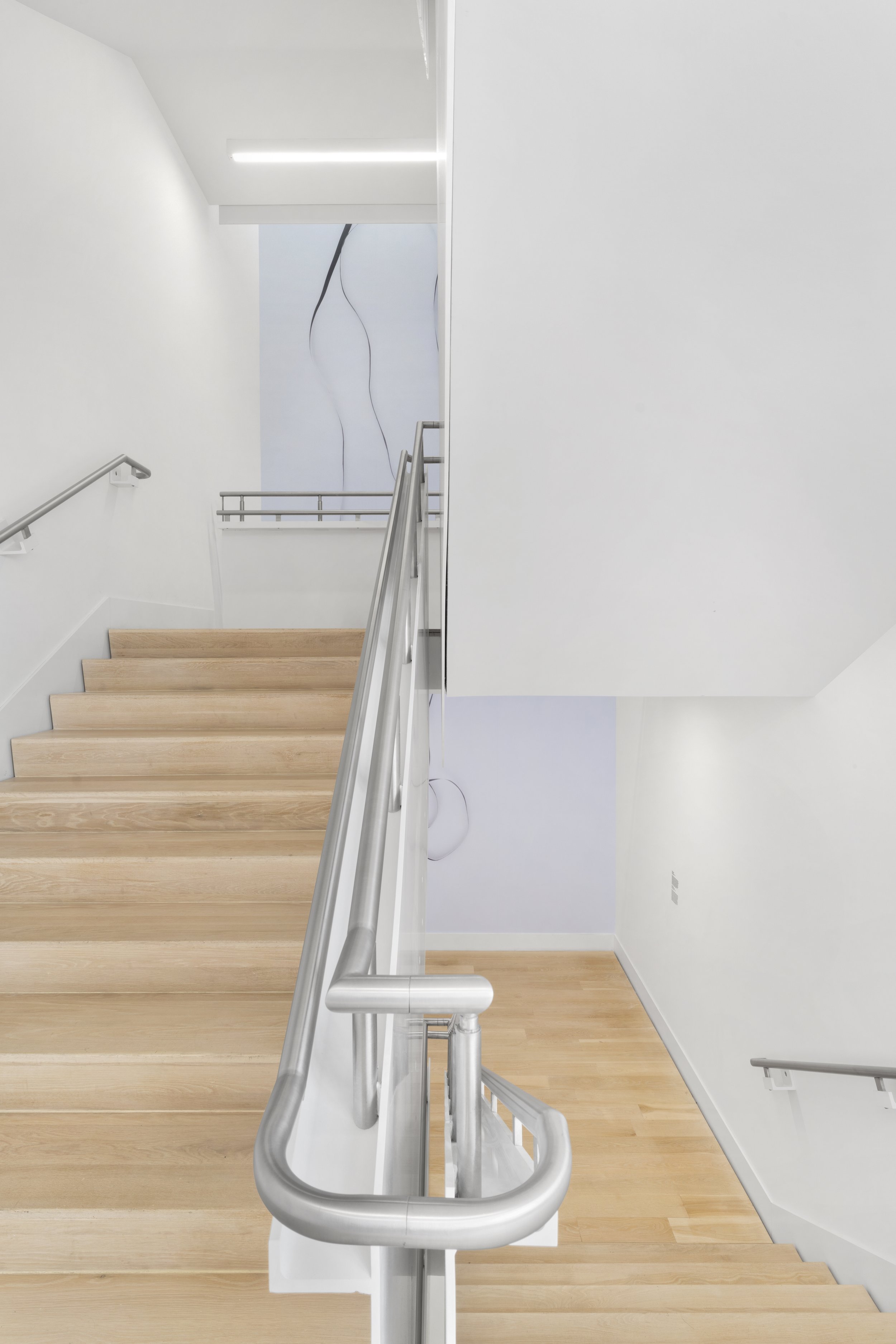
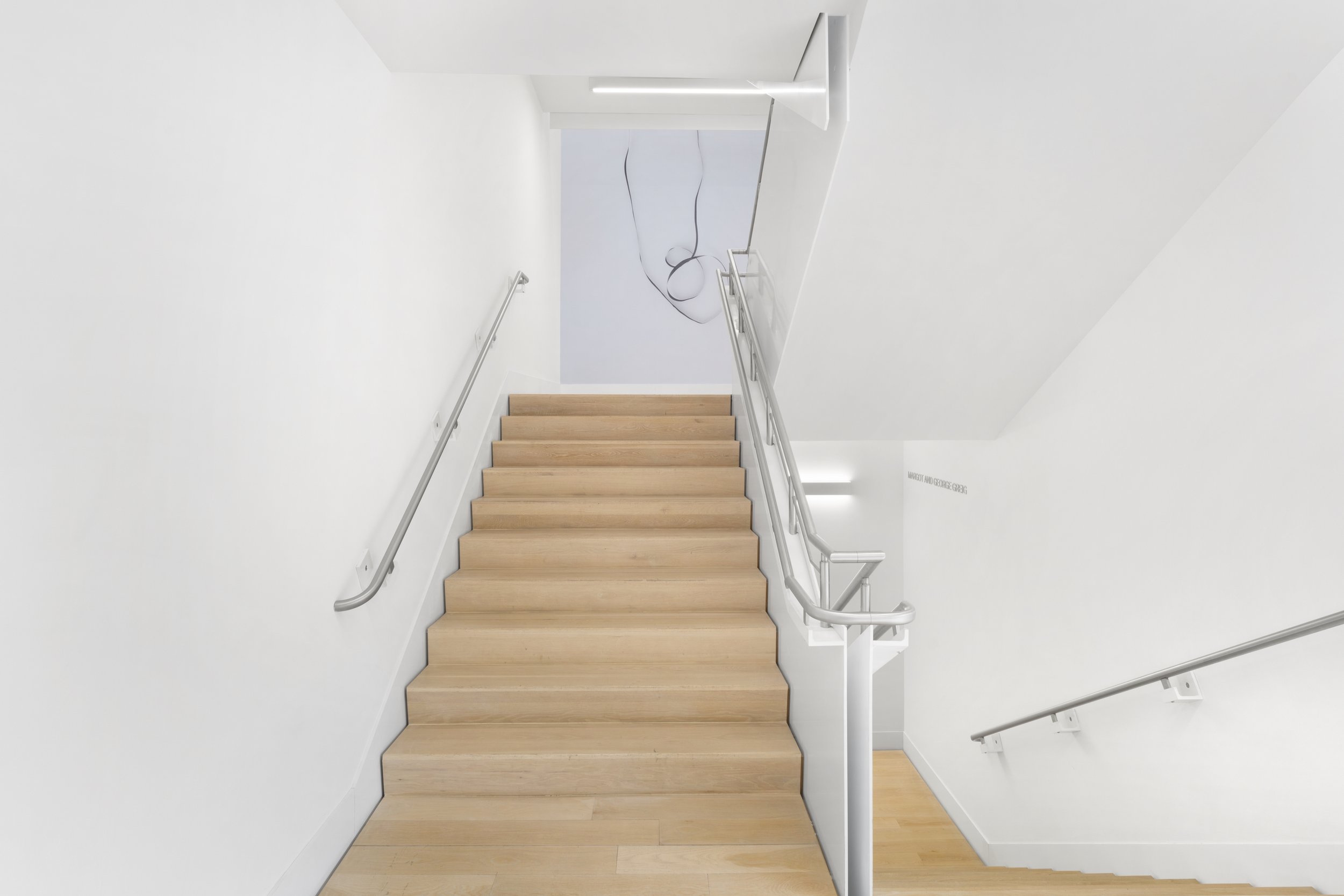
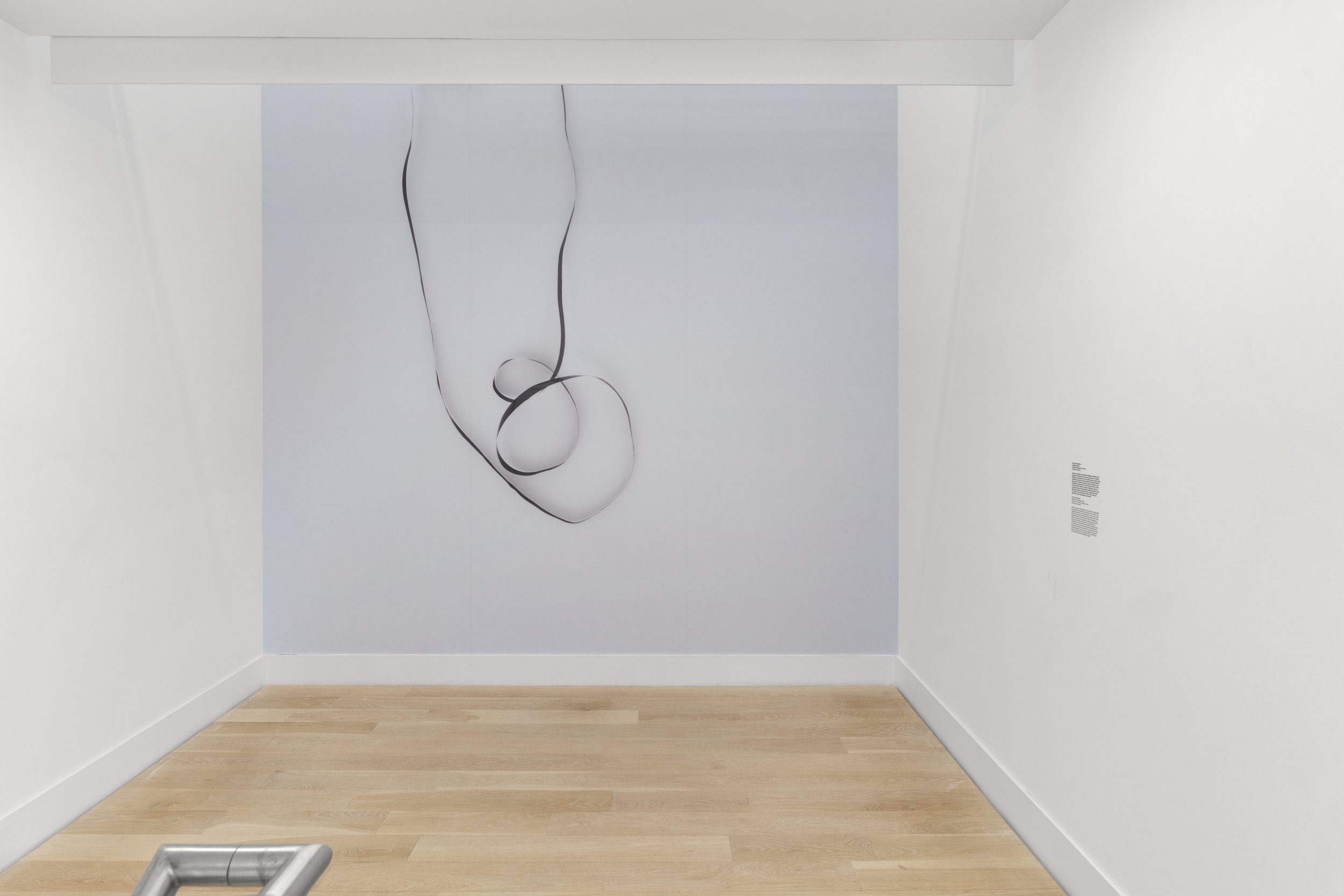
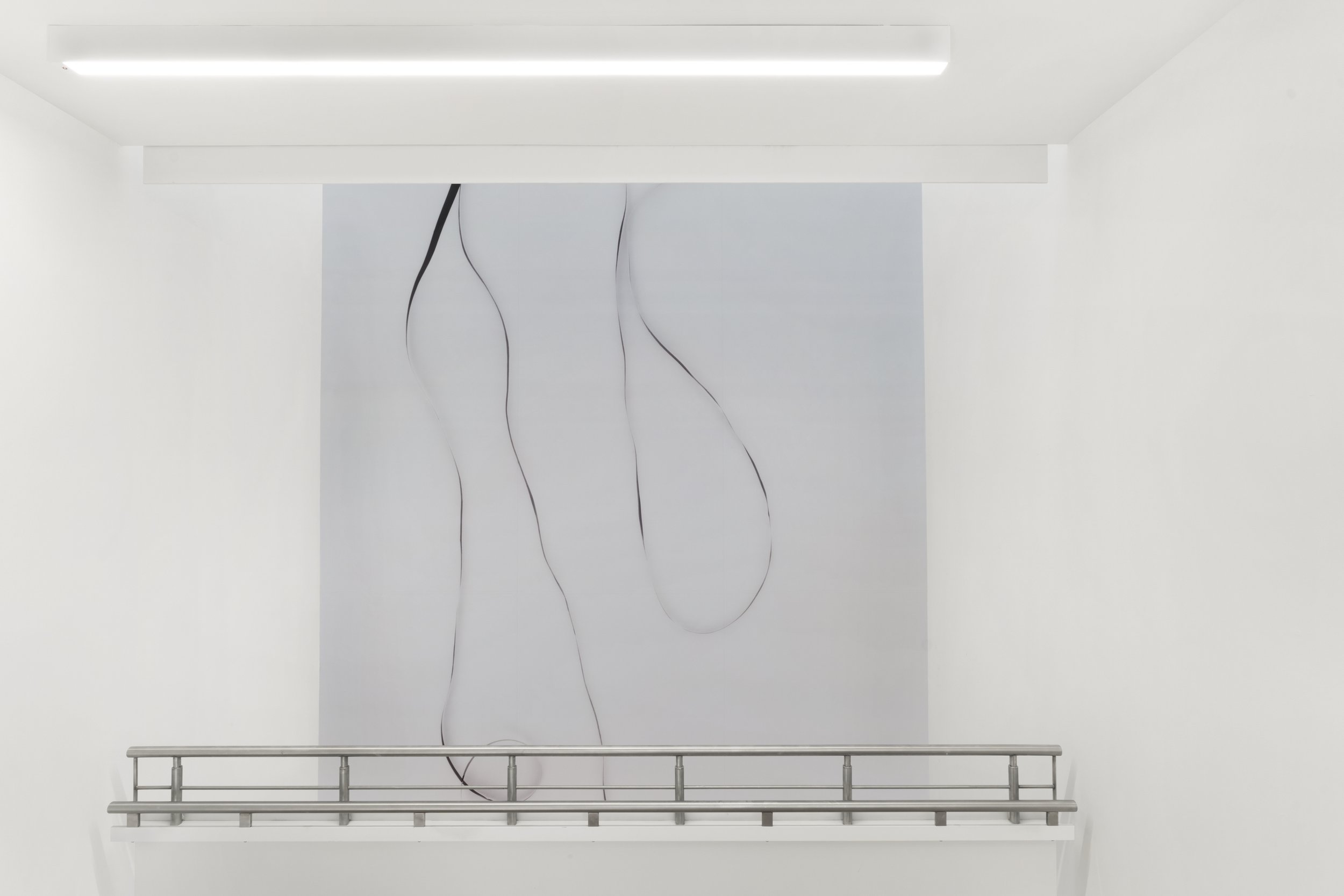
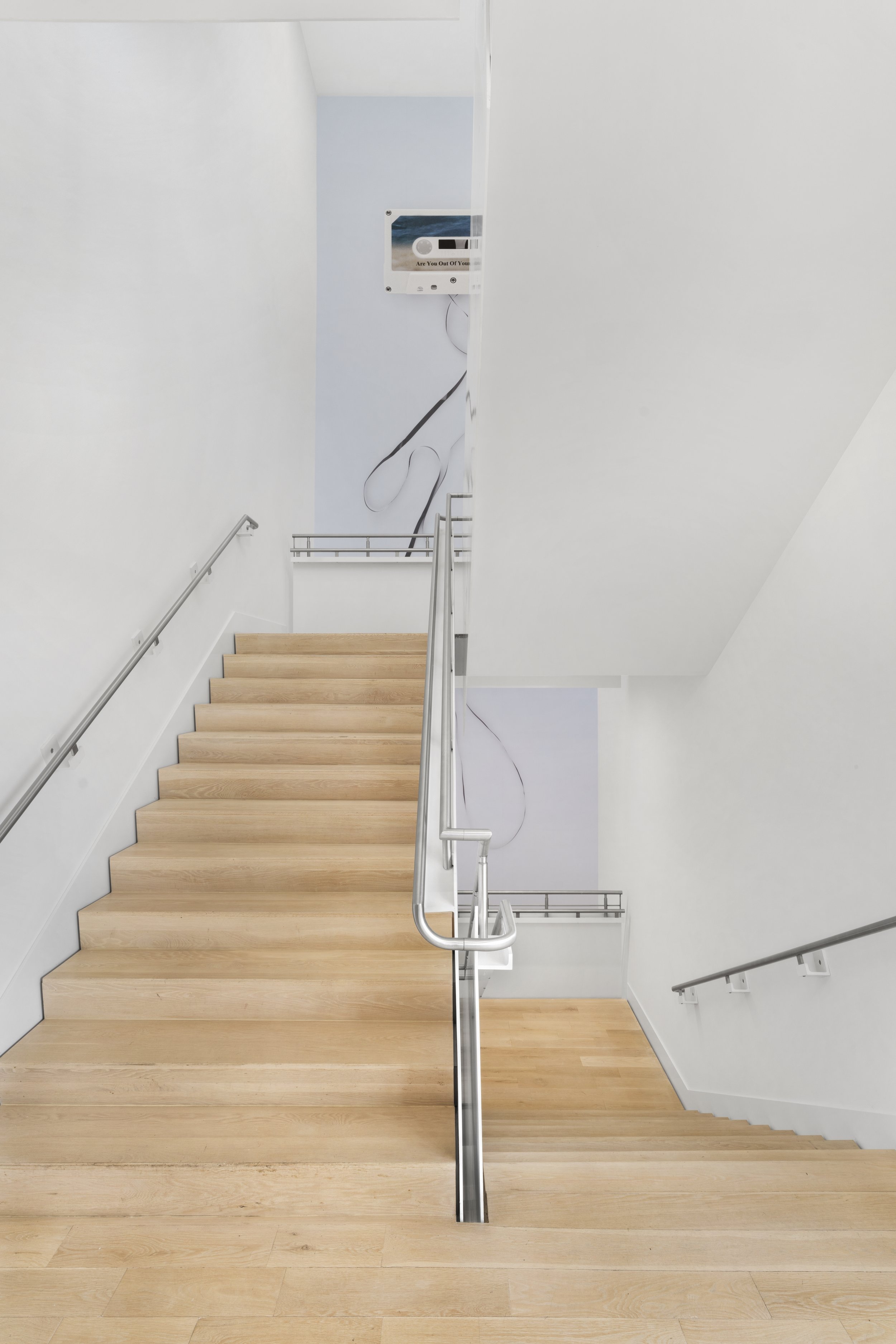
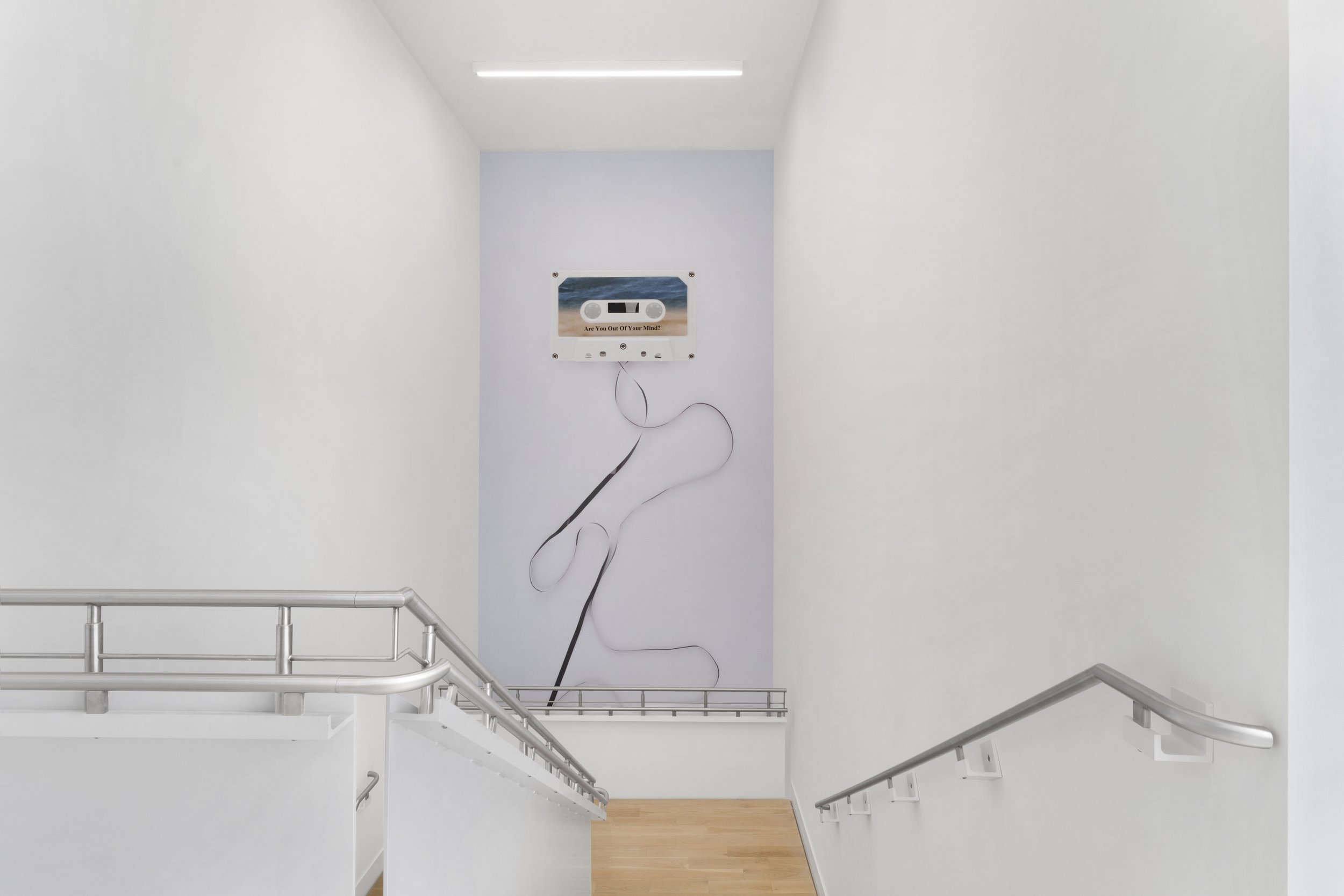
Anne Collier, "Unraveling (Are You Out Of Your Mind)", 2023. Adhesive vinyl on wall. 535x 139 inches. Courtesy of the artist. Photo: Zachary Balber. Courtesy Institute of Contemporary Art, Miami.
The exhibition opened on December 5, 2023, and will run through until October 16, 2024; the location of the exhibition is in ICA’s Stairwell.
The Institute of Contemporary Art, Miami is located at 61 NE 41st Street, Miami, Florida 33137. For more information, visit here or follow the museum on Instagram, YouTube, and Facebook. Explore the ICA Channel for inside looks at ICA Miami exhibitions and the practices of the most exciting artists working today.






















